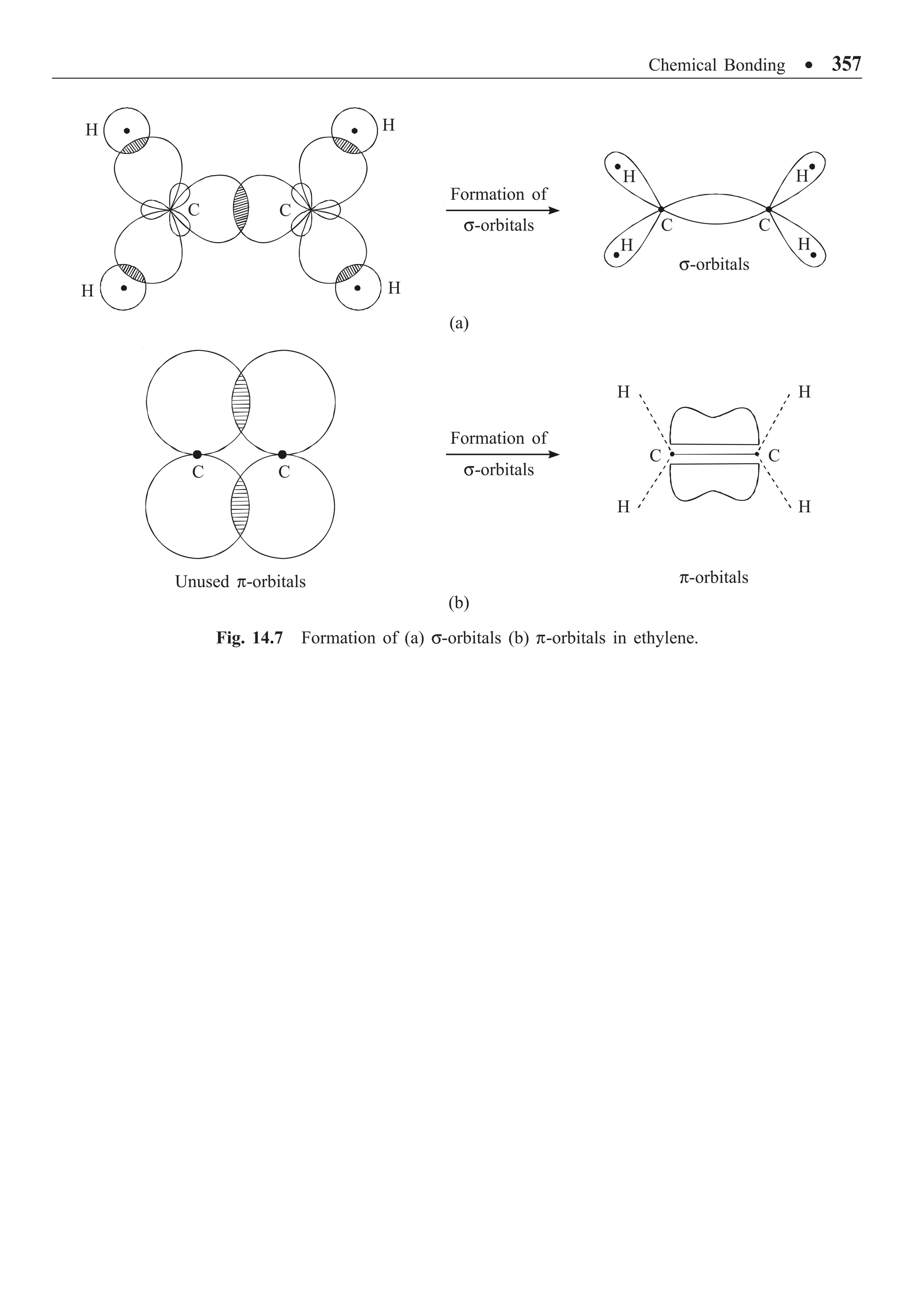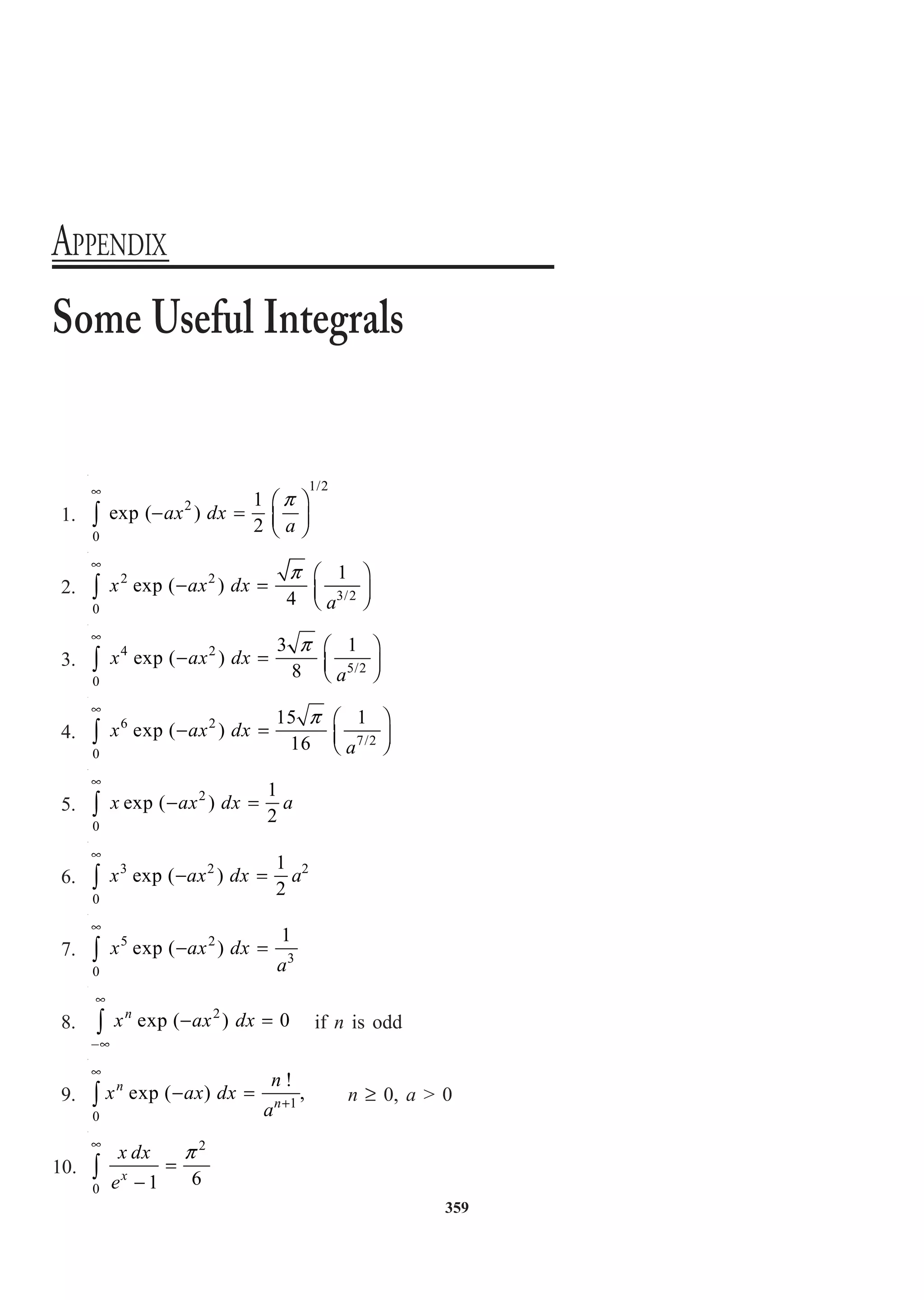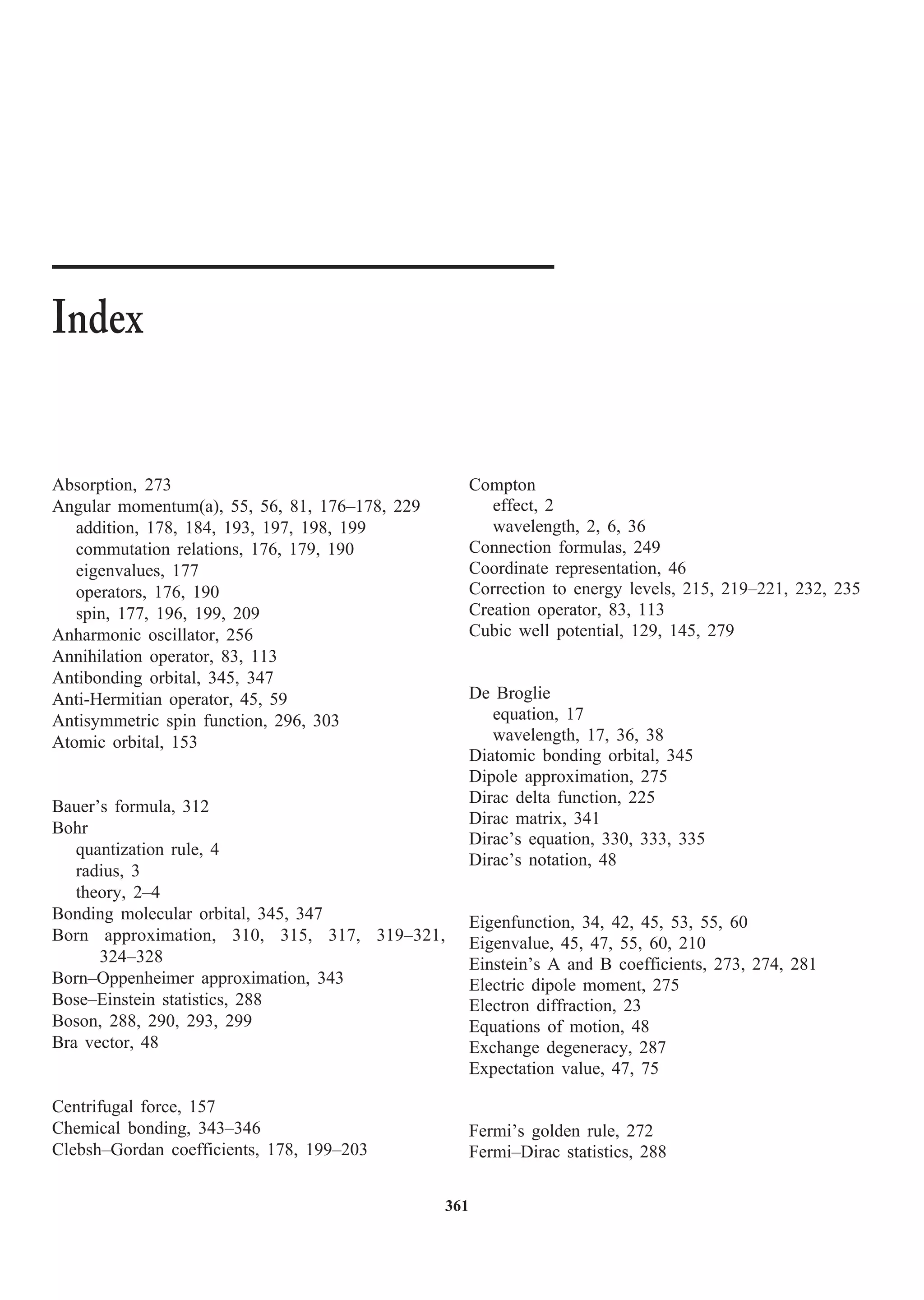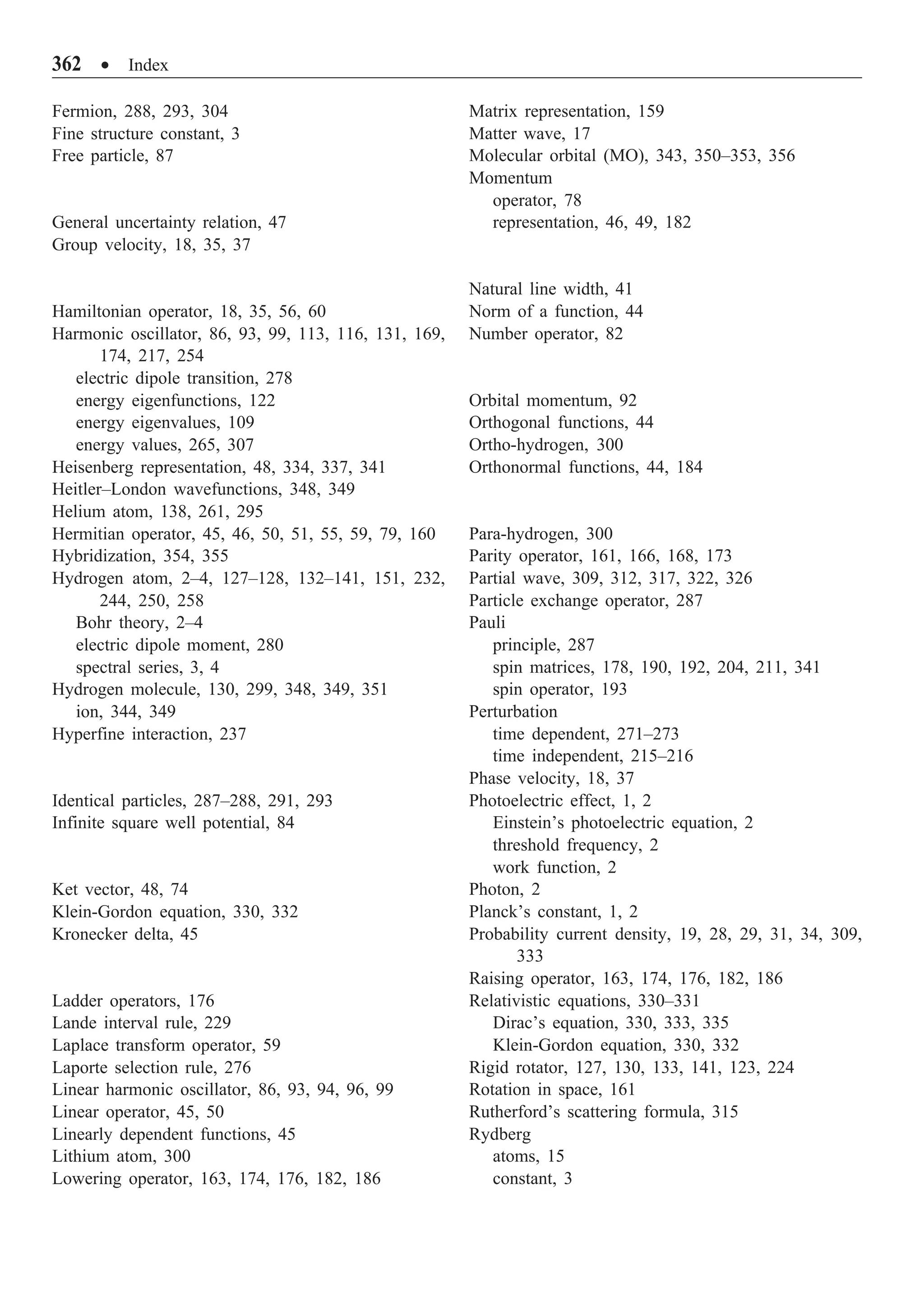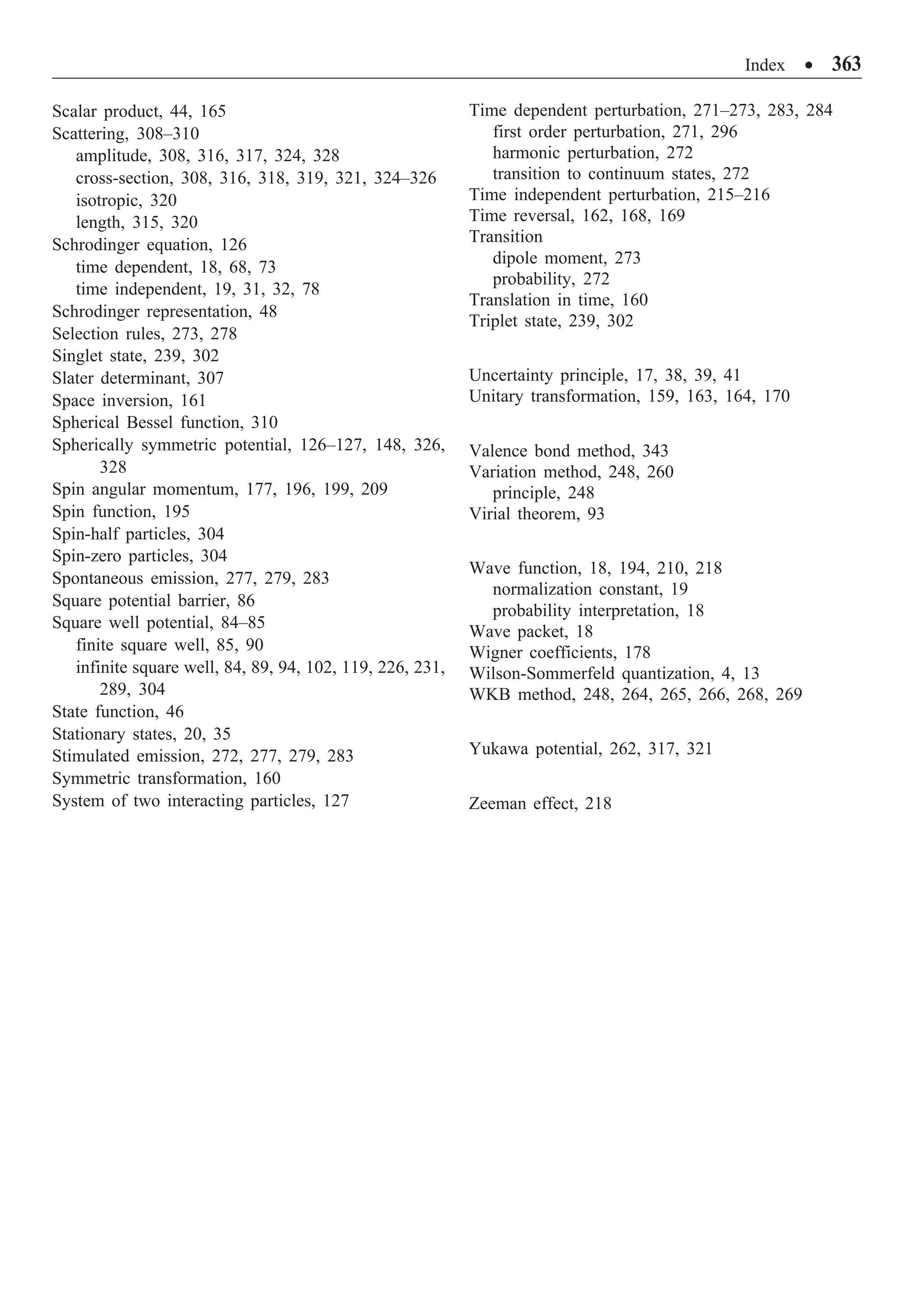The document provides an overview of the key developments in quantum theory that led to the emergence of quantum mechanics. It discusses Planck's quantum hypothesis, Einstein's explanation of the photoelectric effect and Compton effect, Bohr's theory of the hydrogen atom, and the Wilson-Sommerfeld quantization rule. Various concepts are defined, such as Planck's constant, photons, Compton wavelength, Bohr radius, Rydberg constant, and spectral series of the hydrogen atom. Example problems are provided to illustrate applications of these foundational ideas in quantum theory.
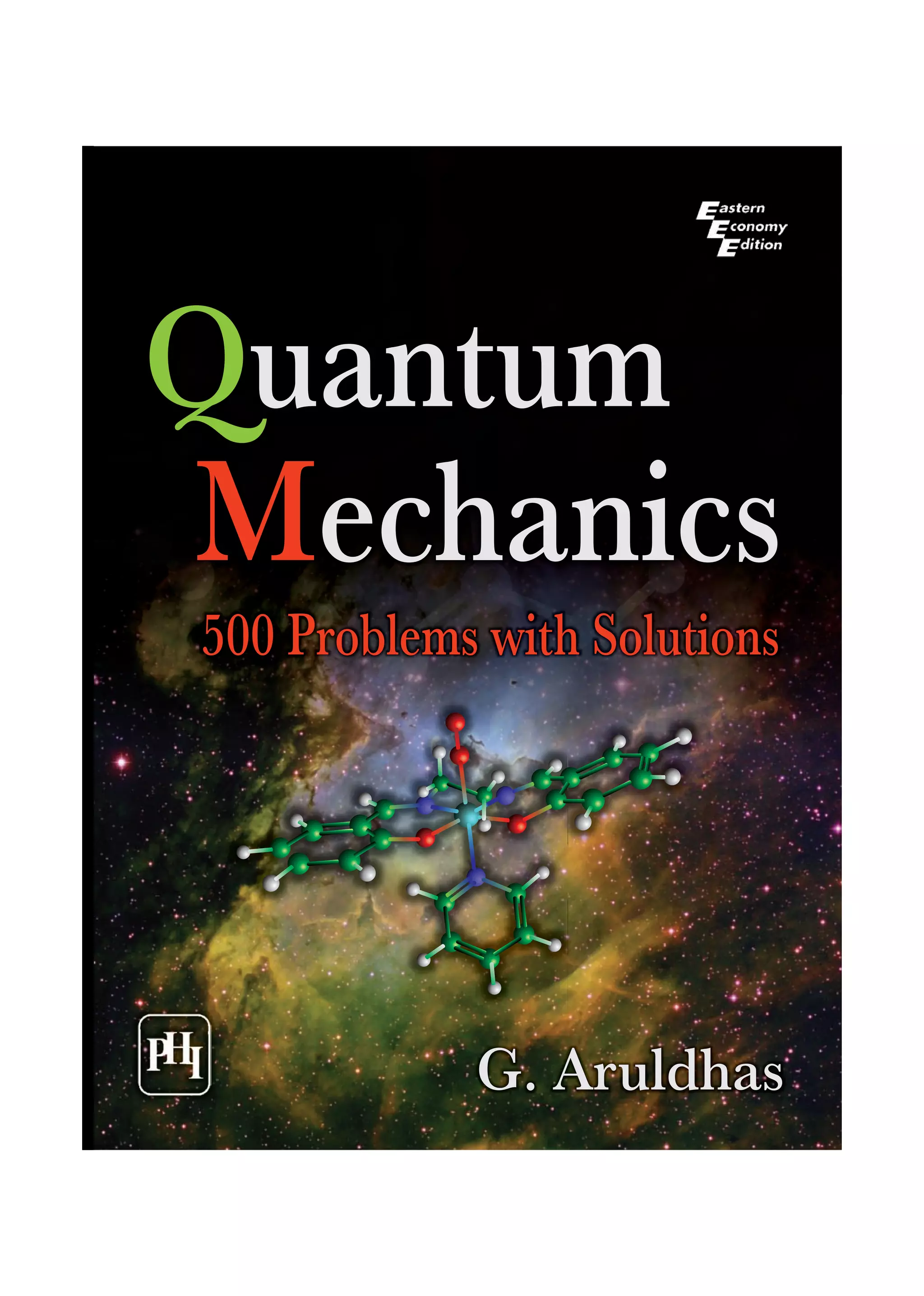



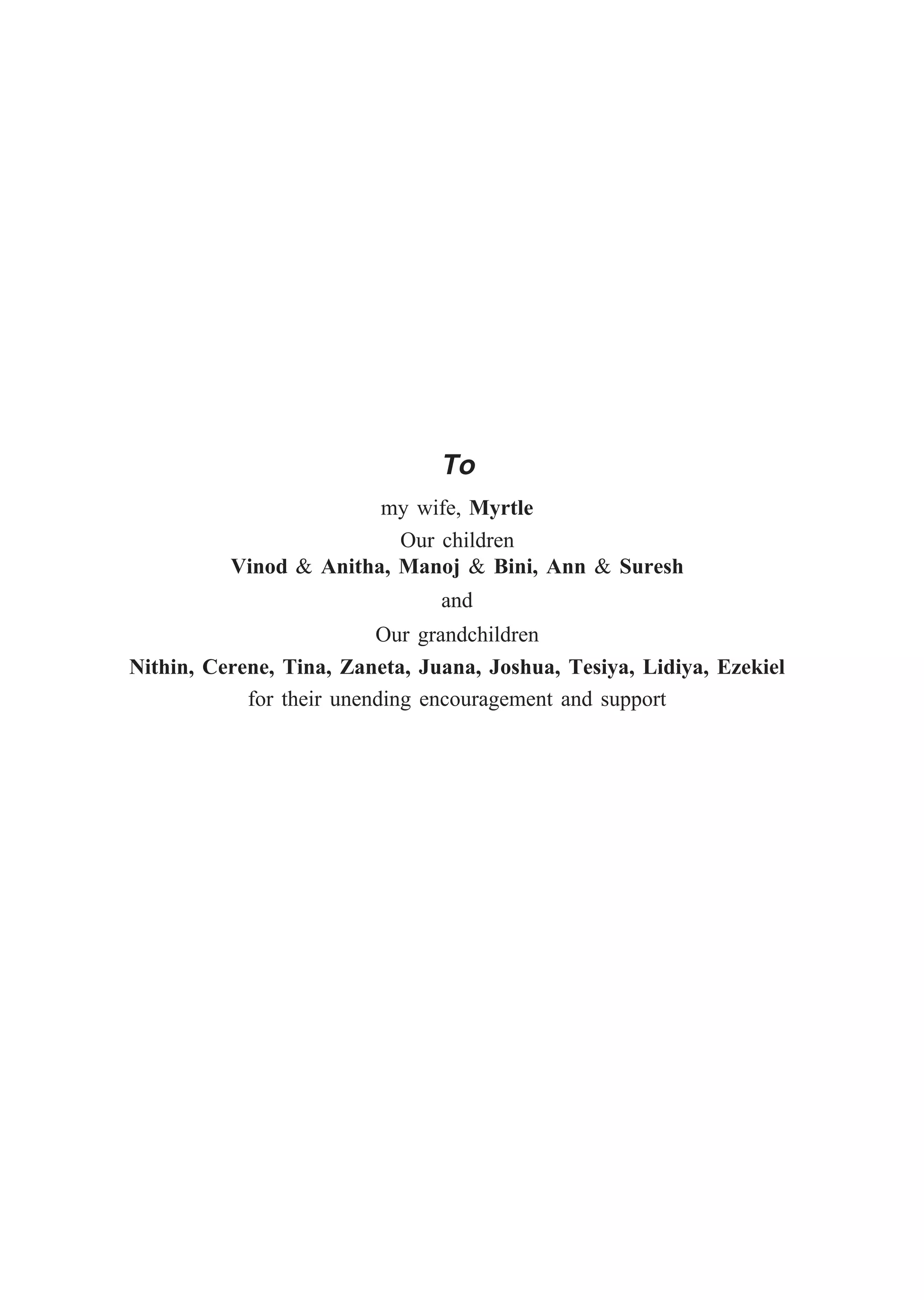
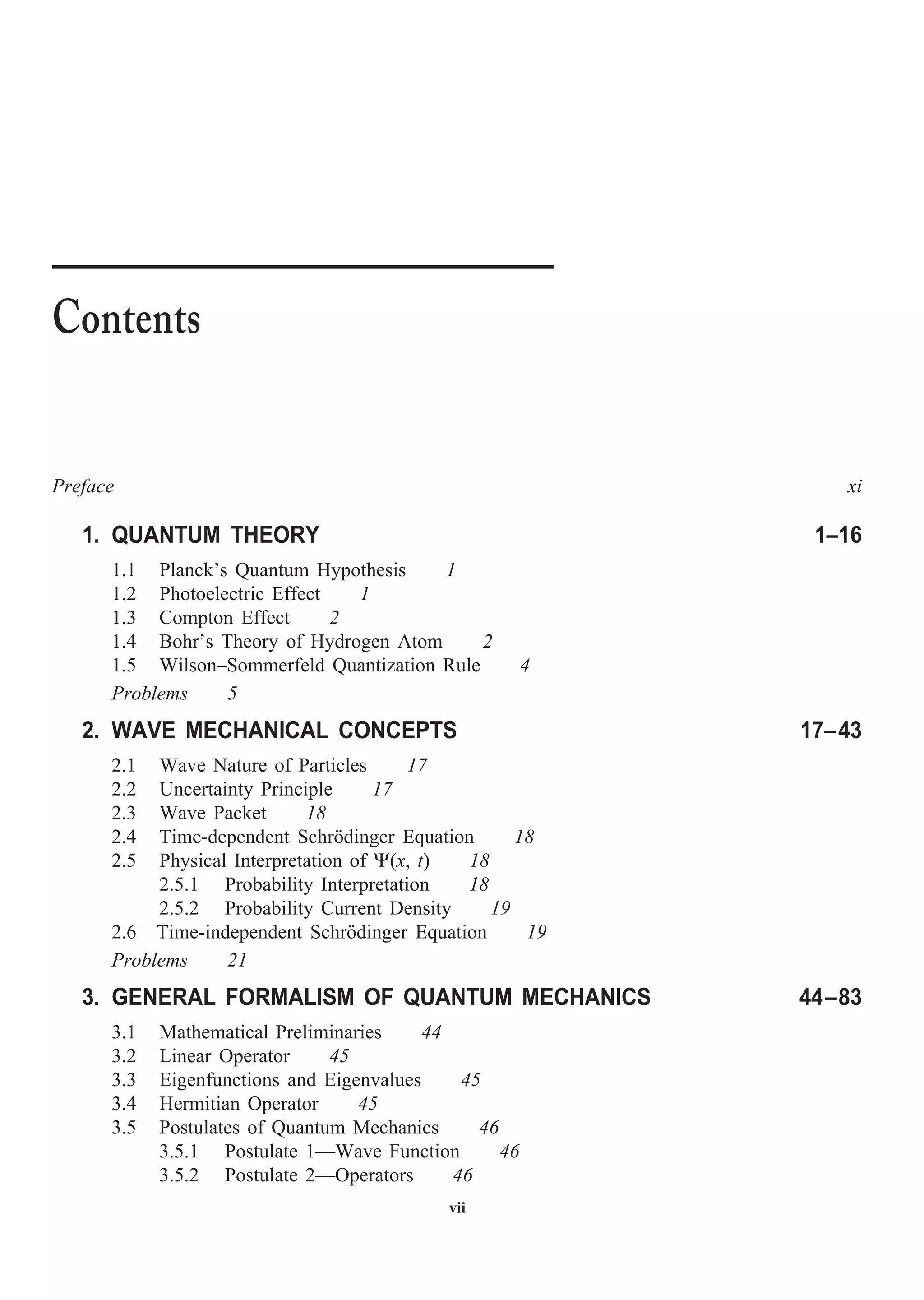
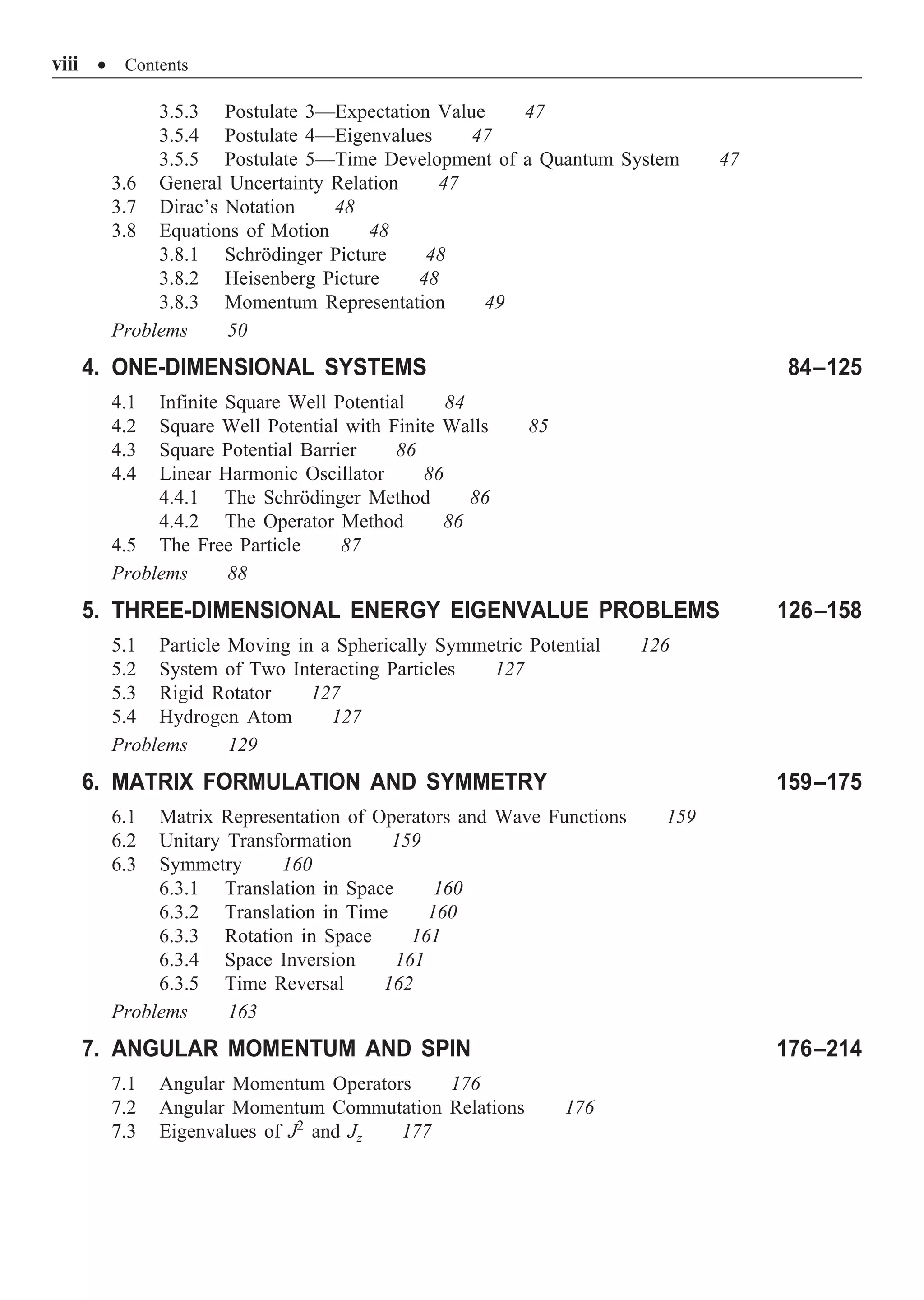
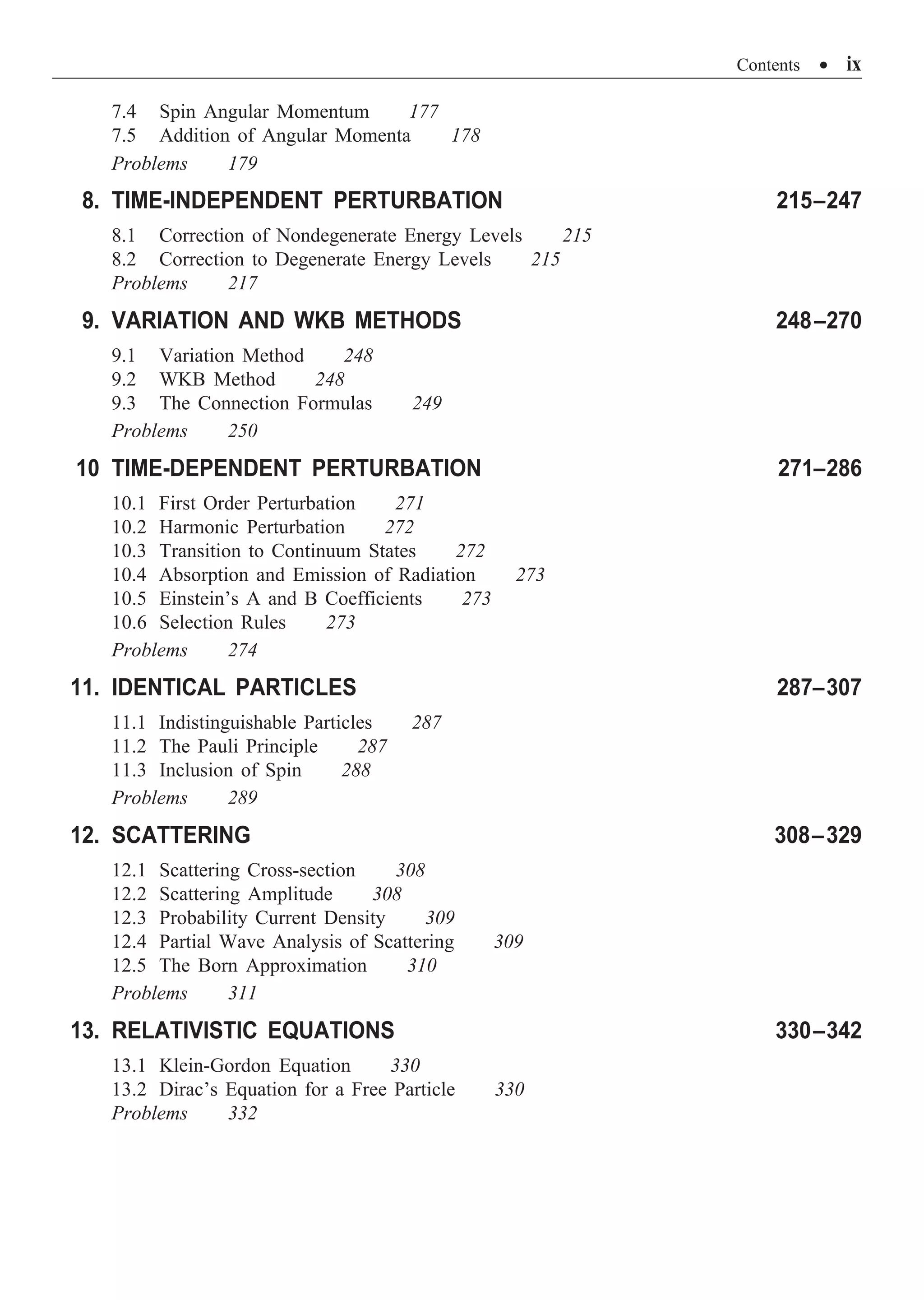
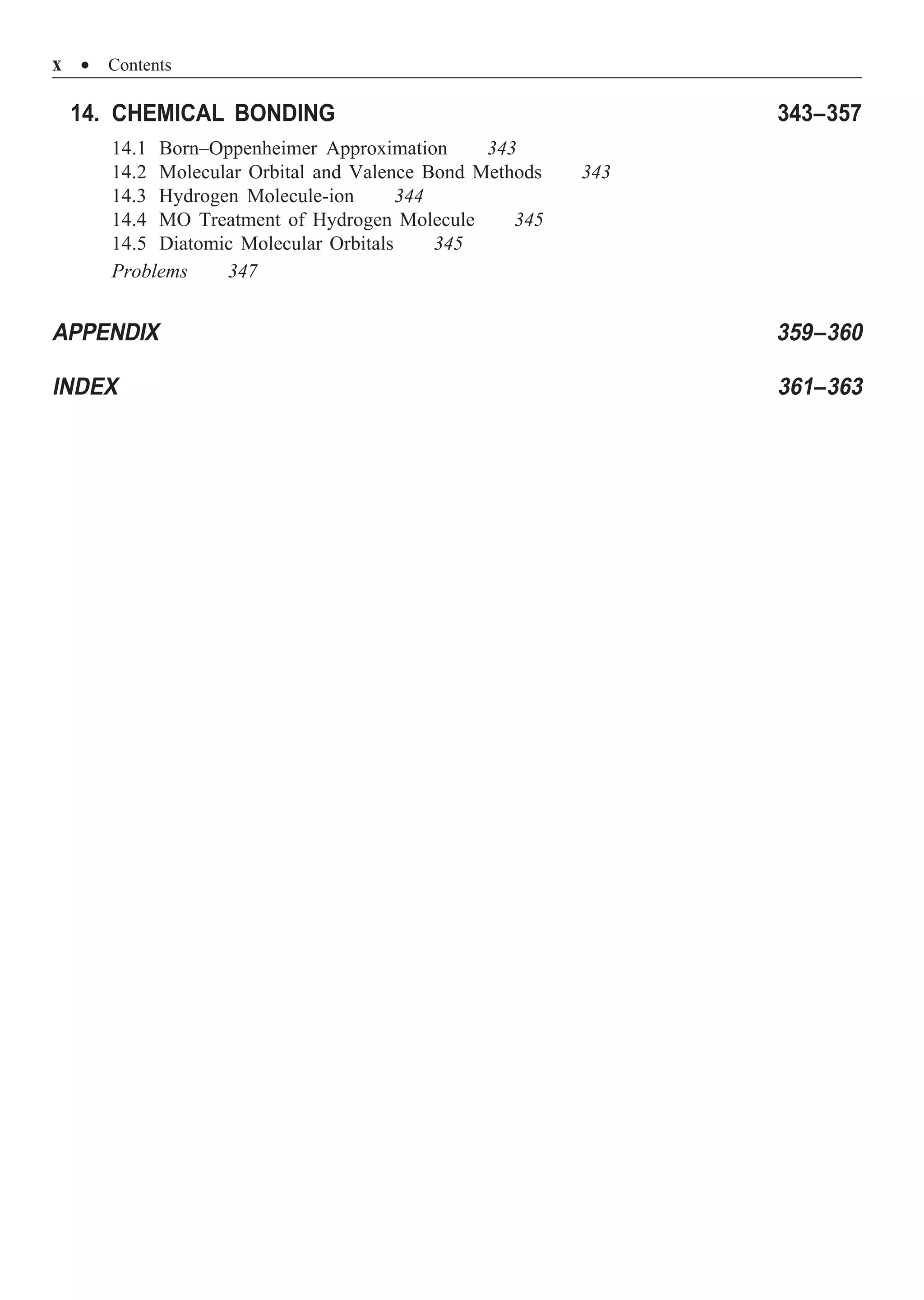

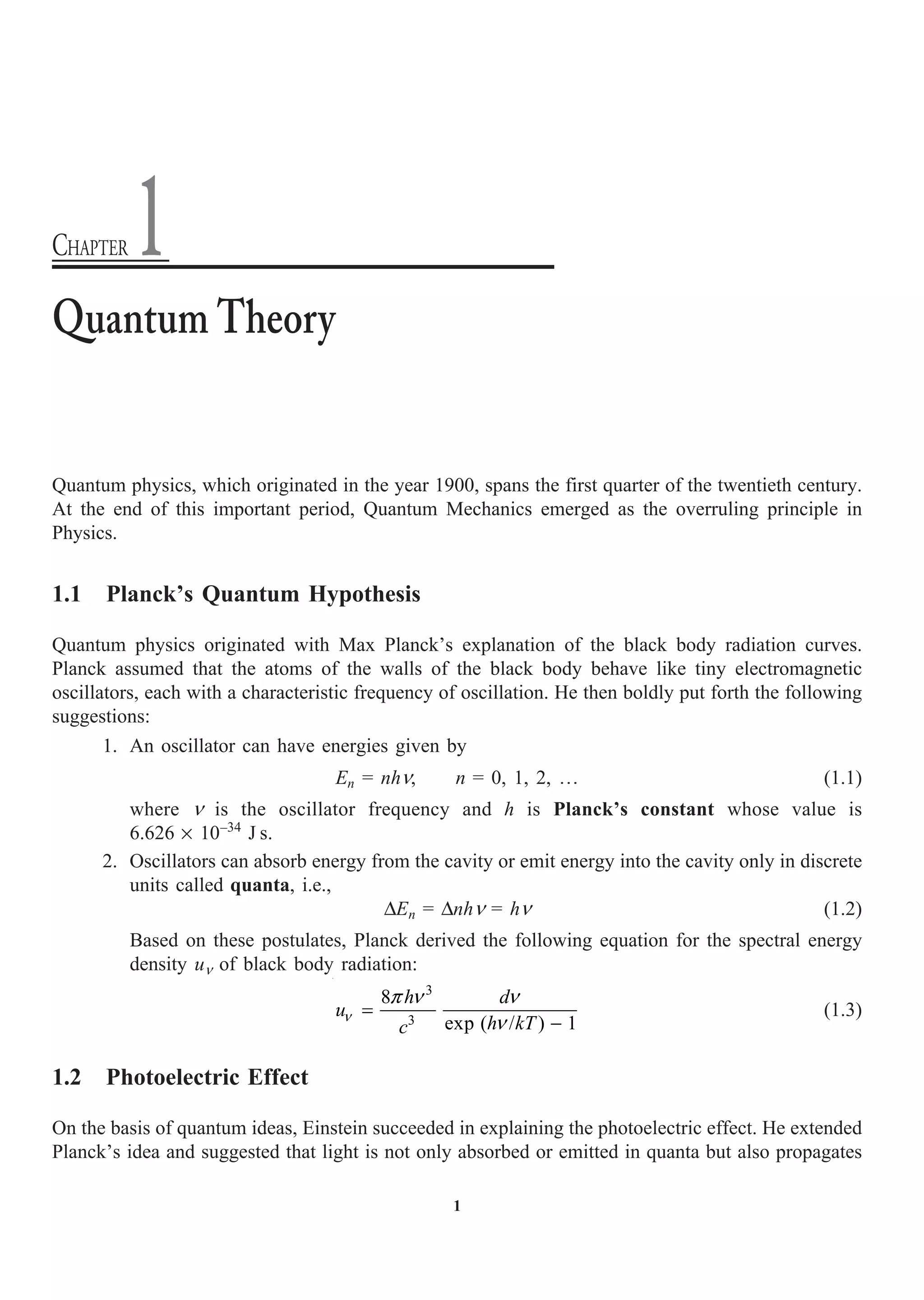


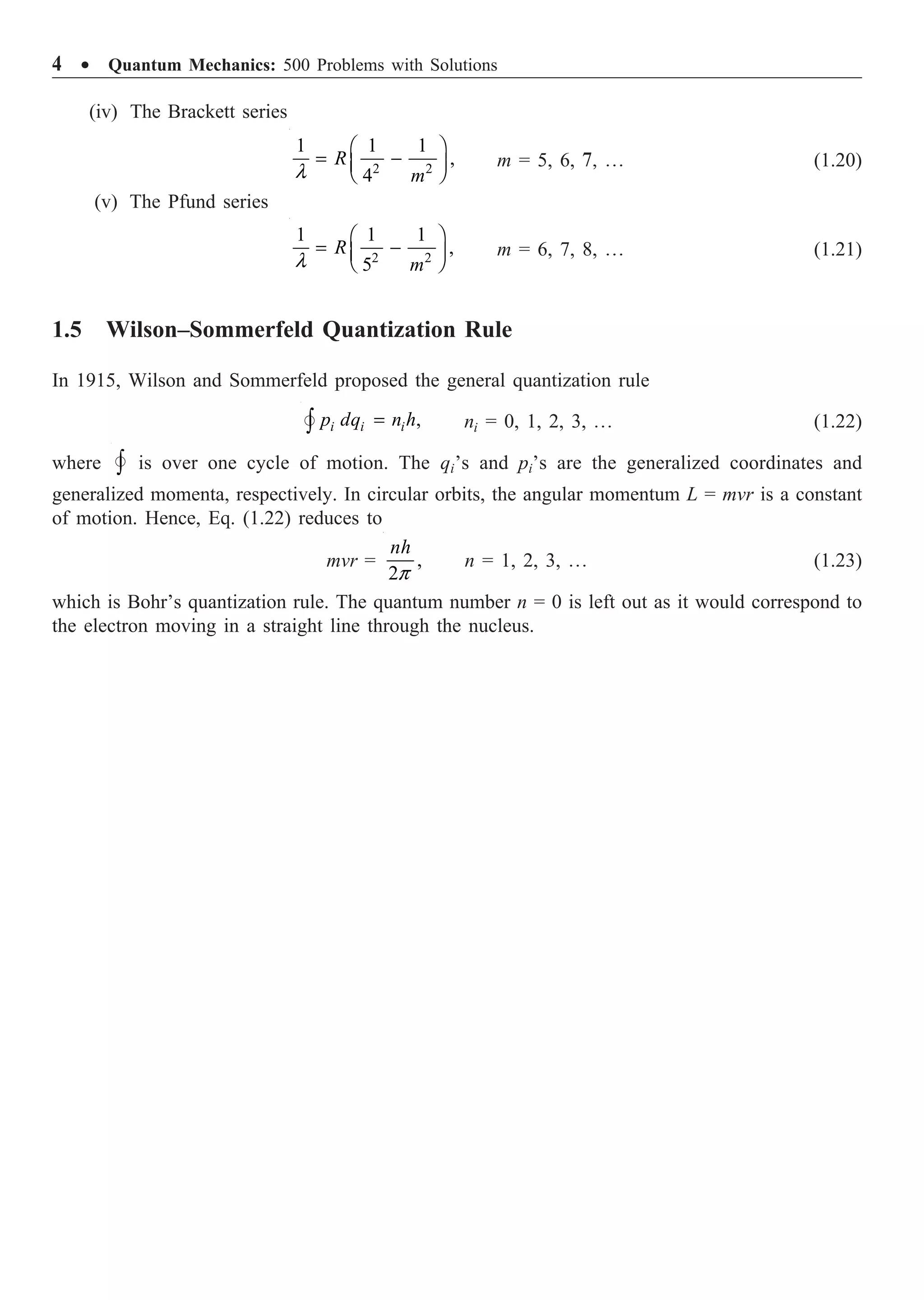
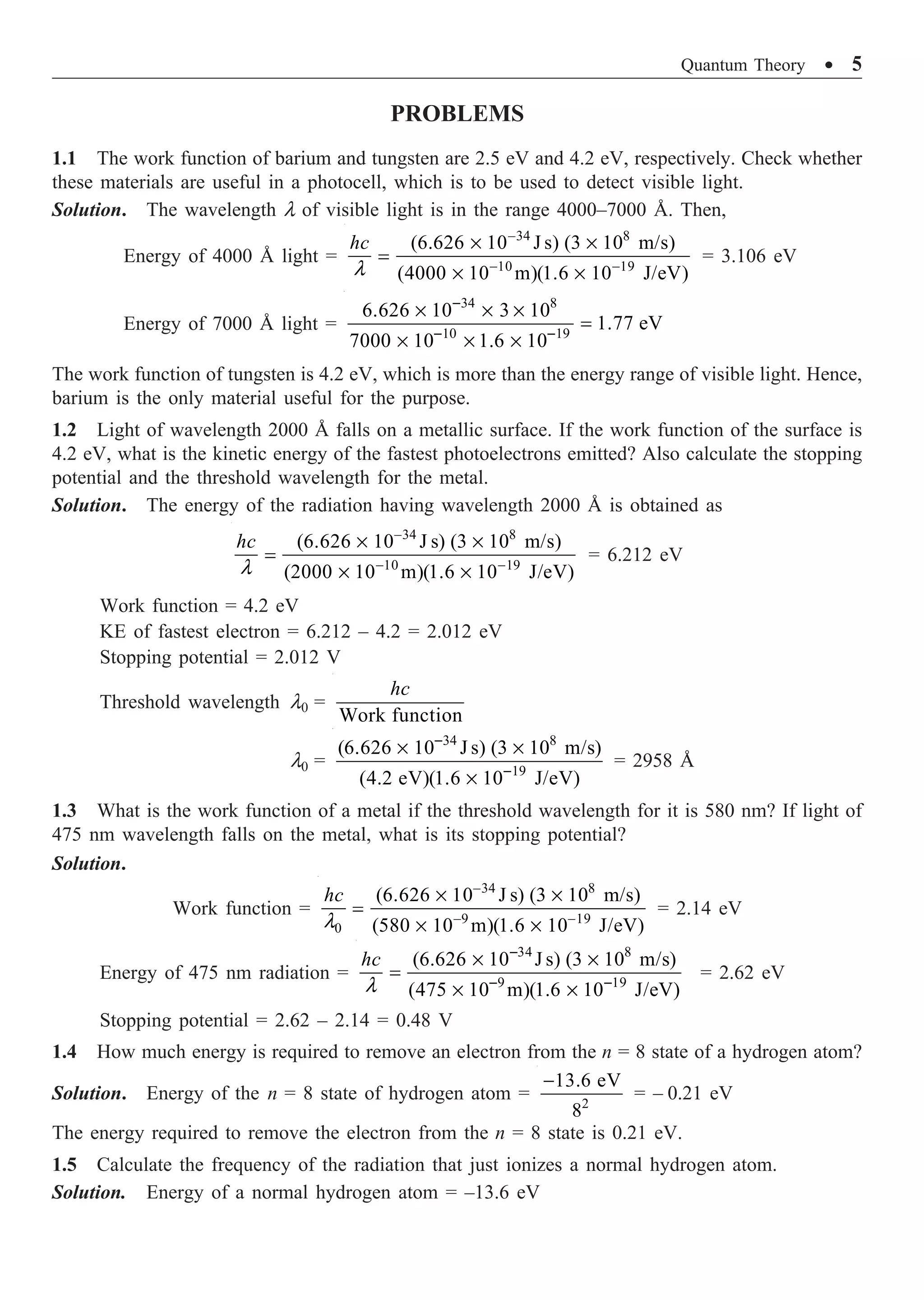
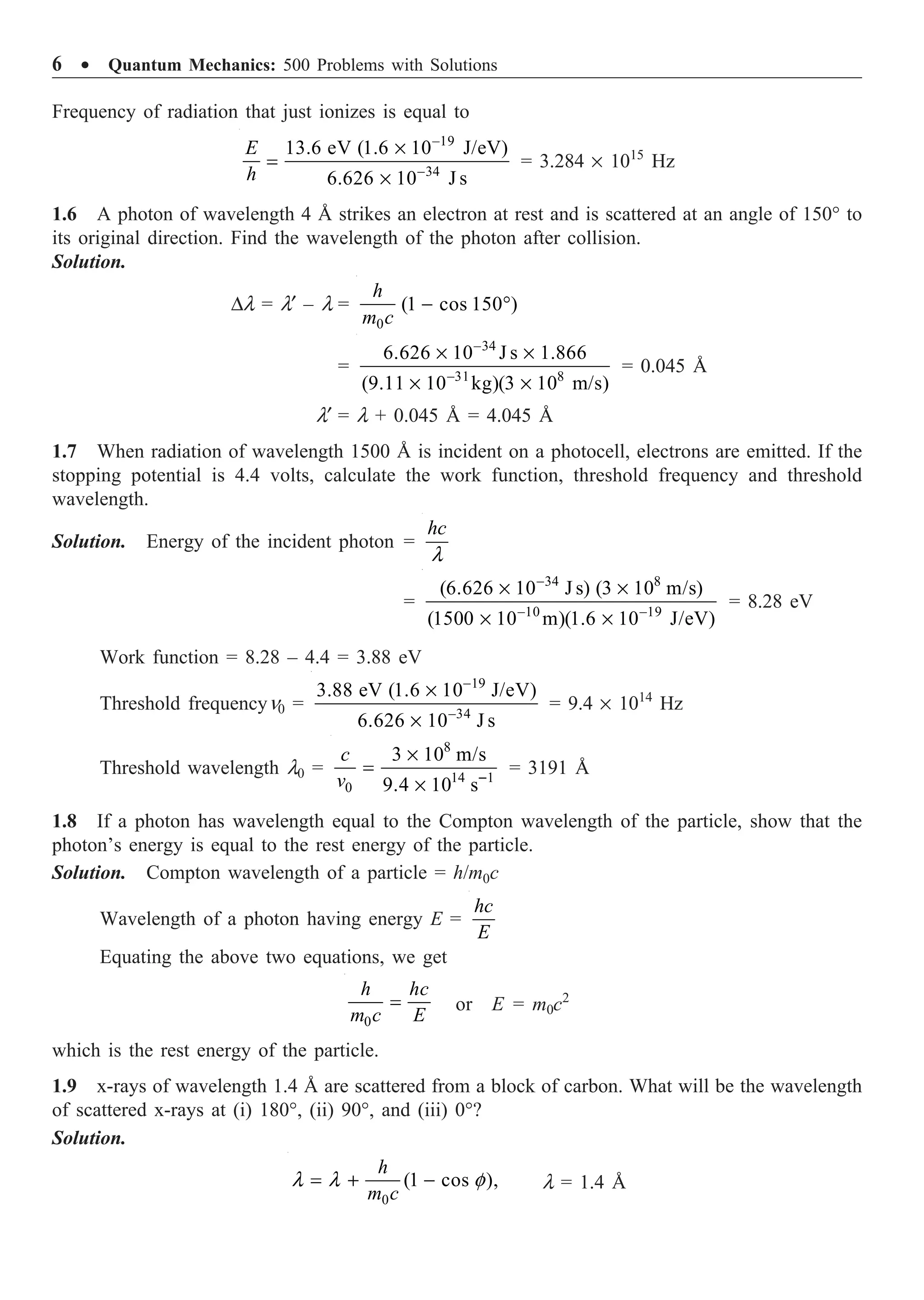
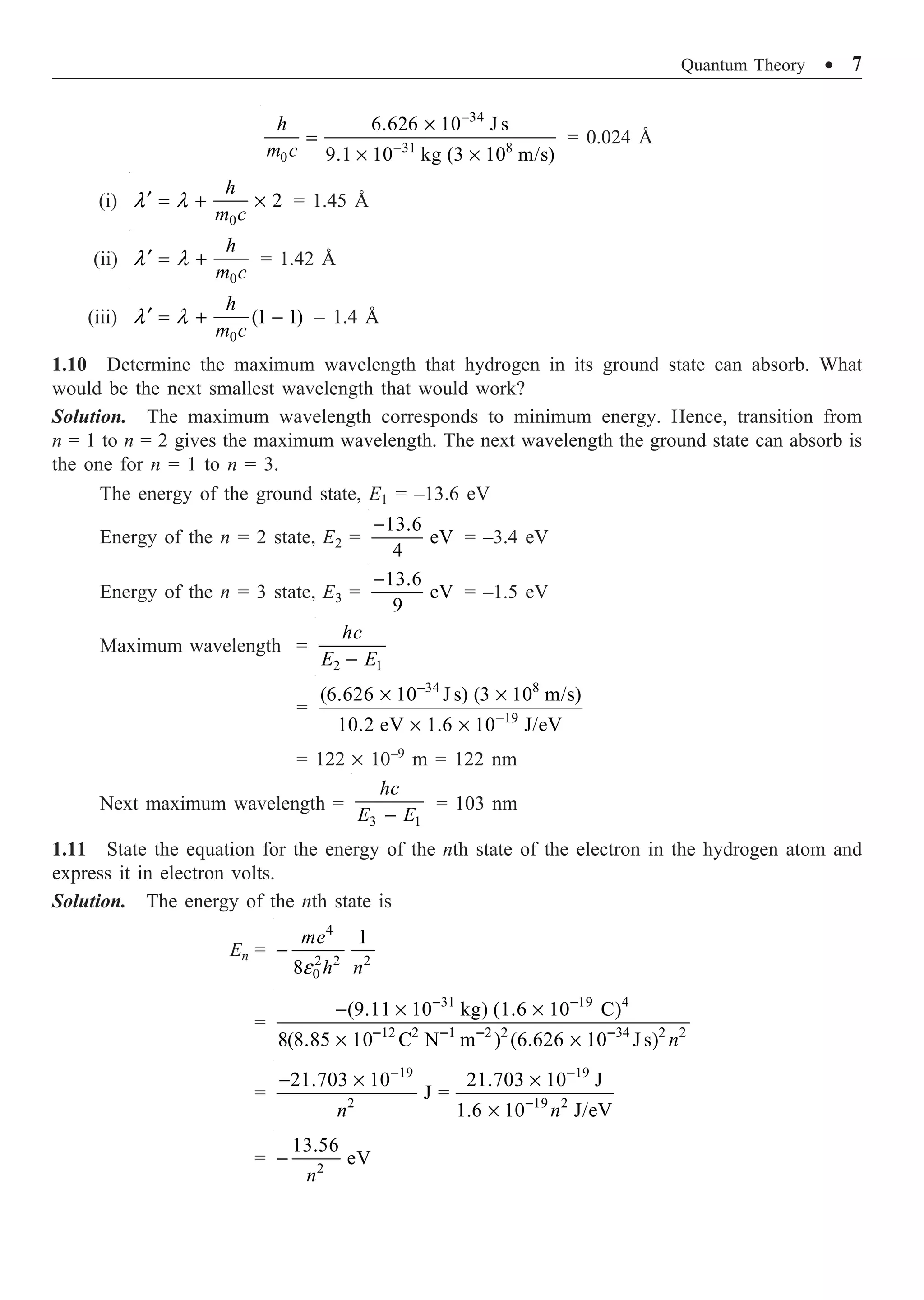
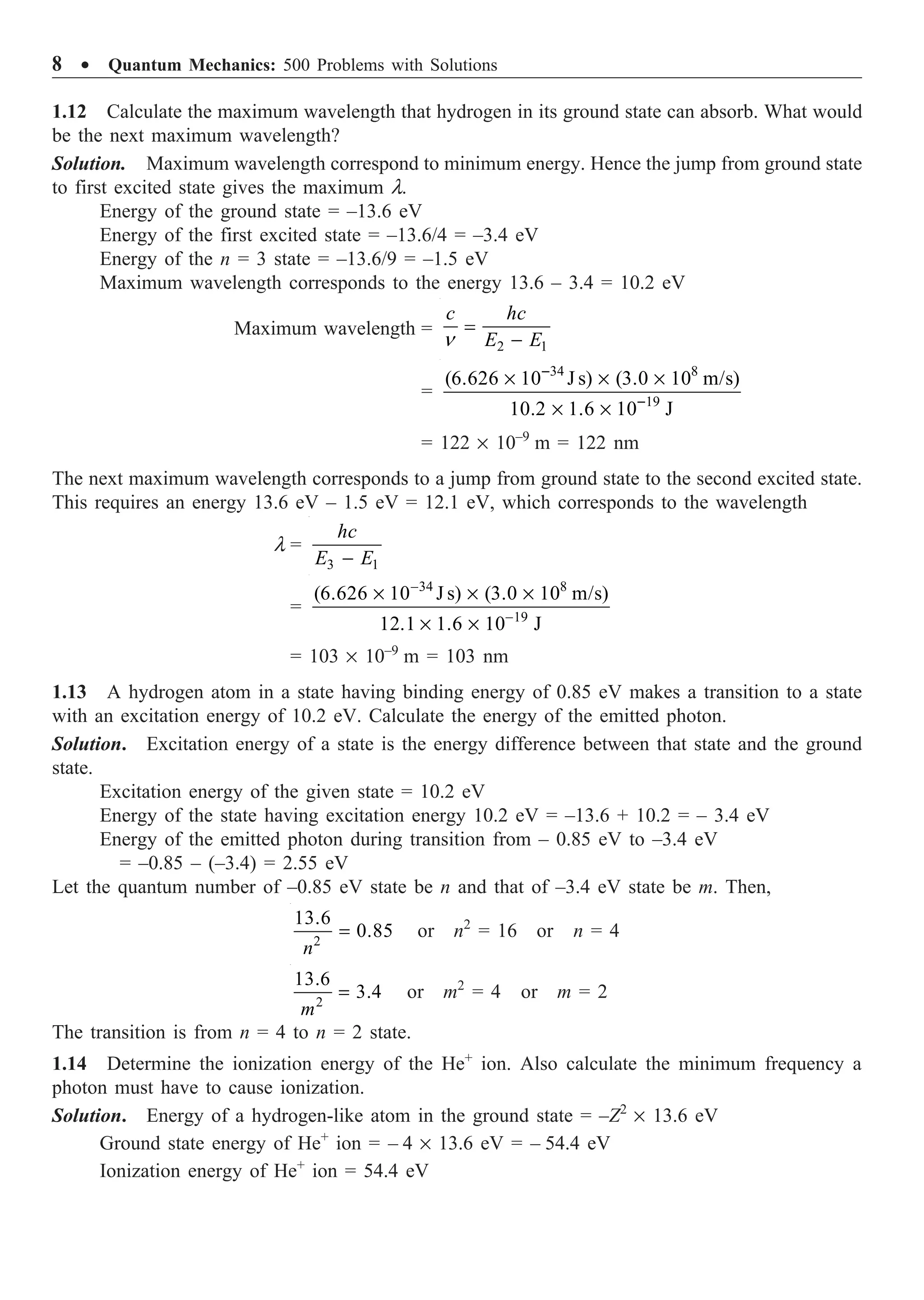
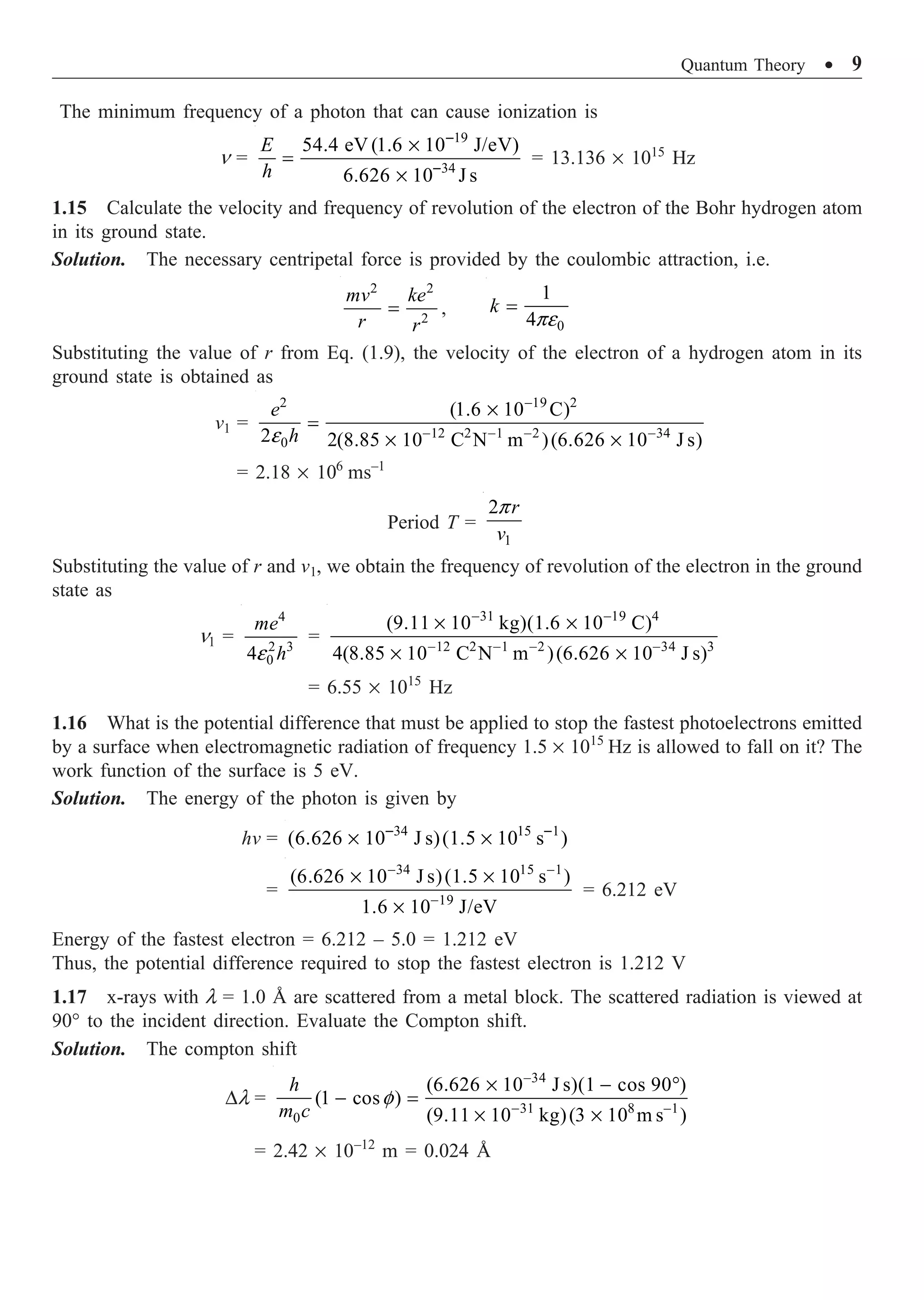
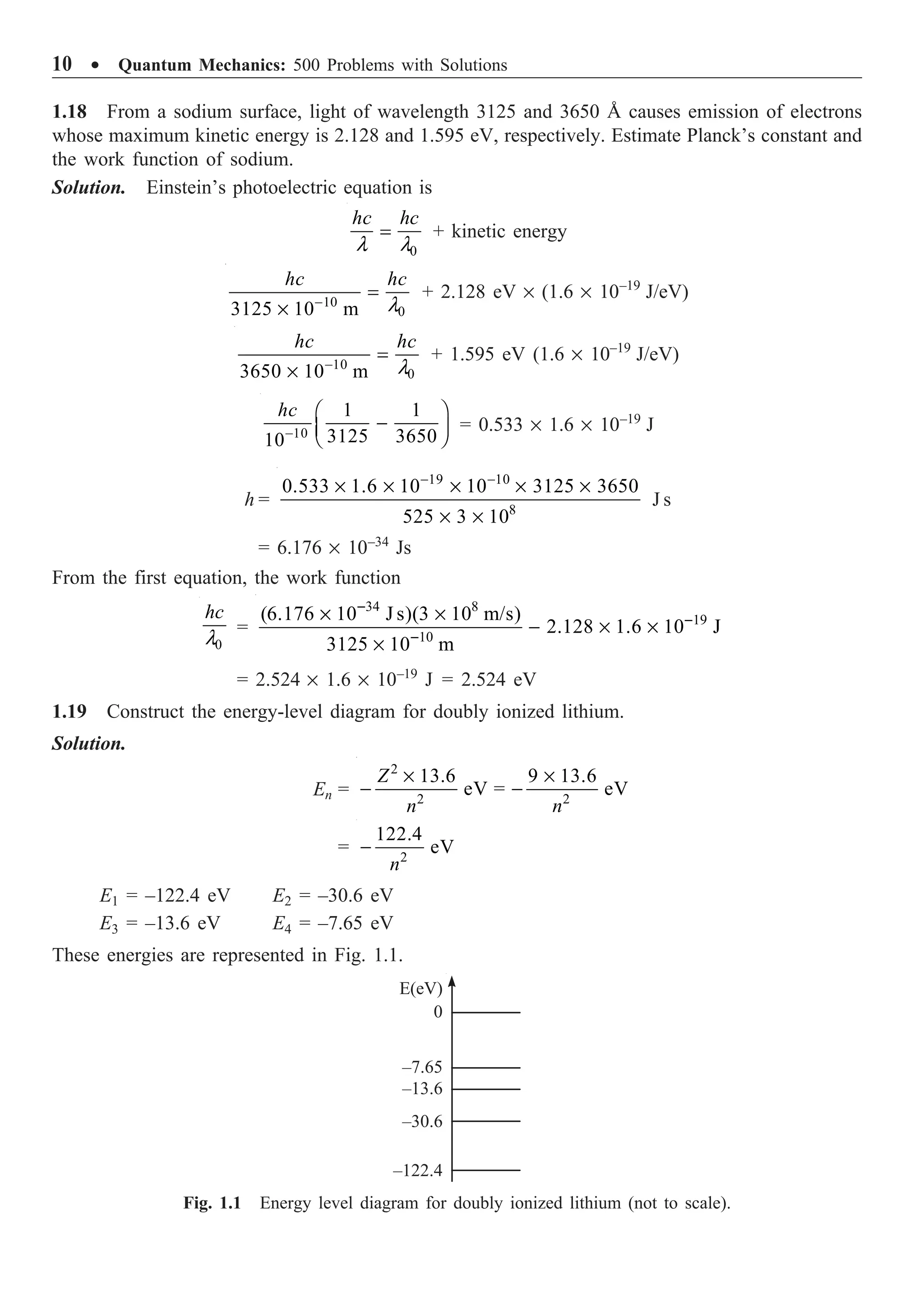
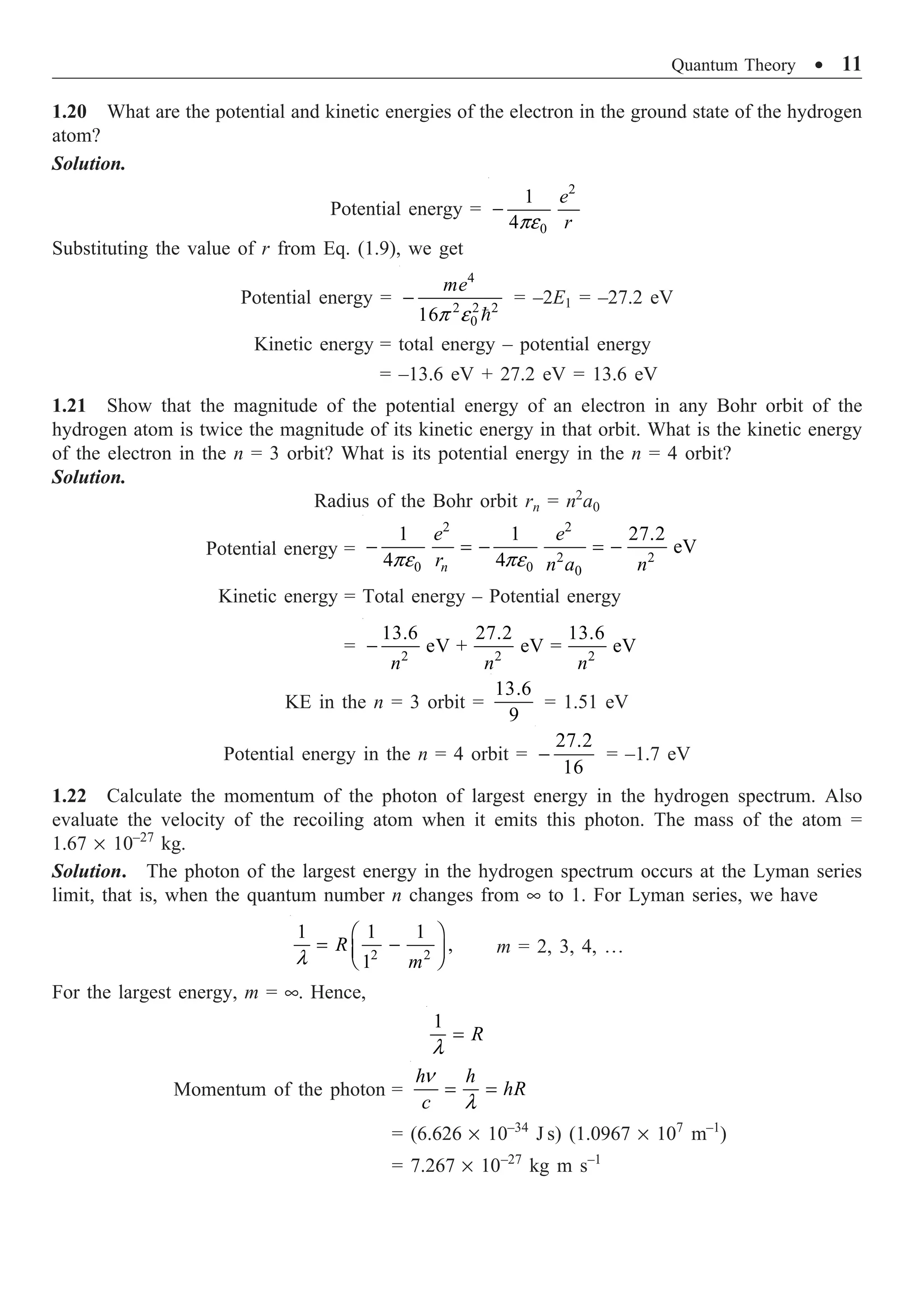

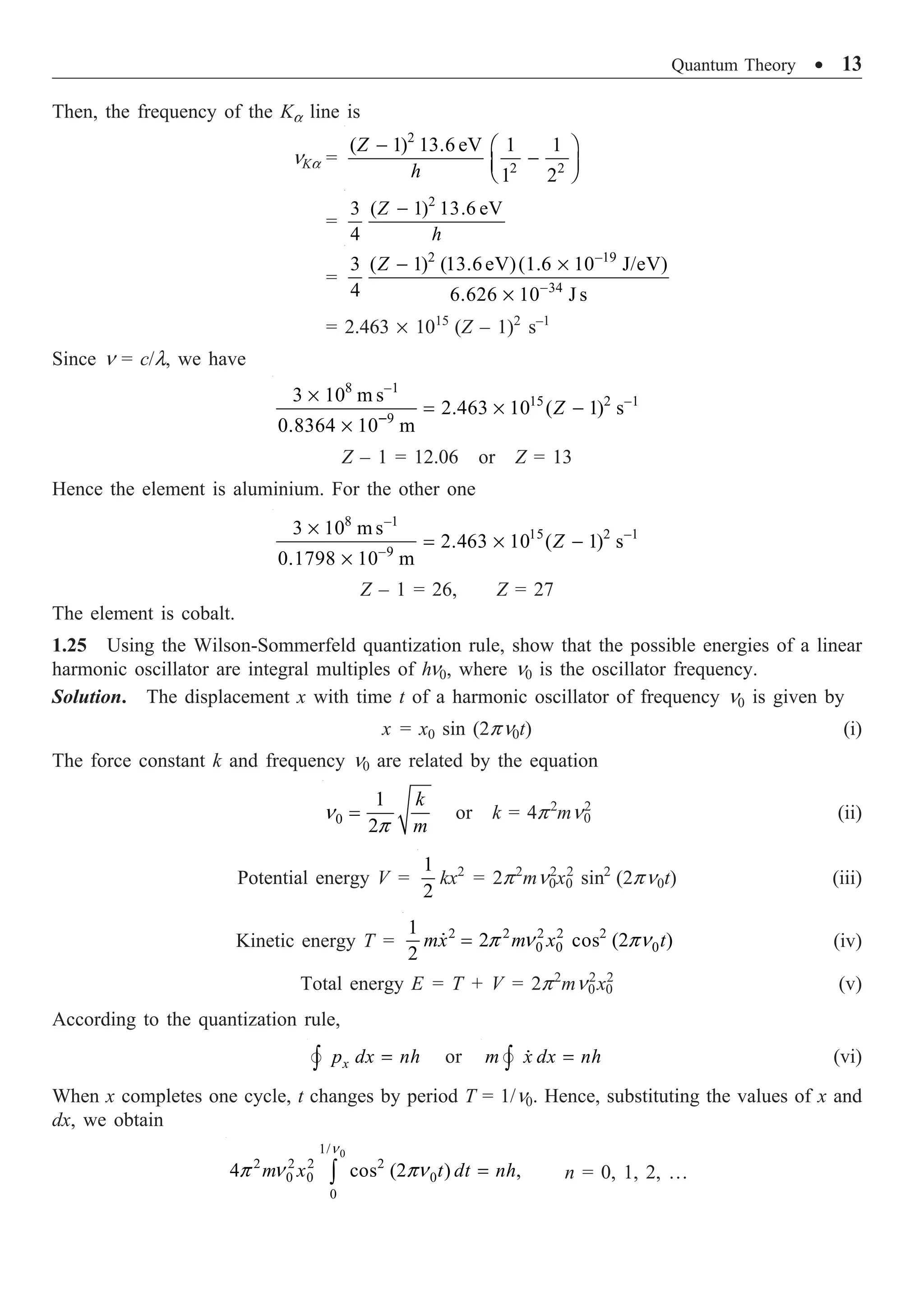
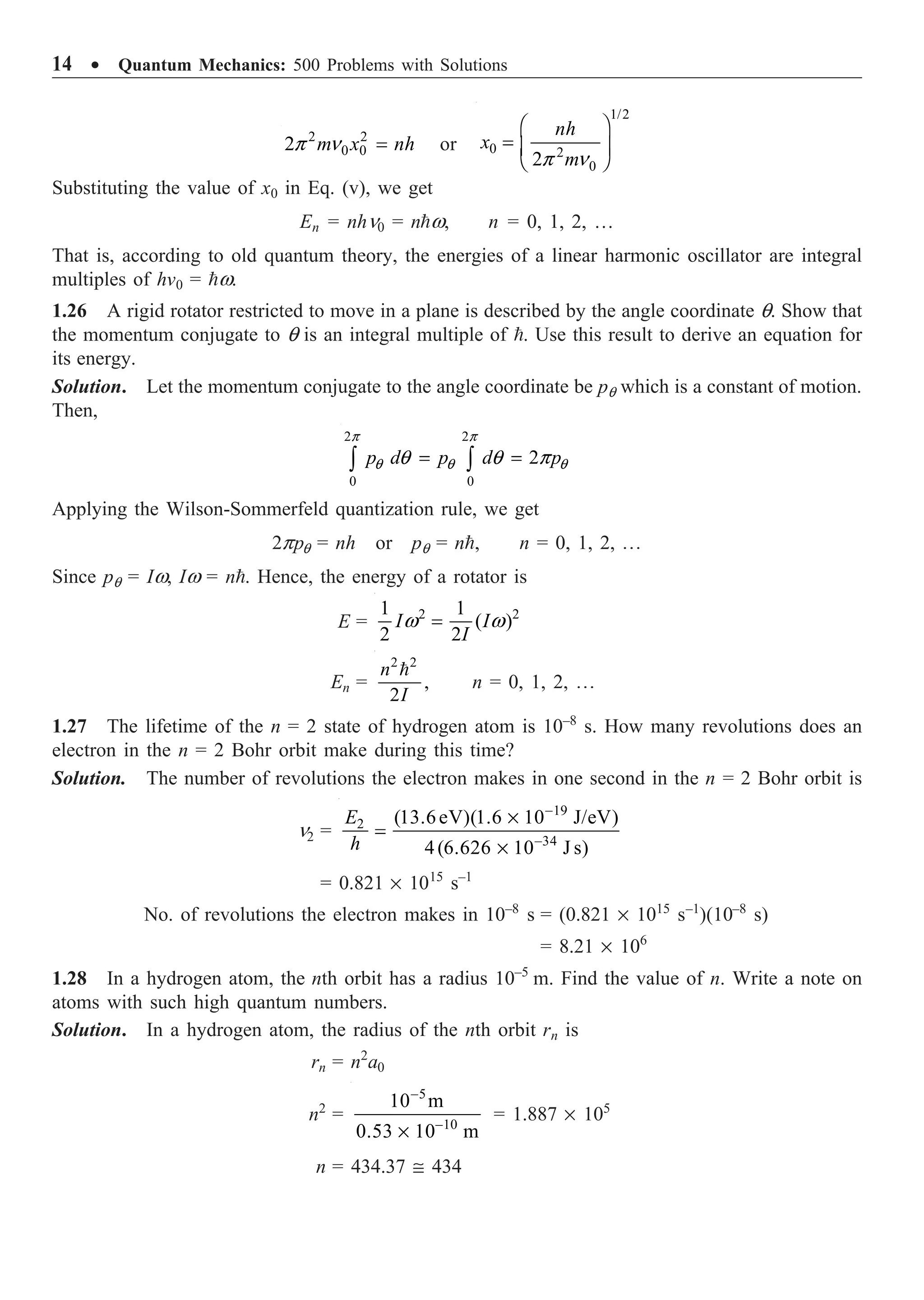
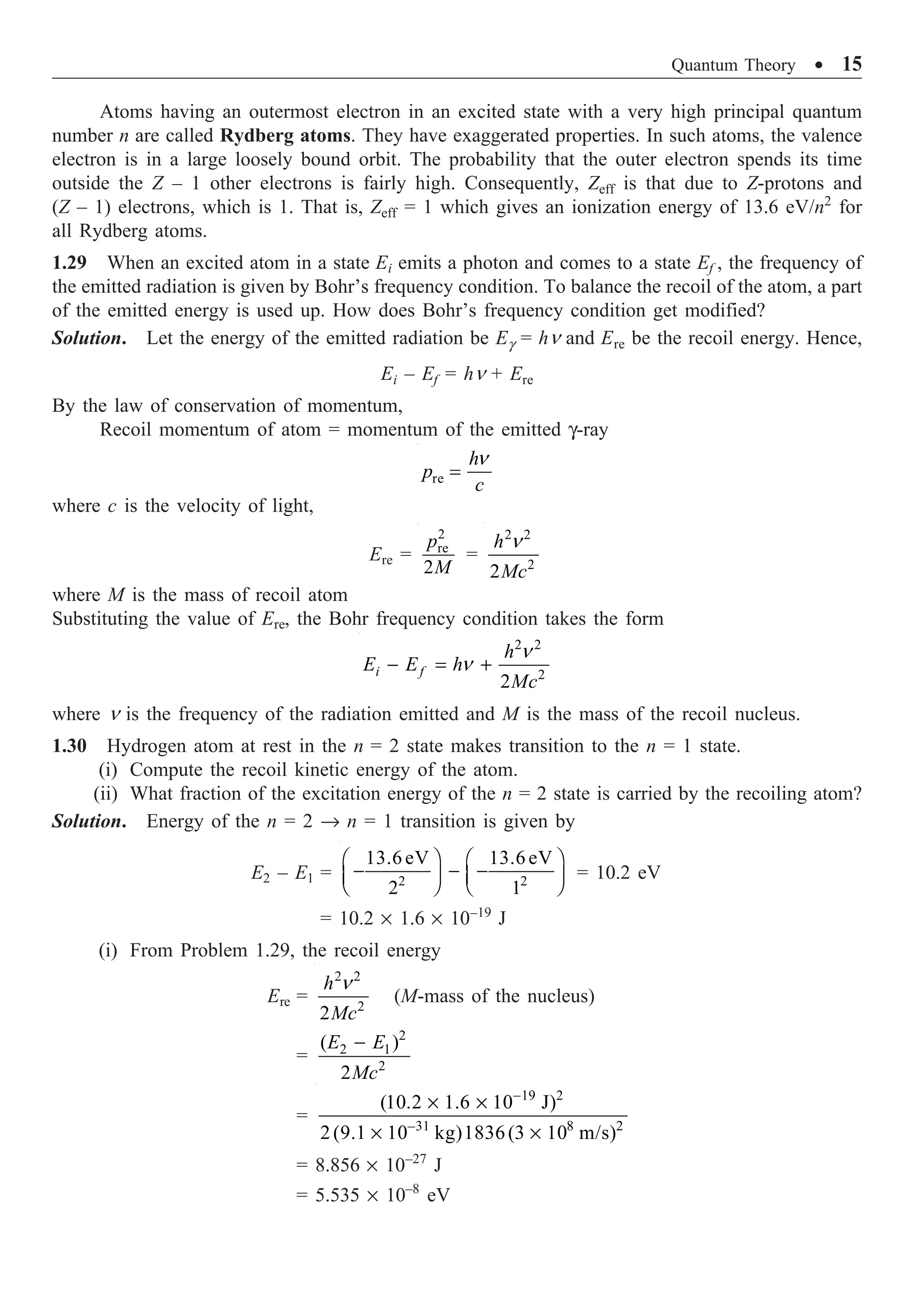
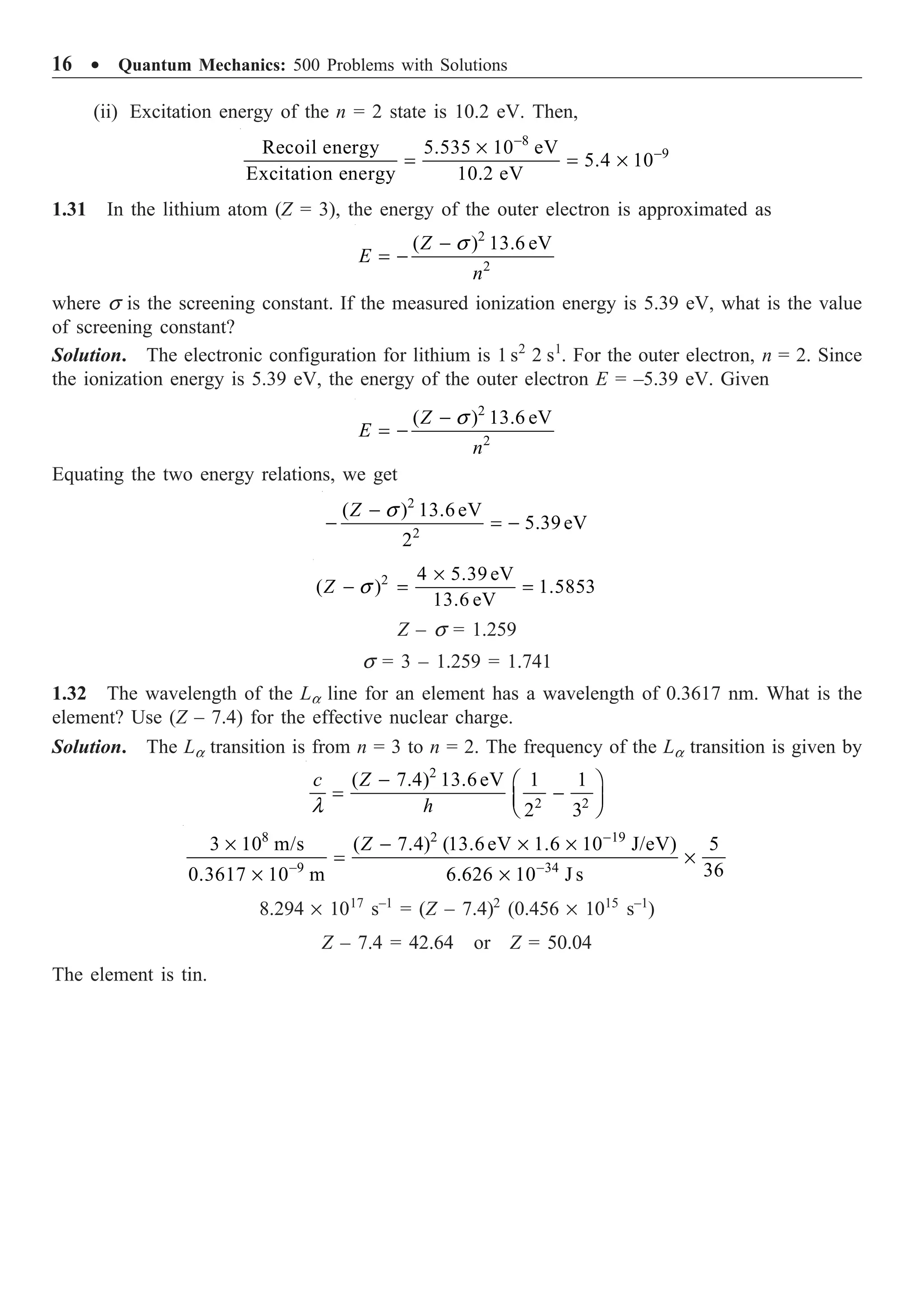

![18 ∑ Quantum Mechanics: 500 Problems with Solutions
2.3 Wave Packet
The linear superposition principle, which is valid for wave motion, is also valid for material particles.
To describe matter waves associtated with particles in motion, we requires a quantity which varies
in space and time. This quantity, called the wave function Y(r, t), is confined to a small region in
space and is called the wave packet or wave group. Mathematically, a wave packet can be
constructed by the superposition of an infinite number of plane waves with slightly differing k-values,
as
( , ) ( ) exp [ ( ) ]
w
Y = -
Ú
x t A k ikx i k t dk (2.6)
where k is the wave vector and w is the angular frequency. Since the wave packet is localized, the
limit of the integral is restricted to a small range of k-values, say, (ko – Dk) k (ko + Dk). The speed
with which the component waves of the wave packet move is called the phase velocity vp which is
defined as
p
k
w
=
v (2.7)
The speed with which the envelope of the wave packet moves is called the group velocity vg given
by
g
d
dk
w
=
v (2.8)
2.4 Time-dependent Schrödinger Equation
For a detailed study of systems, Schrödinger formulated an equation of motion for Y(r, t):
2
( , ) ( ) ( , )
2
∂ È ˘
Y = - — + Y
Í ˙
∂ Î ˚
i t V r t
t m
r r (2.9)
The quantity in the square brackets is called the Hamiltonian operator of the system. Schrödinger
realized that, in the new mechanics, the energy E, the momentum p, the coordinate r, and time t have
to be considered as operators operating on functions. An analysis leads to the following operators for
the different dynamical variables:
∂
Æ
∂
E i
t
, p Æ –i—, r Æ r, t Æ t (2.10)
2.5 Physical Interpretation of Y(r, t)
2.5.1 Probability Interpretation
A universally accepted interpretation of Y(r, t) was suggested by Born in 1926. He interpreted Y*Y
as the position probability density P (r, t):
2
*
( , ) ( , ) ( , ) ( , )
= Y Y = Y
P t t t t
r r r r (2.11)](https://image.slidesharecdn.com/quantummechanics500problemswithsolutionspdfdrive-220626164912-635041ea/75/Quantum-Mechanics_-500-Problems-with-Solutions-PDFDrive-pdf-28-2048.jpg)
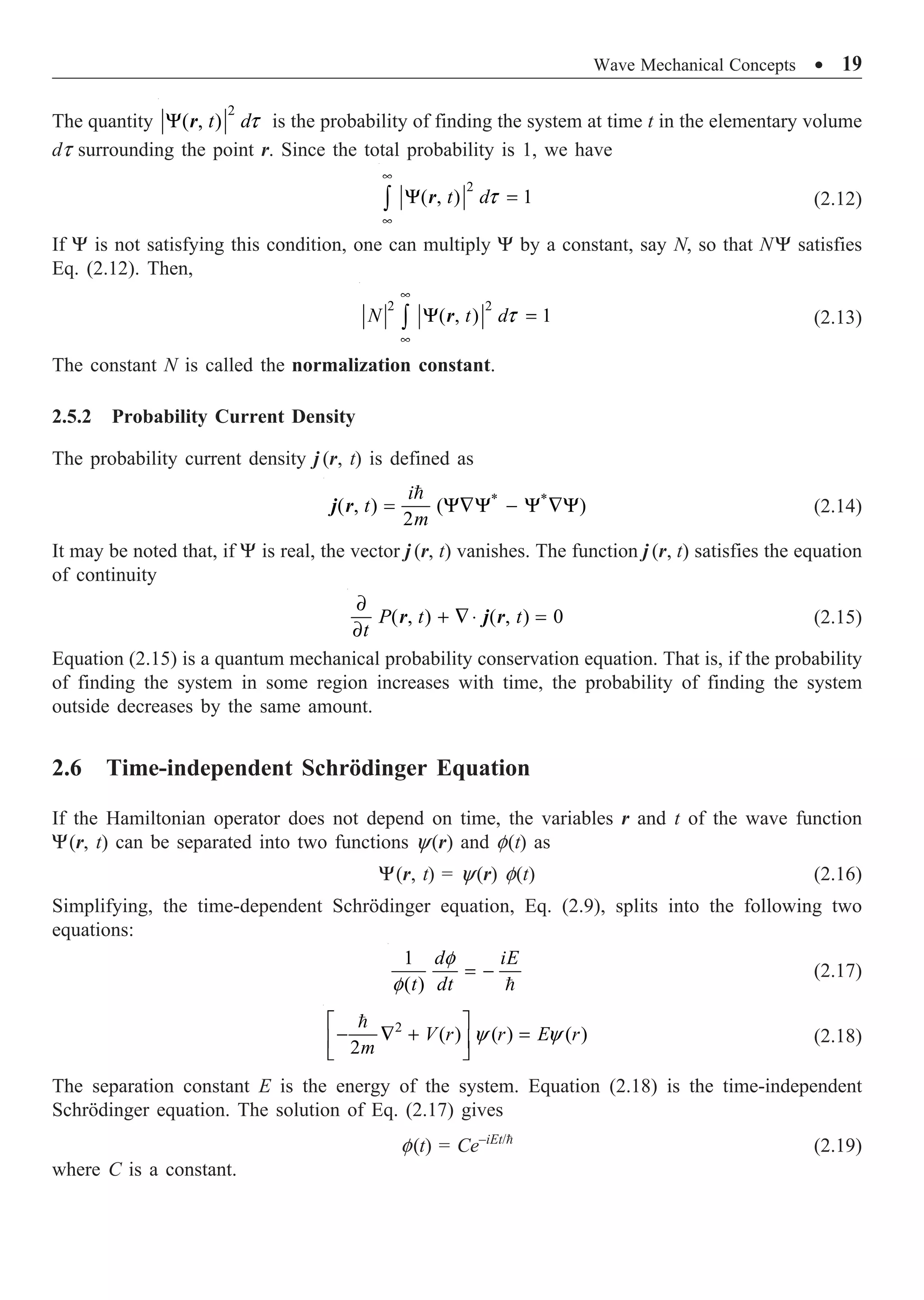
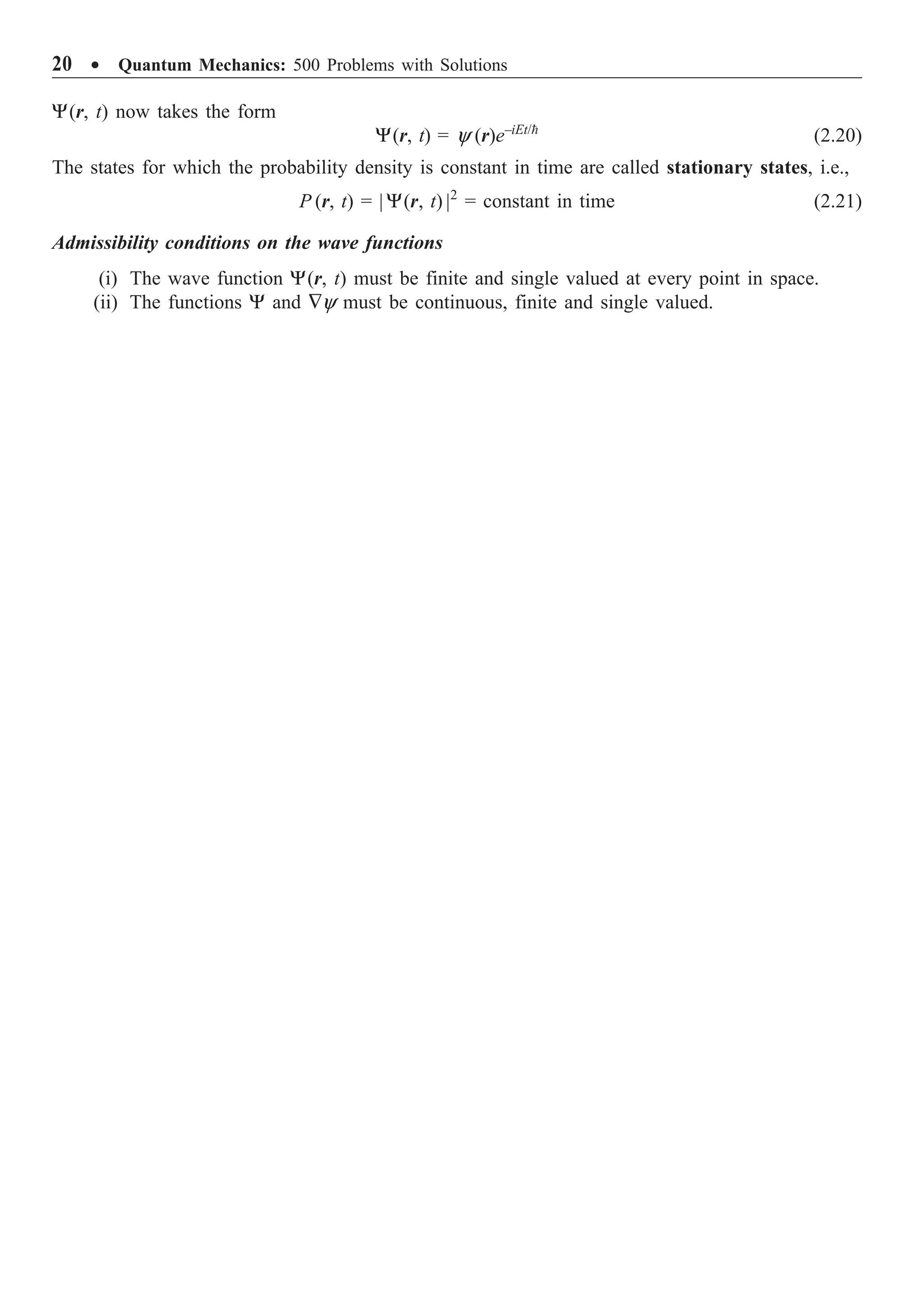
![Wave Mechanical Concepts ∑ 21
PROBLEMS
2.1 Calculate the de Broglie wavelength of an electron having a kinetic energy of 1000 eV.
Compare the result with the wavelength of x-rays having the same energy.
Solution. The kinetic energy
T =
2
2
p
m
= 1000 eV = 1.6 ¥ 10–16
J
l =
34
31 16 1/2
6.626 10 js
[2 (9.11 10 kg) (1.6 10 J]
-
- -
¥
=
¥ ¥ ¥ ¥
h
p
= 0.39 ¥ 10–10
m = 0.39 Å
For x-rays,
Energy =
l
hc
l =
34 8
16
(6.626 10 J s) (3 10 m/s)
1.6 10 J
-
-
¥ ¥ ¥
¥
= 12.42 ¥ 10–10
m = 12.42 Å
Wavelength of x-rays 12.42 Å
de Broglie wavelength of electron 0.39 Å
= = 31.85
2.2 Determine the de Broglie wavelength of an electron that has been accelerated through a
potential difference of (i) 100 V, (ii) 200 V.
Solution.
(i) The energy gained by the electron = 100 eV. Then,
2
2
p
m
= 100 eV = (100 eV)(1.6 ¥ 10–19
J/eV) = 1.6 ¥ 10–17
J
p = [2 (9.1 ¥ 10–13
kg)(1.6 ¥ 10–17
J)]1/2
= 5.396 ¥ 10–24
kg ms–1
l =
34
24 1
6.626 10 J s
5.396 10 kg ms
-
- -
¥
=
¥
h
p
= 1.228 ¥ 10–10
m = 1.128 Å
(ii)
2
2
p
m
= 200 eV = 3.2 ¥ 10–17
J
p = [2 (9.1 ¥ 10–31
kg)(3.2 ¥ 10–17
J)]1/2
= 7.632 ¥ 10–24
kg ms–1
l =
34
24 1
6.626 10 J s
7.632 10 kg ms
-
- -
¥
=
¥
h
p
= 0.868 ¥ 10–10
m = 0.868 Å](https://image.slidesharecdn.com/quantummechanics500problemswithsolutionspdfdrive-220626164912-635041ea/75/Quantum-Mechanics_-500-Problems-with-Solutions-PDFDrive-pdf-31-2048.jpg)
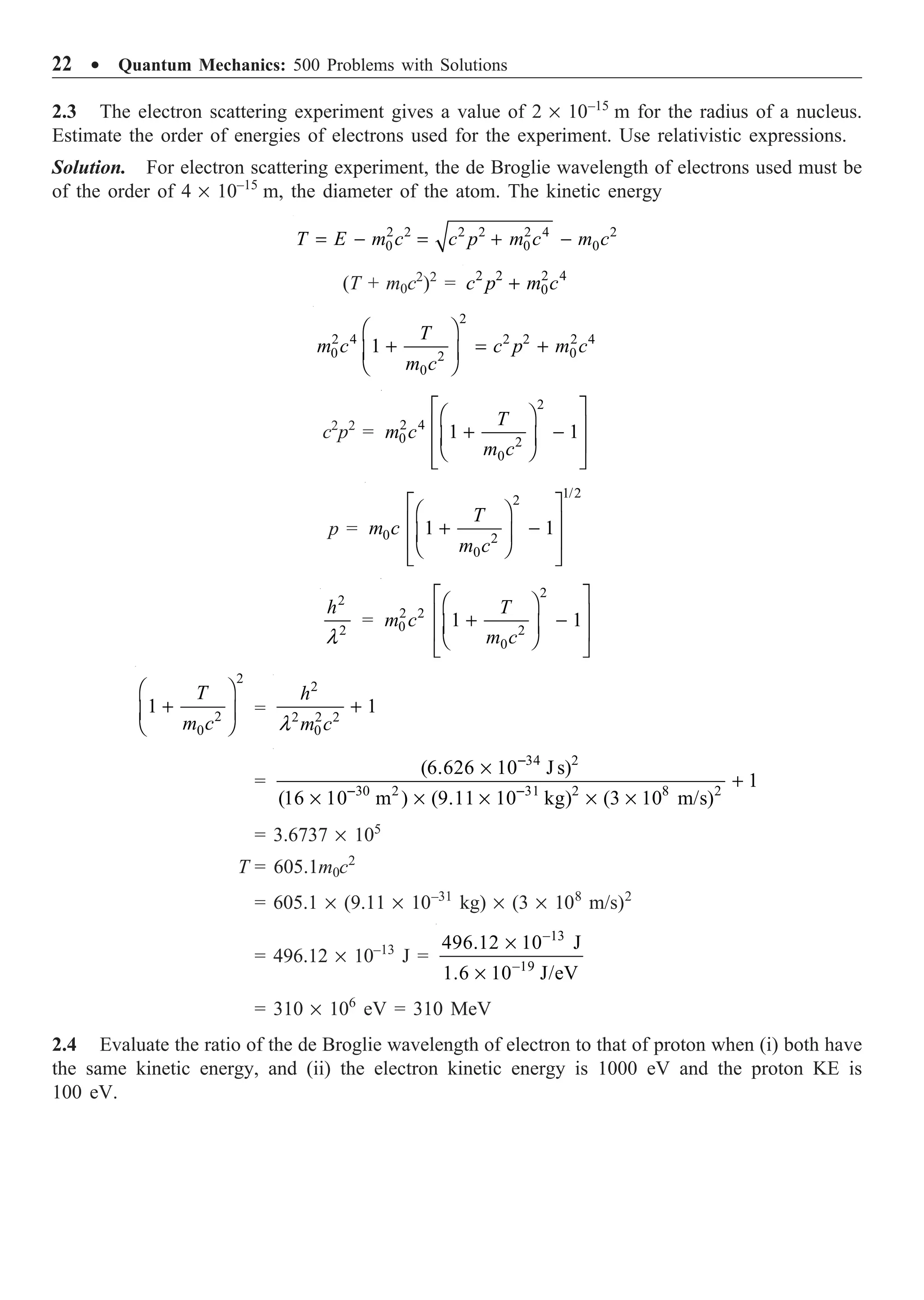
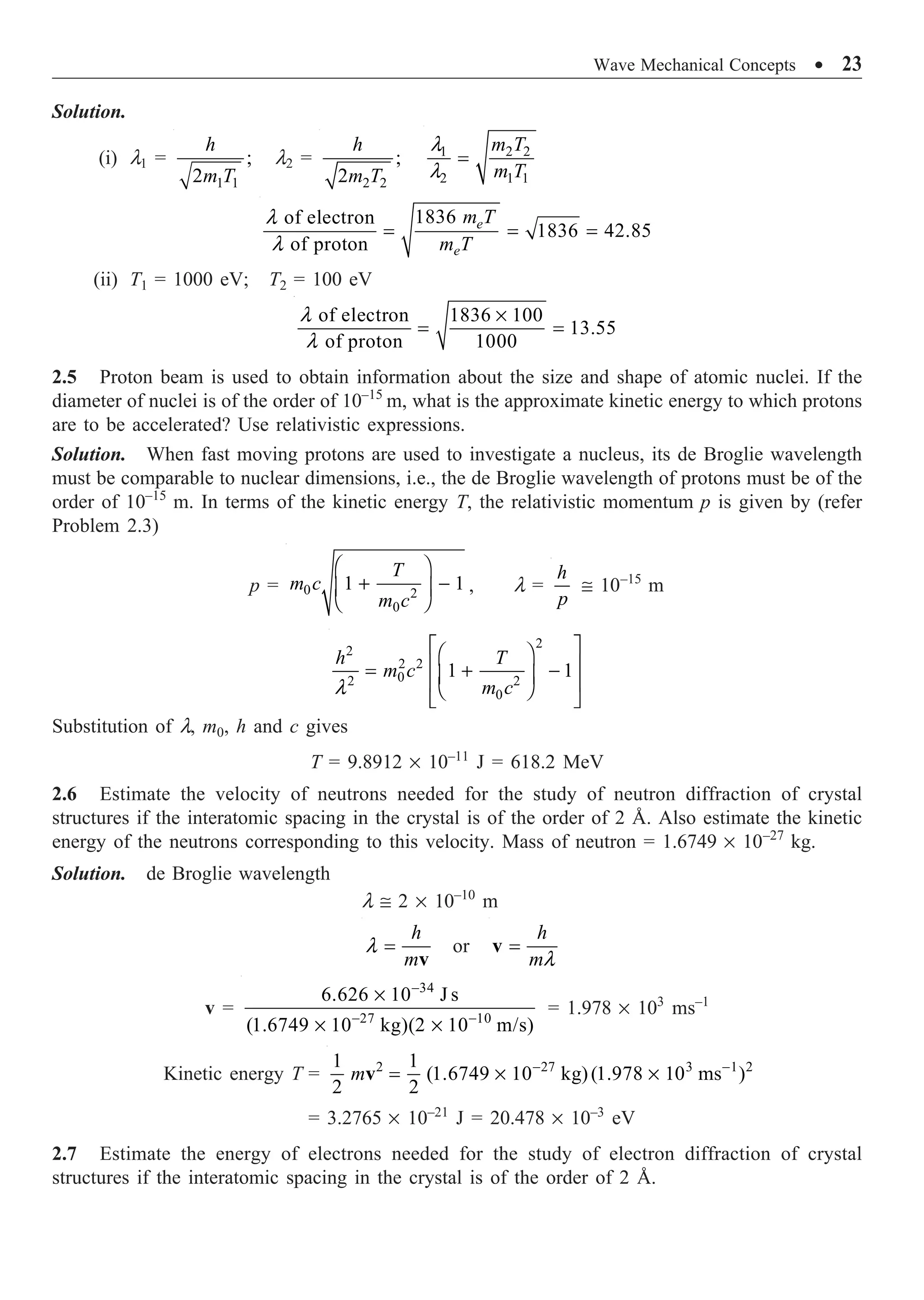
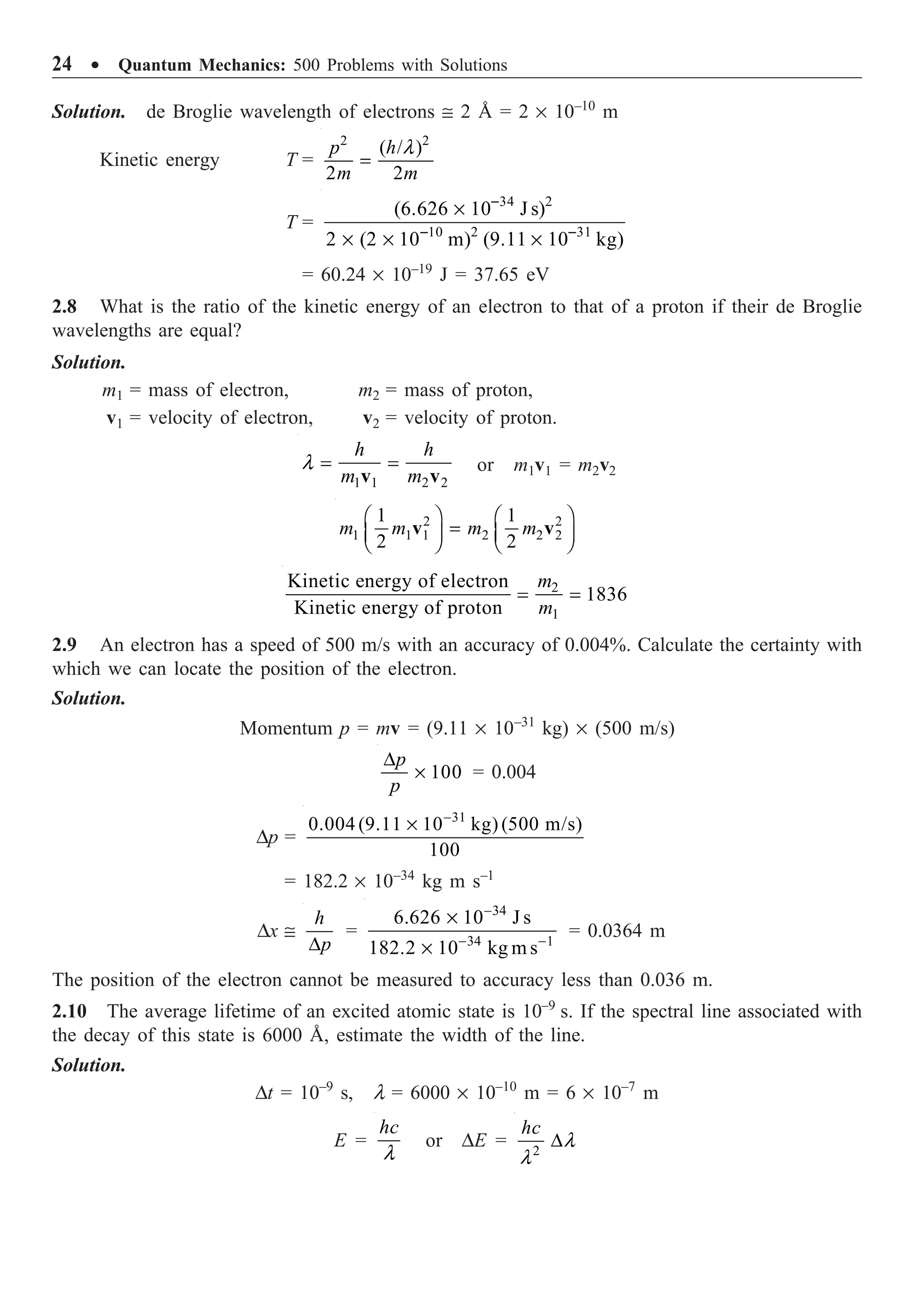
![Wave Mechanical Concepts ∑ 25
DE ◊ Dt = 2 2 4
l
p
l
D ◊ D ª =
hc h
t
Dl =
2 14 2
14
8 9
36 10 m
9.5 10 m
4 4 (3 10 m/s) (10 s)
l
p p
-
-
-
¥
= = ¥
D ¥ ¥
c t
2.11 An electron in the n = 2 state of hydrogen remains there on the average of about 10–8
s, before
making a transition to n = 1 state.
(i) Estimate the uncertainty in the energy of the n = 2 state.
(ii) What fraction of the transition energy is this?
(iii) What is the wavelength and width of this line in the spectrum of hydrogen atom?
Solution. From Eq. (2.4),
(i)
4p
D ≥
D
h
E
t
=
34
8
6.626 10 J s
4 10 s
p
-
-
¥
¥
= 0.527 ¥ 10–26
J = 3.29 ¥ 10–8
eV
(ii) Energy of n = 2 Æ n = 1 transition
= 2 2
1 1
13.6 eV 10.2 eV
2 1
Ê ˆ
- - =
Á ˜
Ë ¯
Fraction
8
9
3.29 10 eV
3.23 10
10.2 eV
-
-
D ¥
= = ¥
E
E
(iii) l =
hc
E
=
34 8
19
(6.626 10 J s) (3 10 m/s)
(10.2 1.6 10 J)
-
-
¥ ¥ ¥
¥ ¥
= 1.218 ¥ 10–7
m = 122 nm
l
l
D D
=
E
E
or l l
D
D = ¥
E
E
Dl = (3.23 ¥ 10–9
) (1.218 ¥ 10–7
m)
= 3.93 ¥ 10–16
m = 3.93 ¥ 10–7
nm
2.12 An electron of rest mass m0 is accelerated by an extremely high potential of V volts. Show
that its wavelength
2 1/2
0
[eV (eV + 2 )]
l =
hc
m c
Solution. The energy gained by the electron in the potential is Ve. The relativistic expression for
kinetic energy =
2
2
0
0
2 2 1/2
(1 / )
m c
m c
c
-
- v
. Equating the two and rearranging, we get
2
2
0
0
2 2 1/2
(1 / )
m c
m c Ve
c
- =
- v
2
2 2 1/2 0
2
0
(1 / )
m c
c
Ve m c
- =
+
v](https://image.slidesharecdn.com/quantummechanics500problemswithsolutionspdfdrive-220626164912-635041ea/75/Quantum-Mechanics_-500-Problems-with-Solutions-PDFDrive-pdf-35-2048.jpg)
![26 ∑ Quantum Mechanics: 500 Problems with Solutions
2 4
2
0
2 2 2
0
1
( )
m c
c Ve m c
- =
+
v
2
2
c
v
=
2 2 2 4 2
0 0 0
2 2 2 2
0 0
( ) ( 2 )
( ) ( )
+ - +
=
+ +
Ve m c m c Ve Ve m c
Ve m c Ve m c
v =
2 1/2
0
2
0
[ ( 2 )]
+
+
c Ve Ve m c
Ve m c
de Broglie Wavelength l =
2 2 1/2
0
(1 / )
h h c
m m
-
=
v
v v
l =
2 2
0 0
2 2 1/2
0 0 0
[ ( 2 )]
+
+ +
m c Ve m c
h
m Ve m c c Ve Ve m c
= 2 1/2
0
[ ( 2 )]
+
hc
Ve Ve m c
2.13 A subatomic particle produced in a nuclear collision is found to have a mass such that Mc2
= 1228 MeV, with an uncertainty of ± 56 MeV. Estimate the lifetime of this state. Assuming that,
when the particle is produced in the collision, it travels with a speed of 108
m/s, how far can it travel
before it disintegrates?
Solution.
Uncertainty in energy DE = (56 ¥ 106
eV) (1.6 ¥ 10–19
J/eV)
Dt =
34
13
1 (1.05 10 J s) 1
2 2 (56 1.6 10 J)
-
-
¥
=
D ¥ ¥
E
= 5.86 ¥ 10–24
s
Its lifetime is about 5.86 ¥ 10–24
s, which is in the laboratory frame.
Distance travelled before disintegration = (5.86 ¥ 10–24 s)(108
m/s)
= 5.86 ¥ 10–16
m
2.14 A bullet of mass 0.03 kg is moving with a velocity of 500 m s–1
. The speed is measured up
to an accuracy of 0.02%. Calculate the uncertainty in x. Also comment on the result.
Solution.
Momentum p = 0.03 ¥ 500 = 15 kg m s–1
100 0.02
D
¥ =
p
p
Dp =
0.02 15
100
¥
= 3 ¥ 10–3
kg m s–1
Dx ª
34
31
3
6.626 10 J s
1.76 10 m
2 4 3 10 km/s
p
-
-
-
¥
= = ¥
D ¥ ¥
h
p](https://image.slidesharecdn.com/quantummechanics500problemswithsolutionspdfdrive-220626164912-635041ea/75/Quantum-Mechanics_-500-Problems-with-Solutions-PDFDrive-pdf-36-2048.jpg)

![28 ∑ Quantum Mechanics: 500 Problems with Solutions
Using the result (see the Appendix), we get
2
exp ( 2 )
2
ax dx
a
p
•
-•
- =
Ú
A =
1/4
2
p
Ê ˆ
Á ˜
Ë ¯
a
y(x) =
1/4
2
2
exp( )
p
Ê ˆ
-
Á ˜
Ë ¯
a
ax
2.19 A particle constrained to move along the x-axis in the domain 0 £ x £ L has a wave function
y(x) = sin (npx/L), where n is an integer. Normalize the wave function and evaluate the expectation
value of its momentum.
Solution. The normalization condition gives
2 2
0
sin 1
p
=
Ú
L
n x
N dx
L
2
0
1 2
1 cos 1
2
p
Ê ˆ
- =
Á ˜
Ë ¯
Ú
L
n x
N dx
L
2
1
2
=
L
N or
2
=
N
L
The normalized wave function is 2/ sin [( )/ ]
p
L n x L . So,
· px Ò =
0
*
y y
Ê ˆ
-
Á ˜
Ë ¯
Ú
L
d
i dx
dx
=
0
2
sin cos
p p p
- Ú
L
n n x n x
i dx
L L L L
= 2
0
2
sin 0
p p
- =
Ú
L
n n x
i dx
L
L
2.20 Give the mathematical representation of a spherical wave travelling outward from a point and
evaluate its probability current density.
Solution. The mathematical representation of a spherical wave travelling outwards from a point is
given by
y(r) =
A
r
exp (ikr)
where A is a constant and k is the wave vector. The probability current density](https://image.slidesharecdn.com/quantummechanics500problemswithsolutionspdfdrive-220626164912-635041ea/75/Quantum-Mechanics_-500-Problems-with-Solutions-PDFDrive-pdf-38-2048.jpg)

![30 ∑ Quantum Mechanics: 500 Problems with Solutions
j = ( * * )
2
y y y y
— - —
i
m
=
2
[ ( ) ( ) ]
2
- -
- -
ikx ikx ikx ikx
i
A e ik e e ik e
m
=
2 2
( )
2
- - =
i k
A ik ik A
m m
2.23 Show that the phase velocity vp for a particle with rest mass m0 is always greater than the
velocity of light and that vp is a function of wavelength.
Solution.
Phase velocity ;
p
k
w
nl
= =
v l =
h
p
Combining the two, we get
pvp = hn = E = 2 2 2 4 1/2
0
( )
+
c p m c
pvp =
1/2 1/2
2 4 2 2
0 0
2 2 2
1 1
Ê ˆ Ê ˆ
+ = +
Á ˜ Á ˜
Ë ¯ Ë ¯
m c m c
cp cp
c p p
vp =
1/2
2 2
0
2
1
Ê ˆ
+
Á ˜
Ë ¯
m c
c
p
or vp c
vp =
1/2
2 2 2
0
2
1
l
Ê ˆ
+
Á ˜
Ë ¯
m c
c
h
Hence vp is a function of l.
2.24 Show that the wavelength of a particle of rest mass m0, with kintic energy T given by the
relativistic formula
2 2
0
2
l =
+
hc
T m c T
Solution. For a relativistic particle, we have
2 2 2 2 4
0
= +
E c p m c
Now, since
E = T + m0c2
(T + m0c2
)2
= 2 2 2 4
0
+
c p m c
2 2 2 4
0 0
2
+ +
T m c T m c = 2 2 2 4
0
+
c p m c
cp = 2 2
0
2
+
T m c T
de Broglie wavelength l =
2 2
0
2
=
+
h hc
p T m c T](https://image.slidesharecdn.com/quantummechanics500problemswithsolutionspdfdrive-220626164912-635041ea/75/Quantum-Mechanics_-500-Problems-with-Solutions-PDFDrive-pdf-40-2048.jpg)
![Wave Mechanical Concepts ∑ 31
2.25 An electron moves with a constant velocity 1.1 ¥ 106
m/s. If the velocity is measured to a
precision of 0.1 per cent, what is the maximum precision with which its position could be
simultaneously measured?
Solution. The momentum of the electron is given by
p = (9.1 ¥ 10–31
kg) (1.1 ¥ 106
m/s)
= 1 ¥ 10–24
kg m/s
0.1
100
p
p
D D
= =
v
v
Dp = p ¥ 10–3
= 10–27
kg m/s
Dx @
34
27
6.626 10 J s
4 4 10 kgm/s
p p
-
-
¥
=
D ¥
h
p
= 6.6 ¥ 10–7
m
2.26 Calculate the probability current density j(x) for the wave function.
y(x) = u(x) exp [if (x)],
where u, f are real.
Solution.
y(x) = u(x) exp (if); y *(x) = u(x) exp (–if)
exp ( ) exp ( )
y f
f f
∂ ∂ ∂
= +
∂ ∂ ∂
u
i iu i
x x x
*
exp ( ) exp ( )
y f
f f
∂ ∂ ∂
= - -
∂ ∂ ∂
u
i iu i
x x x
j(x) =
*
*
2
y y
y y
∂ ∂
Ê ˆ
-
Á ˜
∂ ∂
Ë ¯
i
m x x
=
2
f f f f f f
f f
- -
È ˘
∂ ∂ ∂ ∂
Ê ˆ Ê ˆ
- - +
Í ˙
Á ˜ Á ˜
∂ ∂ ∂ ∂
Ë ¯ Ë ¯
Î ˚
i i i i i i
i u u
ue e iu e ue e iu e
m x x x x
=
2 2
2
f f
∂ ∂ ∂ ∂
È ˘
- - -
Í ˙
∂ ∂ ∂ ∂
Î ˚
i u u
u iu u iu
m x x x x
=
2 2
2
2
f f
∂ ∂
È ˘
- =
Í ˙
∂ ∂
Î ˚
i
iu u
m x m x
2.27 The time-independent wave function of a particle of mass m moving in a potential V(x) = a2
x2
is
y(x) = exp
2
2
2
2
m
x
a
Ê ˆ
-
Á ˜
Á ˜
Ë ¯
, a being a constant.
Find the energy of the system.
Solution. We have
y(x) = exp
2
2
2
2
a
Ê ˆ
-
Á ˜
Á ˜
Ë ¯
m
x](https://image.slidesharecdn.com/quantummechanics500problemswithsolutionspdfdrive-220626164912-635041ea/75/Quantum-Mechanics_-500-Problems-with-Solutions-PDFDrive-pdf-41-2048.jpg)
![32 ∑ Quantum Mechanics: 500 Problems with Solutions
2 2
2
2 2
2
exp
2
d m m
x
dx
y a a
Ê ˆ
= - ¥ -
Á ˜
Á ˜
Ë ¯
2 2 2 2
2 2
2 2 2 2
2 2
1 exp
2
y a a a
È ˘ Ê ˆ
Í ˙
= - - -
Á ˜
Á ˜
Í ˙ Ë ¯
Î ˚
d m m m
x x
dx
Substituting these in the time-independent Schrödinger equation and dropping the exponential term,
we obtain
2 2 2
2 2 2
2 2
2 2
2
a a
È ˘
Í ˙
- - + + =
Í ˙
Î ˚
m m
x a x E
m
2
2 2 2 2
2
a
- + =
a x a x E
m
2
a
=
E
m
2.28 For a particle of mass m, Schrödinger initially arrived at the wave equation
2 2 2 2
2 2 2 2
1 ∂ Y ∂ Y
= - Y
∂ ∂
m c
c t x
Show that a plane wave solution of this equation is consistent with the relativistic energy momentum
relationship.
Solution. For plane waves,
Y(x, t) = A exp [i (kx – wt)]
Substituting this solution in the given wave equation, we obtain
2 2 2
2
2 2
( )
( )
w
-
Y = Y - Y
i m c
ik
c
2 2 2
2
2 2
w
-
= - -
m c
k
c
Multiplying by c2
2
and writing w = E and k = p, we get
E2
= c2
p2
+ m2
c4
which is the relativistic energy-momentum relationship.
2.29 Using the time-independent Schrödinger equation, find the potential V(x) and energy E for
which the wave function
y(x) = 0
/
0
-
Ê ˆ
Á ˜
Ë ¯
n
x x
x
e
x
,
where n, x0 are constants, is an eigenfunction. Assume that V(x) Æ 0 as x Æ •.](https://image.slidesharecdn.com/quantummechanics500problemswithsolutionspdfdrive-220626164912-635041ea/75/Quantum-Mechanics_-500-Problems-with-Solutions-PDFDrive-pdf-42-2048.jpg)
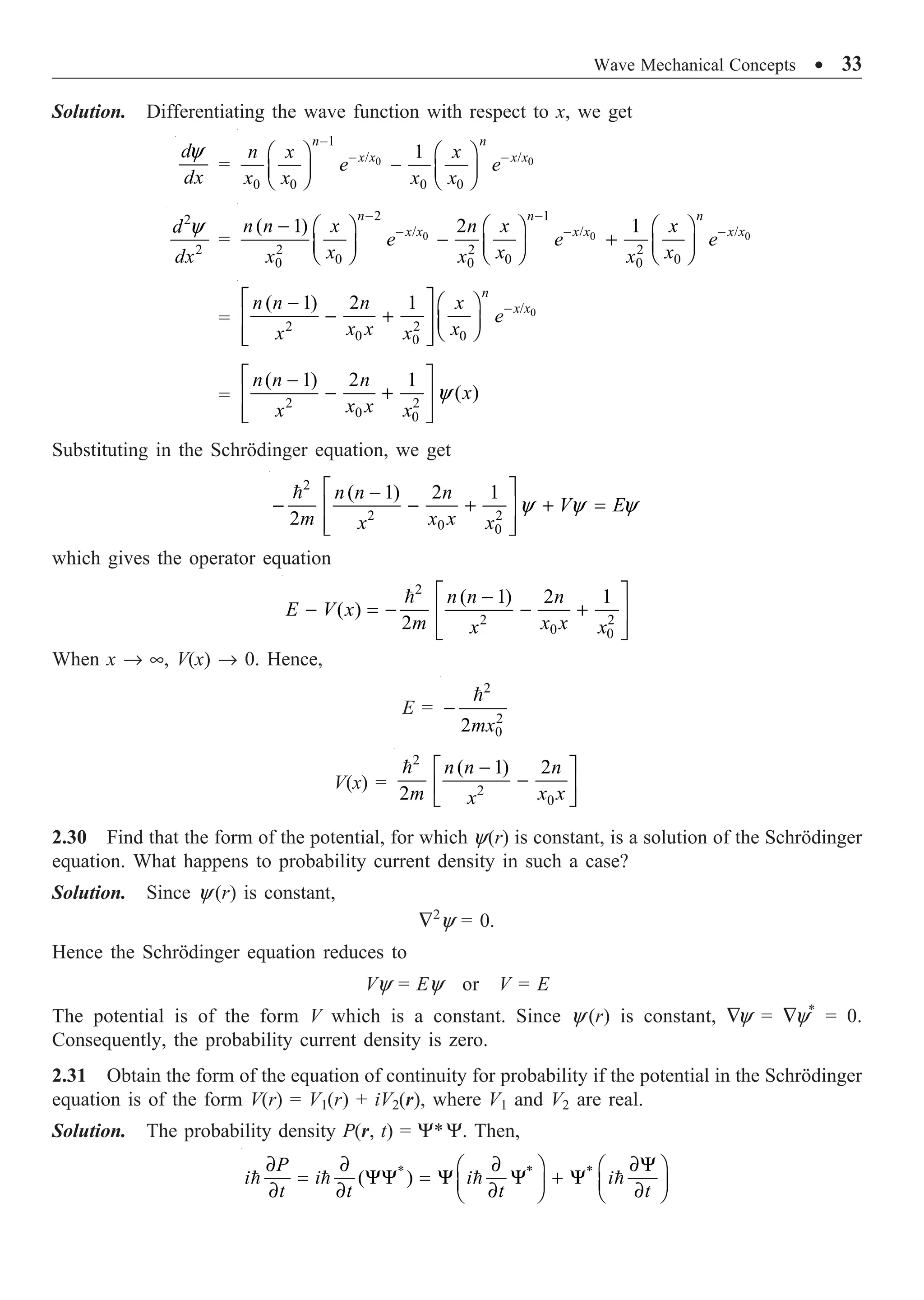
![34 ∑ Quantum Mechanics: 500 Problems with Solutions
The Schrödinger equation with the given potential is given by
2
2
1 2
( )
2
∂Y -
= — Y + + Y
∂
i V iV
t m
Substituting the values of
∂Y
∂
i
t
and
*
∂Y
∂
i
t
, we have
∂
∂
P
i
t
=
2
2 * * 2
2
( ) 2
2
Y— Y - Y — Y +
iV P
m
∂
∂
P
i
t
=
2
* *
2
[ ( ) 2 ]
2
—◊ Y—Y - Y —Y +
iV P
m
∂
∂
P
t
=
* * 2
( ) 2
2
Ê ˆ
— ◊ - Y—Y - Y —Y +
Á ˜
Ë ¯
V
i
P
m
2
2
( , ) ( , )
∂
+ —◊ =
∂
V
P
t P t
t
j r r
2.32 For a one-dimensional wave function of the form
Y(x, t) = A exp [if (x, t)]
show that the probability current density can be written as
2 f
∂
=
∂
A
m x
j
Solution. The probability current density j(r, t) is given by
j(r, t) = * *
( )
2
Y—Y - Y —Y
i
m
Y(x, t) = A exp [if (x, t)]
Y*
(x, t) = A*
exp [–if (x, t)]
—Y = f f
∂Y ∂
=
∂ ∂
i
iAe
x x
—Y*
=
*
* f f
-
∂Y ∂
= -
∂ ∂
i
iA e
x x
Substituting these values, we get
j = * *
2
f f f f
f f
- -
È ˘
∂ ∂
Ê ˆ Ê ˆ
- -
Í ˙
Á ˜ Á ˜
∂ ∂
Ë ¯ Ë ¯
Î ˚
i i i i
i
Ae iA e A e iAe
m x x
=
2 2 2
2
f f
∂ ∂
È ˘
- - =
Í ˙
Î ˚ ∂ ∂
i
i A i A A
m x m x
2.33 Let y0(x) and y1(x) be the normalized ground and first excited state energy eigenfunctions of
a linear harmonic oscillator. At some instants of time, Ay0 + By1, where A and B are constants, is
the wave function of the oscillator. Show that ·xÒ is in general different from zero.](https://image.slidesharecdn.com/quantummechanics500problemswithsolutionspdfdrive-220626164912-635041ea/75/Quantum-Mechanics_-500-Problems-with-Solutions-PDFDrive-pdf-44-2048.jpg)
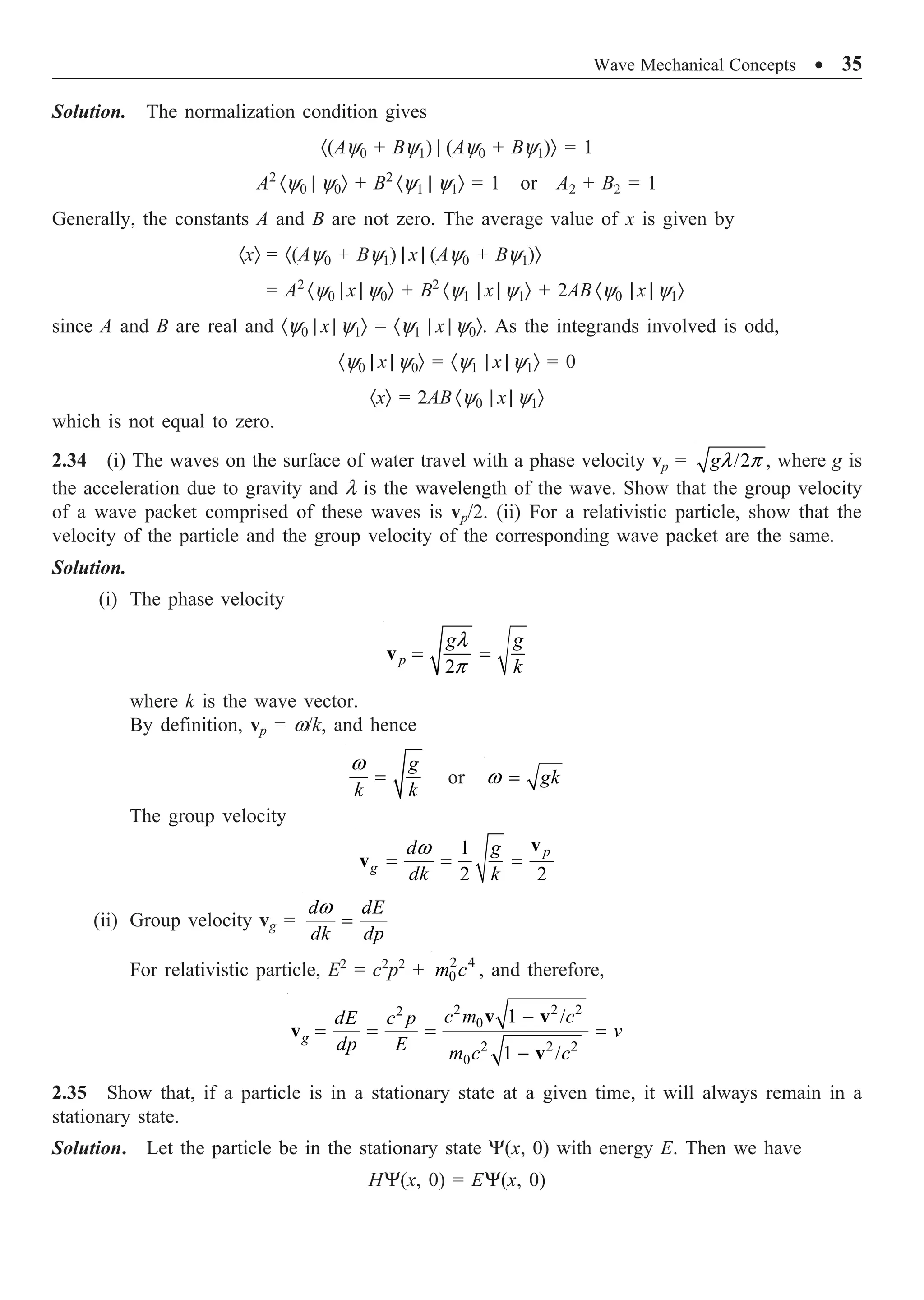
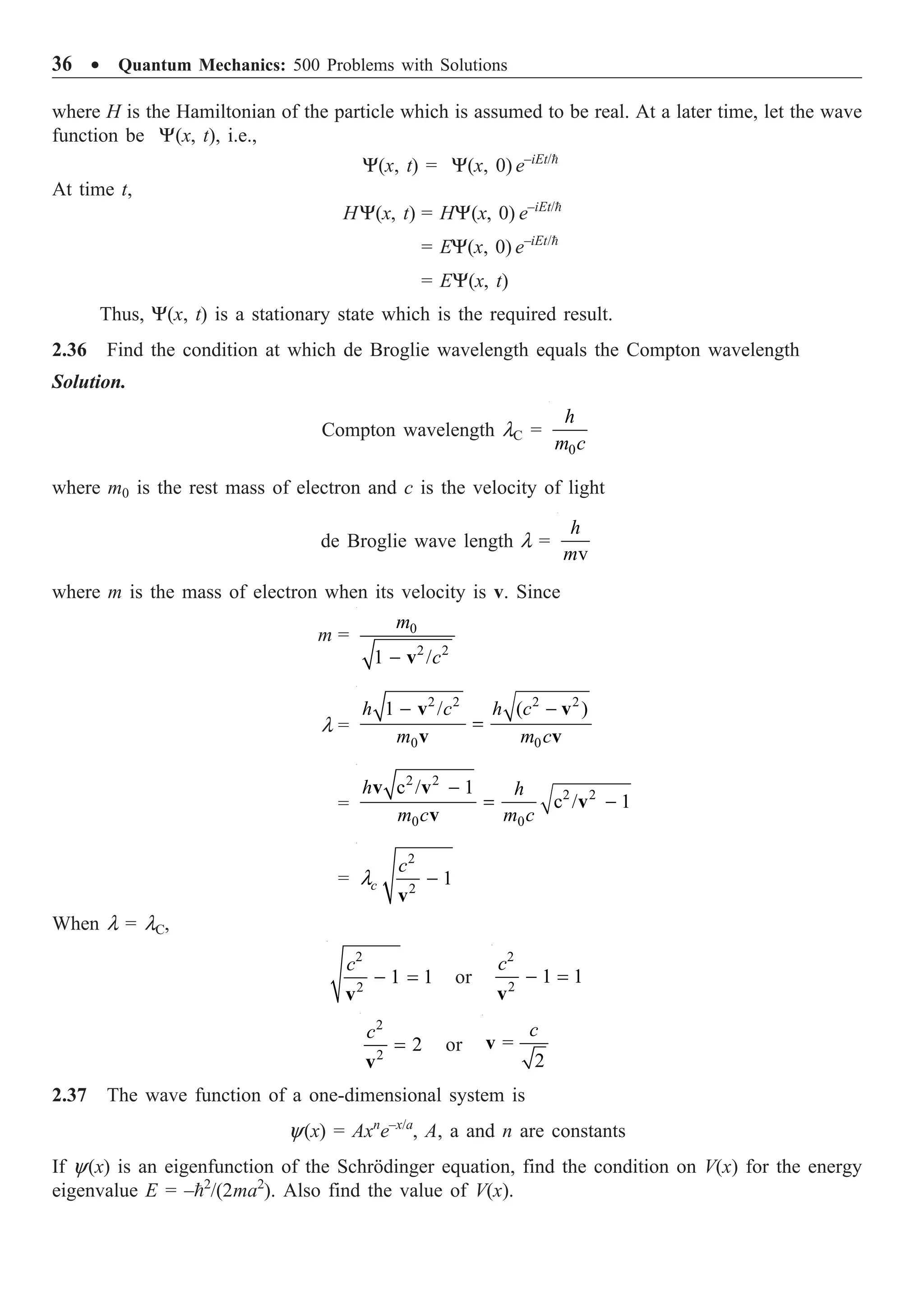
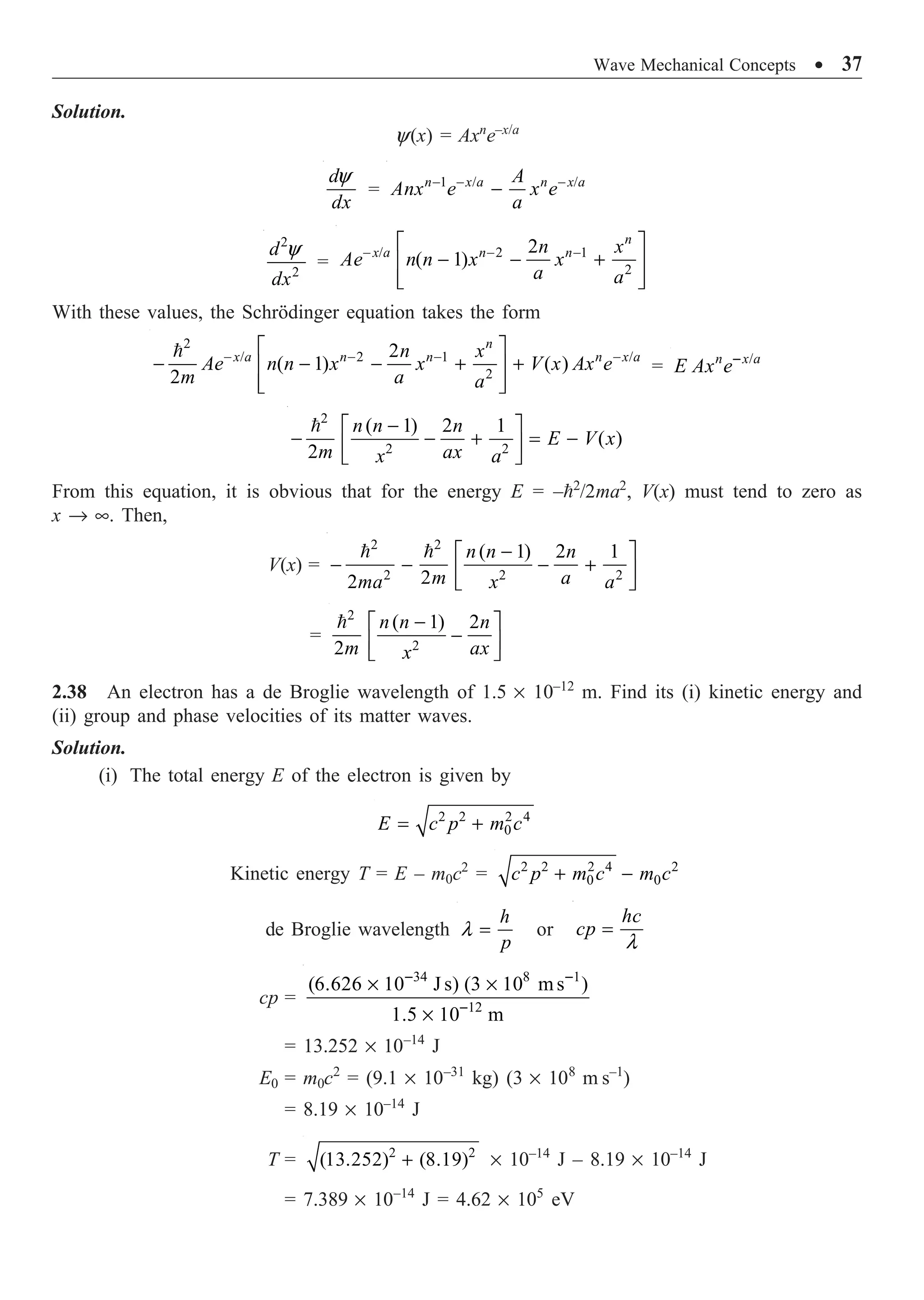
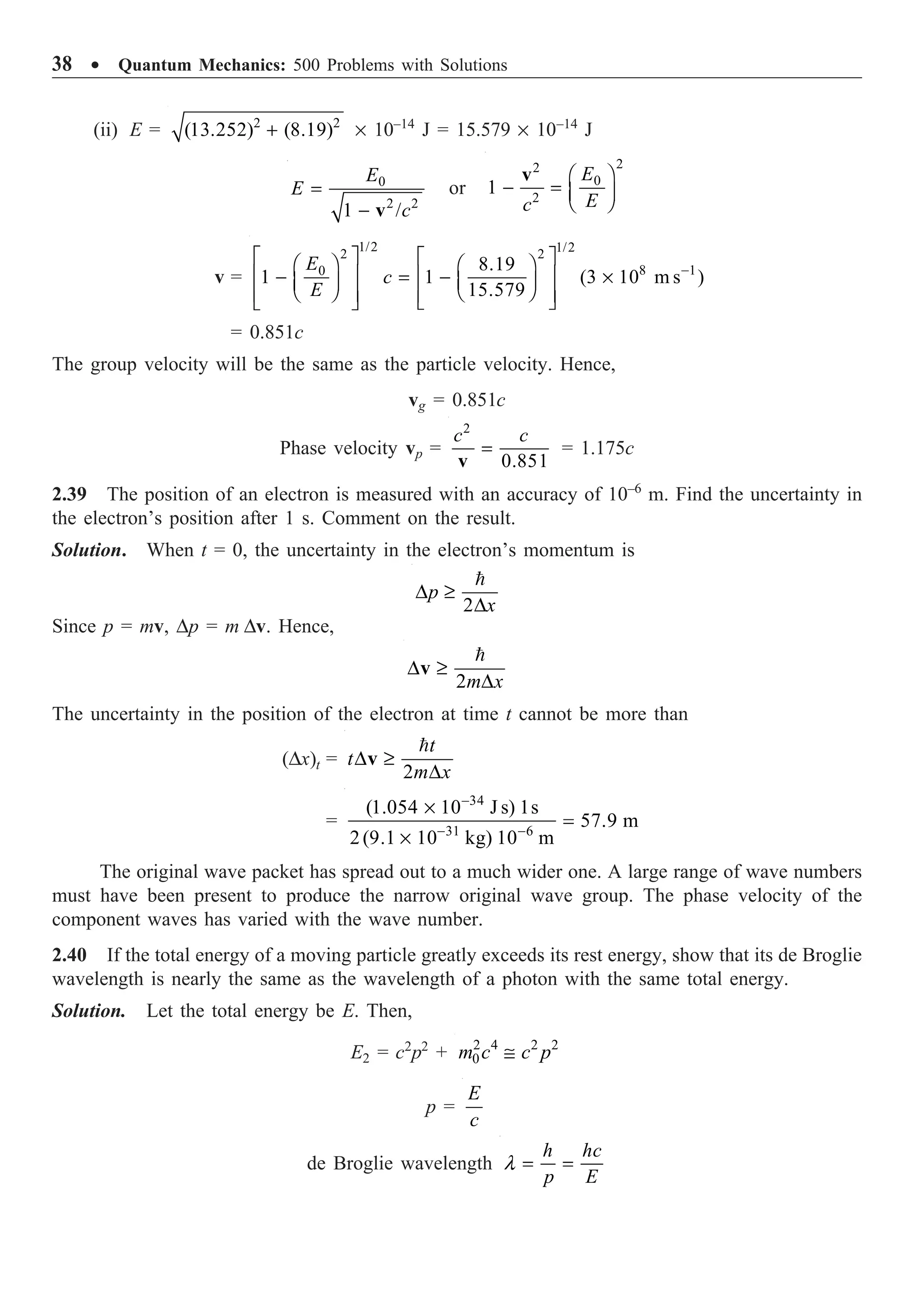
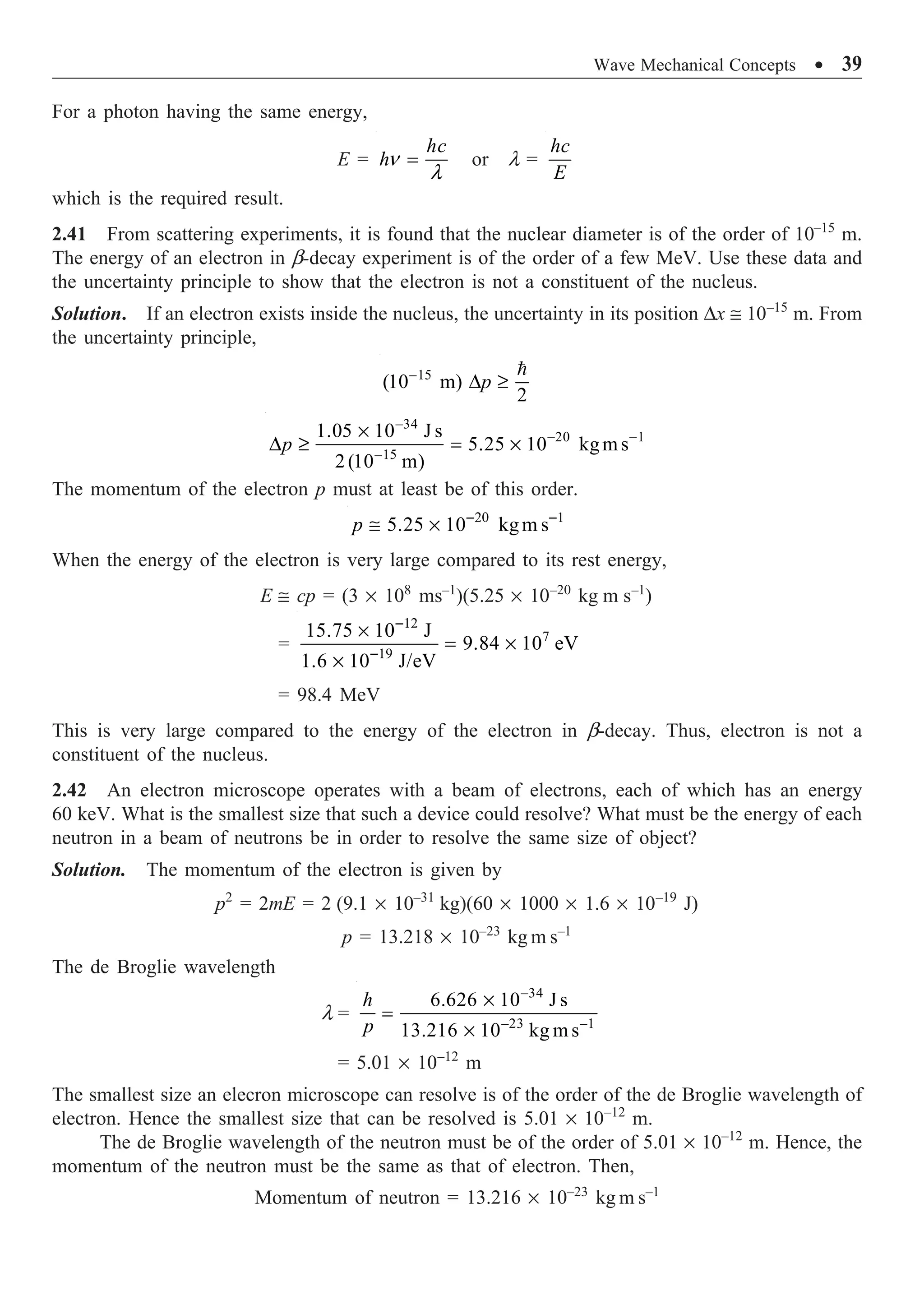

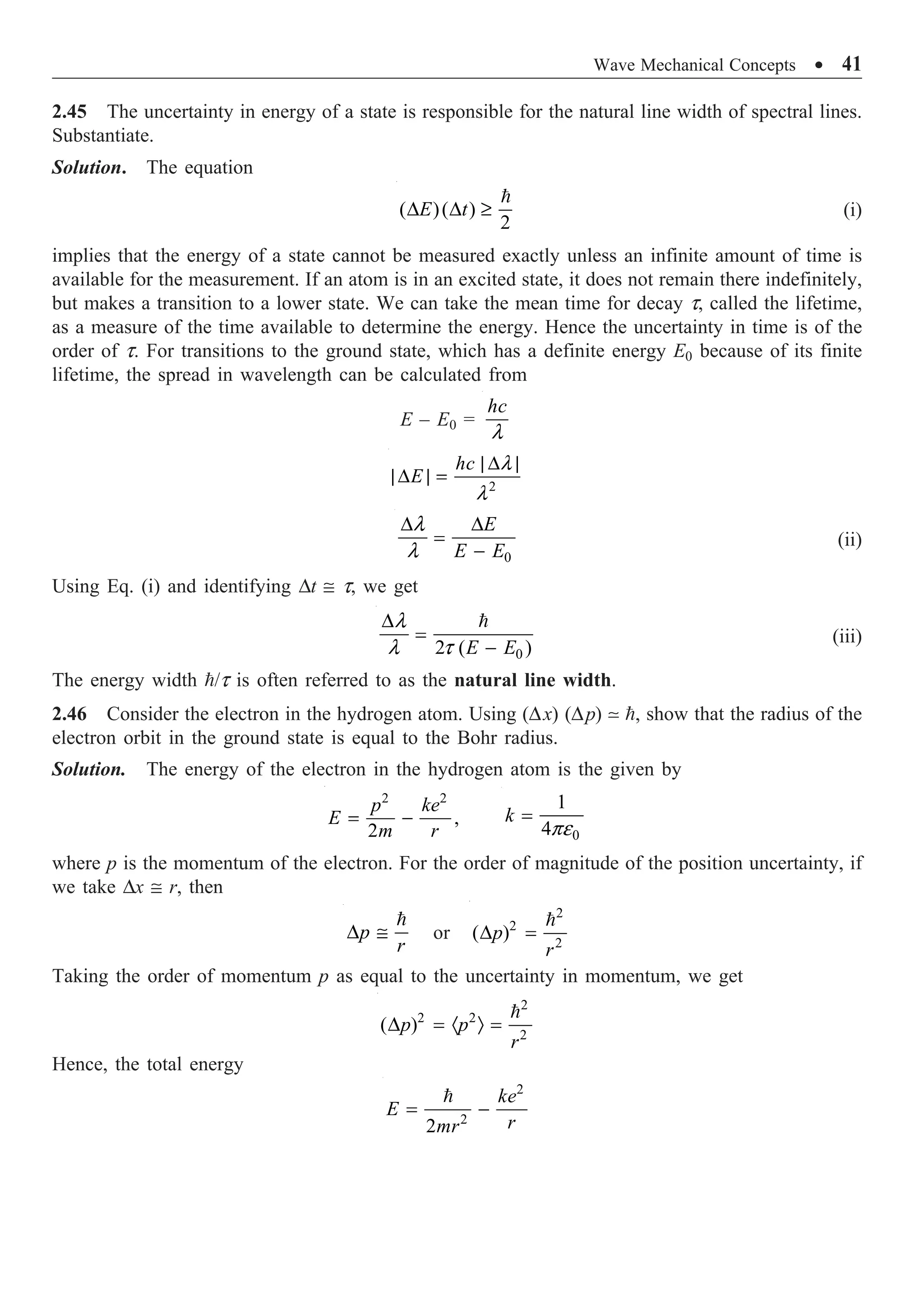
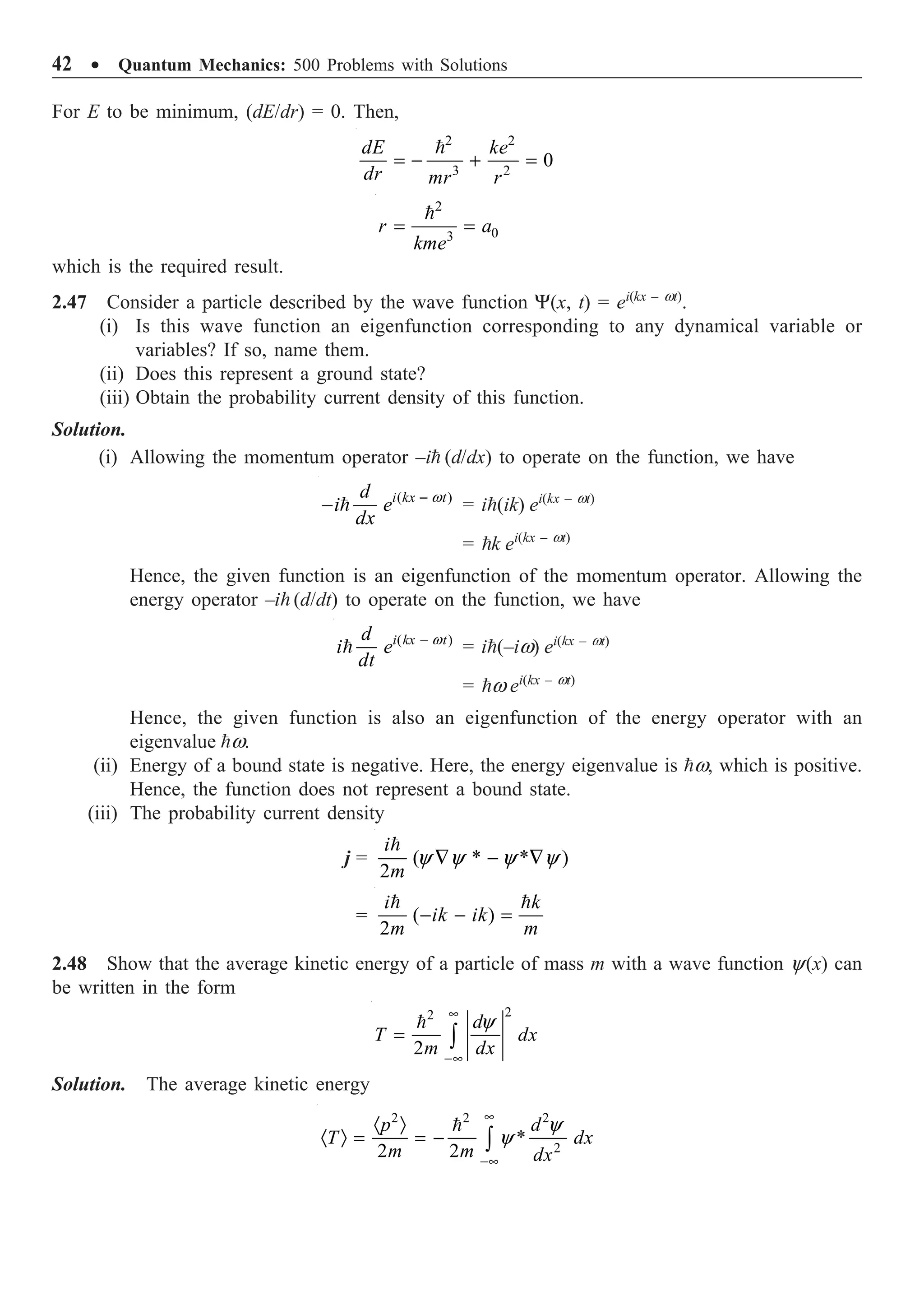
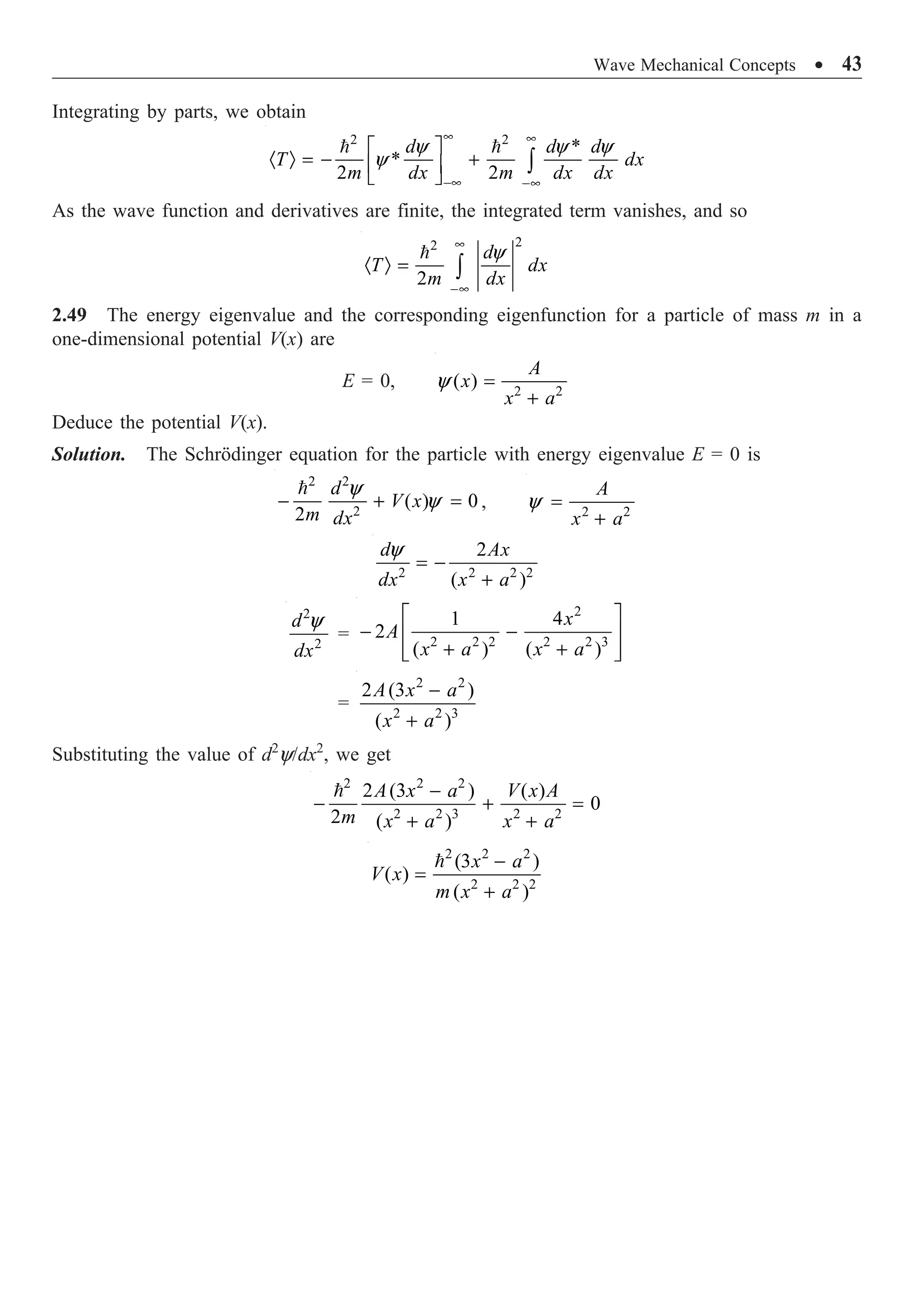
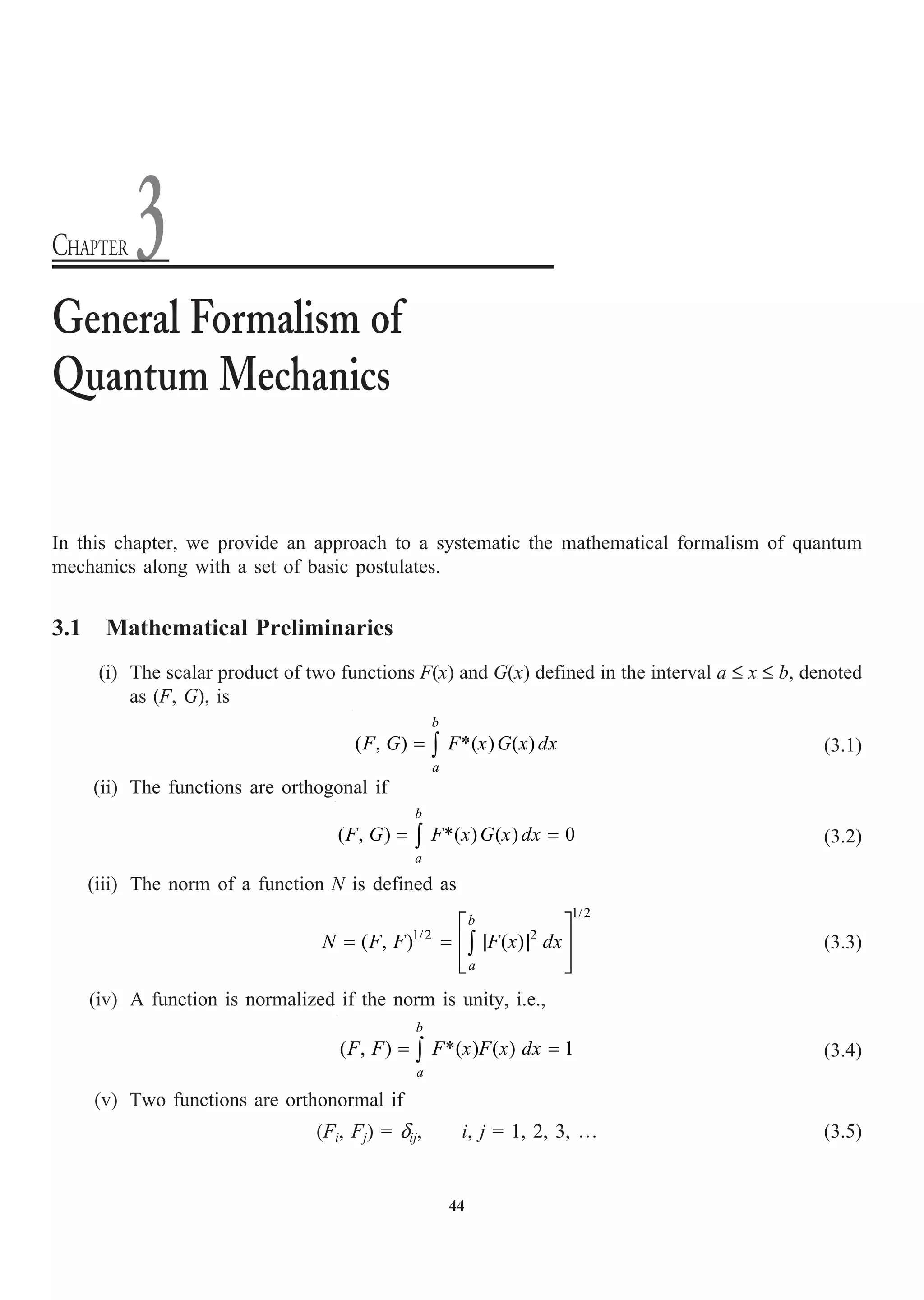
![General Formalism of Quantum Mechanics ∑ 45
where dij is the Kronecker delta defined by
1 if
0 if
d
=
Ï
= Ì
π
Ô
Ó
ij
i j
i j
(3.6)
(vi) A set of functions F1(x), F2(x), º is linearly dependent if a relation of the type
( ) 0
=
 i i
i
c F x (3.7)
exists, where ci’s are constants. Otherwise, they are linearly independent.
3.2 Linear Operator
An operator can be defined as the rule by which a different function is obtained from any given
function. An operator A is said to be linear if it satisfies the relation
1 1 2 2 1 1 2 2
[ ( ) ( )] ( ) ( )
+ = +
A c f x c f x c Af x c Af x (3.8)
The commutator of operators A and B, denoted by [A, B], is defined as
[A, B] = AB – BA (3.9)
It follows that
[A, B] = –[B, A] (3.10)
If [A, B] = 0, A and B are said to commute. If AB + BA = 0, A and B are said to anticommute. The
inverse operator A–1
is defined by the relation
AA–1
= A–1
A = I (3.11)
3.3 Eigenfunctions and Eigenvalues
Often, an operator A operating on a function multiplies the function by a consant, i.e.,
( ) ( )
y y
=
A x a x (3.12)
where a is a constant with respect to x. The function y(x) is called the eigenfunction of the operator
A corresponding to the eigenvalue a. If a given eigenvalue is associated with a large number of
eigenfunctions, the eigenvalue is said to be degenerate.
3.4 Hermitian Operator
Consider two arbitrary functions ym(x) and yn(x). An operator A is said to be Hermitian if
* ( )*
y y y y
• •
-• -•
=
Ú Ú
m n m n
A dx A dx (3.13)
An operator A is said to be anti-Hermitian if
* ( )*
y y y y
• •
-• -•
= -
Ú Ú
m n m n
A dx A dx (3.14)](https://image.slidesharecdn.com/quantummechanics500problemswithsolutionspdfdrive-220626164912-635041ea/75/Quantum-Mechanics_-500-Problems-with-Solutions-PDFDrive-pdf-55-2048.jpg)
![46 ∑ Quantum Mechanics: 500 Problems with Solutions
Two important theorems regarding Hermitian operators are:
(i) The eigenvalues of Hermitian operators are real.
(ii) The eigenfunctions of a Hermitian operator that belong to different eigenvalues are
orthogonal.
3.5 Postulates of Quantum Mechanics
There are different ways of stating the basic postulates of quantum mechanics, but the following
formulation seems to be satisfactory.
3.5.1 Postulate 1—Wave Function
The state of a system having n degrees of freedom can be completely specified by a function Y of
coordinates q1, q2, º, qn and time t which is called the wave function or state function or state
vector of the system. Y, and its derivatives must be continuous, finite and single valued over the
domain of the variables of Y.
The representation in which the wave function is a function of coordinates and time is called
the coordinate representation. In the momentum representation, the wave function is a function
of momentum components and time.
3.5.2 Postulate 2—Operators
To every observable physical quantity, there corresponds a Hermitian operator or matrix. The
operators are selected according to the rule
[Q, R] = i={q, r} (3.15)
where Q and R are the operators selected for the dynamical variables q and r, [Q, R] is the
commutator of Q with R, and {q, r} is the Poisson bracket of q and r.
Some of the important classical observables and the corresponding operators are given in
Table 3.1.
Table 3.1 Important Observables and Their Operators
Observable Classical form Operator
Coordinates x, y, z x, y, z
Momentum p –i=—
Energy E
∂
∂
=
i
t
Time t t
Kintetic energy
2
2
p
m
2
2
2
- —
=
m
Hamiltonian H
2
2
( )
2
- — +
=
V r
m](https://image.slidesharecdn.com/quantummechanics500problemswithsolutionspdfdrive-220626164912-635041ea/75/Quantum-Mechanics_-500-Problems-with-Solutions-PDFDrive-pdf-56-2048.jpg)
![General Formalism of Quantum Mechanics ∑ 47
3.5.3 Postulate 3—Expectation Value
When a system is in a state described by the wave function Y, the expectation value of any
observable a whose operator is A is given by
* t
•
-•
· Ò = Y
Ú
a AY d (3.16)
3.5.4 Postulate 4—Eigenvalues
The possible values which a measurement of an observable whose operator is A can give are the
eigenvalues ai of the equation
AYi = aiYi, i = 1, 2, º, n (3.17)
The eigenfunctions Yi form a complete set of n independent functions.
3.5.5 Postulate 5—Time Development of a Quantum System
The time development of a quantum system can be described by the evolution of state function in
time by the time dependent Schrödinger equation
( , ) ( , )
∂Y
= Y
∂
=
i t H t
t
r r (3.18)
where H is the Hamiltonian operator of the system which is independent of time.
3.6 General Uncertainty Relation
The uncertainty (DA) in a dynamical variable A is defined as the root mean square deviation from
the mean. Here, mean implies expectation value. So,
(DA)2
= ·(A – ·AÒ)2
Ò = ·A2
Ò – ·AÒ2
(3.19)
Now, consider two Hermitian operators, A and B. Let their commutator be
[A, B] = iC (3.20)
The general uncertainty relation is given by
( )( )
2
· Ò
D D ≥
C
A B (3.21)
In the case of the variables x and px, [x, px] = i= and, therefore,
( )( )
2
D D ≥
=
x
x P (3.22)](https://image.slidesharecdn.com/quantummechanics500problemswithsolutionspdfdrive-220626164912-635041ea/75/Quantum-Mechanics_-500-Problems-with-Solutions-PDFDrive-pdf-57-2048.jpg)
![48 ∑ Quantum Mechanics: 500 Problems with Solutions
3.7 Dirac’s Notation
To denote a state vector, Dirac introducted the symbol | Ò, called the ket vector or, simply, ket.
Different states such as ya(r), yb(r), º are denoted by the kets |aÒ, |bÒ, º Corresponding to every
vector, |aÒ, is defined as a conjugate vector |aÒ*, for which Dirac used the notation ·a|, called a bra
vector or simply bra. In this notation, the functions ya and yb are orthogonal if
·a | bÒ = 0 (3.23)
3.8 Equations of Motion
The equation of motion allows the determination of a system at a time from the known state at a
particular time.
3.8.1 Schrödinger Picture
In this representation, the state vector changes with time but the operator remains constant. The state
vector |ys(t)Ò changes with time as follows:
( ) ( )
y y
| Ò = | Ò
s s
d
i t H t
dt
(3.24)
Integration of this equation gives
/
( ) (0)
y y
-
| Ò = | Ò
iHt
s s
t e (3.25)
The time derivative of the expectation value of the operator is given by
1
[ , ]
∂
· Ò = · Ò +
∂
s
s s
A
d
A A H
dt i t
(3.26)
3.8.2 Heisenberg Picture
The operator changes with time while the state vector remains constant in this picture. The state
vector |yHÒ and operator AH are defined by
|yHÒ = eiHt/
|ys(t)Ò (3.27)
AH(t) = eiHt/
AseiHt/
(3.28)
From Eqs. (3.27) and (3.25), it is obvious that
|yHÒ = |ys(0)Ò (3.29)
The time derivative of the operator AH is
1
[ , ]
∂
= +
∂
H
H H
A
d
A A H
dt i t
(3.30)](https://image.slidesharecdn.com/quantummechanics500problemswithsolutionspdfdrive-220626164912-635041ea/75/Quantum-Mechanics_-500-Problems-with-Solutions-PDFDrive-pdf-58-2048.jpg)
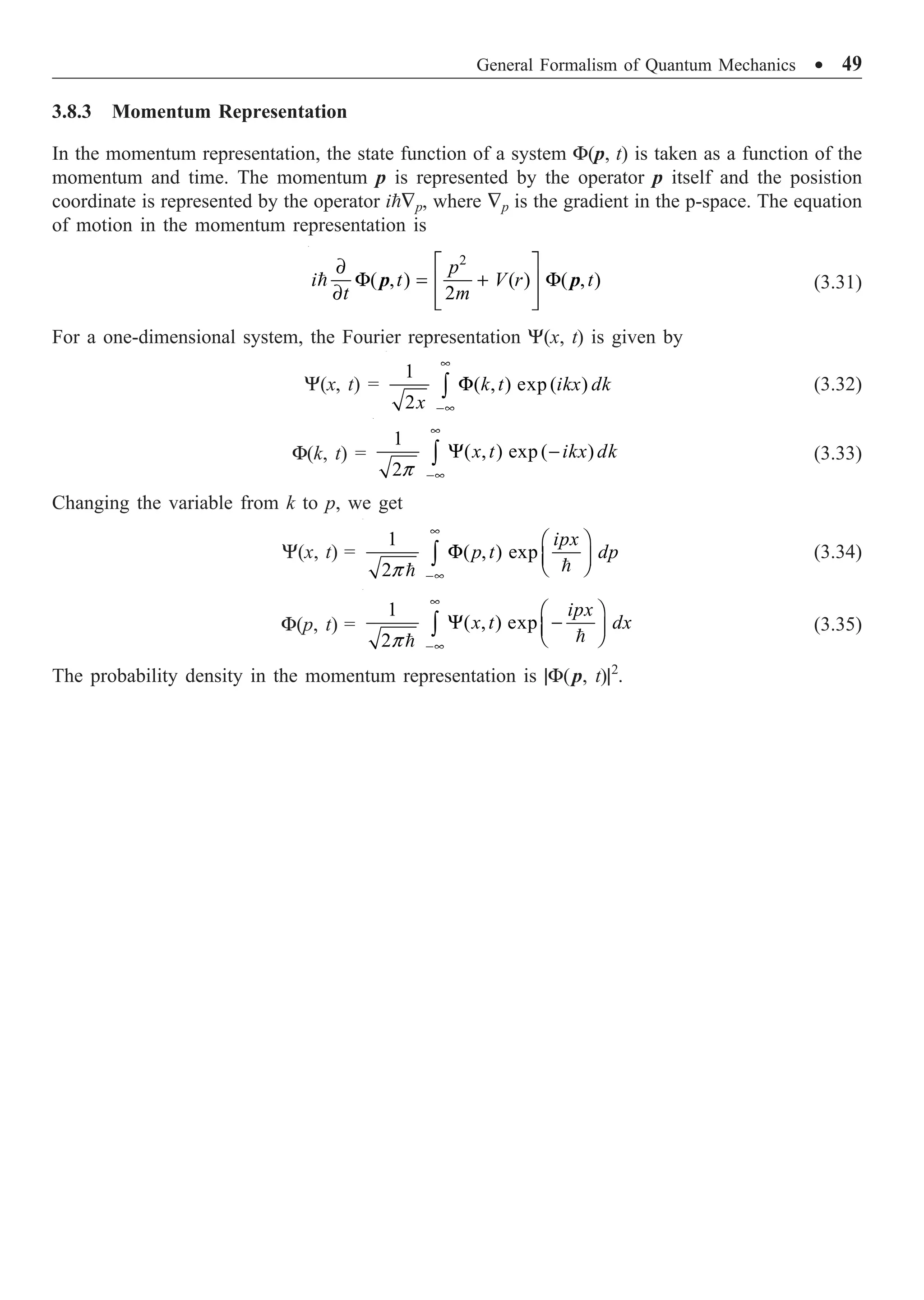
![50 ∑ Quantum Mechanics: 500 Problems with Solutions
PROBLEMS
3.1 A and B are two operators defined by Ay(x) = y(x) + x and By(x) = (dy/dx) + 2y(x). Check
for their linearity.
Solution. An operator O is said to be linear if
O [c1 f1(x) + c2 f2(x)] = c1Of1(x) + c2Of2(x)
For the operator A,
A [c1 f1(x) + c2 f2(x)] = [c1f1(x) + c2 f2(x)] + x
LHS = c1Af1(x) + c2Af2(x) = c1f1(x) + c2 f2(x) + c1x + c2x
which is not equal to the RHS. Hence, the operator A is not linear.
B [c1 f1(x) + c2 f2(x)] =
d
dx
[c1 f1(x) + c2 f2(x)] + 2[c1f1(x) + c2 f2(x)]
= c1
d
dx
f1(x) + c2
d
dx
f2(x) + 2c1 f1(x) + 2c2 f2(x)
=
d
dx
c1f1(x) + 2c1f1(x) +
d
dx
c2 f2(x) + 2c2 f2(x)
= c1Bf1(x) + c2Bf2(x)
Thus, the operator B is linear.
3.2 Prove that the operators i(d/dx) and d2
/dx2
are Hermitian.
Solution. Consider the integral *
y y
•
-•
Ê ˆ
Á ˜
Ë ¯
Ú m n
d
i dx
dx
. Integrating it by parts and remembering that
ym and yn are zero at the end points, we get
*
y y
•
-•
Ê ˆ
Á ˜
Ë ¯
Ú m n
d
i dx
dx
= [ * ] *
y y y y
•
•
-•
-•
- Ú
m n n m
d
i i dx
dx
=
*
m n
d
i dx
dx
y y
•
-•
Ê ˆ
Á ˜
Ë ¯
Ú
which is the condition for i(d/dx) to be Hermitian. Therefore, id/dx is Hermitian.
2
2
*
y
y
•
-•
Ú
n
m
d
dx
dx
=
*
*
y y y
y
• •
-•
-•
È ˘
-
Í ˙
Î ˚
Ú
n n m
m
d d d
dx
dx dx dx
=
2 2
2 2
* * *
y y y
y y
• • •
-• -•
-•
È ˘
+ =
Í ˙
Î ˚
Ú Ú
m m m
n n
d d d
dx dx
dx dx dx
Thus, d2
/dx2
is Hermitian. The integrated terms in the above equations are zero since ym and yn are
zero at the end points.](https://image.slidesharecdn.com/quantummechanics500problemswithsolutionspdfdrive-220626164912-635041ea/75/Quantum-Mechanics_-500-Problems-with-Solutions-PDFDrive-pdf-60-2048.jpg)
![General Formalism of Quantum Mechanics ∑ 51
3.3 If A and B are Hermitian operators, show that (i) (AB + BA) is Hermitian, and (ii) (AB – BA)
is non-Hermitian.
Solution.
(i) Since A and B are Hermitian, we have
* * *
y y y y
=
Ú Ú
m n m n
A dx A dx; * * *
y y y y
=
Ú Ú
m n m n
B dx B dx
*( )
y y
+
Ú m n
AB BA dx = * *
y y y y
+
Ú Ú
m n m n
AB dx BA dx
= * * * * * *
y y y y
+
Ú Ú
m n m n
B A dx A B dx
= ( )* *
y y
+
Ú m n
AB BA dx
Hence, AB + BA is Hermitian.
(ii) *( )
y y
-
Ú m n
AB BA dx = ( * * * *) *
y y
-
Ú m n
B A A B dx
= ( B )* *
y y
- -
Ú m n
A BA dx
Thus, AB – BA is non-Hermitian.
3.4 If operators A and B are Hermitian, show that i [A, B] is Hermitian. What relation must exist
between operators A and B in order that AB is Hermitian?
Solution.
* [ , ]
i n
i A B dx
y y
Ú = * *
y y y y
-
Ú Ú
m n m n
i AB dx i BA dx
= * * * * * *
y y y y
-
Ú Ú
m n m n
i B A dx i A B dx
= ( [ , ] )*
y y
Ú m n
i A B dx
Hence, i [A, B] is Hermitian.
For the product AB to be Hermitian, it is necessary that
* * * *
m n m n
AB dx A B dx
y y y y
=
Ú Ú
Since A and B are Hermitian, this equation reduces to
* * * = * * *
y y y y
Ú Ú
m n m n
B A dx A B dx
which is possible only if * * * * * *
y y
=
m m
B A A B . Hence,
AB = BA
That is, for AB to be Hermitian, A must commute with B.
3.5 Prove the following commutation relations:
(i) [[A, B], C] + [[B, C], A] + [[C, A], B] = 0.
(ii)
2
2
,
È ˘
∂ ∂
Í ˙
∂ ∂
Í ˙
Î ˚
x x
(iii) , ( )
∂
È ˘
Í ˙
∂
Î ˚
F x
x](https://image.slidesharecdn.com/quantummechanics500problemswithsolutionspdfdrive-220626164912-635041ea/75/Quantum-Mechanics_-500-Problems-with-Solutions-PDFDrive-pdf-61-2048.jpg)
![52 ∑ Quantum Mechanics: 500 Problems with Solutions
Solution.
(i) [[A, B], C] + [[B, C], A] + [[C, A], B] = [A, B] C – C [A, B] + [B, C] A – A [B, C]
+ [C, A] B – B [C, A]
= ABC – BAC – CAB + CBA + BCA – CBA – ABC
+ ACB + CAB – ACB – BCA + BAC = 0
(ii)
2
2
, y
È ˘
∂ ∂
Í ˙
∂ ∂
Í ˙
Î ˚
x x
=
2 2
2 2
y
Ê ˆ
∂ ∂ ∂ ∂
-
Á ˜
∂ ∂
∂ ∂
Ë ¯
x x
x x
=
3 3
3 3
0
y
Ê ˆ
∂ ∂
- =
Á ˜
∂ ∂
Ë ¯
x x
(iii) , ( ) y
∂
È ˘
Í ˙
∂
Î ˚
F x
x
= ( )
y y
∂ ∂
-
∂ ∂
F F
x x
=
y y
y y
∂ ∂ ∂ ∂
+ - =
∂ ∂ ∂ ∂
F F
F F
x x x x
Thus, , ( )
∂ ∂
È ˘
=
Í ˙
∂ ∂
Î ˚
F
F x
x x
3.6 Show that the cartesian linear momentum components (p1, p2, p3) and the cartesian
components of angular momentum (L1, L2, L3) obey the commutation relations (i) [Lk , pl] = ipm;
(ii) [Lk, pk] = 0, where k, l, m are the cyclic permutations of 1, 2, 3.
Solution.
(i) Angular momentum L =
ˆ ˆ ˆ
k l m
k l m
k l m
r r r
p p p
Lk = rlpm – rmpl =
∂ ∂
Ê ˆ
- -
Á ˜
∂ ∂
Ë ¯
l m
m l
i r r
r r
[Lk, pl] y = 2 2
y y
∂ ∂ ∂ ∂ ∂ ∂
Ê ˆ Ê ˆ
- - + -
Á ˜ Á ˜
∂ ∂ ∂ ∂ ∂ ∂
Ë ¯ Ë ¯
l m l m
m l l l m l
r r r r
r r r r r r
=
2 2
2
2 2
y y y y y
Ê ˆ
∂ ∂ ∂ ∂ ∂ ∂ ∂
- - - - +
Á ˜
∂ ∂ ∂ ∂ ∂
∂ ∂
Ë ¯
l m l m
m l m l m
l l
r r r r
r r r r r
r r
=
2 y y
y
∂ ∂
Ê ˆ
= - =
Á ˜
∂ ∂
Ë ¯
m
m m
i i i p
r r
Hence, [Lk, pl] = ipm.
(ii) [Lk, pk]y = 2 2
0
y y
∂ ∂ ∂ ∂ ∂ ∂
Ê ˆ Ê ˆ
- - + - =
Á ˜ Á ˜
∂ ∂ ∂ ∂ ∂ ∂
Ë ¯ Ë ¯
l m l m
m l k k m l
r r r r
r r r r r r
= 2
0
y y y y
∂ ∂ ∂ ∂ ∂ ∂ ∂ ∂
Ê ˆ
- - - + =
Á ˜
∂ ∂ ∂ ∂ ∂ ∂ ∂ ∂
Ë ¯
l m l m
m k l k k m k l
r r r r
r r r r r r r r](https://image.slidesharecdn.com/quantummechanics500problemswithsolutionspdfdrive-220626164912-635041ea/75/Quantum-Mechanics_-500-Problems-with-Solutions-PDFDrive-pdf-62-2048.jpg)
![General Formalism of Quantum Mechanics ∑ 53
3.7 Show that (i) Operators having common set of eigenfunctions commute; (ii) commuting
operators have common set of eigenfunctions.
Solution.
(i) Consider the operators A and B with the common set of eigenfunctions yi, i = 1, 2, 3, º
as
Ayi = aiyi, Byi = biyi
Then,
AByi = Abiyi = aibiyi
BAyi = Bayi = aibiyi
Since AByi = BAyi, A commutes with B.
(ii) The eigenvalue equation for A is
Ayi = aiyi, i = 1, 2, 3, º
Operating both sides from left by B, we get
BAyi = aiByi
Since B commutes with A,
AByi = aiByi
i.e., Byi is an eigenfunction of A with the same eigenvalue ai. If A has only nondegenerate
eigenvalues, Byi can differ from yi only by a multiplicative constant, say, b. Then,
Byi = biyi
i.e., yi is a simultaneous eigenfunction of both A and B.
3.8 State the relation connecting the Poisson bracket of two dynamical variables and the value of
the commutator of the corresponding operators. Obtain the value of the commutator [x, px] and the
Heisenberg’s equation of motion of a dynamical variable which has no explicit dependence on time.
Solution. Consider the dynamical variables q and r. Let their operators in quantum mechanics be
Q and R. Let {q, r} be the Poisson bracket of the dynamical variables q and r. The relation
connecting the Poisson bracket and the commutator of the corresponding operators is
[Q, R] = i {q, r} (i)
The Poisson bracket {x, px} = 1. Hence,
[x, px] = i (ii)
The equation of motion of a dynamical variable q in the Poisson bracket is
{ , }
=
dq
q H
dt
(iii)
Using Eq. (i), in terms of the operator Q, Eq. (iii) becomes
{ , }
=
dQ
i Q H
dt
(iv)
which is Heisenberg’s equation of motion for the operator Q in quantum mechanics.](https://image.slidesharecdn.com/quantummechanics500problemswithsolutionspdfdrive-220626164912-635041ea/75/Quantum-Mechanics_-500-Problems-with-Solutions-PDFDrive-pdf-63-2048.jpg)
![54 ∑ Quantum Mechanics: 500 Problems with Solutions
3.9 Prove the following commutation relations (i) [Lk, r2
] = 0, (ii) [Lk, p2
] = 0, where r is the radius
vector, p is the linear momentum, and k, l, m are the cyclic permutations of 1, 2, 3.
Solution.
(i) [Lk, r2
] = 2 2 2
[ , ]
k k l m
L r r r
+ +
= 2 2 2
[ , ] [ , ] [ , ]
k k k l k m
L r L r L r
+ +
= 1
[ , ] [ , ] [ , ] [ , ] [ , ] [ , ]
+ + + + +
k k k k k k k l k l l m k m k m m
r L r L r r r L r L r r r L r L r r
= 0 + 0 + rlirm + irmrl – rmirl – irlrm = 0
(ii) [Lk, p2
] = 2 2 2
[ , ] [ , ] [ , ]
+ +
k k k l k m
L p L p L p
= 1
[ , ] [ , ] [ , ] [ , ] [ , ] [ , ]
+ + + + +
k k k k k k k l k l l m k m k m m
p L p L p p p L p L p p p L p L p p
= 0 + 0 + ipl pm + ipm pl – ipmpl – ipl pm = 0
3.10 Prove the following commutation relations:
(i) [x, px] = [y, py] = [z, pz] = i
(ii) [x, y] = [y, z] = [z, x] = 0
(iii) [px, py] = [py, pz] = [pz, px] = 0
Solution.
(i) Consider the commutator [x, px]. Replacing x and px by the corresponding operators and
allowing the commutator to operate on the function y(x), we obtain
, ( )
y
È ˘
-
Í ˙
Î ˚
d
x i x
dx
=
( )
y y
- +
d d x
i x i
dx dx
=
y y
y
- + +
d d
i x i i x
dx dx
= iy
Hence,
, [ , ]
È ˘
- = =
Í ˙
Î ˚
x
d
x i x p i
dx
Similarly,
[y, py] = [z, pz] = i
(ii) Since the operators representing coordinates are the coordinates themselves,
[x, y] = [y, z] = [z, x] = 0
(iii) [px, py] y(x, y) = , ( , )
y
∂ ∂
È ˘
- -
Í ˙
∂ ∂
Î ˚
i i x y
x y
=
2 2
2
( , )
y
È ˘
∂ ∂
- -
Í ˙
∂ ∂ ∂ ∂
Í ˙
Î ˚
x y
x y y x
The right-hand side is zero as the order of differentiation can be changed. Hence the
required result.](https://image.slidesharecdn.com/quantummechanics500problemswithsolutionspdfdrive-220626164912-635041ea/75/Quantum-Mechanics_-500-Problems-with-Solutions-PDFDrive-pdf-64-2048.jpg)
![General Formalism of Quantum Mechanics ∑ 55
3.11 Prove the following:
(i) If y1 and y2 are the eigenfunctions of the operator A with the same eigenvalue, c1y1 + c2y2
is also an eigenfunction of A with the same eigenvalue, where c1 and c2 are constants.
(ii) If y1 and y2 are the eigenfunctions of the operator A with distinct eigenvalues, then c1y1
+ c2y2 is not an eigenfunction of the operator A, c1 and c2 being constants.
Solution.
(i) We have
Ay1 = a1y1, Ay2 = a1y2
A(c1y1 + c2y2) = Ac1y1 + Ac2y2
= a1 (c1y1 + c2y2)
Hence, the required result.
(ii) Ay1 = a1y1, and Ay2 = a2y2
A(c1y1 + c2y2) = Ac1y1 +m Ac2y2
= a1c1y1 + a2c2y2
Thus, c1y1 + c2y2 is not an eigenfunction of the operator A.
3.12 For the angular momentum components Lx and Ly, check whether LxLy + LyLx is Hermitian.
Solution. Since i (d/dx) is Hermitian (Problem 3.2), i (d/dy) and i (d/dz) are Hermitian. Hence Lx
and Ly are Hermitian. Since Lx and Ly are Hermitian,
*( )
y y
+
Ú m x y y x n
L L L L dx = ( * * * *) *
y y
+
Ú y x x y m n
L L L L dx
= ( )* *
y y
+
Ú x y y x m n
L L L L dx
Thus, LxLy + LyLx is Hermitian.
3.13 Check whether the operator – ix (d/dx) is Hermitian.
Solution.
*
y y
Ê ˆ
Á ˜
Ë ¯
Ú
m n
d
i x dx
dx
= *
y y
Ê ˆ
-
Á ˜
Ë ¯
Ú
m n
d
x i dx
dx
=
*
*
*y y
Ê ˆ
-
Á ˜
Ë ¯
Ú m n
d
i x dx
dx
π
*
*
y y
Ê ˆ
-
Á ˜
Ë ¯
Ú m n
d
i x dx
dx
Hence the given operator is not Hermitian.
3.14 If x and px are the coordinate and momentum operators, prove that [x, px
n
] = nipx
n–1
.
Solution.
[x, px
n
] = [x, px
n–1
px] = [x, px] px
n–1
+ px [x, px
n–1
]
= ipx
n–1
+ px ([x, px] px
n–2
+ px [x, px
n–2
])
= 2ipx
n–1
+ px
2
([x, px] px
n–3
+ px [x, px
n–3
])
= 3ipx
n–1
+ px
3
[x, px
n–3
]
Continuing, we have [x, px
n
] = nipx
n–1](https://image.slidesharecdn.com/quantummechanics500problemswithsolutionspdfdrive-220626164912-635041ea/75/Quantum-Mechanics_-500-Problems-with-Solutions-PDFDrive-pdf-65-2048.jpg)
![56 ∑ Quantum Mechanics: 500 Problems with Solutions
3.15 Show that the cartesian coordinates (r1, r2, r3) and the cartesian components of angular
momentum (L1, L2, L3) obey the commutation relations.
(i) [Lk, rl] = irm
(ii) [Lk, rk] = 0, where k, l, m are cyclic permutations of 1, 2, 3.
Solution.
(i) [Lk, rl]y = (Lkrl – rlLk)y = y y
È ˘
∂ ∂ ∂ ∂
Ê ˆ Ê ˆ
- - - -
Í ˙
Á ˜ Á ˜
∂ ∂ ∂ ∂
Ë ¯ Ë ¯
Î ˚
l m l l l m
m l m l
i r r r r r r
r r r r
=
2 2
y y y y
y
∂ ∂ ∂ ∂
È ˘
- - - - +
Í ˙
∂ ∂ ∂ ∂
Î ˚
l m m l l l m
m l m l
i r r r r r r r
r r r r
= irmy
Hence, [Lk, rl] = irm.
(ii) [Lk, rk]y = 0
y y
È ˘
∂ ∂ ∂ ∂
Ê ˆ Ê ˆ
- - - - =
Í ˙
Á ˜ Á ˜
∂ ∂ ∂ ∂
Ë ¯ Ë ¯
Î ˚
l m k k l m
m l m l
i r r r r r r
r r r r
Thus, [Lk, rk] = 0.
3.16 Show that the commutator [x, [x, H]] = –2
/m, where H is the Hamiltonian operator.
Solution.
Hamiltonian H =
2 2 2
( )
2
+ +
x y z
p p p
m
Since
[x, py] = [x, pz] = 0, [x, px] = i
we have
[x, H] = 2
1 1
[ , ] ( [ , ] [ , ] )
2 2
= +
x x x x x
x p p x p x p p
m m
[x, H] =
1
2
2
=
x x
i
i p p
m m
[x, [x, H]] =
2
, [ , ]
È ˘
= = -
Í ˙
Î ˚
x
x
i p i
x x p
m m m
3.17 Prove the following commutation relations in the momentum representation:
(i) [x, px] = [y, py] = [z, pz] = i
(ii) [x, y] = [y, z] = [z, x] = 0
Solution.
(i) [x, px] f ( px) = , ( )
∂
È ˘
Í ˙
∂
Î ˚
x x
x
i p f p
p
= ( )
∂ ∂
- =
∂ ∂
x x
x x
i p f i p f i f
p p
[x, px] = i
Similarly, [y, py] = [z, pz] = i](https://image.slidesharecdn.com/quantummechanics500problemswithsolutionspdfdrive-220626164912-635041ea/75/Quantum-Mechanics_-500-Problems-with-Solutions-PDFDrive-pdf-66-2048.jpg)
![General Formalism of Quantum Mechanics ∑ 57
(ii) [x, y] f(px, py) = 2
( ) , ( , )
È ˘
∂ ∂
Í ˙
∂ ∂
Î ˚
x y
x y
i f p p
p p
= 2
( , ) 0
È ˘
∂ ∂ ∂ ∂
- - =
Í ˙
∂ ∂ ∂ ∂
Î ˚
x y
x y y x
f p p
p p p p
since the order of differentiation can be changed. Hence, [x, y] = 0. Similarly, [y, z] = [z, x] = 0.
3.18 Evaluate the commutator (i) [x, px
2
], and (ii) [xyz, px
2
].
Solution.
(i) [x, px
2
] = [x, px] px + px [x, px]
= 2
+ =
x x x
i p i p i p
=
2
2 2
Ê ˆ
- =
Á ˜
Ë ¯
d d
i i
dx dx
(ii) [xyz, px
2
] = [xyz, px] px + px [xyz, px]
= xy [z, px] px + [xy, px] zpx + pxxy [z, px] + px [xy, px] z
Since [z, px], the first and third terms on the right-hand side are zero. So,
[xyz, px
2
] = x[y, px] zpx + [x, px] yzpx + px x[y, px]z + px [x, px] yz
The first and third terms on the right-hand side are zero since [y, px] = 0. Hence,
[xyz, px
2
] = iyzpx + ipxyz = 2iyzpx
where we have used the result
[ ( )] ( )
∂
=
∂
d
yz f x yz f x
dx x
Substituting the operator for px, we get
[xyz, px
2
] = 2
2
∂
∂
yz
x
3.19 Find the value of the operator products
(i)
Ê ˆ Ê ˆ
+ +
Á ˜ Á ˜
Ë ¯ Ë ¯
d d
x x
dx dx
(ii)
Ê ˆ Ê ˆ
+ -
Á ˜ Á ˜
Ë ¯ Ë ¯
d d
x x
dx dx
Solution.
(i) Allowing the product to operate on f(x), we have
( )
Ê ˆ Ê ˆ
+ +
Á ˜ Á ˜
Ë ¯ Ë ¯
d d
x x f x
dx dx
=
Ê ˆ Ê ˆ
+ +
Á ˜ Á ˜
Ë ¯ Ë ¯
d df
x xf
dx dx
=
2
2
2
+ + + +
d f df df
x f x x f
dx dx
dx
=
2
2
2
2 1
Ê ˆ
+ + +
Á ˜
Ë ¯
d d
x x f
dx
dx](https://image.slidesharecdn.com/quantummechanics500problemswithsolutionspdfdrive-220626164912-635041ea/75/Quantum-Mechanics_-500-Problems-with-Solutions-PDFDrive-pdf-67-2048.jpg)
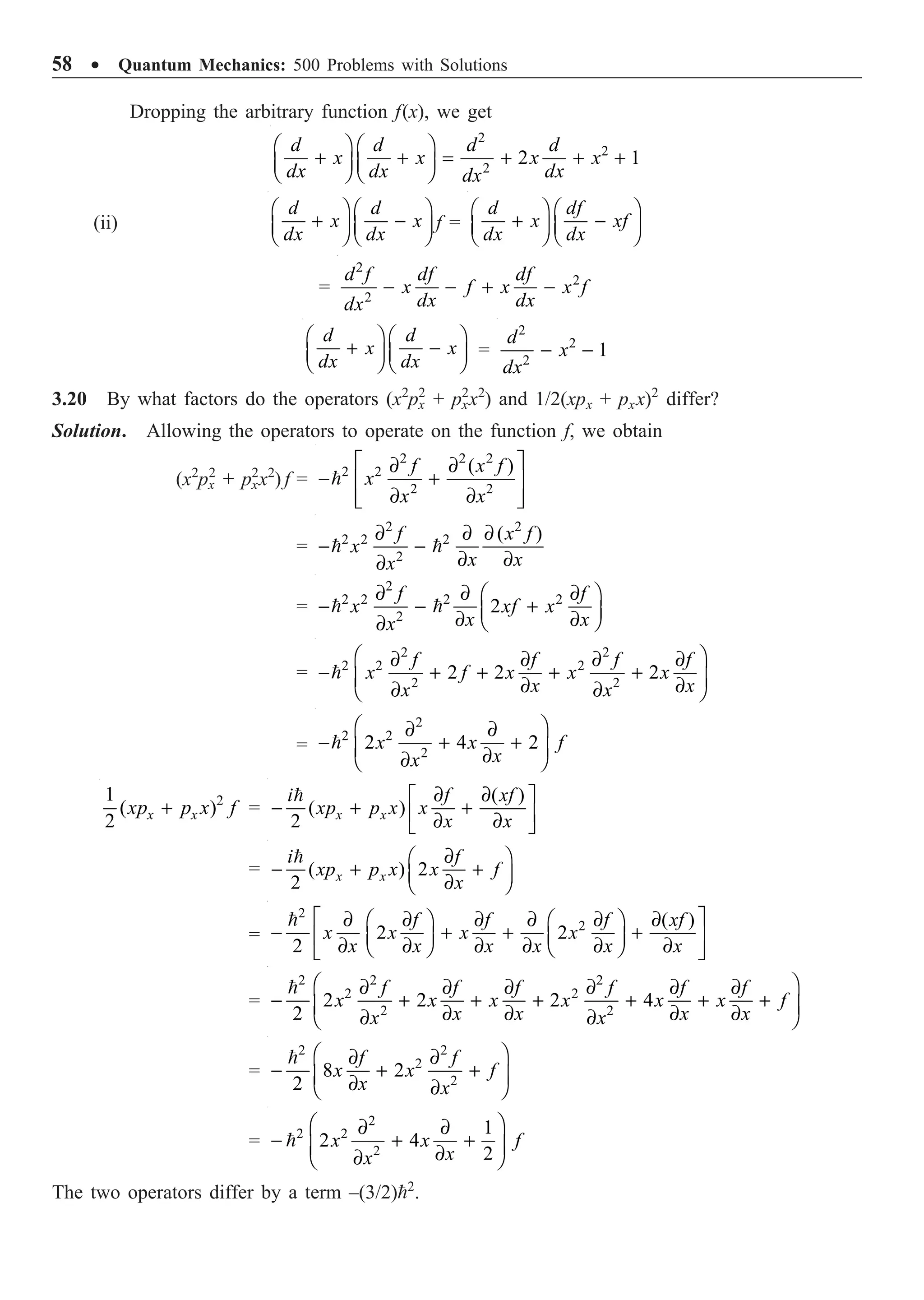
![General Formalism of Quantum Mechanics ∑ 59
3.21 The Laplace transform operator L is defined by Lf(x) =
0
( )
•
-
Ú
sx
e f x dx
(i) Is the operator L linear?
(ii) Evaluate Leax
if s a.
Solution.
(i) Consider the function f(x) = c1f1(x) + c2 f2(x), where c1 and c2 are constants. Then,
L[c1f1(x) + c2 f2(x)] = 1 1 2 2
0
[ ( ) ( )]
•
-
+
Ú
sx
e c f x c f x dx
= 1 1 2 2
0 0
( ) ( )
• •
- -
+
Ú Ú
sx sx
c e f x dx c e f x dx
= c1Lf1(x) + c2Lf2(x)
Thus, the Laplace transform operator L is linear.
(ii)
( )
( )
0 0 0
1
( )
•
• • - -
- - -
˘
= = = =
˙
- - -
˙
˚
Ú Ú
s a x
ax sx ax s a x e
Le e e dx e dx
s a s a
3.22 The operator eA
is defined by
2 3
1
2! 3!
= + + + +
A A A
e A
Show that eD
= T1, where D = (d/dx) and T1 is defined by T1 f(x) = f(x + 1)
Solution. In the expanded form,
eD
=
2 3
2 3
1 1
1
2! 3!
+ + + +
d d d
dx dx dx
(i)
eD
f(x) =
1 1
( ) ( ) ( ) ( )
2! 3!
¢ ¢¢ ¢¢¢
+ + + +
f x f x f x f x (ii)
where the primes indicate differentiation. We now have
T1 f(x) = f (x + 1) (iii)
Expanding f (x + 1) by Taylor series, we get
f (x + 1) =
1
( ) ( ) ( )
2!
¢ ¢¢
+ + +
f x f x f x (iv)
From Eqs. (i), (iii) and (iv), we can write
eD
f(x) = T1 f(x) or eD
= T1
3.23 If an operator A is Hermitian, show that the operator B = iA is anti-Hermitian. How about the
operator B = –iA?
Solution. When A is Hermitian,
* ( )*
y y t y y t
=
Ú Ú
A d A d
For the operator B = iA, consider the integral](https://image.slidesharecdn.com/quantummechanics500problemswithsolutionspdfdrive-220626164912-635041ea/75/Quantum-Mechanics_-500-Problems-with-Solutions-PDFDrive-pdf-69-2048.jpg)
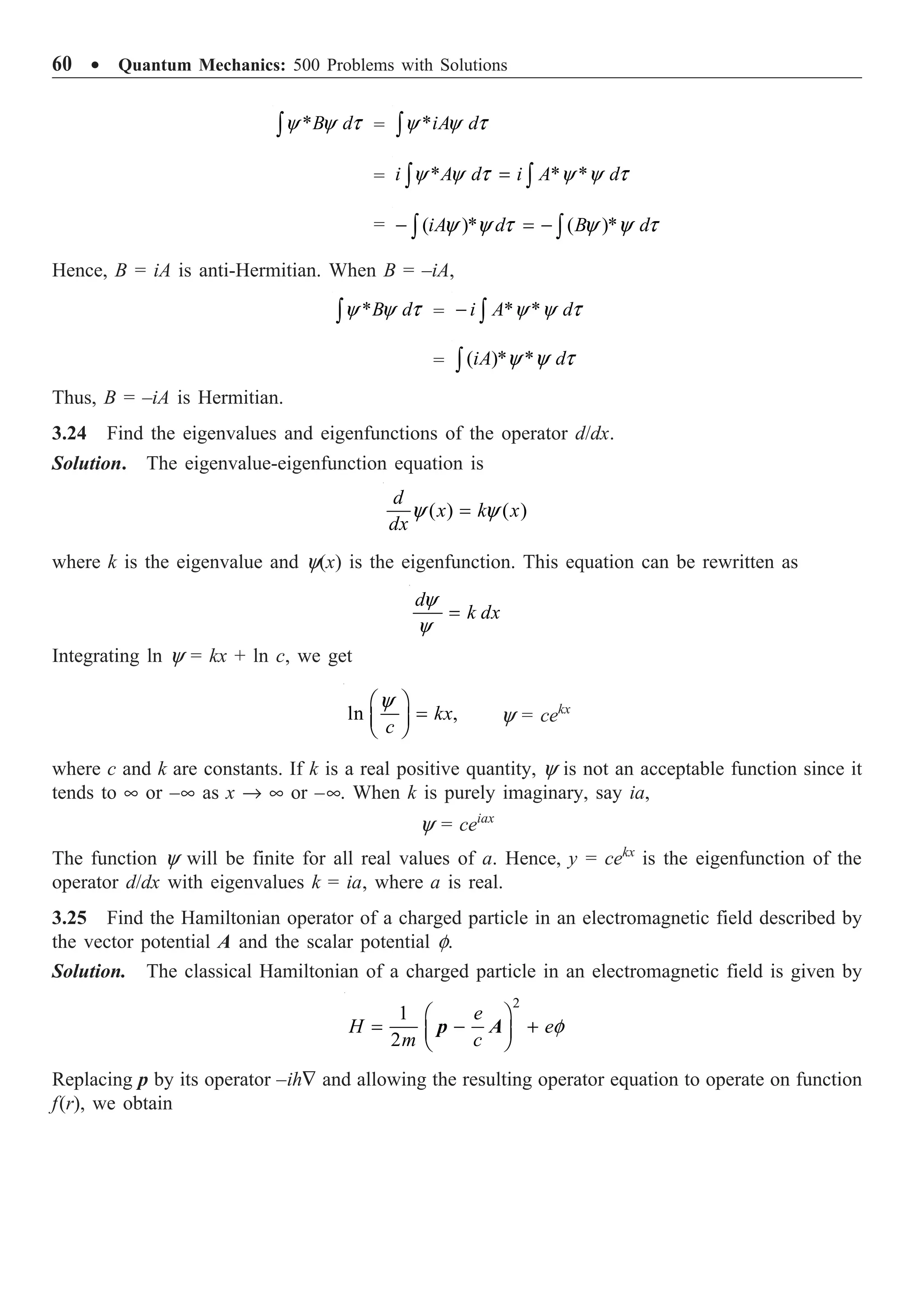

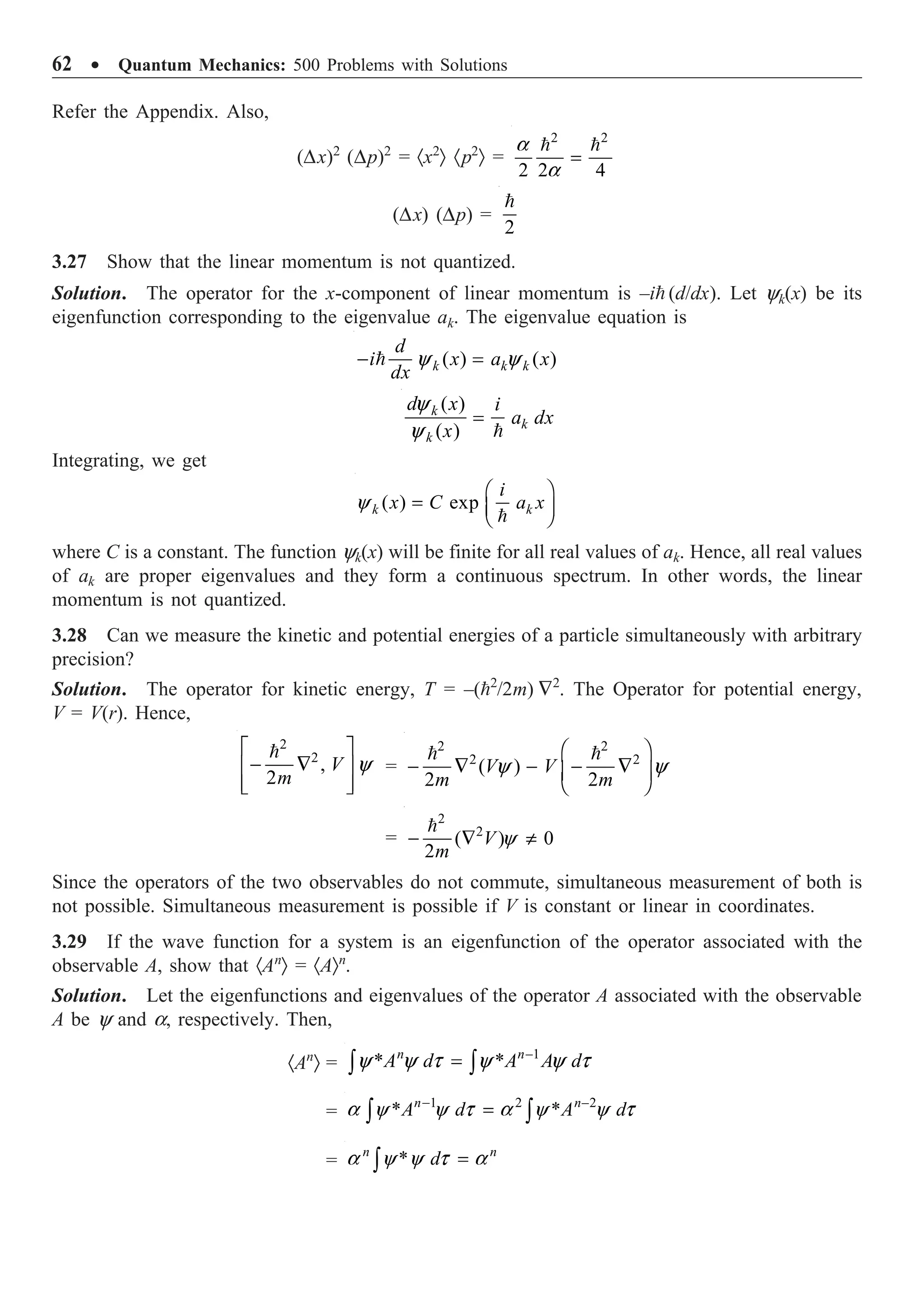
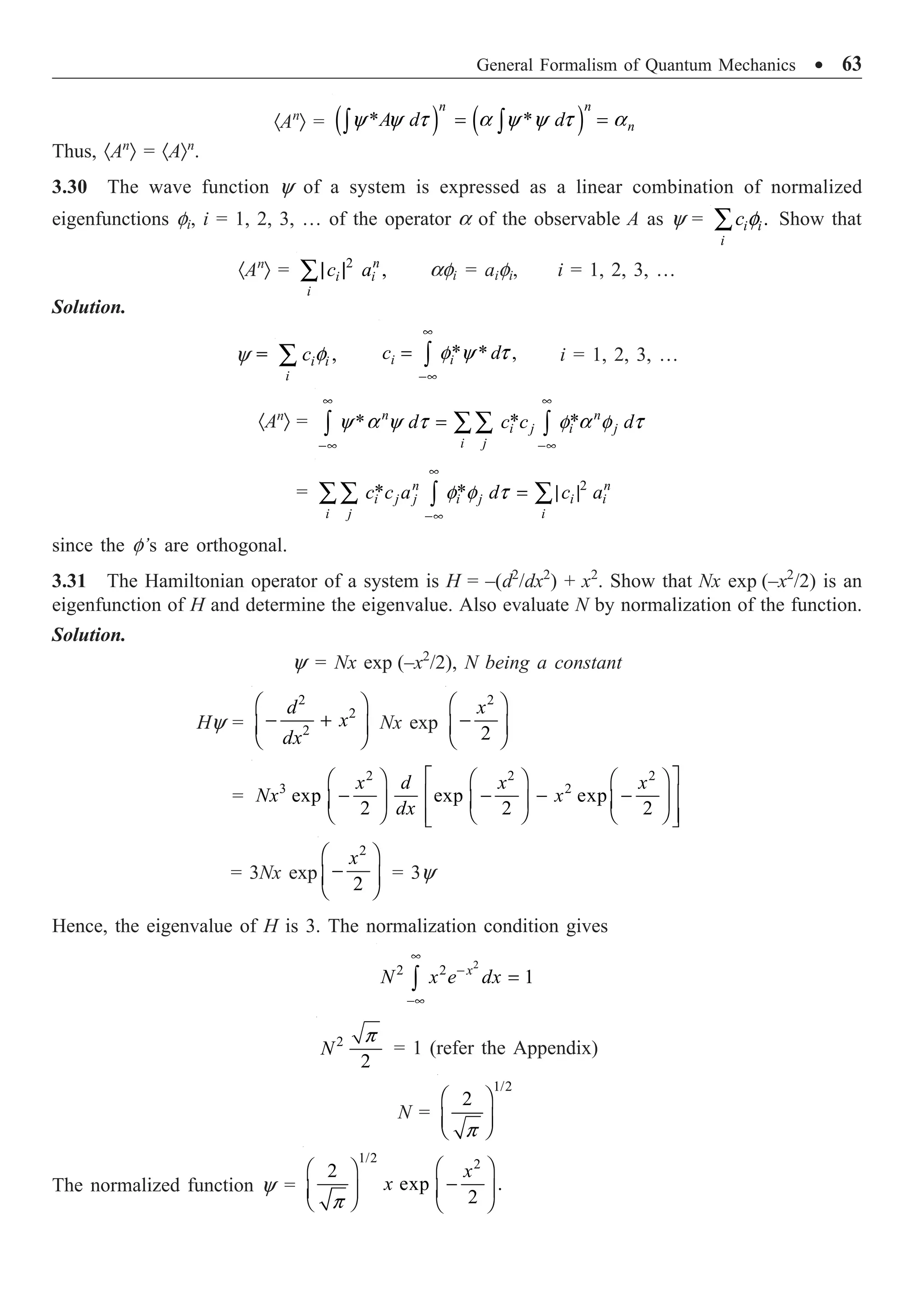
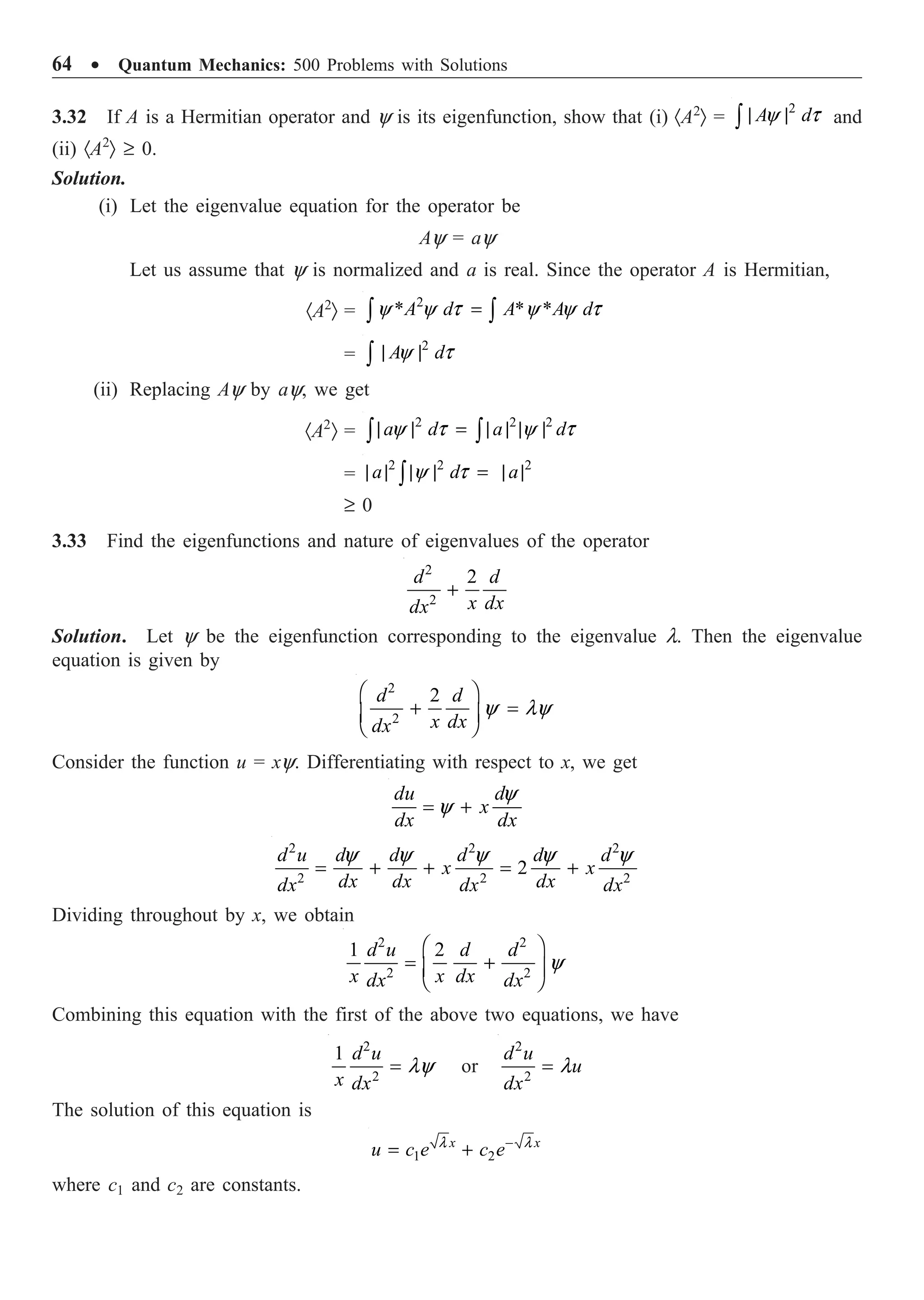
![General Formalism of Quantum Mechanics ∑ 65
For u to be a physically acceptable function, ÷l must be imaginary, say, ib. Also, at x = 0, u = 0.
Hence, c1 + c2 = 0, c1 = –c2. Consequently,
u = c1 (eibx
– e–ibx
), y =
1
x
c1 (eibx
– e–ibx
)
y =
sin b x
c
x
3.34 (i) Prove that the function y = sin (k1x) sin (k2 y) sin (k3z) is an eigenfunction of the Laplacian
operator and determine the eigenvalue. (ii) Show that the function exp (ik ◊ r ) is simultaneously an
eigenfunction of the operators –i— and –2
—2
and find the eigenvalues.
Solution.
(i) The eigenvalue equation is
—2
y =
2 2 2
2 2 2
Ê ˆ
∂ ∂ ∂
+ +
Á ˜
∂ ∂ ∂
Ë ¯
x y z
sin k1x sin k2y sin k3z
= 2 2 2
1 2 3
( )
- + +
k k k sin k1x sin k2y sin k3z
Hence, y is an eigenfunction of the Laplacian operator with the eigenvalue –(k2
1 + k2
2 + k2
3).
(ii) –i—ei(k ◊ r)
= keik ◊ r
–2
—2
ei(k ◊ r)
= +2
k2
ei(k ◊ r)
That is, exp (ik ◊ r) is a simultaneous eigenfunction of the operators –i— and –2
—2
, with
eigenvalues k and 2
k2
, respectively.
3.35 Obtain the form of the wave function for which the uncertainty product (Dx) (Dp) = /2.
Solution. Consider the Hermitian operators A and B obeying the relation
[A, B] = iC (i)
For an operator R, we have (refer Problem 3.30)
2
0
y t
| | ≥
Ú R d (ii)
Then, for the operator A + imB, m being an arbitrary real number,
( )* *( ) 0
y y t
- + ≥
Ú A imB A imB d (iii)
Since A and B are Hermitian, Eq. (iii) becomes
*( ) ( ) 0
y y t
- + ≥
Ú A imB A imB d
2 2 2
*( ) 0
y y t
- + ≥
Ú A mC m B d
2 2 2
0
· Ò - · Ò + · Ò ≥
A m C m B (iv)
The value of m, for which the LHS of Eq. (iv) is minimum, is when the derivative on the LHS with
respect to m is zero, i.e.,
0 = –·CÒ + 2m ·B2
Ò or m = 2
2
· Ò
· Ò
C
B
(v)](https://image.slidesharecdn.com/quantummechanics500problemswithsolutionspdfdrive-220626164912-635041ea/75/Quantum-Mechanics_-500-Problems-with-Solutions-PDFDrive-pdf-75-2048.jpg)
![66 ∑ Quantum Mechanics: 500 Problems with Solutions
When the LHS of (iv) is minimum,
(A + imB) y = 0 (vi)
Since
[A – ·AÒ, B – ·BÒ] = [A, B] = iC
Eq. (vi) becomes
[(A – ·AÒ) + im (B – ·BÒ)]y = 0 (vii)
Identifying x with A and p with B, we get
[(x – ·xÒ) + im (p – ·pÒ)] y = 0, 2
2( )
=
D
m
p
Substituting the value of m and repalcing p by –i(d/dx), we obtain
2
2
2( )
( ) 0
y
y
È ˘
D · Ò
+ - · Ò - =
Í ˙
Í ˙
Î ˚
d p i p
x x
dx
2
2
2( )
( )
y
y
È ˘
D · Ò
= - - · Ò -
Í ˙
Í ˙
Î ˚
d p i p
x x dx
Integrating and replacing Dp by /2(Dx), we have
ln y =
2 2
2
2( ) ( )
ln
2
D - · Ò · Ò
- + +
p x x i p x
N
y = N exp
2
2
( )
4( )
È ˘
- · Ò · Ò
- +
Í ˙
D
Í ˙
Î ˚
x x i p x
x
Normalization of the wave function is straightforward, which gives
y =
1/4 2
2 2
1 ( )
exp
2 ( ) 4( )
p
È ˘
Ê ˆ - · Ò · Ò
- +
Í ˙
Á ˜
D D
Ë ¯ Í ˙
Î ˚
x x i p x
x x
3.36 (i) Consider the wave function
2
2
( ) exp exp ( )
y
Ê ˆ
= -
Á ˜
Ë ¯
x
x A ikx
a
where A is a real constant: (i) Find the value of A; (ii) calculate ·pÒ for this wave function.
Solution.
(i) The normalization condition gives
2
2
2
2
exp 1
•
-•
Ê ˆ
- =
Á ˜
Ë ¯
Ú
x
A dx
a
1/2
2
2
1
2/
p
Ê ˆ
=
Á ˜
Ë ¯
A
a
or
1/2
2
1
2
p
Ê ˆ
=
Á ˜
Ë ¯
A a
2
p
=
A a](https://image.slidesharecdn.com/quantummechanics500problemswithsolutionspdfdrive-220626164912-635041ea/75/Quantum-Mechanics_-500-Problems-with-Solutions-PDFDrive-pdf-76-2048.jpg)
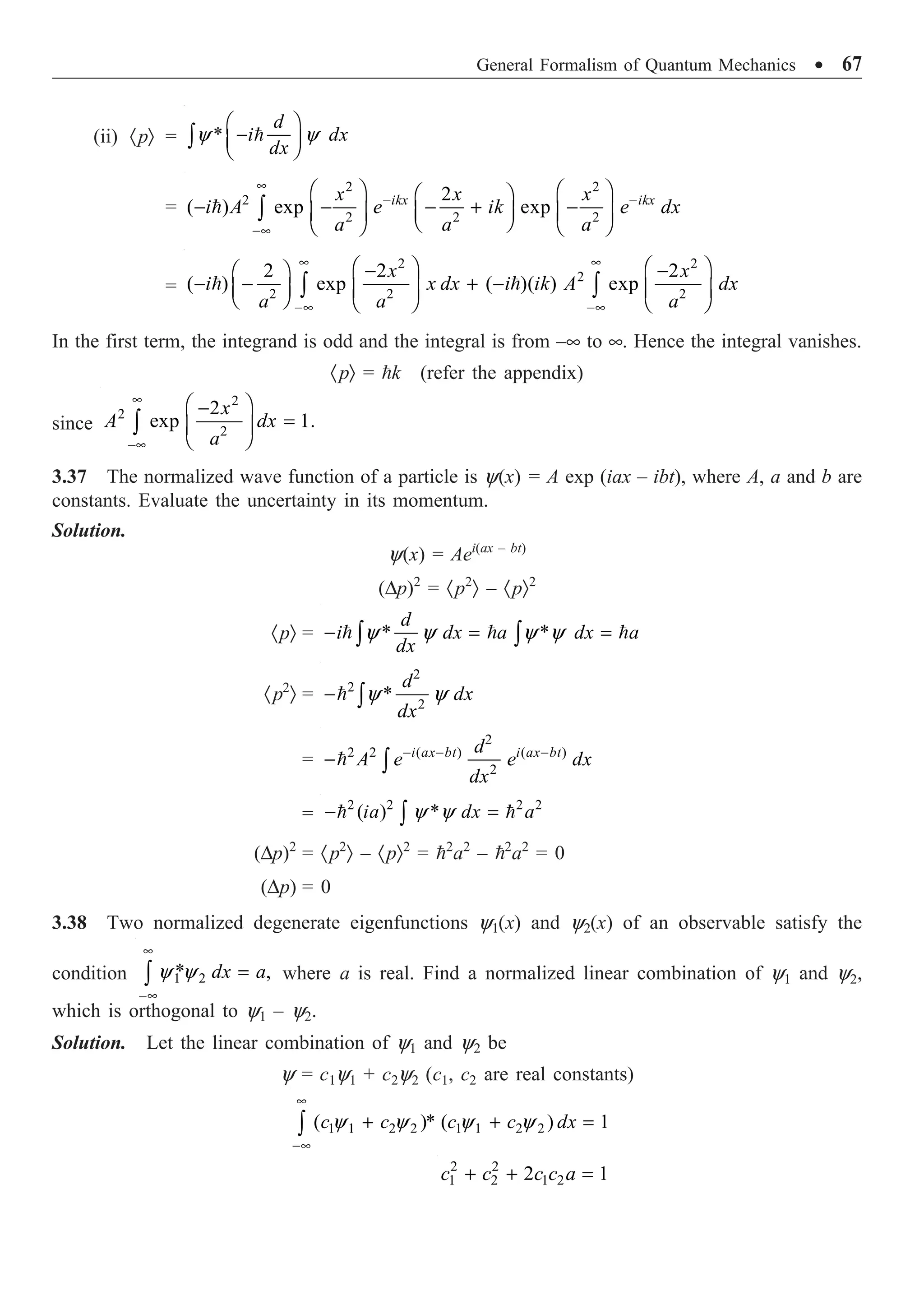
![68 ∑ Quantum Mechanics: 500 Problems with Solutions
As the combination y is orthogonal to y1 – y2,
1 2 1 1 2 2
( )* ( ) 0
y y y y
- + =
Ú c c dx
1 2 2 1 0
- + - =
c c c a c a
(c1 – c2)(1 – a) = 0 or c1 = c2
With this condition, the earlier condition on c1 and c2 takes the form
2 2 2
2 2 2
2 1
+ + =
c c c a or 2
1
2 2
=
+
c
a
Then, the required linear combination is
1 2
2 2
y y
y
+
=
+ a
3.39 The ground state wave function of a particle of mass m is given by y(x) = exp (–a2
x4
/4), with
energy eigenvalue 2
a2
/m. What is the potential in which the particle moves?
Solution. The Schrödinger equation of the system is given by
2 4 2 4
2 2 2 2
/4 /4
2
2
a a
a
- -
Ê ˆ
- + =
Á ˜
Ë ¯
x x
d
V e e
m m
dx
2 4 2 4 2 4
2 2 2
2 2 4 6 /4 /4 /4
( 3 )
2
a a a
a
a a - - -
- - + + =
x x x
x x e Ve e
m m
2 2 2 2
4 6 2 2
3
2 2 2
a
a a
= - +
V x x
m m m
3.40 An operator A contains time as a parameter. Using time-dependent Schrödinger equation for
the Hamiltonian H, show that
[ , ]
· Ò ∂
= · Ò +
∂
d A i A
H A
dt t
Solution. The ket |ys(t)Ò varies in accordance with the time-dependent Schrödinger equation
( ) ( )
y y
∂
| Ò = | Ò
∂
s s
i t H t
t
(i)
As the Hamiltonian H is independent of time, Eq. (3.24) can be integrated to give
|ys(t)Ò = exp (–iHt/)|ys(0)Ò (ii)
Here, the operator exp (–iHt/) is defined by
0
1
exp
!
n
n
iHt iHt
n
•
=
Ê ˆ Ê ˆ
- = -
Á ˜ Á ˜
Ë ¯ Ë ¯
 (iii)
Equation (ii) reveals that the operator exp (–iHt/) changes the ket |ys(0)Ò into ket |ys(t)Ò. Since H
is Hermitian and t is real, this operator is unitary and the norm of the ket remains unchanged. The
Hermitian adjoint of Eq. (i) is](https://image.slidesharecdn.com/quantummechanics500problemswithsolutionspdfdrive-220626164912-635041ea/75/Quantum-Mechanics_-500-Problems-with-Solutions-PDFDrive-pdf-78-2048.jpg)
![General Formalism of Quantum Mechanics ∑ 69
†
( ) ( ) ( )
y y y
∂
- · | = · | = · |
∂
s s s
i t t H t H
t
(iv)
whose solution is
( ) (0) exp
y y
Ê ˆ
· | = · | Á ˜
Ë ¯
s s
iHt
t (v)
Next we consider the time derivative of expectation value of the operator As. The time
derivative of ·AsÒ is given by
( ) ( )
y y
· Ò = · | | Ò
s s s s
d d
A t A t
dt dt
(vi)
where As is the operator representing the observable A. Replacing the factors ( )
y
| Ò
s
d
t
dt
and
( )
y
· |
s
d
t
dt
and using Eqs. (i) and (iv), we get
1
( ) ( ) ( ) ( )
y y y y
∂
· Ò = · | - | Ò + · Ò
∂
s
s s s s s s s
A
d
A t A H HA t t t
dt i t
1
[ ]
∂
· Ò = +
∂
s
s s
A
d
A A H
dt i t
(vii)
3.41 A particle is constrained in a potential V(x) = 0 for 0 £ x £ a and V(x) = • otherwise. In the
x-representation, the wave function of the particle is given by
2 2
( ) sin
p
y =
x
x
a a
Determine the momentum function F(p).
Solution. From Eq. (3.35),
1
( ) ( ) exp
2
ipx
p x dx
y
p
•
-•
Ê ˆ
F = -
Á ˜
Ë ¯
Ú
In the present case, this equation can be reduced to
1
( )
p
F =
p I
a
where
( / )
0
2
sin
a
ipx
x
I e dx
a
p -
= Ú
Integrating by parts, we obtain
( / ) ( / )
0 0
2 2 2
sin cos
a a
ipx ipx
x x
I e e dx
ip a ip a a
p p p
- -
È ˘ Ê ˆ
= - - -
Á ˜
Í ˙ Ë ¯
Î ˚
Ú](https://image.slidesharecdn.com/quantummechanics500problemswithsolutionspdfdrive-220626164912-635041ea/75/Quantum-Mechanics_-500-Problems-with-Solutions-PDFDrive-pdf-79-2048.jpg)
![70 ∑ Quantum Mechanics: 500 Problems with Solutions
Since the integrated term is zero,
I = ( / ) ( / )
0
0
2 2 2 2 2
cos sin
a a
ipx ipx
x x
e e dx
ipa a ip ipa ip a a
p p p p p
- -
È ˘
Ê ˆ Ê ˆ Ê ˆ
- - - -
Í ˙
Á ˜ Á ˜ Á ˜
Ë ¯ Ë ¯ Ë ¯
Î ˚
Ú
=
2 2
( / )
2 2
2 4
[ 1]
ipx
e I
ipa ip a p
p p
-
Ê ˆ
- - +
Á ˜
Ë ¯
2 2
( / )
2 2 2
4 2
1 [ 1]
2
ipx
I e
a p ap
p p -
Ê ˆ
- = -
Á ˜
Ë ¯
I =
2
( / )
2 2 2 2
2
[ 1]
4
ipa
a
e
a p
p
p
-
-
-
With this value of I,
F(p) =
2
( / )
2 2 2 2
1 2
[ 1]
4
ipa
a
e
a p
a
p
p
p
-
-
-
=
1/2 1/2 3/2
( / )
2 2 2 2
2
[ 1]
4
ipa
a
e
a p
p
p
-
-
-
3.42 A particle is in a state |yÒ = (1/p)1/4
exp (–x2
/2). Find Dx and Dpx. Hence evaluate the
uncertainty product (Dx) (Dpx).
Solution. For the wave function, we have
2
1/2
1
0
x
x xe dx
p
•
-
-•
Ê ˆ
· Ò = =
Á ˜
Ë ¯ Ú
since the integrand is an odd function of x. Now,
·x2
Ò =
2
1/2 1/2
2
1 1 1
2
4 2
p
p p
•
-
-•
Ê ˆ Ê ˆ
= =
Á ˜ Á ˜
Ë ¯ Ë ¯
Ú
x
x e dx (see Appendix)
(Dx)2
= ·x2
Ò – ·x2
Ò =
1
2
·pxÒ =
1/2 2 2
1
exp exp
2 2
x d x
i dx
dx
p
•
-•
Ê ˆ Ê ˆ
Ê ˆ Ê ˆ
- - -
Á ˜ Á ˜
Á ˜ Á ˜
Ë ¯ Ë ¯
Ë ¯ Ë ¯
Ú
=
2
1/2
1
0
x
i xe dx
p
•
-
-•
Ê ˆ
=
Á ˜
Ë ¯ Ú](https://image.slidesharecdn.com/quantummechanics500problemswithsolutionspdfdrive-220626164912-635041ea/75/Quantum-Mechanics_-500-Problems-with-Solutions-PDFDrive-pdf-80-2048.jpg)


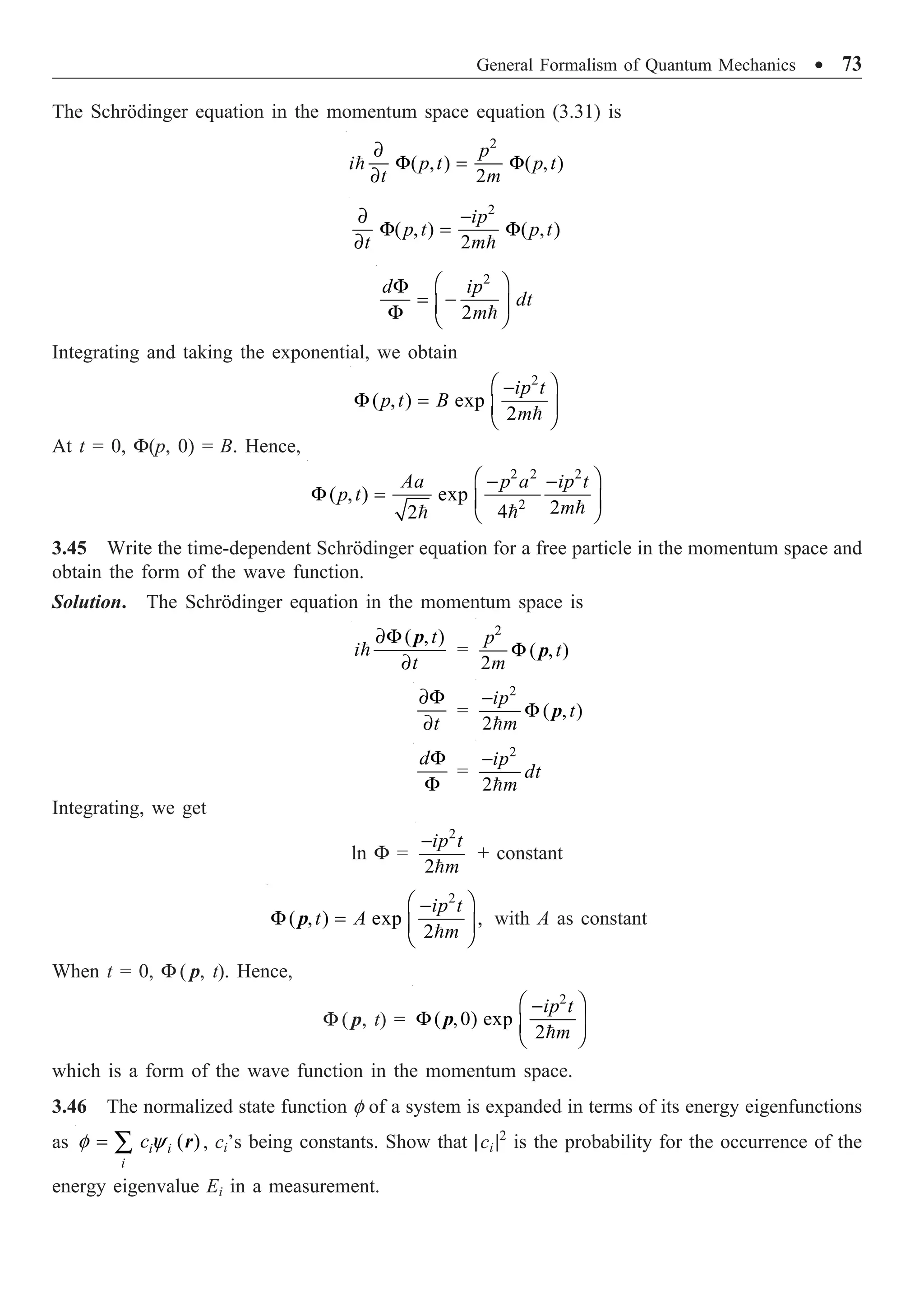
![74 ∑ Quantum Mechanics: 500 Problems with Solutions
Solution. The expectation value of the Hamiltonian operator H is
·HÒ = *
i j i j
i j
H c e H
f f y y
· | | Ò = · | | Ò
ÂÂ
= * y y
· | | Ò
ÂÂ i j i j j
i j
c c E
= 2
| |
 i i
i
c E
Let wi be the probability for the occurrence of the eignevalue Ei. Then,
·HÒ = w
 i i
i
E
Since Ei’s are constants from the above two equations for ·HÒ,
wi = | ci |2
3.47 Show that, if the Hamiltonian H of a system does not depend explicitly on time, the ket |y(t)Ò
varies with time according to
|y(t)Ò = exp (0)
y
Ê ˆ
- | Ò
Á ˜
Ë ¯
iHt
Solution. The time-dependent Schrödinger equation for the Hamiltonian operator H is
( ) ( )
y y
Ò = | Ò
d
i t H t
dt
Rearranging, we get
( )
( )
y
y
| Ò
=
| Ò
d t H
dt
t i
Integrating, we obtain
ln
( ) ,
Ht
t C
i
y
| Ò = + with C as constant,
C = ln |y(0)Ò
Substituting the value of C, we have
( )
ln
(0)
y
y
| Ò
=
| Ò
t Ht
i
( )
exp
(0)
y
y
| Ò Ê ˆ
= -
Á ˜
| Ò Ë ¯
t iHt
( ) exp (0)
y y
Ê ˆ
| Ò = - | Ò
Á ˜
Ë ¯
iHt
t
3.48 Show that, if P, Q and R are the operators in the Schrödinger equation satisfying the relation
[P, Q] = R, then the corresponding operators PH, QH and RH of the Heisenberg picture satisfy the
relation [PH, QH] = RH.](https://image.slidesharecdn.com/quantummechanics500problemswithsolutionspdfdrive-220626164912-635041ea/75/Quantum-Mechanics_-500-Problems-with-Solutions-PDFDrive-pdf-84-2048.jpg)
![General Formalism of Quantum Mechanics ∑ 75
Solution. The operator in the Heisenberg picture AH corresponding to the operator AS in the
Schrödinger equation is given by
AH(t) = eiHt/
ASe–iHt/
By the Schrödinger equation,
PQ – QP = R
Inserting e–iHt/
e–iHt/
= 1 between quantities, we obtain
Pe–iHt/
eiHt/
Q – Qe–iHt/
eiHt/
P = R
Pre-multiplying each term by eiHt/
and post-multiplying by e–iHt/
, we get
eiHt/
Pe–iHt/
Qe–iHt/
– eiHt/
Qe–iHt/
eiHt/
Pe–iHt/
= eiHt/
Re–iHt/
PHQH – QHPH = RH
[PH, QH] = RH
3.49 Show that the expectation value of an observable, whose operator does not depend on time
explicitly, is a constant with zero uncertainty.
Solution. Let the operator associated with the observable be A and its eigenvalue be an. The wave
function of the system is
( , ) ( ) exp
y
Ê ˆ
Y = -
Á ˜
Ë ¯
n
n n
iE t
t
r r
The expectation value of the operator A is
·AÒ = *( ) exp ( ) exp
y y t
•
-•
Ê ˆ Ê ˆ
Á ˜ Á ˜
Ë ¯ Ë ¯
Ú
n n
n n
iE t iE t
A d
r r
= * *
( ) ( ) ( ) ( )
y y t y y t
• •
-• -•
=
Ú Ú
n n n n n
A d a d
r r r r
= an
That is, the expectation value of the operator A is constant. Similarly,
·A2
Ò =
2 2
*( ) ( )
y y t
•
-•
=
Ú n n n
A d a
r r
Uncertainty (DA) = 2 2 2 2
0
· Ò - · Ò = - =
n n
A A a a
3.50 For the one-dimensional motion of a particle of mass m in a potential V(x), prove the
following relations:
· Ò
· Ò
= x
p
d x
dt m
,
· Ò
= -
x
d p dV
dt dx
Explain the physical significance of these results also.
Solution. If an operator A has no explicit dependence on time, from Eq. (3.26),
[ , ] ,
· Ò = · Ò
d
i A A H
dt
H being the Hamiltonian operator](https://image.slidesharecdn.com/quantummechanics500problemswithsolutionspdfdrive-220626164912-635041ea/75/Quantum-Mechanics_-500-Problems-with-Solutions-PDFDrive-pdf-85-2048.jpg)
![76 ∑ Quantum Mechanics: 500 Problems with Solutions
Since H =
2
( )
2
+
x
p
V x
m
, we have
· Ò
d
i x
dt
=
2
,
2
È ˘
+
Í ˙
Í ˙
Î ˚
x
p
x V
m
2
,
2
È ˘
+
Í ˙
Í ˙
Î ˚
x
p
x V
m
= 2
1
[ , ] [ , ( )]
2
+
x
x p x V x
m
=
1 1
[ , ] [ , ]
2 2
+
x x x x
x p p p x p
m m
= 2
2
=
x
x
p
i
p i
m m
Consequently,
· Ò
· Ò
= x
p
d x
dt m
For the second relation, we have
[ , ]
· Ò = · Ò
x x
d
i p p H
dt
2
1
[ , ] [ , ] [ , ] [ , ( )]
2
= + =
x x x x x
p H p p p V p V x
m
Allowing [px, V(x)] to operate on y(x), we get
, ( ) y
∂
È ˘
-
Í ˙
∂
Î ˚
i V x
x
= ( )
y y
∂ ∂
- +
∂ ∂
i V i V
x x
= y
∂
-
∂
V
i
x
Hence,
· Ò = -
x
d dV
i p i
dt dx
or · Ò = -
x
d dV
p
dt dx
In the limit, the wave packet reduces to a point, and hence
·xÒ = x, ·pxÒ = px
Then the first result reduces to
= x
dx
m p
dt
which is the classical equation for momentum. Since – (∂V/∂x) is a force, when the wave packet
reduces to a point, the second result reduces to Newton’s Second Law of Motion.](https://image.slidesharecdn.com/quantummechanics500problemswithsolutionspdfdrive-220626164912-635041ea/75/Quantum-Mechanics_-500-Problems-with-Solutions-PDFDrive-pdf-86-2048.jpg)
![General Formalism of Quantum Mechanics ∑ 77
3.51 Find the operator for the velocity of a charged particle of charge e in an electromagnetic field.
Solution. The classical Hamiltonian for a charged particle of charge e in an electromagnetic field
is
2
1
2
f
Ê ˆ
= - +
Á ˜
Ë ¯
e
H e
m c
p A
where A is the vector potential and f is the scalar potential of the field. The operator representing
the Hamiltonian (refer Problem 3.23)
2 2 2
2
2
2 2 2
f
= - — + — ◊ + ◊ — + +
ie ie e
H e
m mc mc mc
A
A A
For our discussion, let us consider the x-component of velocity. In the Heisenberg picture, for an
operator A not having explicit dependence on time, we have
1
[ , ]
=
dA
A H
dt i
Applying this relation for the x coordinate of the charged particle, we obtain
1
[ , ]
=
dx
x H
dt i
As x commutes with the second, fourth and fifth terms of the above Hamiltonian, we have
dx
dt
=
2 2
2
1
,
2
È ˘
-
+
Í ˙
Í ˙
Î ˚
x
d ie d
x A
i m mc dx
dx
=
2 2
2
1 1
, ,
2
È ˘
- È ˘
+
Í ˙ Í ˙
Î ˚
Í ˙
Î ˚
x
d ie d
x x A
i m i mc dx
dx
2 2
2
,
2
y
È ˘
-
Í ˙
Í ˙
Î ˚
d
x
m dx
=
2 2 2
2
( )
2 2
y y
- +
d d d x
x
m m dx dx
dx
=
2 2 2 2
2 2
2
2 2
y y y
Ê ˆ
- + +
Á ˜
Ë ¯
d d d
x x
m m dx
dx dx
=
2
y
d
m dx
,
È ˘
Í ˙
Î ˚
x
ie d
x A
mc dx
=
( )
y y
È ˘
-
Í ˙
Î ˚
x x
ie d d x
xA A
mc dx dx
= y
-
x
ie
A
mc
Substituting these results, we get
2
1 1 1 1
È ˘ Ê ˆ
= - = - - = -
Á ˜
Í ˙ Ë ¯
Î ˚
x x x x
dx d ie d e e
A i A p A
dt i m dx i mc m dx c m c](https://image.slidesharecdn.com/quantummechanics500problemswithsolutionspdfdrive-220626164912-635041ea/75/Quantum-Mechanics_-500-Problems-with-Solutions-PDFDrive-pdf-87-2048.jpg)
![78 ∑ Quantum Mechanics: 500 Problems with Solutions
Including the other two components, the operator for
1 Ê ˆ
= -
Á ˜
Ë ¯
v
e
m c
p A , p = i—
3.52 For the momentum and coordinate operators, prove the following: (i) ·pxxÒ – ·xpxÒ = –i,
(ii) for a bound state, the expectation value of the momentum operator ·pÒ is zero.
Solution.
(i) ·pxÒ = * ( )
y y
Ê ˆ
-
Á ˜
Ë ¯
Ú
d
i x dx
dx
= * *
y
y y y
Ê ˆ
- +
Á ˜
Ë ¯
Ú
d
i x dx
dx
= * *
y y y y
Ê ˆ
- - Á ˜
Ë ¯
Ú Ú
d
i dx i x dx
dx
= *
y y
Ê ˆ
- + -
Á ˜
Ë ¯
Ú
d
i x i dx
dx
= - + · Ò
i xp
·pxÒ – ·xpÒ = –i
(ii) The expectation value of p for a bound state defined by the wave function yn is
* ( )
y y t
· Ò = - —
Ú
n n
p i d
If yn is odd, —yn is even and the integrand becomes odd. The value of the integral is then zero.
If yn is even, —yn is odd and the integrand is again odd. Therefore, · pÒ = 0.
3.53 Substantiate the statement: “Eigenfunctions of a Hermitian operator belonging to distinct
eigenvalues are orthogonal” by taking the time-independent Schrödinger equation of a one-
dimensional system.
Solution. The time-independent Schrödinger equation of a system in state n is
2
2 2
2
[ ( )] 0
y
y
+ - =
n
n n
d m
E V x
dx
(i)
The complex conjugate equation of state k is
2
2 2
* 2
*
[ ( )] 0
y
y
+ - =
k
k k
d m
E V x
dx
(ii)
Multiplying the first by yk* and the second by yn from LHS and subtracting, we get
2 2
2 2 2
* 2
* *
( ) 0
y y
y y y y
- + - =
n k
k n n k k n
d d m
E E
dx dx
(iii)](https://image.slidesharecdn.com/quantummechanics500problemswithsolutionspdfdrive-220626164912-635041ea/75/Quantum-Mechanics_-500-Problems-with-Solutions-PDFDrive-pdf-88-2048.jpg)
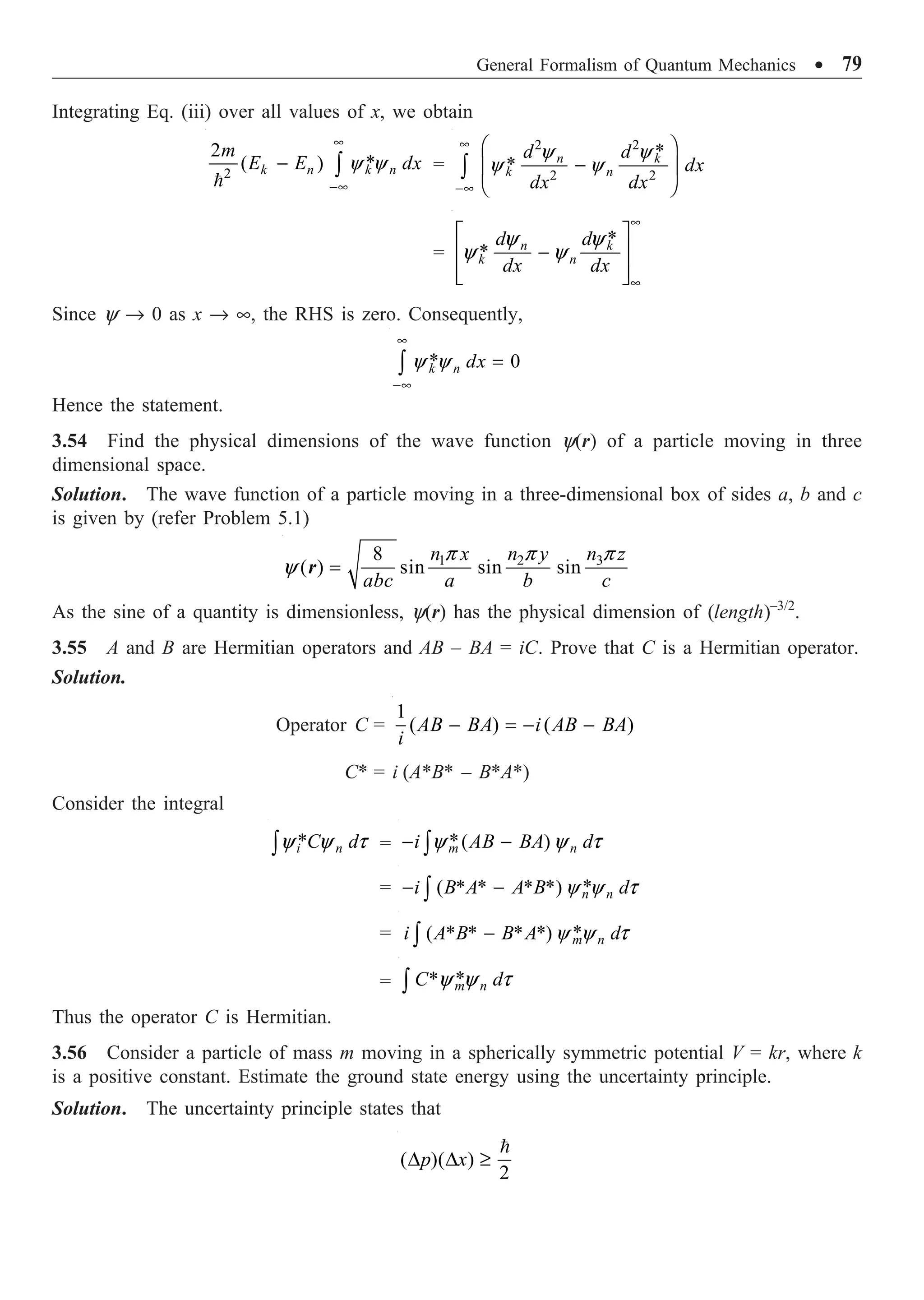
![80 ∑ Quantum Mechanics: 500 Problems with Solutions
Since the potential is spherically symmetric, ·pÒ = ·rÒ = 0. Hence,
·DrÒ2
= ·r2
Ò, ·DpÒ2
= ·p2
Ò
We can then assume that
Dr @ r, Dp @ p
( )( )
2
D D =
p r or Dp =
2( )
D
r
Energy E =
2 2
( )
( )
2 2
D
+ = + D
p p
kr k r
m m
=
2
2
( )
8 ( )
+ D
D
k r
m r
For the energy to be minimum, [∂E/∂(Dr)] = 0, and hence
2
3
0
4 ( )
- + =
D
k
m r
or
1/3
2
4
Ê ˆ
D = Á ˜
Ë ¯
r
mk
Substituting this value of Dr in the energy equation, we get
1/3
2 2
3
2 4
Ê ˆ
= Á ˜
Ë ¯
k
E
m
3.57 If the Hamiltonian of a system H = (px
2
/2m) + V(x), obtain the value of the commutator
[x, H]. Hence, find the uncertainty product (Dx) (DH).
Solution.
[x, H] =
2
, [ , ( )]
2
È ˘
+
Í ˙
Í ˙
Î ˚
x
p
x x V x
m
=
1 1
[ , ] [ , ]
2 2
+
x x x x
x p p p x p
m m
=
1 1
( ) ( )
2 2
+
x x
i p p i
m m
=
x
i p
m
(i)
Consider the operators A and B. If
[A, B] = iC (ii)
the general uncertainty relation states that
( )( )
2
· Ò
D D =
C
A B (iii)
Identifying A with x, B with H and C with px, we can write
( )( )
2
D D ≥ · Ò
x
x H p
m](https://image.slidesharecdn.com/quantummechanics500problemswithsolutionspdfdrive-220626164912-635041ea/75/Quantum-Mechanics_-500-Problems-with-Solutions-PDFDrive-pdf-90-2048.jpg)
![General Formalism of Quantum Mechanics ∑ 81
3.58 If Lz is the z-component of the angular momentum and f is the polar angle, show that [f, Lz]
= i and obtain the value of (Df)(DLz).
Solution. The z-component of angular momentum in the spherical polar coordinates is given by
Lz =
f
-
d
i
d
[f, Lz] = , ,
f f
f f
È ˘ È ˘
- = -
Í ˙ Í ˙
Î ˚ Î ˚
d d
i i
d d
Allowing the commutator to operate on a function f(f), we get
,
f
f
È ˘
Í ˙
Î ˚
d
f
d
=
( )
f
f
f f
-
df d f
d d
= f f
f f
- - = -
df df
f f
d d
Hence,
, 1
f
f
È ˘
= -
Í ˙
Î ˚
d
d
With this value of [f, (d/df)], we have
[f, Lz] = i
Comparing this with the general uncertainty relation, we get
[A, B] = iC, ( )( )
2
· Ò
D D ≥
C
A B
( )( )
2
f
D D ≥
z
L
3.59 Find the probability current density j(r, t) associated with the charged particle of charge e and
mass m in a magnetic field of vector potential A which is real.
Solution. The Hamiltonian operator of the system is (refer Problem 3.23)
H =
2 2 2 2
2
2
1
( ) ( )
2 2 2 2
Ê ˆ
- = - — + — ◊ + ◊ — +
Á ˜
Ë ¯
e ie ie e A
A A
m c m mc mc mc
p A
The time-dependent Schrödinger equation is
2 2 2
2
2
( )
2 2 2
∂Y
= - — Y + — ◊ Y + ◊ —Y + Y
∂
ie ie e A
i A A
t m mc mc mc
Its complex conjugate equation is
2 2 2
2
2
*
* ( ) * * *
2 2 2
∂Y
- = - — Y - — ◊ Y - ◊ —Y + Y
∂
ie ie e A
i A A
t m mc mc mc
Multiplying the first equation by Y* from left and the complex conjugate equation by Y and
subtracting, we get](https://image.slidesharecdn.com/quantummechanics500problemswithsolutionspdfdrive-220626164912-635041ea/75/Quantum-Mechanics_-500-Problems-with-Solutions-PDFDrive-pdf-91-2048.jpg)
![82 ∑ Quantum Mechanics: 500 Problems with Solutions
*
*
∂Y ∂Y
Ê ˆ
Y + Y
Á ˜
∂ ∂
Ë ¯
i
t t
=
2
2 2
[ * *] [ *( ) ( ) *]
2 2
- Y — Y - Y— Y + Y — ◊ Y + Y — ◊ Y
ie
m mc
A A
+ [ *( ) ( *) ]
2
Y —Y ◊ + Y —Y ◊
ie
mc
A A
( * )
∂
Y Y
∂t
= [ ( * *)] * ( ) [ * *]
2
— ◊ Y —Y - Y—Y + Y Y — + Y ◊ —Y + Y ◊ —Y
i e e
m mc mc
A A A
( * )
∂
Y Y
∂t
= ( * *) ( * )
2
È ˘
— ◊ Y —Y - Y—Y + Y Y
Í ˙
Î ˚
i e
m mc
A
Defining the probability current density vector j(r, t) by
( , ) ( * * ) ( * )
2
= Y—Y - Y —Y - Y Y
i e
t
m mc
j r A
the above equation reduces to
( , ) ( , ) 0
∂
+ — ◊ =
∂
P t t
t
r j r
which is the familiar equation of continuity for probability.
3.60 The number operator Nk is defined by Nk = a†
k ak, where a†
k and ak obey the commutation
relations
[ak, a†
l] = dkl, [ak, al] = [a†
k, a†
l] = 0
Show that (i) the commutator [Nk, Nl] = 0, and (ii) all positive integers including zero are the
eigenvalues of Nk.
Soultion. The number operator Nk is defined by
Nk = a†
k ak
(i) [Nk, Nl] = [a†
k ak, a†
l al] = [a†
k ak, a†
l] al + a†
l [a†
k ak, al]
= a†
k [ak, a†
l] al + [a†
k, a†
l] ak al + a†
l a†
k [ak al] + a†
l [a†
k, al] ak
= a†
k dkl al + 0 + 0 + a†
l (–dkl) ak
= a†
k ak – a†
k ak = 0
(ii) Let the eigenvalue equation of Nk be
Nky(nk) = nky(nk)
where nk is the eigenvalue. Multiplying from left by y*(nk) and integrating over the entire
space, we get
nk = *( ) ( )
y y t
Ú k k k
n N n d
=
†
*( ) ( )
y y t
Ú k k k
k
n a a n d
=
2
( ) 0
y t
| | ≥
Ú k k
a n d
Thus, the eigenvalues of Nk are all positive integers, including zero.](https://image.slidesharecdn.com/quantummechanics500problemswithsolutionspdfdrive-220626164912-635041ea/75/Quantum-Mechanics_-500-Problems-with-Solutions-PDFDrive-pdf-92-2048.jpg)
![General Formalism of Quantum Mechanics ∑ 83
3.61 For a system of fermions, the creation (a†
k) and annihilation (a) operators obey the
anticommutation relations
[ak, ak
†
]+ = dkl, [ak, al]+ = [ak
†
, al
†
]+ = 0
Show that the eigenvalues of the number operator Nk defined by Nk = a†
k ak are 0 and 1.
Solution. Since [ak, ak
†
]+ = dkl, we have
[ak, ak
†
]+ = ak ak
†
+ ak
†
ak = 1
ak ak
†
= 1 – ak
†
ak (i)
Also,
[ak, ak]+ = [ak
†
, ak
†
]+ = 0
ak ak = ak
†
ak
†
= 0 (ii)
Nk
2
= ak
†
ak ak
†
ak = ak
†
(ak ak
†
)ak
= ak
†
(1 – ak
†
ak) ak = ak
†
ak – ak
†
ak
†
akak
= Nk (iii)
since the second term is zero. If nk is the eigenvalue of Nk, Eq (iii) is equivalent to
nk
2
= nk or nk
2
– nk = 0
nk (nk – 1) = 0 (iv)
which gives
nk = 0, 1
Thus, the eigenvalues of Nk are 0 and 1.](https://image.slidesharecdn.com/quantummechanics500problemswithsolutionspdfdrive-220626164912-635041ea/75/Quantum-Mechanics_-500-Problems-with-Solutions-PDFDrive-pdf-93-2048.jpg)
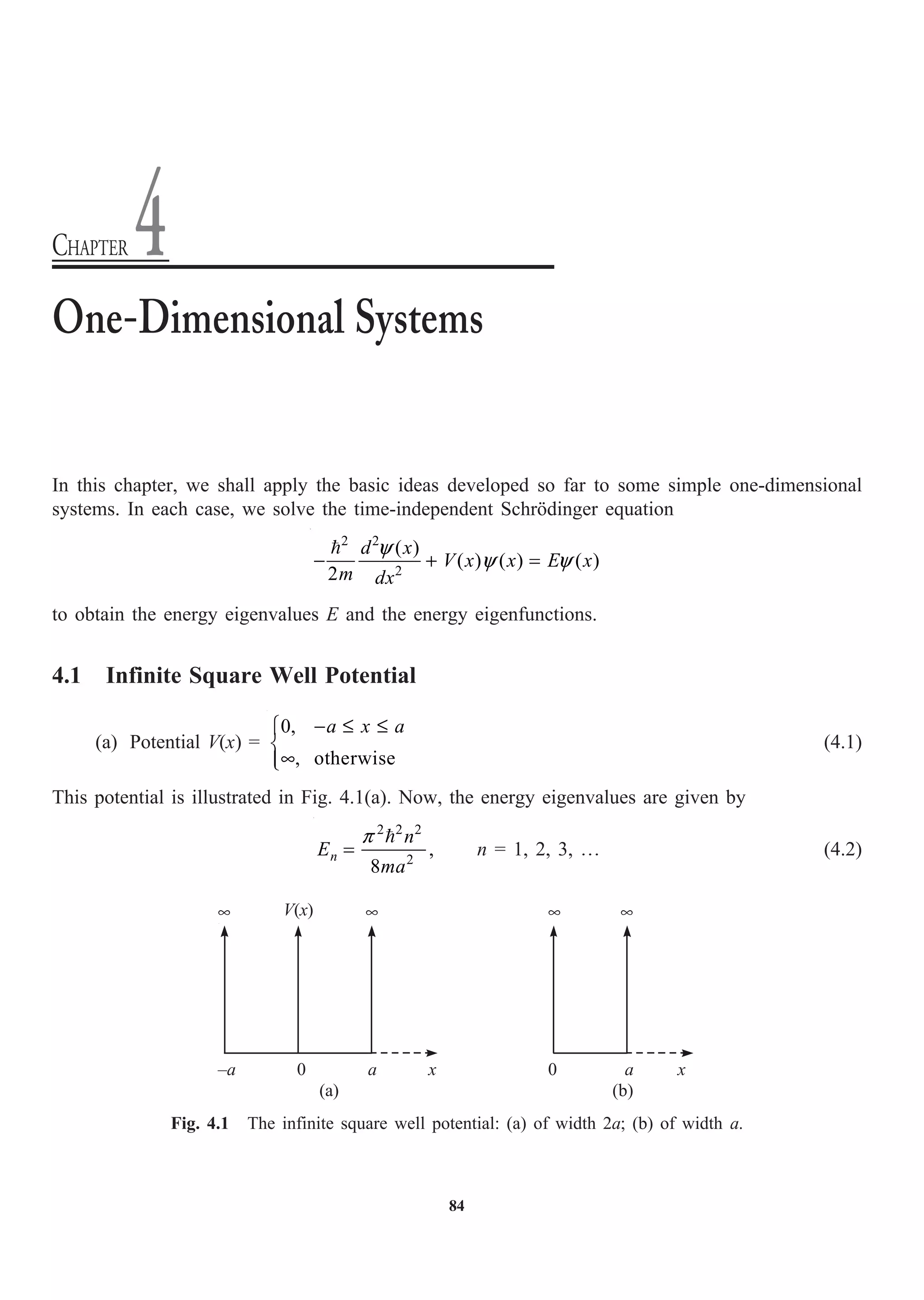
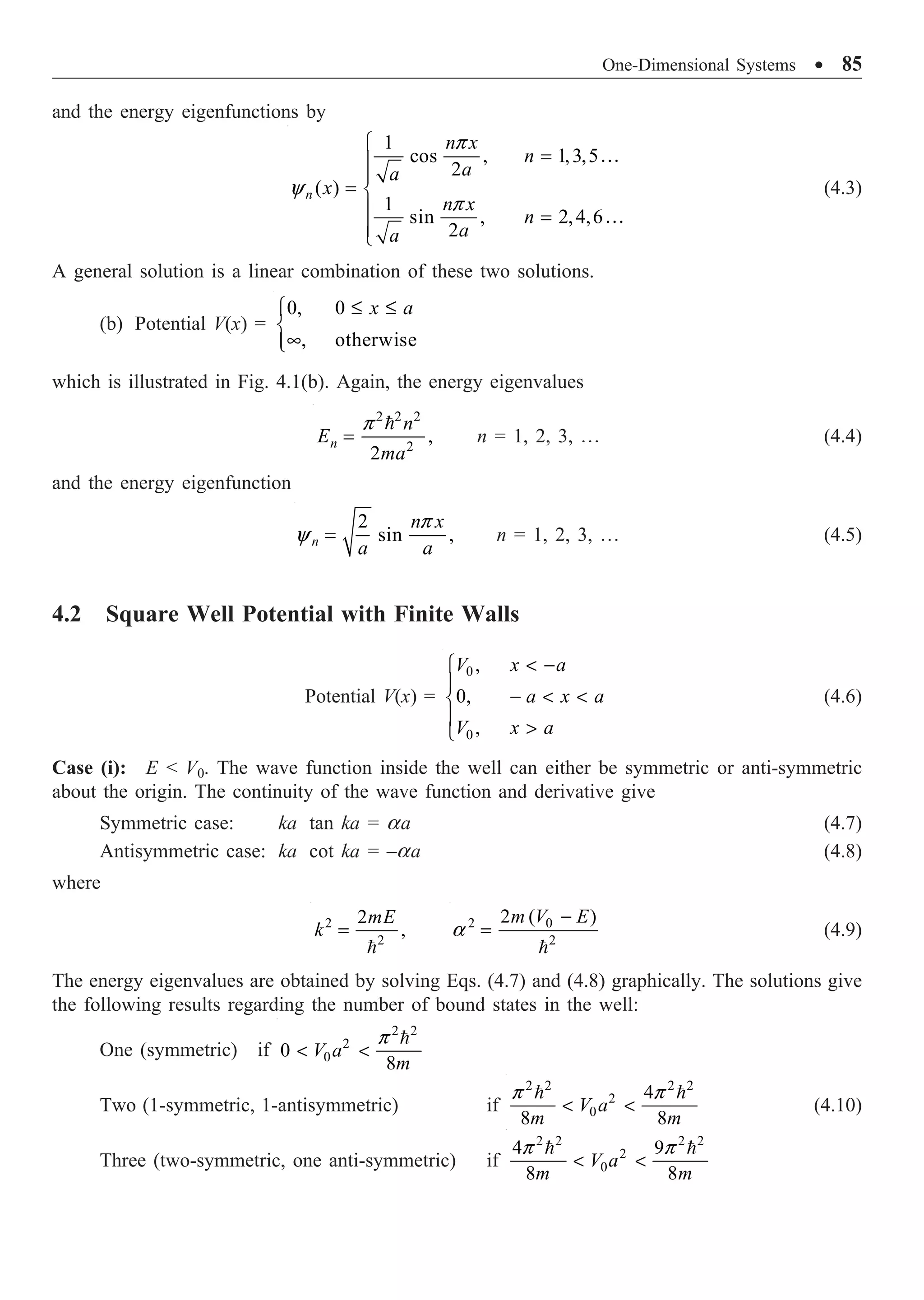
![86 ∑ Quantum Mechanics: 500 Problems with Solutions
Case (ii): E V0. In this case, the particle is not bound and the wave function is sinusoidal in all
the regions.
4.3 Square Potential Barrier
The potential is defined by
V(x) = V0 for 0 x a (4.11)
V(x) = 0, otherwise
Consider a stream of particles of mass m, the energy E V0 approaching the square barrier from the
left. A portion of the particles is reflected back and the rest is transmitted. For a broad high barrier,
the transmission coefficient T is given by
2
2 2 2
0
2 2 2 2
0
16 ( )
16
( )
a
a
a
a
-
-
-
= =
+
a
a
E V E e
k e
T
k V
(4.12)
where k and a have the same definitions as in Eq. (4.9).
4.4 Linear Harmonic Oscillator
4.4.1 The Schrödinger Method
The solution of the Schrödinger equation for the linear harmonic oscillator potential V = (1/2)kx2
,
where k = mw2
, gives the energy eigenvalues
1 1
,
2 2
n w
Ê ˆ Ê ˆ
= + = +
Á ˜ Á ˜
Ë ¯ Ë ¯
n
E n h n n = 0, 1, 2, º (4.13)
The normalized eigenfunctions are
2
1/2
/2
( ) ( )
2 !
y
n n
n
y H y e
n
a
y
p
-
Ê ˆ
= Á ˜
Ë ¯
(4.14)
where
y = ax and a =
1/2
mw
Ê ˆ
Á ˜
Ë ¯
(4.15)
y0(x) =
1/2 2 2
exp
2
x
a a
p
Ê ˆ
Ê ˆ
-
Á ˜
Á ˜
Ë ¯ Ë ¯
(4.16)
y1(x) =
1/2 2 2
(2 ) exp
2
2
x
x
a a
a
p
Ê ˆ
Ê ˆ
-
Á ˜
Á ˜
Ë ¯ Ë ¯
(4.17)
4.4.2 The Operator Method
The operator method is based on the basic commutation relation [x, p] = i, where x and p are the
coordinate and momentum operators. The creation (a†
) and annihilation (a) operators are defined by](https://image.slidesharecdn.com/quantummechanics500problemswithsolutionspdfdrive-220626164912-635041ea/75/Quantum-Mechanics_-500-Problems-with-Solutions-PDFDrive-pdf-96-2048.jpg)
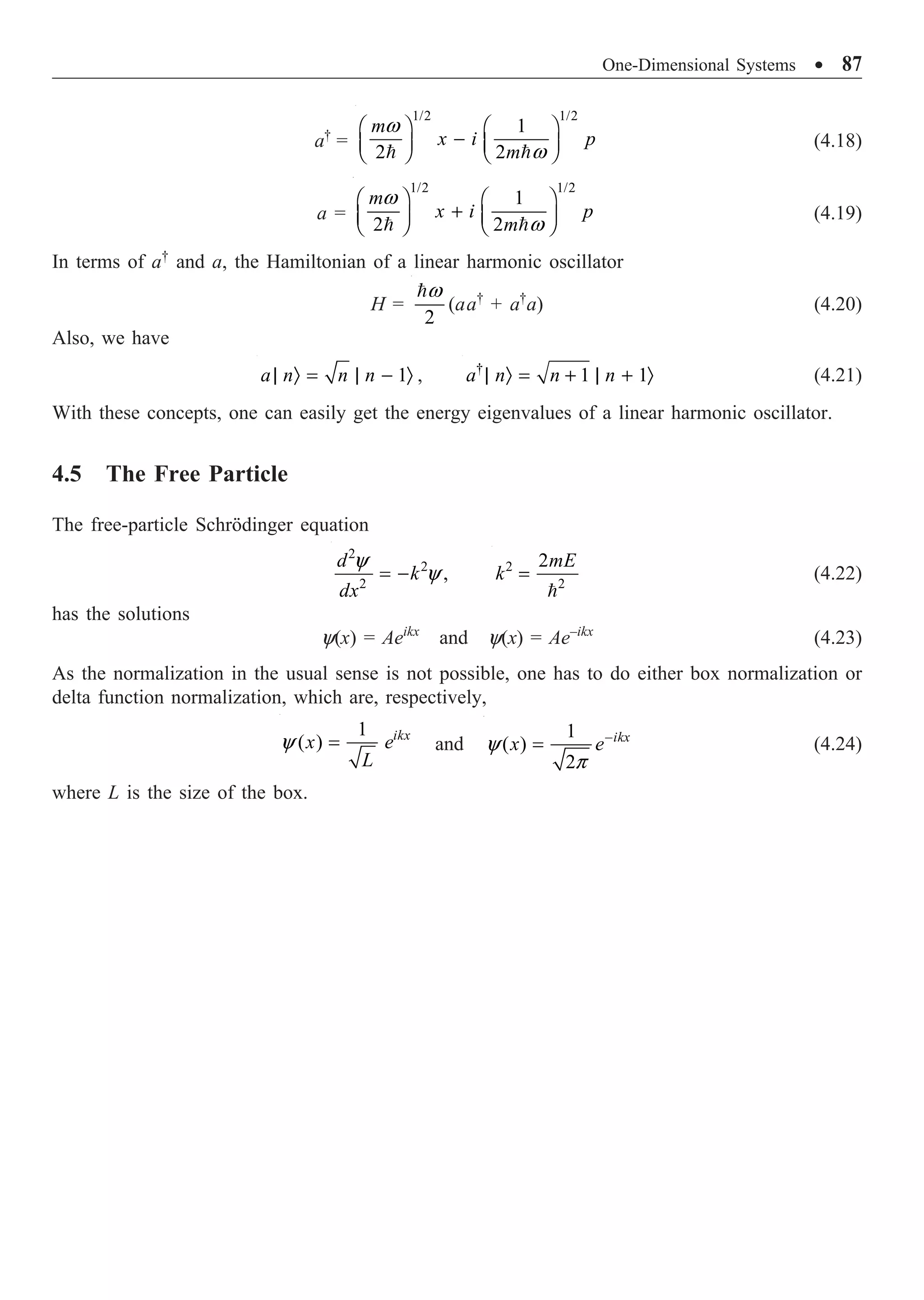
![88 ∑ Quantum Mechanics: 500 Problems with Solutions
PROBLEMS
4.1 Obtain the energy eigenvalues and eigenfunctions of a particle trapped in the potential
V(x) = 0 for 0 £ x £ a and V(x) = • otherwise. Show that the wave functions for the different energy
levels of the particle trapped in the square well are orthogonal.
Solution. The Schrödinger equation is
2 2
2
( )
( ) ( ),
2
d x
V x E x
m dx
y
y y
- + =
0 £ x £ a
2
2
2
( )
( ),
d x
k x
dx
y
y
= - 2
2
2mE
k =
y(x) = A sin kx + B cos kx, 0 £ x £ a
y(0) = 0 gives B = 0 or y (x) = A sin kx
y(a) = 0 gives A sin ka = 0 or sin ka = 0
ka = np or
2 2 2
2
,
2
n
n
E
ma
p
=
n = 1, 2, º
( ) 2/ sin
n x
x a
a
p
y =
0
*
a
i n dx
y y
Ú =
0
2
sin sin
a
m x n x
dx
a a a
p p
Ú
=
0
2
sin sin ,
x
ny my dy y
a
p
p
p
=
Ú
=
0
1
[cos ( ) cos ( ) ] 0
n m y n m y dy
p
p
- - + =
Ú
4.2 Consider a particle of mass m moving in a one dimensional potential specified by
0, 2 2
( )
, otherwise
a x a
V x
-
Ï
= Ì
•
Ô
Ó
Find the energy eigenvalues and eigenfunctions.
Solution. The time-independent Schrödinger equation for the region –2a x 2a (Fig. 4.2) is
2
2
2
0,
d
k
dx
y
y
+ = 2
2
2mE
k =
V(x)
• •
–2a 0 2a
Fig. 4.2 Infinite square well of bottom.](https://image.slidesharecdn.com/quantummechanics500problemswithsolutionspdfdrive-220626164912-635041ea/75/Quantum-Mechanics_-500-Problems-with-Solutions-PDFDrive-pdf-98-2048.jpg)
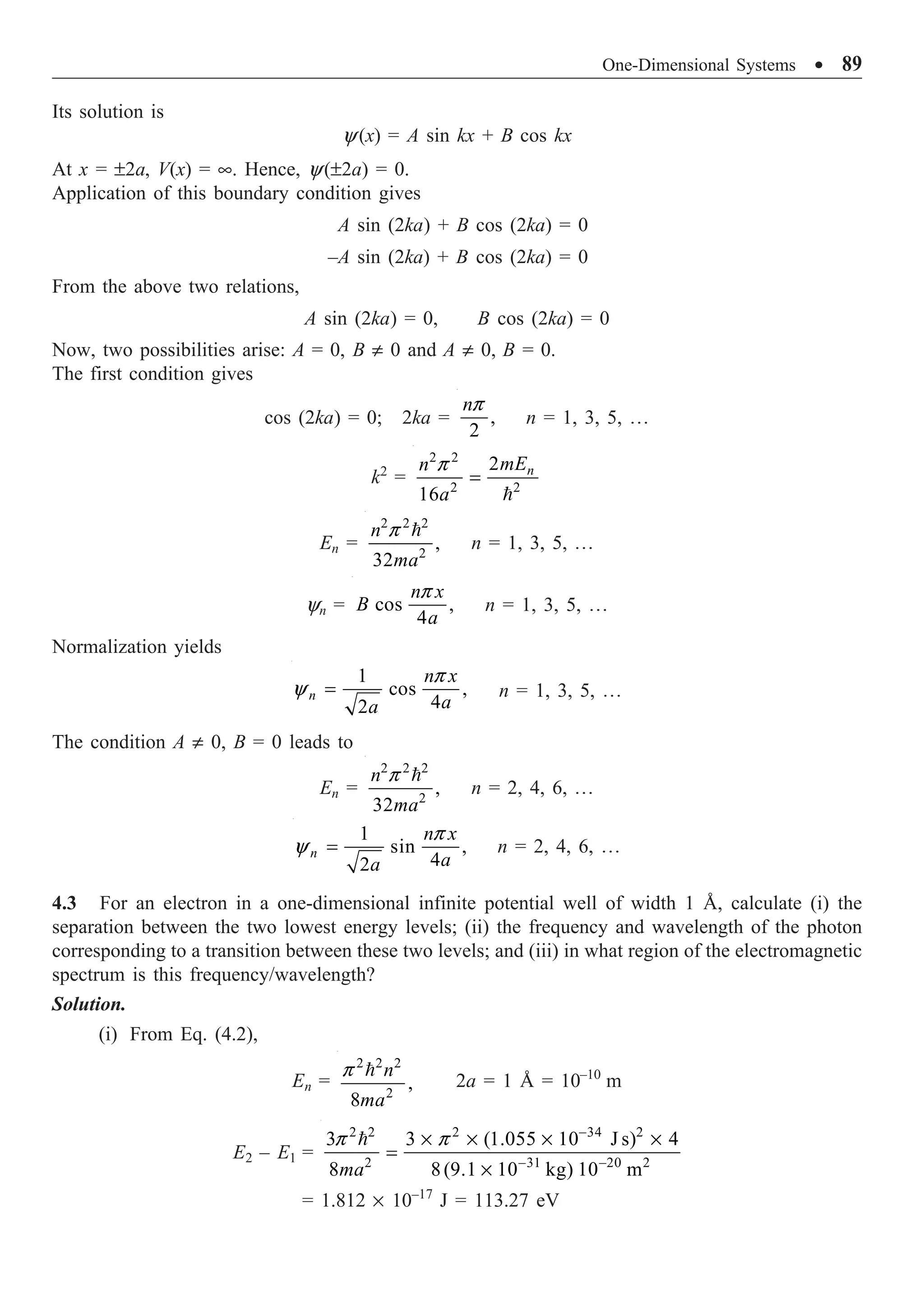
![90 ∑ Quantum Mechanics: 500 Problems with Solutions
(ii) hn = 1.812 ¥ 10–17
J
n = 2.7 ¥ 1016
8 1
8
16 1
3 10 ms
1.1 10 m
2.7 10 s
c
l
n
-
-
-
¥
= = = ¥
¥
(iii) This frequency falls in the vacuum ultraviolet region.
4.4 Show that the energy and the wave function of a particle in a square well of finite depth V0
reduces to the energy and the wave function of a square well with rigid walls in the limit V0 Æ •.
Solution. For a well of finite depth V0, Eq. (4.7) gives
tan ka = ,
k
a 2
2
2
,
mE
k =
2
0
2
2
( )
m
V E
a = -
tan ka = 0
V E
E
-
or
0
Lt tan
V
ka
Æ•
Æ •
ka =
2
np
or k2
a2
=
2 2
4
n p
En =
2 2 2
2
8
n
ma
p
[which is the same as Eq. (4.2).]
The wave functions in the different regions will be
,
( ) sin cos ,
,
x
x
Ae x a
x B kx C kx a x a
De x a
a
a
y
-
Ï -
Ô
= + -
Ì
Ô
Ô
Ó
When V0 Æ •, a Æ •, and the wave function reduces to
0,
( ) sin cos ,
0,
x a
x A kx B kx a x a
x a
y
-
Ï
Ô
= + -
Ì
Ô
Ó
which is the wave function of a particle in a square well with rigid walls.
4.5 Calculate the expectation values of position ·xÒ and of the momentum ·pxÒ of the particle
trapped in the one-dimensional box of Problem 4.1.
Solution.
·xÒ =
0
2
sin sin
a
n x n x
x dx
a a a
p p
Ú
=
2
0 0
2 1 2
sin 1 cos
a a
n x n x
x dx x dx
a a a a
p p
Ê ˆ
= -
Á ˜
Ë ¯
Ú Ú
=
0 0
1 1 2
cos
a a
n x
x dx x dx
a a a
p
-
Ú Ú](https://image.slidesharecdn.com/quantummechanics500problemswithsolutionspdfdrive-220626164912-635041ea/75/Quantum-Mechanics_-500-Problems-with-Solutions-PDFDrive-pdf-100-2048.jpg)

![92 ∑ Quantum Mechanics: 500 Problems with Solutions
4.8 An alpha particle is trapped in a nucleus of radius 1.4 ¥ 10–15
m. What is the probability that
it will escape from the nucleus if its energy is 2 MeV? The potential barrier at the surface of the
nucleus is 4 MeV and the mass of the a-particle = 6.64 ¥ 10–27
kg.
Solution. Transmission coefficient T = 0
0 0
2
16 1 exp 2 ( )
E e a
m V E
V V
Ê ˆ È ˘
- - -
Á ˜ Í ˙
Ë ¯ Î ˚
Mass of alpha particle = 6.64 ¥ 10–27
kg
0
2 ( )
m V E
- = 27 6 19 1/2
[2(6.64 10 kg)(2 10 eV) (1.6 10 J/eV)]
- -
¥ ¥ ¥
= 6.52 ¥ 10–20
kg m s–1
0
2
2 ( )
a
m V E
-
=
15
20 1
34
2(2.8 10 m)
6.52 10 kg ms 3.477
1.05 10 J s
-
- -
-
¥
¥ ¥ =
¥
T =
1 1
16 exp ( 3.477) 0.124
2 2
¥ ¥ ¥ - =
4.9 The wave function of a particle confined in a box of length a is
2
( ) sin ,
x
x
a a
p
y = 0 £ x £ a
Calculate the probability of finding the particle in the region 0 x a/2.
Solution. The required probability P =
/2
2
0
2
sin
a
x
dx
a a
p
Ú
=
/2
0
1 2
1 cos
a
x
dx
a a
p
Ê ˆ
-
Á ˜
Ë ¯
Ú
=
/2 /2
0 0
1 1 2 1
cos
2
a a
x
dx dx
a a a
p
- =
Ú Ú
4.10 Find ·xÒ and ·pÒ for the nth state of the linear harmonic oscillator.
Solution. For the harmonic oscillator, yn(x) = AHn(x) exp (–mwx2
/2)
2
2 2
( ) exp 0
n
m x
x A H x x dx
w
•
-•
Ê ˆ
· Ò = - =
Á ˜
Ë ¯
Ú
since the integrand is an odd function of x.
·pÒ =
2 2
2
( ) exp exp
2 2
n n
m x d m x
i A H x H dx
dx
w w
•
-•
È ˘
Ê ˆ Ê ˆ
- - -
Í ˙
Á ˜ Á ˜
Ë ¯ Ë ¯
Í ˙
Î ˚
Ú
=
2 2
2 2
exp exp
n n n
m x m x m x
i A H H H dx
w w w
•
-•
È ˘
Ê ˆ Ê ˆ
- - - -
Í ˙
Á ˜ Á ˜
Ë ¯ Ë ¯
Í ˙
Î ˚
Ú
= 0
since both the integrand terms are odd functions of x. Here, H¢n = dHn/dx.](https://image.slidesharecdn.com/quantummechanics500problemswithsolutionspdfdrive-220626164912-635041ea/75/Quantum-Mechanics_-500-Problems-with-Solutions-PDFDrive-pdf-102-2048.jpg)
![One-Dimensional Systems ∑ 93
4.11 For the nth state of the linear harmonic oscillator, evaluate the uncertainty product (Dx) (Dp).
Solution. According to the Virial theorem, the average values of the kinetic and potential energies
of a classical harmonic oscillator are equal. Assuming that this holds for the expectation values of
the quantum oscillator, we have
2 2
1 1 1
2 2 2 2
x
p k x n
m
w Ê ˆ
· Ò = · Ò = +
Á ˜
Ë ¯
k = mw2
Hence,
2 1
2
x
p m n
w
Ê ˆ
· Ò = +
Á ˜
Ë ¯
,
2 1
2
x n
mw
Ê ˆ
· Ò = +
Á ˜
Ë ¯
2 2 2 2
( )
x x x x
D = · Ò - · Ò = · Ò [refer Problem 4.10]
(Dpx)2
= 2
x
p
· Ò
2
2 2 2
1
( ) ( ) ,
2
x
x p n
Ê ˆ
D D = +
Á ˜
Ë ¯
1
( )( )
2
x
x p n
Ê ˆ
D D = +
Á ˜
Ë ¯
4.12 A harmonic oscillator is in the ground state. (i) Where is the probability density maximum?
(ii) What is the value of maximum probability density?
Solution.
(i) The ground state wave function
1/4 2
0 ( ) exp
2
m m x
x
w w
y
p
Ê ˆ
-
Ê ˆ
= Á ˜ Á ˜
Ë ¯ Ë ¯
The probability density
P(x) =
1/2 2 2
0 0
* exp
m m x
w w
y y
p
Ê ˆ
Ê ˆ
= -
Á ˜ Á ˜
Ë ¯ Ë ¯
P(x) will be maximum at the point where
1/2 2 2
0 2 exp
dP m m m x
x
dx
w w w
p
Ê ˆ
Ê ˆ Ê ˆ
= = - -
Á ˜ Á ˜ Á ˜
Ë ¯ Ë ¯ Ë ¯
x = 0
Thus, the probability density is maximum at x = 0.
(ii) P(0) =
1/2
mw
p
Ê ˆ
Á ˜
Ë ¯
4.13 A 1 eV electron got trapped inside the surface of a metal. If the potential barrier is 4.0 eV
and the width of the barrier is 2 Å, calculate the probability of its transmission.
Solution. If L is the width of the barrier, the transmission coefficient
T =
2
16 1 exp 2 ( )
E E L
m V E
V V
Ê ˆ È ˘
- - -
Á ˜ Í ˙
Ë ¯ Î ˚
=
10
31 19
34
1 3 2 2 10 m
16 exp 2(9.1 10 kg)(3 1.6 10 J)
4 4 1.05 10 J s
-
- -
-
Ê ˆ
¥ ¥
¥ ¥ ¥ - ¥ ¥ ¥
Á ˜
¥
Ë ¯
= 0.085](https://image.slidesharecdn.com/quantummechanics500problemswithsolutionspdfdrive-220626164912-635041ea/75/Quantum-Mechanics_-500-Problems-with-Solutions-PDFDrive-pdf-103-2048.jpg)
![94 ∑ Quantum Mechanics: 500 Problems with Solutions
4.14 An electron is in the ground state of a one-dimensional infinite square well with a = 10–10
m.
Compute the force that the electron exerts on the wall during an impact on either wall.
Solution. The force on the wall
F = n
dE
da
-
The energy of the ground state
2 2
1 2
2
E
ma
p
=
and hence the force on the wall
F =
10 10
2 2
1
3
10 10
a a
dE
da ma
p
- -
= =
- =
=
2 34 2
31 10 3
(1.054 10 J s)
(9.1 10 kg)(10 m)
p -
- -
¥
¥
= 1.21 ¥ 10–7
N
4.15 Show that the probability density of the linear harmonic oscillator in an arbitrary superposition
state is periodic with the period equal to the period of the oscillator.
Solution. The time-dependent wave function of the linear harmonic oscillator in a superposition
state is
( , ) ( ) exp( / )
n n n
n
x t C x iE t
y
Y = -
Â
where yn(x) is the time-independent wave function of the harmonic oscillator in the nth state. The
probability density
2
* *
( , ) ( , ) exp[ ( ) / )]
m n m n m n
m n
P x t x t C C i E E t
y y
= |Y | = -
ÂÂ
It is obvious that P(x, t) is dependent on time. Let us investigate what happens to P(x, t) if t is
replaced by t + 2p/w. It follows that
( ) 2
exp m n
i E E
t
p
w
È ˘
- Ê ˆ
+
Í ˙
Á ˜
Ë ¯
Î ˚
=
( ) ( ) 2
exp exp
m n m n
i E E t i E E p
w
- -
È ˘ È ˘
Í ˙ Í ˙
Î ˚ Î ˚
=
( )
exp m n
i E E t
-
È ˘
Í ˙
Î ˚
since (Em – En) is an integral multiple of w, i.e., P(x, t) is periodic with period 2p/w, the period of
the linear harmonic oscillator.
4.16 For harmonic oscillator wave functions, find the value of (yk, xyn).
Solution. For Hermite polynomials,
Hn+1(y) – 2yHn(y) + 2nHn–1(y) = 0](https://image.slidesharecdn.com/quantummechanics500problemswithsolutionspdfdrive-220626164912-635041ea/75/Quantum-Mechanics_-500-Problems-with-Solutions-PDFDrive-pdf-104-2048.jpg)
![One-Dimensional Systems ∑ 95
Substituting the values of Hn+1, Hn and Hn-1 in terms of the oscillator wave functions, [(Eq. 4.14)],
and dropping
2
/2 1/4
( / )
y
e m
p w
from all terms, we get
1 1/2 1/2 1 1/2
1 1
[2 ( 1)!] 2 (2 !) 2 [2 ( 1)!] 0
n n n
n n n
n y n n n
y y y
+ -
+ -
+ - + - =
1/2 1/2
1 1
( 1)] 2 0
n n n
n y n
y y y
+ -
+ - + =
Since y = (mw/)1/2
x, the inner product of this equation with yk gives
1/2 1/2 1/2
1 1
( 1) ( , ) (2 / ) ( , ) ( , ) 0
k n k n k n
n m x n
y y w y y y y
+ -
+ - + =
1/2 1/2
1 1
( 1)
( , ) ( , ) ( , )
2 2
k n k n k n
n n
m m
y y y y y y
w w
+ -
+
È ˘ Ê ˆ
= + Á ˜
Í ˙ Ë ¯
Î ˚
(yk, xyn) =
( 1)/2 if = + 1
/2 if = – 1
0 if 1
n m k n
n m k n
k n
w
w
Ï +
Ô
Ô
Ì
Ô π ±
Ô
Ó
4.17 Evaluate ·x2
Ò, ·p2
Ò, ·VÒ and ·TÒ for the states of a harmonic oscillator.
Solution. From Problem 4.16,
1/2
1/2 1/2
1 1
2
( 1) 0
n n n
m
n x n
w
y y y
+ -
Ê ˆ
+ - + =
Á ˜
Ë ¯
Multiplying from left by x and then taking the inner product of the resulting equation with yn, we
get
1/2
1/2 2 1/ 2
1 1
2
( 1) ( , ) ( , ) ( , ) 0
n n n n n n
m
n x x n x
w
y y y y y y
+ -
Ê ˆ
+ - + =
Á ˜
Ë ¯
Using the results of Problem 4.16, we obtain
2
( 1) 2
1 ( , ) 0
2 2
n n
n m n
n x n
m m
w
y y
w w
+
+ - + =
2
2
(2 1) ( , )
2 n n
n m
n x
m
w
y y
w
+ =
·x2
Ò = 2
( , ) (2 1)
2
n n
x n
m
y y
w
= +
·p2
Ò =
2
2
2
, n
n
d
dx
y
y
Ê ˆ
- Á ˜
Ë ¯
The Schrödinger equation for harmonic oscillator is
2 2 2 2
2 2 2
2
n n
n n
d mE m x
dx
y w
y y
= - +](https://image.slidesharecdn.com/quantummechanics500problemswithsolutionspdfdrive-220626164912-635041ea/75/Quantum-Mechanics_-500-Problems-with-Solutions-PDFDrive-pdf-105-2048.jpg)
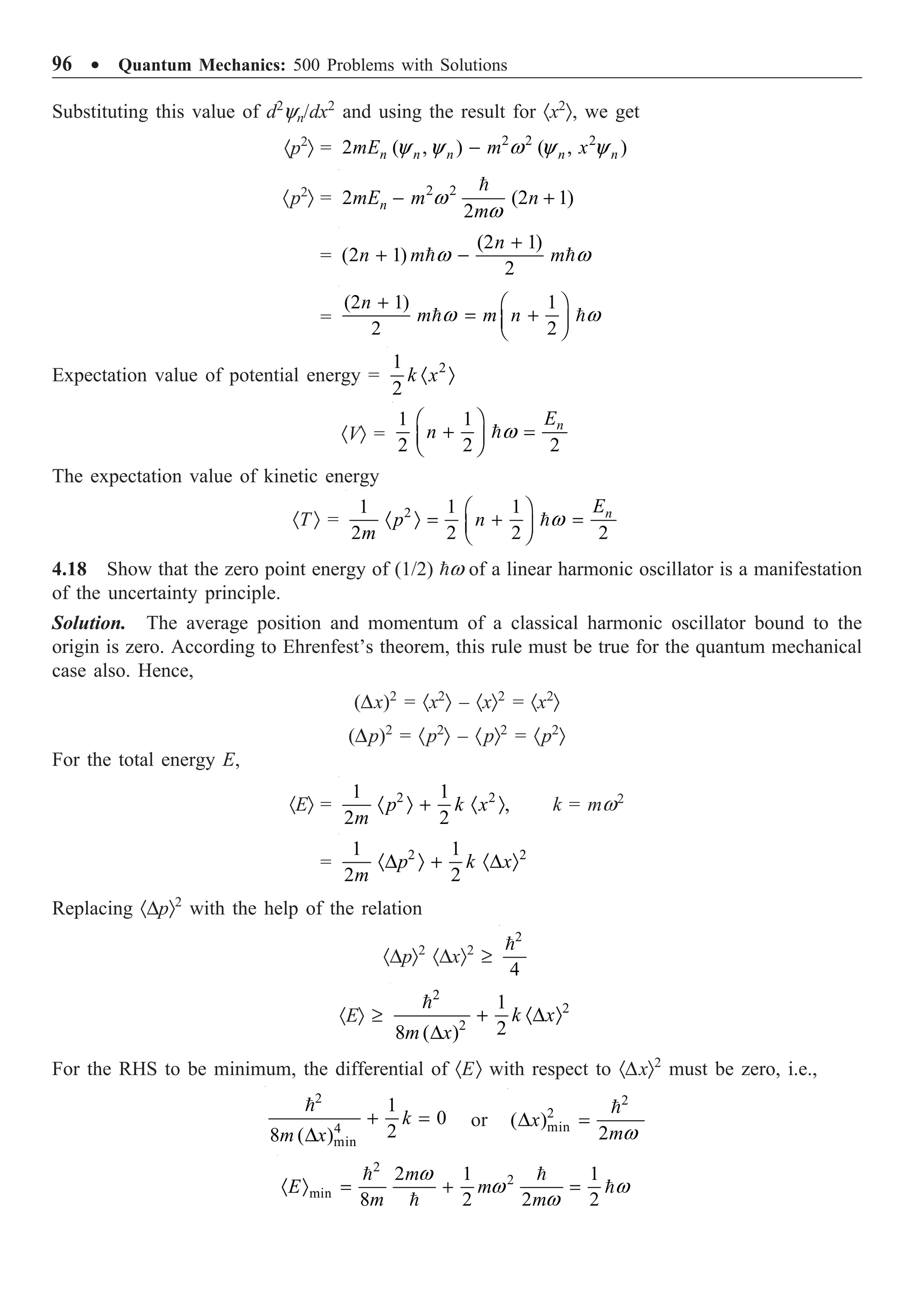
![One-Dimensional Systems ∑ 97
4.19 A stream of particles of mass m and energy E move towards the potential step V(x) = 0 for
x 0 and V(x) = V0 for x 0. If the energy of the particles E V0, show that the sum of fluxes
of the transmitted and reflected particles is equal to the flux of incident paricles.
Solution. The Schrödinger equation for regions 1 and 2 (see Fig. 4.3) are
2
2
1
0
2
0,
d
k
dx
y
y
+ = 2
0 2
2
,
mE
k =
x 0
2
2
2
2
0,
d
k
dx
y
y
+ = 2 0
2
2 ( )
,
m E V
k
-
=
x 0
The solutions of the two equations are
0 0
1 ,
ik x ik x
e Ae
y -
= + x 0
2 ,
ikx
Be
y = x 0
For convenience, the amplitude of the incident wave is taken as 1. The second term in y1, a wave
travelling from right to left, is the reflected wave whereas y2 is the transmitted wave. It may be noted
that in region 2 we will not have a wave travelling from right to left. The continuity conditions on
y and its derivative at x = 0 give
1 + A = B, k0 (1 – A) = kB
Simplifying, we get
A = 0
0
,
k k
k k
-
+
B = 0
0
2k
k k
+
Flux of particles for the incident wave (see Problem 2.22) = 0
k
m
Magnitude of flux of particles for the reflected wave = 0
k
m
|A|2
Flux of particles for the transmitted wave =
k
m
|B|2
The sum of reflected and transmitted flux is given by
2
2 2 0 0 0 0
0 2 2
0 0
( ) 4
[ ]
( ) ( )
k k k kk k
k A k B
m m m
k k k k
È ˘
-
| | + | | = + =
Í ˙
+ +
Í ˙
Î ˚
which is the incident flux.
Fig. 4.3 Potential step.
E
V = V0
V = 0
Region 1 Region 2
0 x](https://image.slidesharecdn.com/quantummechanics500problemswithsolutionspdfdrive-220626164912-635041ea/75/Quantum-Mechanics_-500-Problems-with-Solutions-PDFDrive-pdf-107-2048.jpg)
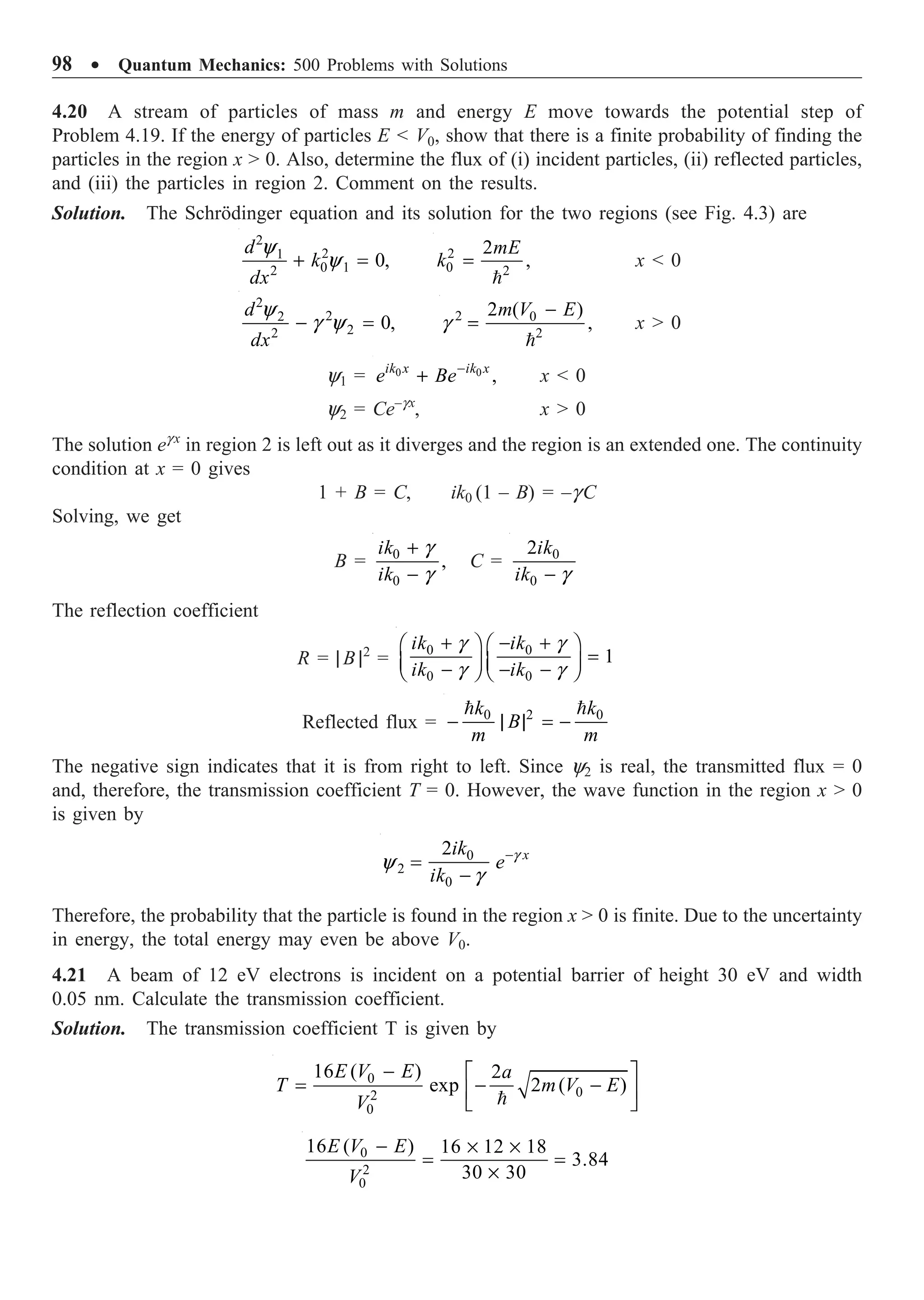
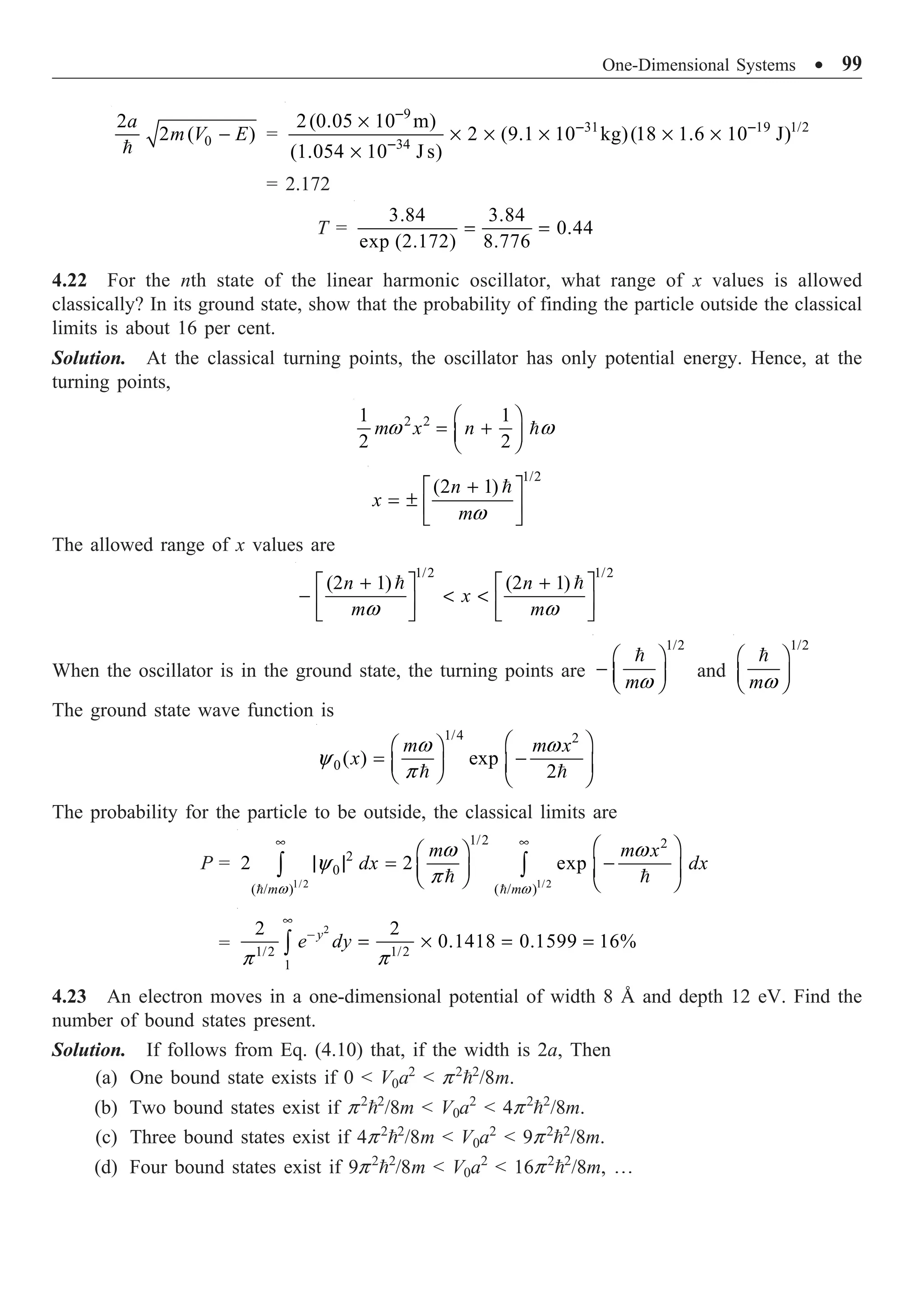
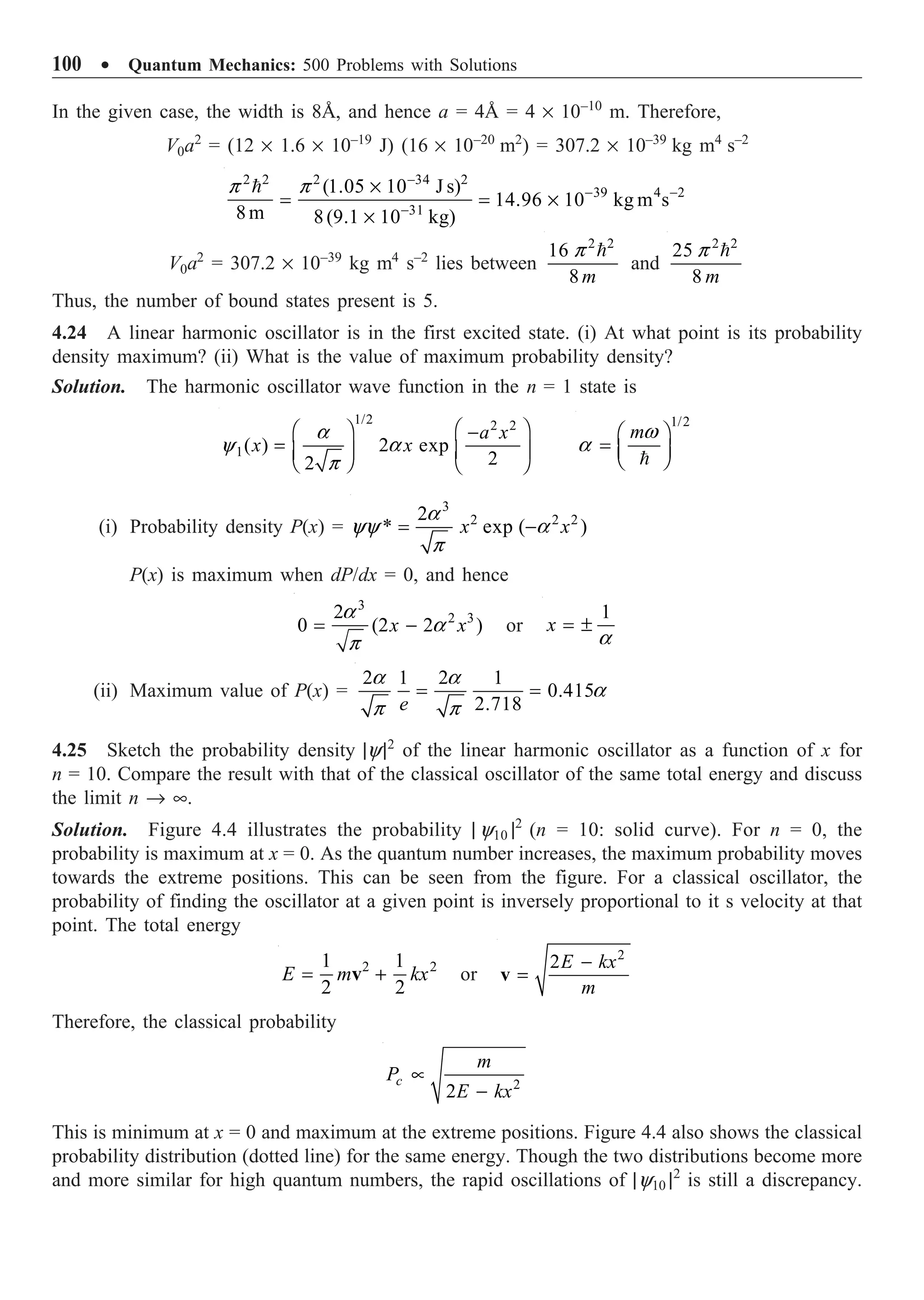
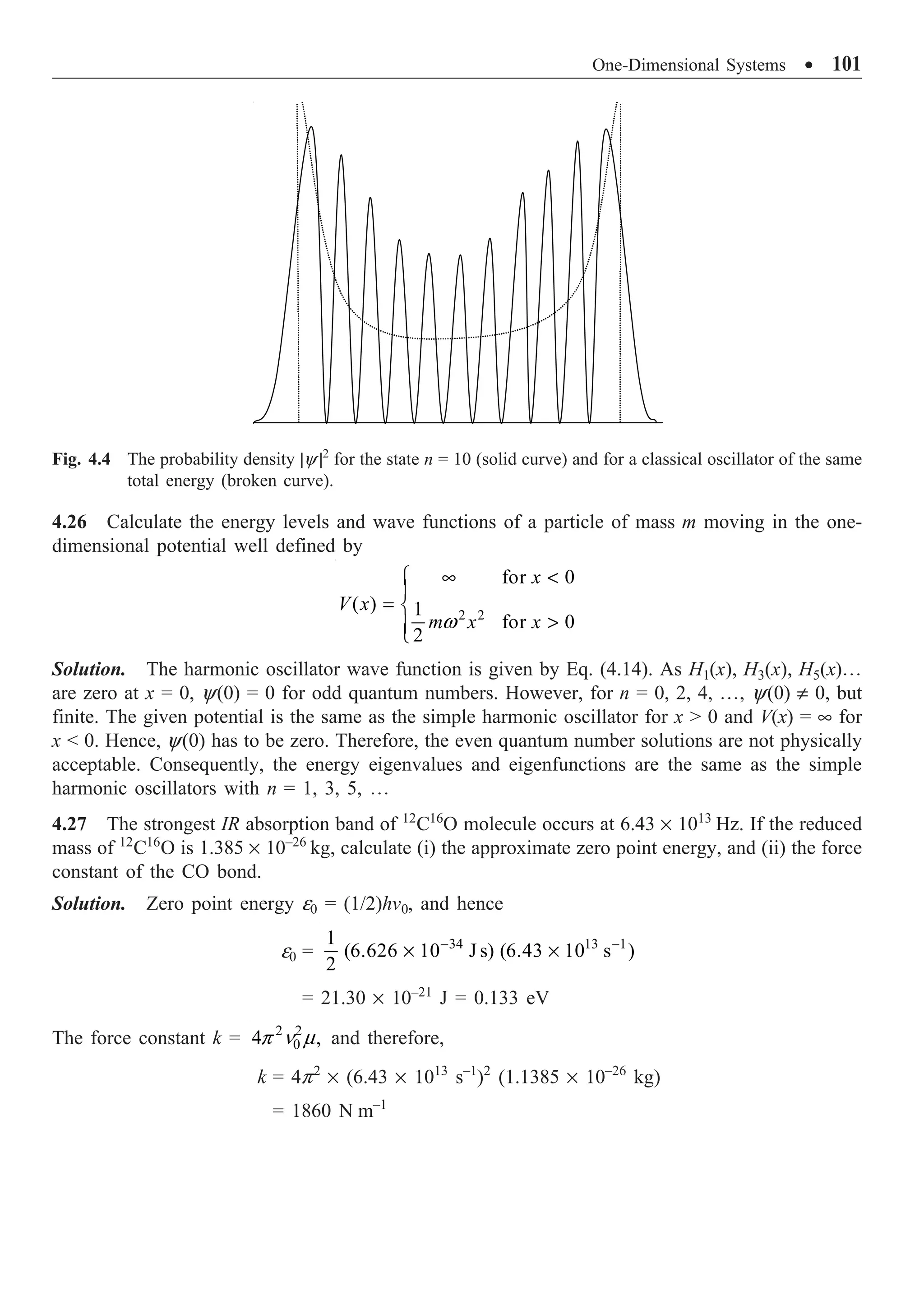
![102 ∑ Quantum Mechanics: 500 Problems with Solutions
4.28 A particle of mass m confined to move in a potential V(x) = 0 for 0 £ x £ a and V(x) = •
otherwise. The wave function of the particle at time t = 0 is given by
5 2
( ,0) sin cos
x x
x A
a a
p p
y =
(i) Normalize y(x, 0), (ii) Find y(x, t), (iii) Is y(x, t) a stationary state?
Solution. Given
5 2 7 3
( ,0) sin cos sin sin
2
x x A x x
x A
a a a a
p p p p
y
Ê ˆ
= = +
Á ˜
Ë ¯
(i) The normalization condition gives
2
2
0
7 3
sin sin
4
a
A x x
dx
a a
p p
Ê ˆ
+
Á ˜
Ë ¯
Ú = 1
2
2 2
0
7 3 7 3
sin sin 2 sin sin
4
a
A x x x x
dx
a a a a
p p p p
Ê ˆ
+ +
Á ˜
Ë ¯
Ú = 1
2
1
4 2 2
A a a
Ê ˆ
+ =
Á ˜
Ë ¯
or
2
A
a
=
Normalized y(x, 0) is
1 7 3
( , 0) sin sin
x x
x
a a
a
p p
y
Ê ˆ
= +
Á ˜
Ë ¯
For a particle in an infinite square well, the eigenvalues and eigenfunctions are
2 2 2
2
,
2
n
n
E
ma
p
=
1/2
2
( ) sin ,
n
n x
x
a a
p
f
Ê ˆ
= Á ˜
Ë ¯
n = 1, 2, 3, º
Hence,
7 3
1 1 7 3
( , 0) ( ) sin sin
2
x x
x
a a
a
p p
y f f
Ê ˆ
= + = +
Á ˜
Ë ¯
(ii) The time dependence of a state is given by
y(x, t) = y(x, 0) e (–iEt/)
Hence, y(x, t) in this case is
7 7 3 3
1
( , ) [ exp ( / ) exp ( / )]
2
x t iE t iE t
y f f
= - + -
(iii) It is not a stationary state since y(x, t) is a superposition state.
4.29 Consider a particle of mass m in the one-dimensional short range potential
V(x) = –V0d(x), V0 0
where d (x) is the Dirac delta function. Find the energy of the system.](https://image.slidesharecdn.com/quantummechanics500problemswithsolutionspdfdrive-220626164912-635041ea/75/Quantum-Mechanics_-500-Problems-with-Solutions-PDFDrive-pdf-112-2048.jpg)
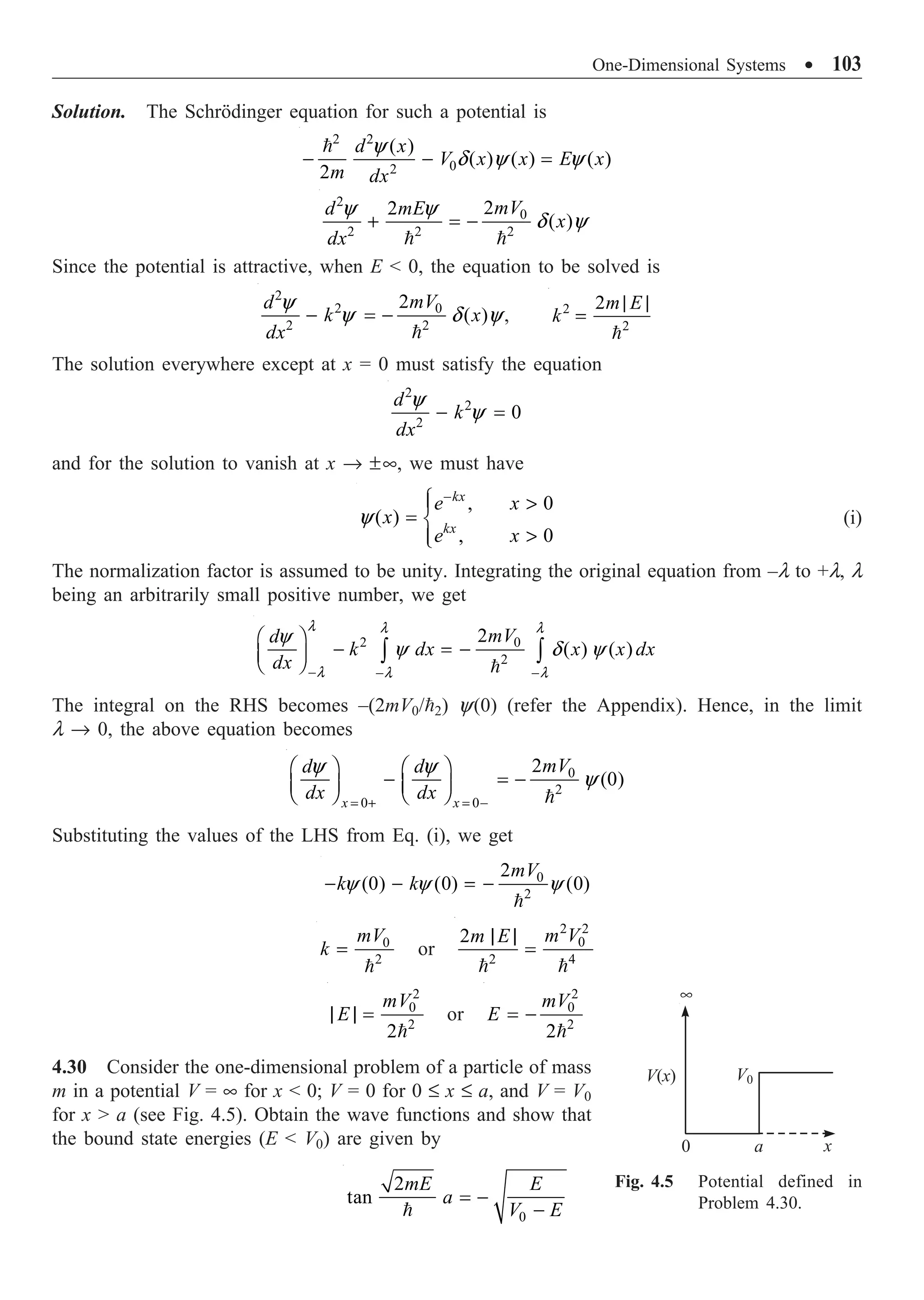
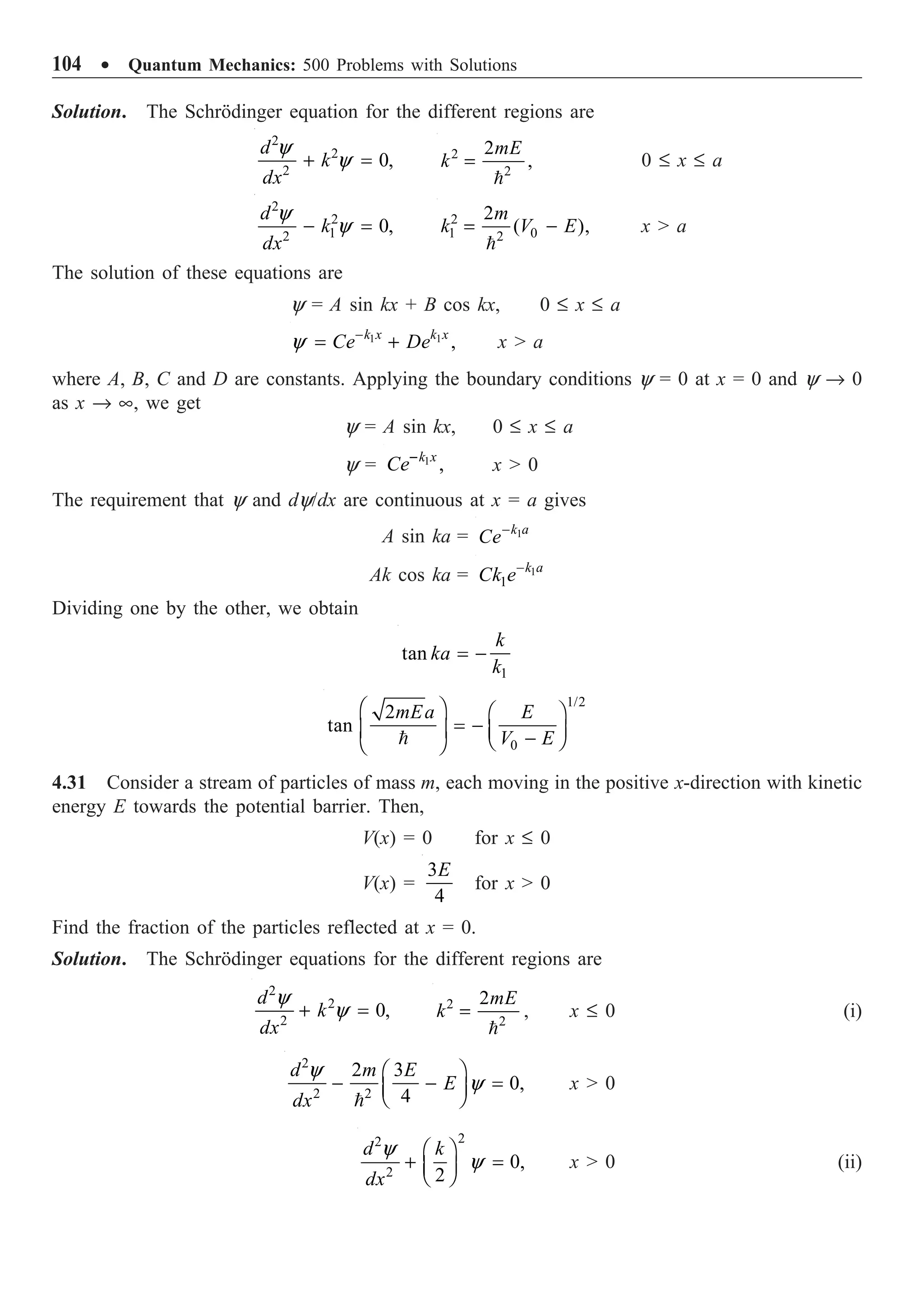
![One-Dimensional Systems ∑ 105
The solution of equation (i) is
y = eikx
+ re–ikx
, x £ 0
where r is the amplitude of the reflected wave since e–ikx
represents a wave travelling in the negative
x-direction. The solution of equation (ii) is
/2
,
ikx
te
y = x 0
where t is the amplitude of the transmitted wave. It is also oscillatory since the height of the barrier
is less than the kinetic energy of the particle. As the wave function is continuous at x = 0,
1 + r = t
Since the derivative dy/dx is continuous at x = 0,
(1 )
2
t
r
- =
Solving the two equations, r = 1/3 and hence one-ninth of the particle is reflected at x = 0.
4.32 An electron of mass m is contained in a cube of side a, which is fairly large. If it is in an
electromagnetic field characterized by the vector potential 0 ˆ ˆ
,
B xy y
=
A being the unit vector along
the y-axis, determine the energy levels and eigenfunctions.
Solution. The Hamiltonian operator of the electron having charge –e is
2
2 2
0
1
2 x y z
B ex
H p p p
m c
È ˘
Ê ˆ
Í ˙
= + + +
Á ˜
Ë ¯
Í ˙
Î ˚
where px, py, pz are operators. We can easily prove the following commutation relations:
[H, py] = [H, pz] = 0, [H, px] π 0
Hence, py and pz are constants. The Schrödinger equation is
2 2 2
2
0
2 2 2
0
2 2
2
1
2
y
y z
B ep x
B e x
d
p p E
m c
dx c
y y
Ê ˆ
- + + + + =
Á ˜
Ë ¯
2
2 2 2
2 2
0 2
0
2 2
1
2 2 2
2
y y
z
B ep x p
B e x
d
E p
m mc m m
dx mc
y
y y
Ê ˆ
- Ê ˆ
+ + + = -
Á ˜ Á ˜
Ë ¯
Ë ¯
we now introduce a new variable x1 defined by
1
0
y
cp
x x
B e
= +
2 2
2 2
1 2 2
0 0
2 y y
cp x c p
x x
B e B e
= + +
Multiplying by 2 2 2
0 /(2 )
B e mc , we get
2
2 2 2 2 2 2
0
0 1 0
2 2 2
2 2
y y
B ep x p
B e x B e x
mc m
mc mc
= + +](https://image.slidesharecdn.com/quantummechanics500problemswithsolutionspdfdrive-220626164912-635041ea/75/Quantum-Mechanics_-500-Problems-with-Solutions-PDFDrive-pdf-115-2048.jpg)
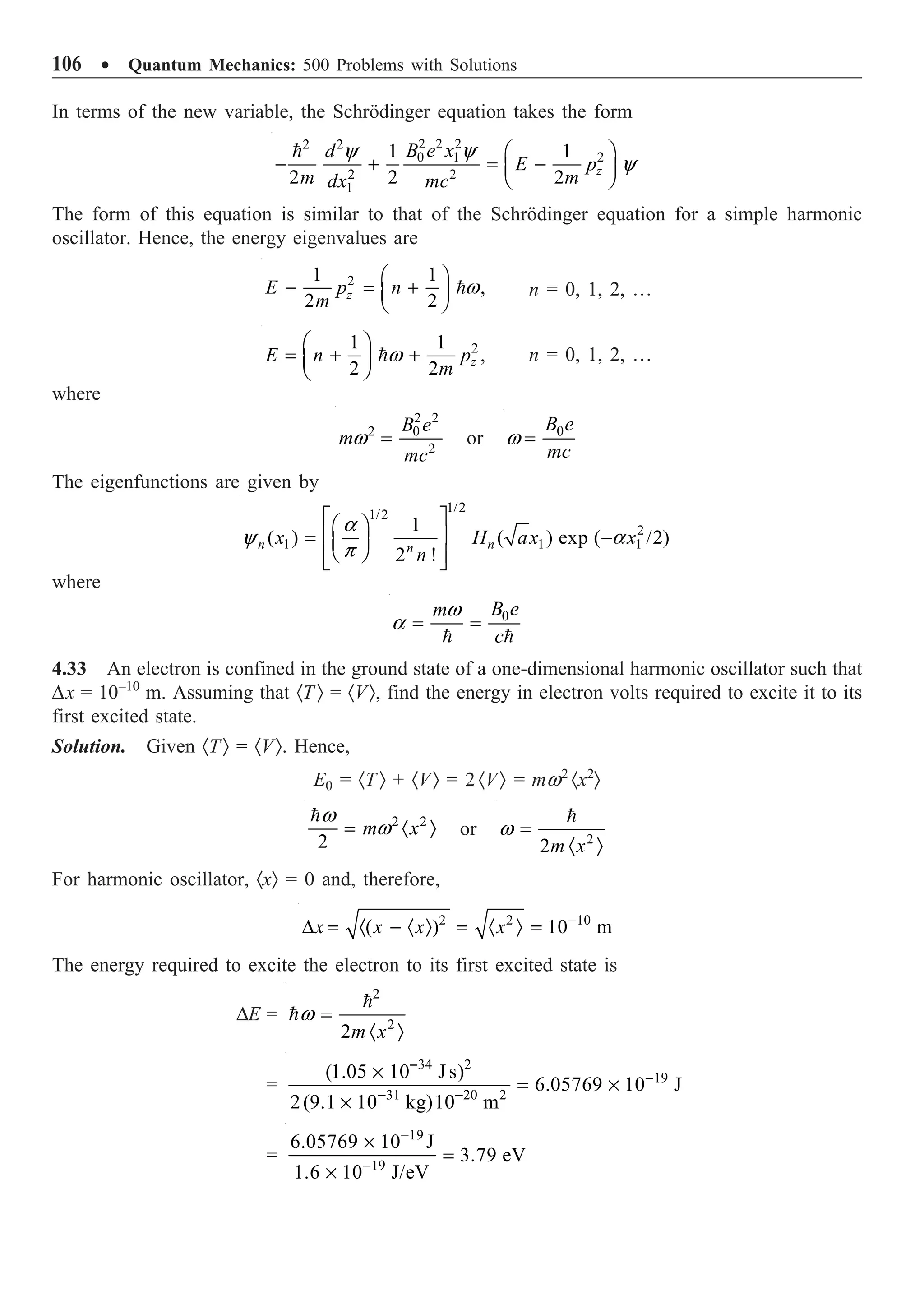
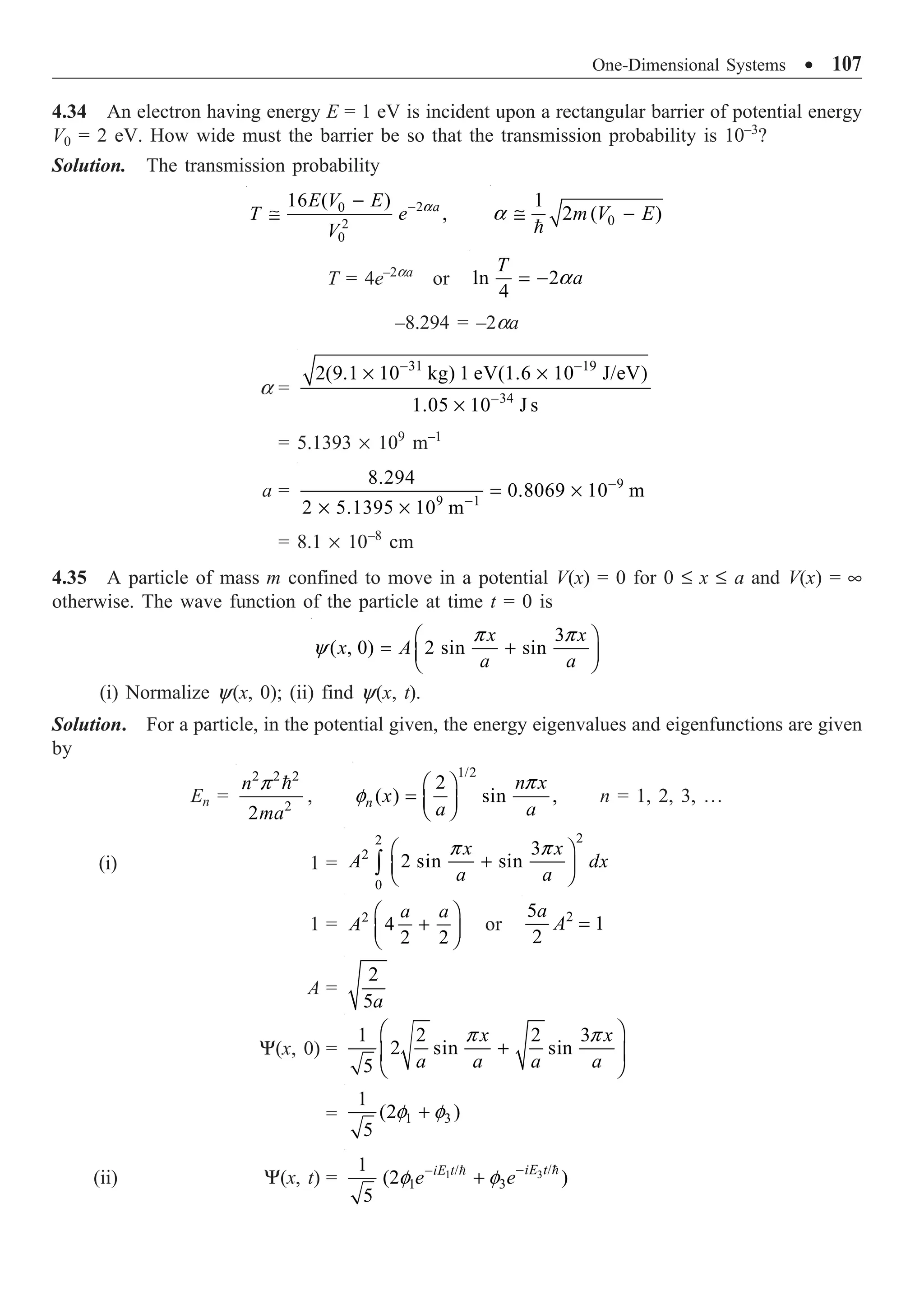
![108 ∑ Quantum Mechanics: 500 Problems with Solutions
4.36 The force constant of HCl molecule is 480 Nm–1
and its reduced mass is 1.63 ¥ 10–27
kg. At
300 K, what is the probability that the molecule is in its first excited vibrational state?
Solution. The vibrational energy of the molecule is given by
Ev =
1
v ,
2
w
Ê ˆ
+
Á ˜
Ë ¯
v = 0, 1, 2, º
w =
1
27
480 Nm
1.63 10 kg
k
m
-
-
=
¥
= 5.427 ¥ 1014
s–1
The number of molecules in a state is proportional to
v
exp exp ( v )
x
kT
w
Ê ˆ
- = -
Á ˜
Ë ¯
where x = w/kT, where k is the Boltzmann constant. Now,
34 14 1
23
(1.054 10 J s)(5.427 10 )
13.8
(1.38 10 J/k) 300 K
s
x
kT
w - -
-
¥ ¥
= = =
¥
The probability that the molecule is in the first excited state is
P1 = v 2
v
1
x x
x x x
e e
e e e
- -
- - -
=
+ + +
Â
= 1
(1 )
(1 )
x
x x
x
e
e e
e
-
- -
- -
= -
-
@ e–x
= e–13.8
= 1.02 ¥ 10–6
4.37 For a one-dimensional harmonic oscillator, using creation and annihilation operators, show
that
1
( )( )
2
x p n
Ê ˆ
D D = +
Á ˜
Ë ¯
Solution. From Eqs. (4.18) and (4.19),
†
( ),
2
x a a
mw
= +
†
( )
2
m
p i a a
m
w
w
= -
where a and a†
are annihilation and creation operators satisfying the conditions
1
a n n n
| Ò = | - Ò and †
1 1
a n n n
| Ò = + | + Ò
We have the relations
(Dx)2
= ·x2
Ò – ·xÒ2
·xÒ = ·n | x | nÒ =
2mw
[·n | a | nÒ + ·n | a†
| nÒ]
=
[ 1 1 1 ] 0
2
n n n n n n
mw
· | - Ò + + · | + Ò =](https://image.slidesharecdn.com/quantummechanics500problemswithsolutionspdfdrive-220626164912-635041ea/75/Quantum-Mechanics_-500-Problems-with-Solutions-PDFDrive-pdf-118-2048.jpg)
![One-Dimensional Systems ∑ 109
·x2
Ò = ·n | x2
| nÒ =
2mw
·n |(a + a†
) (a + a†
) | nÒ
=
2mw
[·n | a a | nÒ + ·n | a a†
| nÒ + ·n | a†
a | nÒ + ·n | a†
a†
| nÒ]
=
2mw
[0 1 1 0]
n n n n
+ + + + +
= (2 1)
2
n
mw
+
Similarly,
·n | p | nÒ = 0, ·n | p2
| nÒ = (2 1)
2
m
n
w
+
(Dp)2
= ·p2
Ò = (2 1)
2
n
n
w
+
(Dx)2
(Dp)2
=
2
2
(2 1) (2 1) 1
2 2 2
n m n
n
m
w
w
+ + Ê ˆ
◊ = +
Á ˜
Ë ¯
(Dx) (Dp) =
1
2
n
Ê ˆ
+
Á ˜
Ë ¯
4.38 A harmonic oscillator moves in a potential V(x) = (1/2)kx2
+ cx, where c is a constant. Find
the energy eigenvalues.
Solution. The Hamiltonian of the system is given by
H =
2 2
2
2
1
2 2
d
kx cx
m dx
- + +
=
2
2 2 2
2
1
2 2 2
d c c
k x
m k k
dx
Ê ˆ
- + + -
Á ˜
Ë ¯
Defining a new variable x1 by
x1 =
c
x
k
+
we get
2 2 2
2
1
2
1
1
2 2 2
d c
H kx
m k
dx
= - + -
The Schrödinger equation is
2 2 2
2
1
2
1
1
2 2 2
d c
kx E
m k
dx
y
y y y
- + - =
which can be modified as
2 2 2
2
1
2
1
1
2 2 2
d c
k E
m k
dx
y
y y
Ê ˆ
- + = +
Á ˜
Ë ¯](https://image.slidesharecdn.com/quantummechanics500problemswithsolutionspdfdrive-220626164912-635041ea/75/Quantum-Mechanics_-500-Problems-with-Solutions-PDFDrive-pdf-119-2048.jpg)

![One-Dimensional Systems ∑ 111
(ii) The average energy of the system at t is
( , ) ( , )
E x t i x t i
t t
∂ ∂
· Ò = Y Y = Y Y
∂ ∂
2 2 2 2
1 2
2 2 2 2
2 2
sin exp sin exp
2 2
i x i t i x i t
i i c i c
t a a
ma ma ma ma
p p p p p p
Ê ˆ Ê ˆ Ê ˆ Ê ˆ
∂ - -
Y = - + -
Á ˜ Á ˜ Á ˜ Á ˜
∂ Ë ¯ Ë ¯ Ë ¯ Ë ¯
Writing Y = c1f1 + c2f2, we get
·EÒ = ·(c1f1 + c2f2) | (E1c1f1 + E2c2f2)Ò
= E1 ·c1f1 | c1f1Ò + E2 ·c2f2 | c2f2Ò
= E1 + E2
4.41 A particle in a box is in a superposition state and is described by the wave function
1 2
1 2
( , ) exp cos exp sin ,
2 2
iE t iE t
x x
x t
a a
a
p p
È ˘
- -
Ê ˆ Ê ˆ
Y = +
Í ˙
Á ˜ Á ˜
Ë ¯ Ë ¯
Î ˚
–a x a
where E1 and E2 are the energy eigenvalues of the first two states. Evaluate the expectation value
of x.
Solution.
*( , ) ( , )
x x t x x t dx
•
-•
· Ò = Y Y
Ú
Substituting the values of Y and Y*, we get
·xÒ =
2 2
1 1 2
cos sin
2 2
a a
a a
x x
x dx x dx
a a a a
p p
- -
+
Ú Ú
1 2 2 1
1 2
{exp [ ( ) / )] exp [ ( ) / )]} cos sin
2 2
a
a
x x
i E E t i E E t x dx
a a a
p p
-
+ - + - Ú
The integrands in the first two terms are odd and hence will not contribute.
2 3
cos sin sin sin
2 2 2 2 2
a a
a a
x x x x x
x dx dx
a a a a
p p p p
- -
Ê ˆ
= +
Á ˜
Ë ¯
Ú Ú
Integrating each term by parts, we get
3
sin
2
a
a
x
x dx
a
p
-
Ú =
2 3 2 2 3
cos sin
3 2 3 3 2
a a
a a
a x a a x
x
a a
p p
p p p
- -
Ê ˆ Ê ˆ
- +
Á ˜ Á ˜
Ë ¯ Ë ¯
=
2 2
2 2
4 8
0 ( 1 1)
9 9
a a
p p
+ - - = -
Similarly,
2
2
8
sin
2
a
a
x a
x dx
a
p
p
-
=
Ú](https://image.slidesharecdn.com/quantummechanics500problemswithsolutionspdfdrive-220626164912-635041ea/75/Quantum-Mechanics_-500-Problems-with-Solutions-PDFDrive-pdf-121-2048.jpg)
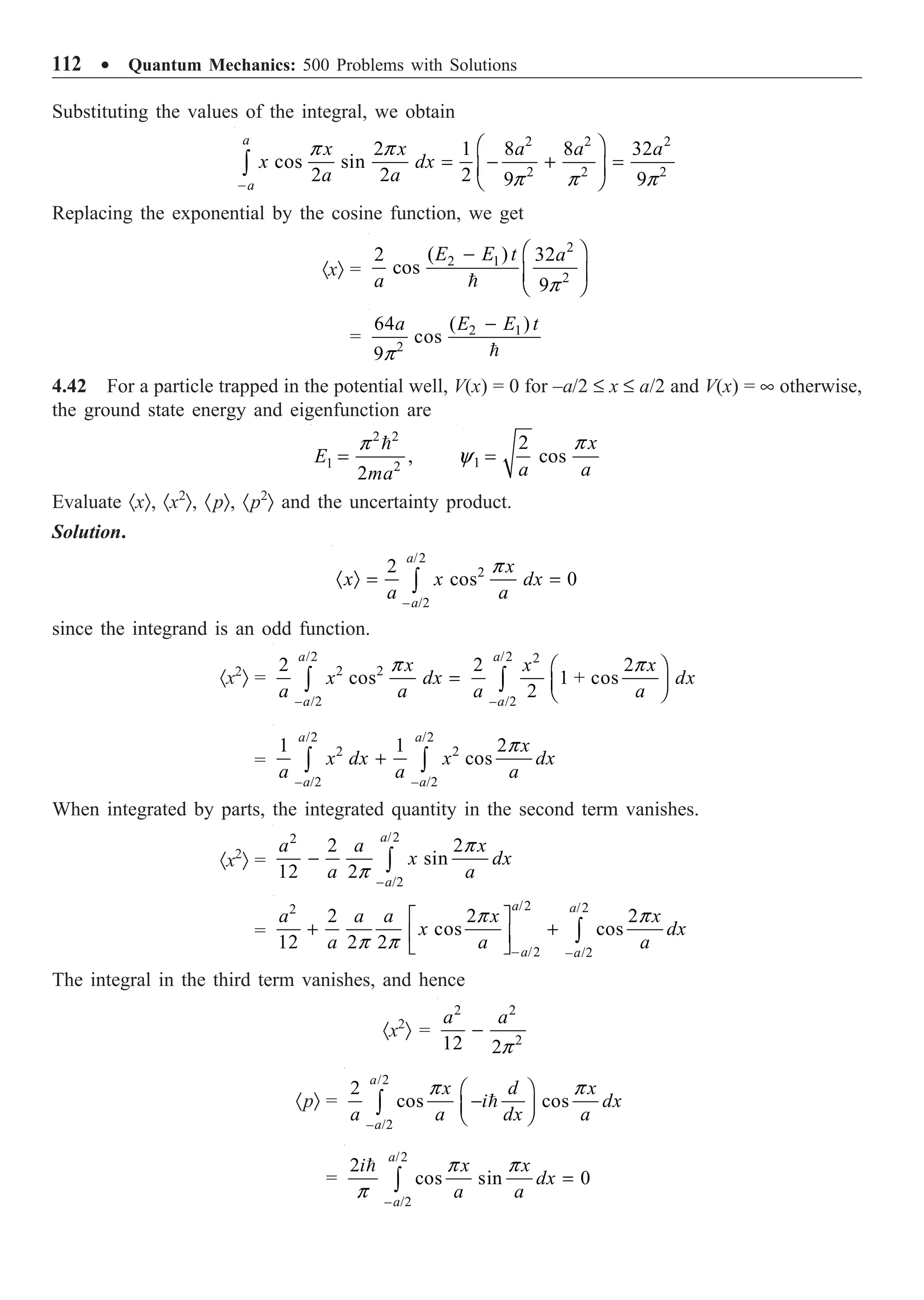
![One-Dimensional Systems ∑ 113
since the integrand is an odd function. Now,
·p2
Ò =
/2
– /2
2
cos cos
a
a
x d d x
i i dx
a a dx dx a
p p
Ê ˆ Ê ˆ
- -
Á ˜ Á ˜
Ë ¯ Ë ¯
Ú
Using the Schrödinger equation, we get
2 2
1 1 1
2
( ) ( )
2
d
x E x
m dx
y y
- =
·p2
Ò =
/2
1 1 1
– /2
*
2 2
a
i
a
mE dx mE
y y =
Ú
=
2 2 2 2
2 2
2
2
m
ma a
p p
=
(Dx)2
=
2
2 2 2
2
( 6)
12
a
x x
x
p
· Ò - · Ò = -
(Dp)2
=
2 2
2 2
2
p p
a
p
· Ò - · Ò =
The uncertainty product
2 2 2 2 2
2 2
( 6) 6
( )( )
12
12
a
x p
a
p p p
p
- -
D D = ¥ =
4.43 In the simple harmonic oscillator problem, the creation (a†
) and annihilation (a) operators are
defined as
a†
=
1/2 1/2
1
,
2 2
m
x i p
m
w
w
Ê ˆ Ê ˆ
-
Á ˜ Á ˜
Ë ¯ Ë ¯
1/2 1/2
1
2 2
m
a x i p
m
w
w
Ê ˆ Ê ˆ
= +
Á ˜ Á ˜
Ë ¯ Ë ¯
Show that (i) [a, a†
] = 1; (ii) [a, H] = wa, where H is the Hamiltonian operator of the oscillator;
and (iii) ·n | a†
a | nÒ ≥ 0, where | nÒ are the energy eigenkets of the oscillator.
Solution.
(i) a a†
=
1/2 1/2 1/2
1 1
2 2 2 2
m m
x i p x i p
m m
w w
w w
È ˘ È ˘
Ê ˆ Ê ˆ Ê ˆ Ê ˆ
Í ˙ Í ˙
+ -
Á ˜ Á ˜ Á ˜ Á ˜
Ë ¯ Ë ¯ Ë ¯ Ë ¯
Í ˙ Í ˙
Î ˚ Î ˚
= 2 2
1
( )
2 2 2
m i
x p xp px
m
w
w
+ - -
=
2
2 2
1 1
( )
2 2 2
p i
m x i
m
w
w
Ê ˆ
+ -
Á ˜
Ë ¯
=
1
2
H
w
+
(i)](https://image.slidesharecdn.com/quantummechanics500problemswithsolutionspdfdrive-220626164912-635041ea/75/Quantum-Mechanics_-500-Problems-with-Solutions-PDFDrive-pdf-123-2048.jpg)
![114 ∑ Quantum Mechanics: 500 Problems with Solutions
where H is the Hamiltonian operator of the simple harmonic oscillator. Simlarly,
a†
a =
1
2
H
w
-
(ii)
[a, a†
] = aa†
– a†
a =
1 1
1
2 2
H H
w w
+ - + =
(iii)
(ii) From Eqs. (i) and (ii),
aa†
+ a†
a =
2H
w
H =
2
w
(aa†
+ a†
a) (iv)
[a, H] = aH – Ha
=
2
w
(aaa†
+ aa†
a) –
2
w
(aa†
a + a†
aa)
=
2
w
(a2
a†
– a†
a2
) =
2
w
{a [a, a†
] + [a, a†
] a}
Substituting the value of [a, a†
] = 1, we get
[a, H] = wa (v)
Similarly,
[a†
, H] = –wa†
(vi)
(iii) ·n | a†
a | nÒ = ·n | a†
| mÒ ·m | a | nÒ
= ·m | a | nÒ†
·m | a | nÒ
= |·m | a | nÒ|2
≥ 0 (vii)
4.44 Particles of mass m and charge e approach a square barrier defined by V(x) = V0 for
0 x a and V(x) = 0 otherwise. The wave function in the region 0 x a is
y = Beax
+ Ce–ax
,
0
2 ( )
m V E
a
-
=
, E V0
(i) Explain why the exponentially increasing function Beax
is retained in the wave function.
(ii) Show that the current density in this region is (2ae/m) [Im (BC*)].
Solution.
(i) It is true that eax
Æ • as x Æ •. However, it is also an acceptable solution since the barrier
is of finite extent.
(ii) The probability current density
jx =
*
*
2
i d d
m dx dx
y y
y y
Ê ˆ
-
Á ˜
Ë ¯
= [( )( * * ) ( * * )( )]
2
x x x x x x x x
i
Be Ce B e C e B e C e Be Ce
m
a a a a a a a a
a - - - -
+ - - + -
= [ * + * + * * ]
2
i
BC CB B C C B
m
a
- -
= [ * *]
i
B C BC
m
a
-](https://image.slidesharecdn.com/quantummechanics500problemswithsolutionspdfdrive-220626164912-635041ea/75/Quantum-Mechanics_-500-Problems-with-Solutions-PDFDrive-pdf-124-2048.jpg)
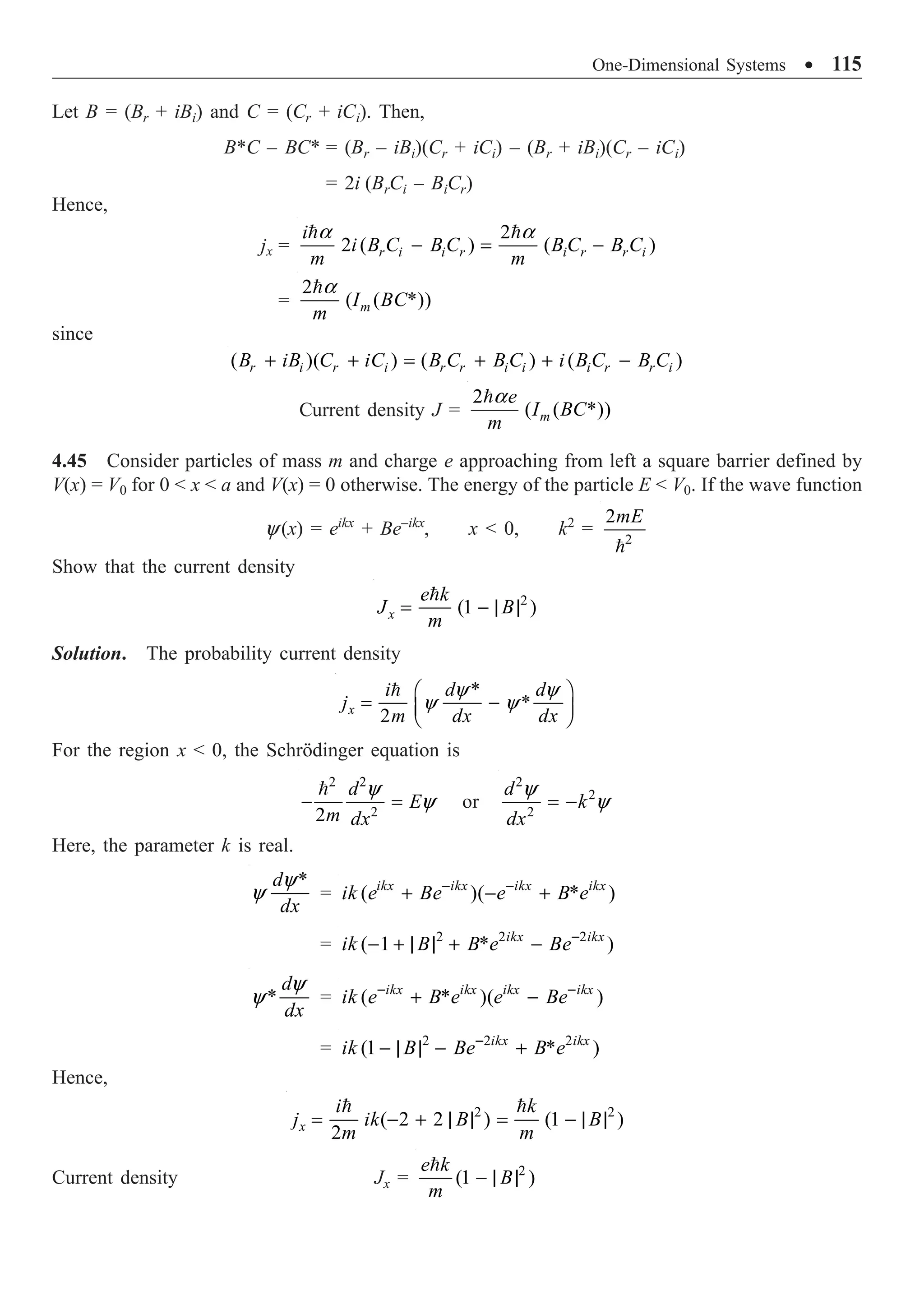
![116 ∑ Quantum Mechanics: 500 Problems with Solutions
4.46 Define the creation (a†
) and annihilation (a) operators for a harmonic oscillator and show that
(i) Ha | nÒ = (En – w)a | nÒ and Ha†
| n = (En + w)a†
| nÒ.
(ii) a | nÒ = 1
n n
| - Ò and a†
| nÒ = 1 1 .
n n
+ | + Ò
Solution.
(i) Creation and annihilation operators are defined in Problem 4.43, from which we have
[a, H] = wa, [a†
, H] = –wa†
From the first relation,
Ha| nÒ = aH| nÒ – wa| nÒ
= (En – w) a| nÒ (i)
Similarly, from the second relation,
H a†
| nÒ = (En + w) a†
| nÒ (ii)
Since En = [n + (1/2] w, from Eq. (i),
Ha| nÒ = [n – (1/2] w a| nÒ (iii)
For the (n – 1) state, we have
H | n – 1Ò = 1
1
1 1 1
2
n
E n n n
w
-
Ê ˆ
| - Ò = - + | - Ò
Á ˜
Ë ¯
=
1
1
2
n n
w
Ê ˆ
- | - Ò
Á ˜
Ë ¯
(iv)
Relations (iii) and (iv) are possible only if a|nÒ is a multiple of |n – 1Ò, i.e.,
a | nÒ = a | n – 1Ò (v)
·n | a†
= ·n – 1| a*
Hence,
·n | a†
a| nÒ = ·n – 1 | | a|2
|n – 1Ò
Substituting the value of a†
a, we get
|a |2
=
1 1 1
2 2 2
H
n n n n n n
w
- = + - =
a = n
Consequently,
a| nÒ = 1
n n
| - Ò (vi)
Similarly,
a†
| nÒ = 1 1
n n
+ | + Ò (vii)
4.47 In the harmonic oscillator problem, the creation (a†
) and annihilation (a) operators in
dimensionless units ( = w = m = 1) are defined by
†
,
2
x ip
a
-
=
2
x ip
a
+
=](https://image.slidesharecdn.com/quantummechanics500problemswithsolutionspdfdrive-220626164912-635041ea/75/Quantum-Mechanics_-500-Problems-with-Solutions-PDFDrive-pdf-126-2048.jpg)
![One-Dimensional Systems ∑ 117
An unnormalized energy eigenfunction is yn = (2x2
– 1) exp (–x2
/2). What is its state? Find the
eigenfunctions corresponding to the adjacent states.
Solution. We have
a | nÒ = 1
n n
| - Ò , a†
| nÒ = 1 1
n n
+ | + Ò
aa†
| nÒ = a 1 1
n n
+ | + Ò = (n + 1) | nÒ
Operators for a†
and a are
a†
=
1
,
2
d
x
dx
Ê ˆ
-
Á ˜
Ë ¯
a =
1
2
d
x
dx
Ê ˆ
+
Á ˜
Ë ¯
In the given case, substituting the values of a, a†
and | nÒ,
aa†
| ynÒ = 2 2
1
(2 1) exp ( /2)
2
d d
x x x x
dx dx
Ê ˆ Ê ˆ
+ - - -
Á ˜ Á ˜
Ë ¯ Ë ¯
=
3 2
1
(4 6 ) exp ( /2)
2
d
x x x x
dx
Ê ˆ
+ - -
Á ˜
Ë ¯
= 2 2 2 2
1
(12 6)exp ( /2) 3 (2 1)exp ( /2)
2
x x x x
- - = - -
= (2 1) n
y
+ | Ò
Hence, the quantum number corresponding to this state is 2. The adjacent states are the n = 1 and
n = 3 states. Therefore,
y1 =
1
1 2
2
a
| Ò = | Ò
=
2 2
1 1
(2 1) exp ( /2)
2 2
d
x x x
dx
Ê ˆ
+ - -
Á ˜
Ë ¯
= 3 2 2
1
[2 4 (2 1)( )] exp ( /2)
2
x x x x x x
- + + - - -
= 2
2 exp ( /2)
x x
-
Substituting the values of a and | 2 Ò, we get
y3 =
2
† 2
1 1 1
3 2 (2 1) exp
2
3 3 2
d x
a x x
dx
Ê ˆ
| Ò = | Ò = - - -
Á ˜
Ë ¯
=
2
3 2
1
[2 4 (2 1)( )] exp
2
6
x
x x x x x
- - - - - -
=
2
3
2
(2 3 ) exp
2
6
x
x x
- -](https://image.slidesharecdn.com/quantummechanics500problemswithsolutionspdfdrive-220626164912-635041ea/75/Quantum-Mechanics_-500-Problems-with-Solutions-PDFDrive-pdf-127-2048.jpg)
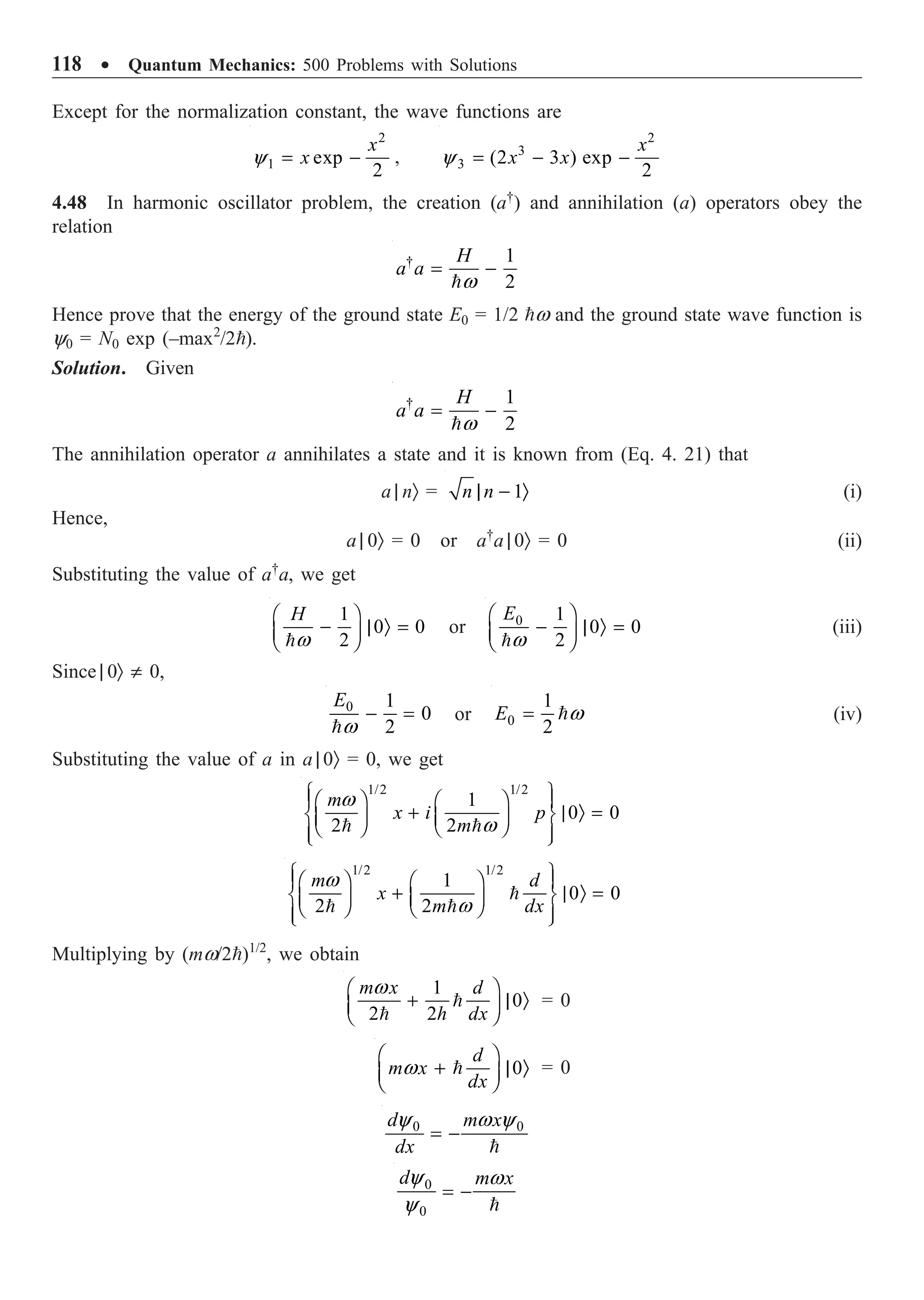
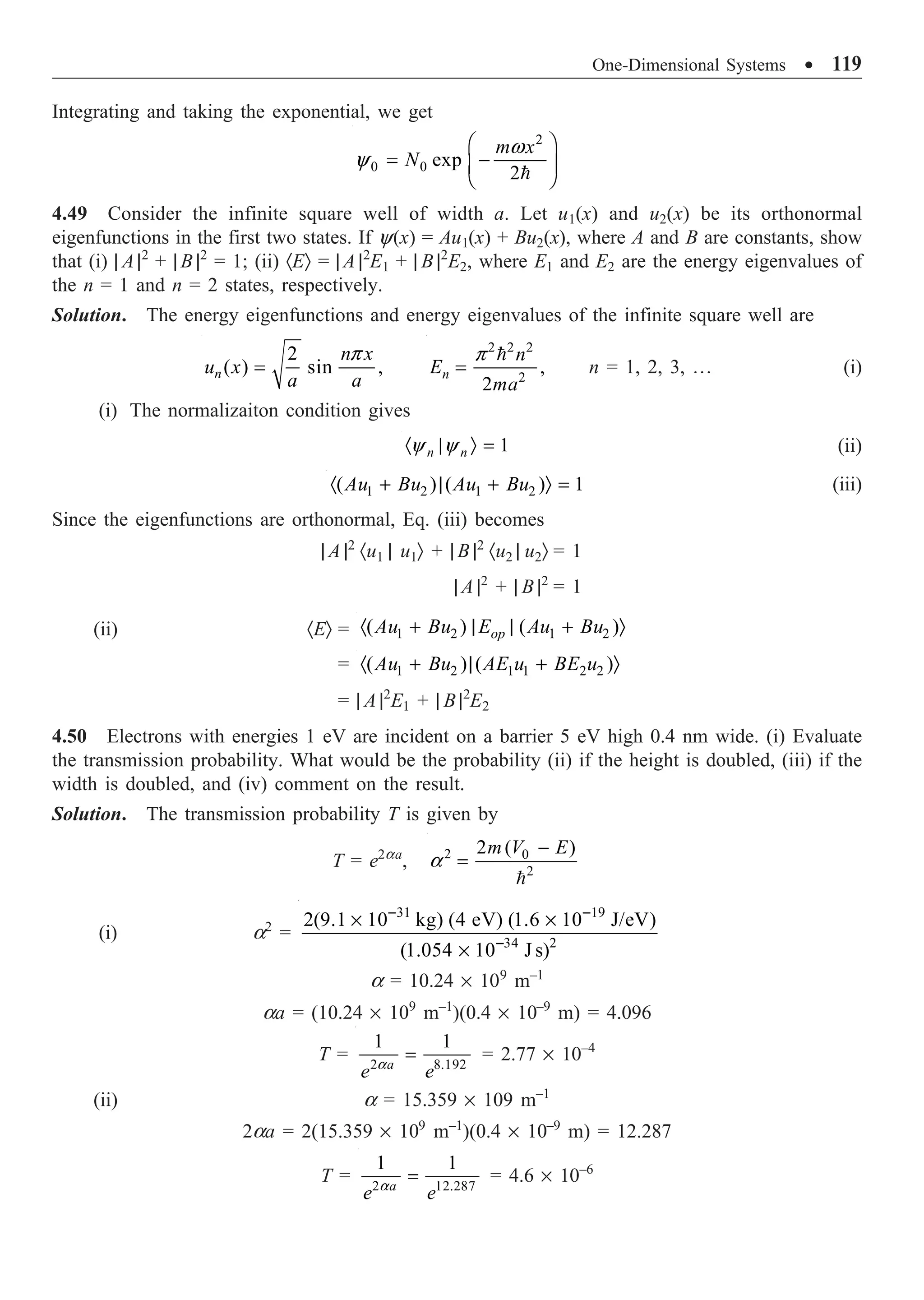

![One-Dimensional Systems ∑ 121
2
2
d
dx
y
= 2 2 2 2 2 3
1 ( 2) 2
2
( ) ( )
x x
A
x a x a
È ˘
-
- +
Í ˙
+ +
Í ˙
Î ˚
=
2 2 2 2 2
2 2 3 2 2 3
[ 4 ] 3
2 2
( ) ( )
x a x a x
A A
x a x a
+ - -
- = -
+ +
Substituting in the Schrödinger equation, we get
2 2 2
2 2 3 2 2
( 3 )
2 0
2 ( )
a x VA
A
m x a x a
-
= =
+ +
2 2 2
2 2 2
(3 )
( )
( )
x a
V x
m x a
-
=
+
4.53 A beam of particles having energy 2 eV is incident on a potential barrier of 0.1 nm width and
10 eV height. Show that the electron beam has a probability of 14% to tunnel through the barrier.
Solution. The transmission probability
2
0
2
0
16 ( )
,
a
E V E e
T
V
a
-
-
@ 2 0
2
2 ( )
m V E
a
-
@
where a is the width of the barrier, V0 is the height of the barrier, and E is the energy of the electron.
a2
=
31 19
34 2
2(9.1 10 kg)(8 eV 1.6 10 J/eV)
(1.05 10 J s)
- -
-
¥ ¥ ¥
¥
= 211.3 ¥ 1018
m–2
a = 9 1
14.536 10 m-
¥
aa = 9 1 9
(14.536 10 m )(0.1 10 m) 1.4536
- -
¥ ¥ =
29072
2
16 2 eV 8 eV
0.14
(10 eV)
T e-
¥ ¥
= =
The percentage probability to tunnel through the barrier is 14.
4.54 For the ground state of a particle of mass m moving in a potential,
V(x) = 0, 0 x a and V(x) = • otherwise
Estimate the uncertainty product (Dx)(Dp).
Solution. The energy of the ground state
2 2
2
2
E
ma
p
=
This must be equal to p2
/2m. Hence,
2 2 2
2
2 2
p
m ma
p
=
or
2 2
2
2
p
a
p
=
2 2 2
( )
p p p
D = · Ò - · Ò](https://image.slidesharecdn.com/quantummechanics500problemswithsolutionspdfdrive-220626164912-635041ea/75/Quantum-Mechanics_-500-Problems-with-Solutions-PDFDrive-pdf-131-2048.jpg)
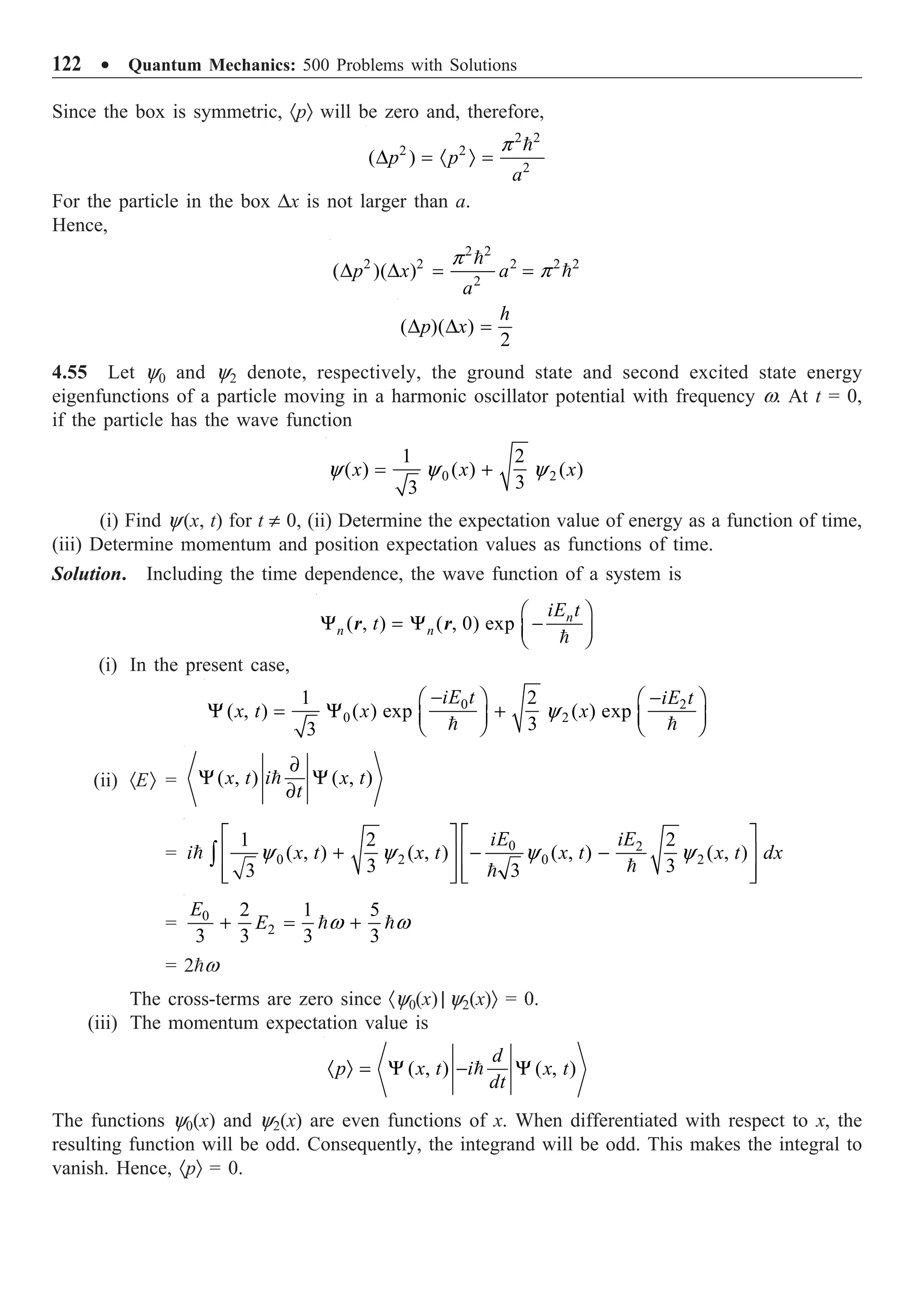

![124 ∑ Quantum Mechanics: 500 Problems with Solutions
4.57 A beam of particles, each with energy E approaches a step potential of V0.
(i) Show that the fraction of the beam reflected and transmitted are independent of the mass
of the particle.
(ii) If E = 40 MeV and V0 = 30 MeV, what fraction of the beam is reflected and transmitted?
Solution. Details of particles approaching a potential step are discussed in Problem 4.19. We have
the relations:
Incident flux of particles = 0
k
m
(i)
Reflected flux of particles = 2
0
k
A
m
| |
(ii)
Transmitted flux of particles = 2
0
k
B
m
| |
(iii)
where
2
0 2
2
,
mE
k =
2 0
2
2 ( )
m E V
k
-
=
(iv)
0
0
,
k k
A
k k
-
=
+
0
0
2k
B
k k
=
+
(v)
(i) Fraction reflected =
2
2
0
0
/
/
k A m
A
k m
| |
= | |
=
2 2 2
0 0 0
2 2 2
0 0 0
( ) 2
( ) 2
k k k k kk
k k k k kk
- + -
=
+ + +
=
2 2 2
0 0
2 2 2
0 0
(2 / ) [2 ( )/ ] 2(2 / ) ( )
(2 / ) [2 ( )/ ] 2(2 / ) ( )
mE m E V m E E V
mE m E V m E E V
+ - - -
+ - + -
=
0 0
0 0
( ) 2 ( )
( ) 2 ( )
E E V E E V
E E V E E V
+ - - -
+ - + -
(vi)
That is, the fraction reflected is independent of mass.
Fraction transmitted =
2
2
0 0
/
/
k B m k
B
k m k
| |
= | |
=
2
0 0
2 2
0 0 0
4 4
( ) ( )
k kk
k
k k k k k
=
+ +
=
2
0
2
0 0
4(2 / ) ( )
(2 / ) [ ( ) 2 ( )]
m E V E
m E E V E E V
-
+ - + -
=
0
0 0
4 ( )
( ) 2 ( )]
E V E
E E V E E V
-
+ - + -
(vii)
i.e., the fraction transmitted is independent of mass.](https://image.slidesharecdn.com/quantummechanics500problemswithsolutionspdfdrive-220626164912-635041ea/75/Quantum-Mechanics_-500-Problems-with-Solutions-PDFDrive-pdf-134-2048.jpg)
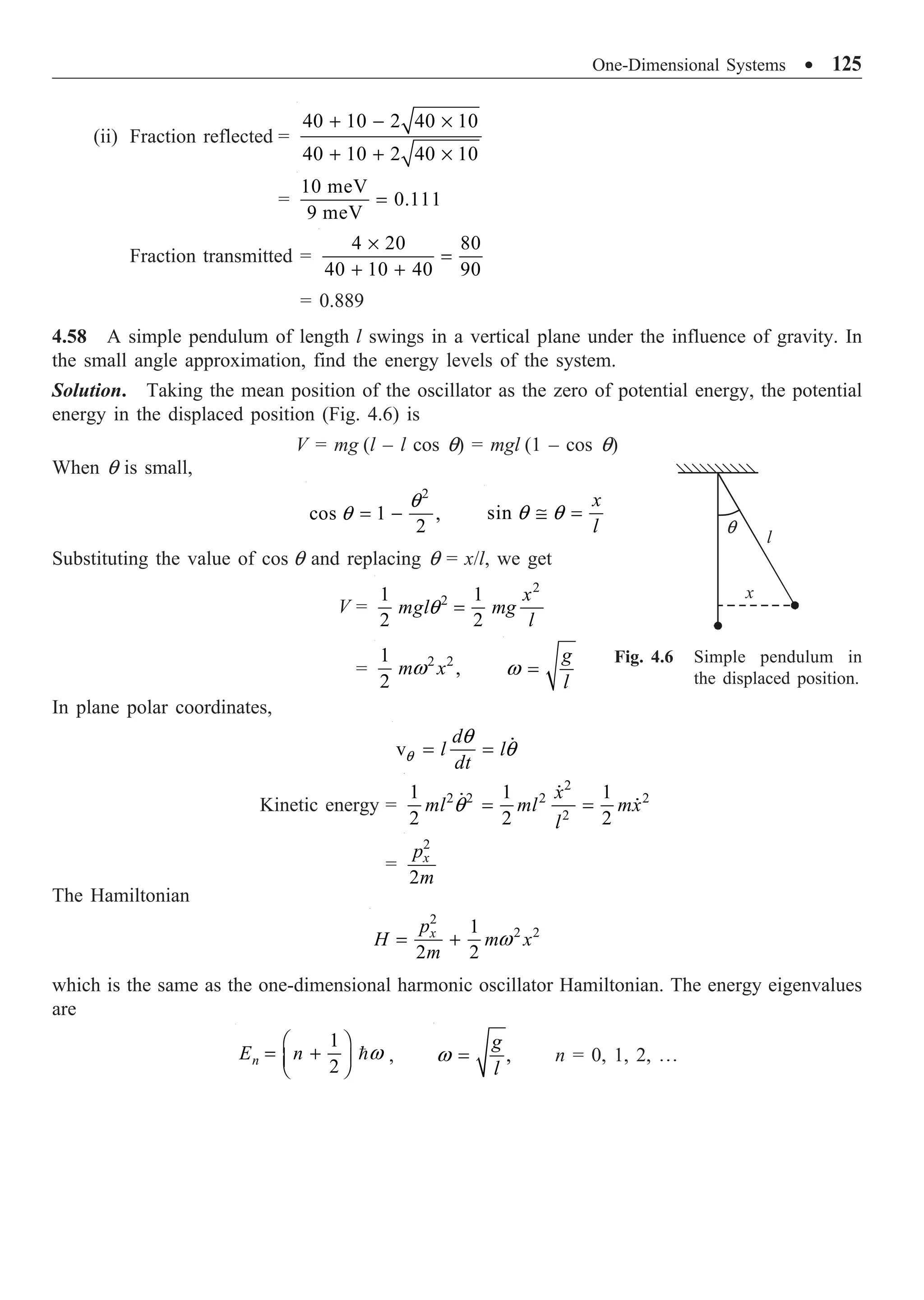
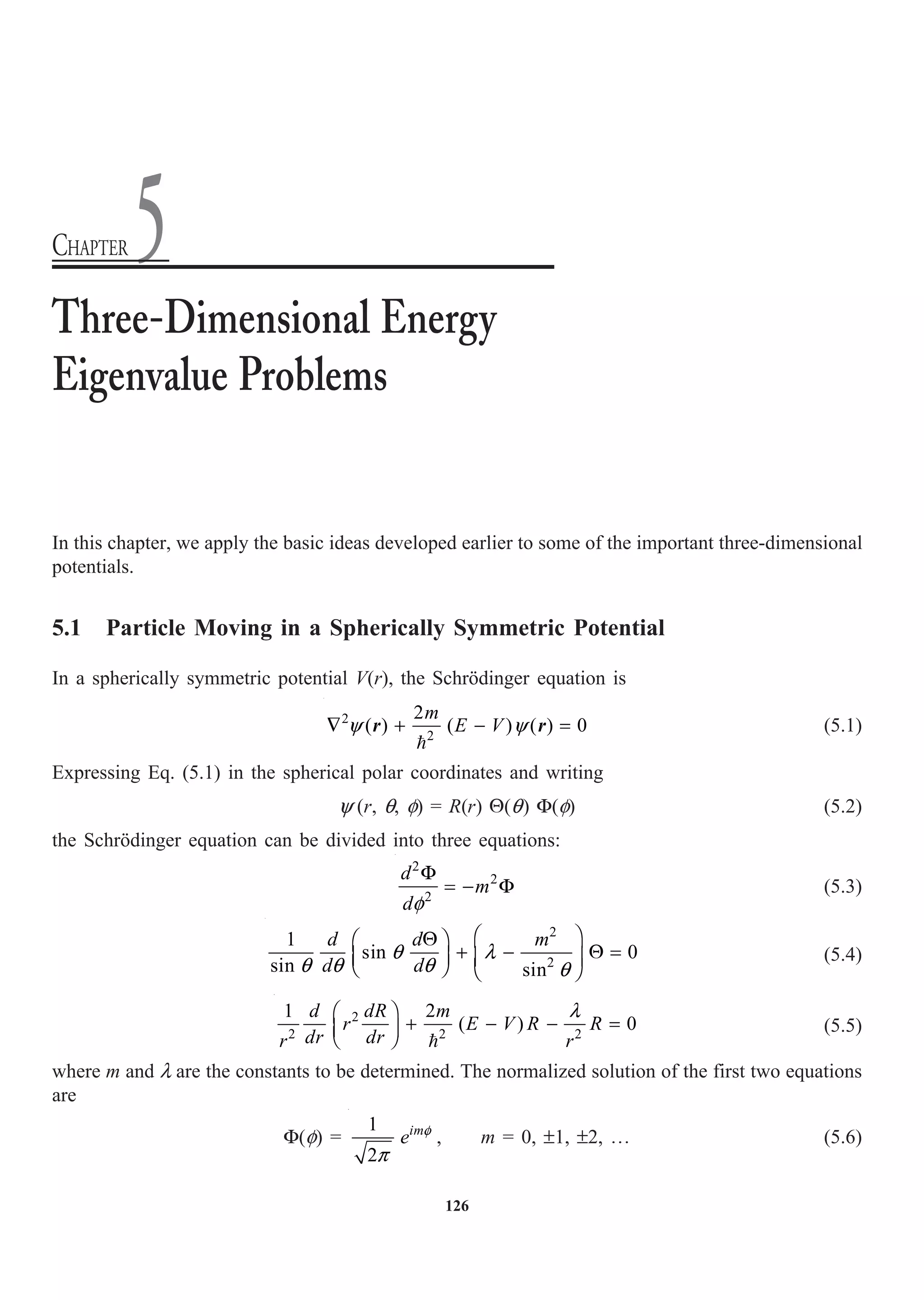

![128 ∑ Quantum Mechanics: 500 Problems with Solutions
The energy eigenvalues are
2 4
2 2 2 2
0
1
,
32
n
Z e
E
e n
m
p
= -
n = 1, 2, 3, º (5.13)
The normalized radial wave functions are
1/2
3
/2 2 1
3
0
2 ( 1) !
( ) ( )
2 [( ) !]
l l
nl n l
Z n l
R r e L
na n n l
r
r r
- +
+
Ï ¸
- -
Ê ˆ
Ô Ô
= - Ì ˝
Á ˜
Ë ¯ +
Ô Ô
Ó ˛
(5.14)
2
8
,
E
r
m
r = -
l = 0, 1, 2, º, (n – 1) (5.15)
2 1
( )
l
n l
L r
+
+ are the associated Laguerre polynomials. The wave function is given by
( , , ) ( ) ( , )
nlm nl lm
r R r Y
y q f q f
= (5.16)
n = 1, 2, 3, º; l = 0, 1, 2, º, (n – 1); m = 0, ±1, ±2, º, ±l
The explict form of the ground state wave function is
0
3/2
/
100 1/2
0
1 Zr a
Z
e
a
y
p
-
Ê ˆ
= Á ˜
Ë ¯
(5.17)
The radial probability density, Pnl(r) is the probability of finding the electron of the hydrogen atom
at a distance r from the nucleus. Thus,
2 2
( )
nl nl
P r r R
= | | (5.18)](https://image.slidesharecdn.com/quantummechanics500problemswithsolutionspdfdrive-220626164912-635041ea/75/Quantum-Mechanics_-500-Problems-with-Solutions-PDFDrive-pdf-138-2048.jpg)



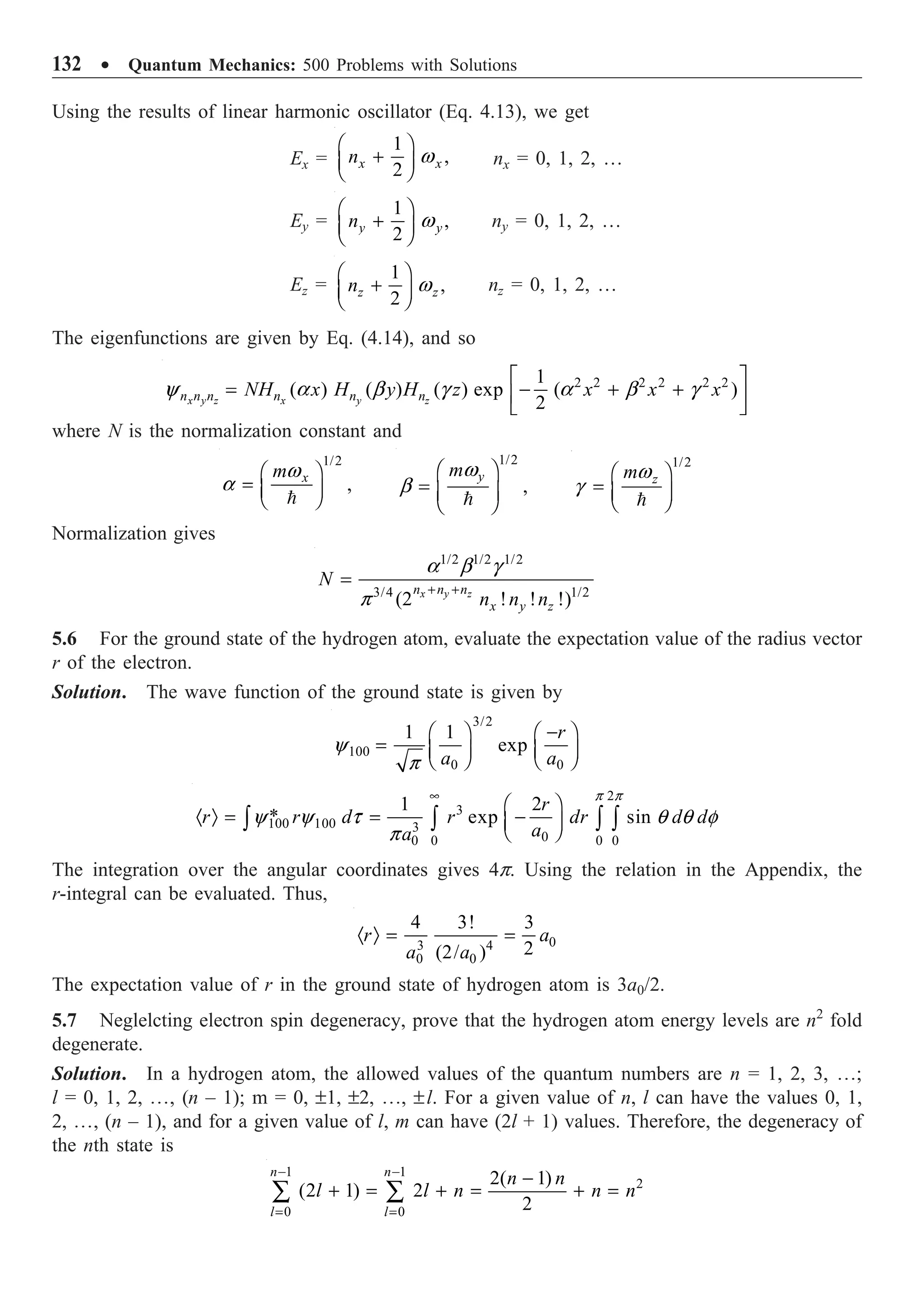
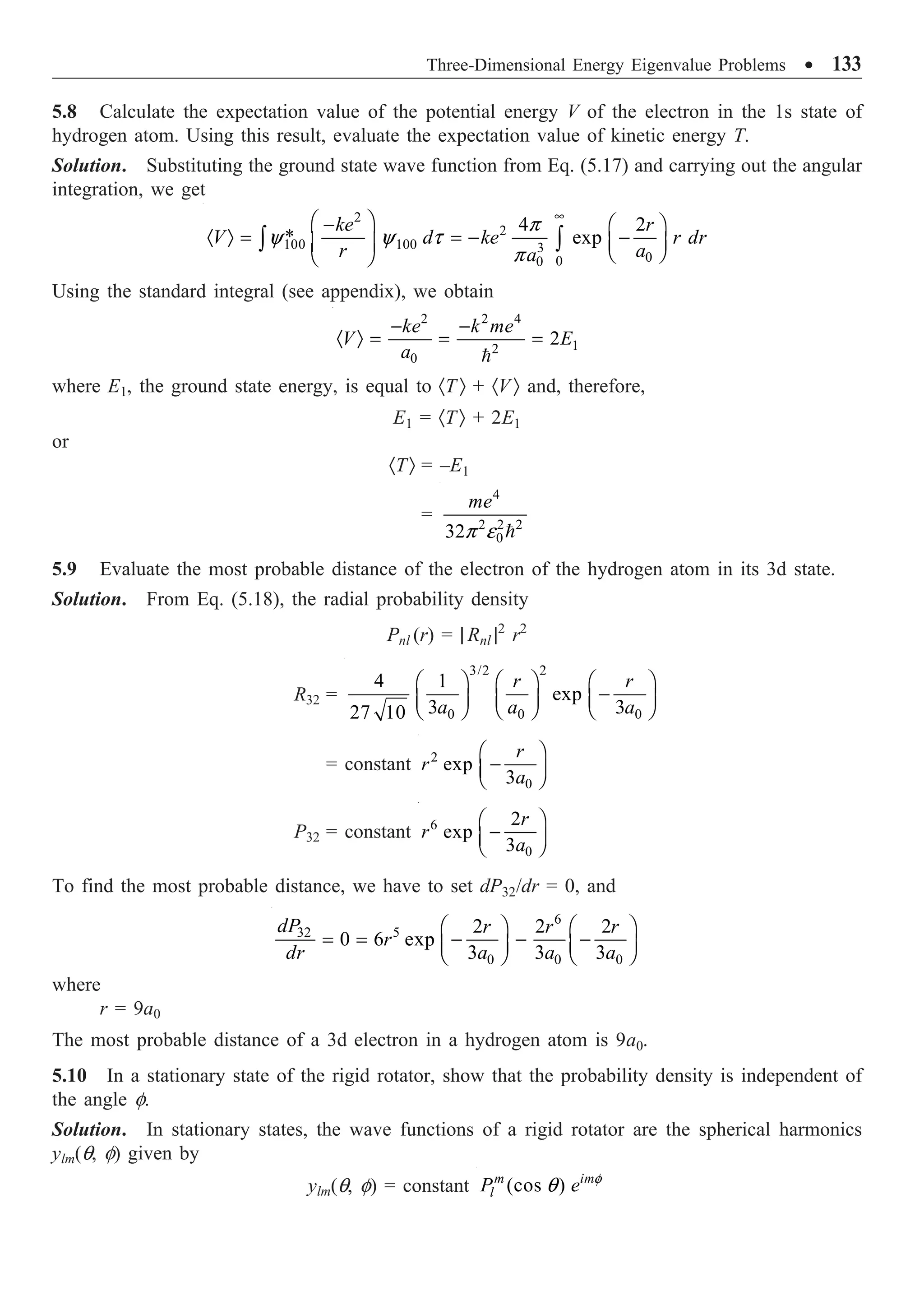
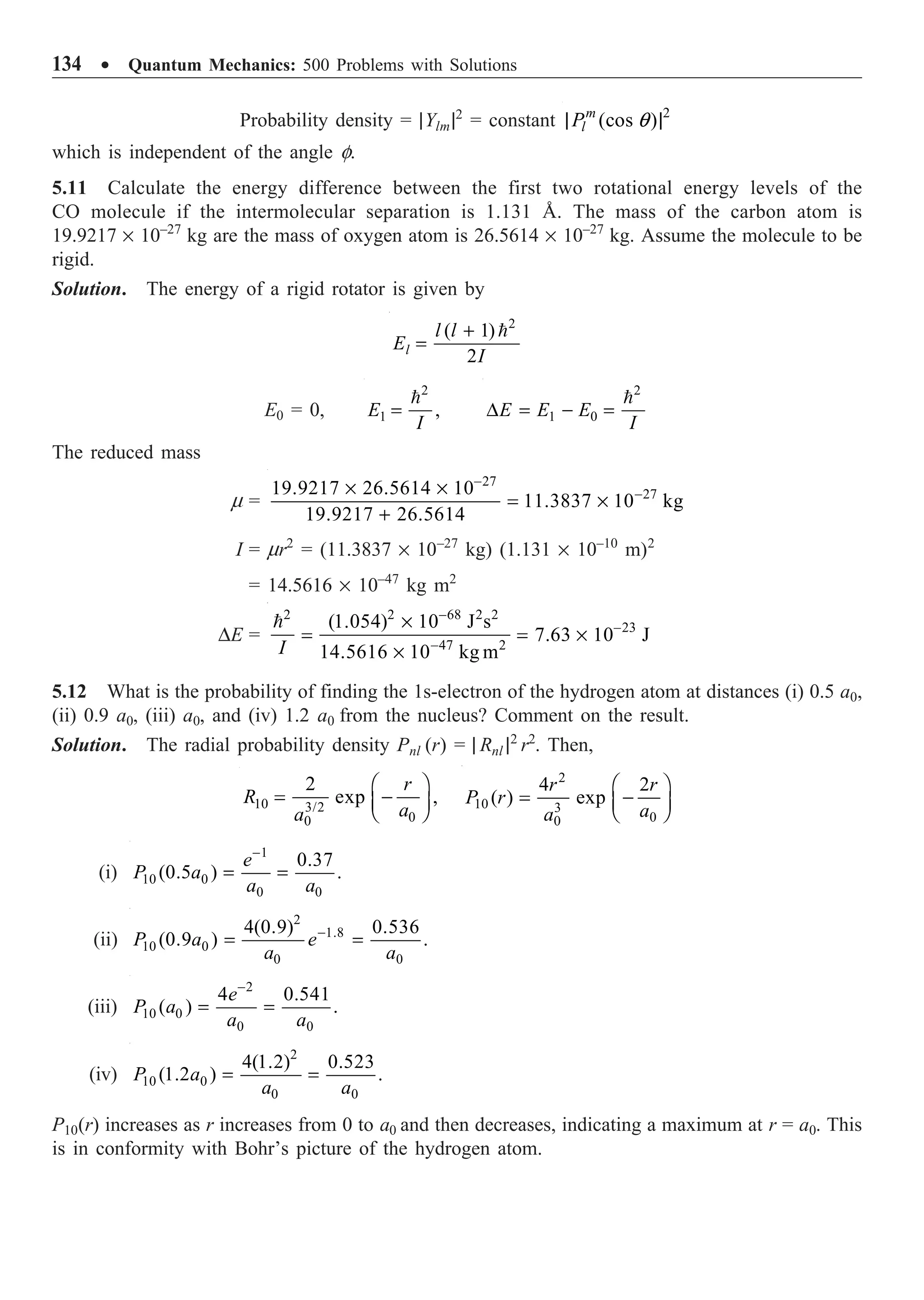
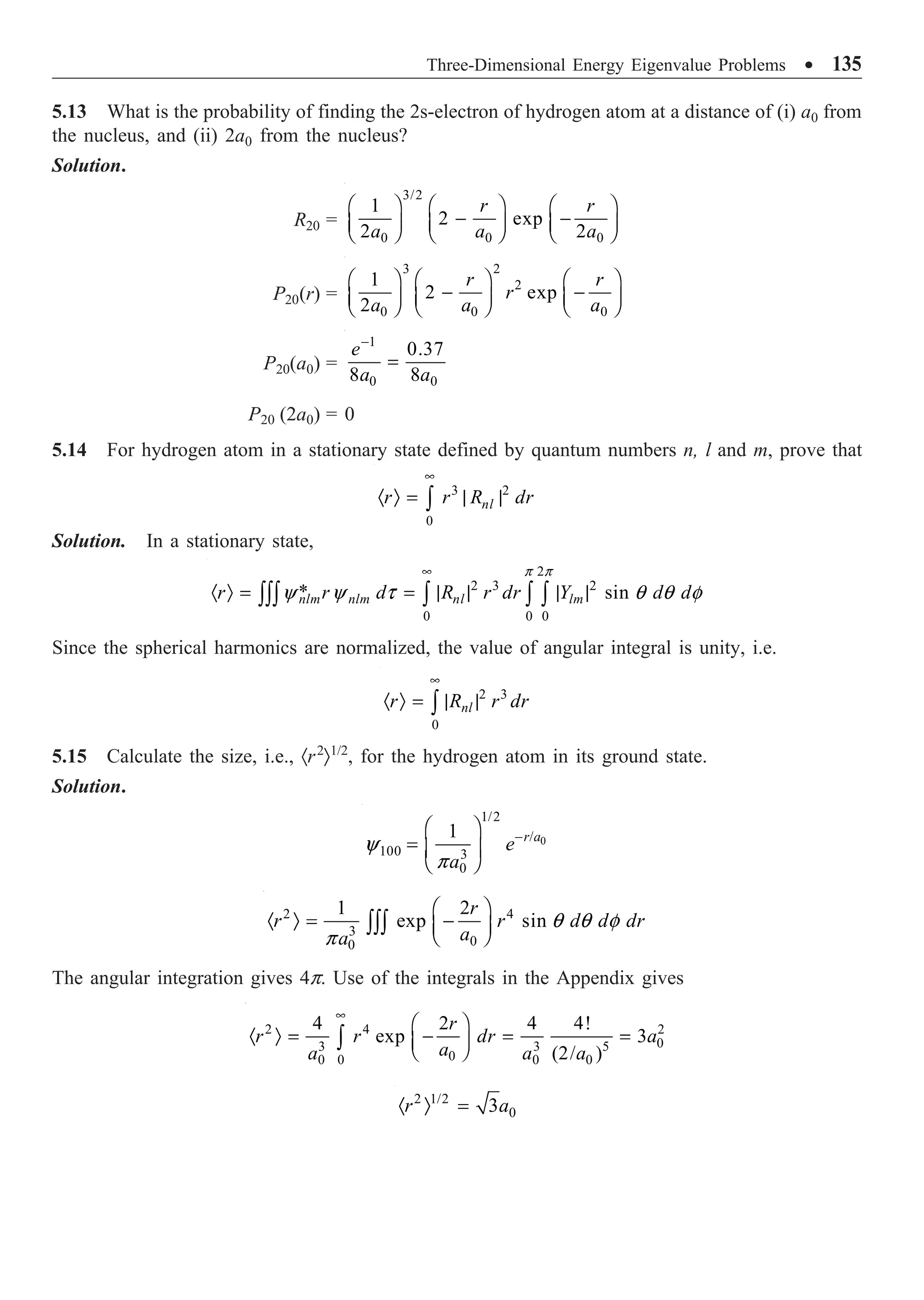
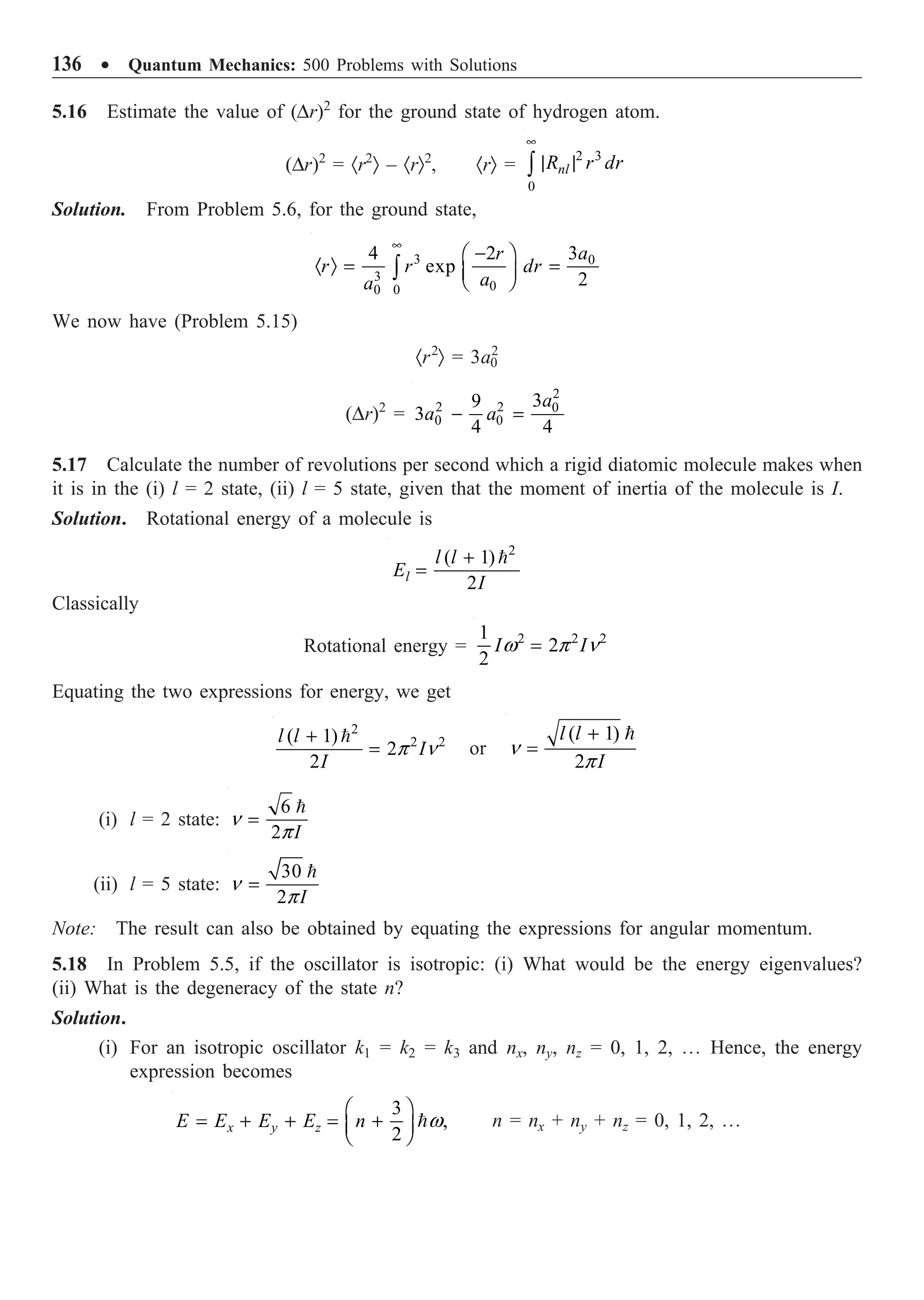
![Three-Dimensional Energy Eigenvalue Problems ∑ 137
(ii) Degeneracy of the state n : The various possibilities are tabulated:
nx ny nz
n 0 0 1 way
n – 1 1 0
n – 1 0 1
2 ways
n – 2 1 1
n – 2 0 2 3 ways
n – 2 2 0
1 n – 1 0
1
n ways
0 n 0
0 0 n
(n + 1) ways
Total no. of ways = 1 + 2 + 3 + º + (n + 1)
= (n + 1)(n + 2)/2
Degeneracy of the state (n) = (n + 1)(n + 2)/2
5.19 Find the number of energy states and energy levels in the range E [15R2
/(8 ma2
)] of a
cubical box of side a.
Solution. For a particle in a cubic box of side a, the energy is given by (refer Problem 5.2)
2 2 2
2 2 2 2 2 2
2 2
( ) ( )
2 8
x y z x y z
h h
E n n n n n n
ma ma
p
= + + = + +
Comparing with the given expression, we get
2 2 2
15
x y z
n n n
+ +
The number of possible combinations of (nx ny nz) is
(1 1 1) 1 way
(1 1 2), (1 2 1), (2 1 1) 3 ways
(1 1 3), (1 3 1), (3 1 1) 3 ways
(1 2 2), (2 1 2), (2 2 1) 3 ways
(2 2 2) 1 way
(1 2 3), (1 3 2), (2 1 3), (2 3 1), (3 2 1), (3 1 2) 6 ways
Total 17 ways
Hence the No. of possible states = 17. The No. of energy levels = 6.
5.20 Show that the three 2p eigenfunctions of hydrogen atom are orthogonal to each other.
0
/2
210 1 cos
r a
c re
y q
-
= , c1 being constant
0
/2
21, 1 2 sin ,
r a i
c re e f
y q
- ±
± = c2 being constant](https://image.slidesharecdn.com/quantummechanics500problemswithsolutionspdfdrive-220626164912-635041ea/75/Quantum-Mechanics_-500-Problems-with-Solutions-PDFDrive-pdf-147-2048.jpg)
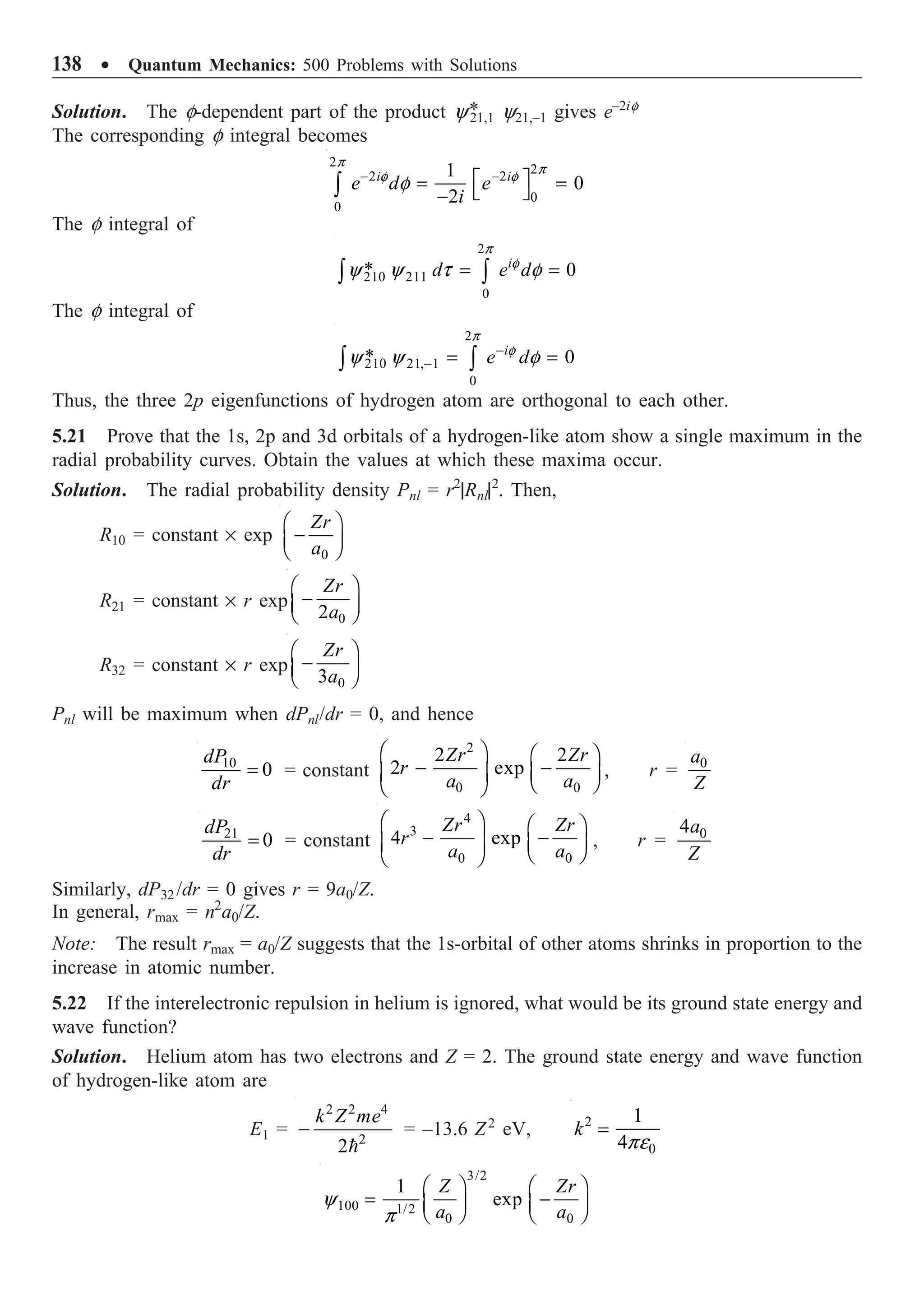
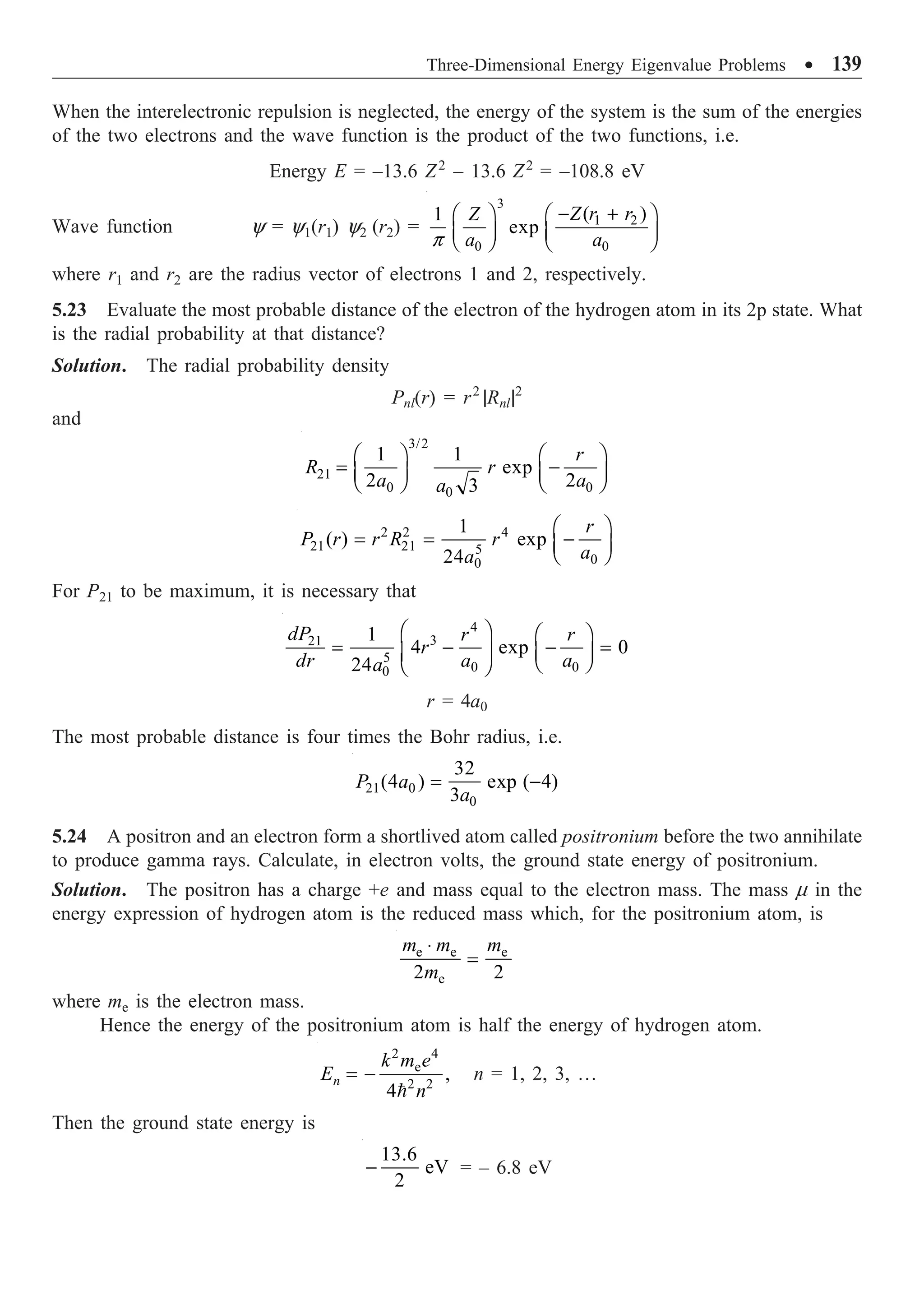
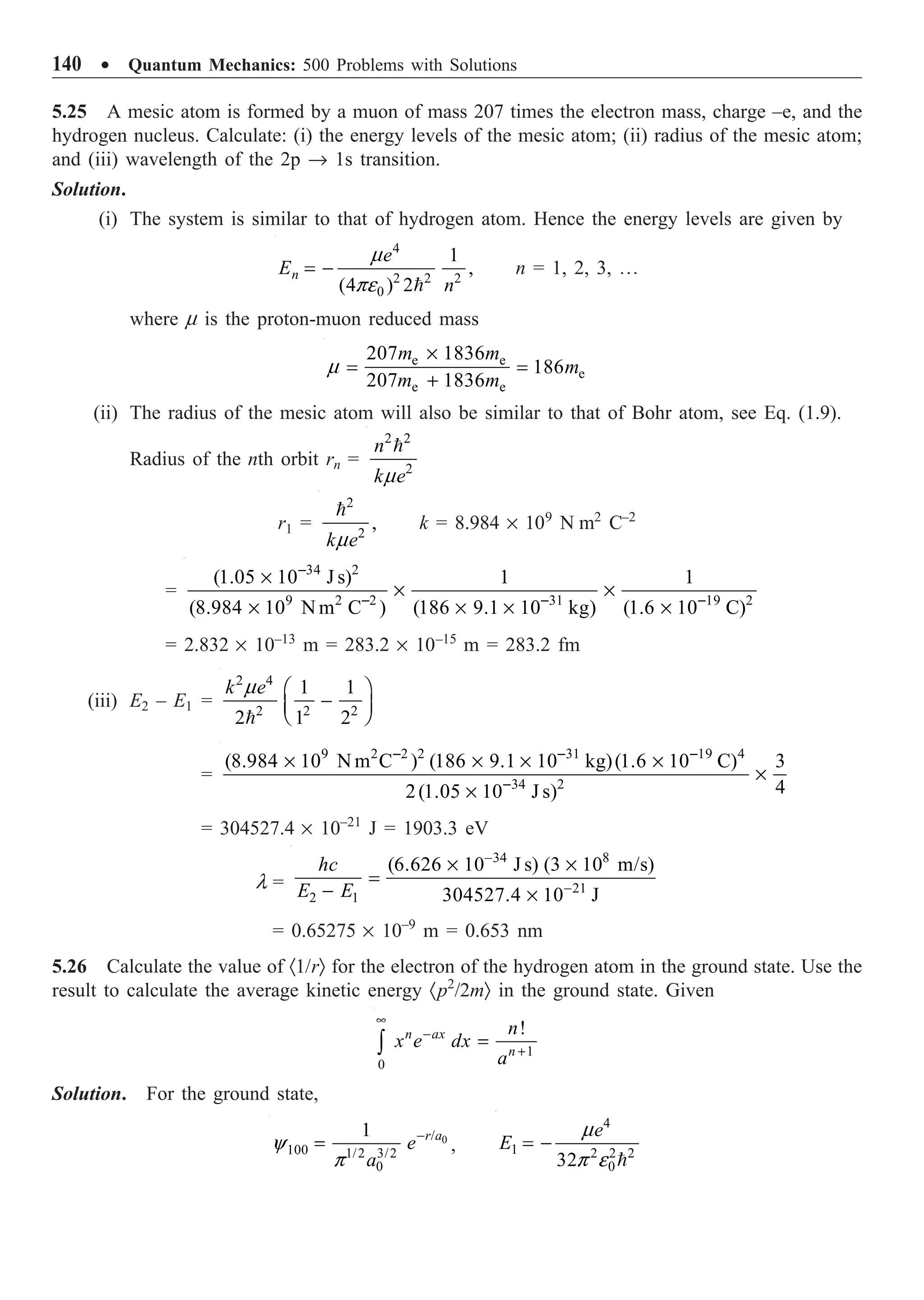
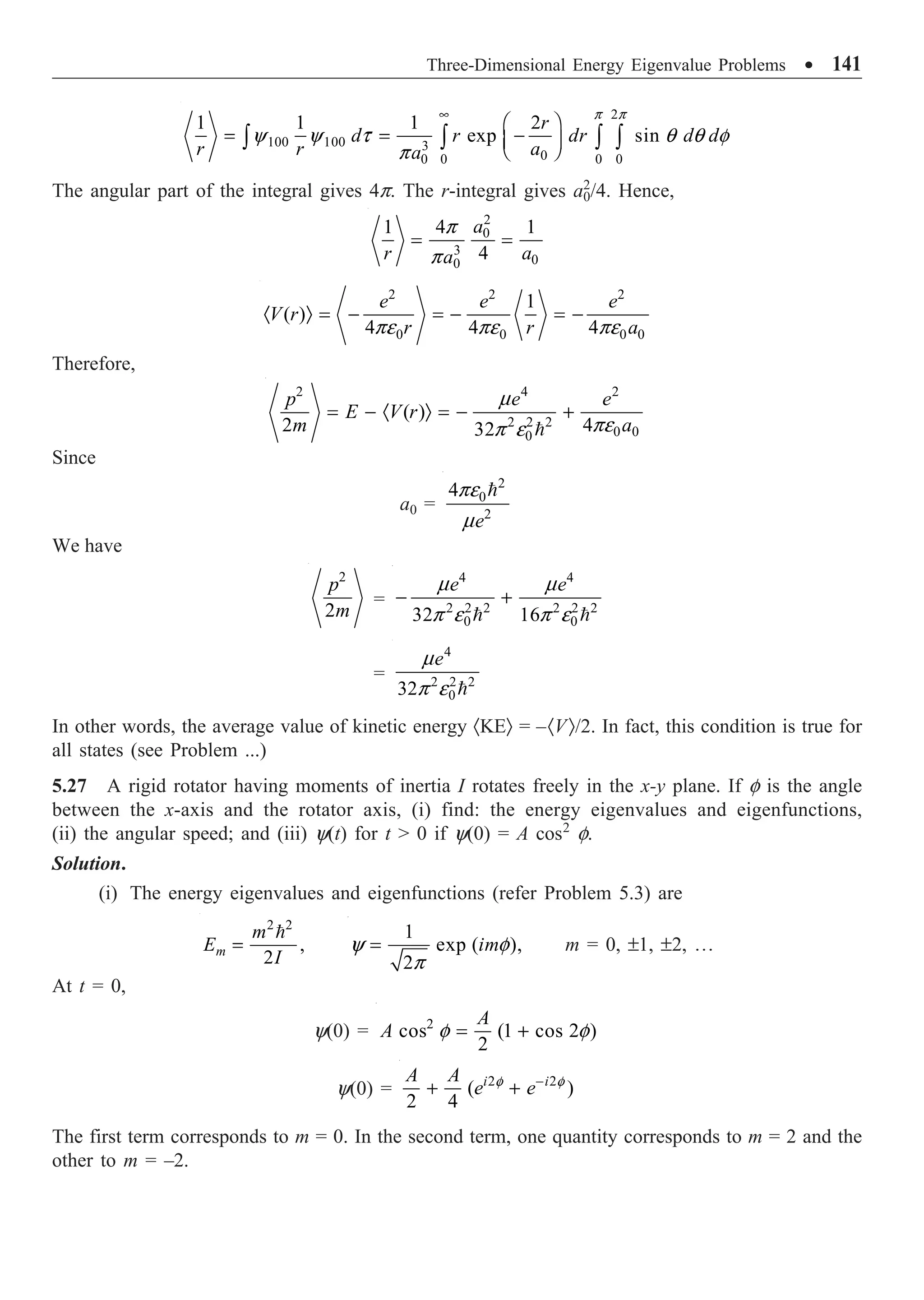
![142 ∑ Quantum Mechanics: 500 Problems with Solutions
(ii) The angular speed f
is given by
2
1
2
m
E If
= or
2 2
2
1
2 2
m
I
I
f
=
m
I
f =
(iii) y(t) = 2 2
2 2
exp exp
2 4 4
i i
iE t iE t
A A A
e e
f f
- -
Ê ˆ Ê ˆ
+ ◊ - + ◊ -
Á ˜ Á ˜
Ë ¯ Ë ¯
= exp 2 exp 2
2 4 4
A A t A t
i i
I I
f f
È ˘ È ˘
Ê ˆ Ê ˆ
+ - + - +
Í ˙ Í ˙
Á ˜ Á ˜
Ë ¯ Ë ¯
Î ˚ Î ˚
5.28 A particle of mass m is confined to the interior of a hollow spherical cavity of radius R1 with
impenetrable walls. Find the pressure exerted on the walls of the cavity by the particle in its ground
state.
Solution. The radial wave equation (5.5), with V(r) = 0, is
2
2 2 2
1 2 ( 1)
0
d dR mE l l
r R
dr dr
r r
+
Ê ˆ È ˘
+ - =
Á ˜ Í ˙
Ë ¯ Î ˚
For the ground state, l = 0. Writing
( )
( )
r
R r
r
c
=
the radial equation reduces to [refer Eq. (5.17)]
2
2
2
0,
d
k
dr
c
c
+ = 2
2
2
,
mE
k =
r R
whose solution is
c = A sin kr + B cos kr, A and B are constants.
R is finite at r = 0, i.e., at r = 0, c = Rr = 0. This leads to B = 0. Hence,
c = A sin kr
The condition that R = 0 at r = R1 gives
0 = A sin kR1
As A cannot be zero,
kR1 = np or
1
,
n
k
R
p
= n = 1, 2, 3, º
Hence the solution is
c =
1
sin ,
n r
A
R
p
n = 1, 2, 3, º
Normalization gives
1 1
2
sin ,
n
n r
R R
p
c = n = 1, 2, 3, º](https://image.slidesharecdn.com/quantummechanics500problemswithsolutionspdfdrive-220626164912-635041ea/75/Quantum-Mechanics_-500-Problems-with-Solutions-PDFDrive-pdf-152-2048.jpg)

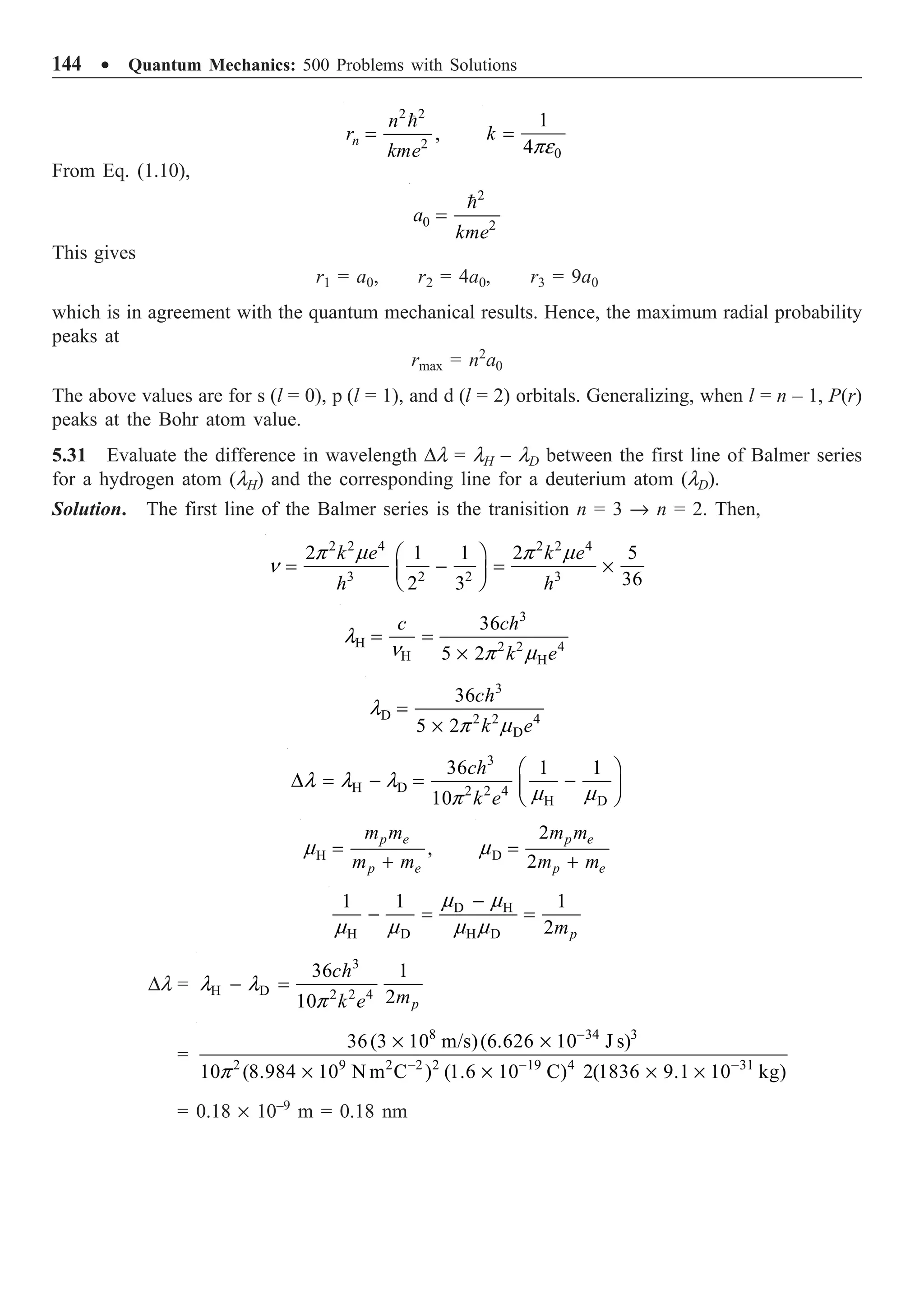
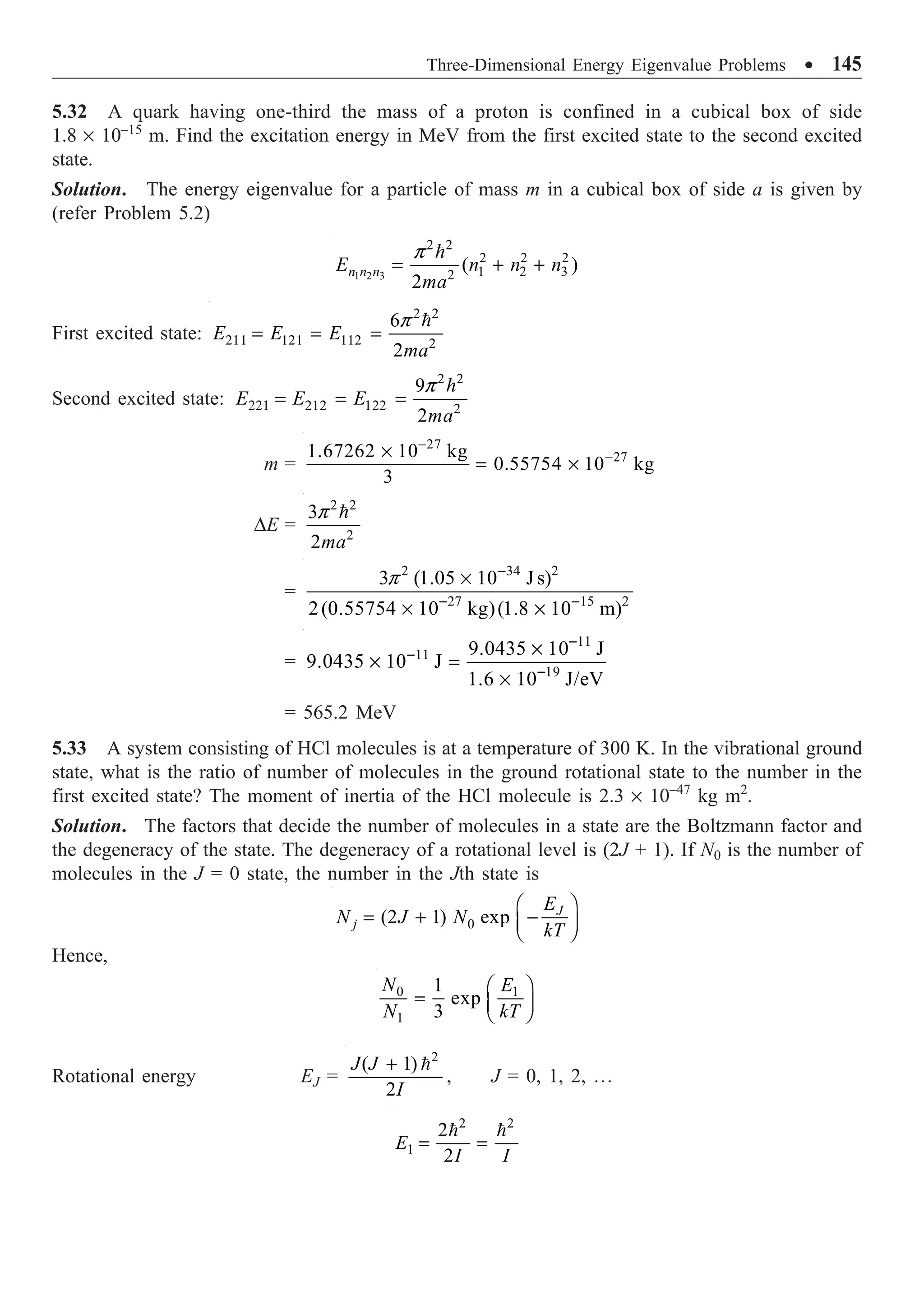
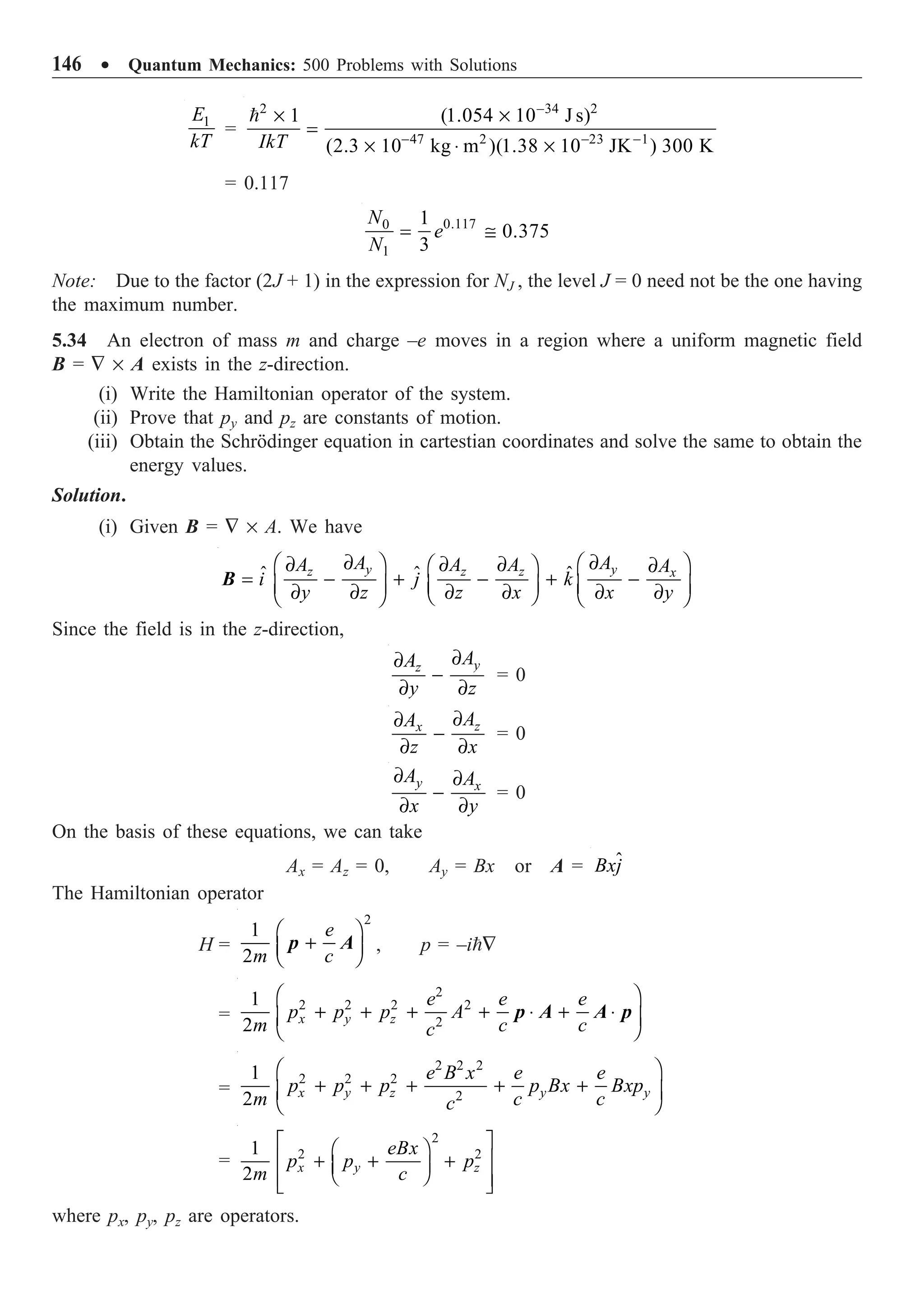
![Three-Dimensional Energy Eigenvalue Problems ∑ 147
(ii) Since the operator py commutes with px, pz and x,
[py, H] = [pz, H] = 0
Hence py and pz are constants.
(iii) The Schrödinger equation is
2
2 2
1
2 x y z
eBx
p p p E
m c
y y
È ˘
Ê ˆ
Í ˙
+ + + =
Á ˜
Ë ¯
Í ˙
Î ˚
2 2
2
1
2 2
z
x y
p
eBx
p p E
m c m
y y
È ˘
Ê ˆ
Ê ˆ
Í ˙
+ + = -
Á ˜
Á ˜
Ë ¯
Í ˙
Ë ¯
Î ˚
Let us change the variable by defining
,
y
cp
x
eB
c = + pc = px
y
y y
cp
eBx eB eB
p p
c c eB c
c
c
Ê ˆ
+ = + - =
Á ˜
Ë ¯
In terms of the new variables, [c, pc] = i. Hence, the above equation reduces to
2 2 2
2
2 2 2
z
p p
m eB
E
m mc m
c
c y y
È ˘ Ê ˆ
Ê ˆ
Í ˙
+ = -
Á ˜
Á ˜
Ë ¯
Í ˙ Ë ¯
Î ˚
Since pz is constant, this equation is the same as the Schrödinger equation of a simple harmonic
oscillator of angular frequency w = eB/mc and energy eigenvalue E – (pz
2
/2m). Therefore,
2
1
,
2 2
z
p
E n
m
w
Ê ˆ
- = +
Á ˜
Ë ¯
n = 0, 1, 2, º
2
1
,
2 2
z
p
E n
m
w
Ê ˆ
= + +
Á ˜
Ë ¯
n = 0, 1, 2, º
5.35 Consider the free motion of a particle of mass M constrained to a circle of radius r. Find the
energy eigenvalues and eigenfunctions.
Solution. The system has only one variable, viz. the azimuthal angle f. The classical energy
equation is
2
2
p
E
m
=
where p is the momentum perpendicular to the radius vector of the particle. Since the z-component
of angular momentum Lz = pr,
2
2
2
z
L
E
Mr
=
The operator for Lz is –i (∂/∂f).](https://image.slidesharecdn.com/quantummechanics500problemswithsolutionspdfdrive-220626164912-635041ea/75/Quantum-Mechanics_-500-Problems-with-Solutions-PDFDrive-pdf-157-2048.jpg)
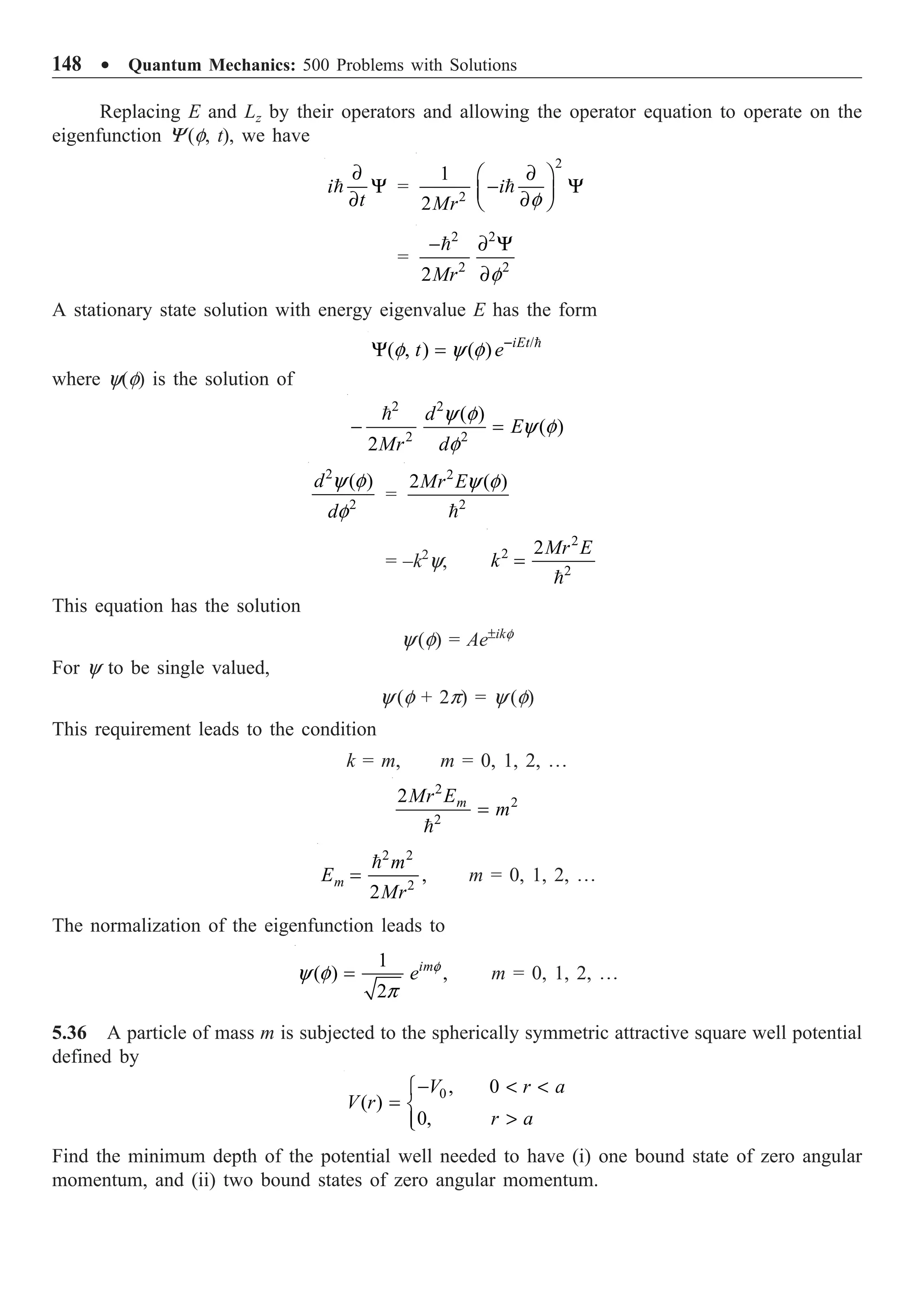
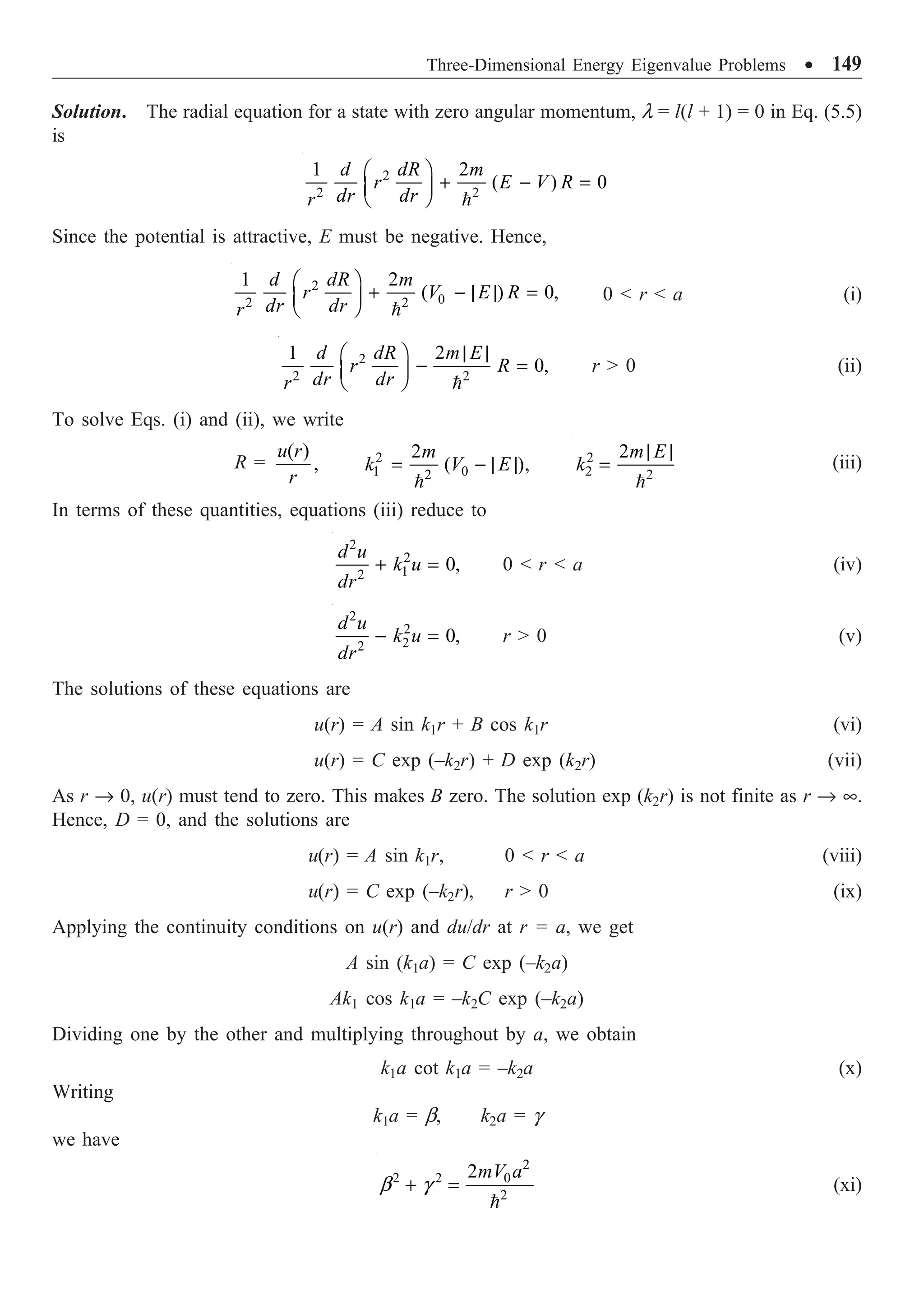
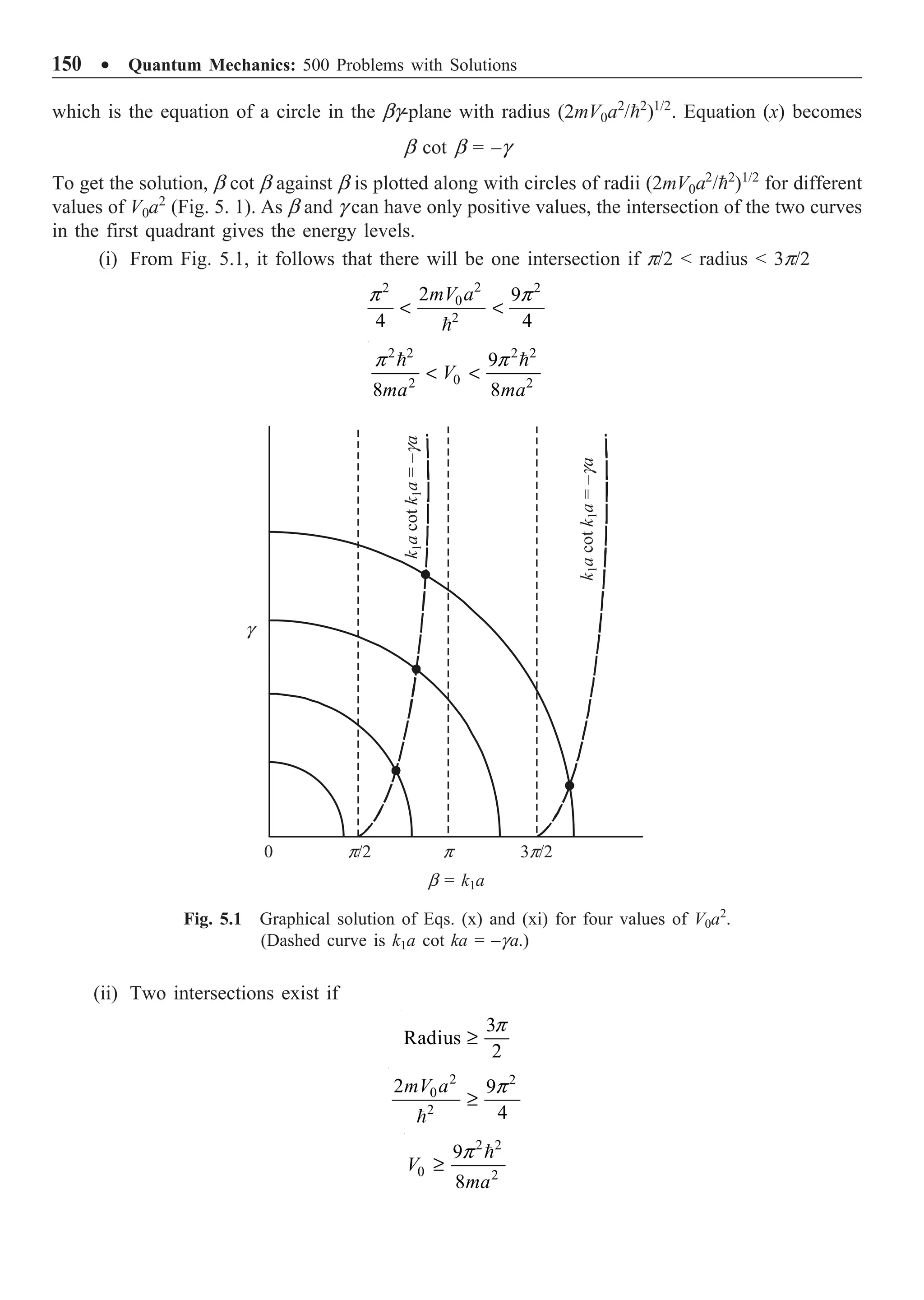
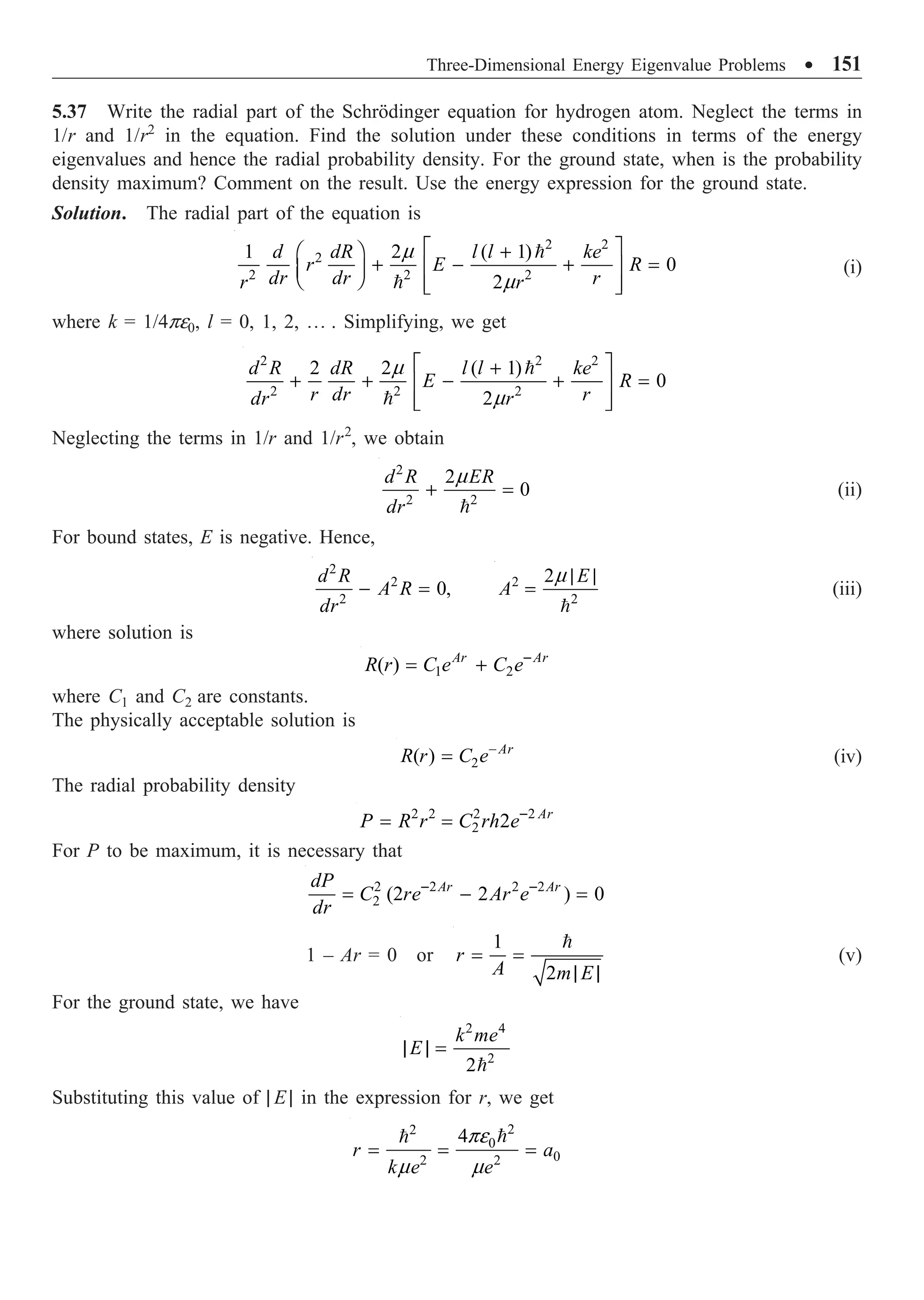
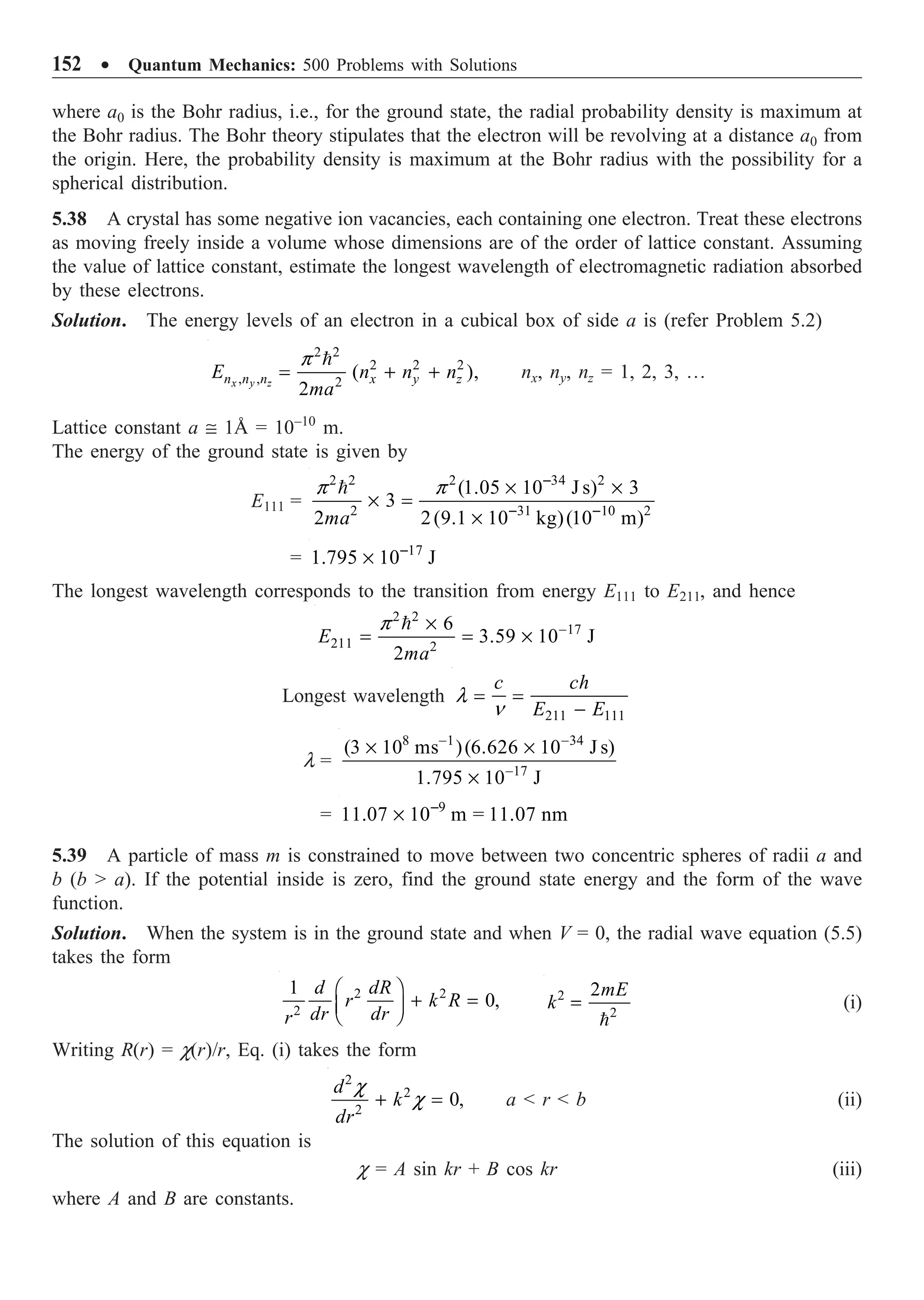
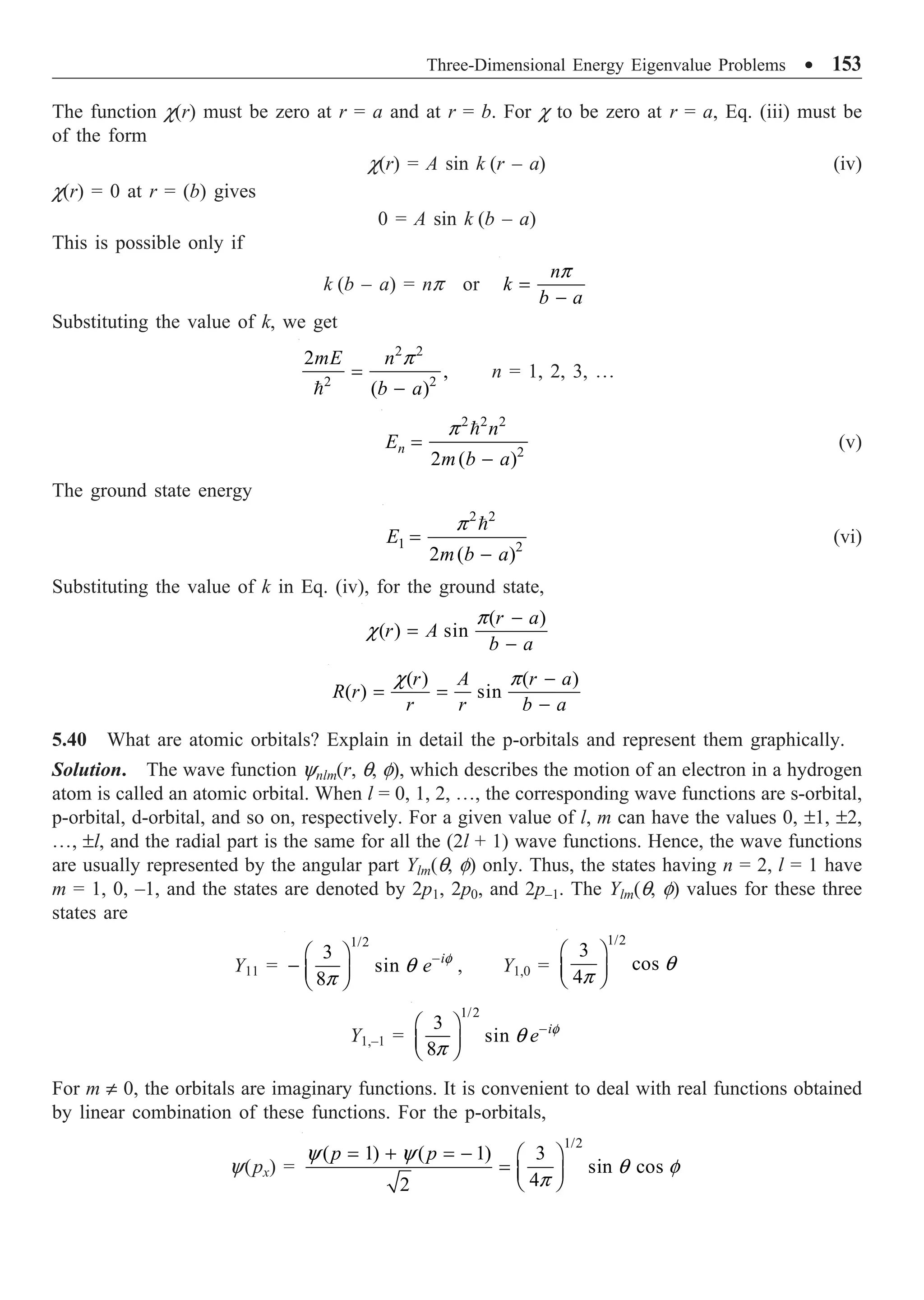
![154 ∑ Quantum Mechanics: 500 Problems with Solutions
y(py) =
1/2
[ ( 1) ( 1)] 3
sin sin
4
2
i p p
y y
q f
p
- = - = - Ê ˆ
= Á ˜
Ë ¯
1/2
0
3
( ) ( ) cos
4
z
p p
y y q
p
Ê ˆ
= = Á ˜
Ë ¯
The representations of orbitals are usually done in two ways: in one method, the graphs of
y(px), y(py) and y(pz) are plotted and, in the second approach, contour surfaces of constant
probability density are drawn. The representations of the angular part for the p-orbitals are shown
in Fig. 5.2. The plot of probability density has the cross-section of numeral 8.
Fig. 5.2 Representation of the angular part of wave function for p-orbitals;
(a) Plot of Ylm(q, f); (b) Plot of |Ylm(q, f)|2
.
Any axis ^ to x-axis
2px
x
– +
Any axis ^ to y-axis
2py
y
– +
Any axis ^ to z-axis
2pz
z
– +
(a) (b)
Each p-orbital is made of two lobes touching at the origin. The px-orbital is aligned along the
x-axis, the py-orbital along the y-axis, and the pz-orbital along the z-axis. The two lobes are separated
by a plane called nodal plane.
5.41 The first line in the rotation spectrum of CO molecule has a wave number of 3.8424 cm–1
.
Calculate the C — O bond length in CO molecule. The Avagadro number is 6.022 ¥ 1023
/mole.
Solution. The first line corresponds to the l = 0 to l = 1 transition. From Eq. (5.10),
2
1 0 2
E E
r
m
- =
or
2
2
h
r
n
m
=
p mn p mn
= =
2
2 2
4 4
h h
r
c
m = 23
23
(12 g/mol)(15.9949 g/mol)
1.1385 10 g
(27.9949 g/mol)(6.022 10 /mol)
-
= ¥
¥
= 26
1.1385 10 kg
-
¥
r2
=
34
2 26 1 8
6.626 10 J s
4 (1.1385 10 kg)(384.24 m )(3 10 m/s)
p
-
- -
¥
¥ ¥
= 1.2778 ¥ 10–20
m2
r = 1.13 ¥ 10–10
m](https://image.slidesharecdn.com/quantummechanics500problemswithsolutionspdfdrive-220626164912-635041ea/75/Quantum-Mechanics_-500-Problems-with-Solutions-PDFDrive-pdf-164-2048.jpg)

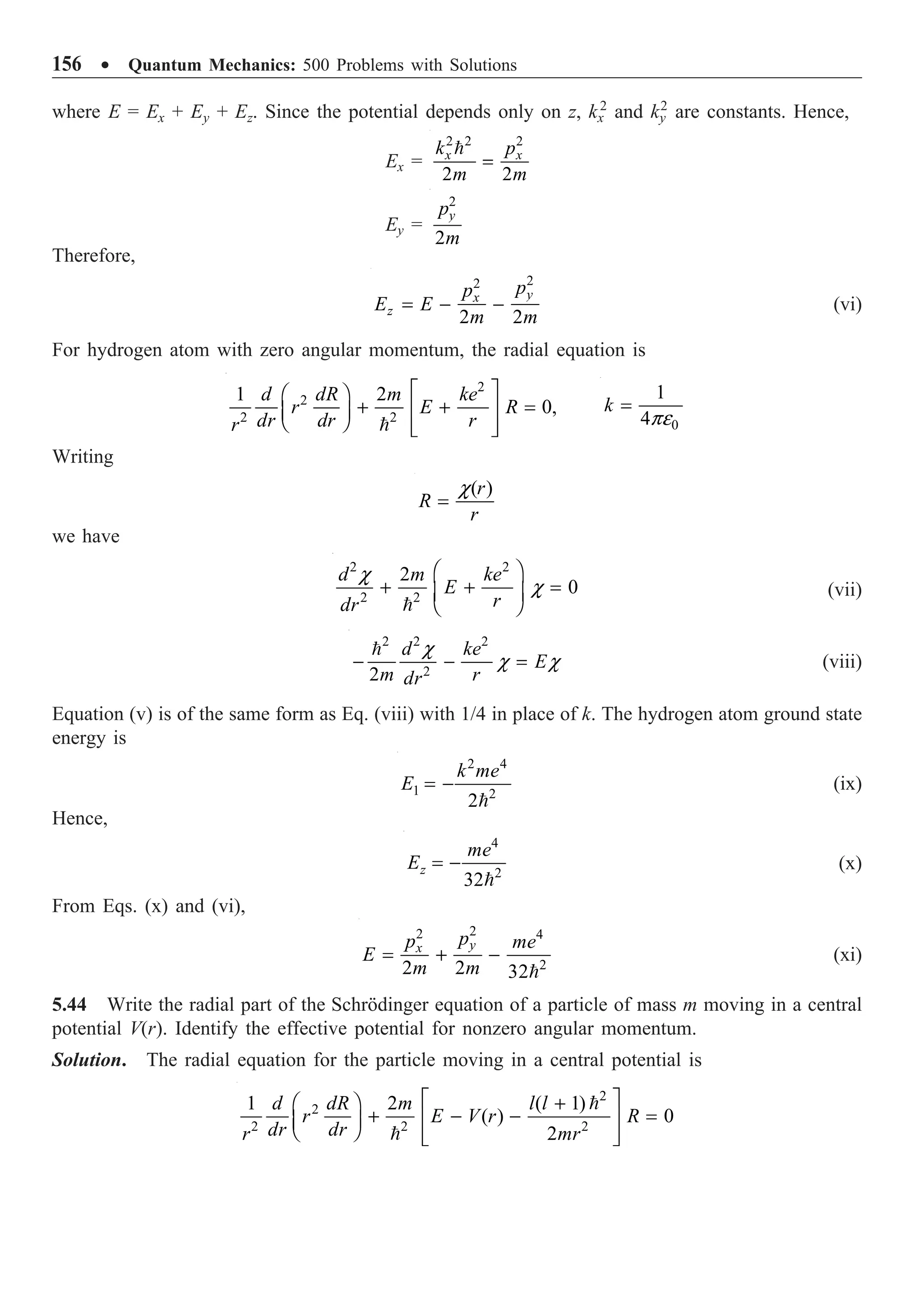
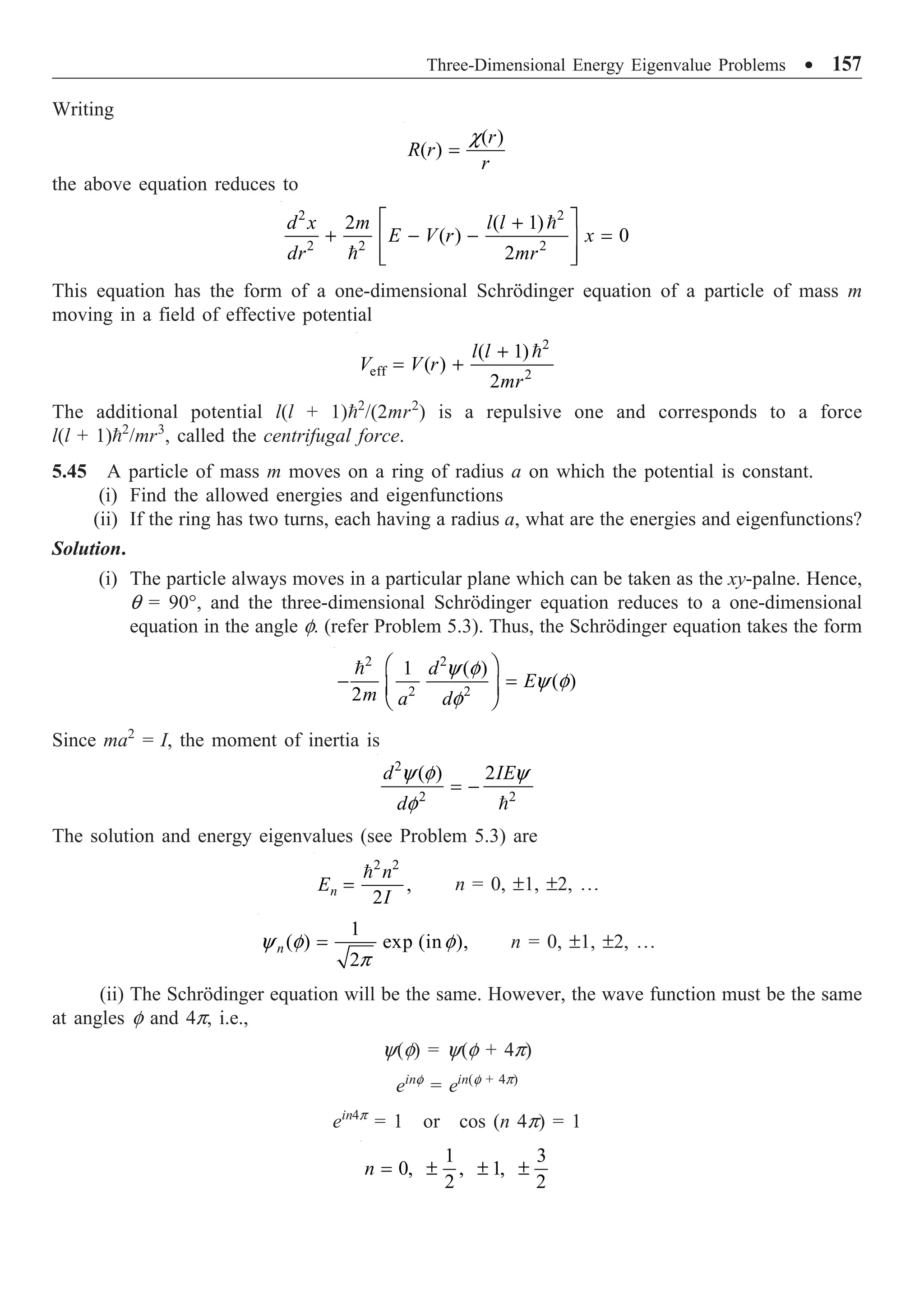
![158 ∑ Quantum Mechanics: 500 Problems with Solutions
Hence, the energy and wave function are
2 2
,
2
n
n
E
I
=
1
0, , 1,
2
n = ± ± …
yn = Aeinf
,
1
0, , 1,
2
n = ± ± …
Defining m = 2n, we get
2 2
,
8
m
m
E
I
=
m = 0, ±1, ±2, º
ym = exp [ ( /2) ]
A i m f , m = 0, ±1, ±2, º
Normalization gives
4
2
0
* 1
A d
p
f
| | Y Y =
Ú or
1
4
A
p
=
1
exp [ ( /2) ]
4
m i m
y f
p
=](https://image.slidesharecdn.com/quantummechanics500problemswithsolutionspdfdrive-220626164912-635041ea/75/Quantum-Mechanics_-500-Problems-with-Solutions-PDFDrive-pdf-168-2048.jpg)
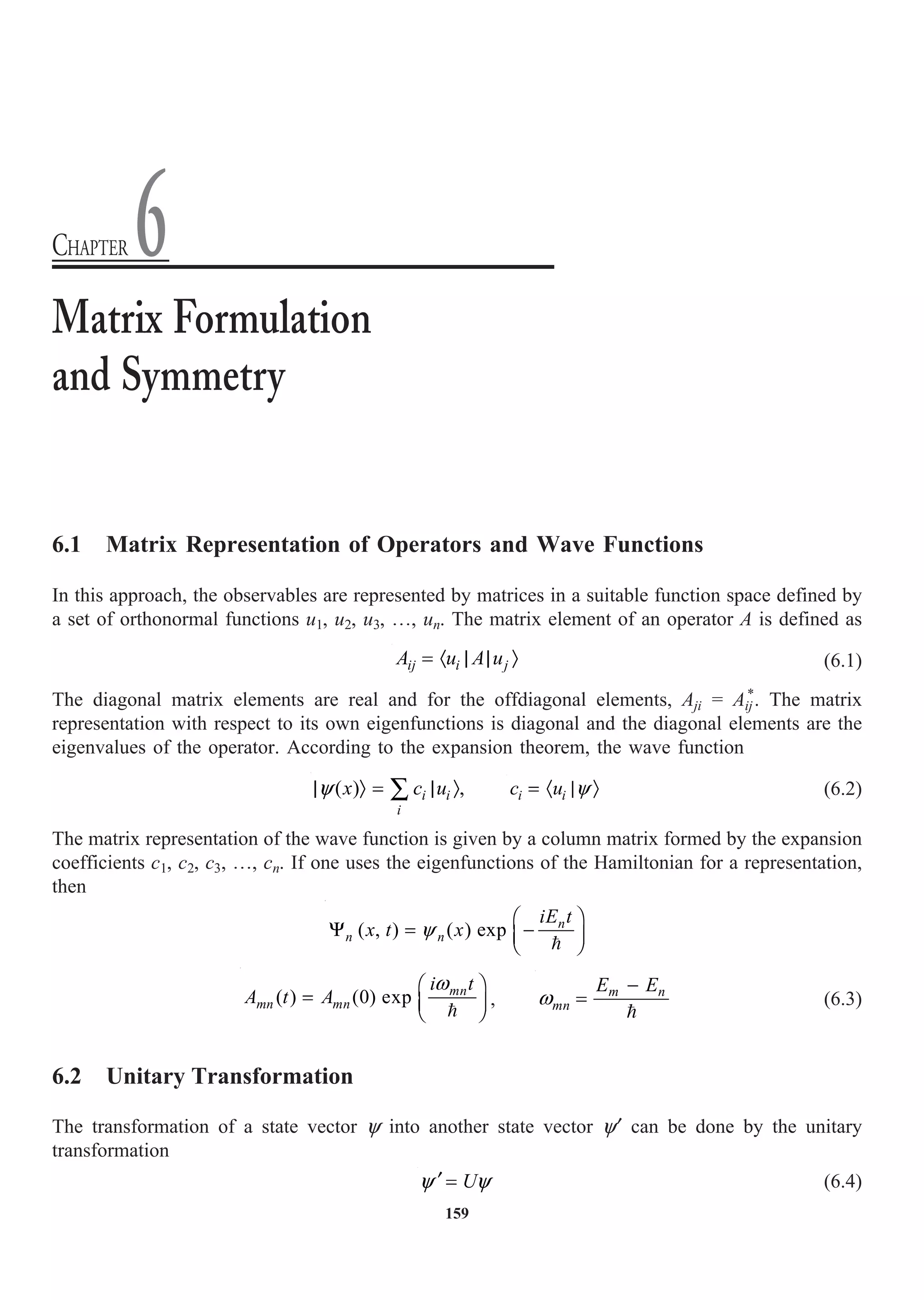
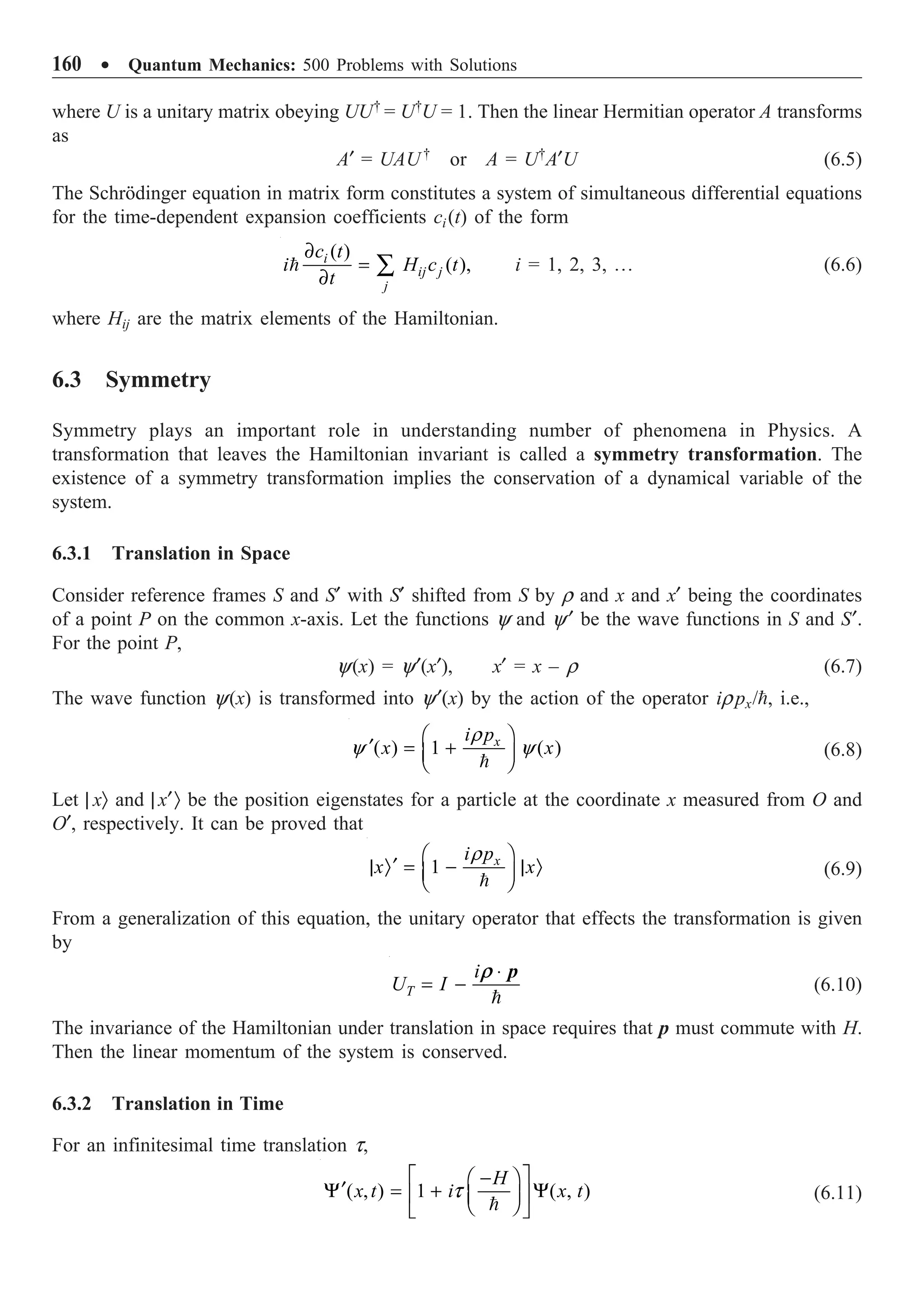
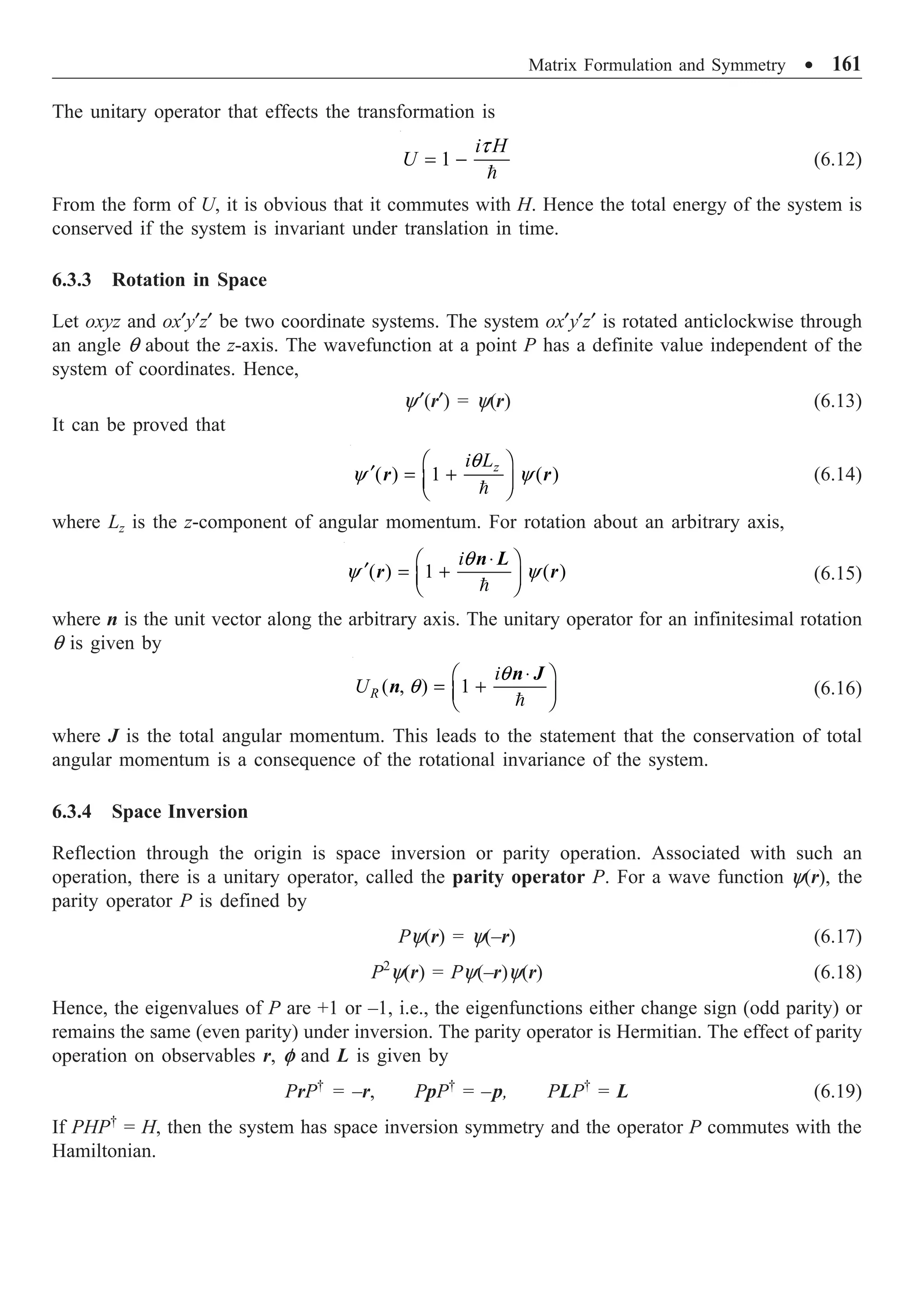
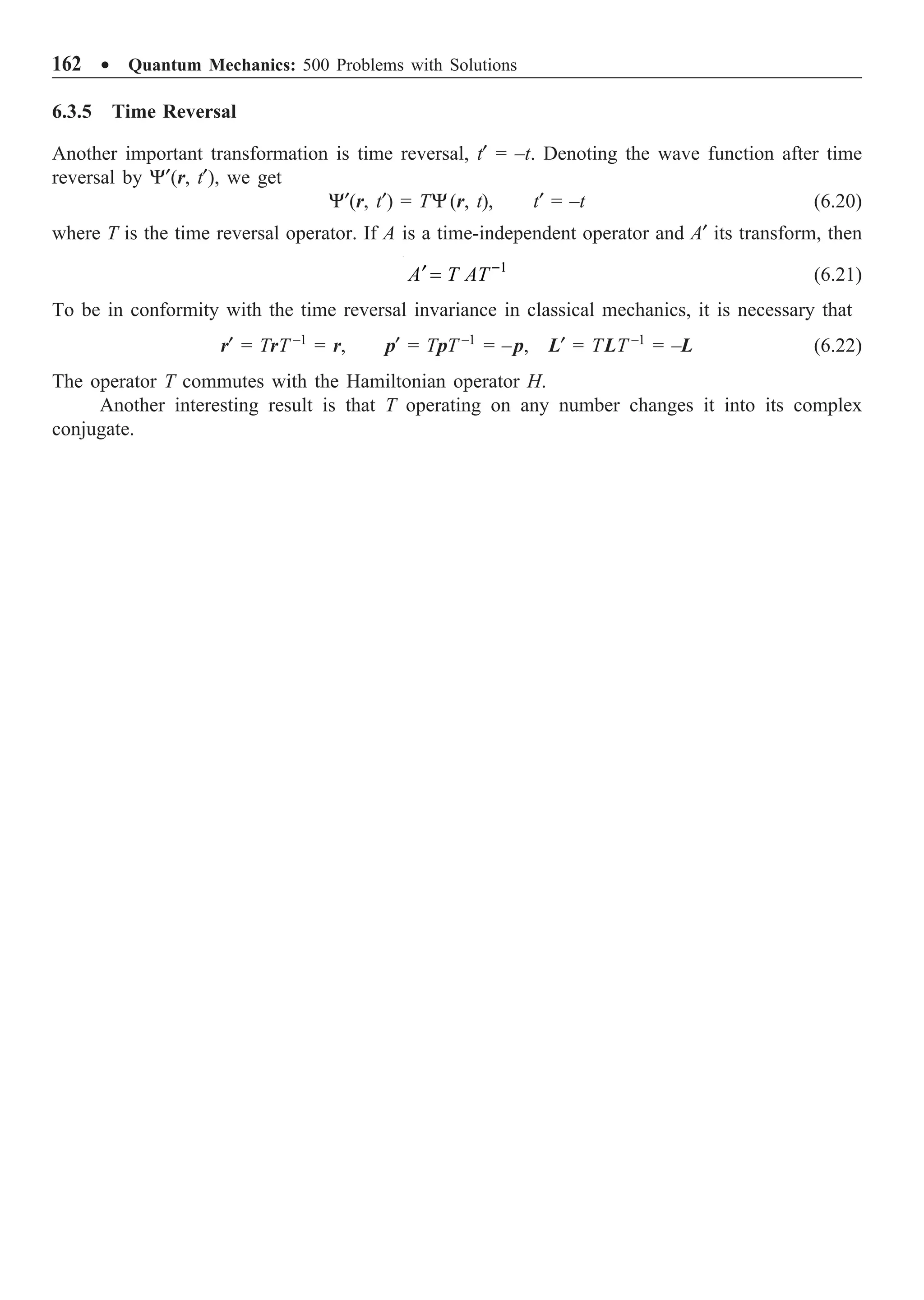
![Matrix Formulation and Symmetry ∑ 163
PROBLEMS
6.1 The base vectors of a representation are
1
0
Ê ˆ
Á ˜
Ë ¯
and
0
1
Ê ˆ
Á ˜
Ë ¯
. Construct a transformation matrix U
for transformation to another representation having the base vectors
1/ 2
1/ 2
Ê ˆ
Á ˜
Á ˜
Ë ¯
and
1/ 2
1/ 2
Ê ˆ
-
Á ˜
Á ˜
Ë ¯
Solution. The transformation matrix U must be such that
11 12
21 22
1/ 2 0
,
1
1/ 2
U U
U U
Ê ˆ Ê ˆ Ê ˆ
=
Á ˜ Á ˜ Á ˜
Á ˜ Ë ¯
Ë ¯
Ë ¯
11 12
21 22
1/ 2 0
1
1/ 2
U U
U U
Ê ˆ
- Ê ˆ Ê ˆ
=
Á ˜ Á ˜ Á ˜
Á ˜ Ë ¯
Ë ¯
Ë ¯
Solving we get
U11 = 1/ 2, U21 = 1/ 2, U12 = –1/ 2, U22 = 1/ 2
U =
1/ 2 1/ 2
,
1/ 2 1/ 2
Ê ˆ
-
Á ˜
Á ˜
Ë ¯
U†
=
1/ 2 1/ 2
1/ 2 1/ 2
Ê ˆ
Á ˜
Á ˜
-
Ë ¯
It follows that UU†
= 1. Hence U is unitary.
6.2 Prove that the fundamental commutation relation [x, px] = i remains unchanged under unitary
transformation.
Solution. Let U be the unitary operator that effects the transformation. Then,
x¢ = UxU†
, p¢x = UpxU†
[x¢, p¢x] = x¢p¢
x – p¢
x x¢
= (UxU†
) (UpxU†
) – (UpxU†
) (UxU†
)
= UxpxU†
– Upx xU†
= U(xpx – pxx) U†
= UiU†
= iUU†
= i
Hence the result.
6.3 The raising (a†
) and lowering (a) operators of harmonic oscillator satisfy the relations
a | nÒ = 1
n n
| - Ò , a†
n
| Ò = 1 1 ,
n n
+ | + Ò n = 0, 1, 2, …
Obtain the matrices for a and a†
.
Solution. Multiplying the first equation from left by ·n¢|, we get
, 1
1 n n
n a n n n n nd ¢ -
¢ ¢
· | | Ò = · | - Ò =
This equation gives the matrix elements of a. Hence,
·0 | a | 1Ò = 1, ·1 | a | 2Ò = 2, ·2 | a | 3Ò = 3, …](https://image.slidesharecdn.com/quantummechanics500problemswithsolutionspdfdrive-220626164912-635041ea/75/Quantum-Mechanics_-500-Problems-with-Solutions-PDFDrive-pdf-173-2048.jpg)
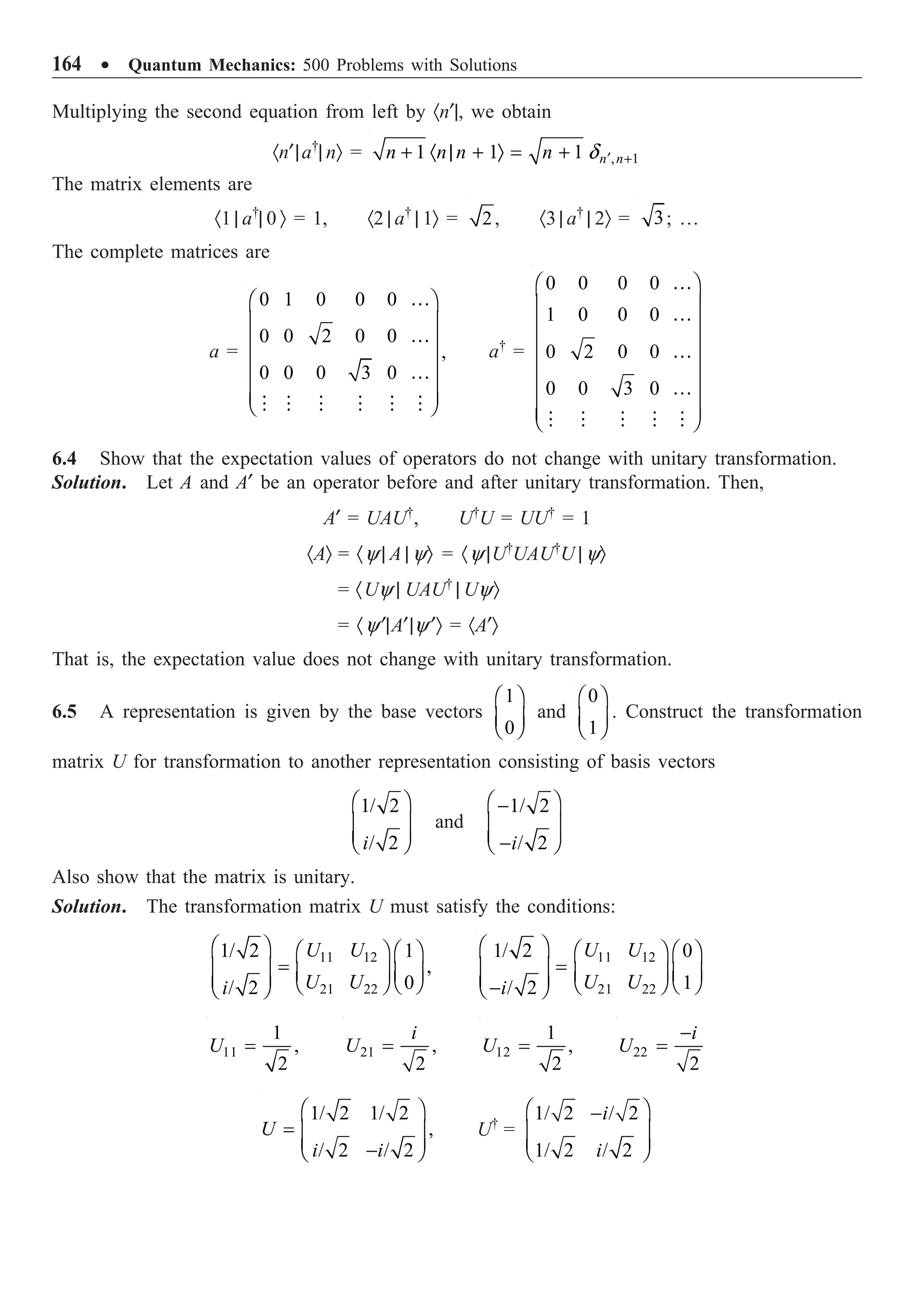
![Matrix Formulation and Symmetry ∑ 165
UU†
=
1/ 2 1/ 2 1/ 2 / 2 1 0
0 1
/ 2 / 2 1/ 2 / 2
i
i i i
Ê ˆ Ê ˆ
- Ê ˆ
=
Á ˜ Á ˜ Á ˜
Á ˜ Á ˜ Ë ¯
-
Ë ¯ Ë ¯
Thus, U is unitary.
6.6 For 2 ¥ 2 matrices A and B, show that the eigenvalues of AB are the same as those of BA.
Solution.
A =
11 12
21 22
,
a a
a a
Ê ˆ
Á ˜
Ë ¯
B =
11 12
21 22
b b
b b
Ê ˆ
Á ˜
Ë ¯
AB =
11 11 12 21 11 12 12 22
21 11 22 21 21 12 22 22
a b a b a b a b
a b a b a b a b
+ +
Ê ˆ
Á ˜
+ +
Ë ¯
The characteristic equation of AB is given by
11 11 12 21 11 12 12 22
21 11 22 21 21 12 22 22
0
a b a b a b a b
a b a b a b a b
l
l
+ - +
=
+ + -
2
Tr ( ) 0
AB AB
l l
- + | | =
Since | AB | = | A || B |, | AB | = | BA |. As Tr (AB) = Tr (BA), the characteristic equation for AB is the
same as the characteristic equation for BA. Hence, the eigenvalues of AB are the same these of BA.
6.7 Prove the following: (i) the scalar product is invariant under a unitary transformation; (ii) the
trace of a matrix is invariant under unitary transformation; and (iii) if [A, B] vanishes in one
representation, it vanishes in any other representation.
Solution.
(i) † † †
A U UAU U U UAU U A
f y f y f y f y
¢ ¢ ¢
· | | Ò = · | | Ò = · | | Ò = · | | Ò
Setting A = I, the above equation reduces to
f y f y
¢ ¢
· | Ò = · | Ò
i.e., the scalar product is invariant under unitary transformation.
(ii) Amm = † † †
m m m m m m
A U UAU U U UAU U
y y y y y y
· | | Ò = · | | Ò = · | | Ò
= m m mn
A A
y y
¢ ¢ ¢ ¢
· | | Ò =
Thus,
mm mn
m m
A A¢
=
 Â
In other words, the trace is invariant under a unitary transformation.
(iii) A¢B¢ – B¢A¢ = UAU†
UBU†
– UBU†
UAU†
= UABU†
– UBAU†
= U(AB – BA)U†
If AB – BA = 0, then A¢B¢ – B¢A¢. Hence the result.](https://image.slidesharecdn.com/quantummechanics500problemswithsolutionspdfdrive-220626164912-635041ea/75/Quantum-Mechanics_-500-Problems-with-Solutions-PDFDrive-pdf-175-2048.jpg)
![166 ∑ Quantum Mechanics: 500 Problems with Solutions
6.8 Show that a linear transformation which preserves length of vectors is represented by an
orthogonal matrix.
Solution. Let x and x¢ be the n-dimensional and transformed vectors, respectively. Then,
x¢ = Ax, 2 2
1 1
n n
i i
i i
x x
= =
¢ =
 Â
where A is the n ¥ n transformation matrix. Substituting the value of x¢i, we get
2
1 1
n n
ij j ik k i
i j k i
A x A x x
= =
Ê ˆ Ê ˆ
=
Á ˜ Á ˜
Ë ¯
Ë ¯
   Â
2
1 1 1 1
n n n n
ij ik j k i
i j k i
A A x x x
= = = =
=
   Â
This equation, to be valid, it is necessary that
1
n
ij ik jk
i
A A d
=
=
 or (A¢A)jk = djk
where A¢ is the transpose of the matrix A. Therefore, A is an orthogonal matrix.
6.9 Prove that the parity of spherical harmonics Yl,m (q, f) is (–1)l
.
Solution. When a vector r is reflected through the origin, we get the vector –r. In spherical polar
coordinates, this operation corresponds to the following changes in the angles q and f, leaving r
unchanged:
q Æ (p – q) and f Æ (f + p)
We have
Yl, m(q, f) = CPl
m
(cos q) exp (imf), C being constant
Yl, m (p – q, f + p) = CPl
m
[cos (p – q)] exp [im (f + p)]
= CPl
m
(–cos q) exp (imf) exp (imp)
= CPl
m
(cos q)(–1)l+m
exp (imf)(–1)m
= (–1)l
Yl,m (q, f)
During simplification we have used the result Pn
m
(–x) = (–1)n + m
Pn
m
(x). That is, the parity of spherical
harmonics is given by (–1)l
.
6.10 If y+(r) and y–(r) are the eigenfunctions of the parity operator belonging to even and odd
eigenstates, show that they are orthogonal.
Solution. From definition we have
Py+(r) = y+(r), Py–(r) = –y–(r)
·y+(r) | y–(r)Ò = ·y+(r) | PP | y–(r)Ò
Here, we have used the result P2
= 1. Since P is Hermitian,
·y+(r) | y–(r)Ò = ·Py+(r) | P | y–(r)Ò = – ·y+(r) | y–(r)Ò](https://image.slidesharecdn.com/quantummechanics500problemswithsolutionspdfdrive-220626164912-635041ea/75/Quantum-Mechanics_-500-Problems-with-Solutions-PDFDrive-pdf-176-2048.jpg)
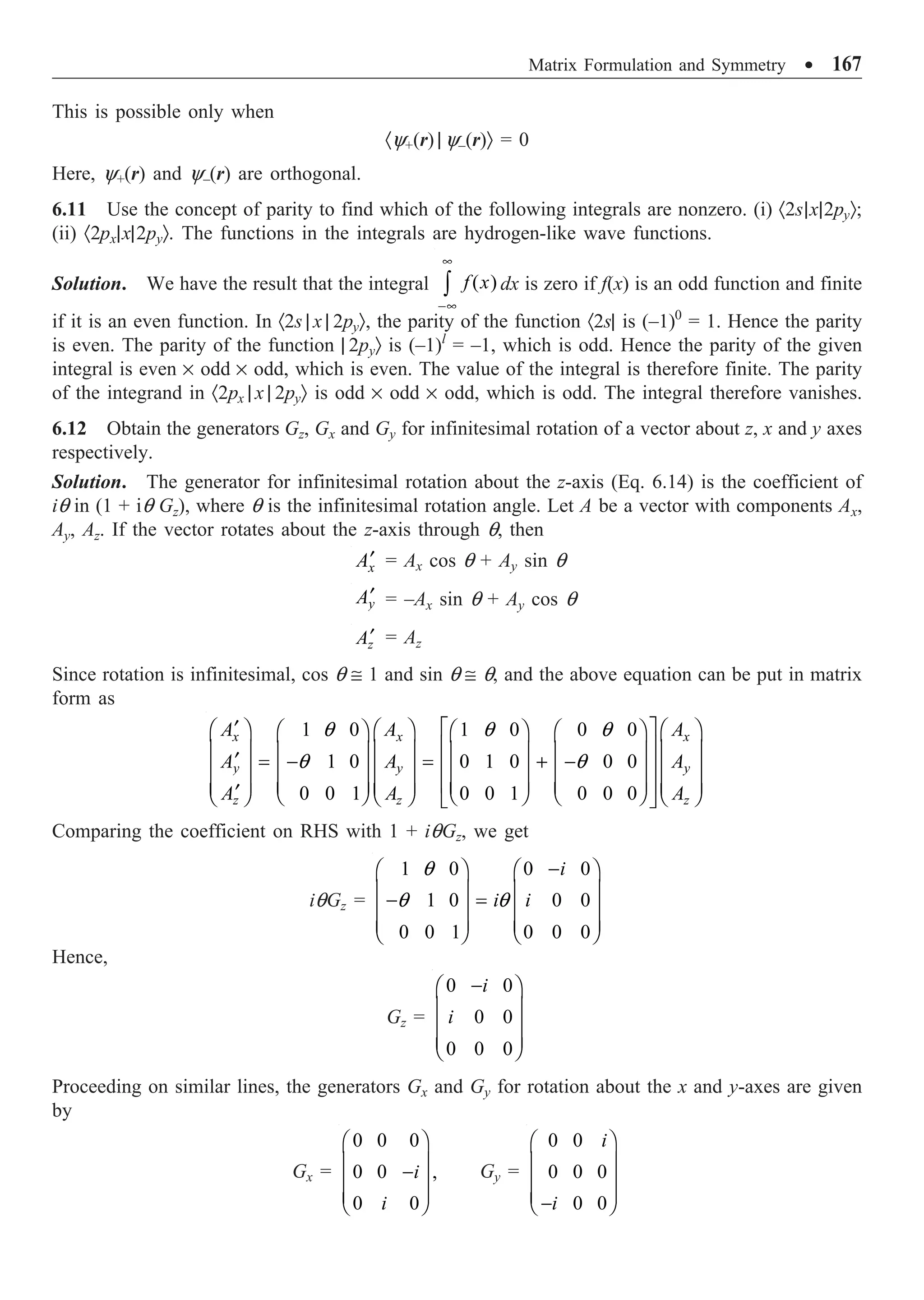
![168 ∑ Quantum Mechanics: 500 Problems with Solutions
6.13 Prove that the parity operator is Hermitian and unitary.
Solution. For any two wave functions y1(r) and y2(r), we have
y y y y
• •
-• -•
= -
Ú Ú
1 2 1 2
* *
( ) ( ) ( ) ( ) ( )
d d d
r r r r r r r
P
On the RHS, changing the variable r to –r, we get
y y
•
-•
Ú 1 2
*( ) ( ) d
r r r
P = 1 2
*( ) ( ) ( )
d
y y
-•
•
- -
Ú r r r
= 1 2
*( ) ( ) d
y y
•
-•
-
Ú r r r
=
*
1 2
[ ( )] ( ) d
y y
•
-•
Ú r
P r r
Hence the operator P is Hermitian, i.e., P = P†
. We have P2
= 1 or PP†
= 1. Thus, P is unitary.
6.14 Use the concept of parity to find which of the following integrals are nonzero: (i) ·2s| x2
| 2pxÒ;
(ii) ·2px | x2
| 2pxÒ; and (iii) ·2p| x |3dÒ. The functions in the integrals are hydrogen-like wave functions.
Solution.
(i) ·2s| x2
| 2pxÒ.
The parity of the integrand is even ¥ even ¥ odd = odd. Hence the integral vanishes
(ii) ·2px | x2
| 2pxÒ.
The parity of the integrand is odd ¥ even ¥ odd = even. Hence the integral is finite.
(iii) ·2p| x |3dÒ.
The parity of the integrand is odd ¥ odd ¥ even = even. Hence the integral is finite.
6.15 For a spinless particle moving in a potential V(r), show that the time reversal operator T
commutes with the Hamiltonian.
Solution.
2
( )
2
p
H V r
m
= +
From Eq. (6.22),
TrT–1
= r
Multiplying by T from RHS, we get
TrT–1
T = rT or Tr = rT
Using the relations Tr = rT and Tp = –pT, we obtain
TH =
2
( )
2 2
p pTp
T TV r VT
m m
-
+ = +
=
2
2
p
T VT HT
m
+ =
[T, H] = 0](https://image.slidesharecdn.com/quantummechanics500problemswithsolutionspdfdrive-220626164912-635041ea/75/Quantum-Mechanics_-500-Problems-with-Solutions-PDFDrive-pdf-178-2048.jpg)
![Matrix Formulation and Symmetry ∑ 169
6.16 Show that the time reversal operator operating on any number changes it into its complex
conjugate.
Solution. From Eq. (6.22),
x¢ = TxT–1
= x, px
¢ = TpxT–1
= –p (i)
We now evaluate the fundamental commutation relation [x¢, px
¢]:
[x¢, px
¢] = [TxT–1
, TpxT–1
] = [x, –px] = –i (ii)
The value of [x¢, px
¢] can also be written as
[x¢, px
¢] = T [x, px]T–1
= T(i)T–1
(iii)
From Eqs. (ii) and (iii),
T(i)T–1
= –i
which is possible only if T operating on any number changes it into its complex conjugate.
6.17 For a simple harmonic oscillator, w is the angular frequency and xnl(0) is the nlth matrix
element of the displacement x at time t = 0. Show that all matrix elements xnl(0) vanish except those
for which the transition frequency wnl = ±w, where wnl = (En – El)/.
Solution. The Hamiltonian of a simple harmonic oscillator is
2
2 2
1
2 2
p
H m x
m
w
= + (i)
The equation of motion for the operator x in the Heisenberg picture is
dx
i
dt
= [x, H] = 2 2 2
1 1
[ , ] [ , ]
2 2
x p m x x
m m
w
+
=
1
( [ , ] [ , ] )
2
p x p x p p
m
+
= ( )
2
i p
p p i
m m
+ =
x
=
p
m
(ii)
Similarly,
2
p m x
w
= -
(iii)
Differentiating Eq. (i) with respect to t and substituting the value of p
from Eq. (ii), we obtain
2
0
x x
w
+ =
(iv)
In matrix form,
2
0
nl nl
x x
w
+ =
(v)
From Eq. (6.3),
( ) (0) exp( )
nl nl nl
x t x i t
w
= (vi)
Differentiaing twice with respect to t, we get
2 2
( ) (0) exp( ) ( )
nl nl nl nl nl nl
x t x i t x t
w w w
= - = -
(vii)](https://image.slidesharecdn.com/quantummechanics500problemswithsolutionspdfdrive-220626164912-635041ea/75/Quantum-Mechanics_-500-Problems-with-Solutions-PDFDrive-pdf-179-2048.jpg)
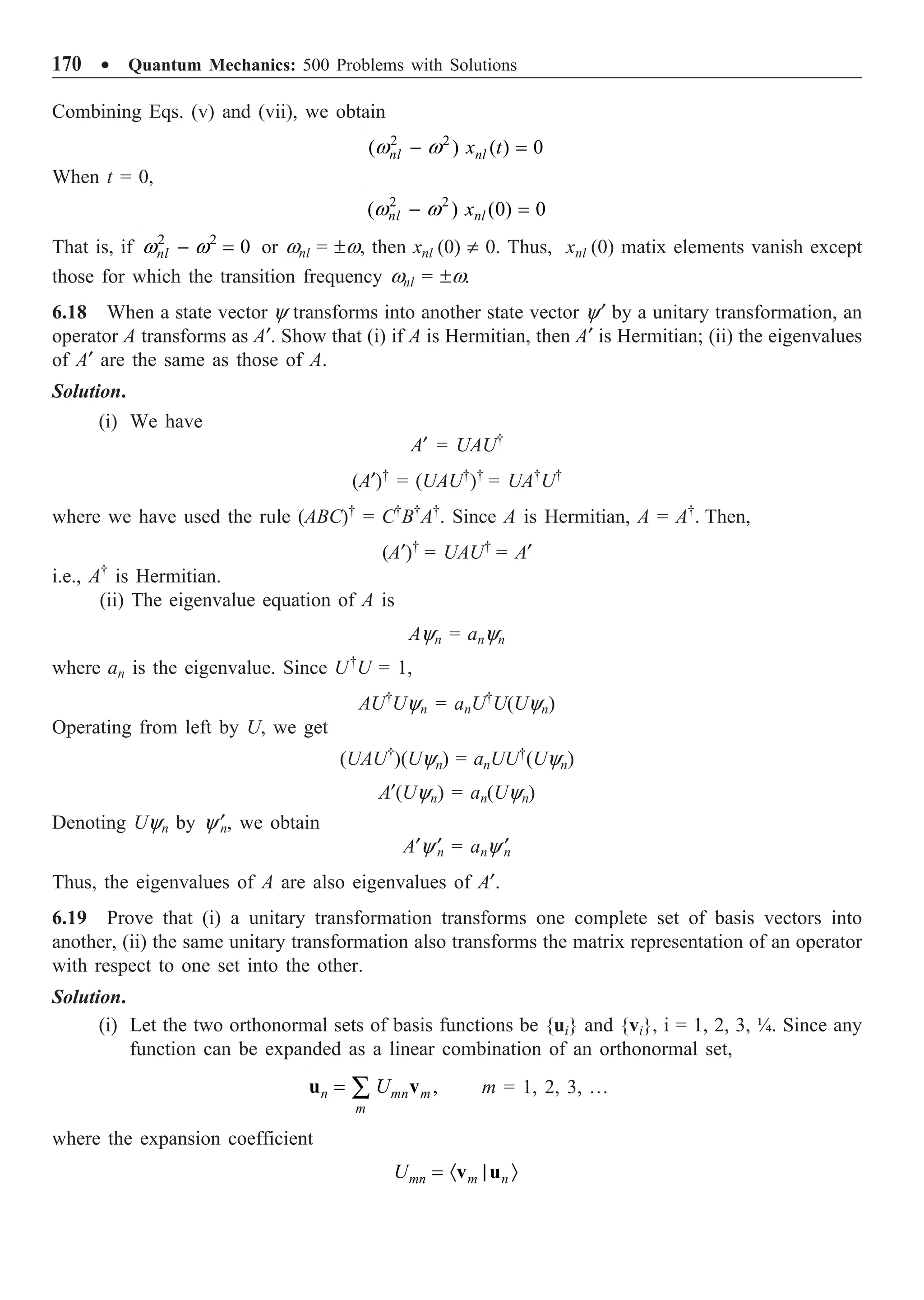
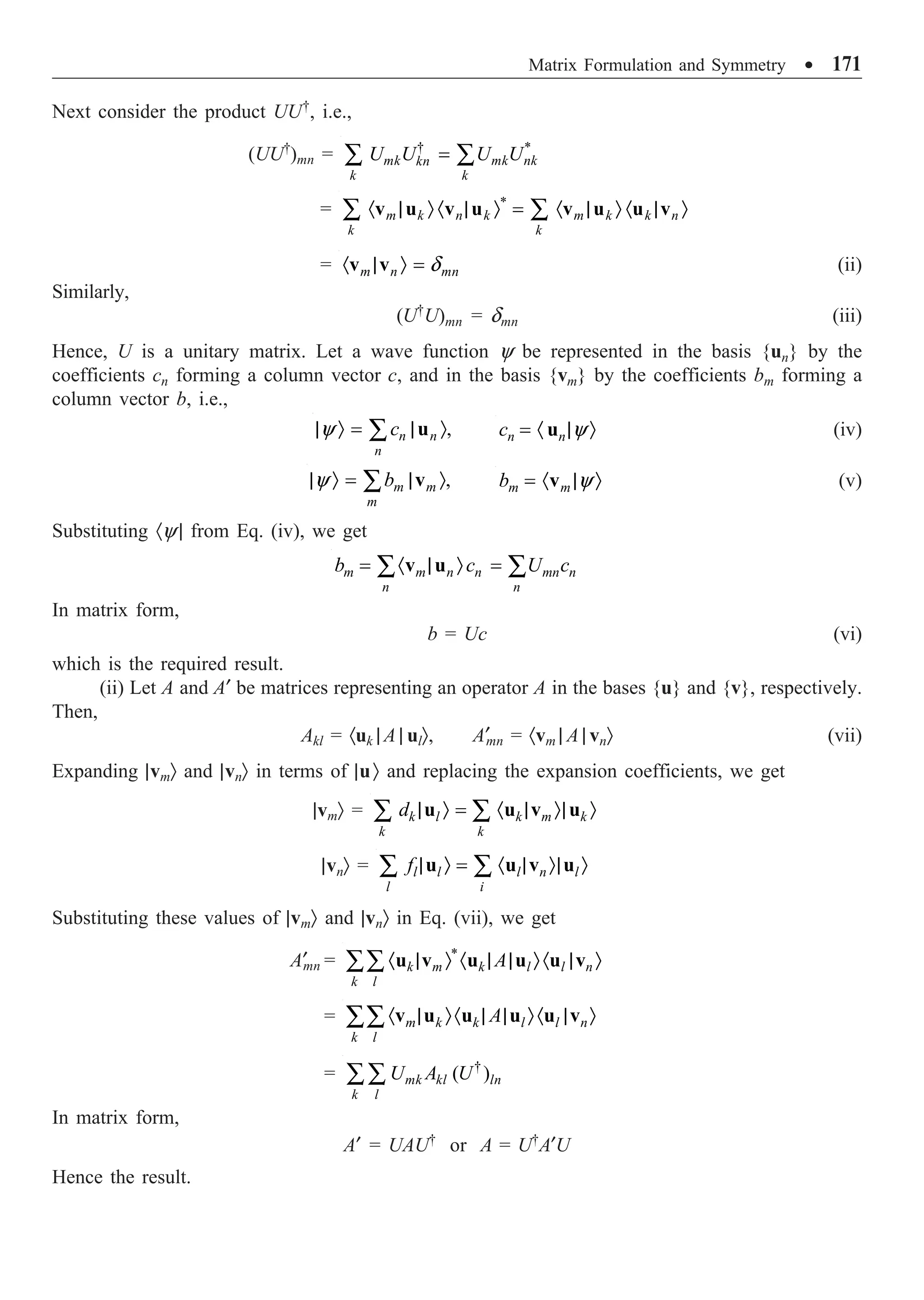
![172 ∑ Quantum Mechanics: 500 Problems with Solutions
6.20 (i) Evaluate the fundamental commutation relation [x¢, p¢
x], where x¢ and p¢ are the coordinate
and momentum after time reversal. (ii) Find the form of the time-dependent Schrödinger equation
after time reversal (t Æ t¢ = –t).
Solution.
(i) The commutator is evaluated in Problem 6.16, Hence,
[x¢, p¢
x] = 1 1
[ , ]
x
TxT Tp T
- -
= [ , ]
x
x p i
- = - (i)
(ii) The time-independent Schrödinger equation of a particle moving in a potential V(r) is
( , )
( , )
t
i H t
t
∂Y
= Y
∂
r
r (ii)
Since T commutes with the Hamiltonian H,
( , )
( , )
t
T i HT t
t
∂Y
È ˘
= Y
Í ˙
∂
Î ˚
r
r (iii)
T operating on any number changes it into its complex conjugate. Hence, T(i)T–1
= –i, i.e.,
T(i) = –iT. Equation (iii) now reduces to
( , ) ( , )
i t H t
t
∂
¢ ¢ ¢ ¢
- Y = Y
¢
∂
r r
( , ) ( , )
i t H t
t
∂
¢ ¢ ¢ ¢
Y = Y
∂
r r
That is, the Schrödinger equation satisfied by the time reversed function Y¢(r, t¢) has the same form
as the original one.
6.21 Consider two coordinate systems oxyz and ox¢y¢z¢. The system ox¢y¢z¢ is rotated anticlockwise
through an infinitesimal angle q about an arbitrary axis. The wave functions y(r) and y¢(r) are the
wave functions of the same physical state referred to oxyz and ox¢y¢z¢ and is related by the equation
( ) ( )
i
r I
q
y y
Ê ˆ
¢ = + ◊
Á ˜
Ë ¯
n J r
where n is the unit vector along the arbitrary axis and J is the total angular momentum. Find the
condition for the Hamiltonian H to be invariant under the transformation.
Solution. The operator that effects the transformation is
U =
i
I
q
+ ◊
n J
H¢ = UHU†
=
i i
I H I
q q
Ê ˆ Ê ˆ
+ ◊ - ◊
Á ˜ Á ˜
Ë ¯ Ë ¯
n J n J
= ( )
i
H H H
q
+ ◊ -
n J J
= [ , ]
i
H H
q
+ ◊
n J](https://image.slidesharecdn.com/quantummechanics500problemswithsolutionspdfdrive-220626164912-635041ea/75/Quantum-Mechanics_-500-Problems-with-Solutions-PDFDrive-pdf-182-2048.jpg)
![Matrix Formulation and Symmetry ∑ 173
For H to be invariant under the transformation, H¢ = H. This is possible only when [J, H] = 0, i.e.,
the total angular momentum must commute with the Hamiltonian. In other words, the total angular
momentum must be a constant of motion.
6.22 Show that the parity operator commutes with the orbital angular momentum operator.
Solution. Let P be the parity operator and L = r ¥ p be the orbital angular momentum operator.
Consider an arbitrary wave function f(r). Then,
PLf(r) = P(r ¥ p) f(r)
= (–r) ¥ (–p) f(–r)
= (r) ¥ (p) f(–r)
= LPf(r)
(PL – LP) f(r) = 0
Thus, P commutes with L.
6.23 A real operator A satisfies the equation
A2
– 5A + 6 = 0
(i) What are the eigenvalues of A?
(ii) What are the eigenvectors of A;
(iii) Is A an observable?
Solution.
(i) As A satisfies a quadratic equation, it will have two eigenvalues. Hence it can be
represented by a 2 ¥ 2 matrix. Its eigenvalues are the roots of the equation
l2
– 5l + 6 = 0
Solving, we get
(l – 3) (l – 2) = 0 or l = 2 or 3
The simplest 2 ¥ 2 matrrix with eigenvalues 2 and 3 is
A =
2 0
0 3
Ê ˆ
Á ˜
Ë ¯
(ii) The eigenvalue equation corresponding to the eigenvalue 2 is
1 1
2 2
2 0
2
0 3
a a
a a
Ê ˆ Ê ˆ
Ê ˆ
=
Á ˜ Á ˜
Á ˜
Ë ¯ Ë ¯ Ë ¯
which leads to a1 = 1, a2 = 0. The other eigenvalue 3 leads to a1 = 0, a2 = 1, i.e., the eigenvectors
are
1
0
Ê ˆ
Á ˜
Ë ¯
and
0
1
Ê ˆ
Á ˜
Ë ¯
(iii) Since A = A†
, the matrix A is Hermitian. Hence, it is an observable.](https://image.slidesharecdn.com/quantummechanics500problemswithsolutionspdfdrive-220626164912-635041ea/75/Quantum-Mechanics_-500-Problems-with-Solutions-PDFDrive-pdf-183-2048.jpg)
![174 ∑ Quantum Mechanics: 500 Problems with Solutions
6.24 The ground state wave function of a linear harmonic oscillator is
2
0 ( ) exp
2
m x
x A
w
y
Ê ˆ
= -
Á ˜
Ë ¯
where A is a constant. Using the raising and lowering operators, obtain the wave function of the first
excited state of the harmonic oscillator.
Solution. The lowering (a) and raising (a†
) operators are defined by
1
2 2
m
a x i p
m
w
w
= +
(i)
† 1
2 2
m
a x i p
m
w
w
= -
(ii)
From the definition, it is obvious that
[a, a†
] = 1, a†
a =
1
2
H
w
-
(iii)
Allowing the Hamiltonian to operate on a†
| 0 Ò and using Eq. (iii), we have
Ha†
| 0 Ò =
† †
1
0
2
a a a
w
Ê ˆ
+ | Ò
Á ˜
Ë ¯
= † † †
1
0 0
2
a aa a
w w
| Ò + | Ò
Since [a, a†
] = 1 or aa†
= a†
a + 1,
Ha†
| 0 Ò = † † †
1
( 1) 0 0
2
a a a a
w w
+ | Ò + | Ò
= † † † †
1
0 0 0
2
a a a a a
w w w
| Ò + | Ò + | Ò
= †
3
0 0
2
a
w
+ | Ò
Hence,
| 1 Ò = † 1
0 0
2 2
m
a x i p
m
w
w
È ˘
| Ò = - | Ò
Í ˙
Í ˙
Î ˚
=
2
/2 2
exp( /2 )
2 2
m x
m d
A xe A m x
dx
m
w
w
w
w
-
- -
=
2
2
exp
2 2
m m x
A x
w w
Ê ˆ
-
Á ˜
Ë ¯](https://image.slidesharecdn.com/quantummechanics500problemswithsolutionspdfdrive-220626164912-635041ea/75/Quantum-Mechanics_-500-Problems-with-Solutions-PDFDrive-pdf-184-2048.jpg)
![Matrix Formulation and Symmetry ∑ 175
6.25 If Em and En are the energies corresponding to the eigenstates | m Ò and | n Ò, respectively, show
that
2
2
( )
2
m n
n
E E m x n
M
- |· | | Ò| = -
Â
where M is the mass of the particle.
Solution.
[[H, x], x] = Hx2
– 2xHx + x2
H
·m | [[H, x], x] | mÒ = ·m | Hx2
| mÒ – 2·m | xHx | mÒ + ·m | x2
H | mÒ
= Em ·m | x2
| mÒ – 2·m | xHx | mÒ + Em ·m | x2
| mÒ
= 2Em ·m | x2
| mÒ – 2·m | xHx | mÒ
where the Hermitian property of H is used. Now,
·m | x2
| mÒ =
n
m x n n x m
· | | Ò · | | Ò
Â
= 2
n
m x n
|· | | Ò|
Â
·m | xHx | mÒ =
n
m xH n n x m
· | | Ò · | | Ò
Â
= 2
n
n
E m x n
|· | | Ò|
Â
Hence,
·m | [[H, x], x] | mÒ = 2
2 ( )
m n
n
E E m x n
- |· | | Ò|
Â
For the Hamiltonian,
H =
2
( )
2
p
V x
M
+
[H, x] = 2
1
[ , ] [ ( ), ]
2
p x V x x
M
+
=
1 1
[ , ] [ , ]
2 2
i p
p p x p x p
M M M
+ = -
[[H, x], x] =
2
[ , ]
i
p x
M M
- = -
Equating the two relations, we get
2
2
( )
2
m n
n
E E m x n
M
- |· | | Ò| = -
Â](https://image.slidesharecdn.com/quantummechanics500problemswithsolutionspdfdrive-220626164912-635041ea/75/Quantum-Mechanics_-500-Problems-with-Solutions-PDFDrive-pdf-185-2048.jpg)
![176
Angular momentum is an important and interesting property of physical systems, both in classical
and quantum mechanics. In this chapter, we consider the operators representing angular momentum,
their eigenvalues, eigenvectors and matrix representation, we also discuss the concept of an intrinsic
angular momentum, called spin, and the addition of angular momenta.
7.1 Angular Momentum Operators
Replacing px, py and pz by the respective operators in angular momentum L = r ¥ p, we can get the
operators for the components Lx, Ly and Lz, i.e.,
x
L i y z
dz dy
∂ ∂
Ê ˆ
= - -
Á ˜
Ë ¯
(7.1)
y
L i z x
dx dz
∂ ∂
Ê ˆ
= - -
Á ˜
Ë ¯
(7.2)
z
L i x y
dy dx
∂ ∂
Ê ˆ
= - -
Á ˜
Ë ¯
(7.3)
Instead of working with Lx and Ly, it is found convenient to work with L+ and L– defined by
L+ = Lx + iLy, L– = Lx – iLy (7.4)
L+ and L– are respectively called raising and lowering operators and together referred to as ladder
operators.
7.2 Angular Momentum Commutation Relations
Some of the important angular momentum commutation relations are
[Lx, Ly] = iLz, [Ly, Lz] = iLx, [Lz, Lx] = iLy (7.5)
[L2
, Lx] = [L2
, Ly] = [L2
, Lz] = 0 (7.6)
Angular Momentum and Spin
CHAPTER 7](https://image.slidesharecdn.com/quantummechanics500problemswithsolutionspdfdrive-220626164912-635041ea/75/Quantum-Mechanics_-500-Problems-with-Solutions-PDFDrive-pdf-186-2048.jpg)
![Angular Momentum and Spin ∑ 177
From the definition of L+ and L_, it is evident that they commute with L2
:
[L2
, L+] = 0, [L2
, L–] = 0 (7.7)
As the components Lx, Ly, Lz are noncommuting among themselves, it is not possible to have
simultaneous eigenvectors for L2
, Lx, Ly, Lz. However, there can be simultaneous eigenvectors for L2
,
and one of the components, say, Lz. The eigenvalue-eigenvector equations are
2 2
( , ) ( 1) ( , )
lm lm
L Y l l Y
q f q f
= + , l = 0, 1, 2, º (7.8)
LzYlm (q, f) = mYlm (q, f), m = 0, ±1, ±2, º, ±l (7.9)
Experimental results such as spectra of alkali metals, anomalous Zeeman effect, Stern-Gerlach
experiment, etc., could be explained only by invoking an additional intrinsic angular momentum,
called spin, for the electron in an atom. Hence the classical definition L = r ¥ p is not general enough
to include spin and we may consider a general angular momentum J obeying the commutation
relations
[Jx, Jy] = iJz, [Jy, Jz] = iJx, [Jz, Jx] = iJy (7.10)
as the more appropriate one.
7.3 Eigenvalues of J2
and Jz
The square of the general angular momentum J commutes with its components. As the components
are non-commuting among themselves, J2
and one of the components, say Jz, can have simultaneous
eigenkets at a time. Denoting the simultaneous eigenkets by | jmÒ, the eigenvalue-eigenket equations
of J2
and Jz are
2 2
( 1) ,
J jm j j jm
| Ò = + | Ò
1 3
0, , 1, ,
2 2
j = … (7.11)
,
z
J jm m jm
| Ò = | Ò
, 1, , ( 1),
m j j j j
= - - + -
… (7.12)
7.4 Spin Angular Momentum
To account for experimental observations, Uhlenbeck and Goudsmit proposed that an electron in an
atom should possess an intrinsic angular momentum in addition to orbital angular momentum. This
intrinsic angular momentum S is called the spin angular momentum whose projection on the z-axis
can have the values Sz = ms, ms = ±1/2. The maximum measurable component of S in units of
is called the spin of the particle s. The spin angular momentum gives rise to the magnetic moment,
which was confirmed by Dirac. Thus,
ms =
e
m
- S (7.13)
For spin –1/2 system, the matrices representing Sx, Sy, Sz are
0 1
1
,
2 1 0
x
S
Ê ˆ
= Á ˜
Ë ¯
0
1
,
2 0
y
i
S
i
-
Ê ˆ
= Á ˜
Ë ¯
1 0
1
2 0 1
z
S
Ê ˆ
= Á ˜
-
Ë ¯
(7.14)](https://image.slidesharecdn.com/quantummechanics500problemswithsolutionspdfdrive-220626164912-635041ea/75/Quantum-Mechanics_-500-Problems-with-Solutions-PDFDrive-pdf-187-2048.jpg)
![178 ∑ Quantum Mechanics: 500 Problems with Solutions
Another useful matrix is the s matrix defined by
1
2
=
S s
where
0 1
,
1 0
x
s
Ê ˆ
= Á ˜
Ë ¯
0
,
0
y
i
i
s
-
Ê ˆ
= Á ˜
Ë ¯
1 0
0 1
z
s
Ê ˆ
= Á ˜
-
Ë ¯
(7.15)
The sx, sy and sz matrices are called Pauli’s spin matrices.
7.5 Addition of Angular Momenta
Consider two noninteracting systems having angular momenta J1 and J2; let their eigenkets be | j1m1Ò
and | j2m2Ò, respectively, i.e.,
2
1 1 1
J j m
| Ò = 2
1 1 1 1
( 1)
j j j m
+ | Ò
(7.16)
2
1 1 1
z
J j m
| Ò = 1 1
m j m
| Ò
(7.17)
2
2 2 2
J j m
| Ò = 2
2 2 2 2
( 1)
j j j m
+ | Ò
(7.18)
2
2 2 2
z
J j m
| Ò = 2 1 1
m j m
| Ò
(7.19)
where
m1 = j1, j1 – 1, º, –j1; m2 = j2, j2 – 1, º, –j2
Since the two systems are noninteracting,
[J1, J2] = 0, 2 2
1 2
[ , ] 0
J J = (7.20)
Hence the operators 2 2
1 1 2 2
, , ,
z x
J J J J form a complete set with simultaneous eigenkets 1 1 2 2 .
j m j m
| Ò
For the given values of j1 and j2,
1 1 2 2
j m j m
| Ò = 1 1 2 2
j m j m
| Ò | Ò = 1 2
m m
| Ò (7.21)
For the total angular momentum vector J = J1 + J2,
2 2 2 2 2
1 2
[ , ] [ , ] [ , ] 0
z
J J J J J J
= = = (7.22)
Hence, 2 2 2
1 2
, , ,
z
J J J J will have simultaneous eigenkets and let them be 1 2
jm j j
| Ò. For given values
of j1 and j2, this becomes .
jm
| Ò The unknown kets jm
| Ò can be expressed as a linear combination
of the known kets 1 2
m m
| Ò as
1 2
1 2
1 2
,
jmm m
m m
jm C m m
| Ò = | Ò
 (7.23)
The coefficients 1 2
jmm m
C are called the Clebsh-Gordan coefficients or Wigner coefficients.
Multiplying Eq. (7.23) by the bra 1 2
m m
· | , we get
1 2
1 2 jmm m
m m jm C
· | Ò = (7.24)
With this value in Eq. (7.23), we have
1 2
1 2 1 2
,
m m
jm m m m m jm
| Ò = | Ò · | Ò
 (7.25)](https://image.slidesharecdn.com/quantummechanics500problemswithsolutionspdfdrive-220626164912-635041ea/75/Quantum-Mechanics_-500-Problems-with-Solutions-PDFDrive-pdf-188-2048.jpg)
![Angular Momentum and Spin ∑ 179
PROBLEMS
7.1 Prove the following commutation relations for the angular momentum operators Lx, Ly, Lz
and L:
(i) [Lx, Ly] = iLz; [Ly, Lz] = iLx; [Lz, Lx] = iLy
(ii) [L2
, Lx] = [L2
, Ly] = [L2
, Lz] = 0
Solution. The angular momentum L of a particle is defined by
ˆ
ˆ ˆ
( ) ( ) ( )
z y x z y x
yp zp i zp xp j xp yp k
= ¥ = - + - + -
L r p
(i) [ , ] [ , ,] [ , ] [ , ] [ , ] [ , ]
x y z y x z z x z z y x y z
L L yp zp zp xp yp zp yp xp zp zp zp xp
= - - = - - +
In the second and third terms on RHS, all the variables involved commute with each other. Hence
both of them vanish. Since y and px commute with z and pz,
[ , ] [ , ]
z x x z x
yp zp yp p z i yp
= = -
[ , ] [ , ]
y z y z y
zp xp xp z p i xp
= =
Therefore,
[ , ] ( )
x y y x z
L L i xp yp i L
= - =
Similarly, we can prove that
[Ly, Lz] = iLx, [Lz, Lx] = iLy
(ii) [L2
, Lx] =
2 2 2
[ , ]
x y z x
L L L L
+ +
=
2 2 2
[ , ] [ , ] [ , ]
x x y x z x
L L L L L L
+ +
= 0 [ , ] [ , ] [ , ] [ , ]
y y x y x y z z x z x z
L L L L L L L L L L L L
+ + + +
= ( ) ( ) ( ) ( )
y z z y z y y z
L i L i L L L i L i L L
- + - + +
= 0
Thus we can conclude that
[L2
, Lx] = [L2
, Ly] = [L2
, Lz] = 0
7.2 Express the operators for the angular momentum components Lx, Ly and Lz in the spherical
polar coordinates.
Solution. The gradient in the spherical polar coordinates is given by
1 1
ˆ ˆ
ˆ
sin
r
r r r
q f
q q f
∂ ∂ ∂
— = + +
∂ ∂ ∂
where r̂, ˆ
q and ˆ
f are the unit vectors along the r, q and f directions. The angular momentum
L = r ¥ p = –i(r ¥ —)
=
1 1
ˆ ˆ
ˆ
sin
i r
r r r
q f
q q f
∂ ∂ ∂
Ê ˆ
- ¥ + ¥ + ¥
Á ˜
∂ ∂ ∂
Ë ¯
r r r](https://image.slidesharecdn.com/quantummechanics500problemswithsolutionspdfdrive-220626164912-635041ea/75/Quantum-Mechanics_-500-Problems-with-Solutions-PDFDrive-pdf-189-2048.jpg)
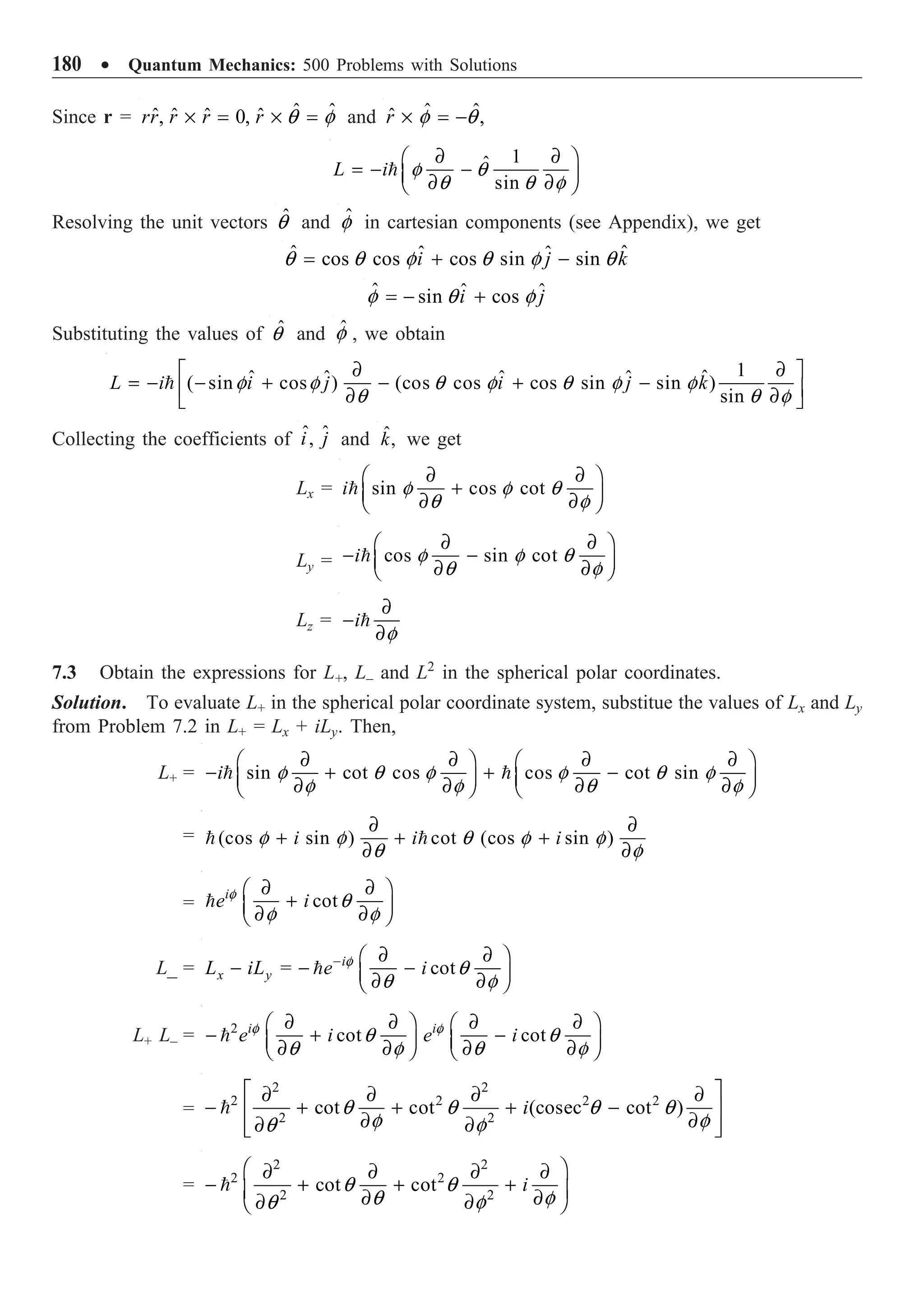
![Angular Momentum and Spin ∑ 181
L– L+ =
2 2
2 2
2 2
cot cot i
q q
q f
q f
Ê ˆ
∂ ∂ ∂ ∂
- + + -
Á ˜
∂ ∂
∂ ∂
Ë ¯
L2
= 2 2 2 2
1
( )
2
x y z z
L L L L L L L L
+ - - +
+ + = + +
=
2 2 2
2 2
2 2 2
cot cot
q q
q
q f f
Ê ˆ
∂ ∂ ∂ ∂
- + + +
Á ˜
∂
∂ ∂ ∂
Ë ¯
=
2 2
2
2 2 2
cos 1
sin sin
q
q q
q q f
Ê ˆ
∂ ∂ ∂
- + +
Á ˜
∂
∂ ∂
Ë ¯
=
2
2
2 2
1 1
sin
sin sin
q
q q q q f
È ˘
∂ ∂ ∂
Ê ˆ
- +
Í ˙
Á ˜
∂ ∂
Ë ¯ ∂
Í ˙
Î ˚
7.4 What is the value of the uncertainty product (DLx) (DLy) in a representation in which L2
and
Lz have simultaneous eigenfunctions? Comment on the value of this product when l = 0.
Solution. If the commutator of operators A and B obey the relation [A, B] = iC, then
( )( )
2
C
A B
|· Ò|
D D ≥
In the representation in which L2
and Lz have simultaneous eigenfunctions,
[Lx, Ly] = iLZ
Therefore, it follows that
(DLx) (DLy) ≥
2 2
z
h
L m
|· Ò| ≥
(DLx) (DLy) ≥
2
2
m
This is understandable as Ylm (q, f) is not an eigenfunction of Lx and Ly when l π 0. When l = 0,
m = 0, Y00 = 1/ 4p . Hence,
( )( ) 0
x y
L L
D D ≥
7.5 Evaluate the following commutators.
Solution.
(i) [Lx, [Ly, Lz]] = [Lx, iLx] = i[Lx, Lx] = 0.
(ii) 2
[ , ] [ , ] [ , ] ( )
y x y y x y x y y z z y
L L L L L L L L i L L L L
= + = - +
.
(iii)
2 2
[ , ]
x y
L L =
2 2
[ , ] [ , ] {[ , ] [ , ]}
x x y x y x x x y y y x y
L L L L L L L L L L L L L
+ = +
+ {[ , ] [ , ]}
x y y y x y x
L L L L L L L
+
= ( )
x z y x y z z y x y z x
i L L L L L L L L L L L L
+ + +
.](https://image.slidesharecdn.com/quantummechanics500problemswithsolutionspdfdrive-220626164912-635041ea/75/Quantum-Mechanics_-500-Problems-with-Solutions-PDFDrive-pdf-191-2048.jpg)
![182 ∑ Quantum Mechanics: 500 Problems with Solutions
7.6 Evaluate the commutator [Lx, Ly] in the momentum representation.
Solution.
Lx = ypz – zpy; Ly = zpx – xpz; Lz = xpy – ypx
[Lx, Ly] = [ ypz – zpy, zpx – xpz] = [ypz, zpx] – [ ypz, xpz] – [zpy, zpx] + [zpy, xpz]
= ypx [pz, z] – 0 – 0 + pyx [z, pz]
In the momentum representation [z, pz] = i,
[Lx, Ly] = i (xpy – ypx) = iLz
7.7 Show that the raising and lowering operators L+ and L– are Hermitian conjugates.
Solution.
m L n
+
· | | Ò = x y
m L n i m L n
· | | Ò + · | | Ò
= * *
x y
n L m i n L m
· | | Ò + · | | Ò
= ( ) * *
x y
n L iL m n L m
-
· | - | Ò = · | | Ò
Hence the result.
7.8 Prove that the spin matrices Sx and Sy have ±/2 eigenvalues, i.e.,
0 1
1
2 1 0
x
S
Ê ˆ
= Á ˜
Ë ¯
0
1
2 0
y
i
S
i
-
Ê ˆ
= Á ˜
Ë ¯
Solution. The characteristic determinant of the Sx matrix is given by
/2
0
/2
l
l
-
=
-
or
2
2
0
4
l - =
or
1
2
l = ±
Similarly, the eigenvalues of Sy are
1
.
2
±
7.9 The operators J+ and J– are defined by J+ = Jx + iJy and J– = Jx + iJy, where Jx and Jy are the
x- and y-components of the general angular momentum J. Prove that
(i) 1/2
, [ ( 1) ( 1)] , 1
j j m j j m m j m
+ | Ò = + - + | + Ò
(ii) 1/2
, [ ( 1) ( 1)] , 1
j j m j j m m j m
- | Ò = + - - | - Ò
Solution. Jz operating on | jmÒ gives
Jz | jmÒ = m| jmÒ (i)
Operating from left by J+, we get
J+Jz | jmÒ = mJ+| jmÒ
Since
[Jz, J+] = J+ or J+Jz = JzJ+ – J+
we have
( )
z
J J J jm m J jm
+ + +
- | Ò = | Ò
( 1)
z
J J jm m J jm
+ +
| Ò = + | Ò
(ii)](https://image.slidesharecdn.com/quantummechanics500problemswithsolutionspdfdrive-220626164912-635041ea/75/Quantum-Mechanics_-500-Problems-with-Solutions-PDFDrive-pdf-192-2048.jpg)
![Angular Momentum and Spin ∑ 183
This implies that J+ | jmÒ is an eigenket of Jz with eigenvalue (m + 1)=. The eigenvalue equation for
Jz with eigenvalue (m + 1)= can also be written as
, 1 ( 1) , 1
| + Ò = + | + Ò
=
z
J j m m j m (iii)
Since the eigenvalues of Jz, see Eqs. (ii) and (iii), are equal, the eigenvectors can differ at the most
by a multiplicative constant, say, am. Now,
, 1
m
J jm a j m
+ | Ò = | + Ò (iv)
Similarly,
, 1
m
J jm b j m
- | Ò = | - Ò (v)
am = , 1
j m J jm
+
· + | | Ò or * , 1
m
a jm J j m
-
= · | | + Ò (vi)
bm = , 1
j m J jm
-
· - | | Ò or 1 , 1
m
b jm J j m
+ -
= · | | + Ò (vii)
Comparing Eqs. (vi) and (vii), we get
1
*
m m
a b +
= (viii)
Operating Eq. (iv) from left by J–, we obtain
, 1
m
J J jm a J j m
- + -
| Ò = | + Ò
It is easily seen that
2 2
z z
J J J J J
- + = - - =
Using this result and Eq. (v), we have
2 2
1
( )
z z m m
J J J jm a b jm
+
- - | Ò = | Ò
=
2 2 2
[ ( 1) ] n
j j m m jm a jm
+ - - | Ò = | | | Ò
=
1/2
[ ( 1) ( 1)]
m
a j j m m
= + - + = (ix)
With this value of am,
1/2
[ ( 1) ( 1)] , 1
J jm j j m m j m
+ | Ò = + - + | + Ò
= (x)
1/2
, 1
[ ( 1) ( 1)] jj m m
j m J jm j j m m d d
¢ ¢
+ +
¢ ¢
· | | Ò = + - + = (xi)
Similarly,
1/2
, 1
[ ( 1) ( 1)] jj m m
j m J jm j j m m d d
¢ ¢
- -
¢ ¢
· | | Ò = + - - = (xii)
7.10 A particle is in an eigenstate of Lz. Prove that ·JxÒ = ·JyÒ = 0. Also find the value of ·Jx
2
Ò and
·Jy
2
Ò.
Solution. Let the eigenstate of Jz be | jmÒ. We have
2
x
J J
J + -
+
= ,
2
y
J J
J
i
+ -
-
=](https://image.slidesharecdn.com/quantummechanics500problemswithsolutionspdfdrive-220626164912-635041ea/75/Quantum-Mechanics_-500-Problems-with-Solutions-PDFDrive-pdf-193-2048.jpg)
![184 ∑ Quantum Mechanics: 500 Problems with Solutions
·JxÒ =
1 1
2 2
jm J jm jm J jm
+ -
· | | Ò + · | | Ò
=
1 1
( 1) ( 1) , 1 ( 1) ( 1) , 1 0
2 2
j j m m jm j m j j m m jm j m
+ - + · | + Ò + + - - · | - Ò =
since · jm | j, m + 1Ò = · jm | j, m – 1Ò = 0. Similarly, ·JyÒ = 0. We have the relation
2 2 2 2
x y z
J J J J
+ = -
In the eigenstate | jmÒ, this relation can be rewritten as
2 2 2 2
( ) ( )
x y z
jm J J jm jm J J jm
· | + | Ò = · | - | Ò
2 2 2 2 2
( 1)
x y
jm J jm jm J jm j j m
· | | Ò + · | | Ò = + -
It is expected that
2 2
x y
J J
· Ò = · Ò and, therefore,
2 2 2 2 2
1
[ ( 1) ]
2
x y
J J j j m
· Ò = · Ò = + -
7.11 Ylm(q, f) form a complete set of orthonormal functions of (q, f). Prove that
1
l
lm lm
l m l
Y Y
=-
| Ò · | =
 Â
where 1 is the unit operator.
Solution. On the basis of expansion theorem, any function of q and f may be expanded in the form
( , ) ( , )
lm lm
l m
C Y
y q f q f
= ÂÂ
In Dirac’s notation,
lm lm
l m
C Y
y
| Ò = | Ò
ÂÂ
Operating from left by ·Ylm | and using the orthonormality relation
l m lm ll mm
Y Y d d
¢ ¢ ¢ ¢
· | Ò =
we get
lm lm
C Y y
= · | Ò
Substituting this value of Clm, we obtain
l
lm lm
l m l
Y Y
y y
=-
| Ò = | Ò· | Ò
 Â
From this relation it follows that
1
l
lm lm
l m l
Y Y
=-
| Ò· | =
 Â
7.12 The vector J gives the sum of angular momenta J1 and J2. Prove that
[Jx, Jy] = iJz, [Jy, Jz] = iJx, [Jz, Jx] = iJy
Is J1 – J2 an angular momentum?](https://image.slidesharecdn.com/quantummechanics500problemswithsolutionspdfdrive-220626164912-635041ea/75/Quantum-Mechanics_-500-Problems-with-Solutions-PDFDrive-pdf-194-2048.jpg)
![Angular Momentum and Spin ∑ 185
Solution. Given J = J1 + J2:
[Jx, Jy] = [J1x + J2x, J1y + J2y]
= [J1x, J1y] + [J1x, J2y] + [J2x, J1y] + [J2x, J2y]
= iJ1z + 0 + 0 + iJ2z
= i(J1z + J2z) = iJz
By cyclic permutation of the coordinates, we can write the other two commutation relations. Writing
J1 – J2 = J¢
[J¢x, J¢
y] = [J1x – J2x, J1y – J2y]
= [J1x, J1y] – [J1x, J2y] – [J2x, J1y] + [J2x, J2y]
= iJ1z – 0 – 0 + iJ2z = i (J1z + J2z)
which is not the operator for J¢z. Hence J1 – J2 is not an angular momentum.
7.13 Write the operators for the square of angular momentum and its z-component in the spherical
polar coordinates. Using the explicit form of the spherical harmonic, verify that Y11(q, f) is an
eigenfunction of L2
and Lz with the quantum numbers l = 1 and m = 1.
Solution. The operators for L2
and Lz are
L2
=
2
2
2 2
1 1
sin
sin sin
q
q q q q f
È ˘
∂ ∂ ∂
Ê ˆ
- +
Í ˙
Á ˜
∂ ∂
Ë ¯ ∂
Í ˙
Î ˚
=
2 2
2
2 2 2
1
cot
sin
q
q
q q f
È ˘
∂ ∂ ∂
- + +
Í ˙
∂
∂ ∂
Í ˙
Î ˚
Lz = i
q
∂
-
∂
The spherical harmonic
1/2
11
3
sin
8
i
Y e f
q
p
Ê ˆ
= - Á ˜
Ë ¯
L2
Y11 =
1/2 2 2
2
2 2 2
3 1
cot sin
8 sin
i
e f
q q
p q
q q q
È ˘
∂ ∂ ∂
Ê ˆ
+ +
Í ˙
Á ˜ ∂
Ë ¯ ∂ ∂
Í ˙
Î ˚
=
1/2
2
2
3 1
sin cot cos sin
8 sin
i
e f
q q q q
p q
Ê ˆ È ˘
- + -
Á ˜ Í ˙
Ë ¯ Î ˚
=
1/2 2
2
3 cos 1
sin
8 sin sin
i
e f
q
q
p q q
È ˘
Ê ˆ
- + -
Í ˙
Á ˜
Ë ¯ Í ˙
Î ˚
=
1/2 2 2
2
3 sin cos 1
8 sin
i
e f
q q
p q
È ˘
- + -
Ê ˆ
Í ˙
Á ˜
Ë ¯ Í ˙
Î ˚
=
1/2
2
3
( 2sin )
8
i
e f
q
p
Ê ˆ
-
Á ˜
Ë ¯
= 2
11
2 Y](https://image.slidesharecdn.com/quantummechanics500problemswithsolutionspdfdrive-220626164912-635041ea/75/Quantum-Mechanics_-500-Problems-with-Solutions-PDFDrive-pdf-195-2048.jpg)
![186 ∑ Quantum Mechanics: 500 Problems with Solutions
LzY11 =
1/2
3
sin
8
i
i e f
q
f p
∂ Ê ˆ
+ Á ˜
∂ Ë ¯
=
1/2
11
3
sin
8
i
e Y
f
q
p
Ê ˆ
- =
Á ˜
Ë ¯
Hence the required result.
7.14 The raising (J+) and lowering (J–) operators are defined by J+ = Jx + iJy and J– = Jx – iJy. Prove
the following identities:
(i) [ , ]
x z
J J J
± = ∓
(ii) [ , ]
y z
J J i J
± = -
(iii) [ , ]
z
J J J
± ±
= ±
(iv) 2 2
z z
J J J J J
+ - = - +
(v) 2 2
z z
J J J J J
- + = - -
Solution.
(i) [Jx, J±] = [ , ] [ , ]
x x x y
J J i J J
±
= 0 ± i(i) Jz
= ∓Jz
(ii) [Jy, J±] = [ , ] [ , ]
y x y y
J J i J J
±
= –iJz
(iii) [Jx, J±] = [ , ] [ , ]
z x z y
J J i J J
±
= ( ) ( )
y x x y
i J i i J J iJ
± - = ± +
= ±J±
(iv) J+ J– = ( )( )
x y x y
J iJ J iJ
+ -
= 2 2
( )
x y x y y x
J J i J J J J
+ - -
= 2 2 2 2
[ , ]
z x y z z
J J i J J J J J
- - = - +
(v) J–J+ =
2 2
( )( ) ( )
x y x y x y x y y x
J iJ J iJ J J i J J J J
- - = + + -
= 2 2 2 2
[ , ]
z x y z z
J J i J J J J J
- + = - -
7.15 In the | jmÒ basis formed by the eigenkets of J2
and Jz, show that
2
( )( 1)
jm J J jm j m j m
- +
· | | Ò = - + +
where J+ = Jx + iJy and J– = Jx – iJy.
Solution. In Problem 7.14, we have proved that
2 2
z z
J J J J J
- + = - -
jm J J jm
- +
· | | Ò = 2 2
z z
jm J J J jm
· | - - | Ò
= 2 2
[ ( 1) ]
j j m m jm jm
+ - - · | Ò](https://image.slidesharecdn.com/quantummechanics500problemswithsolutionspdfdrive-220626164912-635041ea/75/Quantum-Mechanics_-500-Problems-with-Solutions-PDFDrive-pdf-196-2048.jpg)
![Angular Momentum and Spin ∑ 187
Since · jm | jmÒ = 1,
jm J J jm
- +
· | | Ò = 2 2 2
[ ]
j m j m
- + -
= 2
[( )( ) ( )]
j m j m j m
+ - + -
= 2
( ) ( 1)
j m j m
- + + +
7.16 In the | jmÒ basis formed by the eigenkets of the operators J2
and Jz, obtain the relations for
their matrices. Also obtain the explicit form of the matrices for j = 1/2 and j = 1.
Solution. As J2
commutes with Jz, the matrices for J2
and Jz will be diagonal. The eigenvalue-
eigenket equations of the operators J2
and Jz are
2 2
( 1)
J jm j j jm
| Ò = + | Ò
(i)
z
J jm m jm
| Ò = | Ò
(ii)
where
j = 0, 1/2, 1, 3/2, º; m = j, j – 1, j – 2, º, –j
Multiplication of Eqs. (i) and (ii) from left by · j¢m¢| gives the J2
and Jz matrix elements:
· j¢m¢| J2
| jmÒ = j ( j + 1) 2
djj¢dmm¢
· j¢m¢|Jz | jmÒ = mdjj¢dmm¢
The presence of the factors djj¢ and dmm¢ indicates that the matrices are diagonal as expected. The
matrices for J2
and Jz are:
j =
1
2
, m =
1
2
, –
1
2
j = 1, m = 1, 0, –1
7.17 Using the values of J+ | jmÒ and J– | jmÒ, obtain the matrices for Jx and Jy for j = 1/2 and
j = 1.
Solution. In Problem 7.9, we have proved that
1/2
[ ( 1) ( 1)] , 1
J jm j j m m j m
+ | Ò = + - + | + Ò
(i)
1/2
[ ( 1) ( 1)] , 1
J jm j j m m j m
- | Ò = + - - | - Ò
(ii)
Premultiplying these equations by · j¢m¢|, we have
1/2
, 1
[ ( 1) ( 1)] jj m m
j m J jm j j m m d d
¢ ¢
+ +
¢ ¢
· | | Ò = + - + (iii)
1/2
, 1
[ ( 1) ( 1)] jj m m
j m J jm j j m m d d
¢ ¢
- -
¢ ¢
· | | Ò = + - - (iv)
Equations (iii) and (iv) give the matrix elements for J+ and J– matrices. From these, Jx and Jy can
be evaluated using the relations
1
( )
2
x
J J J
+ -
= + , ( )
2
y
i
J J J
+ -
= - -](https://image.slidesharecdn.com/quantummechanics500problemswithsolutionspdfdrive-220626164912-635041ea/75/Quantum-Mechanics_-500-Problems-with-Solutions-PDFDrive-pdf-197-2048.jpg)
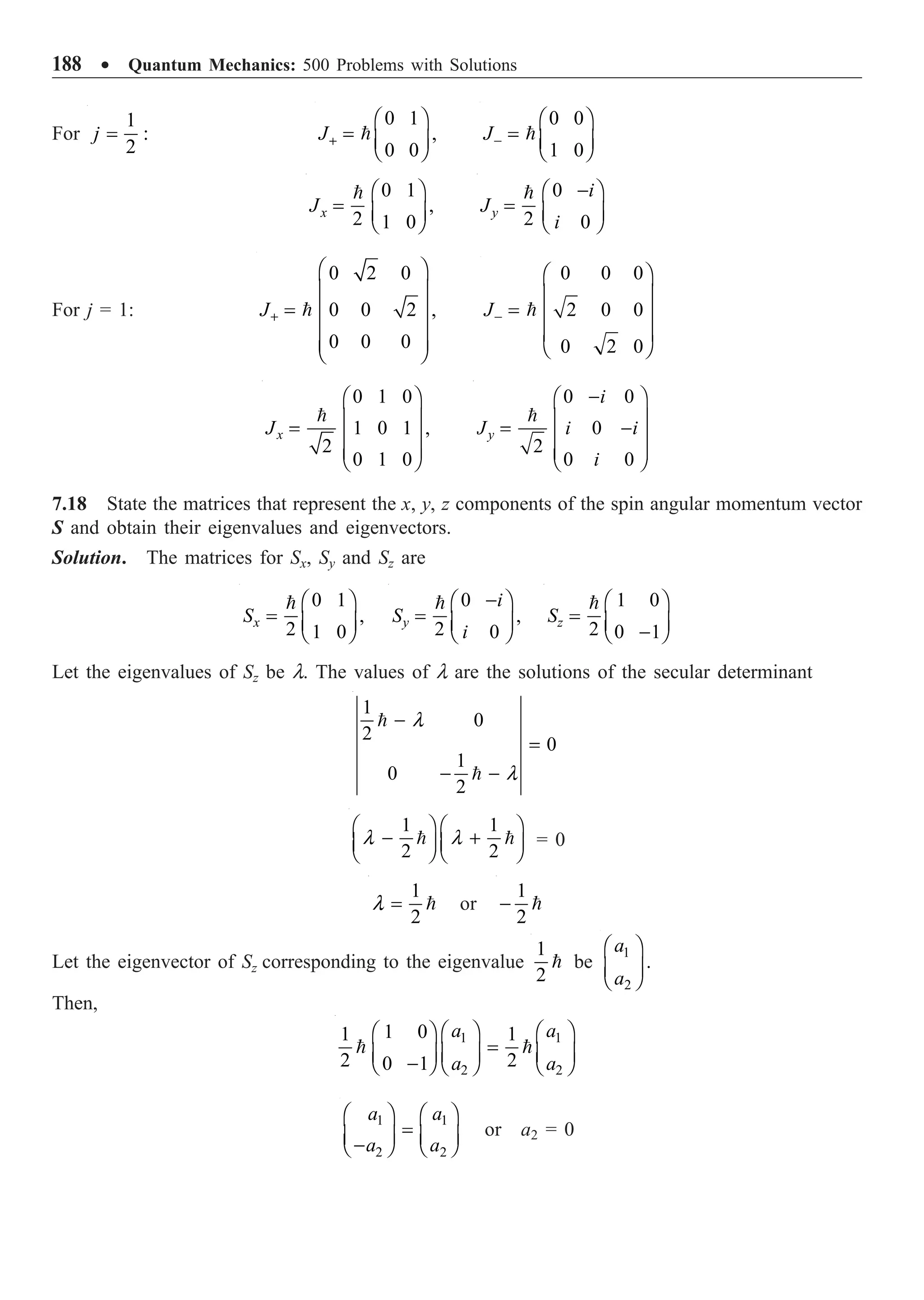
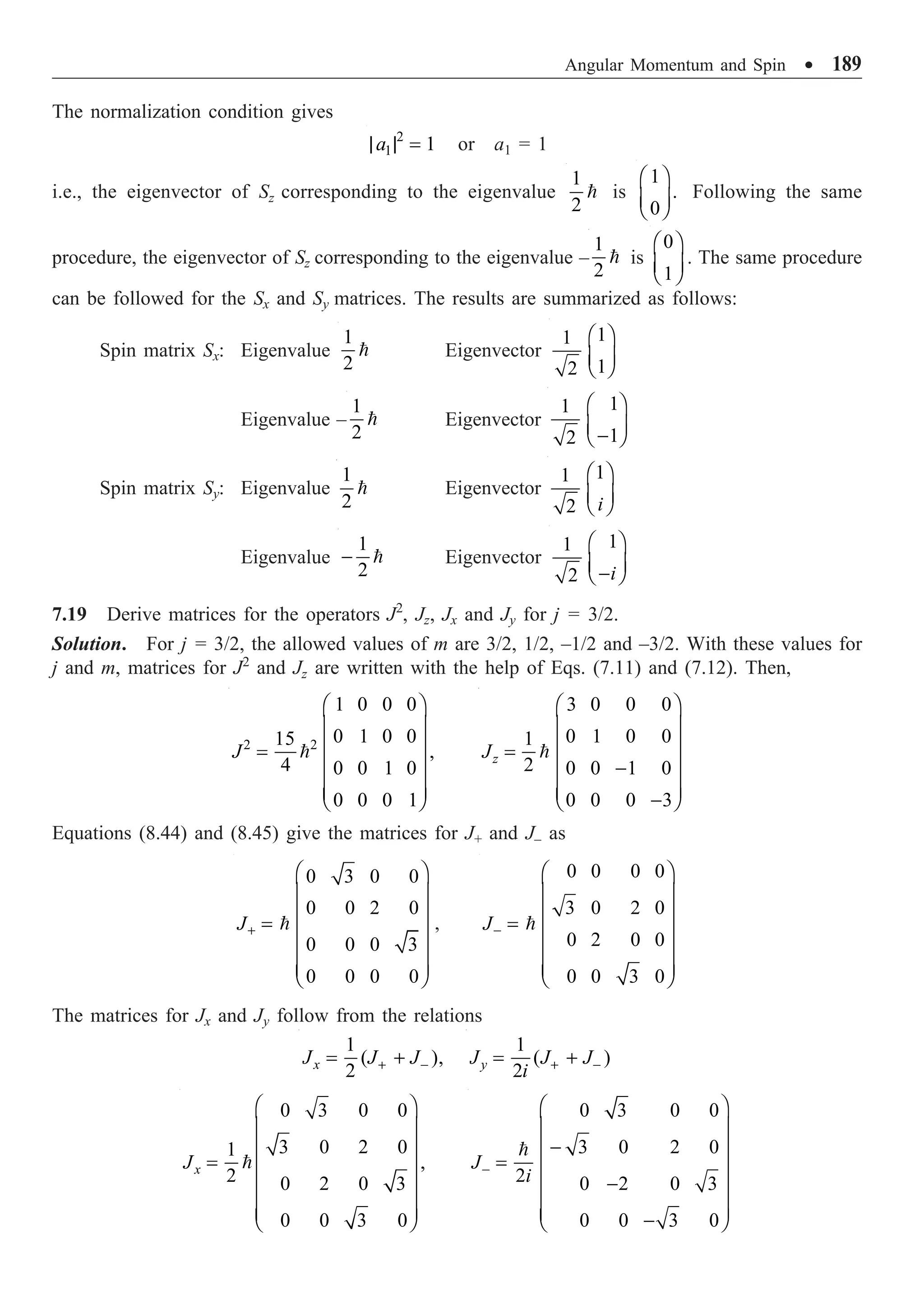
![190 ∑ Quantum Mechanics: 500 Problems with Solutions
7.20 If the angular momentum operators obey the rule [Jx, Jy] = –iJz and similar commutation
relations for the other components, evaluate the commutators [J2
, Jx] and [J2
, J+]. What would be
the roles of J+ and J– in the new situation?
Solution.
[J2
, Jx] = [Jx
2
, Jx] + [Jy
2
, Jx] + [Jz
2
, Jx]
= Jy [Jy, Jx] + [Jy, Jx] Jy + Jz [Jz, Jx] + [Jz, Jx] Jz
= iJyJz + iJzJy – iJzJy – iJyJz = 0
Similarly, [J2
, Jy] = 0. Hence,
[J2
, J+] = [J2
, Jx] + i[J2
, Jy] = 0
Let us evaluate [Jz, J+] and [Jz, J–]:
[Jz, J+] = [Jz, Jx ] + i[Jz, Jy] = –iJy – Jx = –J+
Similarly, [Jz, J–] = J–.
Thus, with the new definition, J+ would be a lowering operator and J– would be a raising
operator.
7.21 For Pauli’s matrices, prove that (i) [sx, sy] = 2isz, (ii) sxsysz = i.
Solution.
(i) We have
S =
1
,
2
s
[Sx, Sy] = iSz
Substituting the values of Sx, Sy and Sz, we get
1 1 1
,
2 2 2
x y z
i
s s s
È ˘
=
Í ˙
Î ˚
or [sx, sy] = 2isz
(ii) sxsysz =
0 1 0 1 0
1 0 0 0 1
i
i
-
Ê ˆ Ê ˆ Ê ˆ
Á ˜ Á ˜ Á ˜
-
Ë ¯ Ë ¯ Ë ¯
=
0 1 0 0
0 0 1 0
i i
i
i i
Ê ˆ Ê ˆ Ê ˆ
= =
Á ˜ Á ˜ Á ˜
- -
Ë ¯ Ë ¯ Ë ¯
7.22 Prove by direct matrix multiplication that the Pauli matrices anticommute and they follow the
commutation relations [sx, sy] = 2isz, xyz cyclic.
Solution.
sxsy + sysx =
0 1 0 0 0 1
1 0 0 0 1 0
i i
i i
- -
Ê ˆ Ê ˆ Ê ˆ Ê ˆ
+
Á ˜ Á ˜ Á ˜ Á ˜
Ë ¯ Ë ¯ Ë ¯ Ë ¯
=
0 0
0
0 0
i i
i i
-
Ê ˆ Ê ˆ
=
Á ˜ Á ˜
-
Ë ¯ Ë ¯](https://image.slidesharecdn.com/quantummechanics500problemswithsolutionspdfdrive-220626164912-635041ea/75/Quantum-Mechanics_-500-Problems-with-Solutions-PDFDrive-pdf-200-2048.jpg)
![Angular Momentum and Spin ∑ 191
[sx, sy] = sxsy – sysx =
0 0
0 0
i i
i i
-
Ê ˆ Ê ˆ
-
Á ˜ Á ˜
-
Ë ¯ Ë ¯
=
2 0 1 0
2 2
0 2 0 1
z
i
i i
i
s
Ê ˆ Ê ˆ
= =
Á ˜ Á ˜
- -
Ë ¯ Ë ¯
7.23 The components of arbitrary vectors A and B commute with those of s. Show that (s ◊ A)
(s ◊ B) = A ◊ B + is ◊ (A ¥ B).
Solution.
(s ◊ A) (s ◊ B) = (sxAx + sy Ay + sz Az) (sxBx + syBy + szBz)
= sx
2
AxBx + sy
2
AyBy + sz
2
AzBz + sxsy AxBy + sysx AyBx
+ sxsz AxBz + sysz AyBz + szsy AzBy + szsx AzBx
Using the relations
2 2 2
1
x y z
s s s
= = =
,
x y z
i
s s s
= ,
y z x
i
s s s
= z x y
i
s s s
=
0
x y y x y z z y z x x z
s s s s s s s s s s s s
+ = + = + =
we get
(s ◊ A) (s ◊ B) = (A ◊ B) + isz (AxBy – AyBx) + isy (AzBx – AxBz) + isx (AyBz – AzBy)
= (A ◊ B) + is ◊ (A ¥ B)
7.24 Obtain the normalized eigenvectors of sx and sy matrices.
Solution. The eigenvalue equation for the matrix sx for the eigenvalue +1 is
1 1
2 2
0 1
1
1 0
a a
a a
Ê ˆ Ê ˆ
Ê ˆ
=
Á ˜ Á ˜
Á ˜
Ë ¯ Ë ¯ Ë ¯
2 1
1 2
a a
a a
Ê ˆ Ê ˆ
=
Á ˜ Á ˜
Ë ¯ Ë ¯
or a1 = a2
Normalization gives | a1|2
+ | a2|2
= 1 or a1 = a2 = 1/ 2.
The normalized eigenvector of sx for the eigenvalue +1 is
1
1
.
1
2
Ê ˆ
Á ˜
Ë ¯
The normalized eigenvector of sx for for the eigenvalue –1 is
1
1
.
1
2
Ê ˆ
Á ˜
-
Ë ¯
The eigenvalue equation for the matrix sy for the eigenvalue +1 is
1 1
2 2
0
0
a a
i
a a
i
- Ê ˆ Ê ˆ
Ê ˆ
=
Á ˜ Á ˜
Á ˜
Ë ¯ Ë ¯ Ë ¯
or a1i = a2
Normalization gives
|a1|2
+ |a1i|2
= 1 or 2a1
2
= 1, a1 =
1
2
, a2 =
2
i](https://image.slidesharecdn.com/quantummechanics500problemswithsolutionspdfdrive-220626164912-635041ea/75/Quantum-Mechanics_-500-Problems-with-Solutions-PDFDrive-pdf-201-2048.jpg)
![192 ∑ Quantum Mechanics: 500 Problems with Solutions
The normalized eigenvector of sy for the eigenvalue +1 is
1
1
.
2 i
Ê ˆ
Á ˜
Ë ¯
The normalized eigenvector of sy for the eigenvalue –1 is
1
1
2 i
Ê ˆ
Á ˜
-
Ë ¯
.
7.25 Using Pauli’s spin matrix representation, reduce each of the operators
(i) Sx
2
SySz
2
; (ii) Sx
2
Sy
2
Sz
2
; (iii) SxSySz
3
Solution.
(i)
2 2 5
2 2 2 2
2 2 2 2
x y z x y z y
S S S s s s s
Ê ˆ Ê ˆ Ê ˆ
= =
Á ˜ Á ˜ Á ˜
Ë ¯ Ë ¯ Ë ¯
.
(ii)
2 2 2 6
2 2 2 2 2 2
2 2 2 2
x y z x y z
S S S s s s
Ê ˆ Ê ˆ Ê ˆ Ê ˆ
= =
Á ˜ Á ˜ Á ˜ Á ˜
Ë ¯ Ë ¯ Ë ¯ Ë ¯
.
(iii)
3 5 5
3 3
2 2 2 2 2
x y z x y z x y z
S S S i
s s s s s s
Ê ˆ Ê ˆ Ê ˆ
= = =
Á ˜ Á ˜ Á ˜
Ë ¯ Ë ¯ Ë ¯
.
7.26 Determine the total angular momentum that may arise when the following angular momenta
are added:
(i) j1 = 1, j2 = 1; (ii) j1 = 3, j2 = 4; (iii) j1 = 2, j2 = 1/2.
Solution. When the angular momenta j1 and j2 are combined, the allowed total angular momentum
(j) values are given by ( j1 + j2), ( j1 + j2 – 1), º, | j1 – j2|.
(i) For j1 = 1, j2 = 1, the allowed j values are 2, 1, 0.
(ii) For j1 = 3, j2 = 4, the allowed j values are 7, 6, 5, 4, 3, 2, 1.
(iii) For j1 = 2, j2 = 1/2, the allowed j values are 5/2, 3/2.
7.27 Determine the orbital momenta of two electrons:
(i) Both in d-orbitals; (ii) both in p-orbitals; (iii) in the configuration p1
d1
.
Solution.
(i) When the two electrons are in d orbitals, l1 = 2, l2 = 2. The angular momentum quantum
number values are 4, 3, 2, 1, 0. The angular momenta in units of are
( 1) 20, 12, 6, 2, 0
l l + =
(ii) When both the electrons are in p-orbitals, l1 = 1, l2 = 1. The possible values of l are 2,
1, 0. The angular momenta are 6, 2, 0.
(iii) The configuration p1
d1
means l1 = 1, l2 = 2. The possible l values are 3, 2, 1. Hence, the
angular momenta are 12, 6, 2.
7.28 For any vector A, show that [s, A ◊ s] = 2iA ¥ s.
Solution. The x-component on LHS is
,
x x x y y z z
A A A
s s s s
Í ˙
+ +
Î ˚ = , , ,
x x x y x y z x z
A A A
s s s s s s
È ˘ È ˘
+ +
È ˘
Î ˚ Î ˚
Î ˚
= 0 2 2
y z z y
iA iA
s s
+ -
Adding all the three components, we get
ˆ
ˆ ˆ
[ , ] 2 ( ) 2 ( ) 2 ( ) 2
y z z y z x x z x y y x
A i i A A j i A A k i A A i
s s s s s s s s s
◊ = - + - + - = ¥
A](https://image.slidesharecdn.com/quantummechanics500problemswithsolutionspdfdrive-220626164912-635041ea/75/Quantum-Mechanics_-500-Problems-with-Solutions-PDFDrive-pdf-202-2048.jpg)
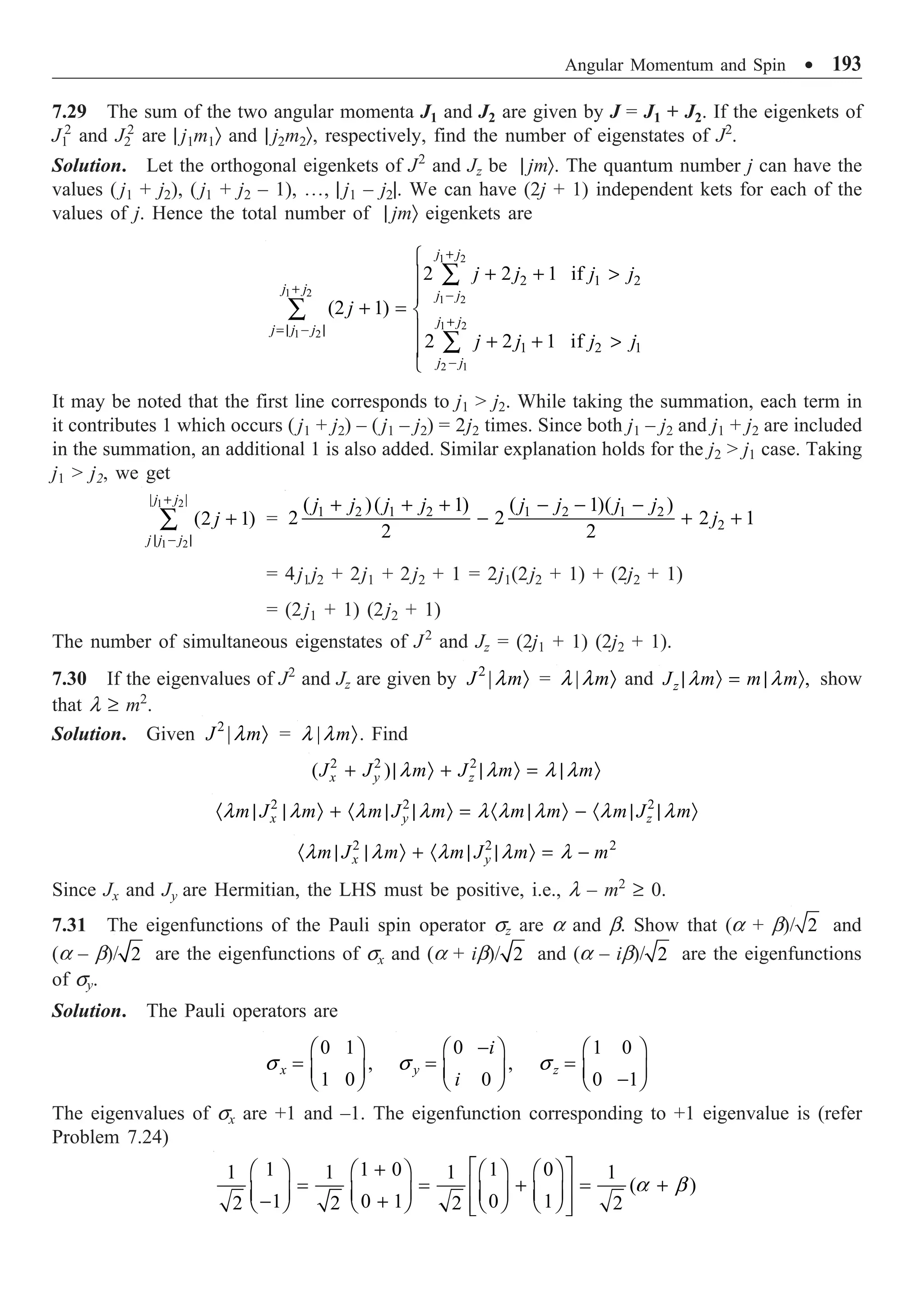
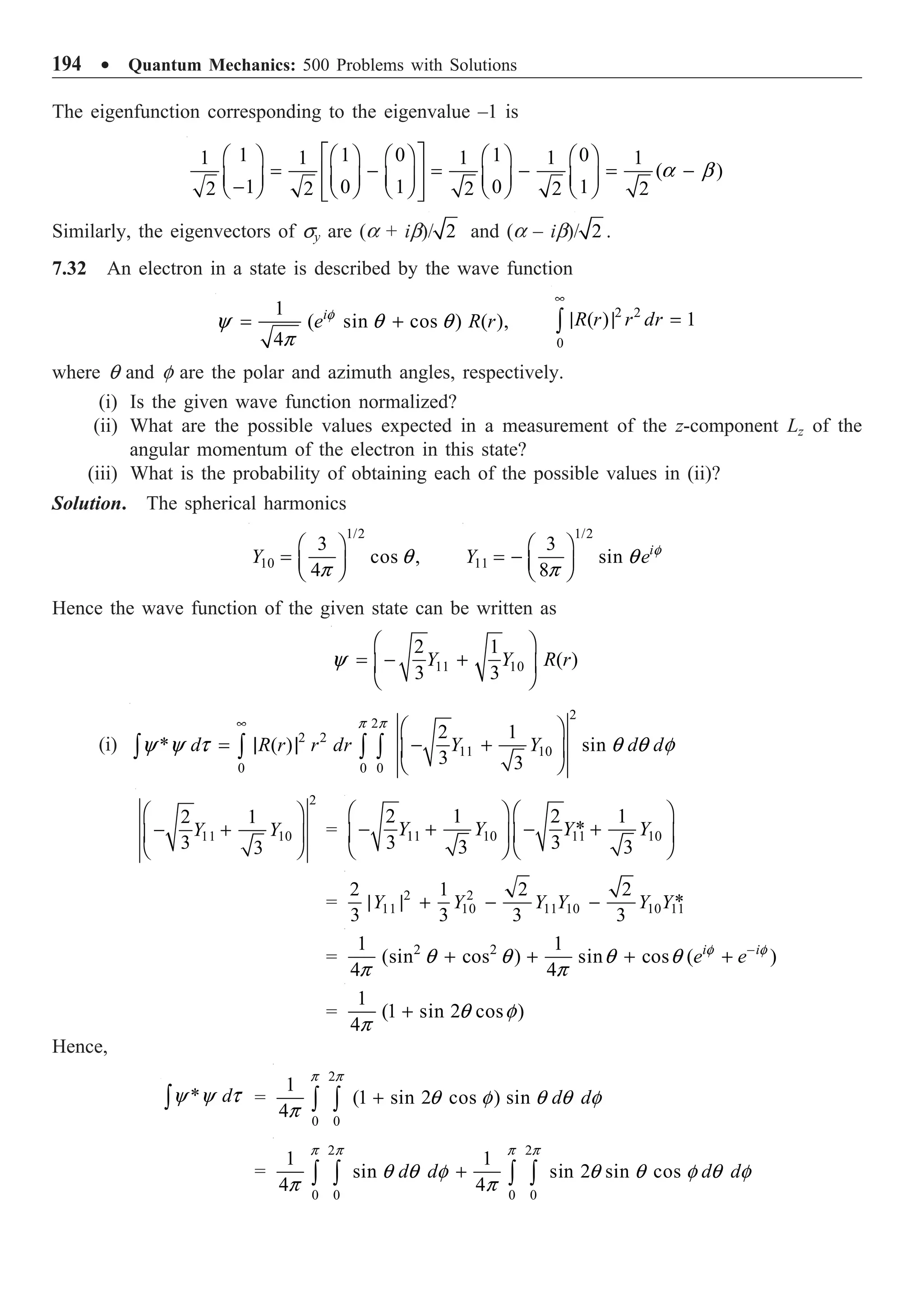
![Angular Momentum and Spin ∑ 195
As the f-part of second integral vanishes,
0
12
* sin 1
4
d d
p
p
y y t q q
p
= =
Ú Ú
Therefore, the wavefunction y is normalized.
(ii) The ml value in Y11 is 1 and in Y10 it is zero. Hence the possible values in a measurement
of Lz are and zero.
(iii) The probabilty density P = |y |2
. Since the wavefunction is normalized, the probability of
2
2 2
1
3 3
z
L
Ê ˆ
= = =
Á ˜
Ë ¯
and that of
2
1 1
0
3
3
z
L
Ê ˆ
= = =
Á ˜
Ë ¯
7.33 The rotational part of the Hamiltonian of a diatomic molecule is
2 2 2
1 1
( ) ,
2 x y z
L L L I
I I
+ +
which is moment of inertia. Find the energy eigenvalues and eigenfunctions.
Solution.
Hamiltonian H = 2 2 2
1 1
( )
2 x y z
L L L
I I
+ +
= 2 2 2 2 2 2
1 1 1 1
( )
2 2 2 2
x y z z z
L L L L L L
I I I I
+ + + = +
The eigenkets are the spherical harmonics. Hence energy E is obtained as
E = 2 2 2
1 1
( )
2 x y z
H L L L
I I
· Ò = + +
= 2 2 2
1 1
( 1)
2 2
l l m
I I
+ +
=
2
2
[ ( 1) ]
2
l l m
I
+ +
0, 1, 2,
0, 1, 2, ,
l
m l
=
¸
˝
= ± ± ±
Ô
˛
…
…
7.34 The spin functions for a free electron in a basis in which S2
and Sz are diagonal are
1
0
Ê ˆ
Á ˜
Ë ¯
and
0
,
1
Ê ˆ
Á ˜
Ë ¯
with Sz eigenvalues
1
2
and –
1
2
, respectively. Using this basis, find the eigenvalues and
normalized eigenkets of Sx and Sy.
Solution. We have
0 1
,
2 1 0
x
S
Ê ˆ
= Á ˜
Ë ¯
0
2 0
y
i
S
i
-
Ê ˆ
= Á ˜
Ë ¯](https://image.slidesharecdn.com/quantummechanics500problemswithsolutionspdfdrive-220626164912-635041ea/75/Quantum-Mechanics_-500-Problems-with-Solutions-PDFDrive-pdf-205-2048.jpg)
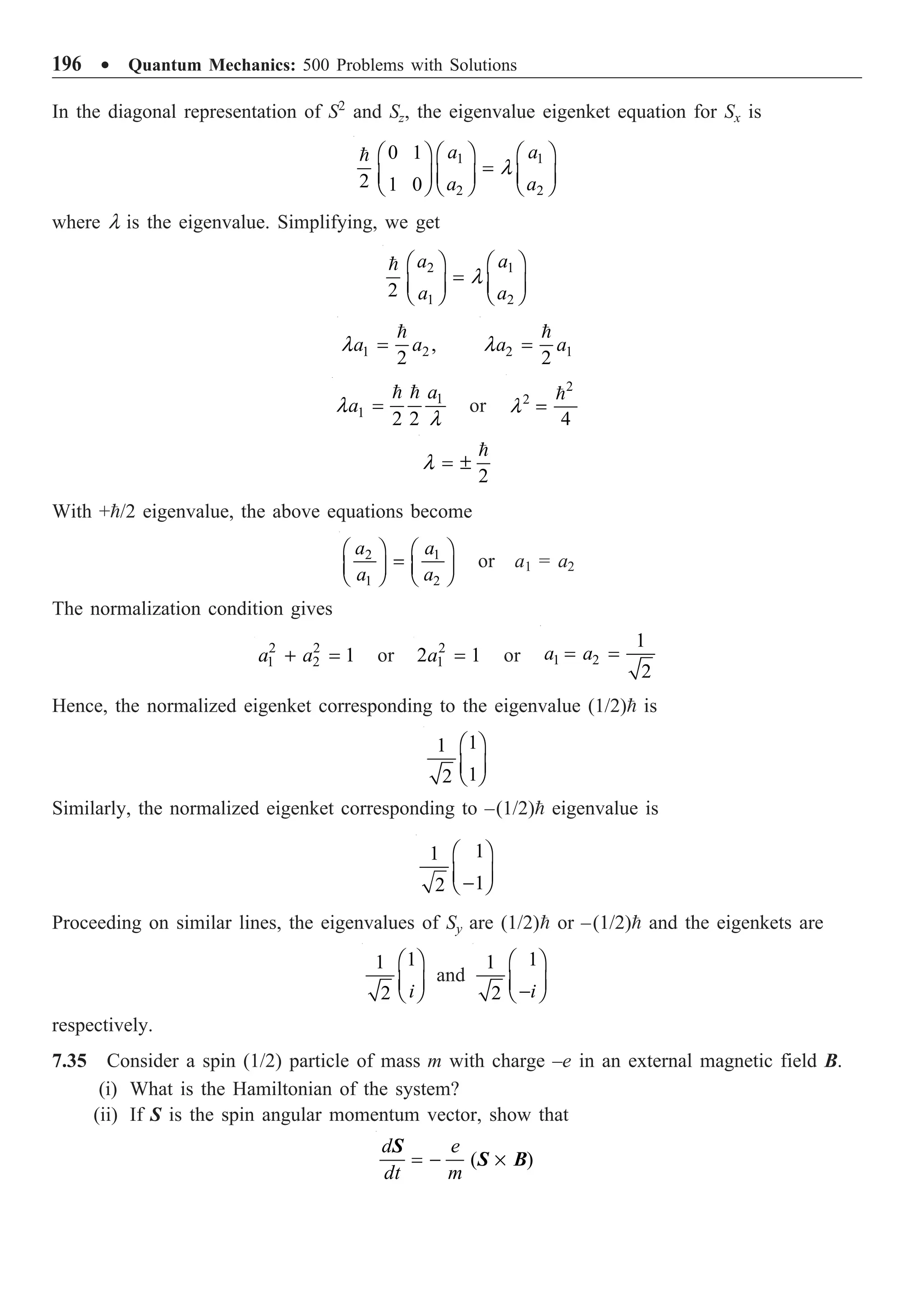
![Angular Momentum and Spin ∑ 197
Solution.
(i) The magnetic moment of the particle is
m =
e
m
- S
The interaction energy E of the moment m in an external magnetic field B is given by
E = –m ◊ B =
e
m
◊
S B
Hamiltonian H =
e
m
◊
S B
(ii) In the Heisenberg picture,
d
dt
S
=
1
[ , ] [ , ]
e
i i m
= ◊
S H S S B
= [ , ]
x x y y z z
e
S B S B S B
i m
+ +
S
The x-component of the commutator on RHS is
[ , ] [ , ] [ , ] [ , ]
x x x x x y y x z z
S S S B S S B S S B
◊ = + +
S B
Since Bx, By and Bz are constants,
[ , ]
x
S ◊
S B = [ , ] [ , ] [ , ]
x x x x y y x z z
S S B S S B S S B
+ +
= 0 z y y z
i S B i S B
+ -
= ( ) ( )
y z z y x
i S B S B i
- - = - ¥
S B
Similarly,
[Sy, S ◊ B] = –i(S ¥ B)y
[Sz, S ◊ B] = –i(S ¥ B)z
Substituting these values, we get
[ , ] ( )
i
◊ = - ¥
S S B S B
( )
d e
m
= - ¥
S
S B
dt
7.36 The sum of two noninteracting angular momenta J1 and J2 is given by J = J1 + J2. Prove the
following: (i) [Jx, Jy] = iJz; (ii) [J2
, J1
2
] = [J2
, J2
2
] = 0.
Solution.
(i) 1 2 1 2 1 1 2 2 1 2 2 1
[ , ] [ , ] [ , ] [ , ] [ , ] [ , ]
x y x x y y x y x y x y x y
J J J J J J J J J J J J J J
= + + = + + +
Since the two angular momenta are noninteracting, the third and the fourth terms are zero. Hence,
[Jx, Jy] = 1 2 1 2
( )
z z z z
i J i J i J J
+ = +
= z
i J](https://image.slidesharecdn.com/quantummechanics500problemswithsolutionspdfdrive-220626164912-635041ea/75/Quantum-Mechanics_-500-Problems-with-Solutions-PDFDrive-pdf-207-2048.jpg)
![198 ∑ Quantum Mechanics: 500 Problems with Solutions
(ii) 2 2 2 2 2 2 2 2 2 2
1 1 2 1 1 1 2 1 1 2 1 2 1 1
[ , ] [( ) , ] [ , ] [ , ] [ , ] [ , ]
J J J J J J J J J J J J J J J
= + = + + +
Since J1 and J2 are noninteracting, all term, except the first are zero. The first term is zero since both
are J1
2
in the commutator. Hence,
2 2
1
[ , ] 0
J J =
Similarly, 2 2
2
[ , ] 0
J J =
7.37 Consider two noninteracting systems having angular momenta J1 and J2 with eigenkets 1 1
j m
| Ò
and 2 2 ,
j m
| Ò respectively. The total angular momentum vector J = J1 + J2. For given values of j1
and j2, the simultaneous eigenket of 2 2 2
1 2
, , ,
z
J J J J is | jmÒ. Show that (i) m = m1 + m2; (ii) the
permitted values of j are ( j1 + j2), ( j1 + j2 – 1), ( j1 + j2 – 2) º, | j1 – j2|.
Solution.
(i) From Eq. (7.25), we have
1 2
1 2 1 2
,
m m
jm m m m m jm
| Ò = | Ò· | Ò
 (i)
where 1 2
m m jm
· | Ò are the Clebsh-Gordan coefficients. Operating Eq. (i) from left by Jz, we get
1 2
1 2 1 2 1 2
,
( )
z z z
m m
J jm J J m m m m jm
| Ò = + | Ò· | Ò
Â
1 2
1 2 1 2 1 2
,
( )
m m
m jm m m m m m m jm
| Ò = + | Ò· | Ò
Â
Replacing | jmÒ on the LHS by Eq. (i) and rearranging, we obtain
1 2
1 2 1 2 1 2
,
( ) 0
m m
m m m m m m m jm
- - | Ò· | Ò =
 (ii)
Equaton (ii) will be valid only if the coefficient of each term vanishes separately, i.e.,
(m – m1 – m2) = 0 or m = m1 + m2
which is one of the rules of the vector atom model.
(ii) m1 can have values from j1 to –j1 and m2 from j2 to –j2 in integral steps. Hence, the possible
values of m are ( j1 + j2), ( j1 + j2 – 1), (j1 + j2 – 2), º, – ( j1 + j2). The largest value of m =
( j1 + j2) can occur only when m1 = j1 and m2 = j2. The value of j corresponding to this value of m
is also (j1 + j2).
The next largest value of m is j1 + j2 – 1 which can occur in two ways: m1 = j1, m2 = j2 – 1
or m1 = j1 – 1, m2 = j2. We can have m = j1 + j2 – 1 when j = j1 + j2 or j = j1 + j2 – 1 as can be
seen from the following. When j = (j1 + j2), m can have the values ( j1 + j2), ( j1 + j2 – 1), º,
– ( j1 + j2), and when ( j1 + j2 – 1), m = ( j1 + j2 – 1), ( j1 + j2 – 2), º, –( j1 + j2 – 1). That is,
m = ( j1 + j2 – 1) can result from j = ( j1 + j2 ) and from j = ( j1 + j2 – 1). This process is continued
and the results are summarized in Table 7.1.](https://image.slidesharecdn.com/quantummechanics500problemswithsolutionspdfdrive-220626164912-635041ea/75/Quantum-Mechanics_-500-Problems-with-Solutions-PDFDrive-pdf-208-2048.jpg)
![Angular Momentum and Spin ∑ 199
Table 7.1 Values of j and m for Different Values of m1 and m2
m1 m2 m j
j1 j2 j1 + j2 j1 + j2
j1 j2 – 1 j1 + j2
j1 – 1 j2 j1 + j2 – 1 j1 + j2 – 1
j1 j2 – 2 j1 + j2
j1 – 1 j2 – 1 j1 + j2 – 2 j1 + j2 – 1
j1 – 2 j2 j1 + j2 – 2
j1 j2 – k j1 + j2
j1 – 1 j2 – k + 1 j1 + j2 – 1
j1 – 2 j2 – k + 2 j1 + j2 – k j1 + j2 – 2
j1 – k j2 j1 + j2 – k
The smallest value of j occurs for j1 – k = –j1 or j2 – k = –j2, i.e., when k = 2j1 or 2j2. The smallest
value of j is then j1 + j2 – k = j1 + j2 – 2j1 = j2 – j1 or j1 + j2 – 2j2 = j1 – j2. In other words, the
permitted values of j are
( j1 + j2), (j1 + j2 – 1), (j1 + j2 – 2), º, | j1 – j2 |
7.38 Consider a system of two spin-half particles, in a state with total spin quantum number
S = 0. Find the eigenvalue of the spin Hamiltonian H = A S1 ◊ S2, where A is a positive constant in
this state.
Solution. The total spin angular momentum S of the two-spin system is given by
S = S1 + S2
2 2 2
1 2 1 2
2
S S S
= + + ◊
S S
2 2 2
1 2
1 2
2
S S S
- -
◊ =
S S
Eigenvalue of 2
1
S = 2 2
1 3 3
2 2 4
¥ =
Eigenvalue of 2
2
S = 2
3
4
Eigenvalue of S2
= 0
Eigenvalue of AS1 ◊ S2 =
2 2
2
0 (3/4) (3/4) 3
2 4
A A
È ˘
- -
= -
Í ˙
Í ˙
Î ˚
7.39 Consider two noninteracting angular momenta J1 and J2 and their eigenkets | j1m1Ò and | j2m2Ò.
Their sum J = J1 + J2. Derive the expressions used for the computation of the Clebsh-Gordan
coefficients with j1 = 1/2, j2 = 1/2.
Solution. We shall first derive the expressions needed for the evaluation of the coefficients. In
Problem 7.17, we derived the relation
1/2
[ ( 1) ( 1)] , 1
J jm j j m m j m
- | Ò = + - - | - Ò
(i)](https://image.slidesharecdn.com/quantummechanics500problemswithsolutionspdfdrive-220626164912-635041ea/75/Quantum-Mechanics_-500-Problems-with-Solutions-PDFDrive-pdf-209-2048.jpg)
![200 ∑ Quantum Mechanics: 500 Problems with Solutions
The Clebsh-Gordan coefficients ·m1m2 | jmÒ are given by
1 2
1 2 1 2
,
m m
jm m m m m jm
| Ò = | Ò · | Ò
 (ii)
Operating from left by J–, we get
1 2
1 2 1 2 1 2
,
( )
m m
J jm J J m m m m jm
- - -
¢ ¢
¢ ¢ ¢ ¢
| Ò = + | Ò · | Ò
Â
Using Eq. (i) and remembering that | m1m2Ò stands for | j1 j2m1m2Ò, we obtain
1/2
[ ( 1) ( 1)] , 1
j j m m j m
+ - - | - Ò =
1 2
1/2
1 1 1 1 1 2 1 2
,
[ ( 1) ( 1)] 1,
m m
j j m m m m m m jm
¢ ¢
¢ ¢ ¢ ¢ ¢ ¢
+ - - | - Ò · | Ò
Â
1 2
1/2
2 2 2 2 1 2 1 2
,
[ ( 1) ( 1)] , 1
m m
j j m m m m m m jm
¢ ¢
¢ ¢ ¢ ¢ ¢ ¢
+ + - - | - Ò · | Ò
Â
Operating from left by bra ·m1m2|, we get
1/2
1 2
[ ( 1) ( 1)] , 1
j j m m m m j m
+ - - · | - Ò = 1/2
1 1 1 1 1 2
[ ( 1) ( 1)] 1,
j j m m m m jm
+ - + · + | Ò
+ 1/2
2 2 2 2 1 2
[ ( 1) ( 1)] , 1
j j m m m m jm
+ - + · + | Ò (iii)
Repeating the procedure with J+ instead of J–, we have
1/2
1 2
[ ( 1) ( 1)] , 1
j j m m m m j m
+ - + · | + Ò = 1/2
1 1 1 1 1 2
[ ( 1) ( 1)] 1,
j j m m m m jm
+ - - · - | Ò
+ 1/2
2 2 2 2 1 2
[ ( 1) ( 1)] , 1
j j m m m m jm
+ - - · - | Ò (iv)
The Clebsh-Gordan coefficient matrix has (2j1 + 1) (2j2 + 1) rows and columns. For the
j1 = 1/2, j2 = 1/2 case, this will be a 4 ¥ 4 matrix. It breaks up into smaller matrices depending on
the value of m. The first such matrix will be a 1 ¥ 1 submatrix for which m = j1 + j2 and
j = j1 + j2. Then we have a 2 ¥ 2 submatrix for which m = j1 + j2 – 1 and j = j1 + j2 or
j = j1 + j2 – 1 (refer Table 7.1). Obviously, next we get a 1 ¥ 1 submatrix. For convenience, the first
1 ¥ 1 submatrix is selected as +1, i.e., the Clebsh-Gordan coefficient
1 2 1 2 1 2
, , 1
j j j j j j
· | + + Ò = (v)
To compute the 2 ¥ 2 submatrix, set m1 = j1, m2 = j2 – 1, j = j1 + j2 and m = j1 + j2 in Eq. (iii). On
simplification we get
1/2 1/2
1 2 1 2 1 2 1 2 2 1 2 1 2 1 2
( ) , 1 , 1 ,
j j j j j j j j j j j j j j j
+ · - | + + - Ò = · | + + Ò
Using Eq. (v), we obtain
1/2
1
1 2 1 2 1 2
1 2
, 1 , 1
j
j j j j j j
j j
Ê ˆ
· - | + + - Ò = Á ˜
+
Ë ¯
(vi)
Proceeding on similar lines with m1 = j1 – 1, m2 = j2, j = j1 + j2 and m = j1 + j2, we get
1/2
1
1 2 1 2 1 2
1 2
1, , 1
j
j j j j j j
j j
Ê ˆ
· - | + + - Ò = Á ˜
+
Ë ¯
(vii)](https://image.slidesharecdn.com/quantummechanics500problemswithsolutionspdfdrive-220626164912-635041ea/75/Quantum-Mechanics_-500-Problems-with-Solutions-PDFDrive-pdf-210-2048.jpg)
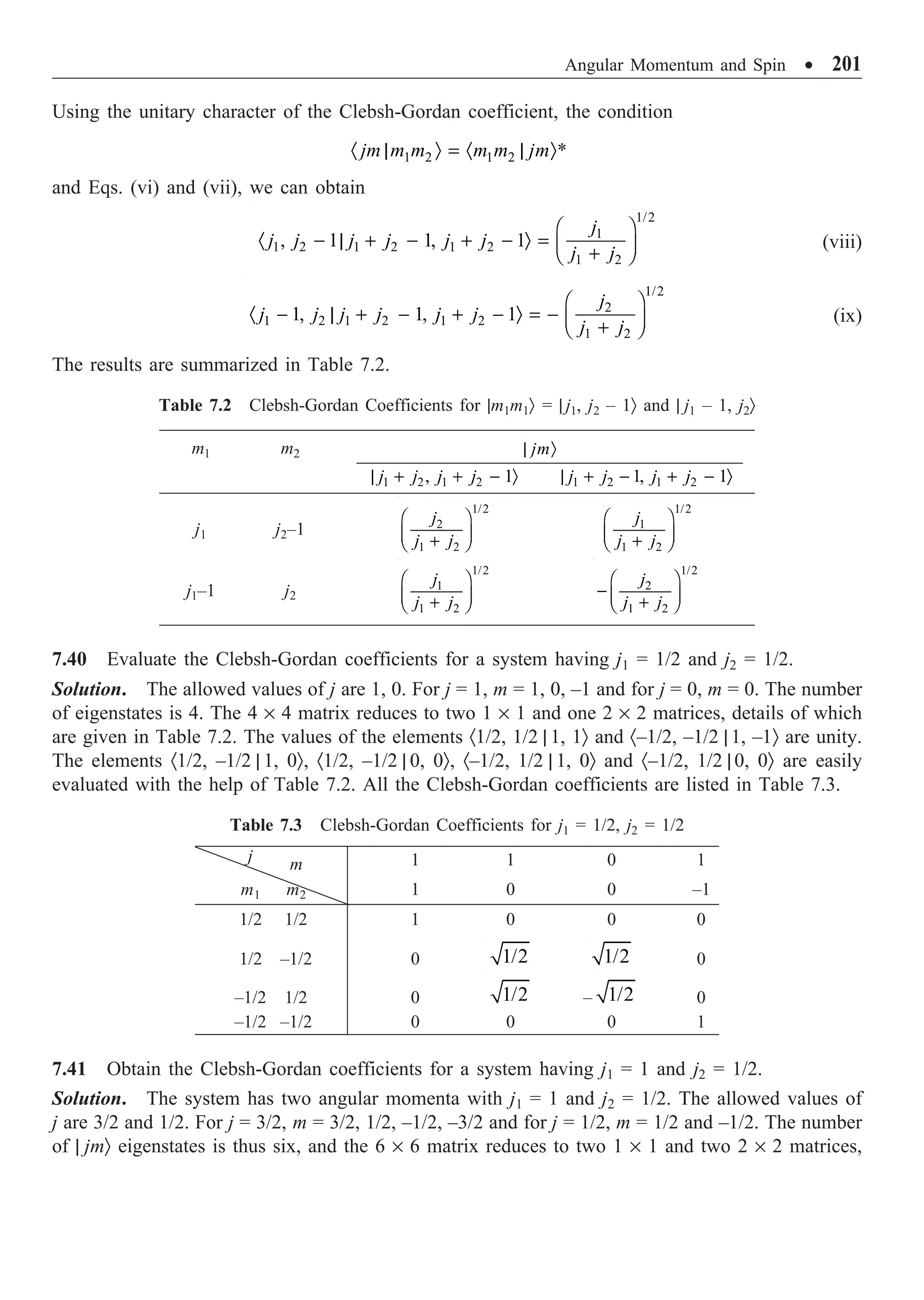
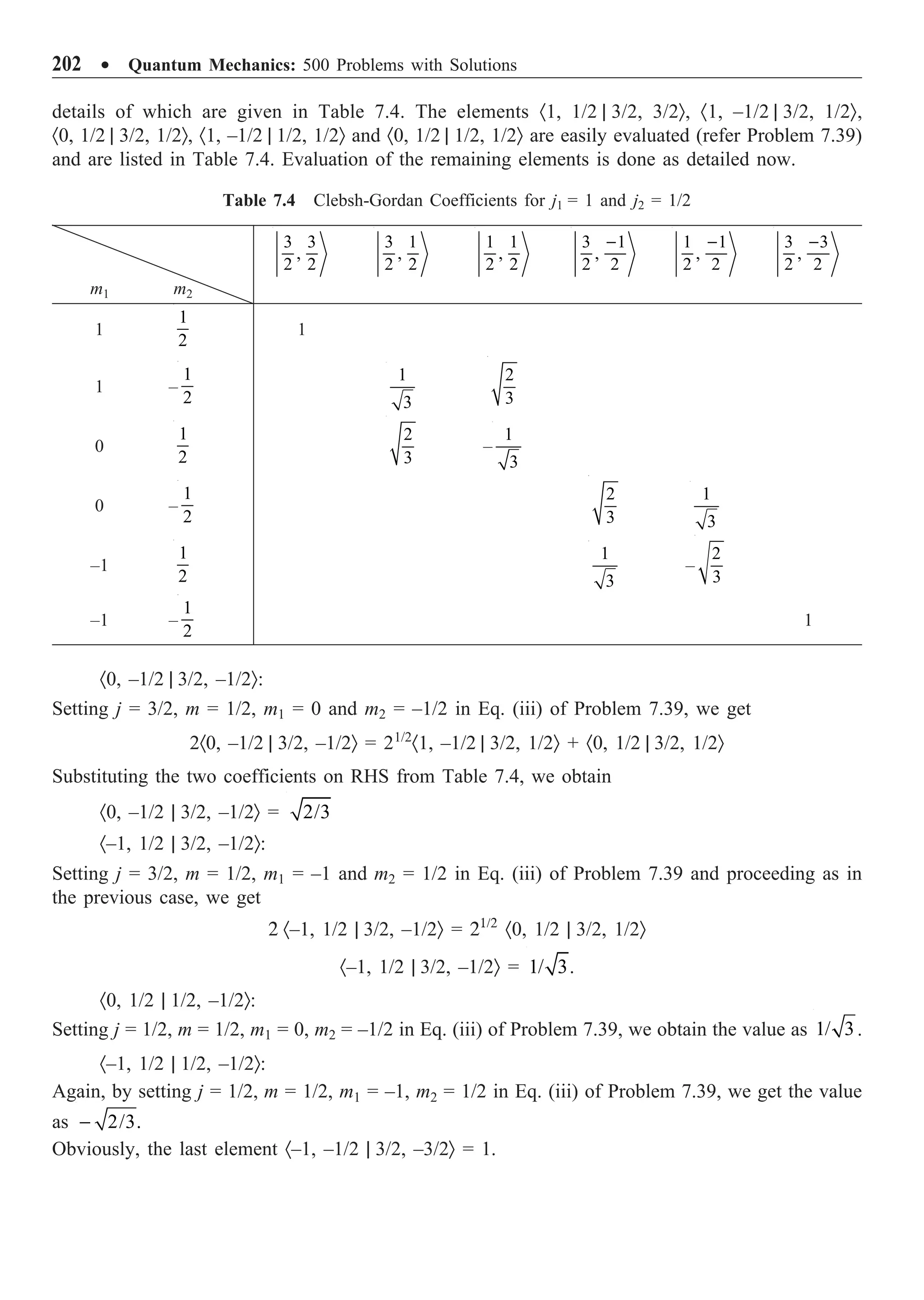
![Angular Momentum and Spin ∑ 203
7.42 Obtain the matrix of Clebsh-Gordan coefficients for j1 = 1 and j2 = 1.
Solution. The nonvanishing Clebsh-Gordan coefficients can be evaluated with the help of
Tables 7.2 and 7.5. These coefficients are
·1, 1 | 2, 2Ò = ·–1, –1 | 2, –2Ò = 1
·1, 0 | 2, 1Ò = ·1, 0 | 1, 1Ò = ·0, 1 | 2, 1Ò = ·0, 1 | 2, –1Ò = ·1, –1 | 1, –1Ò
= ·–1, 0 | 2 – 1Ò = ·1, –1 | 1, 0Ò = 1/ 2
·0, 1 | 1, 1Ò = ·–1, 1 | 1, 0Ò = ·–1, 0 | 1, –1Ò = –1/ 2
·1, –1 | 2, 0Ò = ·–1, 1 | 2, 0Ò = 1/ 6
·1, –1 | 0, 0Ò = ·–1, 1 | 0, 0Ò = 1/ 3
·0, 0 | 2, 0Ò = 2/3; ·0, 0 | 0, 0Ò = –1/ 3 ; ·0, 0 | 1, 0Ò = 0
Table 7.5 Clebsh-Gordan Coefficients for 1 2 1 2
, 2 ,
m m j j
| Ò = | - Ò 1 2
1, 1
j j
| - - Ò and 1 2
2,
j j
| - Ò
m1 m2 jm
| Ò
1 2 1 2
, 2
j j j j
| + + - Ò 1 2 1 2
1, 2
j j j j
| + - + - Ò 1 2 1 2
2, 2
j j j j
| + - + - Ò
j1 j2 – 2
1/2
2 2
1 2
(2 1)
( )
j j
j j A
-
È ˘
Í ˙
+
Î ˚
1/2
1 2
1 2
(2 1)
( )
j j
j j B
-
È ˘
Í ˙
+
Î ˚
1/2
1 1
(2 1)
j j
AB
-
È ˘
Í ˙
Î ˚
j1 – 2 j2 – 1
1/2
1 2
1 2
4
( )
j j
j j A
È ˘
Í ˙
+
Î ˚
1 2
1/2
1 2
[( ) ]
j j
j j B
-
+
1/2
1 2
(2 1)(2 1)
j j
AB
- -
È ˘
- Í ˙
Î ˚
j1 – 2 j2
1/2
1 1
1 2
(2 1)
( )
j j
j j A
-
È ˘
Í ˙
+
Î ˚
1/2
2 1
1 2
(2 1)
( )
j j
j j B
-
È ˘
- Í ˙
+
Î ˚
1/2
2 2
(2 1)
j j
AB
-
È ˘
Í ˙
Î ˚
A = 2j1 + 2j2 – 1, B = j1 + j2 – 1
7.43 An electron is in a state described by the wave function
1
(cos sin ) ( ),
4
i
e R r
f
y q q
p
-
= +
2 2
0
( ) 1
R r r dr
•
| | =
Ú
where q and f are, respectively, the polar and azimuth angles: (i) What are the possible values of
Lz? (ii) What is the probability of obtaining each of the possible values of Lz?
Solution.
(i) From Table 5.2 we have
1/2
10
3
cos ,
4
Y q
p
Ê ˆ
= Á ˜
Ë ¯
1/2
1, 1
3
sin
8
i
Y e f
q
p
-
-
Ê ˆ
= Á ˜
Ë ¯
Hence the given wave function can be written as
10 1, 1
1
( 2 ) ( )
3
Y Y R r
y -
= +
The possible values of Lz are 0 and .](https://image.slidesharecdn.com/quantummechanics500problemswithsolutionspdfdrive-220626164912-635041ea/75/Quantum-Mechanics_-500-Problems-with-Solutions-PDFDrive-pdf-213-2048.jpg)
![204 ∑ Quantum Mechanics: 500 Problems with Solutions
(ii) 2 2 2 2
10 1, 1
1
( ) ( 2 ) sin
3
d R r Y Y r d d dr
y t q q f
-
| | = | | | + |
Ú Ú
2
10 1, 1
( 2 )
Y Y -
| + | = 10 1, 1 10 1, 1
( 2 )* ( 2 )
Y Y Y Y
- -
+ +
= 10 10 1, 1 1, 1 10 1, 1 1, 1 10
* * * *
2 2( )
Y Y Y Y Y Y Y Y
- - - -
+ + +
= 2 2
3 3
(cos sin ) cos sin ( )
4 4
i i
e e
f f
q q q q
p p
-
+ + +
=
3
(1 sin 2 cos )
4
q f
p
+
2
d
y t
| |
Ú =
2
2 2
0 0 0
1
( ) sin (1 sin 2 cos )
4
R r r dr d d
p p
q q q f f
p
•
| | +
Ú Ú Ú
=
0
1
sin 1
2
d
p
q q =
Ú
i.e., the given wave function is normalized. The probability density is then P = |y |2
. Hence, the
probability of obtaining Lz = 0 is 2
(1/ 3) 1/3.
= The probability of obtaining Lz = –1 is
2
( 2/3) 2/3.
=
7.44 An operator P describing the interaction of two spin-half particles is P = a + bs1 ◊ s2, where
a, b are constants, with s1 and s2 being the Pauli matrices of the two spins. The total spin angular
momentum S = S1 + S2 = (1/2) (s1 + s2). Show that P, S2
and Sz can be measured simultaneously.
Solution. P, S2
and Sz can be measured simultaneously if
2 2
[ , ] [ , ] [ , ] 0
z z
P S P S S S
= = =
We know that [S2
, Sz] = 0. From the definition
2
2 2 2
1 1 1 2
( 2 )
4
S s s s s
= + + ◊
we have
2
2 2
1 2 1 2
2
2 1
( )
2
S
s s s s
◊ = - +
Since for each particle,
2 2 2 2
3
x y z I
s s s s
= + + =
where I is the unit matrix, we have
2 2
1 2
1 1
( ) (3 3 ) 3
2 2
I I I
s s
+ = + =
Hence,
s1 ◊ s1 =
2
2
2
3
S
I
-](https://image.slidesharecdn.com/quantummechanics500problemswithsolutionspdfdrive-220626164912-635041ea/75/Quantum-Mechanics_-500-Problems-with-Solutions-PDFDrive-pdf-214-2048.jpg)
![Angular Momentum and Spin ∑ 205
[S2
, P] =
2
2 2 2
1 2 2
2
[ , ] [ , ] , 3
S
S a b S b S I
È ˘
+ ◊ = -
Í ˙
Í ˙
Î ˚
s s
=
2
2 2
2
2
, [ , 3 ] 0
S
b S b S I
È ˘
- =
Í ˙
Í ˙
Î ˚
[Sz, P] = [Sz, a] +
2
2
2
, 3
z
S
b S I
È ˘
-
Í ˙
Í ˙
Î ˚
= 0
Since S2
and Sz commute with P, all the three can be measured simultaneously.
7.45 Obtain the Hamiltonian operator for a free electron having magnetic moment m in an external
magnetic field Bz in the z-direction in the electron’s reference frame. If another constant magnetic
field By is applied in the y-direction, obtain the time rate of change of m in the Heisenberg picture.
Solution. The magnetic moment of the electron is given by
2 B
e e
m m
m
= - = - = -
m s s
S
where S = 1/2 s and mB is the Bohr magneton. The Hamiltonian
B
z z z z
H B B
m m s
¢ = - ◊ = - =
m B
With the total magnetic field applied ˆ ˆ,
y z
B B y B z
= + the total Hamiltonian
H = mB (szBz + syBy)
From Eq. (3.30),
d
dt
m
= B B
1 1
[ , ] [ , ( )]
z z y y
H B B
i i
m m m s s
= - +
s
=
2
B ˆ ˆ ˆ
[ , ]
x y z z z y y
x y z B B
i
m
s s s s s
- + + +
=
2
B ˆ ˆ ˆ
[ , ] [ , ] [ , ]
x z z x y y y z z
B x B x B y
i
m
s s s s s s
- + +
ˆ ˆ ˆ
[ , ] [ , ] [ , ]
y y y z z z z y y
B y B z B z
s s s s s s
+ + +
Using the commutation relations among sx, sy, sz, we get
d
dt
m
= 2
B ˆ ˆ ˆ ˆ
[ 2 2 2 2 ]
y z z y x z x y
i
i B x i B x i B y i B z
m s s s s
- + + -
= 2
B
2
ˆ ˆ ˆ
[( ) ]
y z z y x z x y
B B x B y B z
m s s s s
- - +
= 2 2
B B
2 2
[ ] [ ]
m m
¥ = - ¥
s s
B B
= [ ]
e
m
¥ m
B
which is the time rate of change of the magnetic moment.](https://image.slidesharecdn.com/quantummechanics500problemswithsolutionspdfdrive-220626164912-635041ea/75/Quantum-Mechanics_-500-Problems-with-Solutions-PDFDrive-pdf-215-2048.jpg)
![206 ∑ Quantum Mechanics: 500 Problems with Solutions
7.46 Obtain the energy levels of a symmetric top molecule with principal moments of inertia
I1 = I2 = I π I3.
Solution. Let (x, y, z) be the coordinates of a body-fixed coordinate system. The Hamiltonian
H =
2 2
2
2 2 2
1 2 3 3
1 1 1
( )
2 2 2
y z
x
x y z
L L
L
L L L
I I I I I
Ê ˆ
+ + = + +
Á ˜
Ë ¯
= 2 2
3
1 1 1 1
2 2 z
L L
I I I
Ê ˆ
+ -
Á ˜
Ë ¯
|lmÒ are the simultaneous eigenkets of L2
and Lz. The Schrödinger equation is
2 2
3
1 1 1 1
2 2 z
L L lm E lm
I I I
È ˘
Ê ˆ
+ - | Ò = | Ò
Í ˙
Á ˜
Ë ¯
Î ˚
2 2
2
3
1 1
( 1)
2 2
lm
E l l m
I I I
Ê ˆ
= + + -
Á ˜
Ë ¯
which is the energy equation for symmetric top. This energy equation can be expressed in the
familiar form by writing
2
,
2
B
I
=
2
3
2
C
I
=
Elm = Bl (l + 1) + (C – B) m2
The constants B and C are rotational constants.
l = 0, 1, 2, º; m = 0, ±1, ±2, º, ±l
7.47 The kets | j, mÒ are the simultaneous eigenkets of J2
and Jz. Show that | j, mÒ are also eigenkets
of [Jx, J+] and of [Jy, J+]. Find the eigenvalues of each of these commutators.
Solution. Operating [Jx, J+] on the eigenkets | jmÒ, we obtain
[Jx, J+] | jmÒ = Jx J+ | jmÒ – J+Jx | jmÒ
=
1 1
( ) ( )
2 2
J J J jm J J J jm
+ - + + + -
+ | Ò - + | Ò
=
1 1 1 1
2 2 2 2
J J jm J J jm J J jm J J jm
+ + - + + + + -
| Ò - | Ò - | Ò - | Ò
=
1 1
2 2
J J jm J J jm
- + + -
| Ò - | Ò
From Problem 7.14,
J–J+ = J2
– Jz
2
– Jz, J+J– = J2
– Jz
2
+ Jz
Hence,
[Jx, J+] | jmÒ = 2 2 2 2
1 1
( ) ( )
2 2
z z z z
J J J jm J J J jm
- - | Ò - - + | Ò
= 2
z
J jm m jm
- | Ò = - | Ò](https://image.slidesharecdn.com/quantummechanics500problemswithsolutionspdfdrive-220626164912-635041ea/75/Quantum-Mechanics_-500-Problems-with-Solutions-PDFDrive-pdf-216-2048.jpg)
![Angular Momentum and Spin ∑ 207
i.e., | jmÒ are eigenkets of [Jx, J+] with eigenvalues –m2
. Now,
[Jy, J+] | jmÒ = ( )
y y
J J J J jm
+ +
- | Ò
=
1 1
( ) ( )
2 2
J J J jm J J J jm
i i
+ - + + + -
- | Ò - - | Ò
=
1 1
2 2
J J jm J J jm
i i
- + + -
- | Ò + | Ò
= 2 2 2 2
1 1
( ) ( )
2 2
z z z z
J J J jm J J J jm
i i
- - - | Ò + - + | Ò
= 2
1 1
)
z
J jm m jm
i i
| Ò = | Ò
= 2
im jm
- | Ò
That is, | jmÒ are eigenkets of the commutator [Jy, J+] with the eigenvalue –im2
.
7.48 The state of the hydrogen atom is 2p state. Find the energy levels of the spin-orbit interaction
Hamiltonian AL ◊ S, where A is a constant.
Solution. The 2p state means s = 1/2, l = 1 and j = 1 + (1/2) = (3/2) or 1 – (1/2) = (1/2). The total
angular momentum
J = L + S (i)
J2
= L2
+ S2
+ 2L ◊ S
2 2 2
( )
2
so
A
H A J L S
= ◊ = - -
L S (ii)
The eigenvector associated with the variable J2
, Jz, L2
, S2 be | jmlsÒ. In this space,
2 2
( 1)
J jmls j j jmls
| Ò = + | Ò
(iii)
2 2
( 1)
S jmls s s jmls
| Ò = + | Ò
(iv)
2 2
( 1)
L jmls l l jmls
| Ò = + | Ò
(v)
Using Eqs. (ii)–(v), the energy eigenvalue of Hso is given by
j =
3
2
: Eso = 2 2 2
15 3
2
2 4 4
A È ˘
- -
Í ˙
Î ˚
= 2
2
A
j =
1
2
: Eso = 2 2 2
3 3
2
2 4 4
A È ˘
- -
Í ˙
Î ˚
= 2
A
-](https://image.slidesharecdn.com/quantummechanics500problemswithsolutionspdfdrive-220626164912-635041ea/75/Quantum-Mechanics_-500-Problems-with-Solutions-PDFDrive-pdf-217-2048.jpg)
![208 ∑ Quantum Mechanics: 500 Problems with Solutions
7.49 The Hamiltonian of a system of 3 nonidentical spin-half particles is
H = AS1 ◊ S2 – B(S1 + S2) ◊ S3
where A and B are constants are S1, S2 and S3 are the spin angular momentum operators. Find their
energy levels and their degeneracies.
Solution. Writing S = S1 + S2 + S3 and S12 = S1 + S2, we have
2 2 2
12 3 12 3
2
S S S
= + + ◊
S S
2 2 2
12 3 12 3
1
( )
2
S S S
◊ = - -
S S
Similarly,
2 2 2
1 2 12 1 2
1
( )
2
S S S
◊ = - -
S S
since S1 = 1/2 and S2 = 1/2, the possible values of the quantum number S12 = 0 and 1. When
S12 = 0, the possible values of S = 1/2 and 1/3. The Hamiltonian
H = AS1◊S2 – B(S1 + S2) ◊ S3
= 2 2 2 2 2 2
12 1 2 12 3
( ) ( )
2 2
A B
S S S S S S
- - + - -
In the basis | SMsS12S3Ò,
H | SMsS12S3Ò = 2 2 2 2 2 2
12 1 2 12 3 12 3 12 3
( ) ( )
2 2
s s
A B
S S S SM S S S S S SM S S
- - | Ò + - - | Ò
The energy is then,
E = 2
12 12 1 1 2 2
[ ( 1) ( 1) ( 1)]
2
A
S S S S S S
+ - + - +
2
12 12 3 3
[ ( 1) ( 1) ( 1)]
2
B
S S S S S S
+ + - + - +
since S1 = S2 = S3 = 1/2. Now,
12
2 2
, 12 12 12 12
3 3
( 1) ( 1) ( 1)
2 2 2 4
S S
A B
E S S S S S S
È ˘ È ˘
= + - + + - + -
Í ˙ Í ˙
Î ˚ Î ˚
As S = 1/2 when S12 = 0,
2
0,1/2
3
4
E = -
which is 2S + 1 = 2-fold degenerate. As S = 1/2 and 3/2, when S12 = 1,
E1,1/2 = 2 2
3 3 3
2 2
4 2 4 4 4
A B
Ê ˆ Ê ˆ
- + - -
Á ˜ Á ˜
Ë ¯ Ë ¯
=
2 2 2
4 4
A A
B B
Ê ˆ
- = -
Á ˜
Ë ¯](https://image.slidesharecdn.com/quantummechanics500problemswithsolutionspdfdrive-220626164912-635041ea/75/Quantum-Mechanics_-500-Problems-with-Solutions-PDFDrive-pdf-218-2048.jpg)
![Angular Momentum and Spin ∑ 209
which is 2S + 1 = 2-fold degenerate. We also have
E1,3/2 =
2 2
3 15 3
2 2
2 2 2 4 4
A B
Ê ˆ Ê ˆ
- + - -
Á ˜ Á ˜
Ë ¯ Ë ¯
=
2
4 2
A B
Ê ˆ
+
Á ˜
Ë ¯
which is four-fold degenerate.
7.50 Two electrons having spin angular momentum vectors S1 and S2 have an interaction of the
type
H = A(S1 ◊ S2 – 3S1z S2z), A being constant
Express it in terms of S = S1 + S2 and obtain its eigenvalues.
Solution. The sum of the angular momenta S1 and S2 is
S = S1 + S2 (i)
S2
= 2 2
1 2 1 2
2
+ +
S S S S
S1 ◊ S2 = 2 2 2
1 2
1
( )
2
S S S
- - (ii)
From Eq. (i),
Sz = S1z + S2z
2
z
S = 2 2 2
1 2 1 2 1 2
( ) 2
z z z z z z
S S S S S S
+ = + +
S1zS2z = 2 2 2
1 2
1
( )
2 z z z
S S S
- - (iii)
Hence,
2 2 2 2 2 2
1 2 1 2 1 2 1 2
1 3
3 ( ) ( )
2 2
z z z z z
S S S S S S S S
◊ - = - - - - -
S S (iv)
In the simultaneous eigenkets | SMÒ of S2
and Sz,
1 2 1 2
( 3 )
z z
A S S SM
◊ - | Ò
S S
= 2 2 2 2 2 2
1 2 1 2
3
( ) ( )
2 2 z z z
A A
S S S SM S S S SM
- - | Ò - - - | Ò
=
2 2 2
1 3 1 3 3 1 1
( 1)
2 2 2 2 2 2 4 4
A A
S S SM M SM
È ˘ Ê ˆ
+ - ¥ - ¥ | Ò - - - | Ò
Á ˜
Í ˙ Ë ¯
Î ˚
= 2 2
[ ( 1) 3 ]
2
A
S S M SM
+ - | Ò
(v)
Since S = S1 + S2, the quantum number S can have the values
1 1
1
2 2
+ = or
1 1
0.
2 2
- = When
S = 0, M = 0 and when S = 1, M = 1, 0, –1. The eigenkets and the corresponding eigenvalues, see
Eq. (v), are as follows:](https://image.slidesharecdn.com/quantummechanics500problemswithsolutionspdfdrive-220626164912-635041ea/75/Quantum-Mechanics_-500-Problems-with-Solutions-PDFDrive-pdf-219-2048.jpg)
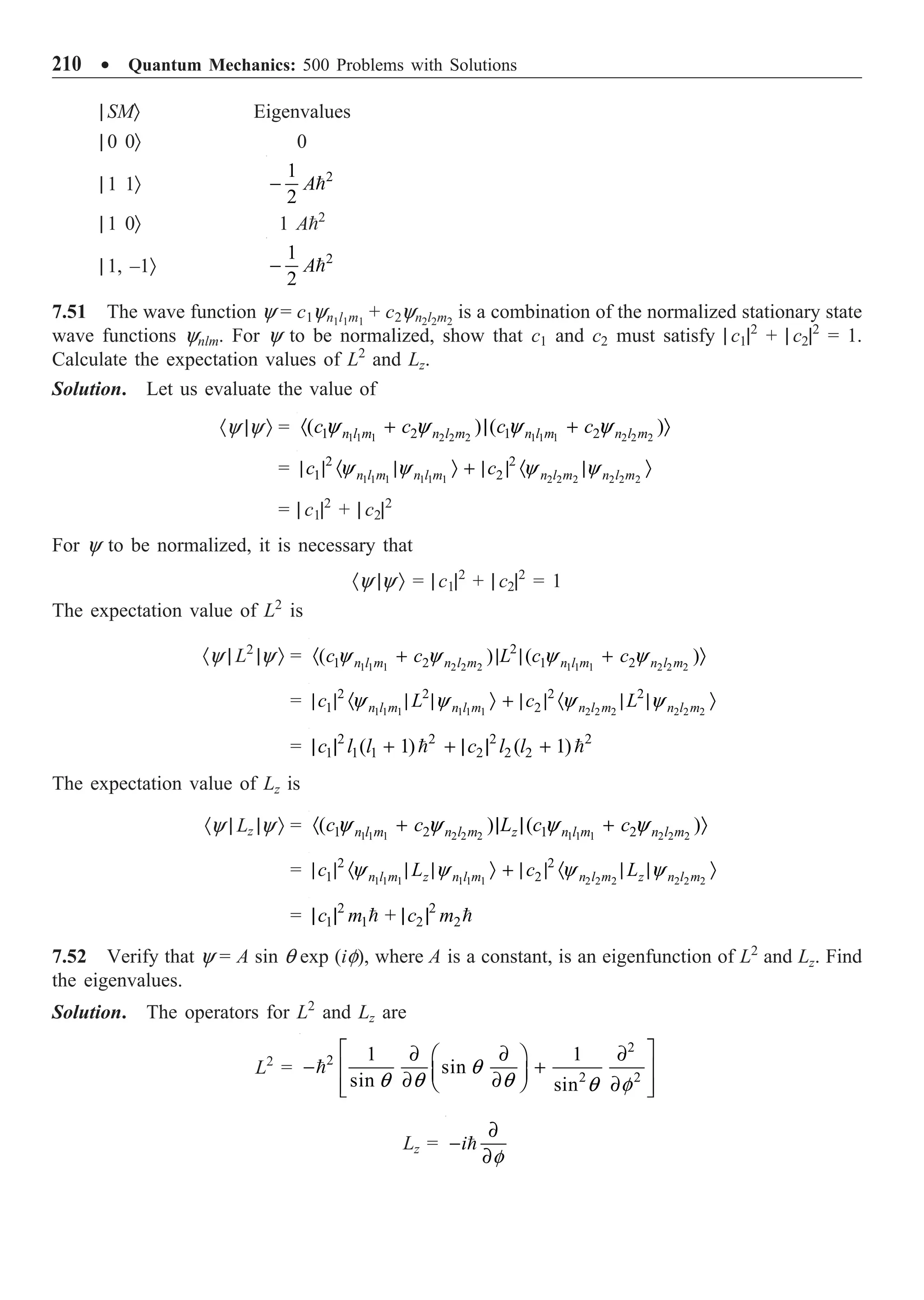
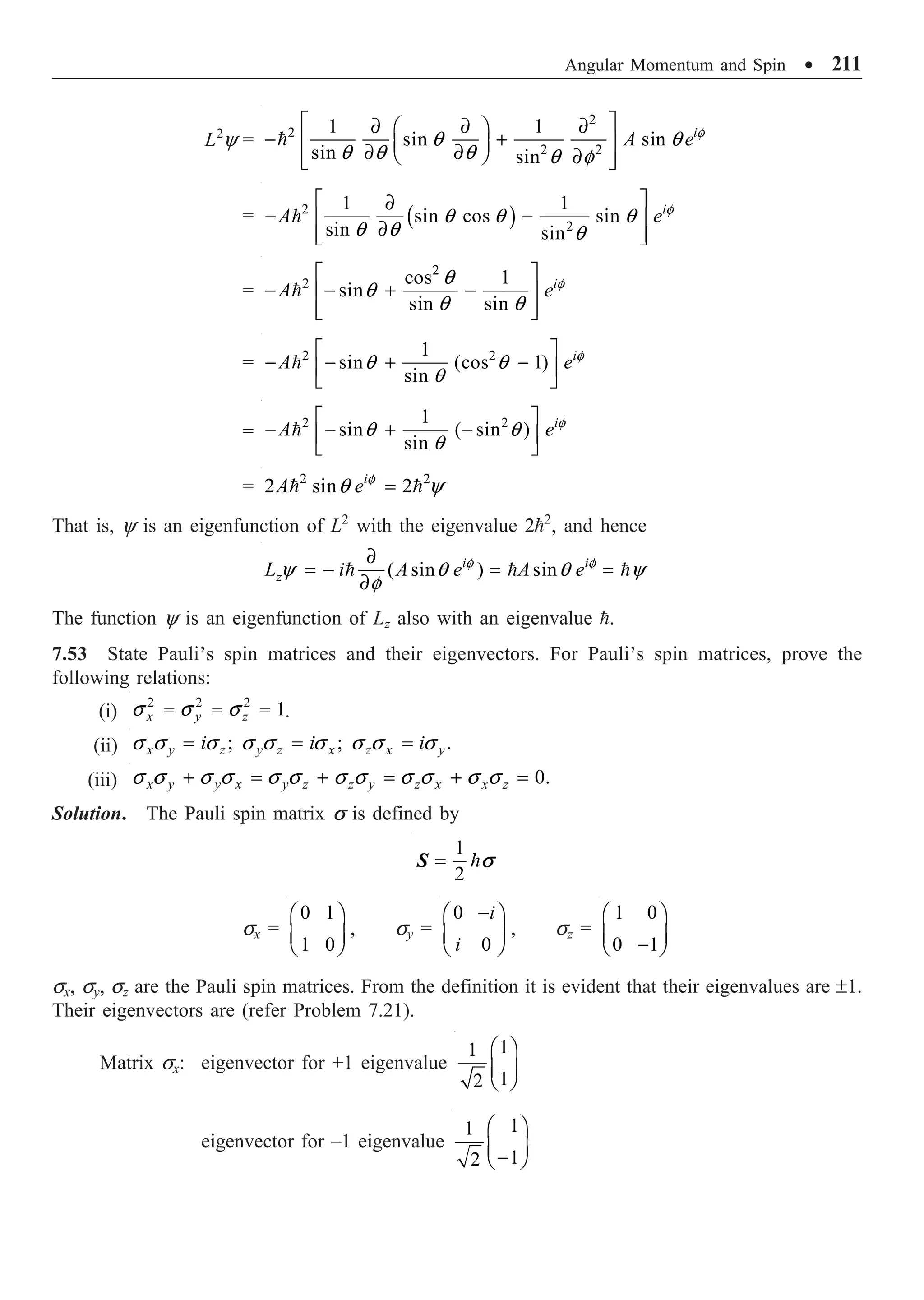
![212 ∑ Quantum Mechanics: 500 Problems with Solutions
Matrix sy: eigenvector for +1 eigenvalue
1
1
2 i
Ê ˆ
Á ˜
Ë ¯
eigenvector for –1 eigenvalue
1
1
2 i
Ê ˆ
Á ˜
-
Ë ¯
Matrix sz: eigenvector for +1 eigenvalue
1
1
0
2
Ê ˆ
Á ˜
Ë ¯
eigenvector for –1 eigenvalue
0
1
1
2
Ê ˆ
Á ˜
Ë ¯
(i) 2
0 1 0 1 1 0
1 0 1 0 0 1
x I
s
Ê ˆ Ê ˆ Ê ˆ
= = =
Á ˜ Á ˜ Á ˜
Ë ¯ Ë ¯ Ë ¯
Similarly, 2 2
1.
y z
s s
= =
(ii)
0 1 0 0 1 0
1 0 0 0 0 1
x y z
i i
i i
i i
s s s
-
Ê ˆ Ê ˆ Ê ˆ Ê ˆ
= = = =
Á ˜ Á ˜ Á ˜ Á ˜
- -
Ë ¯ Ë ¯ Ë ¯ Ë ¯
The same procedure gives the other relations.
(iii) x y y x
s s s s
+ =
0 1 0 0 0 1
1 0 0 0 1 0
i i
i i
- -
Ê ˆ Ê ˆ Ê ˆ Ê ˆ
+
Á ˜ Á ˜ Á ˜ Á ˜
Ë ¯ Ë ¯ Ë ¯ Ë ¯
=
0 0
0
0 0
i i
i i
-
Ê ˆ Ê ˆ
=
Á ˜ Á ˜
-
Ë ¯ Ë ¯
The same procedure proves the other relations too.
7.54 The kets | jmÒ are the simultaneous eigenkets of J2
and Jz with eigenvalues j( j + 1)2
and m,
respectively. Show that:
(i) J+ | jmÒ and J– | jmÒ are also eigenkets of J2
with the same eigenvalue.
(ii) J+ | jmÒ is an eigenket of Jz with the eigenvalue (m + 1).
(iii) J– | jmÒ is an eigenket of Jz with the eigenvalue (m – 1).
(iv) Comment on the results.
Solution. Given
J2
| jmÒ = j( j + 1)2
| jmÒ (i)
Jz | jmÒ = m | jmÒ (ii)
(i) Operating Eq. (i) from left by J+ and using the result [J2, J+] = 0, we have
J+J2
| jmÒ = j( j + 1)2
J+ | jmÒ
J2
J+ | jmÒ = j( j + 1)2
J+ | jmÒ
Similarly,
J2
J– | jmÒ = j( j + 1)2
J– | jmÒ](https://image.slidesharecdn.com/quantummechanics500problemswithsolutionspdfdrive-220626164912-635041ea/75/Quantum-Mechanics_-500-Problems-with-Solutions-PDFDrive-pdf-222-2048.jpg)
![Angular Momentum and Spin ∑ 213
(ii) Operating Eq. (ii) from left by J+, we get
J+Jz | jmÒ = m J+ | jmÒ
Since [Jz, J+] = J+, J+ Jz = Jz J+ – J+.
we have
(Jz, J+ – J+) | jmÒ = mJ+ | jmÒ
Jz J+ | jmÒ = (m + 1) J+ | jmÒ
(iii) Operating Eq. (ii) from left by J– and using the result [Jz, J–] = –J–, we get
Jz J– | jmÒ = (m – 1) J– | jmÒ
(iv) J+ | jmÒ is an eigenket of Jz with the eigenvalue (m + 1) and of J2
with the same eigenvalue
j( j + 1)2
. Since operation by J+ generates a state with the same magnitude of angular
momentum but with a z-component higher by , J+ is called a raising operator. Similarly,
J– is called a lowering operator.
7.55 The two spin – half particles are described by the Hamiltonian
H = A (S1z + S2z) + B(S1 ◊ S2)
where A and B are constants and S1 and S2 are the spin angular momenta of the two spins. Find the
energy levels of the system.
Solution. Let the total angular momentum
S = S1 + S2, Sz = S1z + S2z
2 2 2
1 2 1 2
1
( )
2
S S S
◊ = - -
S S
Let the spin quantum number associated with S1 be s1 and that with S2 be S2. Since S1 = 1/2 and
S2 = 1/2, the possible values of S are 0 and 1. When S = 0, the possible values of Ms = 0. When
S = 1, the possible values of Ms = 1, 0, –1. The Hamiltonian
H = 1 2 1 2
( ) ( )
z z
A S S B
+ + ◊
S S
2 2 2
1 2
( )
2
z
B
AS S S S
+ - -
Selecting | SMsS1S2Ò as the eigenkets, we get
2 2 2
1 2 1 2 1 2 1 2
( )
2
s z s s
B
H SM S S AS SM S S S S S SM S S
| Ò = | Ò + - - | Ò
The energy
Es,Ms
= 2 3 3
( 1)
2 4 4
s
B
AM S S
È ˘
+ + - -
Í ˙
Î ˚
E0,0 = 2
3
4
B
-
E1,1 = 2
4
B
A +](https://image.slidesharecdn.com/quantummechanics500problemswithsolutionspdfdrive-220626164912-635041ea/75/Quantum-Mechanics_-500-Problems-with-Solutions-PDFDrive-pdf-223-2048.jpg)

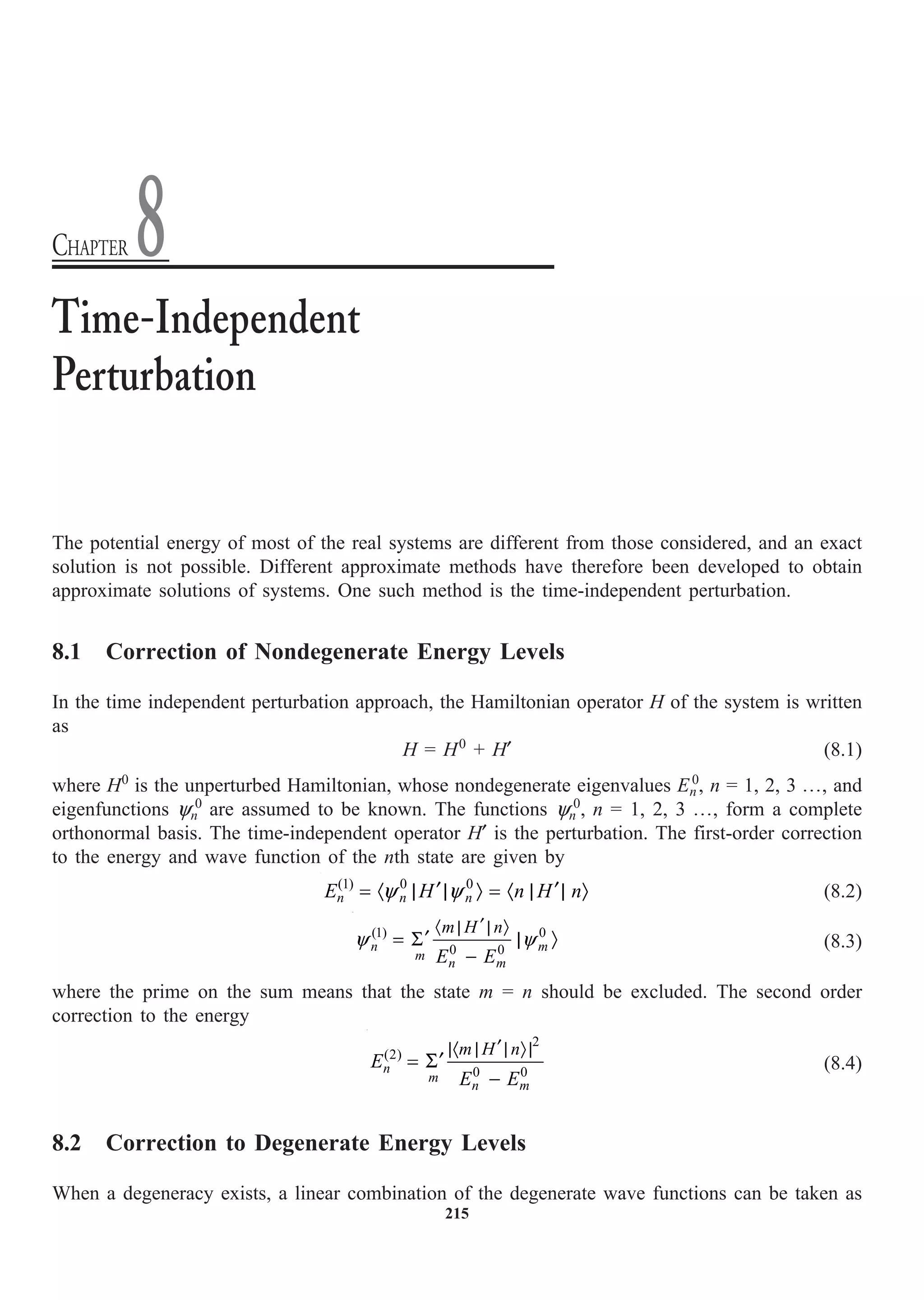
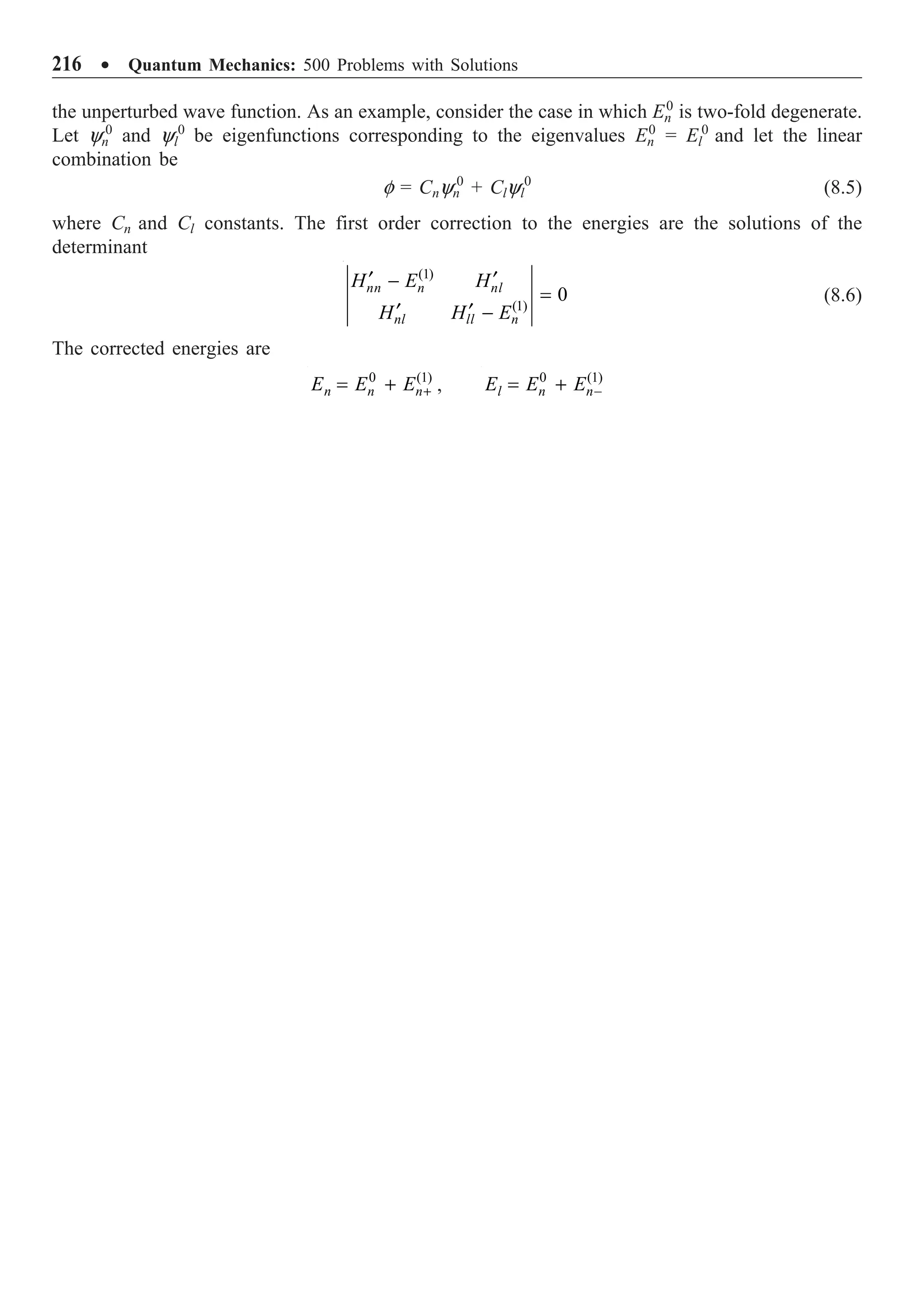
![Time-Independent Perturbation ∑ 217
PROBLEMS
8.1 Calculate the first order correction to the ground state energy of an anharmonic oscillator of
mass m and angular frequency w subjected to a potential V(x) = 1/2 mw2
x2
+ bx4
, where b is a
parameter independent of x. The ground state wave function is
1/4 2
0
0 exp
2
m m x
w w
y
p
Ê ˆ
Ê ˆ
= -
Á ˜ Á ˜
Ë ¯ Ë ¯
Solution. The first order correction to the ground state energy
1/2 2
(1) 0 0 4
0 0
0 exp
m m x
E H b x dx
w w
y y
p
•
-•
Ê ˆ
Ê ˆ
¢
= · | | Ò = -
Á ˜ Á ˜
Ë ¯ Ë ¯
Ú
Using the result given in the Appendix, we get
1/2 5/2 2
(1)
0 2 2
3 3
2
8 4
m b
E b
m m
w p
p w w
Ê ˆ Ê ˆ
= ◊ =
Á ˜ Á ˜
Ë ¯ Ë ¯
8.2 A simple harmonic oscillator of mass m0 and angular frequency w is perturbed by an additional
potential bx3
. Evaluate the second order correction to the ground state energy of the oscillator.
Solution. The second order correction to the ground state energy is given by
2
(2)
0 0 0
0
0
,
m
m
H m
E
E E
¢
|· | | Ò|
¢
= S
-
H¢ = bx3
In terms of a†
and a,
1/2
†
0
( )
2
x a a
m w
Ê ˆ
= +
Á ˜
Ë ¯
·0 | x3
| mÒ =
3/2
0
2m w
È ˘
Í ˙
Î ˚
·0 | (a + a†
)(a + a†
)(a + a†
) | mÒ, m = 1, 2, 3, …
=
3/2
0
2m w
Ê ˆ
Á ˜
Ë ¯
[·0 | aaa | 3Ò + ·0 | aaa†
+ aa†
a |1Ò]
The other contributions vanish. For the nonvanishing contributions, we have
·0 | aaa | 3Ò = 6 , ·0 | aaa†
+ aa†
a | 1Ò = 2 + 1 = 3
3 2 2
(2) 2
0 3 4
0 0
6 9 11
2 3 8
b
E b
m m
w w w w
Ê ˆ Ê ˆ
= + = -
Á ˜
Á ˜ - -
Ë ¯
Ë ¯
8.3 Work out the splitting of the 1
P Æ 1
S transition of an atom placed in a magnetic field B along
the z-axis.
Solution. For 1
P level, S = 0 and, therefore, the magnetic moment of the atom is purely orbital. The
interaction energy between magnetic moment and the field is
0
2
z Z
e
H B L B
m
m
¢ = - =](https://image.slidesharecdn.com/quantummechanics500problemswithsolutionspdfdrive-220626164912-635041ea/75/Quantum-Mechanics_-500-Problems-with-Solutions-PDFDrive-pdf-227-2048.jpg)
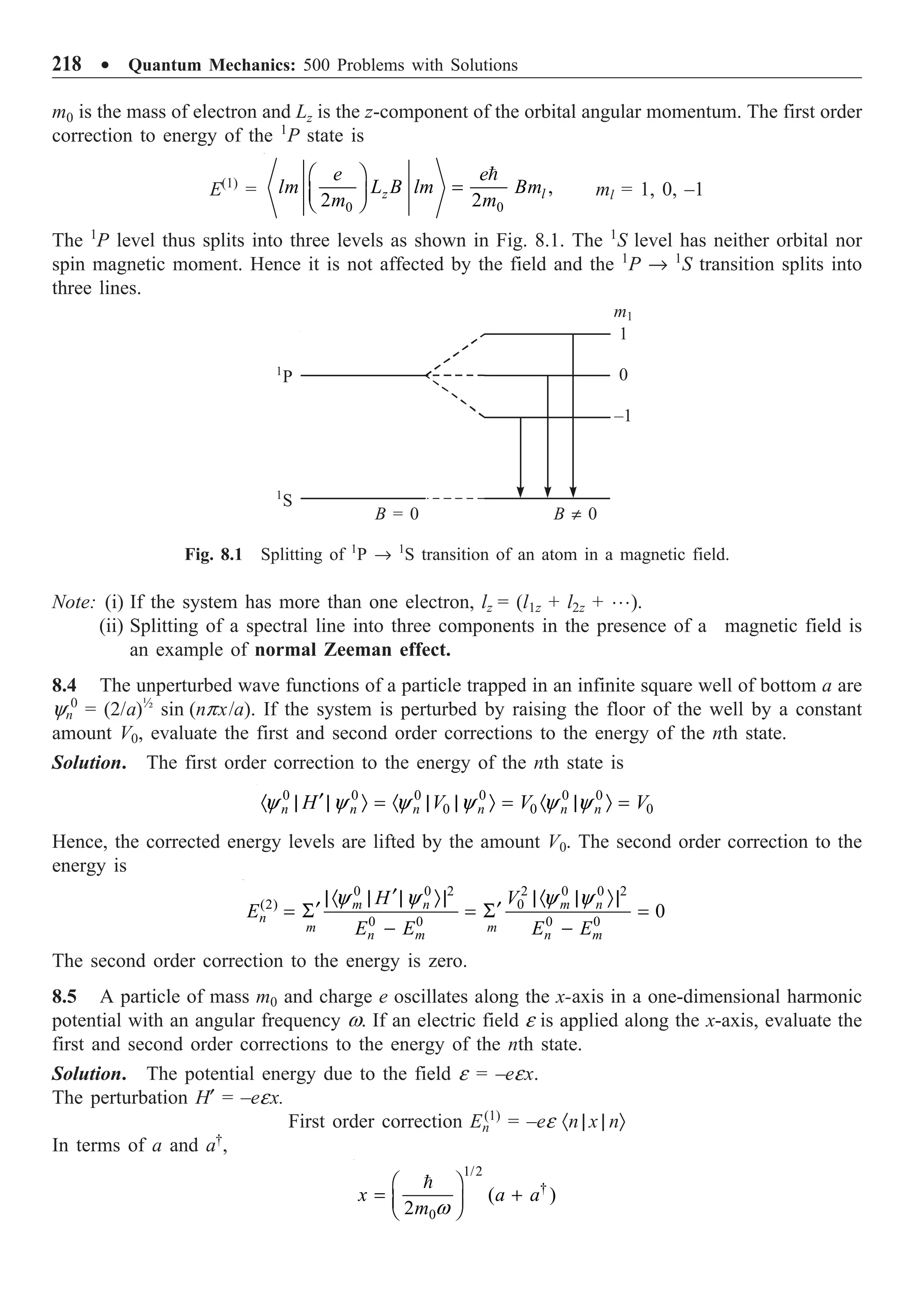
![Time-Independent Perturbation ∑ 219
En
(1)
=
1/2
†
0
( ) 0
2
e n a a n
m
e
w
Ê ˆ
- · | + | Ò =
Á ˜
Ë ¯
En
(2)
=
2
0 0
m
n m
n H m
E E
¢
|· | | Ò|
¢
S
-
1/2
†
0
2
n H m e n a a m
m
e
w
Ê ˆ
¢
· | | Ò = - · | + | Ò
Á ˜
Ë ¯
Here, m can take all integral values except n. The nonvanishing elements correspond to m = (n +
1) and (n – 1). Hence,
2 2 2 2
(2) 2 2
2
0 0
( 1) ( )
2 2
n
n n e
E e
m m
e
e
w w w w
È ˘
+
= + = -
Í ˙
-
Í ˙
Î ˚
8.6 Evaluate the first and second order correction to the energy of the n = 1 state of an oscillator
of mass m and angular frequency w subjected to a potential
V(x) =
1
2
mw2
x2
+ bx, bx
1
2
mw2
x2
Solution. The first order correction to energy for the n = 1 state is given by
(1)
1
E =
1/2
†
1 1 1 ( ) 1
2
bx b a a
mw
Ê ˆ
· | | Ò = · | + | Ò
Á ˜
Ë ¯
=
1/2
†
[ 1 1 1 1 ] 0
2
b a a
mw
Ê ˆ
· | | Ò + · | | Ò =
Á ˜
Ë ¯
Since ( 1)
a n n n
| Ò = | - Ò and †
1 ( 1) ,
a n n n
| Ò = + | + Ò
(2)
1
E =
† 2
2 2
0 0 0 0 0 0
1 1 0 1 2
1 ( ) 1 2
2 2
k
a a k
b b
m m
E E E E E E
w w
È ˘
|· | + | Ò|
Ê ˆ Ê ˆ
¢
S = +
Í ˙
Á ˜ Á ˜
Ë ¯ Ë ¯
- - -
Í ˙
Î ˚
=
2
2
2
1 2
2 2
b
b
m m
w w w w
Ê ˆ Ê ˆ
- = -
Á ˜ Á ˜
Ë ¯ Ë ¯
8.7 Calculate the ground state energy up to first order of the anharmonic oscillator having a
potential energy V = 1/2 mw2
x2
+ ax3
; ax3
1/2 mw2
x2
, where a is independent of x.
Solution. (1) 3
0 0 0 .
E ax
= · | | Ò The integrand of this integral is an odd function of x and, therefore,
the first order correction to the ground state energy is zero.
8.8 Evaluate the first order correction to the energy of the nth state of the anharmonic oscillator
having the potential energy
V =
1
2
mw2
x2
+ bx4
, bx4
1
2
mw2
x2](https://image.slidesharecdn.com/quantummechanics500problemswithsolutionspdfdrive-220626164912-635041ea/75/Quantum-Mechanics_-500-Problems-with-Solutions-PDFDrive-pdf-229-2048.jpg)
![220 ∑ Quantum Mechanics: 500 Problems with Solutions
Solution.
(1)
n
E = n H n
¢
· | | Ò = 4
b n x n
· | | Ò
=
2
† † † †
( )( )( )( )
2
b n a a a a a a a a n
mw
Ê ˆ
· | + + + + | Ò
Á ˜
Ë ¯
The six nonvanishing matrix elements are
1. † †
( ( 1)( 2)
n aaa a n n n
· | | Ò = + +
2. † † 2
( ( 1)
n aa aa n n
· | | Ò = +
3. † †
( ( 1)
n aa a a n n n
· | | Ò = +
4. † †
( ( 1)
n a aaa n n n
· | | Ò = +
5. † † 2
(
n a aa a n n
· | | Ò =
6. † †
( ( 1)
n a a aa n n n
· | | Ò = -
Now,
(1)
n
E =
2
2 2
[( 1)( 2) ( 1) 2 ( 1) ( 1)]
2
b n n n n n n n n
mw
Ê ˆ
+ + + + + + + + -
Á ˜
Ë ¯
=
2
2
3 (2 2 1)
2
b n n
mw
Ê ˆ
+ +
Á ˜
Ë ¯
8.9 A simple harmonic oscillator of mass m and angular frequency w is perturbed by an additional
potential 1/2 bx2
. Obtain the first and second order corrections to the ground state energy.
Solution.
(1)
0
E =
2 † †
1 1
0 0 0 ( )( ) 0
2 2 2
b x b a a a a
mw
Ê ˆ
· | | Ò = · | + + | Ò
Á ˜
Ë ¯
=
†
1
0 ( 0
2 2 4
b
b aa
m m
w w
Ê ˆ
· | | Ò =
Á ˜
Ë ¯
(2)
0
E =
2
0 0
0
0
n
n
H n
E E
¢
|· | | Ò|
¢
S
-
0 H n
¢
· | | Ò =
† † † †
1
0 ,
2 2
b aa aa a a a a n
mw
Ê ˆ
· | + + + | Ò
Á ˜
Ë ¯
n π 0
= 0 ,
4
b
aa n
mw
· | | Ò
n = 2
=
2
4
b
mw
2 2 2
(2)
0 2 2 2 3
2 1
2
16 16
b b
E
m m
w
w w
= - = -
since E0 – E2 = –2w](https://image.slidesharecdn.com/quantummechanics500problemswithsolutionspdfdrive-220626164912-635041ea/75/Quantum-Mechanics_-500-Problems-with-Solutions-PDFDrive-pdf-230-2048.jpg)
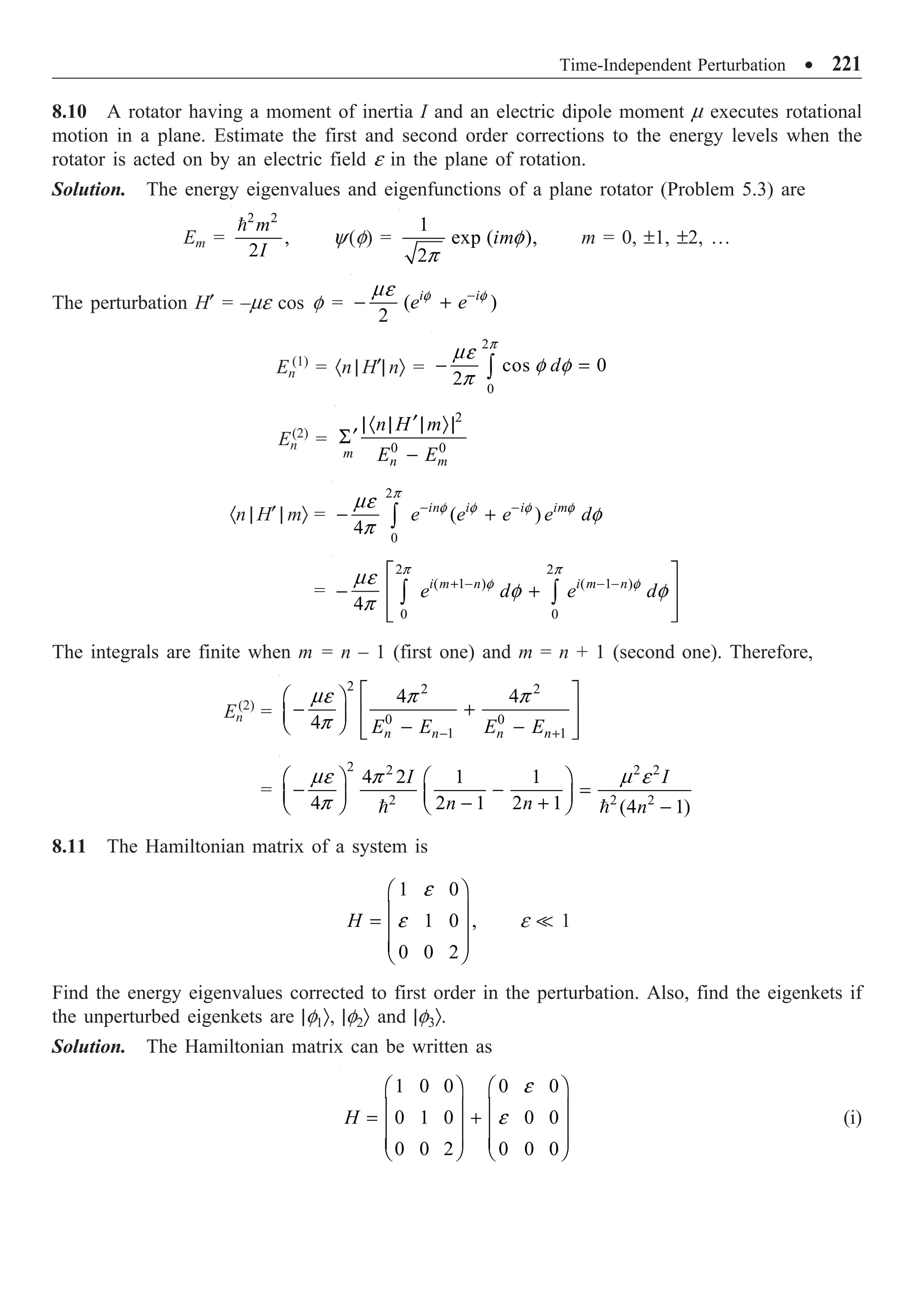
![222 ∑ Quantum Mechanics: 500 Problems with Solutions
In this form, we can identify the unperturbed part H0
and the perturbation H¢ as
0
1 0 0
0 1 0
0 0 2
H
Ê ˆ
Á ˜
=
Á ˜
Á ˜
Ë ¯
0 0
0 0
0 0 0
H
e
e
Ê ˆ
Á ˜
¢ =
Á ˜
Á ˜
Ë ¯
(ii)
The unperturbed energies are 1, 1, 2 units. The energy 1 units are two-fold degenerate. The secular
determinant corresponding to H¢ is
(1)
(1)
(1)
0
0 0
0 0
E
E
E
e
e
-
- =
-
or
2
(1) 2
0
E e
- = and E(1)
= 0
where E(1)
is the first order correction. The solution gives
E(1)
= e, –e, 0 (iii)
Hence, the state | f3Ò is not affected by the perturbation. The eigenkets corresponding to states 1 and
2 can easily be obtained. Let these states be
1 1 2 2 ,
n c c
f f f
¢ = | Ò + | Ò n = 1, 2 (iv)
The coefficients must obey the condition
–E(1)
c1 + ec2 = 0 (v)
For the eigenvalue E(1)
= e, this equation reduces to
–ec1 + ec2 = 0 or c1 = c2
Normalization gives c1 = c2 = 1/ 2 . Hence,
1 1 2
1
[ ]
2
f f f
¢ = | Ò + | Ò (vi)
With the value E(1)
= –e, Eq. (v) reduces to
ec1 + ec2 = 0 or c1 = –c2
Normalization gives c1 = –c2 = 1/ 2 . This leads to
2 1 2
1
[ ]
2
f f f
¢ = | Ò - | Ò (vii)
Thus, the corrected energies and eigenkets are
1 + e 1 2
1
[ ]
2
f f
| Ò + | Ò
1 – e 1 2
1
[ ]
2
f f
| Ò - | Ò
2 | f3Ò](https://image.slidesharecdn.com/quantummechanics500problemswithsolutionspdfdrive-220626164912-635041ea/75/Quantum-Mechanics_-500-Problems-with-Solutions-PDFDrive-pdf-232-2048.jpg)
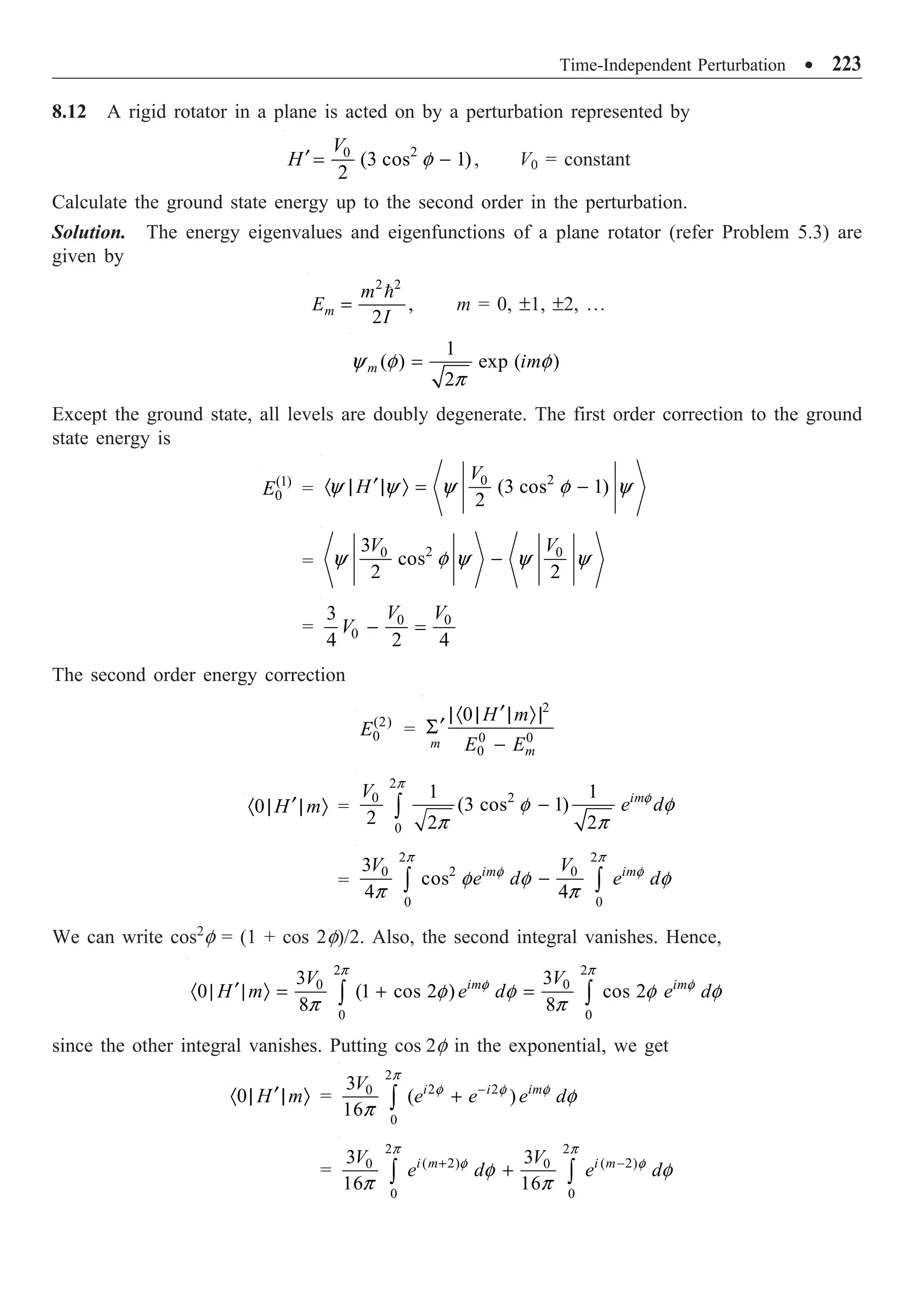
![224 ∑ Quantum Mechanics: 500 Problems with Solutions
The first integral is finite when m = –2, the second integral is finite when m = +2 and their values
are equal to 3V0/8. E±2 = 22
/I, E0 = 0. Hence,
2
0 0 0 0
0 2 0 2
2
E E E E
I
-
- = - = -
Thus,
2 2 2
(2) 0 0 0
0 2 2 2
(3 | 8) (3 | 8) 9
64
2 / 2 /
V V V I
E
I I
= + = -
- -
8.13 A plane rigid rotator in the first excited state is subjected to the interaction
2
0
(3 cos 1)
2
V
H f
¢ = -
where V0 is constant. Calculate the energies to first order in H¢.
Solution. For a plane rotator,
2 2
2
m
m
E
I
=
,
1
( ) ,
2
im
e f
y f
p
= m = 0, ±1, ±2, º
Except the m = 0 state, all states are doubly degenerate. The energy and wave function of the first
excited state are
2
1 ,
2
E
I
± =
1
( )
2
i
e f
y f
p
±
=
The first order energy corrections are given by the roots of Eq. (8.6):
(1)
11 12
1
(1)
21 22 1
H E H
H H E
¢ ¢
-
¢ ¢ -
= 0
H¢
11 =
2
2
0
22
0
1
(3 cos 1)
2 2
V
H d
p
f f
p
¢ = -
Ú
=
2 2
2
0 0 0
0 0
3 cos (3 2 )
2 2 4
V V V
d d
p p
f f f p p
p p
È ˘
- = - =
Í ˙
Í ˙
Î ˚
Ú Ú
H¢
12 =
2
2
0 0
21
0
3
1
(3 cos 1)
2 2 8
i i
V V
H e e d
p
f f
f f
p
- -
¢ = - =
Ú
The secular determinant takes the form
(1)
0 0
1
(1)
0 0
1
3
4 8
0
3
8 4
V V
E
V V
E
-
=
-
2
(1) (1)
2 0 0
1 1
5
[ ] 0
2 64
V V
E E
- - =](https://image.slidesharecdn.com/quantummechanics500problemswithsolutionspdfdrive-220626164912-635041ea/75/Quantum-Mechanics_-500-Problems-with-Solutions-PDFDrive-pdf-234-2048.jpg)
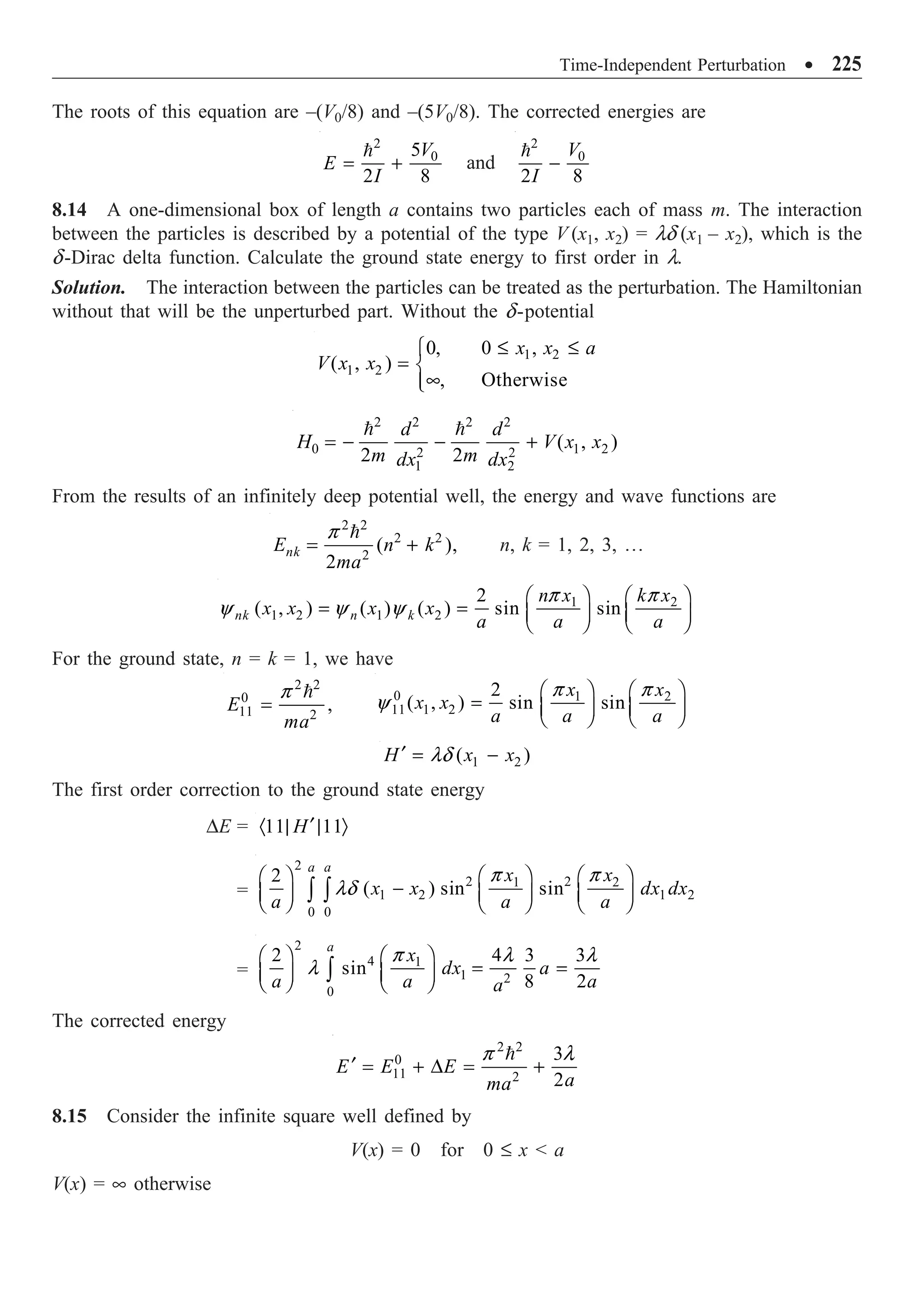
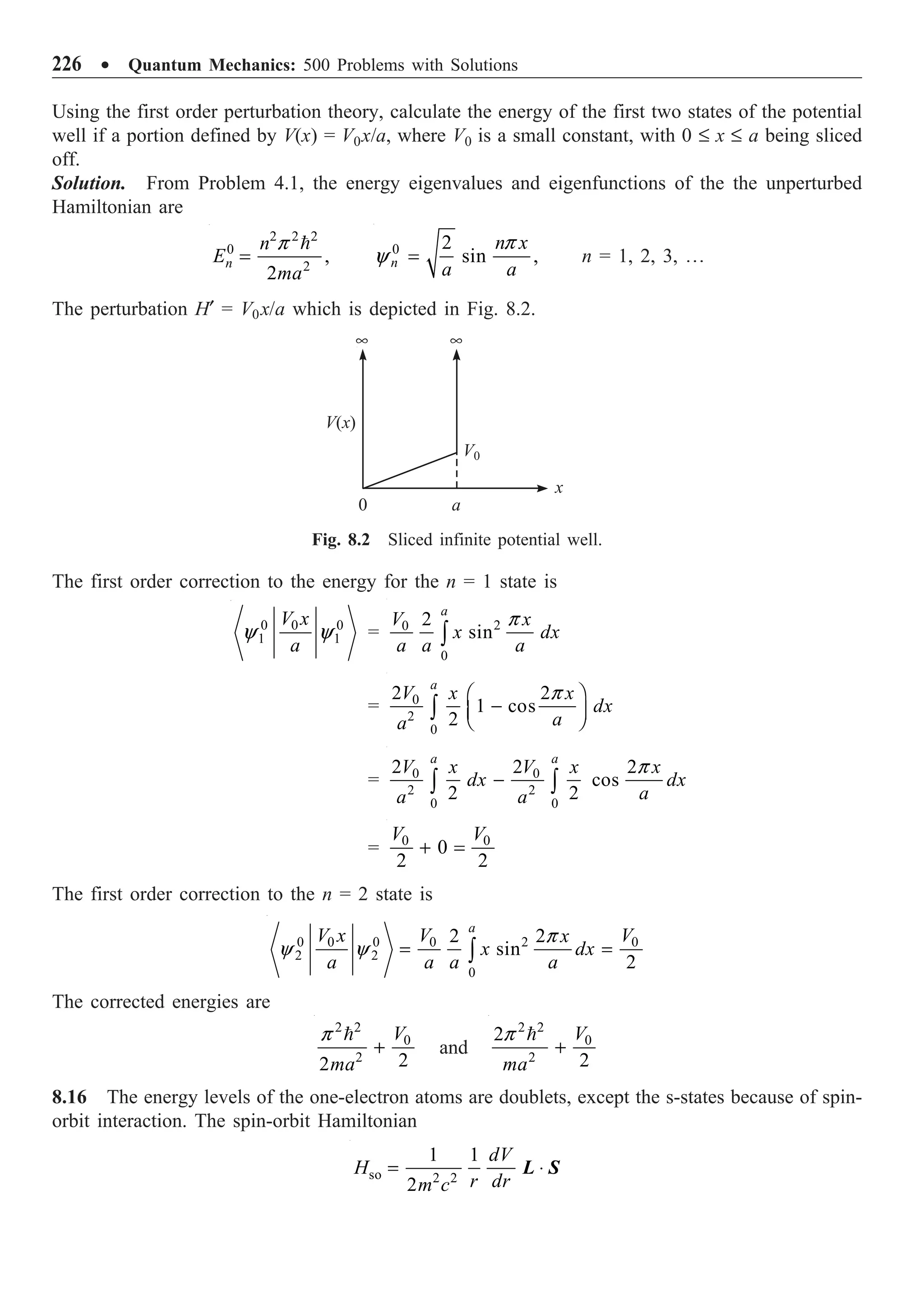
![Time-Independent Perturbation ∑ 227
Treating Hso as a perturbation, evaluate the spin-orbit interaction energy. For hydrogenic atoms,
assume that the expectation value is
3
3 3
3 0
1 2
( 1)(2 1)
z
r n a l l l
=
+ +
where a0 is the Bohr radius.
Solution. For the valence electron in a hydrogen-like atom, the potential
2
0
( )
4
Ze
V r
r
pe
= - or
2
2
0
4
dV Ze
dr r
pe
= (i)
Substituting the value of dV/dr, we get
2
so 2 2 3
0
8
Ze
H
m c r
pe
◊
=
L S
(ii)
Since J = L + S,
J2
= L2
+ S2
+ 2L ◊ S or
2 2 2
2
J L S
- -
◊ =
L S (iii)
Using the basis | lsjmÒ, the expectation value of J2
– L2
– S2
is given by
·(J2
– L2
– S2
)Ò = [ j ( j + 1) – l (l + 1) – s (s + 1)] 2
(iv)
Since the first order correction to the energy constitutes the diagonal matrix elements, substituting
the values of ·1/r3
Ò and ·(J2
– L2
– S2
)Ò, we get
4 2 2
so 2 2 3 3
0 0
( 1) ( 1) ( 1)
8 ( 1)(2 1)
z e j j l l s s
E
m c a n l l l
pe
+ - + - +
=
+ +
(v)
The Bohr radius a0 and the fine structure constant a are defined as
2
0
0 2
4
a
me
pe
=
,
2
0
4
e
c
a
pe
=
(vi)
Using Eq. (vi), we get
4 2 2
so 2 2 3 3
0 0
( 1) ( 1) ( 1)
8 ( 1)(2 1)
z e j j l l s s
E
m c a n l l l
pe
+ - + - +
=
+ +
(vii)
This makes the state j = l – (1/2) to have a lower energy than that with j = l + (1/2).
8.17 The spin -orbit interaction energy
4 4 2
so 3
( 1) ( 1) ( 1)
( 1)(2 1)
2
z mc j j l l s s
E
l l l
n
a + - + - +
=
+ +
Calculate the doublet separation DEso of states with the same n and l. Apply the result to the 2p state
of hydrogen and obtain the doublet separation in units of eV.
Solution. For a given value of l, j can have the values j = l + (1/2) and j = l – (1/2). The difference
in energy between these two is the doublet separation DEso. Hence,](https://image.slidesharecdn.com/quantummechanics500problemswithsolutionspdfdrive-220626164912-635041ea/75/Quantum-Mechanics_-500-Problems-with-Solutions-PDFDrive-pdf-237-2048.jpg)
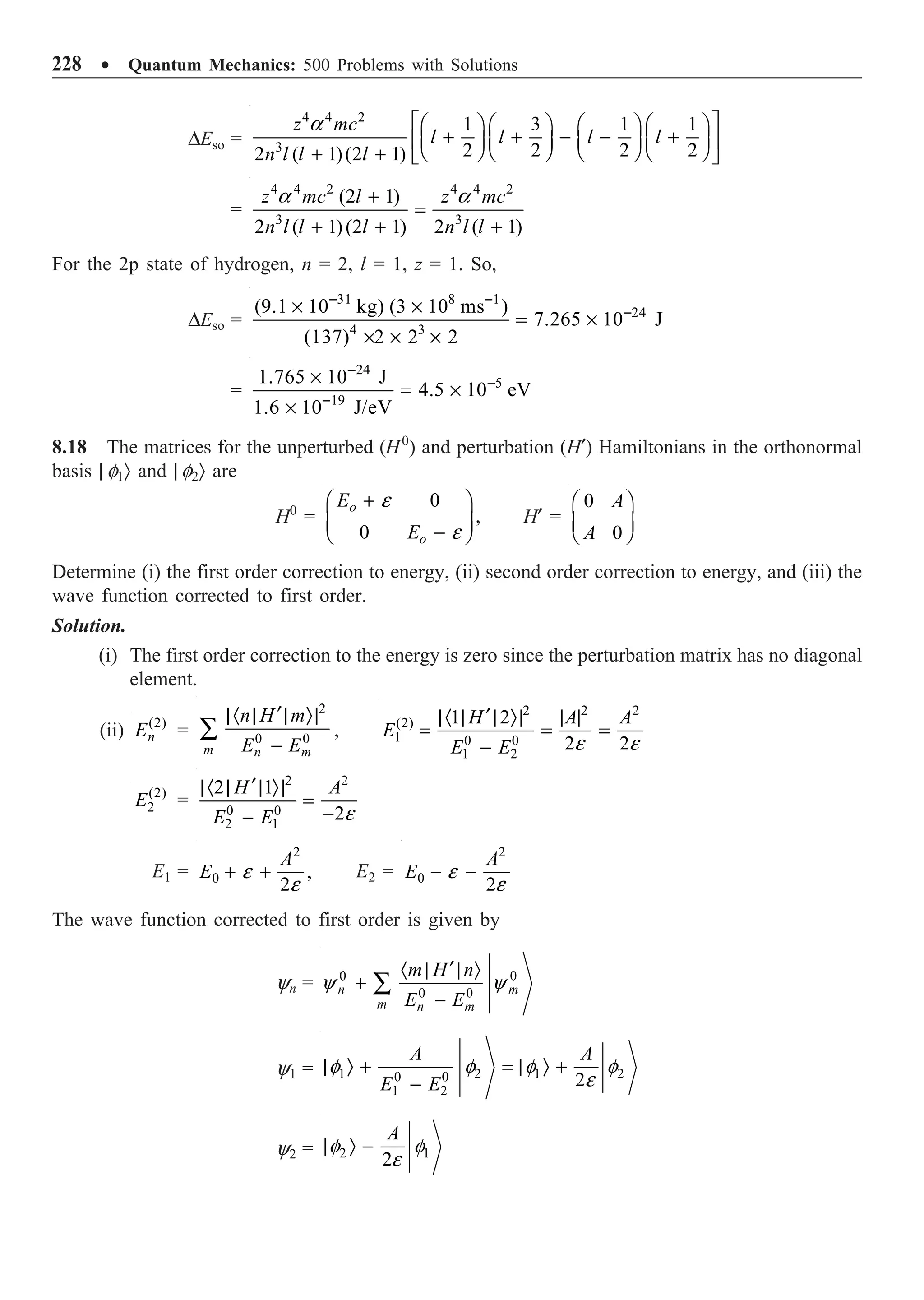
![Time-Independent Perturbation ∑ 229
8.19 Given the matrix for H0
and H¢:
H0
=
0
0
0
,
0
E
E
Ê ˆ
Á ˜
Ë ¯
H¢ =
0
0
A
A
-
Ê ˆ
Á ˜
-
Ë ¯
In the orthonormal basis |1Ò and |2Ò, determine (i) the energy eigenvalues, and (ii) energy
eigenfunctions.
Solution. This is a case of degenerate states |1Ò and |2Ò with energy eigenvalue E0. The secular
determinant is, then,
(1)
(1)
E A
A E
- -
- -
= 0 or E(1)
= ±A
The eigenfunctions corresponding to these eigenvalues are obtained by a linear combination of |1Ò
and |2Ò. Let the combination be c1|1Ò + c2|2Ò. For +A eigenvalue, the equation (1)
11 1
1
( )
H E c
¢ -
12 2 0
H c
¢
+ = reduces to
–Ac1 – Ac2 = 0 or 1
2
1
c
c
= -
Normalization gives c1 = 1/ 2, c2 = 1/ 2. Hence, the combination is (|1Ò – |2Ò)/ 2. The other
combination is (|1Ò + |2Ò)/ 2. The energy eigenvalues and eigenfunctions are
E0 + A and (|1Ò – |2Ò)/ 2
E0 – A and (|1Ò + |2Ò)/ 2
8.20 Prove the Lande interval rule which states that in a given L-S term, the energy difference
between two adjacent J-levels is proportional to the larger of the two values of J.
Solution. For a given L-S term the total orbital angular momentum J can have the values
J = L + S, L + S – 1, º | L – S |. The spin-orbit coupling energy Eso, Problem 8.16 for a given
L-S term is
Eso = constant [J(J + 1) – L(L + 1) – S(S + 1)]
The energy difference between J – 1 and J levels is DEso given by
DEso = constant [J(J + 1) – L(L + 1) – S(S + 1) – J(J – 1) + L(L + S) + S(S + 1)]
= constant ¥ 2J
That is, the energy difference between two adjacent J-levels is proportional to the larger of the two
values of J.
8.21 An interaction of the nuclear angular momentum of an atom (I) with electronic angular
momentum (J) causes a coupling of the I and J vectors: F = I + J. The interaction Hamiltonian is
of the type Hint = constant I ◊ J. Treating this as a perturbation, evaluate the first order correction
to the energy.
Solution. Though the unperturbed Hamiltonian has degenerate eigenvalues, one can avoid working
with degenerate perturbation theory (refer Problem 8.16). The perturbing Hamiltonian
H¢ = costant I ◊ J](https://image.slidesharecdn.com/quantummechanics500problemswithsolutionspdfdrive-220626164912-635041ea/75/Quantum-Mechanics_-500-Problems-with-Solutions-PDFDrive-pdf-239-2048.jpg)
![230 ∑ Quantum Mechanics: 500 Problems with Solutions
The first order correction to energy is the diagonal matrix element of H¢ = ·H¢Ò which can be obtained
as
F2
= (I + J)2
= I2
+ J2
+ 2I ◊ J
I ◊ J =
2 2 2
2
F I J
- -
2
constant [ ( 1) ( 1) ( 1)]
2
H F F I I J J
¢
· Ò = + - + - +
Hence, the first order correction
(1)
[ ( 1) ( 1) ( 1)]
E a F F I I J J
= + - + - +
where a is a constant.
8.22 A particle in a central potential has an orbital angular momentum quantum number l = 3. If
its spin s = 1, find the energy levels and degeneracies associated with the spin-orbit interaction.
Solution. The spin-orbit interaction
so ( )
H r
x
= ◊
L S
where x (r) is a constant. The total angular momentum
J = L + S or L ◊ S = 2 2 2
1
( )
2
J L S
- -
Hence,
Hso = 2 2 2
1
( ) ( )
2
r J L S
x - -
In the | jmjlsÒ basis, the first order correction
Eso = 2 2 2
1
( ) ( )
2
j j
jm ls r J L S jm ls
x - -
= 2
1
( ) [ ( 1) ( 1) ( 1)]
2
r j j l l s s
x + - + - +
Since l = 3 and s = 1, the possible values of j are 4, 3, 2. Hence
2
2
so
2
3 ( ) , 4
( ) , 3
4 ( ) , 2
r j
E r j
r j
x
x
x
Ï =
Ô
= - =
Ì
Ô- =
Ô
Ó
The degeneracy d is given by the (2j + 1) value
9, 4
7, 3
5, 2
j
d j
j
=
Ï
Ô
= =
Ì
Ô =
Ó](https://image.slidesharecdn.com/quantummechanics500problemswithsolutionspdfdrive-220626164912-635041ea/75/Quantum-Mechanics_-500-Problems-with-Solutions-PDFDrive-pdf-240-2048.jpg)
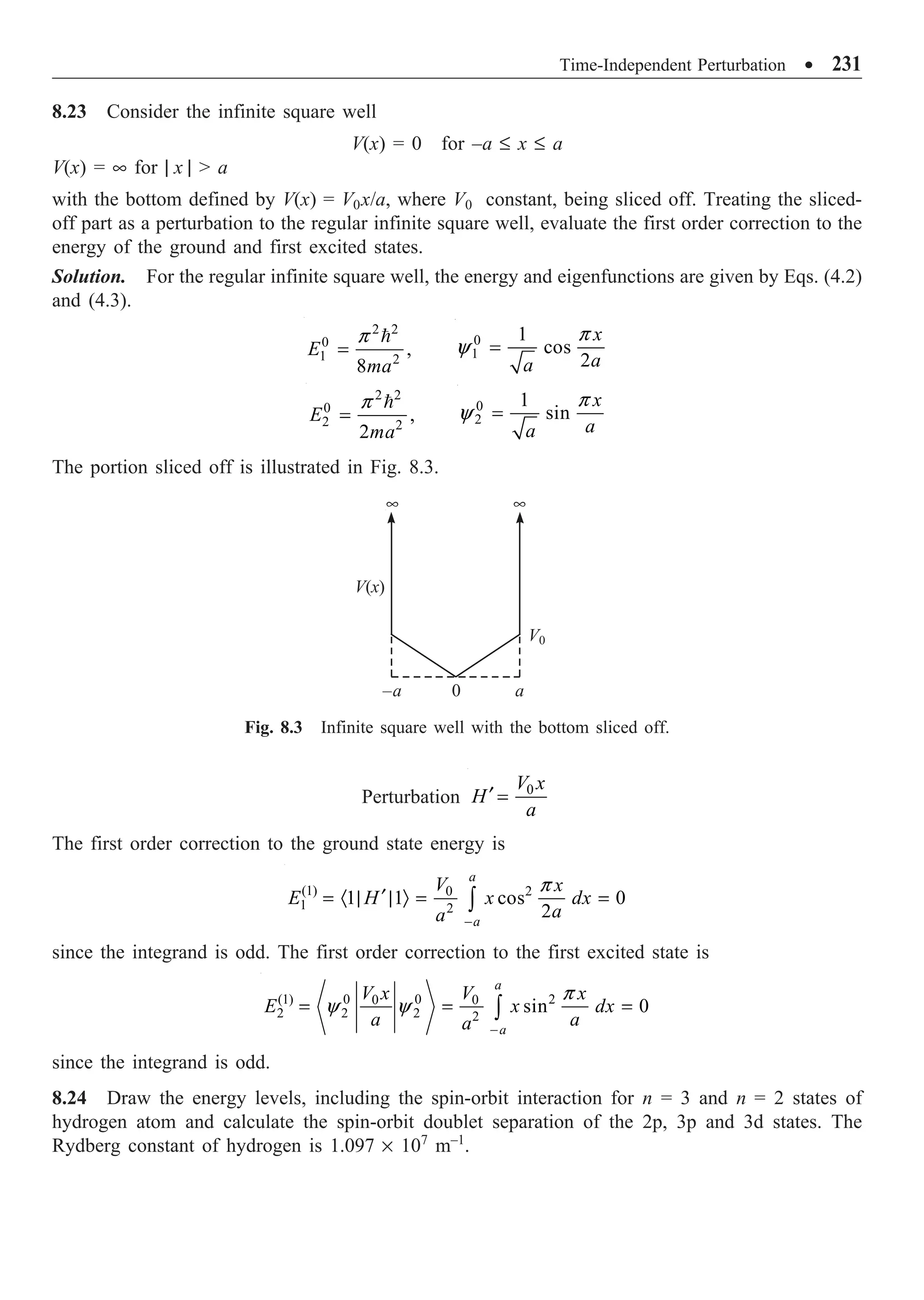

![Time-Independent Perturbation ∑ 233
The unperturbed wave function
0
/
100 1/2 3/2
0
1 r a
e
a
y
p
-
= -
The first order correction to the energy
(1)
100 cos 100
l
E ere q
= · | | Ò
The angular part of this equation is
0
cos sin 0
d
p
q q q =
Ú
i.e., the first order correction to the energy is zero.
8.26 A particle of mass m moves in an infinite one-dimensional box of bottom a with a potential
dip as defined by
V(x) = • for x 0 and x a
V(x) = –V0 for 0
3
a
x
V(x) = 0 for
3
a
x a
Find the first order energy of the ground state.
Solution. For a particle in the infinite potential well (Fig. 8.5) defined by V(x) = 0 for 0 x a
and V(x) = • otherwise, the energy eigenvalues and eignfunctions are
2 2 2
2
2
n
n
E
ma
p
=
,
2
sin ,
n
n x
a a
p
y = n = 1, 2. 3, º
The perturbation H¢ = –V0, 0 x (a/3). Hence, the first order energy correction to the ground state
is
E(1)
=
/3
2
0
0
2
sin
a
x
V dx
a a
p
- Ú
=
/3
0
0
2 1 2
1 cos
2
a
x
V dx
a a
p
Ê ˆ
- -
Á ˜
Ë ¯
Ú
3
a
- =
/3
/3
0 0
0
0
2
[ ] sin
2
a
a
V V a x
x
a a a
p
p
È ˘
- + Í ˙
Î ˚
= 0 0
0
0.866 0.264
3 4
V V
V
p
- + ¥ = -
The energy of the ground state corrected to first order is
2 2
0
2
0.264
2
E V
ma
p
= -
V(x)
0
–V0 x
a
–a/3
Fig. 8.5 Infinite square well with
potential dip.](https://image.slidesharecdn.com/quantummechanics500problemswithsolutionspdfdrive-220626164912-635041ea/75/Quantum-Mechanics_-500-Problems-with-Solutions-PDFDrive-pdf-243-2048.jpg)

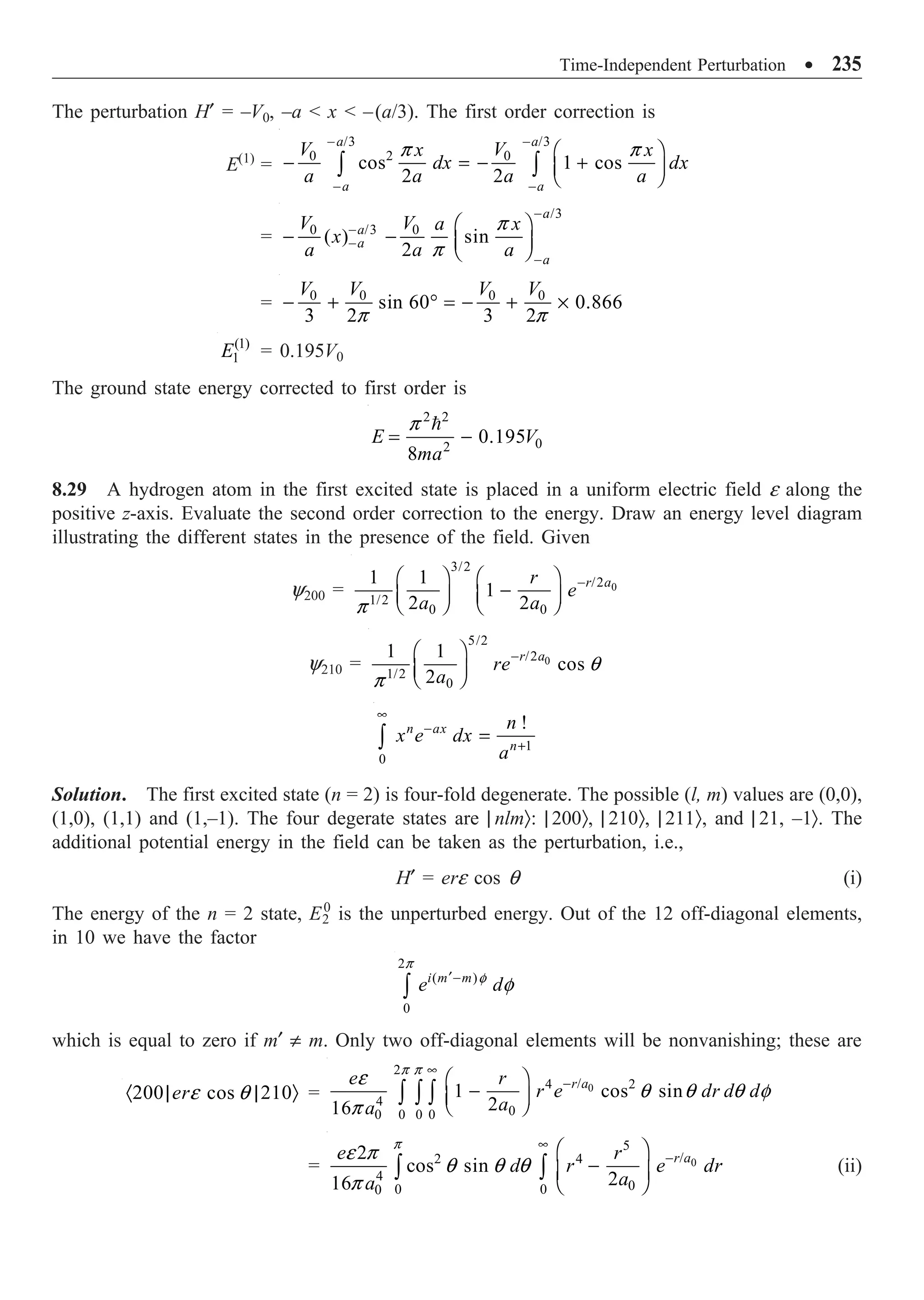
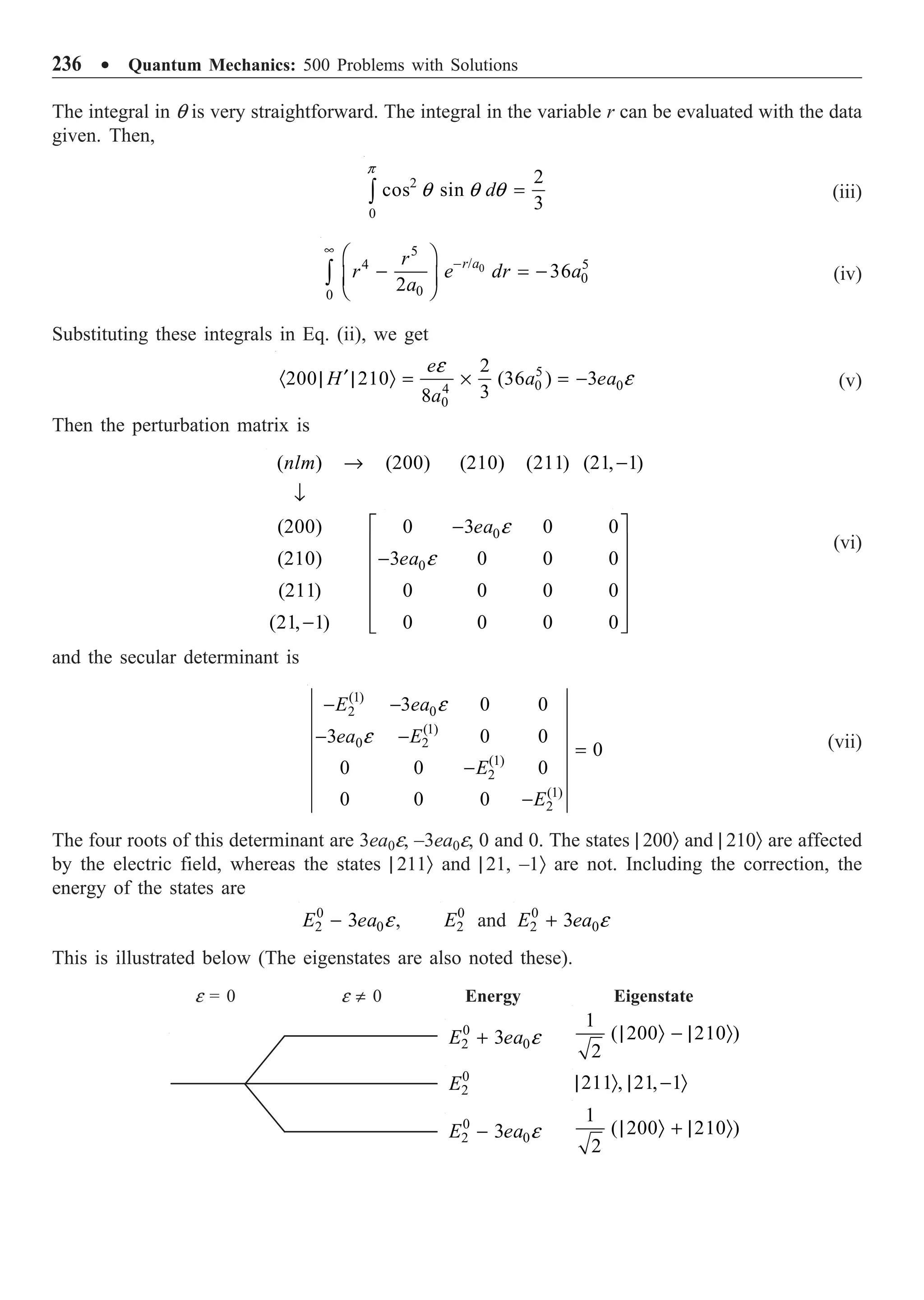
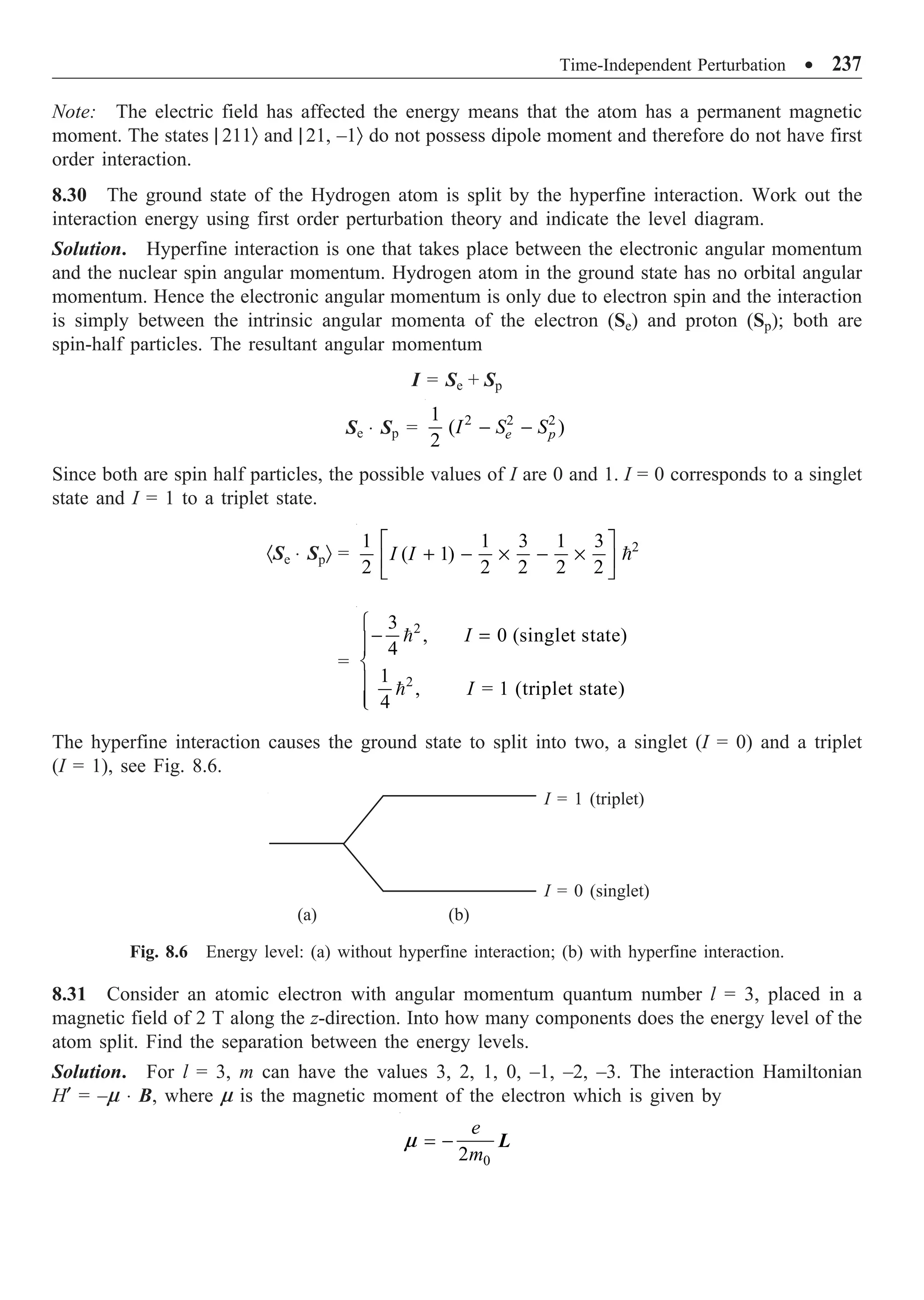
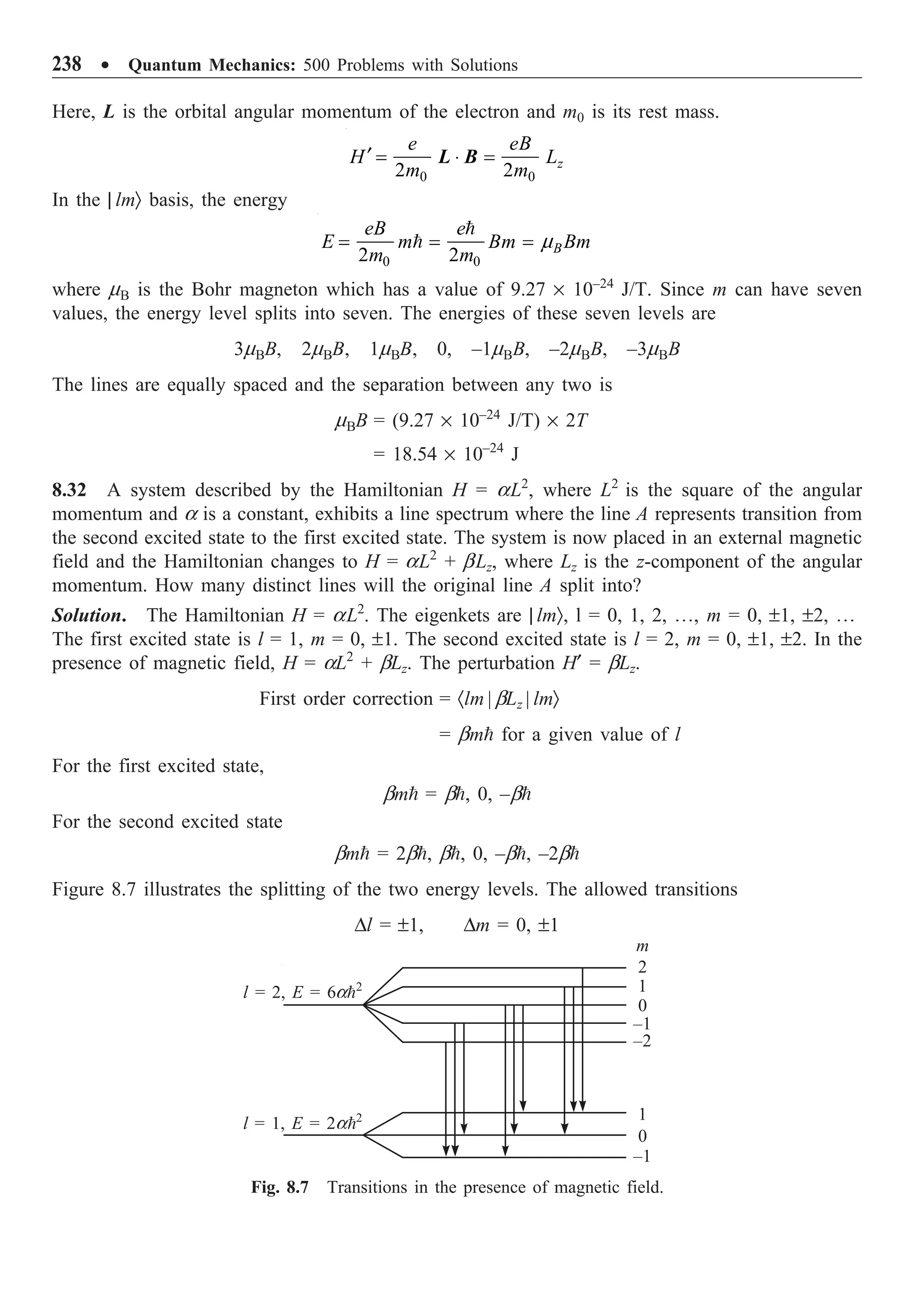
![Time-Independent Perturbation ∑ 239
Transitions are also shown in Figure 8.7. The energies of the levels are also given, from which the
transition energies can be evaluated. The original line will split into eight lines.
8.33 The Hamiltonian of a two-electron syatem is perturbed by an interaction aS1 ◊ S2, where a
is a constant and S1 and S2 are the spin angular momenta of the electrons. Calculate the splitting
between the S = 0 and S = 1 states by first order perturbation, where S is the magnitude of the total
spin.
Solution. We have S = S1 + S2. Then,
2 2 2
1 2 1 2
2
S S S
= + + ◊
S S
2 2 2
1 2
1 2
2
S S S
- -
◊ =
S S
Since the spin of electron is 1/2 when the two electrons combine, the total spin S = 0 or 1. The state,
for which S = 0, is called a singlet state with ms = 0. The state, for which S = 1, is called a triplet
state with ms = 1, 0, –1. The first order correction to S = 0 state in the | smsÒ basis
(1)
0
E =
2 2 2
1 2
( )
2
s s
S S S
sm sm
a
- -
= 2
1 1 2 2
[ ( 1) ( 1) ( 1)]
2
s s s s s s
a
+ - + - +
= 2 2
3 3 3
0
2 4 4 4
a
a Ê ˆ
- - = -
Á ˜
Ë ¯
The first order correction to the S = 1 state is
(1)
1
E =
2
1 3 1 3
1 2
2 2 2 2 2
a È ˘
¥ - ¥ - ¥
Í ˙
Î ˚
= 2
4
a
Splitting between the two states =
2 2
3
4 4
a
a Ê ˆ
- -
Á ˜
Ë ¯
= a2
8.34 The unperturbed Hamiltonian of a system is
2
2 2
0
1
2 2
p
H m x
m
w
= +
If a small perturbation
for 0
0 for 0
x x
V
x
l
Ï
¢ = Ì
£
Ô
Ó
acts on the system, evaluate the first order correction to the ground state energy.](https://image.slidesharecdn.com/quantummechanics500problemswithsolutionspdfdrive-220626164912-635041ea/75/Quantum-Mechanics_-500-Problems-with-Solutions-PDFDrive-pdf-249-2048.jpg)
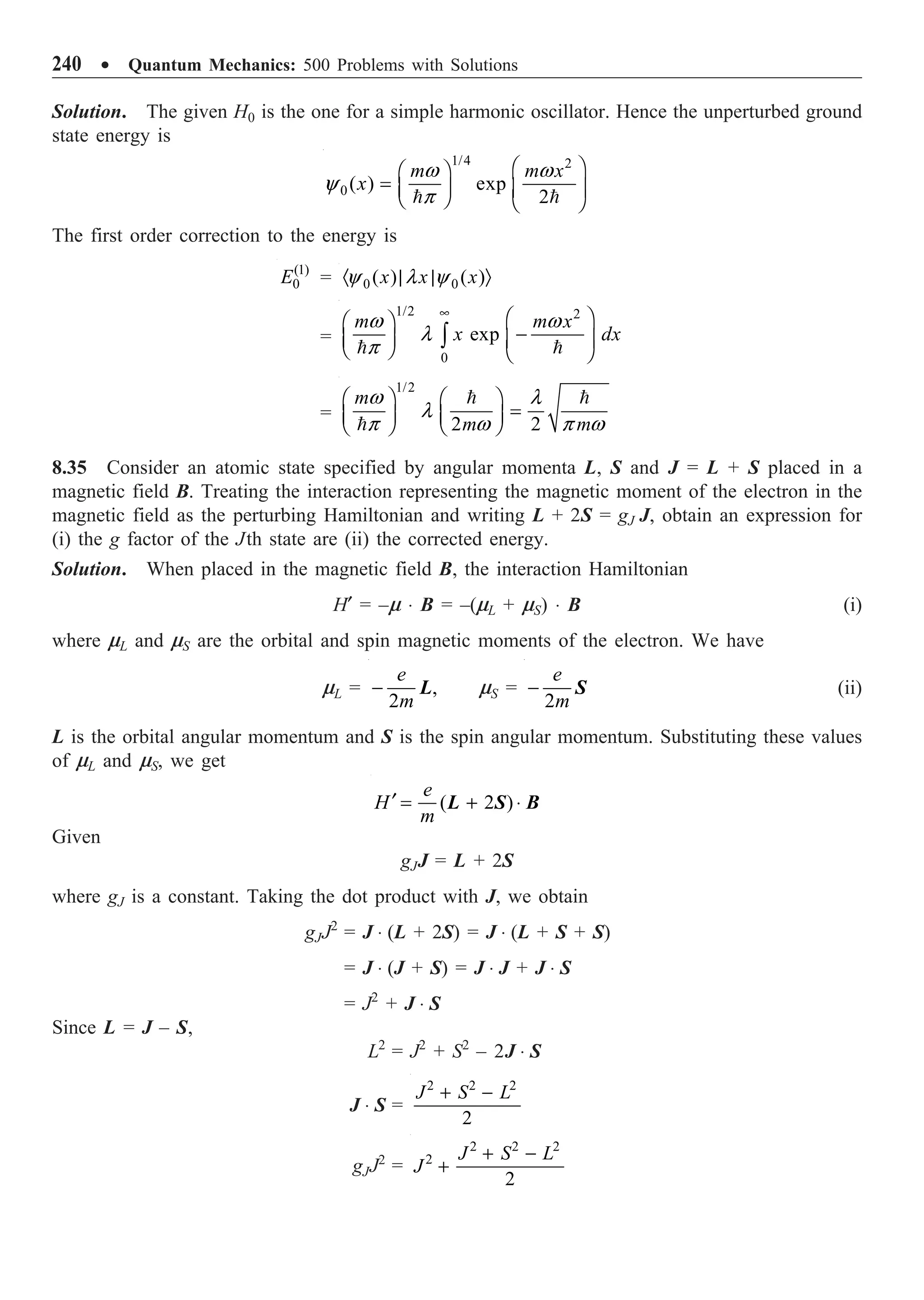
![Time-Independent Perturbation ∑ 241
In the simultaneous eigenkets of J2
, Jz, L2
, S2
,
2 2 2 2 2
1
2
J
g J J J S L
· Ò = · Ò + · + - Ò
2 2 2
1
( 1) ( 1) [ ( 1) ( 1) ( 1)]
2
J
g J J J J J J S S L L
+ = + + + + + - +
( 1) ( 1) ( 1)
1
2 ( 1)
J
J J S S L L
g
J J
+ + + - +
= +
+
where J, L and S are the quantum numbers associated with the angular momenta J, L and S,
respectively.
(ii) The interaction Hamiltonian
H¢ = cos
2 2
e e
g gJB
m m
q
◊ =
J B
=
2 2
z
z
J
e e
gJB gBJ
m J m
=
The first order correction to the energy is the diagonal matrix element
(1)
2 2
J J J
e e
E gBM Bg M
m m
= =
The corrected energy
0
2 J J
e
E E Bg M
m
= +
Since MJ can have (2J + 1)-fold degenerate, each energy level is split into 2J + 1 equally spaced
levels.
8.36 The nuclear spin of bismuth atom is 9/2. Find the number of levels into which a 2
D5/2 term
of bismuth splits due to nuclear spin-electron angular momentum interaction. If the separation of
2
7D5/2 term from 2
6D5/2 is 70 cm–1
, what is the separation between the other adjacent levels?
Solution. 2
D5/2 term means 2S + 1 = 2, S = (1/2), L = 2 and J = (5/2). Given I = (9/2). The total
angular momentum is F = I + J. The possible values of the quantum number F are 7, 6, 5, 4, 3, 2.
Hence, the 2
D5/2 level splits into six sublevels corresponding to the F values, 7, 6, 5, 4, 3, and 2.
From Problem 8.21, we have the correction to energy as
E(1)
= a [F(F + 1) – I (I + 1) – J(J + 1)]
Hence, the energy difference DE between successive levels (F + 1) and F is given by
DE = a [(F + 1)(F + 2) – I (I + 1) – J(J + 1)] – a [F(F + 1) – I (I + 1) – J(J + 1)]
Given the separation between J = 7 and J = 6 is 70 cm–1
, i.e.,
70 cm–1
= 2a ¥ 7 or a = 5 cm–1
Hence,
2 2 1
6 5/2 5 5/2 60 cm
D D -
- =
2 2 1
5 5/2 4 5/2 50 cm
D D -
- =](https://image.slidesharecdn.com/quantummechanics500problemswithsolutionspdfdrive-220626164912-635041ea/75/Quantum-Mechanics_-500-Problems-with-Solutions-PDFDrive-pdf-251-2048.jpg)
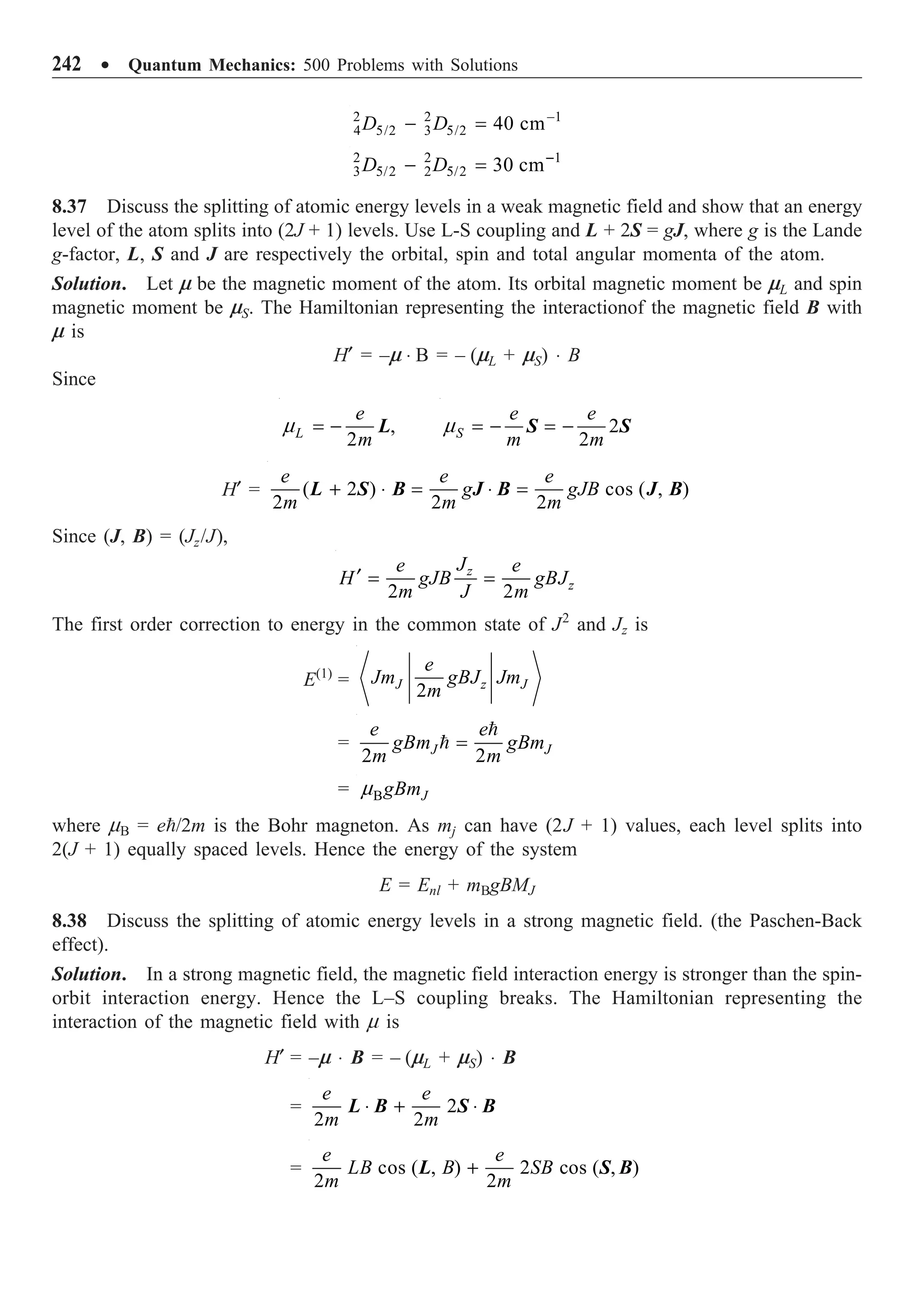
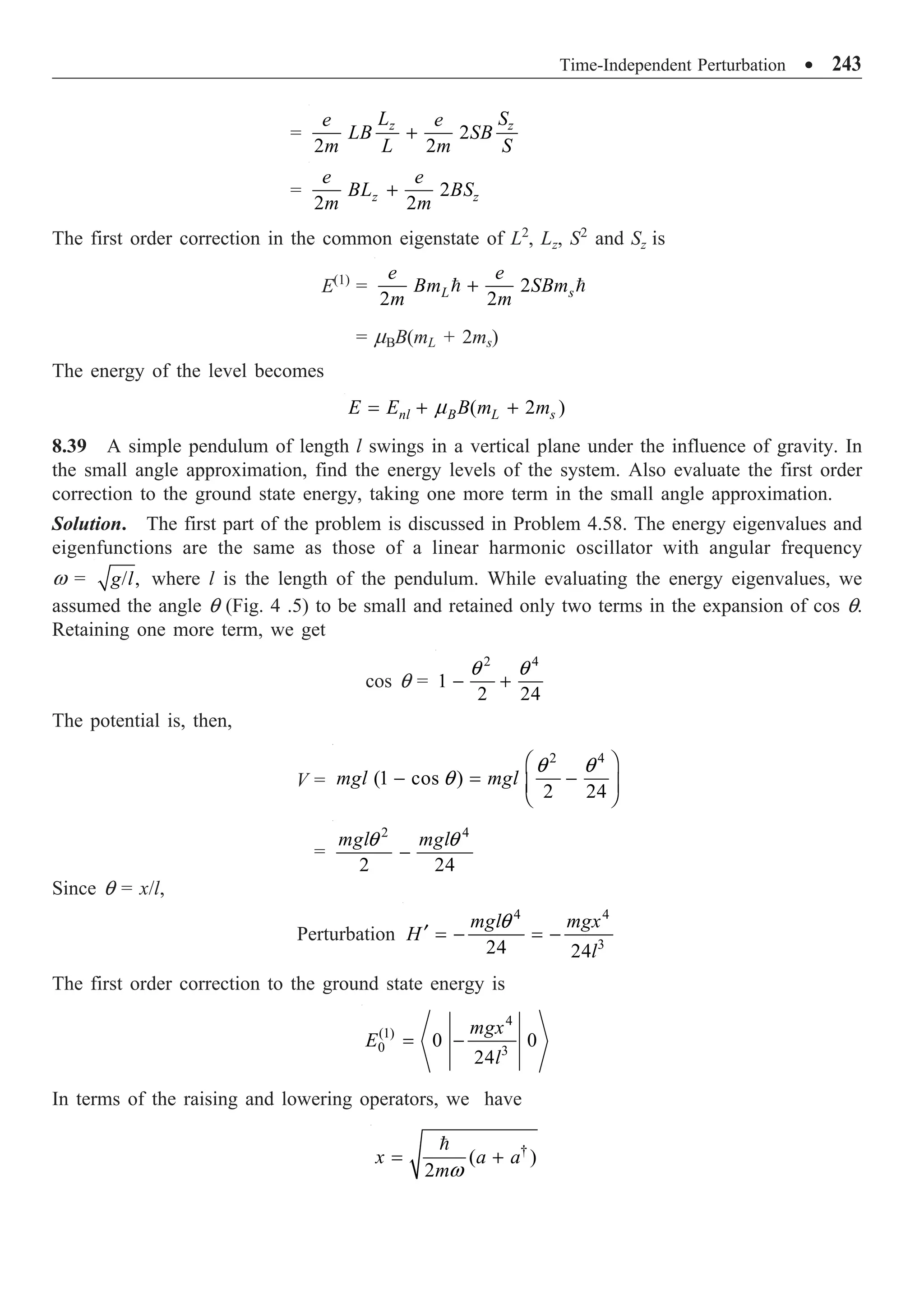
![244 ∑ Quantum Mechanics: 500 Problems with Solutions
With this value of x,
2
(1)
0 3 2
24
mg
E
m
l w
Ê ˆ Ê ˆ
= -
Á ˜ Á ˜
Ë ¯ Ë ¯
·0 | (a + a†
)(a + a†
)(a + a†
)(a + a†
) | 0 Ò
In all, there will be 16 terms on the RHS. However, only two will be nonvanishing. They are
·0 | aaa†
a†
| 0 Ò and ·0 | a a†
a a†
| 0 Ò. Consequently,
·0 | aa†
aa†
| 0 Ò = 1, ·0 | aaa†
a†
| 0 Ò = 2
Hence,
2
(1)
0 3 2
8
g
E
ml w
= -
8.40 Obtain the hyperfine splitting in the ground state of the hydrogen atom to first order in
perturbation theory, for the perturbation
H¢ = ASp ◊ Sed 3
(r), A being constant
where Sp and Se denote the spins of the proton and electron, respectively.
Solution. The hydrogen ground state wave function is
0
1/2
/
100 3
0
1 r a
e
a
y
p
-
Ê ˆ
= Á ˜
Ë ¯
The perturbation H¢ = ASp ◊ Sed 3
(r). Denoting the spin function by cs, the total wave function of the
ground state is
y = y100 cs
The first order correction to energy
(1)
0
E =
3
100 p e 100
| ( )
s s
A
y c d y c
· | Ò
i
S S r
=
3
100 100 p e
| ( ) s s
A
y d y c c
· | Ò · | | Ò
i
r S S
= p e
3
0
s s
A
a
c c
p
· | | Ò
i
S S
Writing
F = Sp + Se or Sp • Se =
2 2 2
p e
2
F S S
- -
(1)
0
E =
2 2 2
p e
3
0
2
s s
F S S
A
a
c c
p
- -
= 2
p p e e
3
0
[ ( 1) ( 1) ( 1)]
2
A
F F S S S S
a
p
+ - + - +
As Sp = (1/2) and Se = (1/2), the possible values of F are 1, 0. The separation between the two F
states is the hyperfine splitting DE. Thus,](https://image.slidesharecdn.com/quantummechanics500problemswithsolutionspdfdrive-220626164912-635041ea/75/Quantum-Mechanics_-500-Problems-with-Solutions-PDFDrive-pdf-254-2048.jpg)
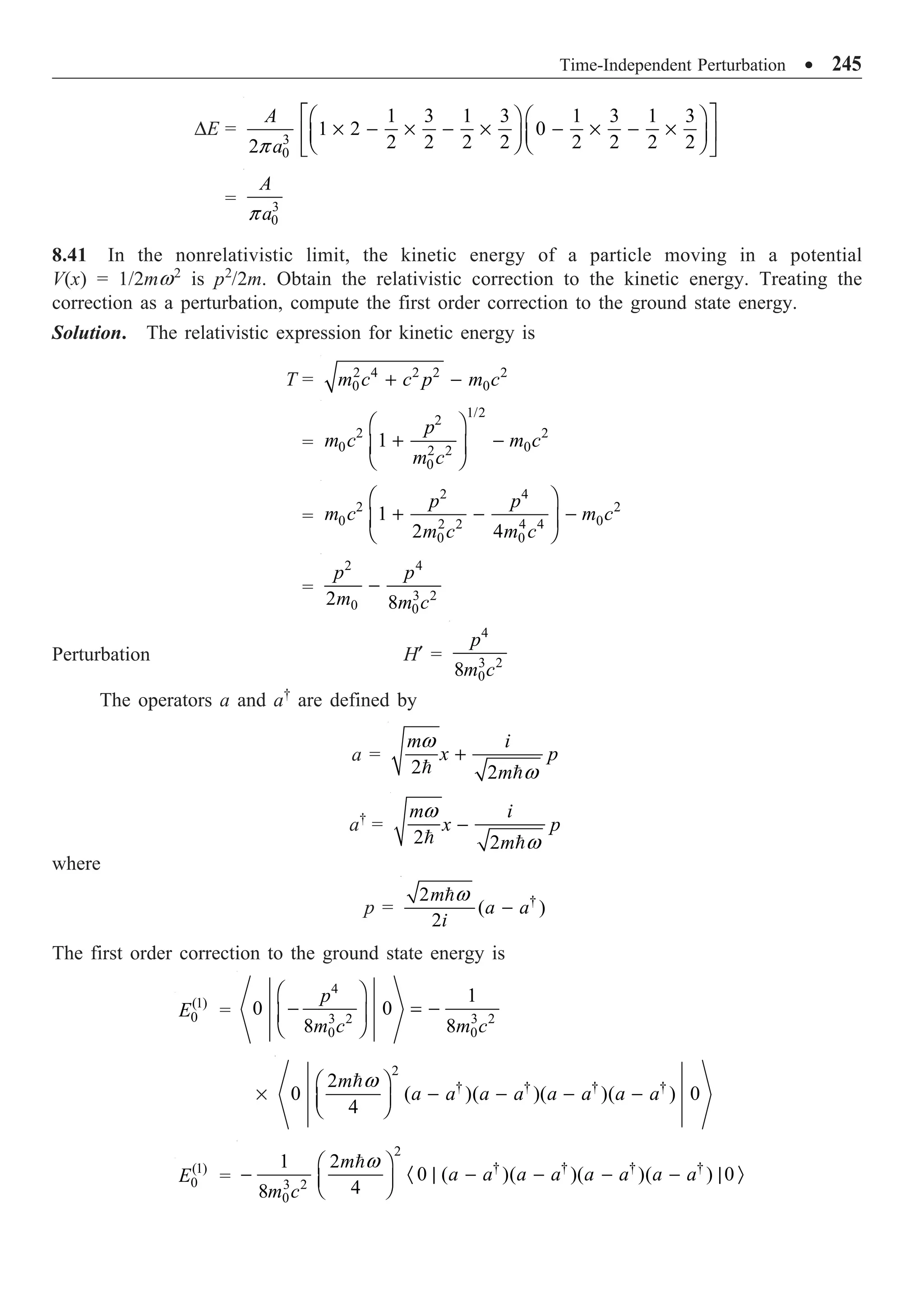
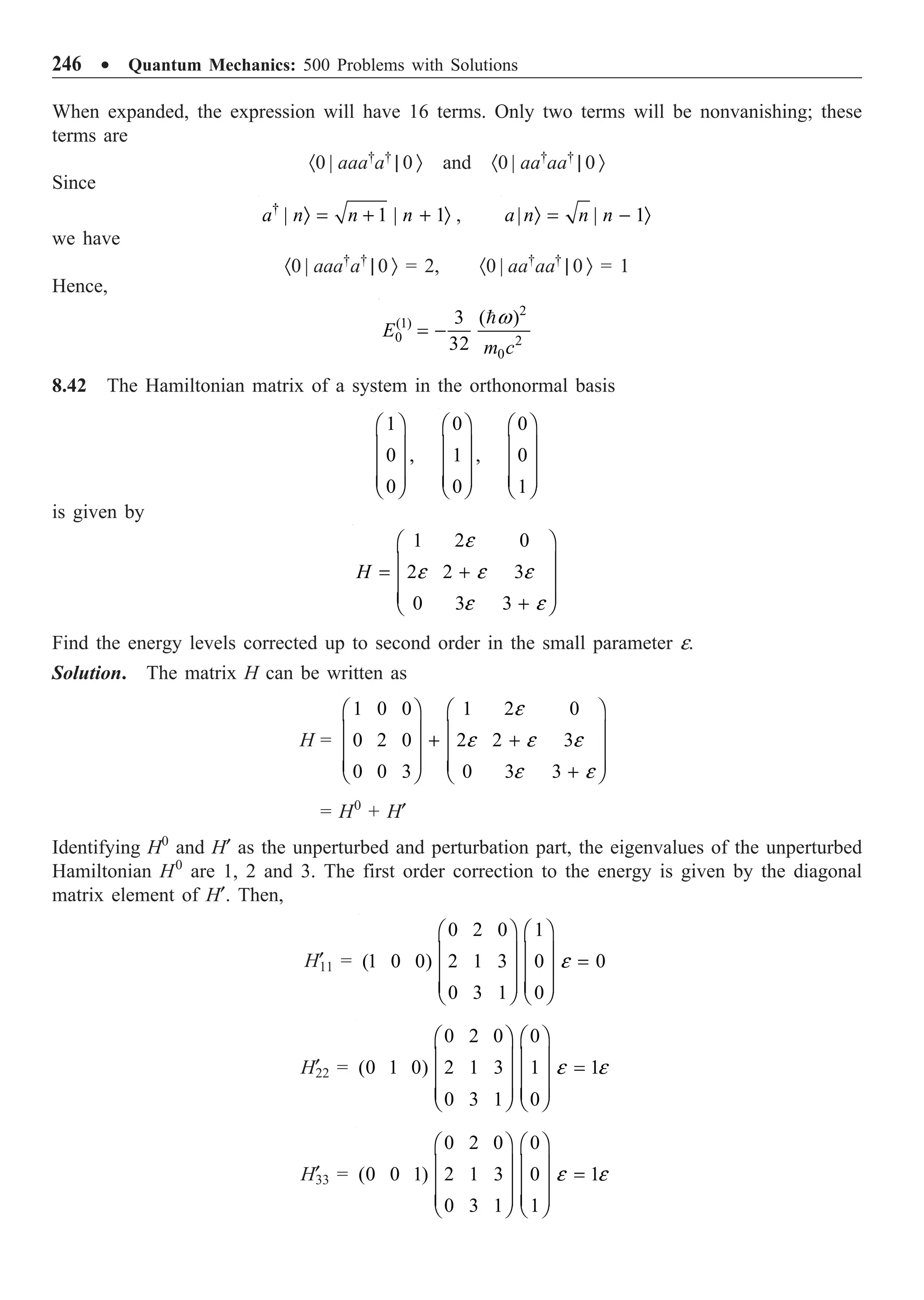
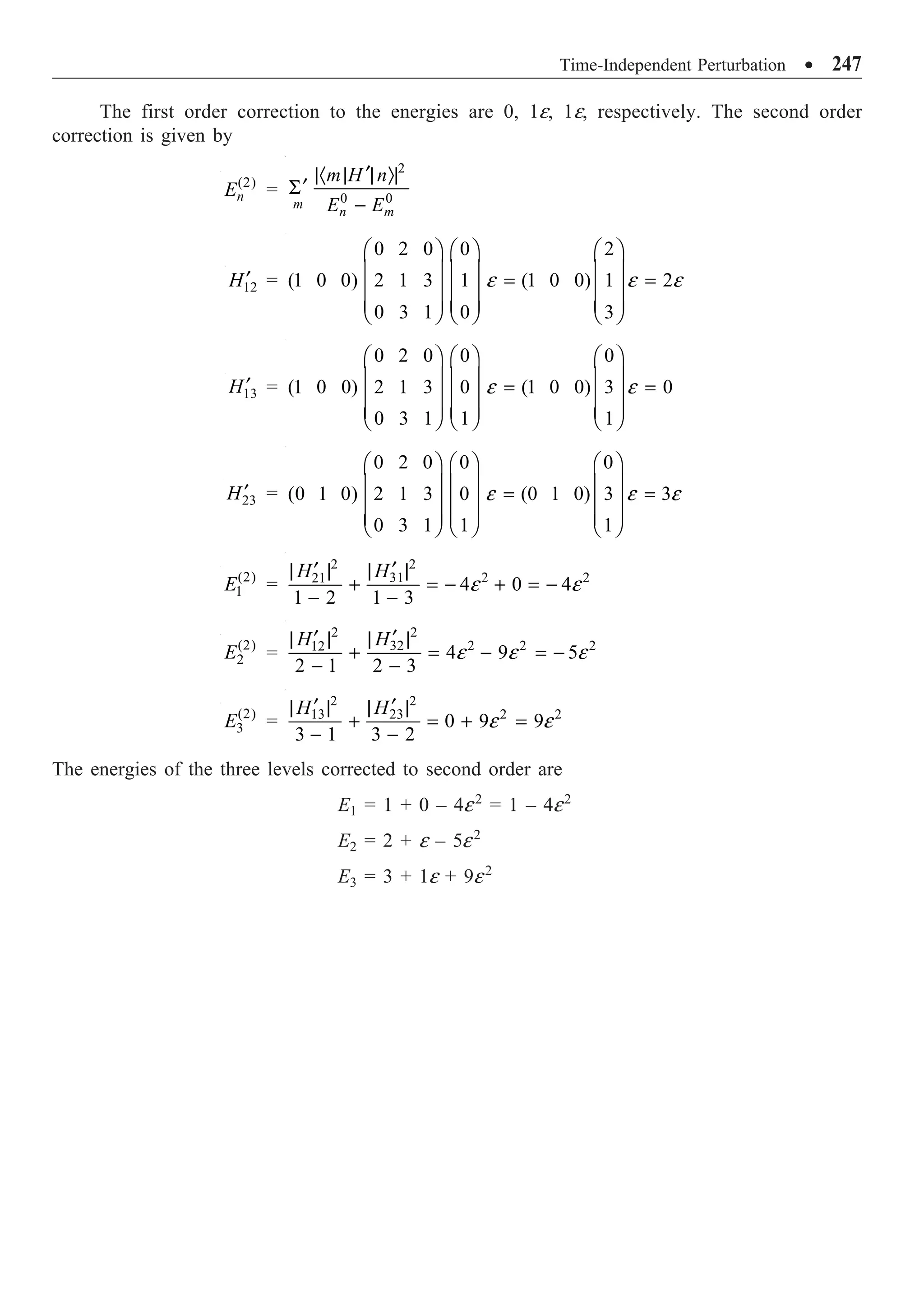
![248
The variation method is usually applied to obtain the ground state energy and wave functions of
quantum mechanical systems. Extension to excited states is also possible. The WKB method is based
on the expansion of the wave function of a one-dimensional system in powers of .
9.1 Variation Method
The essential idea of the method is to evaluate the expectation value ·HÒ of the Hamiltonian operator
H of the system with respect to a trial wave function f. The variational principle states that the
ground state energy
E1 £ ·HÒ = ·f | H | fÒ (9.1)
In practice, the trial function is selected in terms of one or more variable parameters and the value
of ·HÒ is evaluated. The value of ·HÒ is then minimized with respect to each of the parameters. The
resulting value is the closest estimate possible with the selected trial function. If the trial wave
function is not a normalized one, then
H
H
· | | Ò
· Ò =
· | Ò
f f
f f
(9.2)
9.2 WKB Method
The WKB method is based on the expansion of the wave function in powers of . This method is
applicable when the potential V(x) is slowly varying. When E V(x), the Schrodinger equation for
a one-dimensional system is given by
2
2
2
0,
d
k
dx
+ =
y
y 2
2
2
[ ( )]
m
k E V x
= -
(9.3)
The solution is given by
( )
exp
A
i k dx
k
= ± Ú
y (9.4)
Variation and WKB Methods
CHAPTER 9](https://image.slidesharecdn.com/quantummechanics500problemswithsolutionspdfdrive-220626164912-635041ea/75/Quantum-Mechanics_-500-Problems-with-Solutions-PDFDrive-pdf-258-2048.jpg)
![Variation and WKB Methods ∑ 249
where A is a constant. The general solution will be a linear combination of the two. When E V(x),
the basic equation becomes
2
2
2
0,
d
dx
- =
y
g y 2
2
2 [ ( ) ]
m V x E
-
=
g (9.5)
Then the solution of Eq. (9.5) is
( )
exp
B
dx
= ± Ú
y g
g
(9.6)
where B is a constant.
9.3 The Connection Formulas
When E @ V(x), both the quantities k and g Æ 0. Hence, y goes to infinity. The point at which
E = V(x) is called the turning point. On one side the solution is exponential and on the other side,
it is oscillatory. The solutions for the regions E V(x) and E V(x) must be connected. The
connection formulas are as follows:
Barrier to the right of the turning point at x1:
1
1
2 1
cos exp
4
x x
x x
k dx dx
k
Ê ˆ
Ê ˆ
- ¨ -
Á ˜
Á ˜
Ë ¯ Ë ¯
Ú Ú
p
g
g
(9.7)
1
1
1 1
sin exp
4
x x
x x
k dx dx
k
Ê ˆ
Ê ˆ
- Æ - Á ˜
Á ˜
Ë ¯ Ë ¯
Ú Ú
p
g
g
Barrier to the left of the turning point at x2:
2
2
1 2
exp cos
4
x x
x x
dx k dx
k
Ê ˆ
Ê ˆ
- Æ -
Á ˜
Á ˜
Ë ¯ Ë ¯
Ú Ú
p
g
g
(9.8)
2
2
1 1
exp sin
4
x x
x x
dx k dx
k
Ê ˆ
Ê ˆ
- ¨ -
Á ˜
Á ˜
Ë ¯ Ë ¯
Ú Ú
p
g
g
The approximation breaks down if the turning points are close to the top of the barrier. Barrier
penetration: For a broad high barrier, the transmission coefficient
2
1
exp 2
x
x
T dx
Ê ˆ
= -
Á ˜
Ë ¯
Ú g (9.9)](https://image.slidesharecdn.com/quantummechanics500problemswithsolutionspdfdrive-220626164912-635041ea/75/Quantum-Mechanics_-500-Problems-with-Solutions-PDFDrive-pdf-259-2048.jpg)
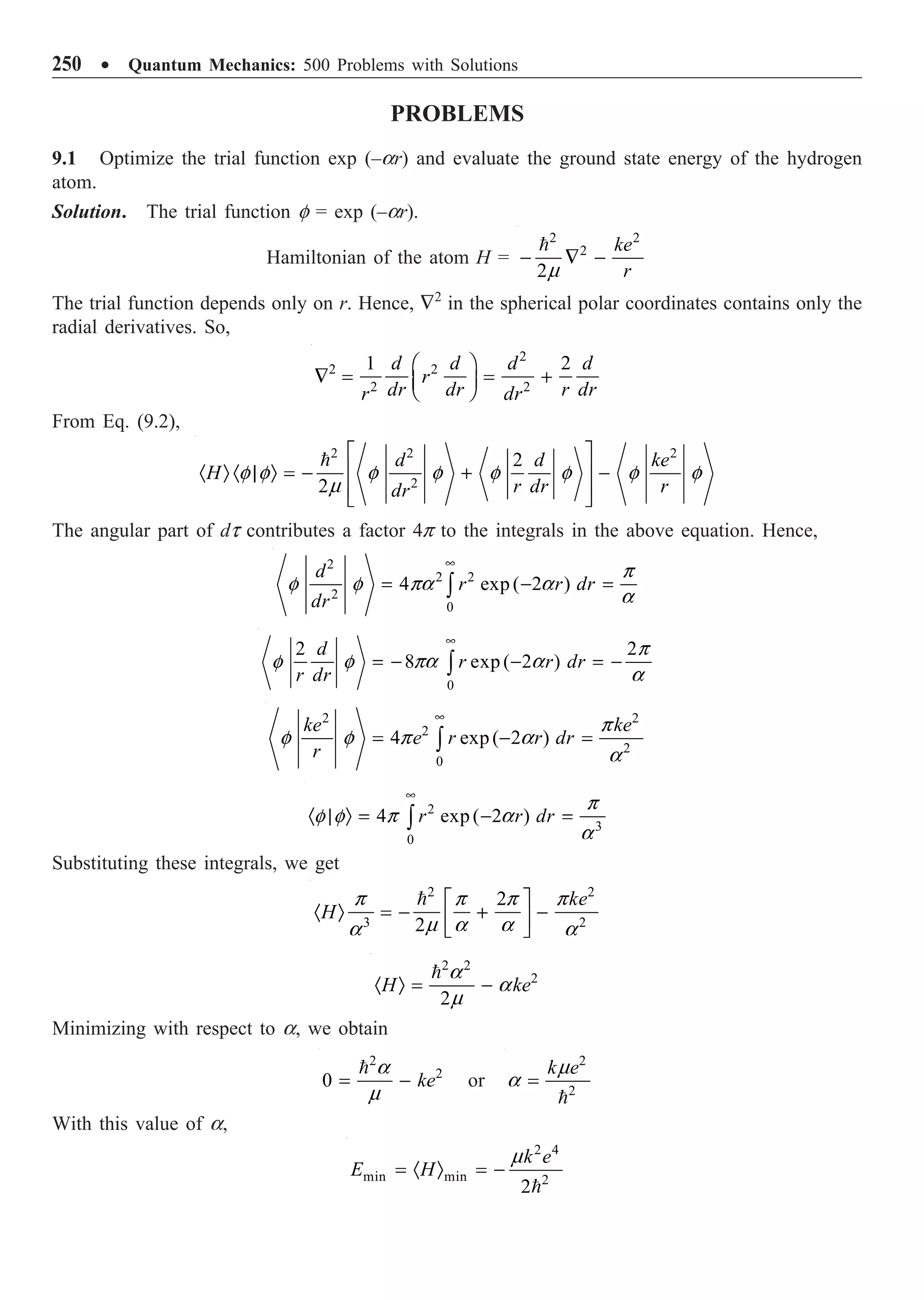
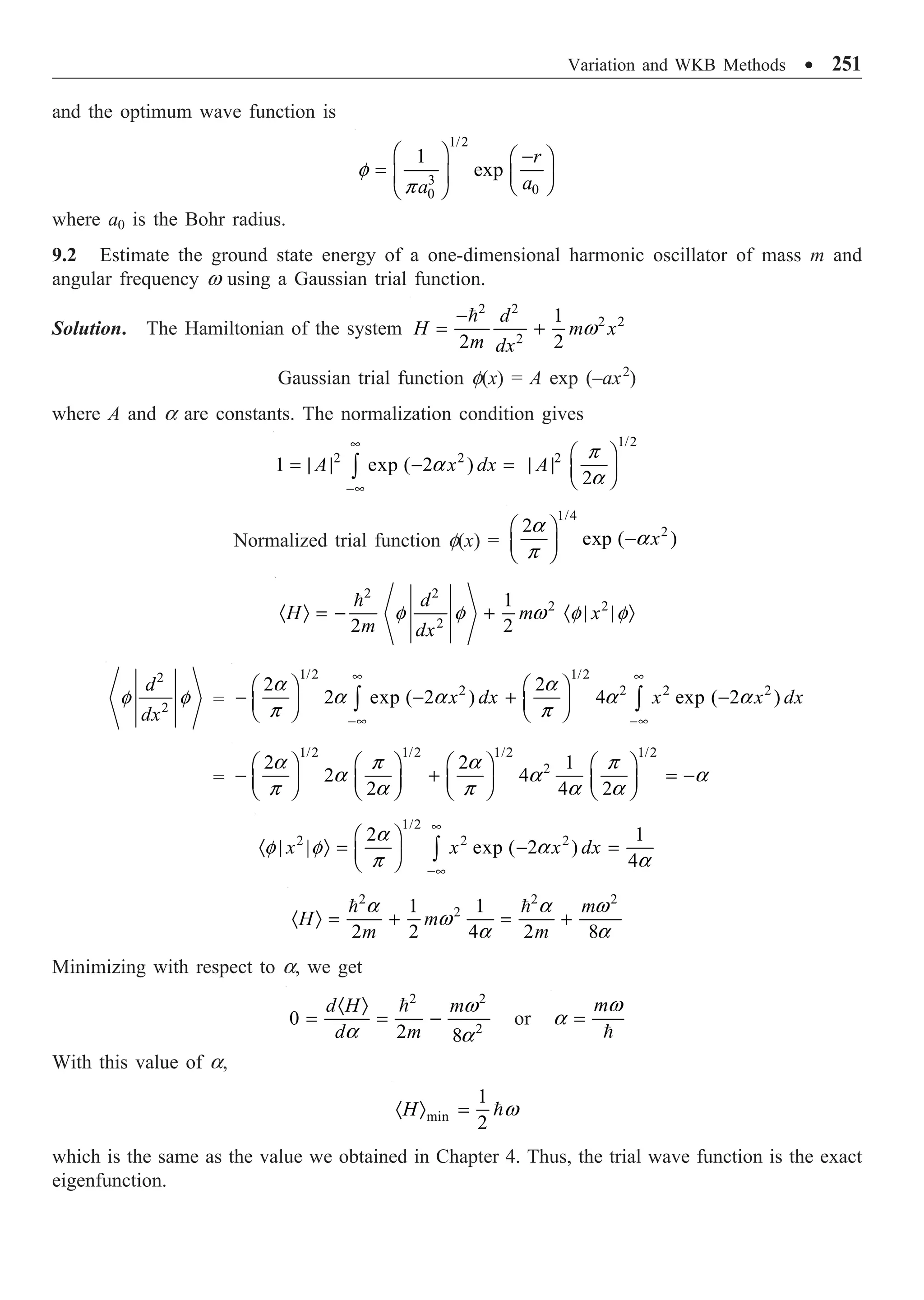
![252 ∑ Quantum Mechanics: 500 Problems with Solutions
9.3 The Schrödinger equation of a particle confined to the positive x-axis is
2 2
2
2
d
mgx E
m dx
-
+ =
y
y y
with y(0) = 0, y(x) Æ 0 as x Æ • and E is the energy eigenvalue. Use the trial function
x exp (–ax) and obtain the best value of the parameter a.
Solution.
Hamiltonian H =
2 2
2
2
d
mgx
m dx
-
+
Trial function f(x) = x exp (–ax)
2
3
0
1
exp ( 2 )
4
x ax dx
a
•
· | Ò = - =
Ú
f f
2 2
2
2
d
m dx
-
f f =
2 2 2
2
0 0
exp ( 2 ) exp ( 2 )
2
a
x x dx x x dx
m m
• •
- - -
Ú Ú
a a a
=
2 2 2
4 8 8
ma ma ma
- =
3
4
0
3
| exp ( 2 )
8
mg
mgx mg x x dx
a
•
· | Ò = - =
Ú
f f a
2 4 2 2
3
| | [ /(8 )] (3 /8 ) 3
| 2 2
1/4
H ma mg a a mg
H
m a
a
· Ò +
· Ò = = = +
· Ò
f f
f f
Minimizing ·HÒ with respect to a, we get
2
2
3
0 2
2 2
mg
a
m a
= -
or
1/3
2
2
3
2
m g
a
Ê ˆ
= Á ˜
Ë ¯
which is the best value of the parameter a so that ·HÒ is minimum.
9.4 A particle of mass m moves in the attractive central potential V(r) = –g2
/r3/2
, where g is a
constant. Using the normalized function (k3
/8p)1/2
e–kr/2
as the trial function, estimate an upper bound
to the energy of the lowest state. Given
1
0
!
n ax
n
n
x e dx
a
•
-
+
=
Ú if n is positive and a 0
we have
0
1
2
ax x
xe dx
a a
•
-
=
Ú
Solution. The expectation value of the Hamiltonian
·HÒ = ·f | H | fÒ =
3
2 /2
0
4
8
kr
k
r e
•
-
Ú
p
p
2 2
2 /2
2 3/2
1
2
kr
d d g
r e dr
m dr dr
r r
-
È ˘
Ê ˆ
¥ - -
Í ˙
Á ˜
Ë ¯
Í ˙
Î ˚](https://image.slidesharecdn.com/quantummechanics500problemswithsolutionspdfdrive-220626164912-635041ea/75/Quantum-Mechanics_-500-Problems-with-Solutions-PDFDrive-pdf-262-2048.jpg)
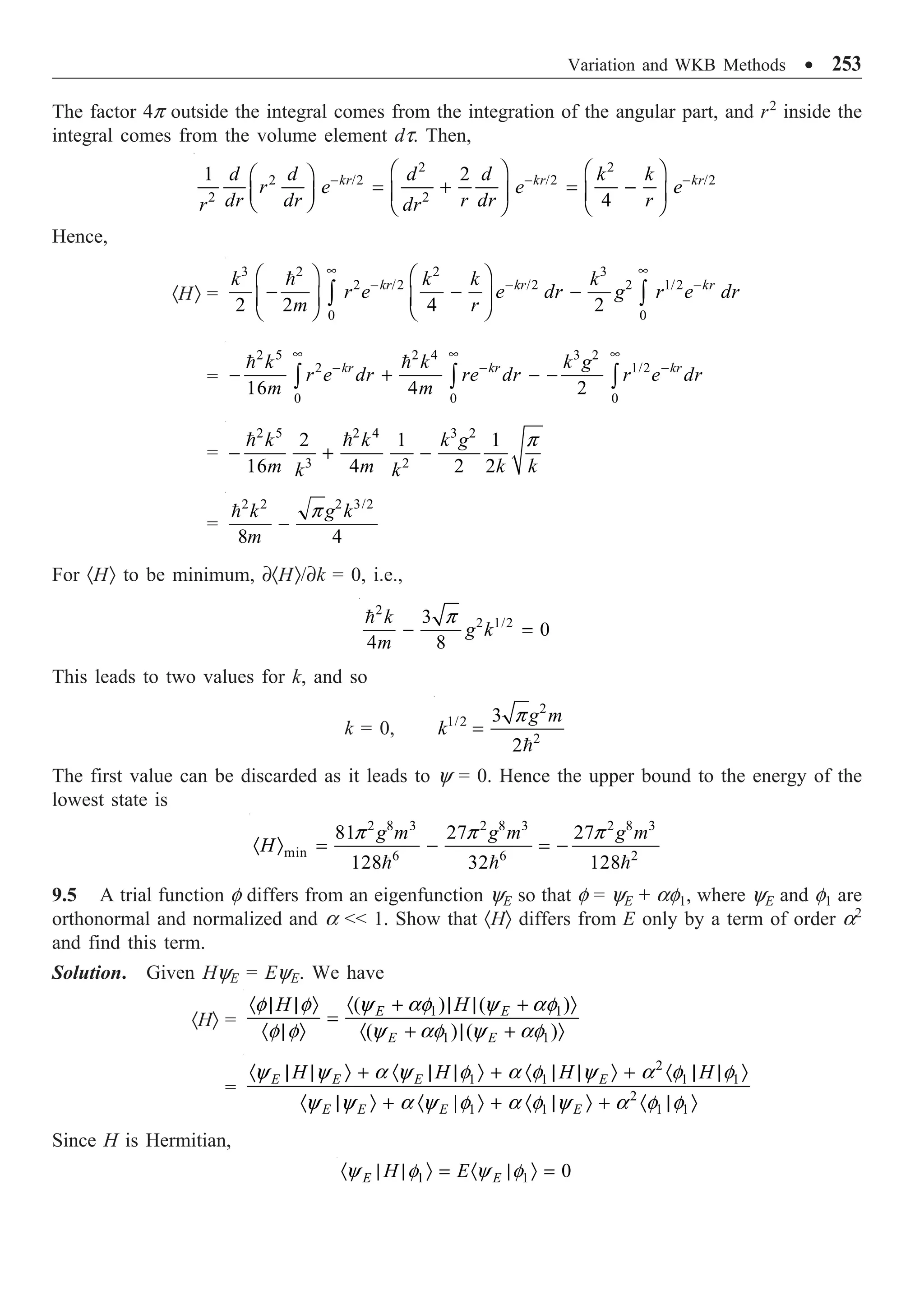
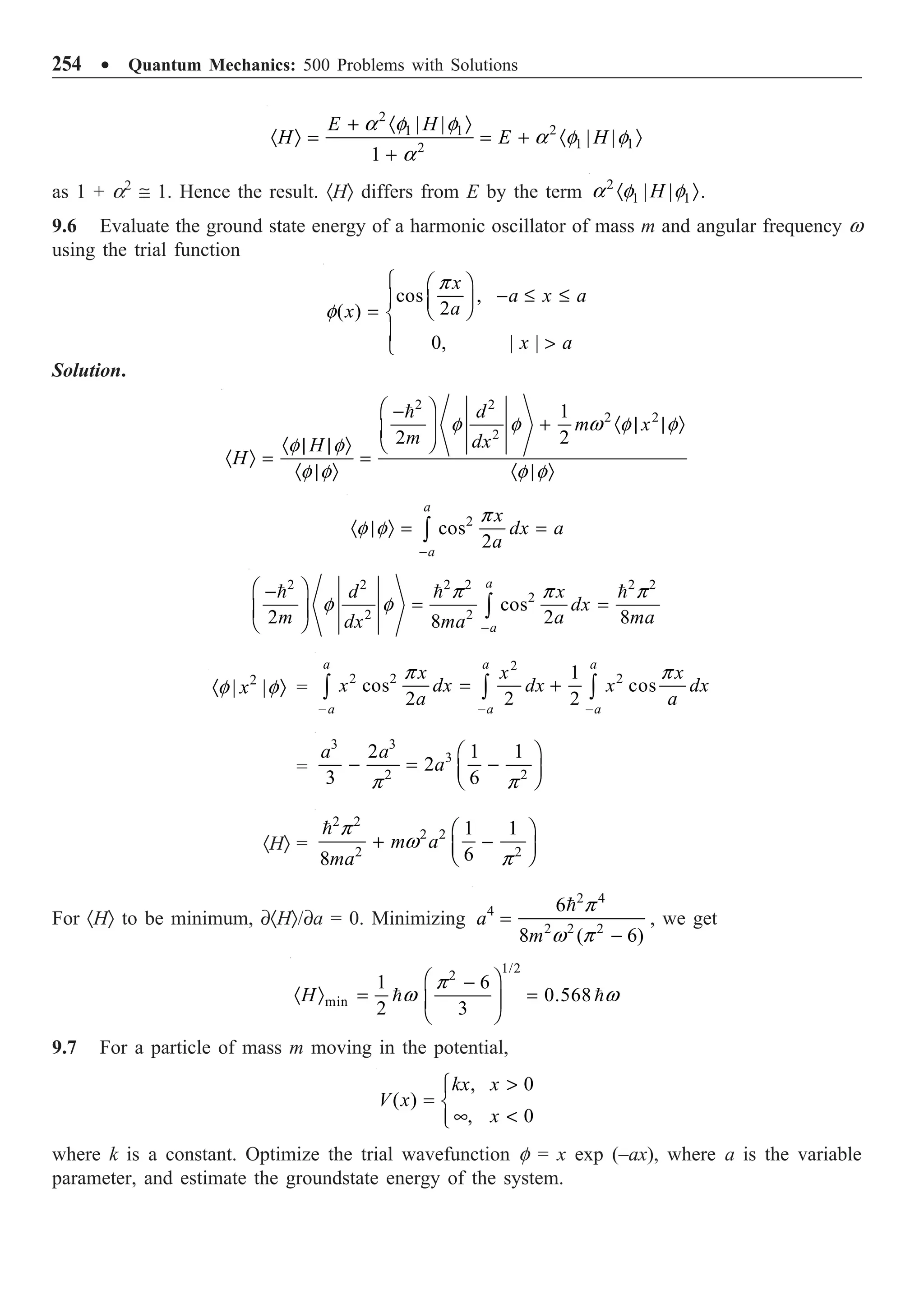
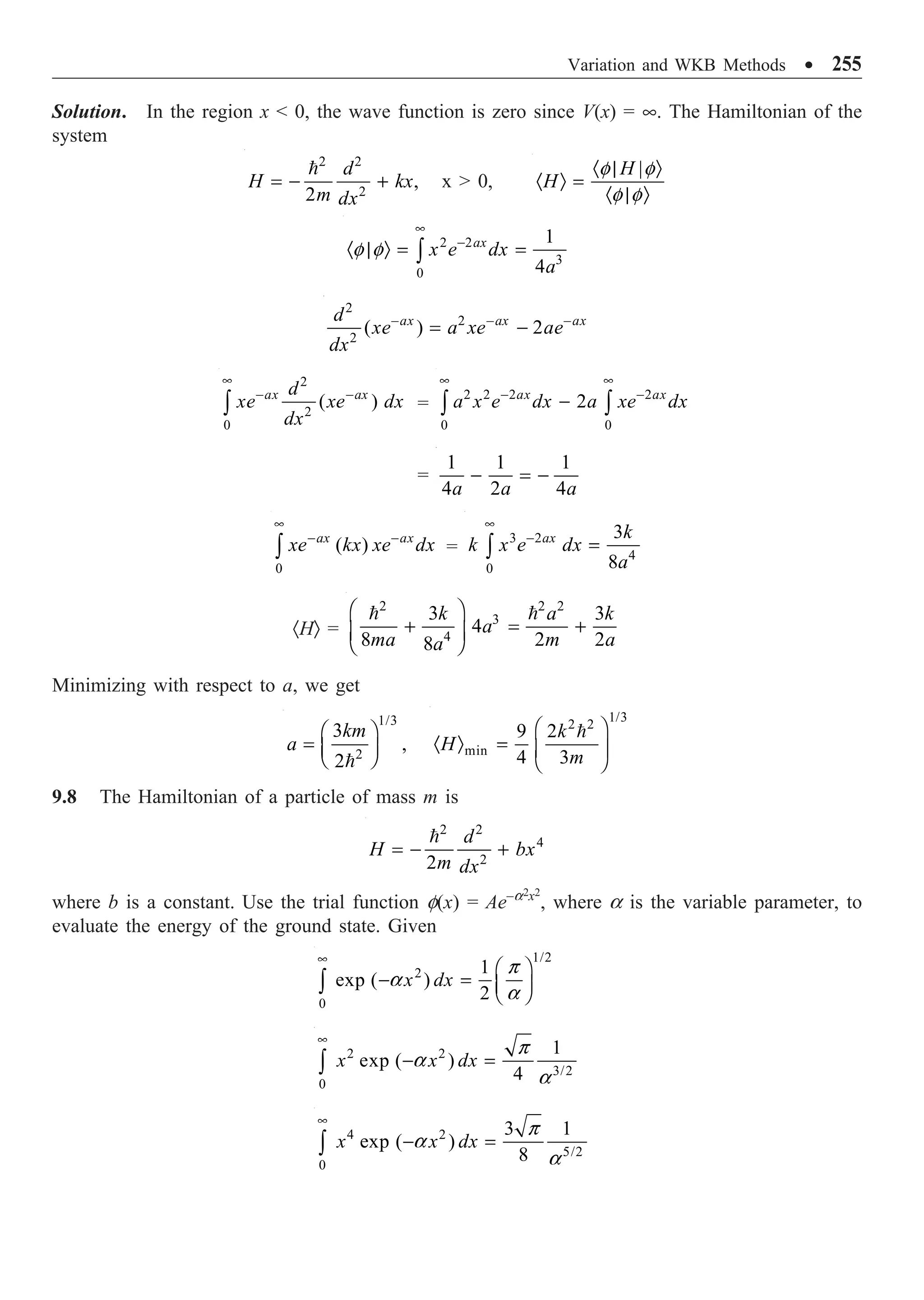
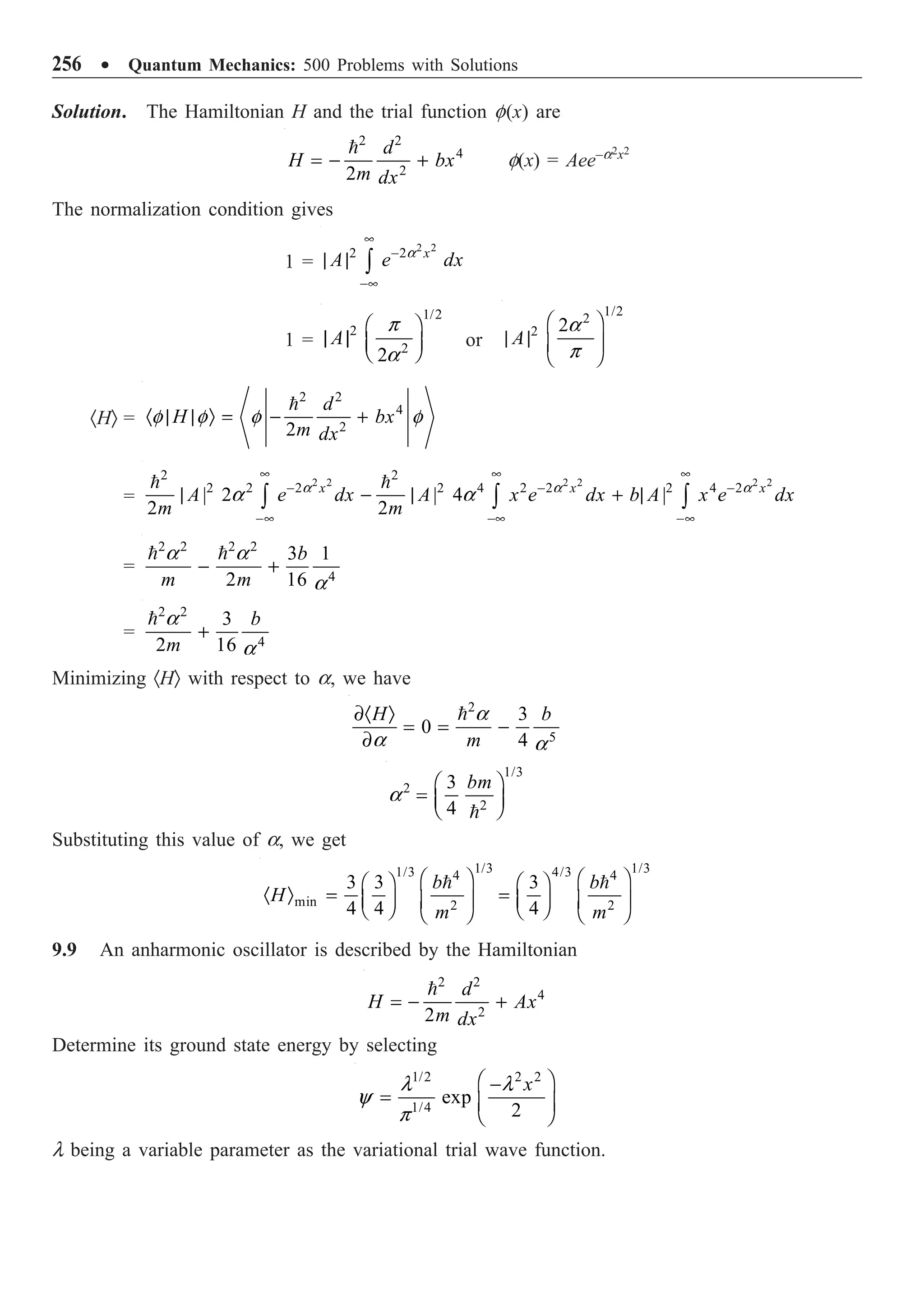

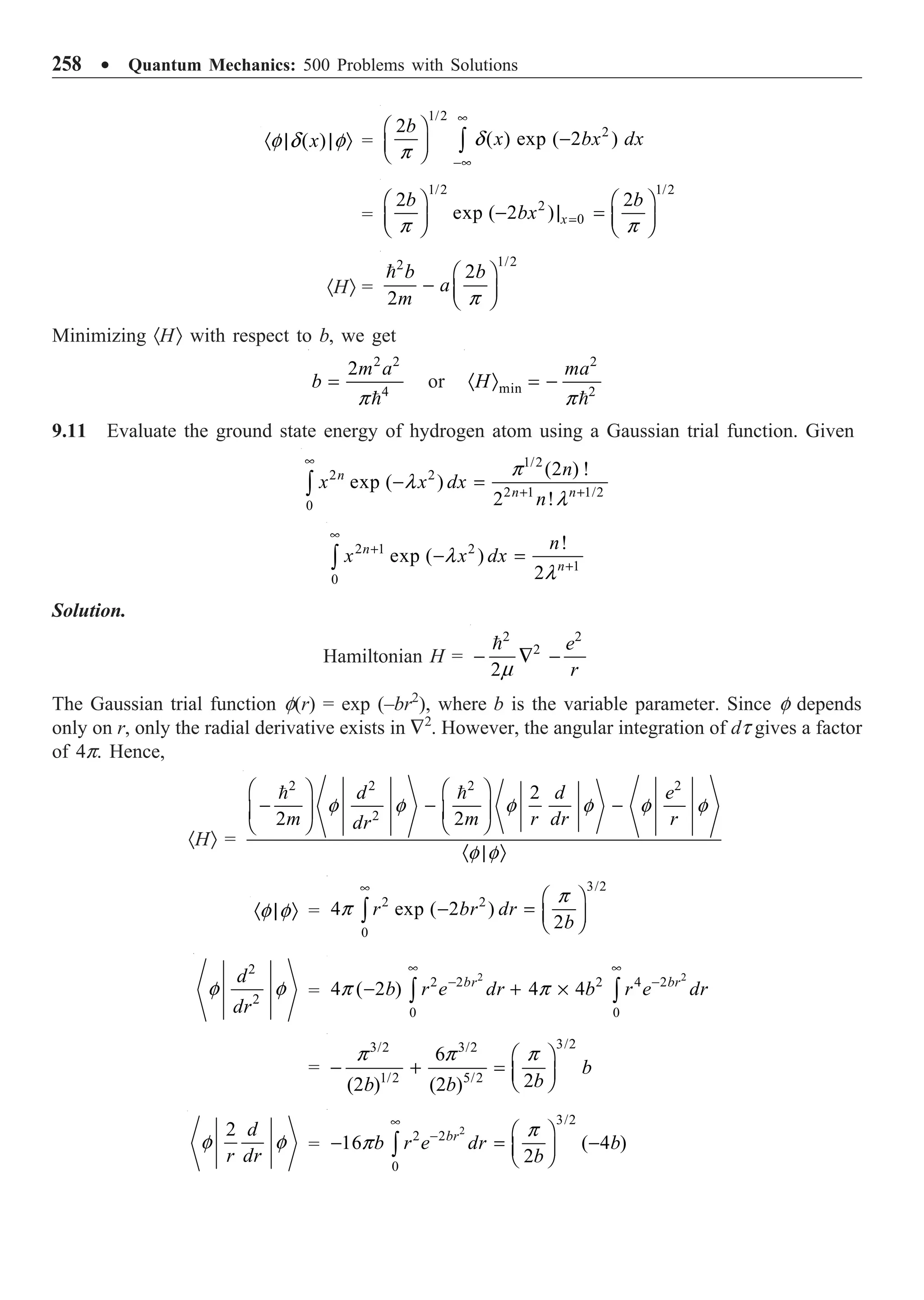
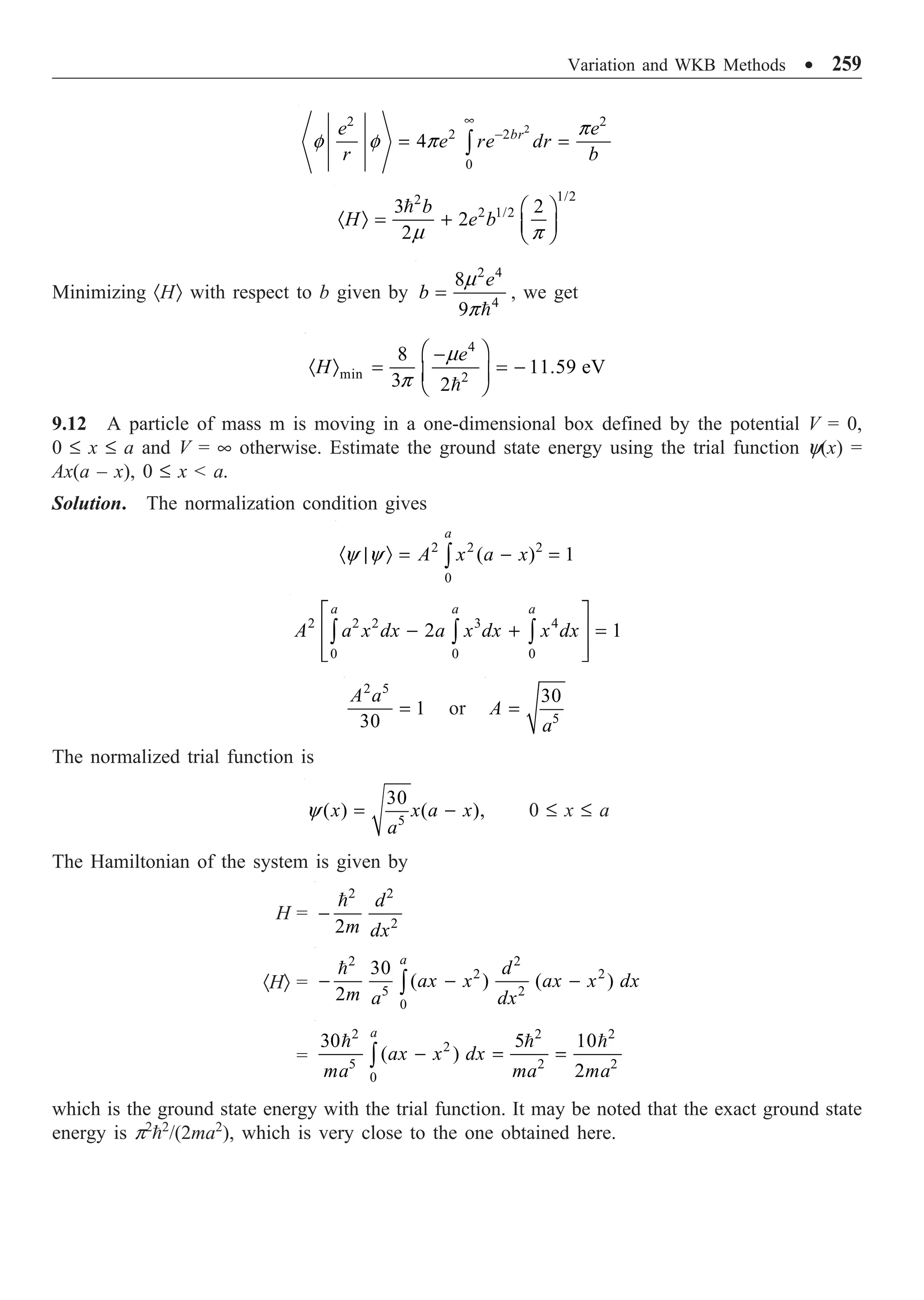
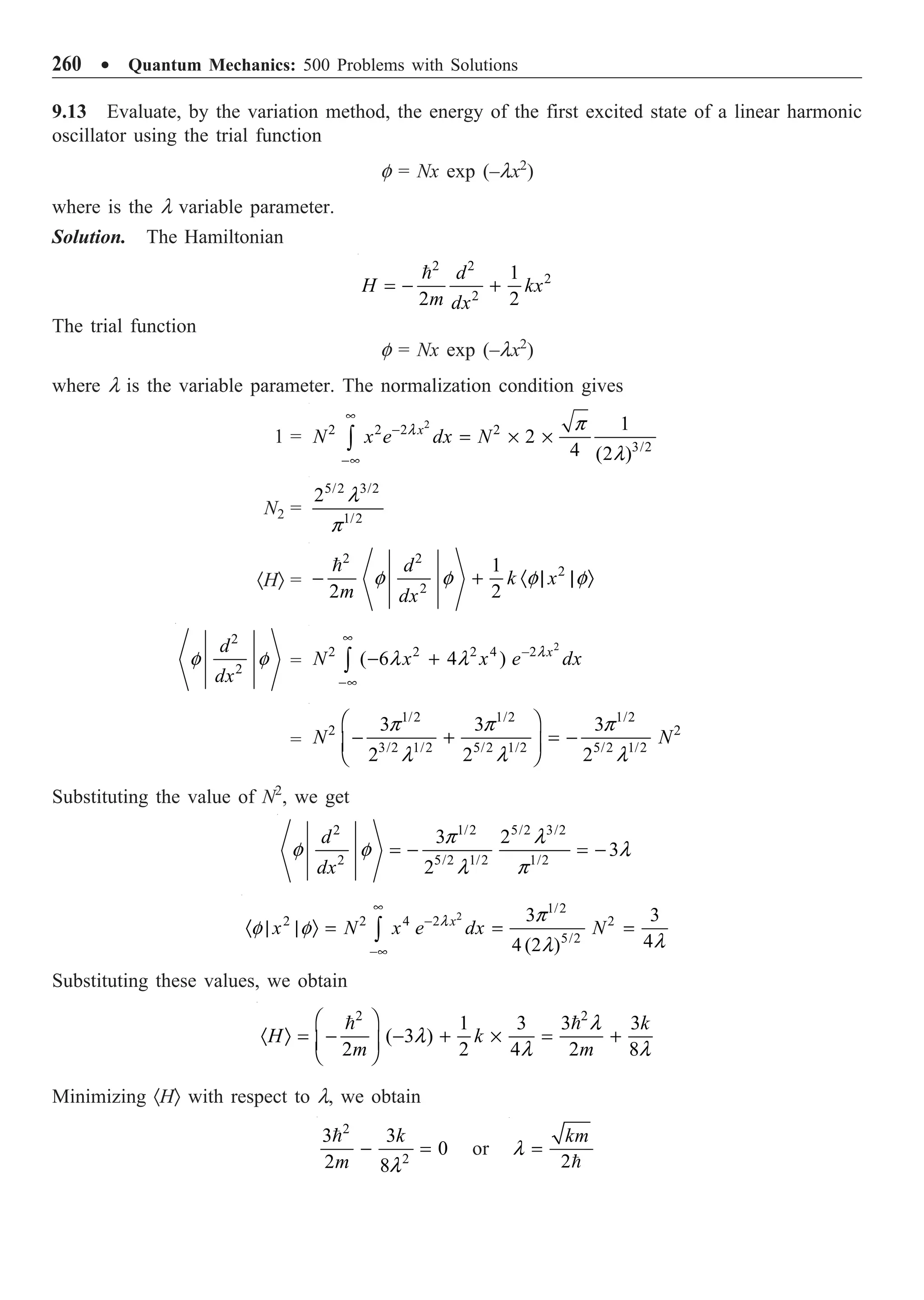
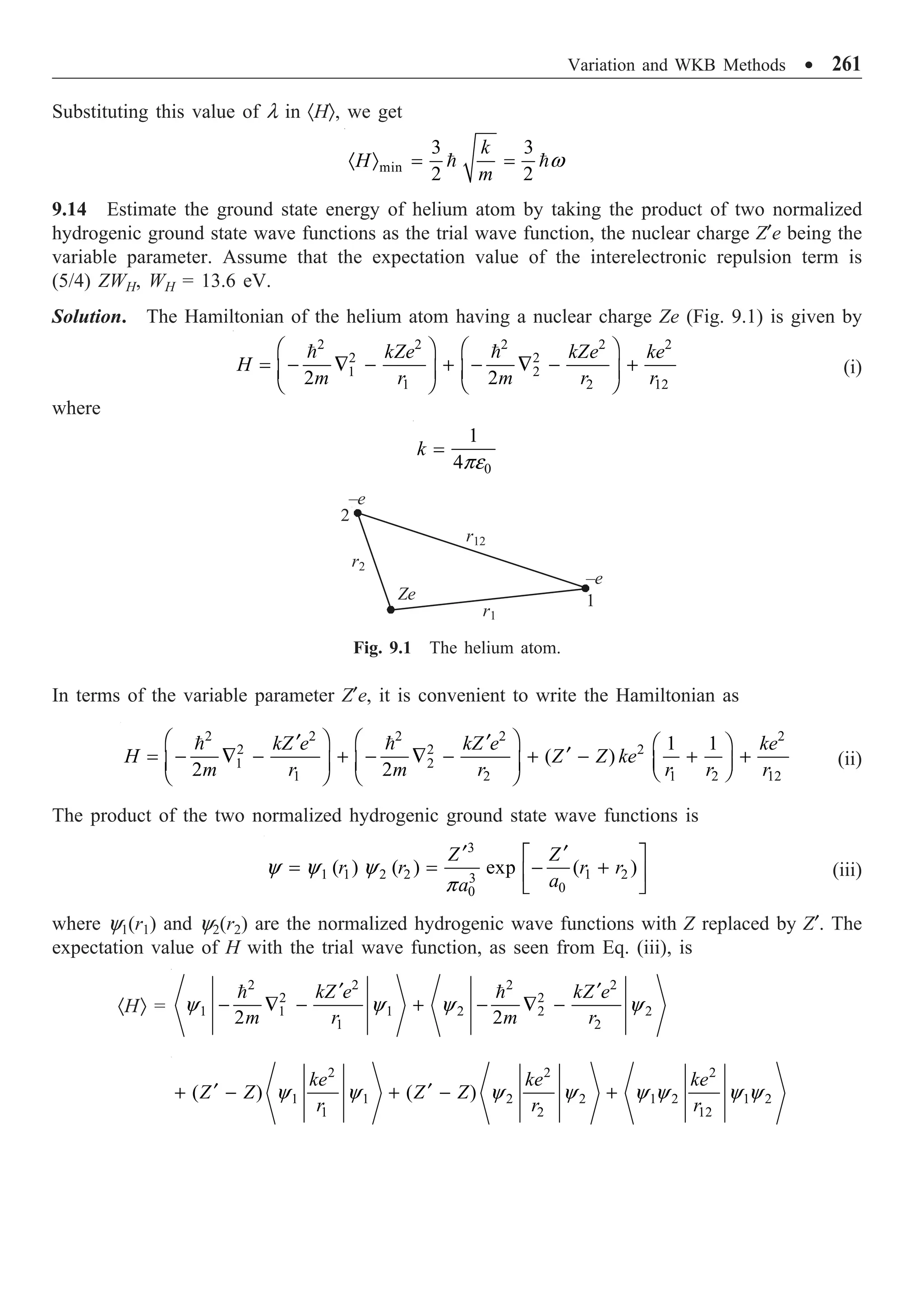
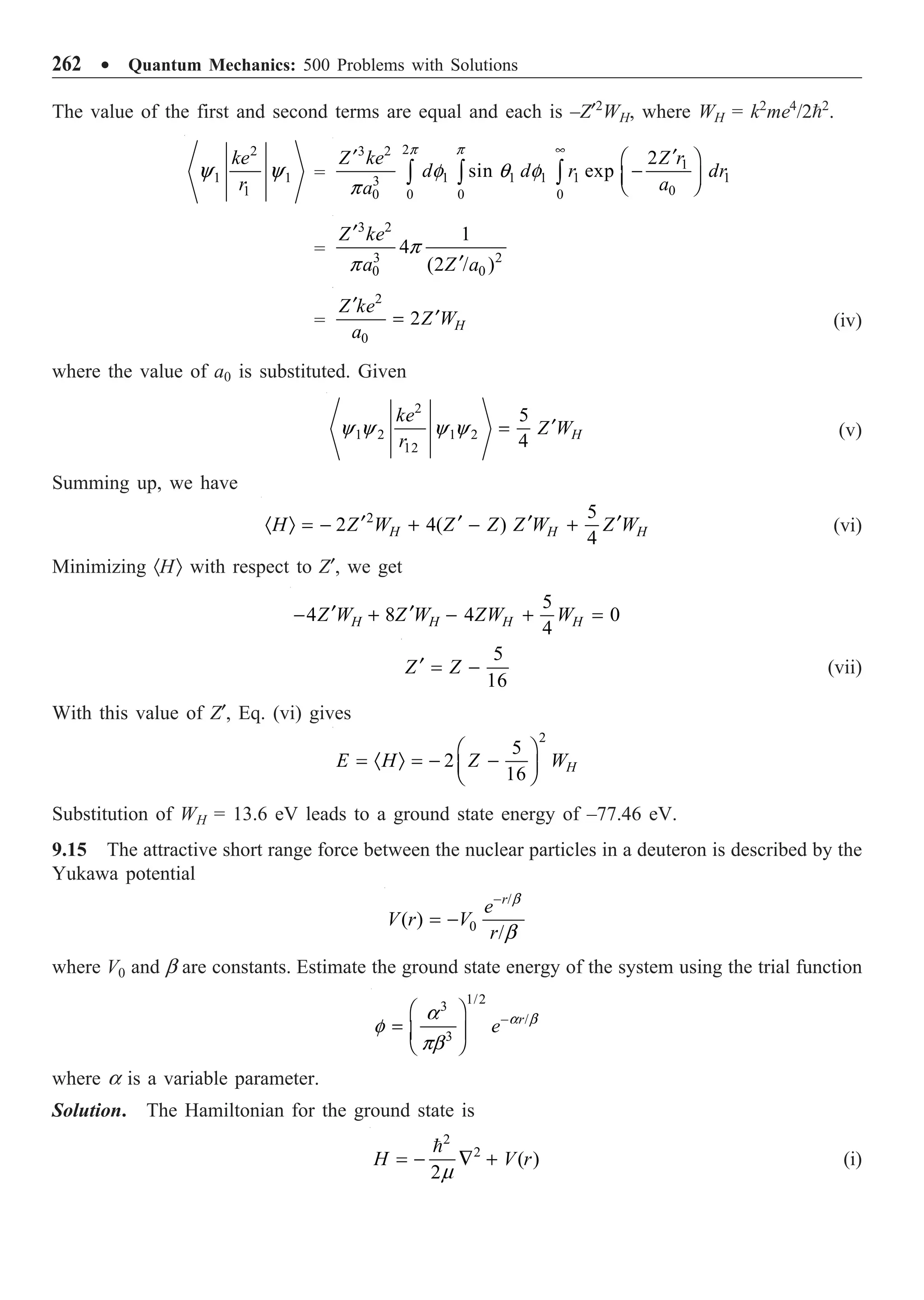
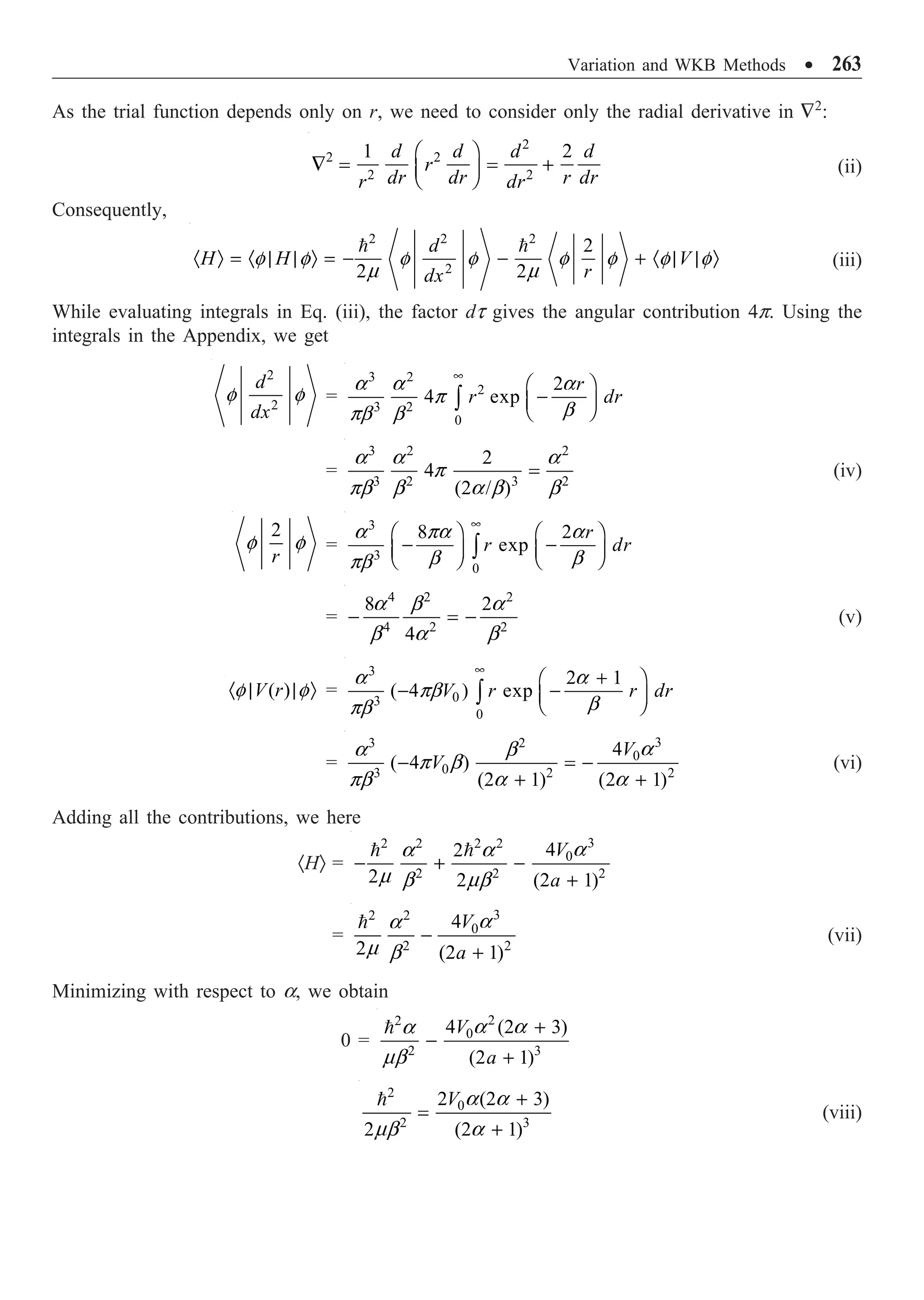
![264 ∑ Quantum Mechanics: 500 Problems with Solutions
Repalcing 2
/2mb2
in Eq. (vii) using Eq. (viii), we get
·HÒ =
3 3
0 0
3 2
2 (2 3) 4
(2 1) (2 1)
V V
+
-
+ +
a a a
a a
=
3
0
3
2
[(2 3) 2(2 1)]
(2 1)
V
+ - +
+
a
a a
a
E =
3
0
2 (2 1)
(2 1)
V -
+
a a
a
where a is given by Eq. (viii).
9.16 Consider a particle having momentum p moving inside the one-dimensional potential well
shown in Fig. 9.2. If E V(x), show by the WKB method, that
2
1
1
2 ,
2
x
x
p dx n h
Ê ˆ
= +
Á ˜
Ë ¯
Ú n = 0, 1, 2, º
V(x)
x1 x2 x
E = V(x1)
Region 1 Region 2 Region 3
E = V(x2)
Fig. 9.2 A potential well with linear turning points at x1 and x2.
Solution. Classically, the particle will oscillate back and forth between the turning points x1 and
x2. Quantum mechanically, the particles can penetrate into regions 1 and 2. The wave functions in
regions 1 and 2 are exponentially decreasing. When we move from region 1 to region 2, the barrier
is to the left of the turning point and, when we move from region 2 to region 3, the barrier is to the
right of the turning point. The wave function in region 1 is
1
2
1
1
exp ,
x
x
dx
r
Ê ˆ
= -
Á ˜
Ë ¯
Ú
y g 2
2
2 [ ( ) ]
m V x E
-
=
g (i)
Applying Eq. (9.8), we get
1
2
2
2
cos ,
4
x
x
k dx
k
Ê ˆ
= -
Á ˜
Ë ¯
Ú
p
y 2
2
2 [ ( )]
m E V x
k
-
=
(ii)](https://image.slidesharecdn.com/quantummechanics500problemswithsolutionspdfdrive-220626164912-635041ea/75/Quantum-Mechanics_-500-Problems-with-Solutions-PDFDrive-pdf-274-2048.jpg)
![Variation and WKB Methods ∑ 265
The wave function that connects region 2 with the decreasing potential of region 3 being of the type
2
1
cos
4
x
x
k dx
Ê ˆ
-
Á ˜
Ë ¯
Ú
p
Hence, Eq. (ii) should be modified as
2
1 2
2
2
cos
4
x x
x x
k dx k dx
k
Ê ˆ
= + -
Á ˜
Ë ¯
Ú Ú
p
y (iii)
Since cos (–q) = cos q and sin (–q) = –sin q, Eq. (iii) can be rewritten as
y2 =
2 2 2 2
1 1
2 2
cos cos sin sin
4 4
x x x x
x x x x
k dx k dx k dx k dx
k k
Ê ˆ Ê ˆ
Ê ˆ Ê ˆ
+ + +
Á ˜ Á ˜
Á ˜ Á ˜
Ë ¯ Ë ¯
Ë ¯ Ë ¯
Ú Ú Ú Ú
p p
=
2 2 2 2
1 1
2 2
cos sin sin cos
4 4
x x x x
x x x x
k dx k dx k dx k dx
k k
Ê ˆ Ê ˆ
Ê ˆ Ê ˆ
- + -
Á ˜ Á ˜
Á ˜ Á ˜
Ë ¯ Ë ¯
Ë ¯ Ë ¯
Ú Ú Ú Ú
p p
(iv)
Comparison of Eqs. (iv) and (9.7) shows that the second term of Eq. (iv) is the one that connects
with the decreasing exponential of region 3, while the first term connects with the increasing
exponential. Since an increasing exponential in region 3 is not acceptable, the first term has to be
zero. This is possible if
2
1
cos 0
x
x
k dx =
Ú or
2
1
1
,
2
x
x
k dx n
Ê ˆ
= +
Á ˜
Ë ¯
Ú p n = 0, 1, 2, º (v)
Substituting the value of k, we get
2
1
1/2
1/2
2
2 1
[ ( )] ,
2
x
x
m
E V x dx n
Ê ˆ Ê ˆ
- = +
Á ˜ Á ˜
Ë ¯ Ë ¯
Ú
p n = 0, 1, 2, º (vi)
which gives the allowed energy value. Classically, since the linear momentum p = [2m (E – V)]1/2
,
Eq. (vi) can be rewritten as
2
1
1
2 ,
2
x
x
p dx n h
Ê ˆ
= +
Á ˜
Ë ¯
Ú n = 0, 1, 2, º (vii)
The LHS is the value of the integral over a complete cycle.
9.17 Obtain the energy values of harmonic oscillator by the WKB method.
Solution. The classical turning points of the oscillator are those points at which the potential V(x)
= E, i.e., 1/2mw2
x2
= E or x1 = –(2E/mw2
)1/2
and x2 = (2E/mw2
)1/2
. For a particle constrained to move
between classical turning points x1 and x2 in a potential well, the energies can be obtained from the
condition (vii) of Problem 9.16. We then have
E =
2
2 2
1
2 2
p
m x
m
+ w or
1/2
2 2
1
2
2
p m E m x
È ˘
Ê ˆ
= -
Í ˙
Á ˜
Ë ¯
Î ˚
w](https://image.slidesharecdn.com/quantummechanics500problemswithsolutionspdfdrive-220626164912-635041ea/75/Quantum-Mechanics_-500-Problems-with-Solutions-PDFDrive-pdf-275-2048.jpg)
![266 ∑ Quantum Mechanics: 500 Problems with Solutions
Substituting this value of p in Eq. (vii) of Problem 9.16, we get
2
1
1/2
2 2
1 1
2 ,
2 2
x
x
m E m x dx n
È ˘
Ê ˆ Ê ˆ
- = +
Í ˙
Á ˜ Á ˜
Ë ¯ Ë ¯
Î ˚
Ú
w p n = 0, 1, 2, º
Writing sin q = (mw2
/2E)1/2
x, the above integral reduces to
1/2
/2
1/2 2
2
/2
2 1
(2 ) cos
2
E
mE d n
m
-
Ê ˆ Ê ˆ
= +
Á ˜ Á ˜
Ë ¯ Ë ¯
Ú
p
p
q q p
w
/2
2
/2
2 1
cos
2
E
d n
-
Ê ˆ Ê ˆ
= +
Á ˜ Á ˜
Ë ¯ Ë ¯
Ú
p
p
q q p
w
2 1
2 2
E
n
Ê ˆ
¥ = +
Á ˜
Ë ¯
p
p
w
or
1
2
E n
Ê ˆ
= +
Á ˜
Ë ¯
w
9.18 Solve the following one-dimensional infinite potential well:
V(x) = 0 for –a x a; V(x) = • for | x | a
using the WKB method and compare it with the exact solution.
Solution. V(x) = 0 for –a x a and V(x) = • for | x | a. The turning points are x1 = –a and
x2 = a. The allowed energies can be obtained using the relation
1
,
2
a
a
k dx n
-
Ê ˆ
= +
Á ˜
Ë ¯
Ú p 2
2
2
,
mE
k =
n = 0, 1, 2, º
1/2
2
2 1
2
a
a
mE
dx n
-
Ê ˆ Ê ˆ
= +
Á ˜ Á ˜
Ë ¯ Ë ¯
Ú
p
2 2 2
2
[ (1/2) ]
,
8
n
n
E
ma
+
=
p
n = 0, 1, 2, º
The exact solution gives
2 2 2
2
,
8
n
n
E
ma
=
p
n = 1, 2, 3, º
The WKB solution has n + (1/2) in place of n. Another major difference is in the allowed values
of n.
9.19 Estimate the energy levels of a particle moving in the potential
V(x) =
, 0
, 0
x
Ax x
•
Ï
Ì
Ô
Ó
A being a constant.
Solution. The classical turning points are at x1 = 0 and at x2 = E/A. Now,
2
1
1
,
2
x
x
k dx n
Ê ˆ
= +
Á ˜
Ë ¯
Ú p 2
2
2
( )
m
k E V
= -](https://image.slidesharecdn.com/quantummechanics500problemswithsolutionspdfdrive-220626164912-635041ea/75/Quantum-Mechanics_-500-Problems-with-Solutions-PDFDrive-pdf-276-2048.jpg)
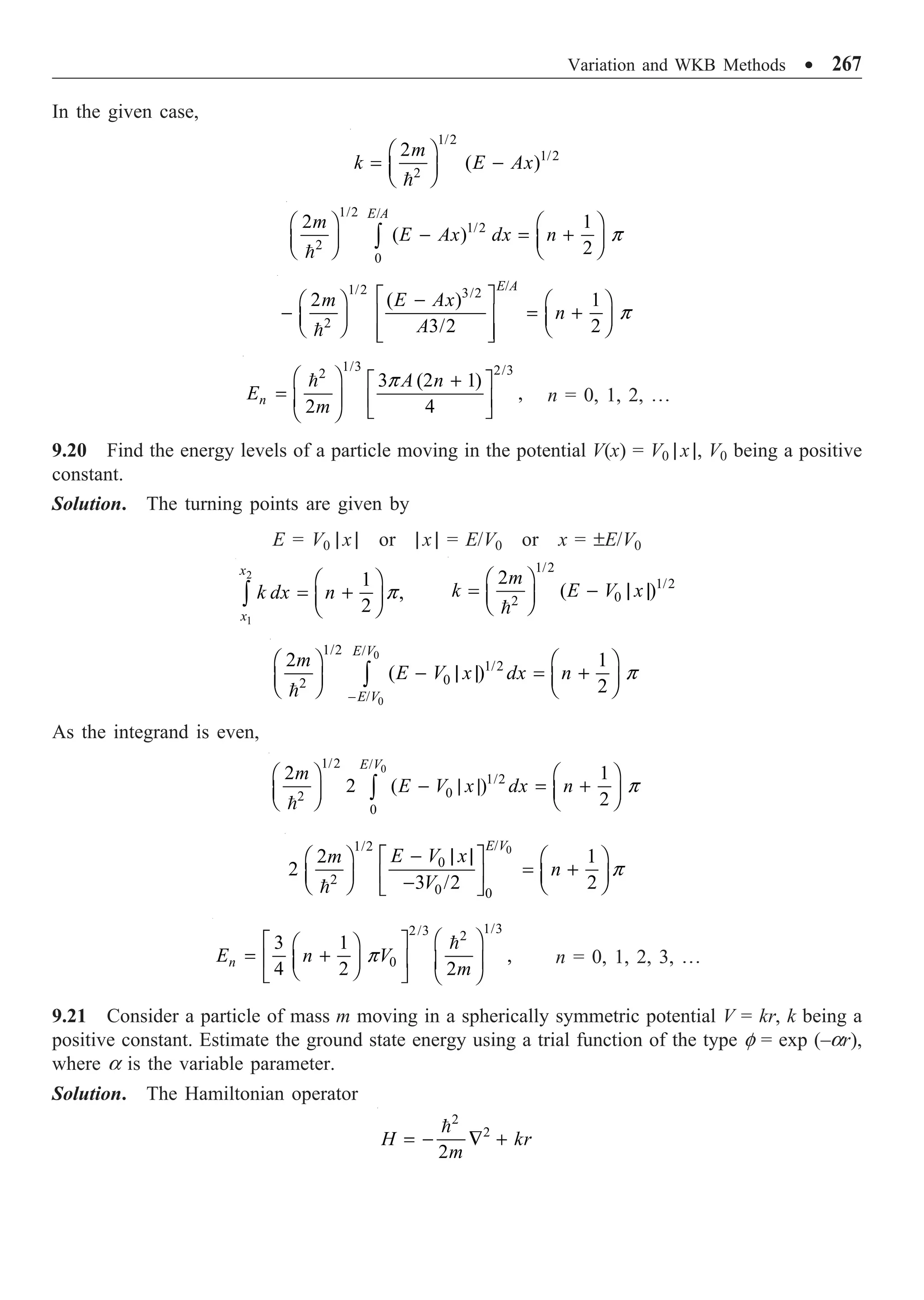
![268 ∑ Quantum Mechanics: 500 Problems with Solutions
As the trial wave function is not normalized,
,
H
H
· | | Ò
· Ò =
· | Ò
f f
f f
f = e–ar
2 2
3 3
0
2! 1
(2 ) 4
r
e r dr
•
-
· | Ò = = =
Ú
a
f f
a a
(see Appendix). Now,
·f | H | fÒ =
2
2 2 3 2
2
0 0
1
2
r r r
d d
e r e r dr k r e dr
m dr dr
r
• •
- - -
È ˘
Ê ˆ
- +
Í ˙
Á ˜
Ë ¯
Î ˚
Ú Ú
a a a
=
2 2 2
2 2 2 3 2
0 0 0
2
r r r
r e dr re dr k r e dr
m m
• • •
- - -
- + +
Ú Ú Ú
a a a
a a
Using the standard integral in the Appendix, we get
·f | H | fÒ =
2 2 2
3 2 4
2! 1 3 !
2 (2 ) (2 ) (2 )
k
m m
- + +
a a
a a a
=
2
4
3
8 8
k
m
+
a a
·HÒ =
2 2
3
2 2
H k
m
· | | Ò
= +
· | Ò
f f a
f f a
For ·HÒ to be minimum, it is necessary that
0
H
∂· Ò
=
∂a
2
2
3
0
2
k
m
- =
a
a
or
1/3
2
3
2
km
Ê ˆ
= Á ˜
Ë ¯
a
With this value of a, the ground state energy
2/3 1/3
2/3
2 2 2 2
2
3 3 2 3 9
2 2 3 2 4
2
mk k k
E
m km m
Ê ˆ Ê ˆ
Ê ˆ
= + =
Á ˜ Á ˜ Á ˜
Ë ¯ Ë ¯ Ë ¯
9.22 Using the WKB method, calculate the transmission coefficient for the potential barrier
0 1 ,
( )
0,
x
V x
V x
x
l
l
l
Ï | |
Ê ˆ
- | |
Ô Á ˜
Ë ¯
= Ì
Ô | |
Ó
Solution. The transmission coefficient
2
1
exp 2 ,
x
x
T dx
Ê ˆ
= -
Á ˜
Ë ¯
Ú l 2
2
2
[ ( ) ]
m
V x E
= -
l](https://image.slidesharecdn.com/quantummechanics500problemswithsolutionspdfdrive-220626164912-635041ea/75/Quantum-Mechanics_-500-Problems-with-Solutions-PDFDrive-pdf-278-2048.jpg)
![Variation and WKB Methods ∑ 269
where x1 and x2 are the turning points. At the turning points,
0
( ) 1
x
E V x V
| |
Ê ˆ
= = -
Á ˜
Ë ¯
l
or
0
1
E x
V
| |
= -
l
0
0
V E
x
V
-
Ê ˆ
| | = Á ˜
Ë ¯
l or
0
0
V E
x
V
-
Ê ˆ
= ± Á ˜
Ë ¯
l
0
1
0
V E
x
V
-
Ê ˆ
= - Á ˜
Ë ¯
l ,
0
2
0
V E
x
V
-
Ê ˆ
= Á ˜
Ë ¯
l
2
1
2
x
x
dx
- Ú g =
2
1
1/2
0
0
2
2
2
x
x
V x
m
V E dx
Ê ˆ
- - -
Á ˜
Ë ¯
Ú
l
=
2
1
3/2
0
0
0
2 2 2
3
x
x
V x
m
V E
V
È ˘
Ê ˆ Ê ˆ
Ê ˆ
Í ˙
- - - -
Á ˜ Á ˜ Á ˜
Ë ¯ Ë ¯ Ë ¯
Í ˙
Î ˚
l
l
= 3/2
0
0
16
( )
3
m
V E
V
- -
l
T = 3/2
0
0
16
exp ( )
3
m
V E
V
È ˘
- -
Í ˙
Í ˙
Î ˚
l
9.23 Use the WKB method to calculate the transmission coefficient for the potential barrier
V(x) =
0 , 0
0, 0
V ax x
x
-
Ï
Ì
Ô
Ó
Solution. The transmission coefficient
2
1
exp 2 ,
x
x
T dx
Ê ˆ
= -
Á ˜
Ë ¯
Ú g 2
2
2
[ ( ) ]
m
V x E
= -
g
From the value of V(x), it is clear that the turning point x1 = 0. To get the other turning point, it is
necessary that
E = V(x) = V0 – ax2
x2 = 0
V E
a
-
g = 1/2
0
2
( )
m
V ax E
- -](https://image.slidesharecdn.com/quantummechanics500problemswithsolutionspdfdrive-220626164912-635041ea/75/Quantum-Mechanics_-500-Problems-with-Solutions-PDFDrive-pdf-279-2048.jpg)
![270 ∑ Quantum Mechanics: 500 Problems with Solutions
2
1
2
x
x
dx
- Ú g =
2
1/2
0
0
2
2 ( )
x
m
V E ax dx
- - -
Ú
=
2
3/2
0
0
2 2 1
2 ( )
3
x
m
V E ax
a
Ê ˆ È ˘
- - - -
Á ˜ Î ˚
Ë ¯
= 3/2 3/2
0 0
4 2
[( ) ( ) ]
3
m
V E ax V E
a
- - - -
= 3/2
0
4 2
[ ]
3
m
V E
a
- -
T = 3/2
0
4 2
exp ( )
3
m
V E
a
È ˘
- -
Í ˙
Í ˙
Î ˚](https://image.slidesharecdn.com/quantummechanics500problemswithsolutionspdfdrive-220626164912-635041ea/75/Quantum-Mechanics_-500-Problems-with-Solutions-PDFDrive-pdf-280-2048.jpg)
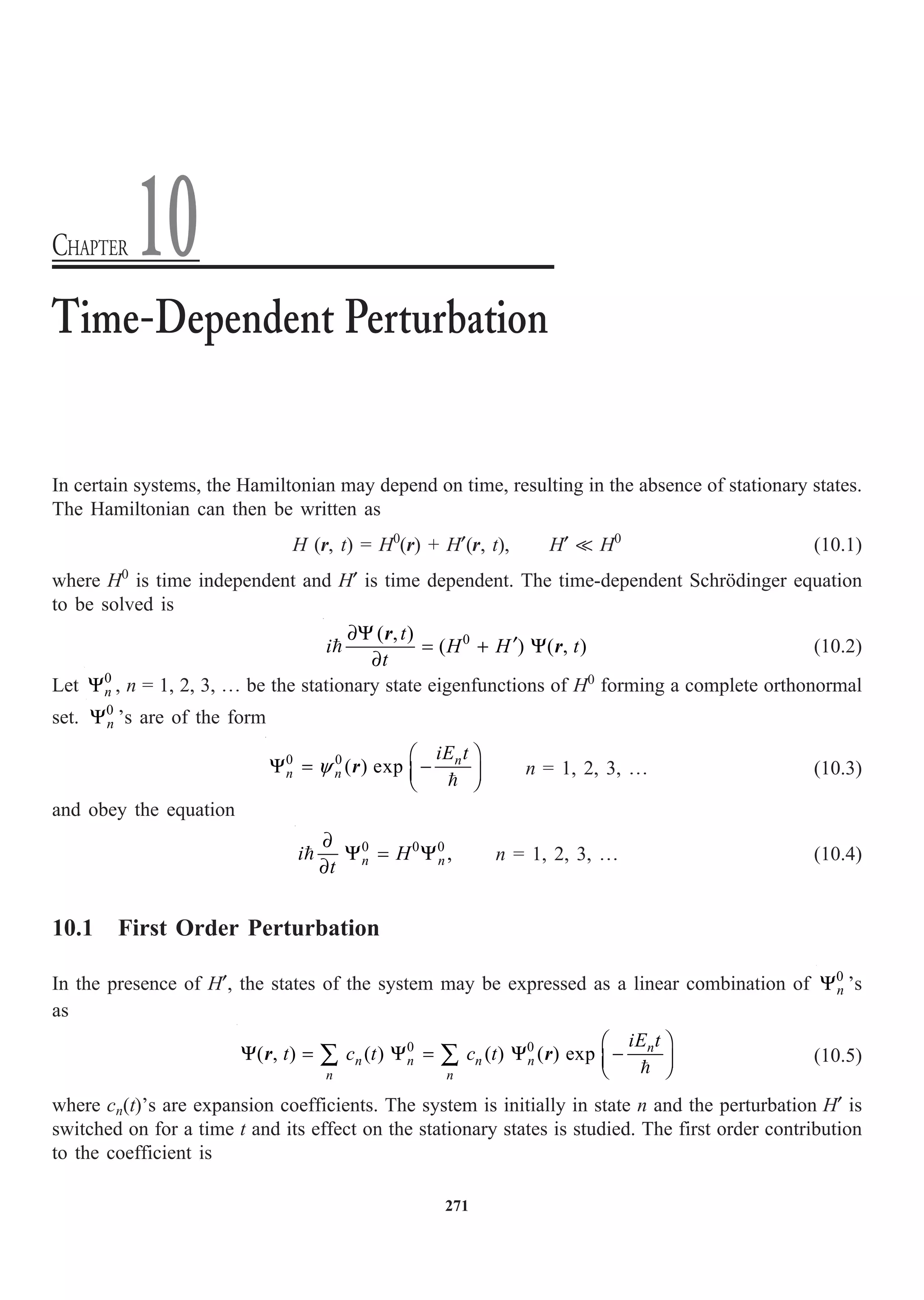
![272 ∑ Quantum Mechanics: 500 Problems with Solutions
(1)
0
1
( ) ( , ) exp ( )
t
kn kn
k
c t H t i t dt
t
¢ ¢ ¢ ¢
= Ú
w
r (10.6)
where
0 0
kn k n
H H k H n
¢ ¢ ¢
= · | | Ò = · | | Ò
y y
k n
kn
E E
-
=
w (10.7)
The perturbation H¢ has induced transition to other states and, after time t, the probability that a
transition to state k has occurred is given by (1) 2
( ) .
k
c t
| |
10.2 Harmonic Perturbation
A harmonic perturbation with an angular frequency w has the form
( , ) 2 ( ) cos ( ) ( )
i t i t
H t H r t H e e-
¢ ¢ ¢
= = +
w w
w
r r (10.8)
With this perturbation, we get
(1) exp [ ( ) ] 1 exp [ ( ) ] 1
( ) kn kn kn
k
kn kn
H i t i t
c t
¢ + - - -
È ˘
= - +
Í ˙
+ -
Î ˚
w w w w
w w w w
(10.9)
The first term on the RHS of Eq. (10.9) has a maximum value when wkn + w @ 0 or Ek @ En – w
which corresponds to induced or stimulated emission. The second term is maximum when
Ek @ En + w which corresponds to absorption. The probability for absorption is obtained as
2 2
2
2 2
4 sin ( ) /2
( ) | ( )|
( )
kn kn
n k kn
kn
H t
P t c t
w w
w w
Æ
¢
| | -
= =
-
(10.10)
10.3 Transition to Continuum States
Next we consider transitions from a discrete state n to a continuum of states around Ek, where the
density of states is r(Ek). The probability for transition into range dEk is
2
2
( ) ( )
kn k
P t t H E
¢
= | |
p
r (10.11)
The transition probability w is the number of transitions per unit time and is given by
2
2
( )
kn k
H E
¢
= | |
p
w r (10.12)
which is called Fermi’s Golden Rule.](https://image.slidesharecdn.com/quantummechanics500problemswithsolutionspdfdrive-220626164912-635041ea/75/Quantum-Mechanics_-500-Problems-with-Solutions-PDFDrive-pdf-282-2048.jpg)
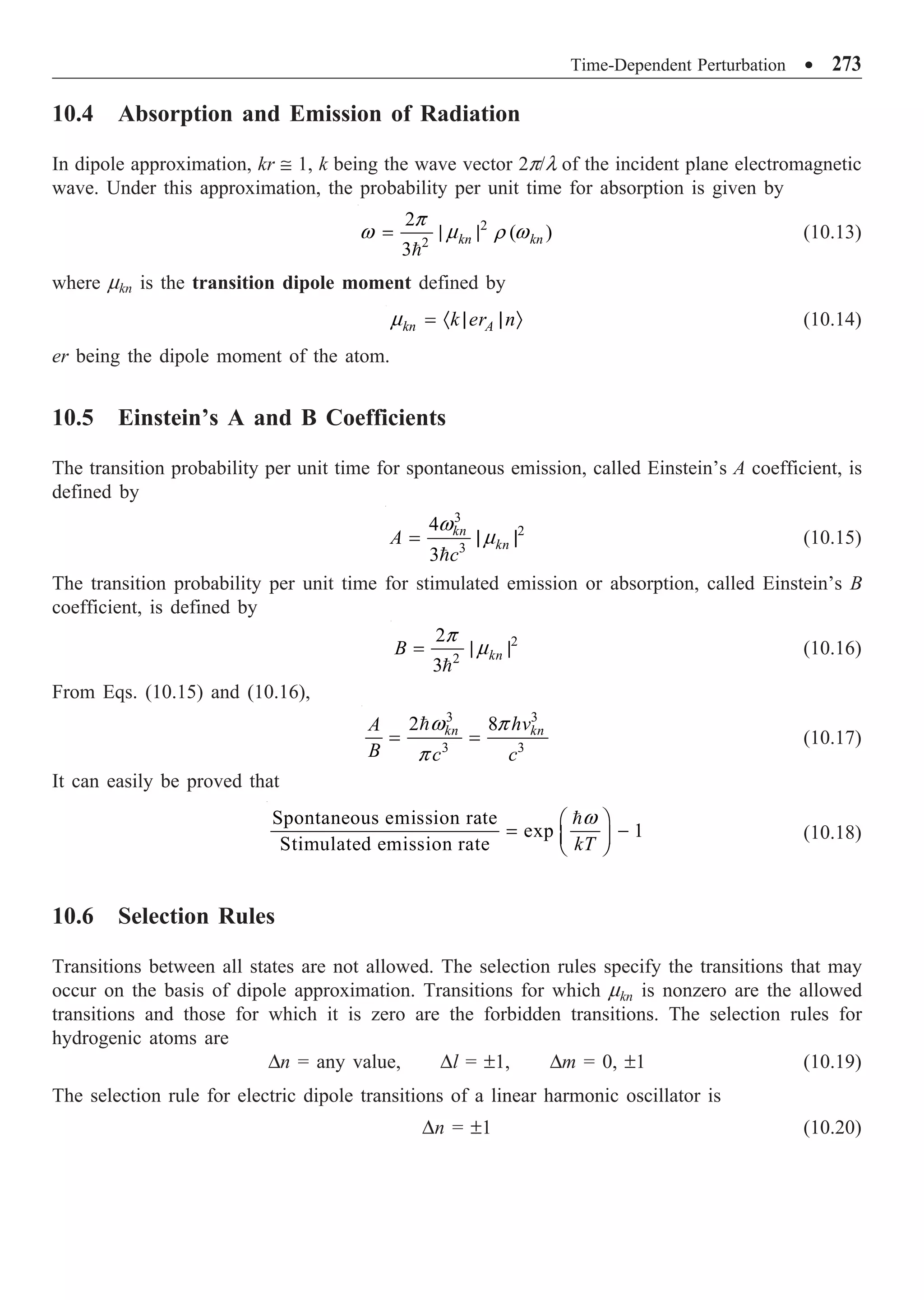
![274 ∑ Quantum Mechanics: 500 Problems with Solutions
PROBLEMS
10.1 A system in an unperturbed state n is suddenly subjected to a constant perturbation
H¢(r) which exists during time 0 Æ t. Find the probability for transition from state n to state k
and show that it varies simple harmonically with angular frequency (Ek – En)/2 and amplitude
4 | H¢
kn|2
/(Ek – En)2
.
Solution. Equation (10. 6) gives the value of ck
(1)
(t). When the perturbation is constant in time,
H¢
kn(r) can be taken outside the integral. Hence,
ck
(1)
(t) =
0
( )
exp ( ) [exp ( ) 1]
t
kn kn
kn kn
kn
H r H
i t dt i t
i
¢ ¢
¢ ¢ = - -
Ú
w w
w
= exp ( /2) [exp ( /2) exp ( /2)]
kn
kn kn kn
kn
H
i t i t i t
¢
- -
w w w
w
=
2
exp ( /2) sin ( /2)
kn
kn kn
kn
iH
i t i t
¢
-
w w
w
|ck
(1)
(t)|2
=
2
2
2 2
4
sin ( /2)
kn
kn
kn
H
t
¢
| |
w
w
which is the probability for transition from state n to state k. From the above expression it is obvious
that the probability varies simple harmonically with angular frequency wkn/2 = (Ek – En)/2. The
amplitude of vibration is
2 2
2 2 2
4 4
( )
kn kn
kn k n
H H
E E
¢ ¢
| | | |
=
-
w
10.2 Calculate the Einstein B coefficient for the n = 2, l = 1, m = 0, Æ n = 1, l = 0, m = 0 transition
in the hydrogen atom.
Solution. Einstein’s B coefficient is given by
BmÆn =
2
2 2
2 2
2 2
| | | | |
3 3
m
e
m n
= · Ò|
p p
m r
To get the value of ·210 | r | 100Ò, we require the values of ·210 | x |100Ò, ·210 | y | 100Ò, ·210 | z | 100Ò.
In the spherical polar coordinates, x = r sin q cos f, y = r sin q sin f, z = r cos q.
y210 =
1/2
3
0 0
0
1
exp cos
2
32
r r
a a
a
Ê ˆ Ê ˆ
-
Á ˜ Á ˜
Ë ¯
Ë ¯
q
p
y100 =
1/2
3
0
0
1
exp
r
a
a
Ê ˆ Ê ˆ
-
Á ˜ Á ˜
Ë ¯
Ë ¯
p
·210 | x | 100Ò = constant ¥ r-part ¥ q-part ¥
2
0
cos d
Ú
p
f f = 0
·210 | y | 100Ò = constant ¥ r-part ¥ q-part ¥
2
0
sin d
Ú
p
f f = 0](https://image.slidesharecdn.com/quantummechanics500problemswithsolutionspdfdrive-220626164912-635041ea/75/Quantum-Mechanics_-500-Problems-with-Solutions-PDFDrive-pdf-284-2048.jpg)
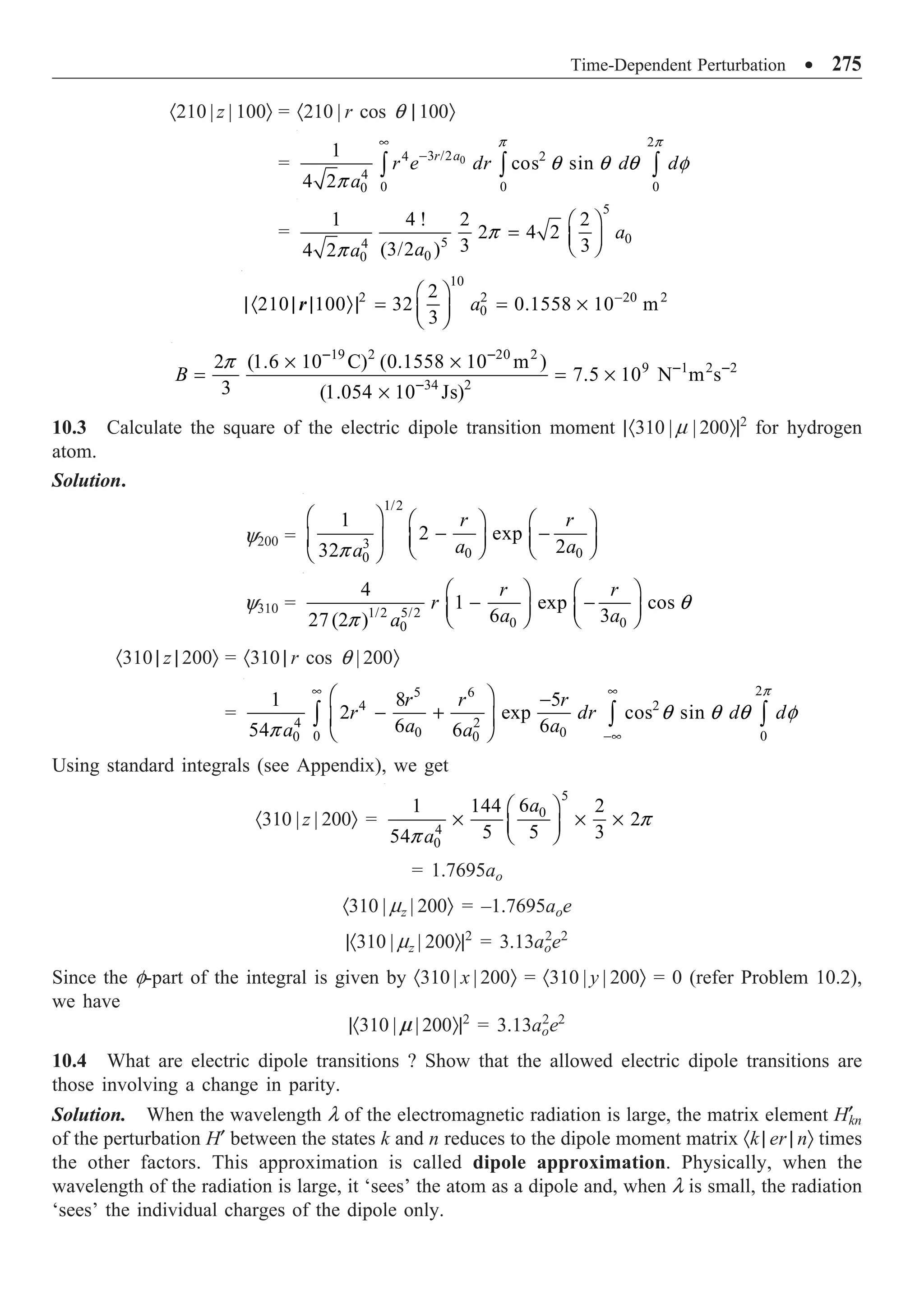
![276 ∑ Quantum Mechanics: 500 Problems with Solutions
The parity of an atomic orbital with quantum number l is (–1)l
. Hence, s (l = 0) and d (l = 2)
orbitals have even parity, whereas p (l = 1) and f(l = 3) orbitals have odd parity. A transition is
allowed if the dipole matrix element mkn = ·yk | er | ynÒ is nonvanishing. For that to happen, the
integrand of the dipole moment matrix must have even parity. The parity of the integrand is governed
by
1
( 1) ( 1)(1) ( 1)
k n k n
l l l l
+ +
- - = -
If lk + ln + 1 is odd, the integrand of mkn will be odd and mkn vanishes. Hence, for mkn to be
nonvanishing, lk + ln + 1 = even or lk + ln = odd. That is, for mkn to be finite, the two orbitals must
have opposite parity. This is often referred to as Laporte selection rule.
10.5 For hydrogenic atoms, the states are specified by the quantum numbers n, l, m. For a transition
to be allowed, show that
Dn = any value, Dl = ±1, Dl = 0, ±1
Solution. The form of the radial wave functions are such that the radial part of the integral
·n¢l¢m¢ | er | nlmÒ is nonvanishing, whatever be the values of n¢, l¢, n and l. Hence,
Dn = any value is allowed.
By the Laporte selection rule (see Problem 10.4) , for a transition to be allowed, it is neccessary that
lk + ln = odd
Therefore,
lk – ln = Dl = ±1
To obtain the selection rule for the quantum number m, the matrix element may be written as
ˆ
ˆ ˆ
n l m nlm i n l m x nlm j n l m y nlm k n l m z nlm
¢ ¢ ¢ ¢ ¢ ¢ ¢ ¢ ¢ ¢ ¢ ¢
· | | Ò = · | | Ò + · | | Ò + · | | Ò
r
If the radiation is plane polarized with the electric field in the z-direction, the z-component is the only
relevant quantity, which is ·n¢l¢m¢ | r cos q | nlmÒ. The f-part of this integral is
2
0
exp [ ( ) ]
i m m d
¢
-
Ú
p
f f
which is finite only when
m – m¢ = 0 or Dm = 0
If the radiation is polarized in the xy-plane, it is convenient to find the matrix elements of x ± iy since
it is always possible to get the values for x and y by the relations
1
[( ) ( )],
2
x x iy x iy
= + + -
1
[( ) ( )]
2
y x iy x iy
i
= + - -
In the polar coordinates,
x ± iy = r sin q cos f ± ir sin q sin f = r sin q e±if
The matrix elements of x ± iy are
2
0
sin ( , ) exp [ ( 1) ]
i
n l m r e nlm f r i m m d
±
¢ ¢ ¢ ¢
· | | Ò = - ±
Ú
p
f
q q f f](https://image.slidesharecdn.com/quantummechanics500problemswithsolutionspdfdrive-220626164912-635041ea/75/Quantum-Mechanics_-500-Problems-with-Solutions-PDFDrive-pdf-286-2048.jpg)
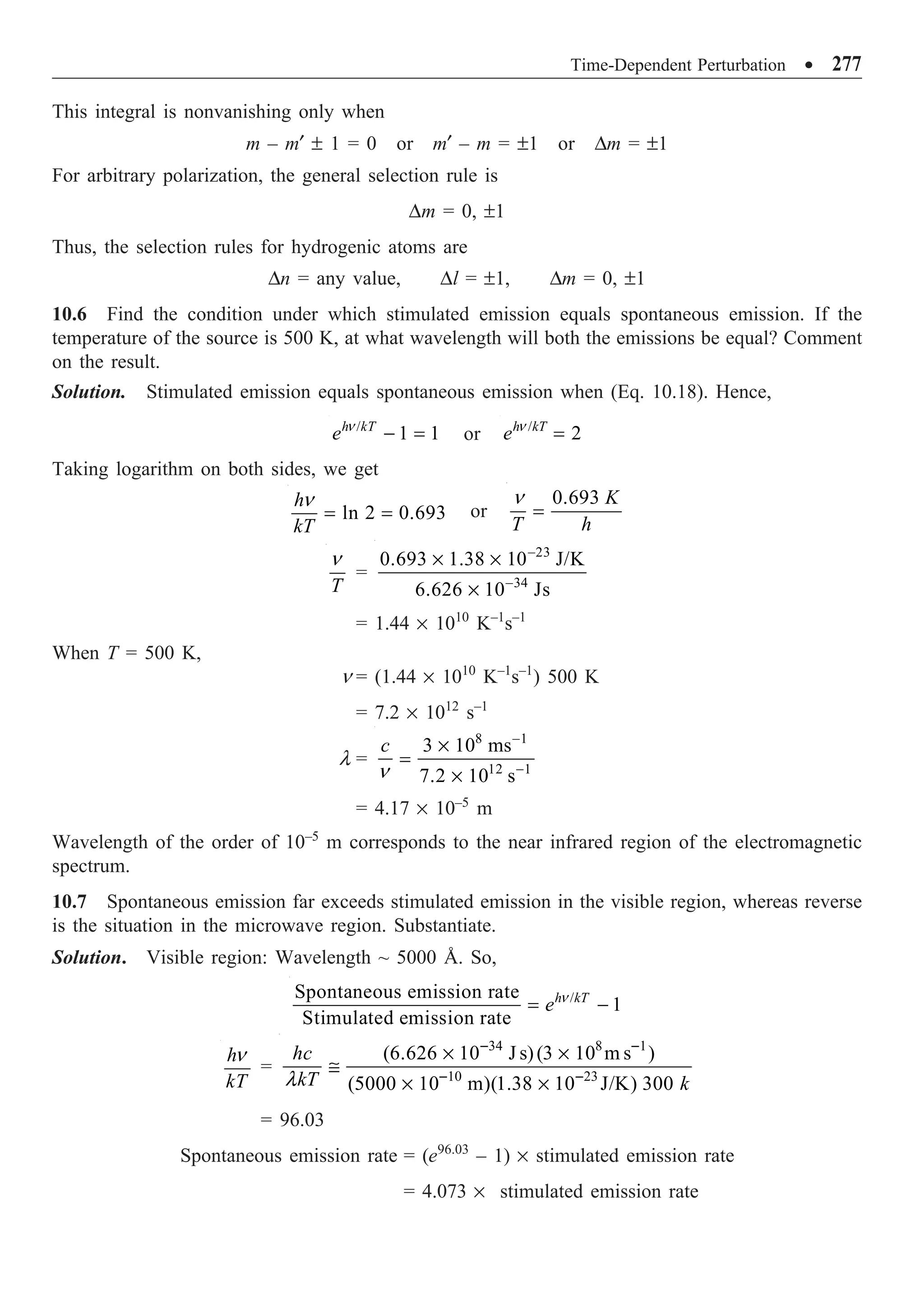
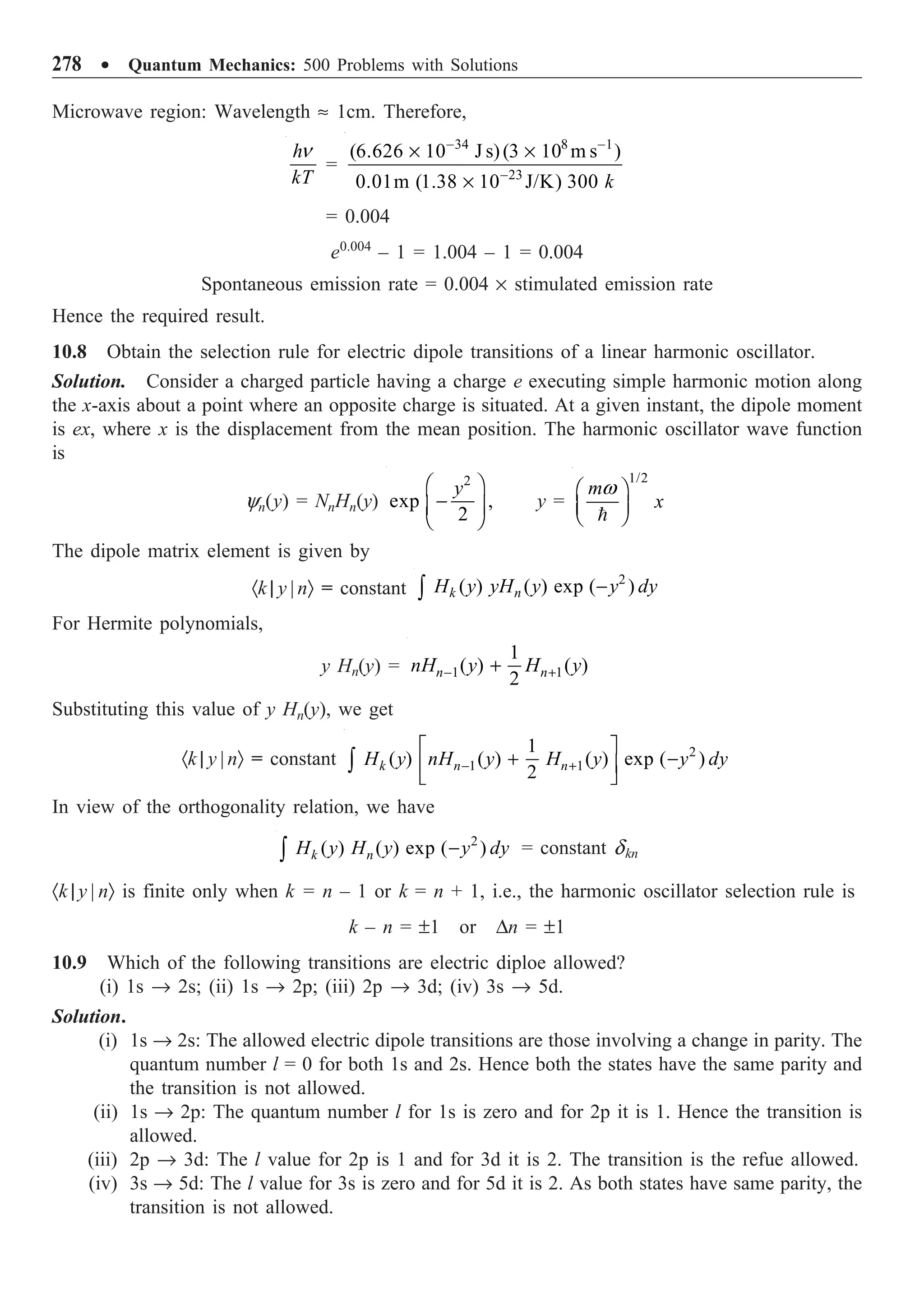
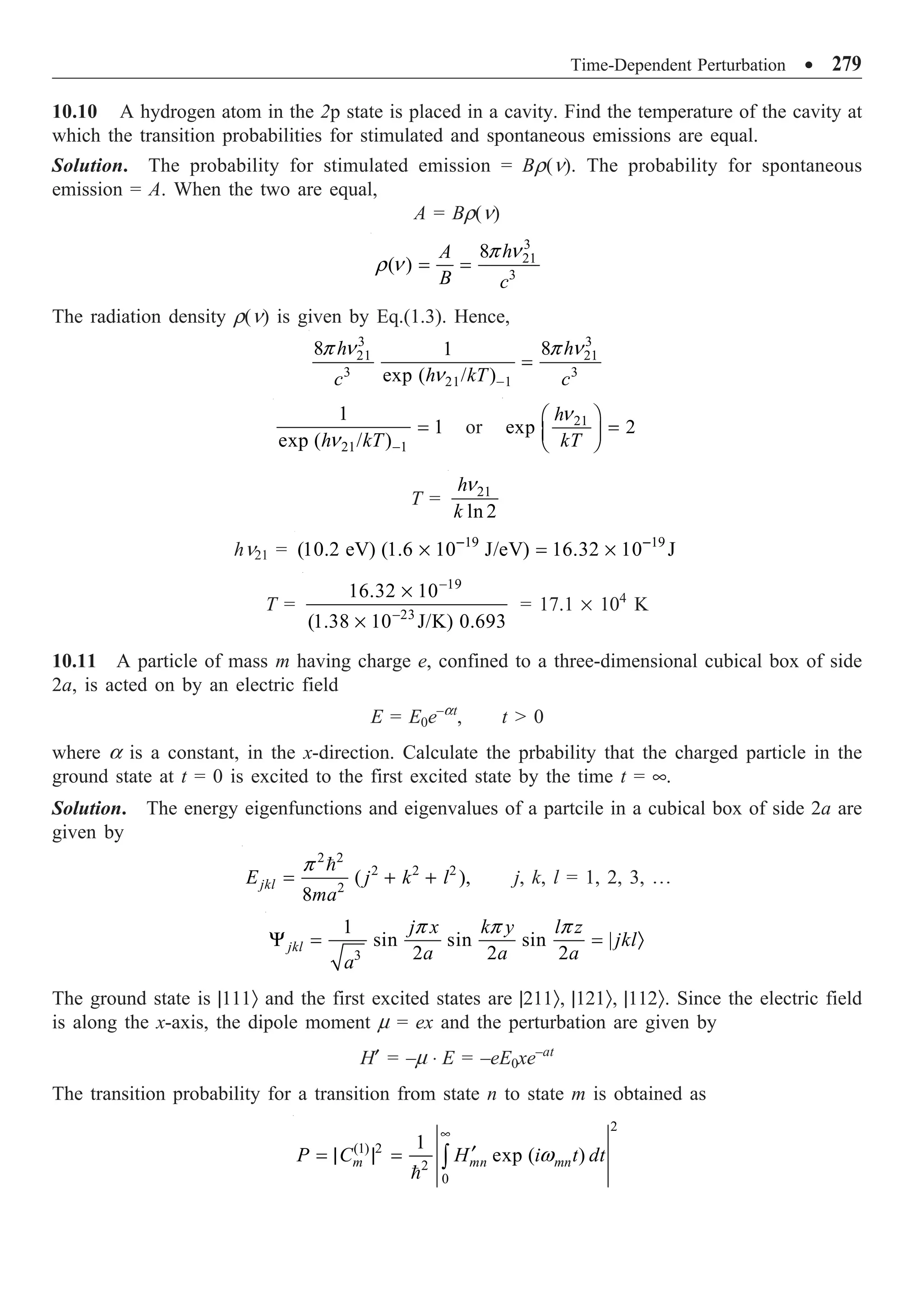
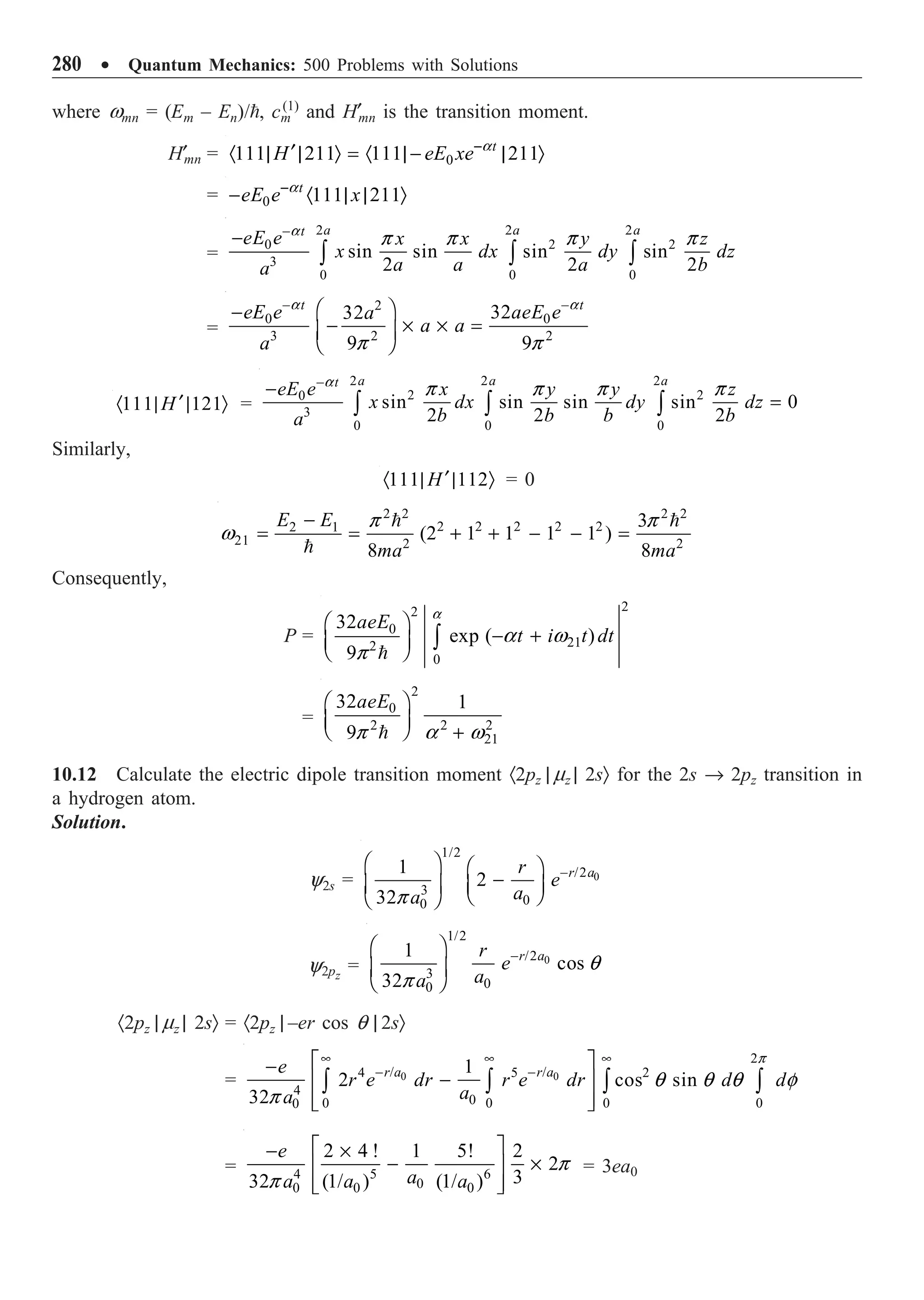
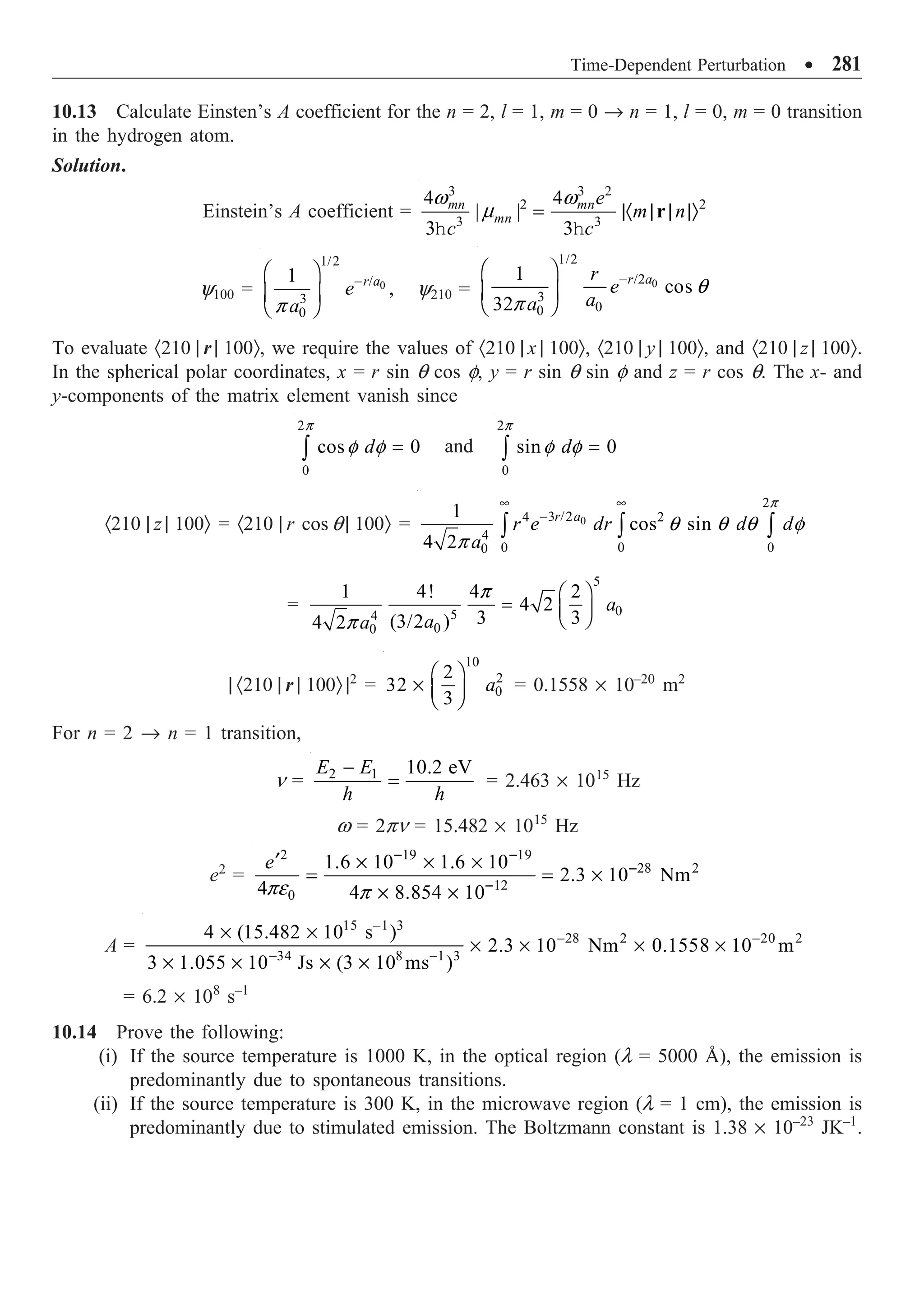
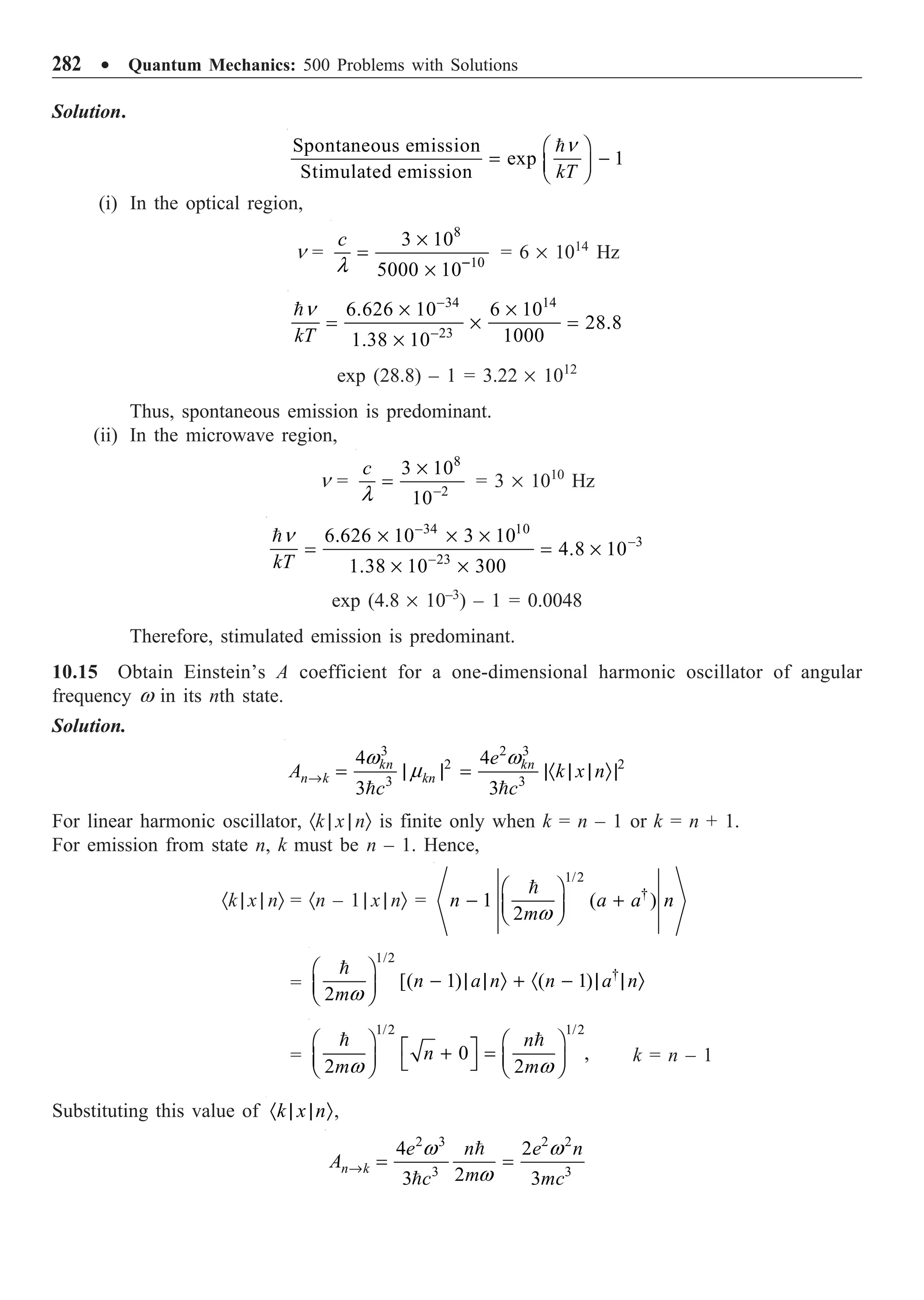

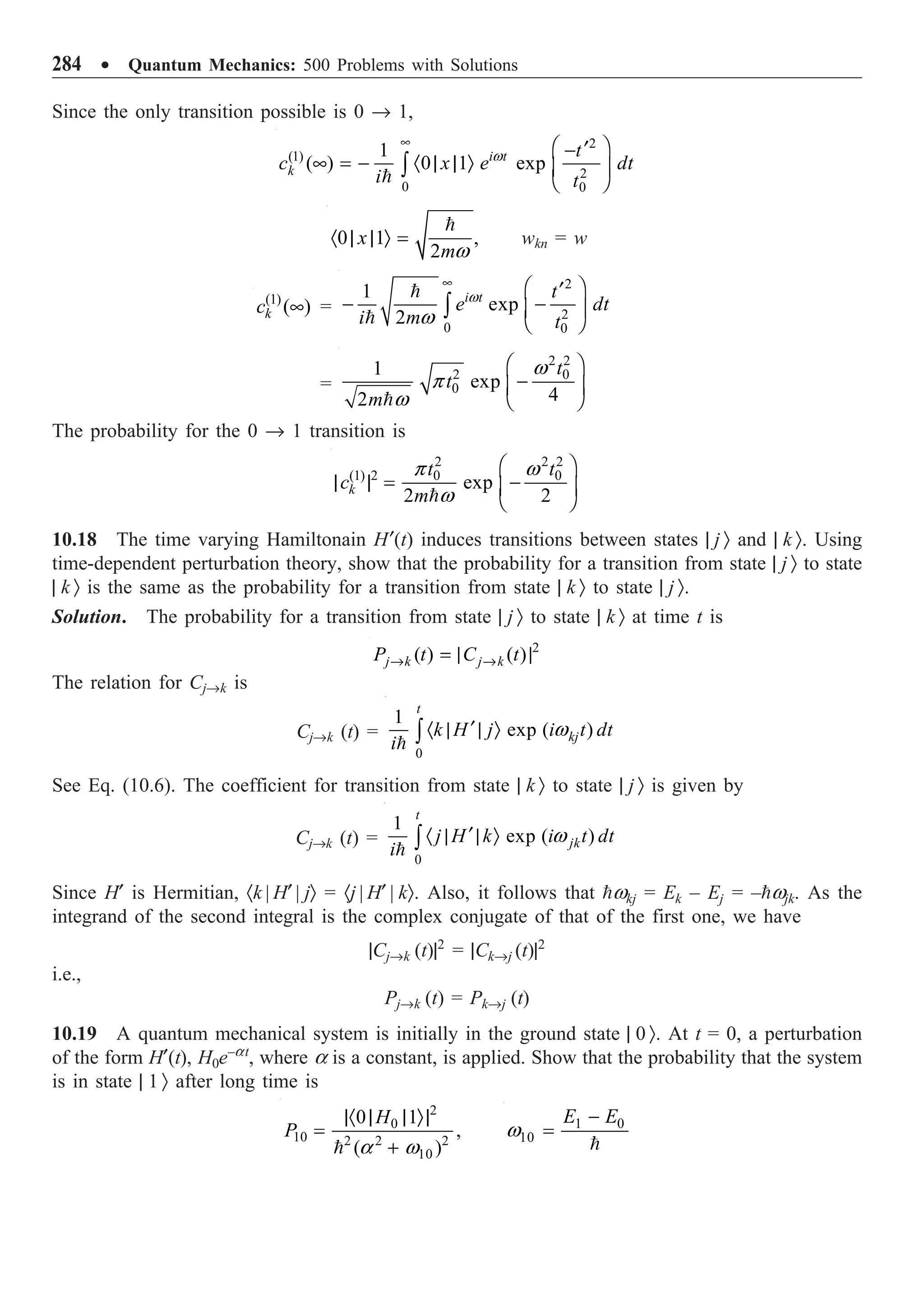
![Time-Dependent Perturbation ∑ 285
Solution. In the first-order perturbation, the transition probability amplitude is given by Eq. (10.6).
So,
(1)
0
1
( ) exp ( )
t
kn kn
k
C t H i t dt
i
¢ ¢ ¢
= Ú
w
where
kn
H k H n
¢ ¢
= · | | Ò , k n
kn
E E
-
=
w
Substituting the value of H¢ and allowing t Æ •, we get
(1)
( )
k
C t = 10 0
0
1
exp ( ) 1 0
t
i t e H dt
i
•
-
· | | Ò
Ú
a
w
=
0 10
10 0
1 0 exp [ ( ) ]
( )
H i t
i i
a w
a w
•
· | | Ò - -
È ˘
Í ˙
- -
Î ˚
=
0
10
1 0 1
H
i i
a w
· | | Ò
-
The probability for a transition from state | 0 Ò to state | 1 Ò after a long time is
2
(1) 2 0
10 2 2 2 2
10
0 1
| |
( )
k
H
P C
a
|· | | Ò|
=
+
w
10.20 A hydrogen atom in the ground state is subjected to an electric field
E = E0e–t/t
, t 0, t being constant
along the z-axis. Calculate the probability for transition to the (200) and (210) states when it is very
large.
Solution. The interaction Hamiltonian
H¢ = /
0
cos cos
t
E erE e
m -
- ◊ - = t
m q q
E =
y100 = 0
1/2
/
3
0
1 r a
e
a
-
Ê ˆ
Á ˜
Ë ¯
p
y200 = 0
3/2
/
1/2
0 0
1 1
1
2 2
r a
r
e
a a
-
Ê ˆ Ê ˆ
-
Á ˜ Á ˜
Ë ¯ Ë ¯
p
y210 = 0
5/2
/2
1/2
0
1 1
cos
2
r a
r e
a
-
Ê ˆ
Á ˜
Ë ¯
q
p
The probability for transition from n Æ k state is
2
2
0
1
( , ) exp ( )
t
n k kn kn
P H r t i t dt
Æ ¢
= Ú
w k n
kn
E E
-
=
w](https://image.slidesharecdn.com/quantummechanics500problemswithsolutionspdfdrive-220626164912-635041ea/75/Quantum-Mechanics_-500-Problems-with-Solutions-PDFDrive-pdf-295-2048.jpg)
![286 ∑ Quantum Mechanics: 500 Problems with Solutions
(100) to (200) transition:
/
21 200 0 100
( ) 200 100 ( cos )
t
H t H erE e d
-
¢ ¢
= · | | Ò = Ú
t
y q y t
The q-part of the integral is
0
cos sin 0
d =
Ú
p
q q q
Hence, H¢21 is zero. Therefore, the probability PnÆk = 0.
(100) to (210) transition:
0
2
/
3 /2
4 2
0
21 5/2 4
0 0 0
0
( ) 200 100 cos sin
2
t
r a
eE e
H t H r e dr d d
a
•
-
-
¢ ¢
= · | | Ò = Ú Ú Ú
p p
t
q q q f
p
Writing y = cos q, dy = – sin q dq,
we have
1
2 2
0 1
2
cos sin
3
d y dy
-
= - =
Ú Ú
p
q q q
H¢
21(t) =
/
0
5/2 4 5
0 0
4 ! 2
2
3
2 (3/2 )
t
eE e
a a
-
◊ ¥ ¥
t
p
p
=
/
/
0 0
256
243 2
t
t
eE a e
Ae
-
-
=
¥
t
t
where
A = 0 0
256
243 2
eE a
¥
21 21
/ /
21 21 21
0 0 0
(cos sin )
t t t
i t i t
t t
H e dt A e e dt A e t i t dt
- -
¢ = = +
Ú Ú Ú
w w
t t
w w
As t is very large, we can assume the limits of integral as 0 to •. Then,
21 21
21 2 2 2 2
0 21 21
1/
(1/ ) + (1/ ) +
i t
H e dt A i
• Ê ˆ
¢ = +
Á ˜
Ë ¯
Ú
w w
t
t w t w
P1Æ2 =
2
21 21
2 2 2 2 2 2 2 2 2
21 21 21 21
1/ 1/
(1/ ) + (1/ ) + (1/ ) + (1/ ) +
A
i i
Ê ˆ Ê ˆ
+ -
Á ˜ Á ˜
Ë ¯ Ë ¯
w w
t t
t w t w t w t w
=
2
2 2
21
2 2 2 2 2 2 2
21 21
(1/ )
[(1/ ) + ] [(1/ ) + ]
A
i
Ê ˆ
+
Á ˜
Ë ¯
w
t
t w t w
=
2
2 2 2
21
1
(1/ ) +
A Ê ˆ
Á ˜
Ë ¯
t w](https://image.slidesharecdn.com/quantummechanics500problemswithsolutionspdfdrive-220626164912-635041ea/75/Quantum-Mechanics_-500-Problems-with-Solutions-PDFDrive-pdf-296-2048.jpg)
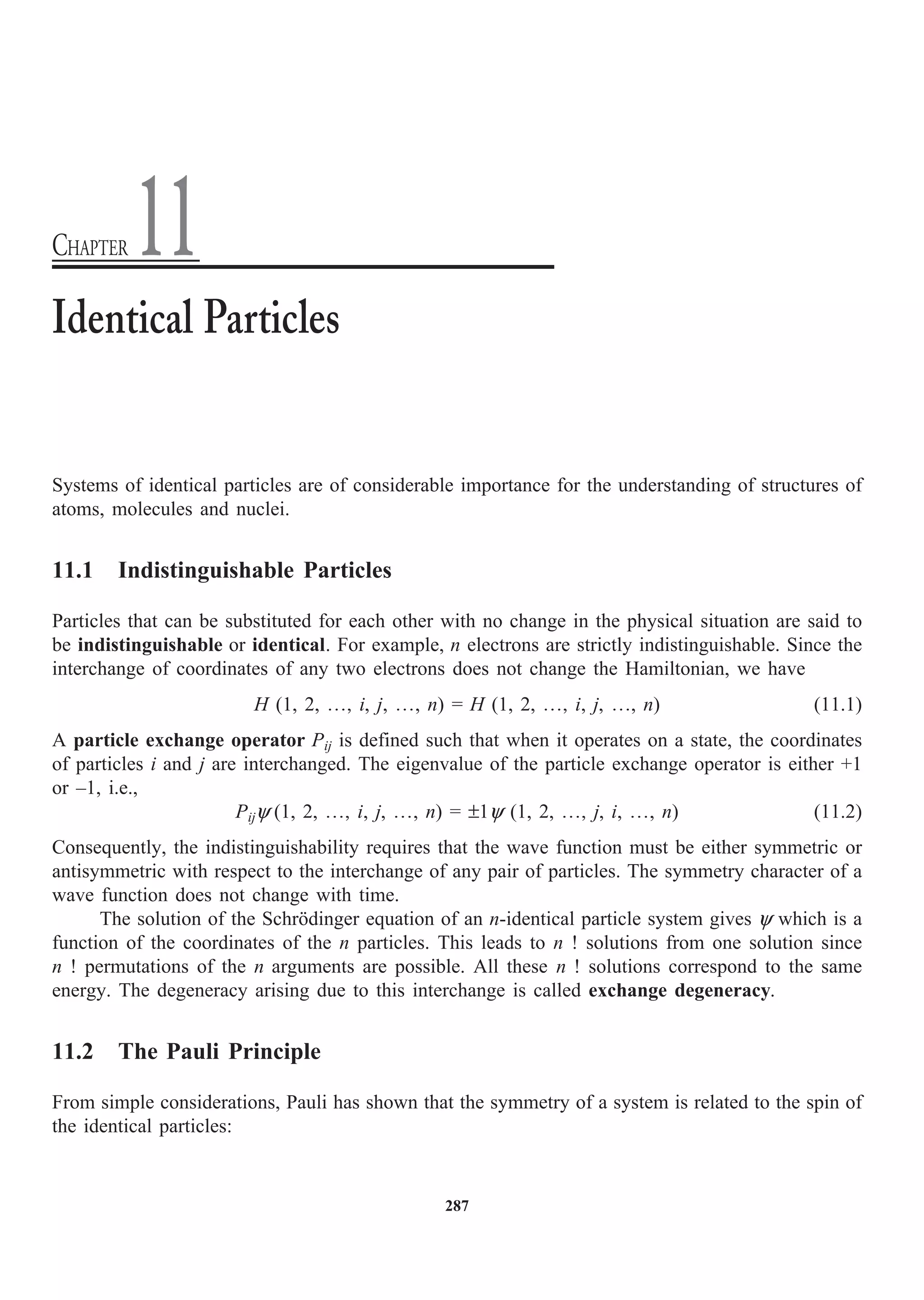
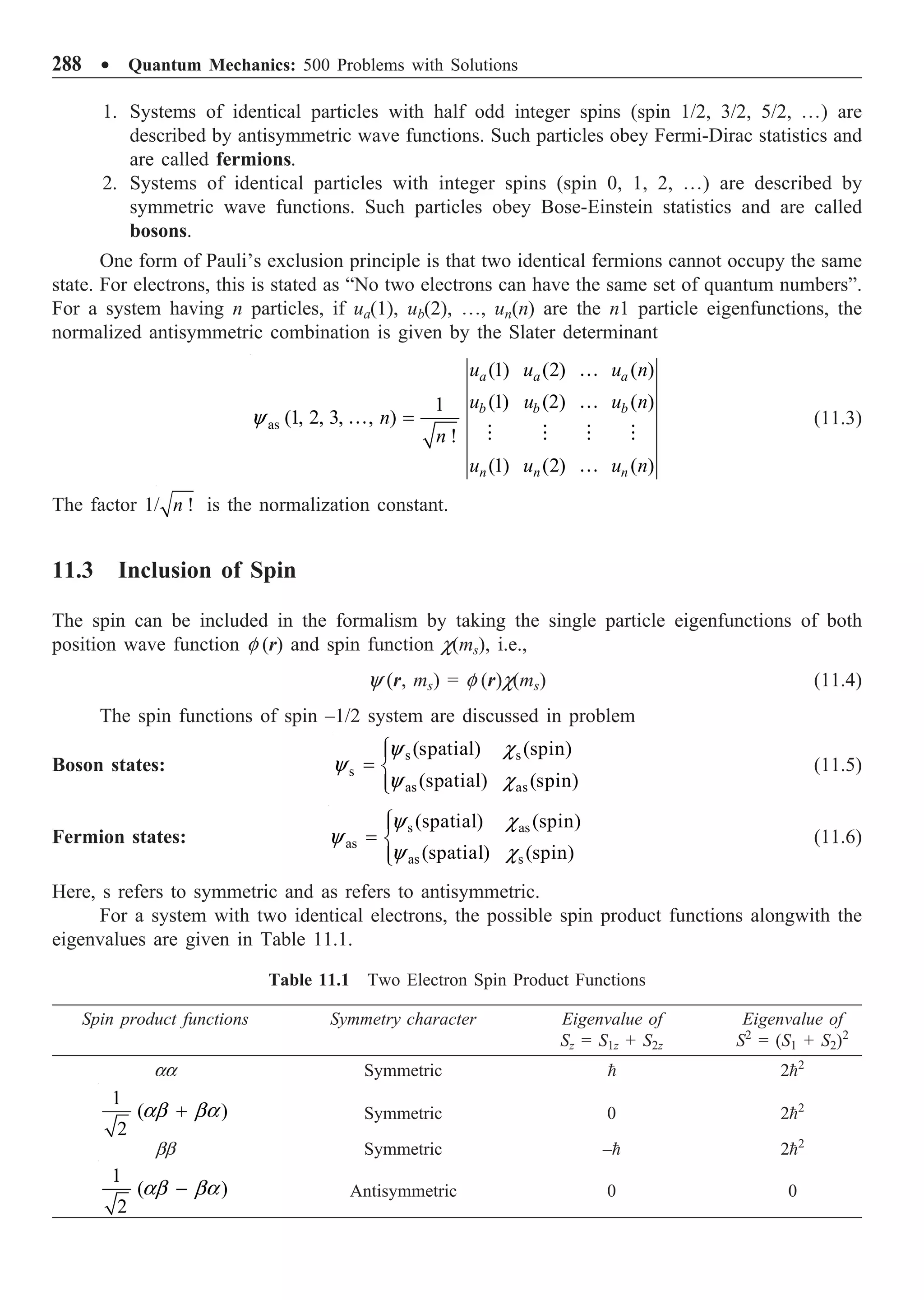
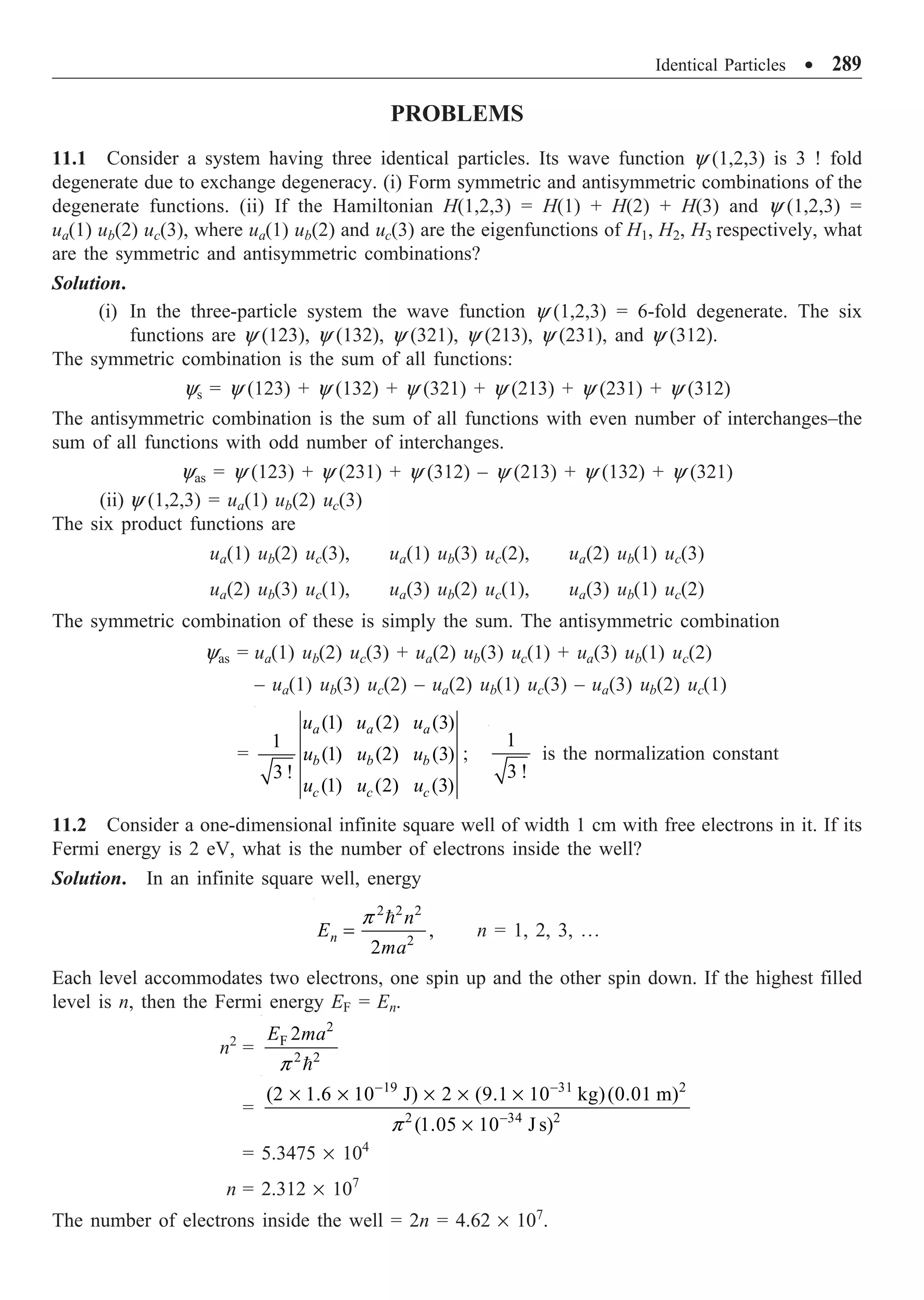
![290 ∑ Quantum Mechanics: 500 Problems with Solutions
11.3 N noninteracting bosons are in an infinite potential well defined by V(x) = 0 for 0 x a;
V (x) = • for x 0 and for x a. Find the ground state energy of the system. What would be the
ground state energy if the particles are fermions.
Solution. The energy eigenvalue of a particle in the infinite square well (Problem 4.1) is given by
En =
2 2 2
2
,
2
n
ma
p
n = 1, 2, 3, º
As the particles are bosons, all the N particles will be in the n = 1 state. Hence the total energy
E =
2 2
2
2
N
ma
p
If the particles are fermions, a state can have only two of them, one spin up and the other spin down.
Therefore, the lowest N/2 states will be filled. The total ground state energy will be
E =
2 2
2
2
2ma
p
[12
+ 22
+ 33
+ º + (N/2)2
]
=
2 2
2
1
1 2 1
6 2 2 2
N N N
ma
È ˘
Ê ˆ Ê ˆ
+ +
Í ˙
Á ˜ Á ˜
Ë ¯ Ë ¯
Î ˚
p
=
2 2
2
24ma
p
N (N + 1) (N + 2)
11.4 Consider two noninteracting electrons described by the Hamiltonian
H =
2 2
1 2
2 2
p p
m m
+ + V(x1) + V(x2)
where V(x) = 0 for 0 x a; V(x) = • for x 0 and for x a. If both the electrons are in the same
spin state, what is the lowest energy and eigenfunction of the two-electron system?
Solution. As the electrons are noninteracting, the wave function of the system y (1, 2) can be
written as
y (1, 2) = y (1) y (2)
With this wave function, the Schrödinger equation for the system breaks into two one-particle
equations:
2 2
2
1
(1)
2
d
m dx
-
y + V(x1) y (1) = E(1)
y (1)
2 2
2
2
(2)
2
d
m dx
-
y + V(x2) y (1) = E(2)
y (1)
where E(1)
+ E(2)
= E, which is the total energy of the system. The energy eigenvalues and
eigenfunctions for a single particle in such a potential (see Problem 4.1) are](https://image.slidesharecdn.com/quantummechanics500problemswithsolutionspdfdrive-220626164912-635041ea/75/Quantum-Mechanics_-500-Problems-with-Solutions-PDFDrive-pdf-300-2048.jpg)
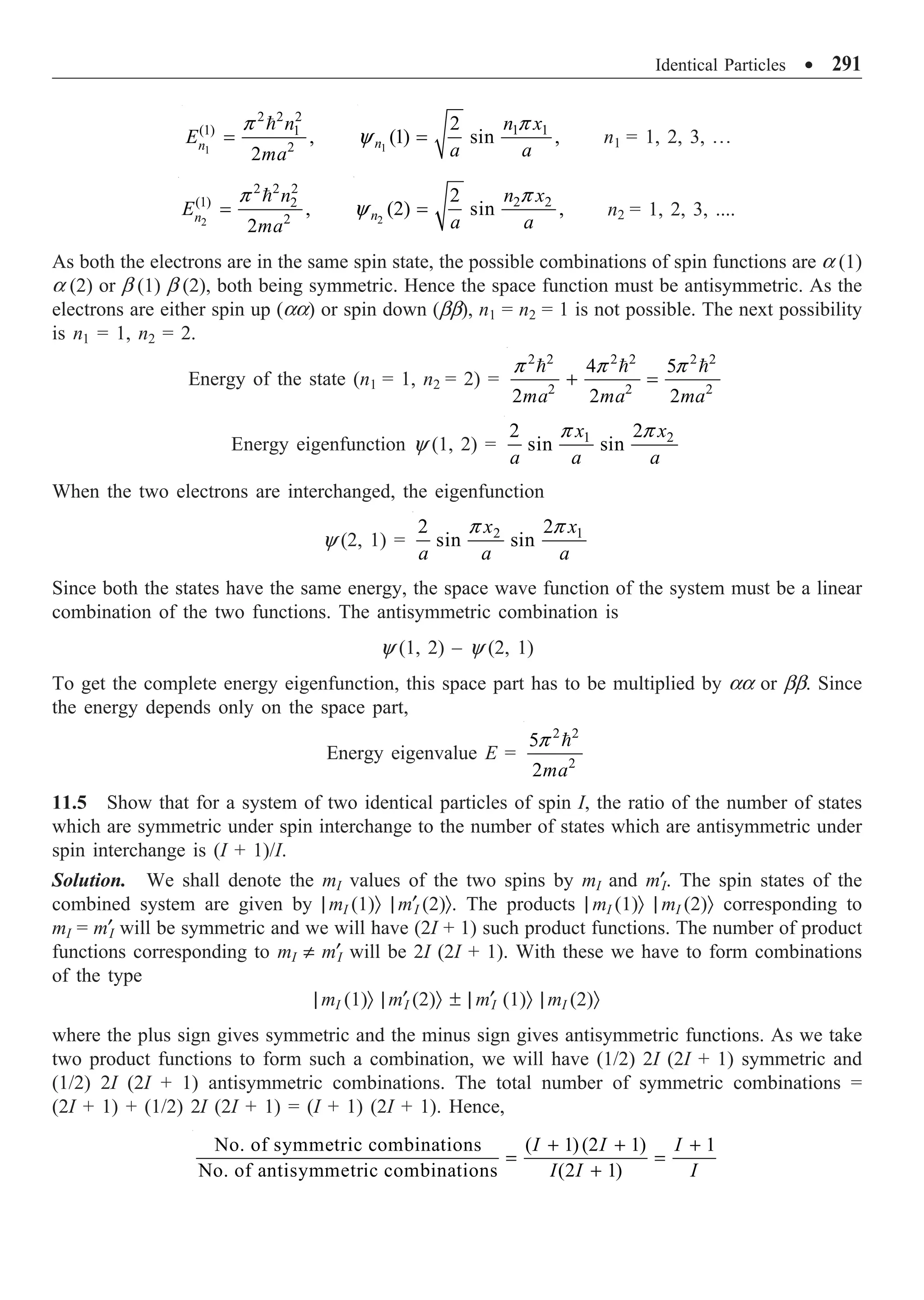
![292 ∑ Quantum Mechanics: 500 Problems with Solutions
11.6 Show that if a wave function y (1, 2, 3, º, n) is an energy eigenfunction of a symmetric
Hamiltonian that corresponds to a nondegenerate eigenvalue, it is either symmetric or antisymmetric.
Solution. The eigenvalue equation of the Hamiltonian is
H(1, 2, º, i, j, º, n) y (1, 2, º, i, j, º, n) = Ey (1, 2, º, i, j, º, n)
Interchange of the indistinguishable particles i and j does not change the energy. Hence,
H(1, 2, º, j, i, º, n) y (1, 2, º, j, i, º, n) = Ey (1, 2, º, j, i, º, n)
Since H is symmetric,
H(1, 2, º, i, j, º, n) y (1, 2, º, j, i, º, n) = Ey (1, 2, º, j, i, º, n)
H(1, 2, º, i, j, º, n) Pijy (1, 2, º, i, j, º, n) = EPijy (1, 2, º, i, j, º, n)
= PijH (1, 2, º, i, j, º, n) y (1, 2, º, i, j, º, n)
(HPij – PijH) y = 0 or [H, Pij] = 0
Since Pij commutes with the Hamiltonian, y (1, 2, º, i, j, º, n) is an eigenfunction of Pij also.
Pijy (1, 2, º, i, j, º, n) = py (1, 2, º, i, j, º, n)
y (1, 2, º, j, i, º, n) = py (1, 2, º, i, j, º, n)
Operating both sides by Pij, we get
y (1, 2, º, i, j, º, n) = p2
y (1, 2, º, i, j, º, n)
Hence, p2
= 1 or p = ±1, i.e.,
Pijy (1, 2, º, i, j, º, n) = ±y (1, 2, º, i, j, º, n)
which means that the wavefunction must be either symmetric or antisymmetric with respect to
interchange of two identical particles.
11.7 Sixteen noninteracting electrons are confined in a potential V(x) = • for x 0 and x 0;
V(x) = 0, for 0 x a.
(i) What is the energy of the least energetic electron in the ground state?
(ii) What is the energy of the most energetic electron in the ground state?
(iii) What is the Fermi energy Ef of the system?
Solution.
(i) The least energetic electron in the ground state is given by
2 2
1 2
.
2
E
ma
=
p
(ii) In the given potential, the energy eigenvalue
2 2 2
2
,
2
n
n
E
ma
=
p
n = 1, 2, 3, º
As two electrons can go into each of the states n = 1, 2, 3, º, the highest filled level will
have n = 8 and its energy will be
2 2 2 2 2
8 2 2
8 32
2
E
ma ma
= =
p p](https://image.slidesharecdn.com/quantummechanics500problemswithsolutionspdfdrive-220626164912-635041ea/75/Quantum-Mechanics_-500-Problems-with-Solutions-PDFDrive-pdf-302-2048.jpg)

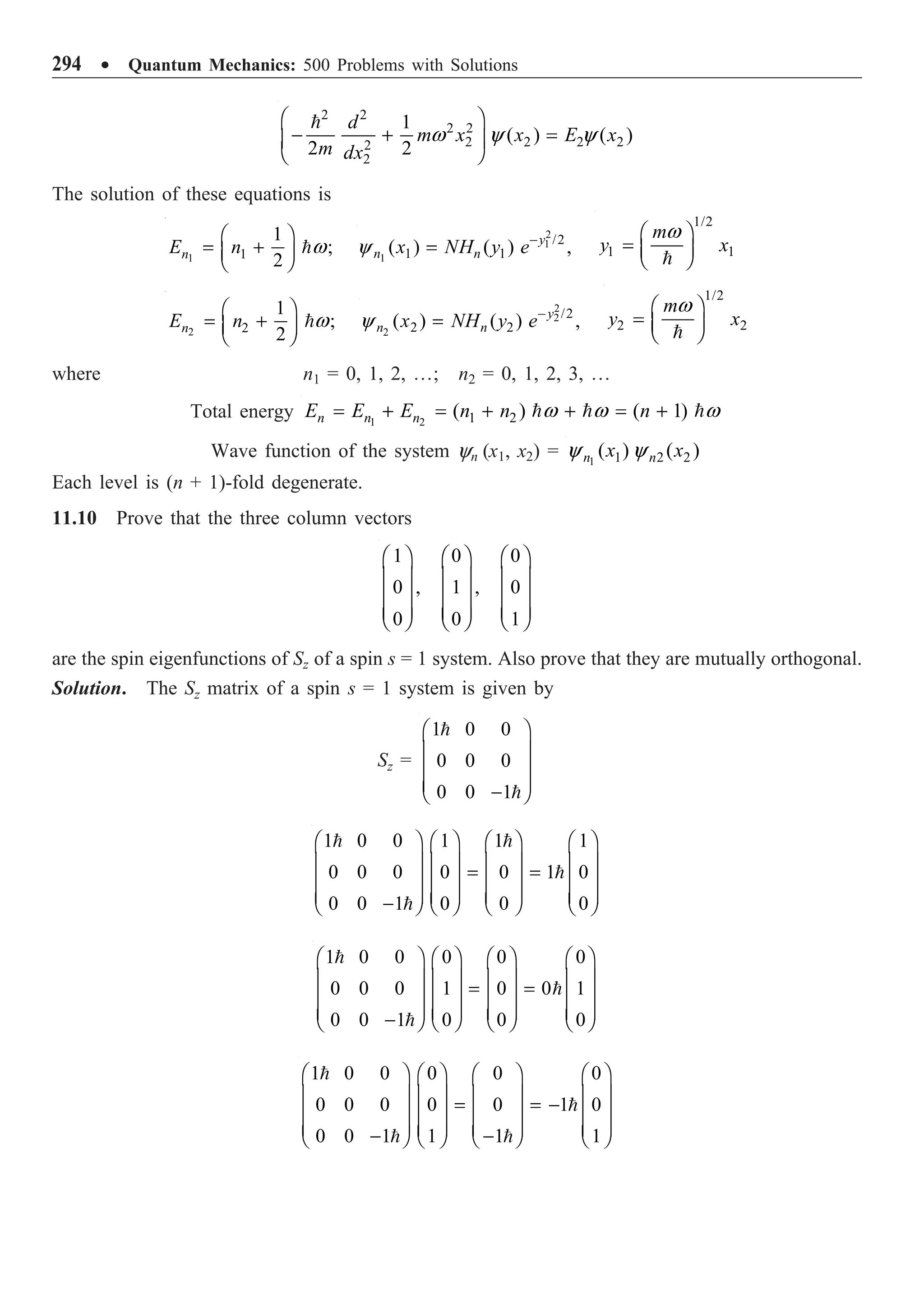
![Identical Particles ∑ 295
As expected, the eigenvalues of Sz are 1, 0 and –1. Thus,
0
(1 0 0) 1 0,
0
Ê ˆ
Á ˜ =
Á ˜
Á ˜
Ë ¯
0
(0 1 0) 0 0,
1
Ê ˆ
Á ˜ =
Á ˜
Á ˜
Ë ¯
1
(0 0 1) 0 0
0
Ê ˆ
Á ˜ =
Á ˜
Á ˜
Ë ¯
Hence the result.
11.11 Give the zeroth order wave functions for helium atom (i) in the ground state (1s2
), and
(ii) in the excited state 1s 2s. Also, express them in the form of Slater determinants.
Solution.
(i) The ground state of helium is 1s2
. As both the electrons are in the y100 state, the space part
of the wave function is y100(r1)y100(r2). The spin part that multiplies this must be antisymmetric so
that the total wave function is antisymmetric. Hence, the zeroth order wave function for helium atom
in the 1s2
state is
1s(1) 1s (2)
1
[ (1) (2) (1) (2)]
2
-
a b b a
In terms of the Slater determinant, this takes the form
1s(1) (1) 1s(2) (2)
1
1s(1) (1) 1s(2) (2)
2
a a
b b
(ii) For the 1s 2s state, taking exchange degeneracy into account, the possible product
functions are
1s(1)2s(2) and 1s(2) 2s(1)
The symmetric combination ys and the antisymmetric combination yas are given by
ys =
1
2
[1s(1) 2s(2) + 1s(2) 2s(1)]
yas =
1
2
[1s(1) 2s(2) – 1s(2) 2s(1)]
Combining these with the spin wave function for a two-electron system, with the condition that the
total wave function must be antisymmetric, we get
y1 =
1
2
[1s(1) 2s(2) + 1s(2) 2s(1)] [a (1) b (2) – b (1) a (2)]
1
2
y2 =
1
2
[1s(1) 2s(2) – 1s(2) 2s(1)] a (1) a (2)
y3 =
1
2
[1s(1) 2s(2) – 1s(2) 2s(1)] [a (1) b (2) + b (1) a (2)]
1
2
y4 =
1
2
[1s(1) 2s(2) – 1s(2) 2s(1)] b (1) b (2)](https://image.slidesharecdn.com/quantummechanics500problemswithsolutionspdfdrive-220626164912-635041ea/75/Quantum-Mechanics_-500-Problems-with-Solutions-PDFDrive-pdf-305-2048.jpg)
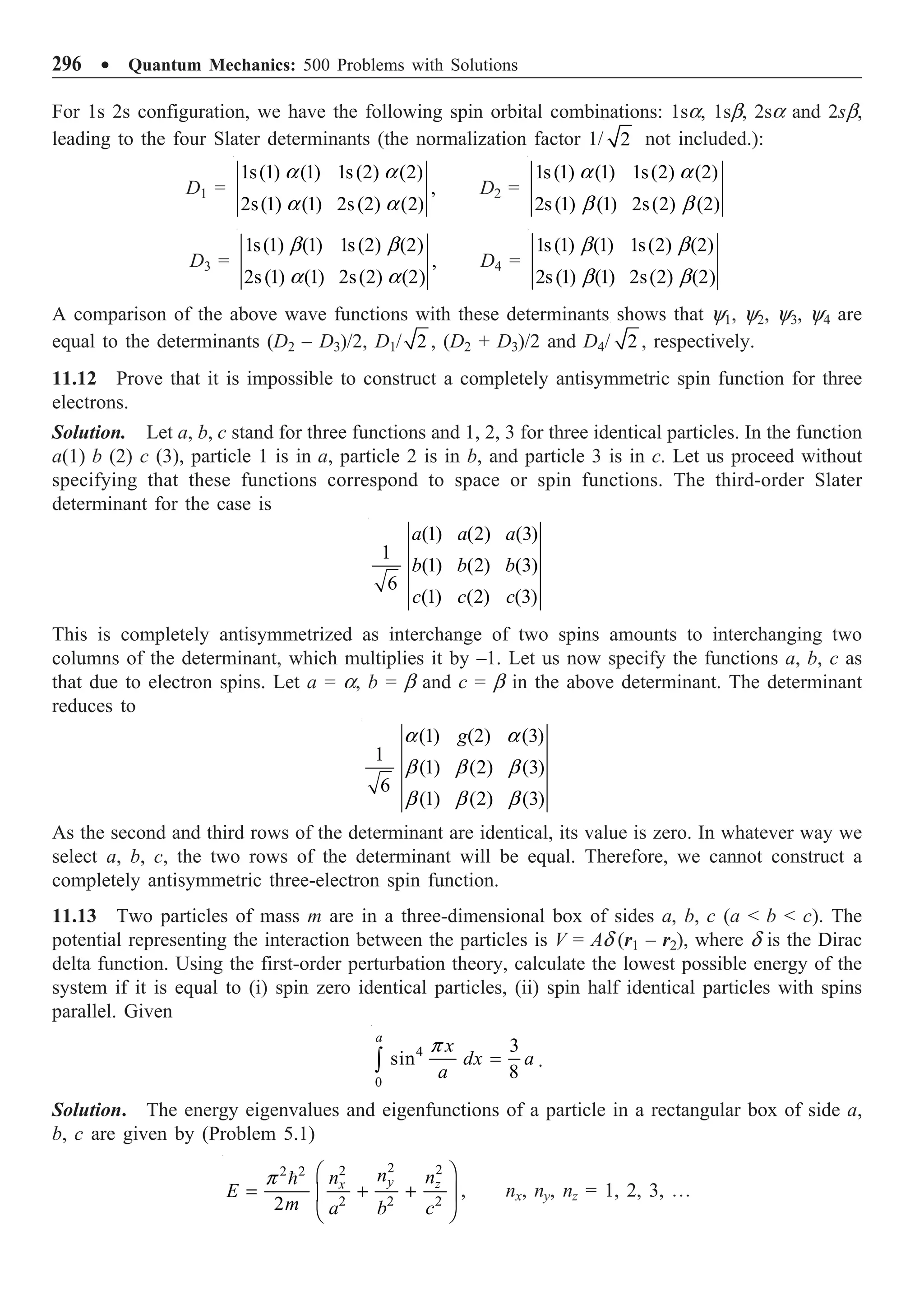
![Identical Particles ∑ 297
8
( , , ) sin sin sin
y z
x
n y n z
n x
x y z
abc a b c
=
p p
p
y
(i) For a system of spin zero particles, the total wave function must be symmetric for
interchange of any pair of particles. Hence, for the two-particle system, the unperturbed wave
function can be taken as the product of two single-particle wave function which is symmetric, i.e.,
ys (r1, r2) = y (r1) y (r2)
= 1 1 1 2 2 2
8
sin sin sin sin sin sin
x y z x y z
abc a b c a b c
p p p p p p
The unperturbed energy
2 2
0 2 2 2
1 1 1
E
m a b c
Ê ˆ
= + +
Á ˜
Ë ¯
p
The Hamiltonian representing the interaction between the two particles is
H¢ = Ad (r1 – r2)
where A is a constant, can be taken as the perturbation. The first order correction to the energy
(1)
s
E = 1 2 1 2 1 2 1 2
*( , ) ( ) ( , )
s s
A d d
-
Ú y d y t t
r r r r r r
=
2
1 1 1
( , )
s
A d
Ú y t
r r
=
4
2
1 1 1
1 1 1
0 0 0
8
sin sin sin
a b c
x y z
A dx dy dz
abc a b c
Ê ˆ
Ê ˆ
Á ˜ Á ˜
Ë ¯ Ë ¯
Ú Ú Ú
p p p
=
2
4 4 4
1 1 1
1 1 1
0 0 0
8
sin sin sin
a b c
x y z
A dx dy dz
abc a b c
Ê ˆ
Á ˜
Ë ¯ Ú Ú Ú
p p p
=
2
8 3 3 3 27
8 8 8 8
a b c A
A
abc abc
Ê ˆ
Á ˜
Ë ¯
Consequently, the energy corrected to first order is
2 2
2 2 2
1 1 1 27
8
s
A
E
m abc
a b c
Ê ˆ
= + + +
Á ˜
Ë ¯
p
(ii) For a system of spin half particles, the total wave function must be antisymmetric for
interchange of any pair of particles. As the spins are parallel, the spin wave function is symmetric
and, therefore, the space part must be antisymmetric. One of the particles will be in the ground state
y111, and the other will be in the first excited state y211 since 1/a2
1/b2
1/c2
. The antisymmetric
combination is then given by
1 2 111 1 211 2 111 2 211 1
1
( , ) [ ( ) ( ) ( ) ( )]
2
a = -
y y y y y
r r r r r r](https://image.slidesharecdn.com/quantummechanics500problemswithsolutionspdfdrive-220626164912-635041ea/75/Quantum-Mechanics_-500-Problems-with-Solutions-PDFDrive-pdf-307-2048.jpg)
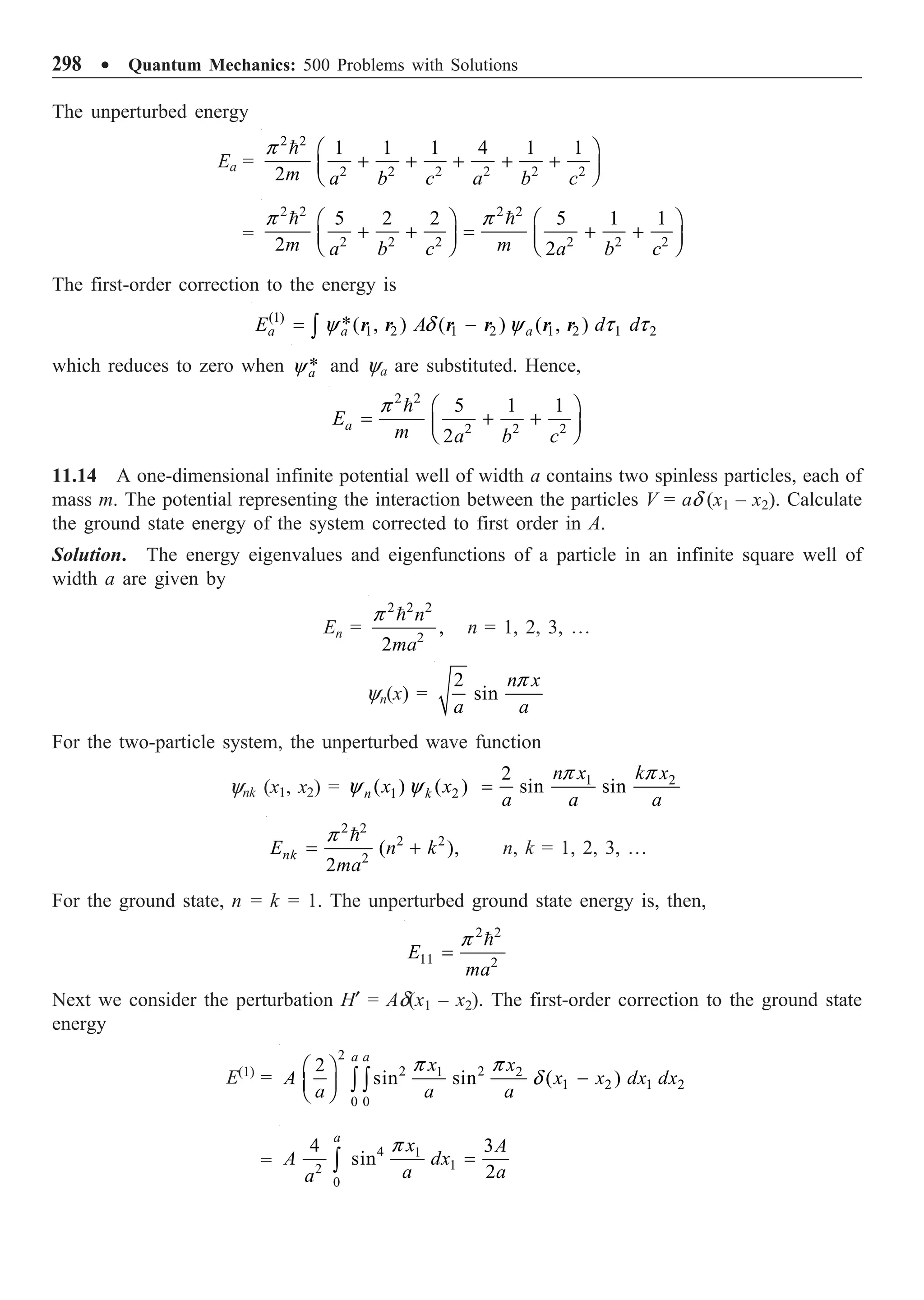
![Identical Particles ∑ 299
Hence, the first-order corrected ground state energy
2 2
11 2
3
2
A
E
a
ma
= +
p
11.15 Two identical bosons, each of mass m, move in the one-dimensional harmonic potential
V = (1/2) mw2
x2
. They also interact with each other via the potential
2
int 1 2
exp [ ( ) ]
V a x x
= - -
b
where a and b are positive parameters. Compute the ground state energy of the system to first order
in the parameter a.
Solution. Since the particles are bosons, both of them can remain in the ground state. The Vint term
can be treated as a perturbation. The ground state wavefunction of a harmonic oscillator is
1/4 2
exp
2
m m x
Ê ˆ
Ê ˆ
-
Á ˜ Á ˜
Ë ¯ Ë ¯
w w
p
Hence the unperturbed wavefunction of the ground state for this two-particle system is
y0 (x1, x2) =
1/4 1/4
2 2
1 2
exp exp
2 2
m x m x
m m
Ê ˆ Ê ˆ
Ê ˆ Ê ˆ
- -
Á ˜ Á ˜
Á ˜ Á ˜
Ë ¯ Ë ¯
Ë ¯ Ë ¯
w w
w w
p p
=
1/4
2 2
1 2
exp ( )
2
m m
x x
Ê ˆ È ˘
- +
Á ˜ Í ˙
Ë ¯ Î ˚
w w
p
The first-order correction to the energy
E(1)
=
2 2 2 2 2
1 2 1 2 1 2
exp ( ) ( )
m m
x x x x dx dx
•
-•
È ˘
- + - +
Í ˙
Î ˚
Ú Ú
wa w
b
p
=
1
( / ) 2
m
m +
wa
p w b
The ground state energy of the system is, therefore,
1
( / ) 2
m
E
m
= +
+
wa
w
p w b
11.16 Consider the rotation of the hydrogen molecule H2. How does the identity of the two nuclei
affect the rotational spectrum? Discuss the type of transition that occurs between the rotational levels.
Solution. The rotational energy levels of hydrogen molecule are given by
2
( 1)
,
2
l l
E
I
+
=
l = 0, 1, 2, º
The total wave function of the molecule y is the product of electronic (ye), vibrational (yv),
rotational (yr) and nuclear (yn) wave functions.
y = yeyvyryn](https://image.slidesharecdn.com/quantummechanics500problemswithsolutionspdfdrive-220626164912-635041ea/75/Quantum-Mechanics_-500-Problems-with-Solutions-PDFDrive-pdf-309-2048.jpg)
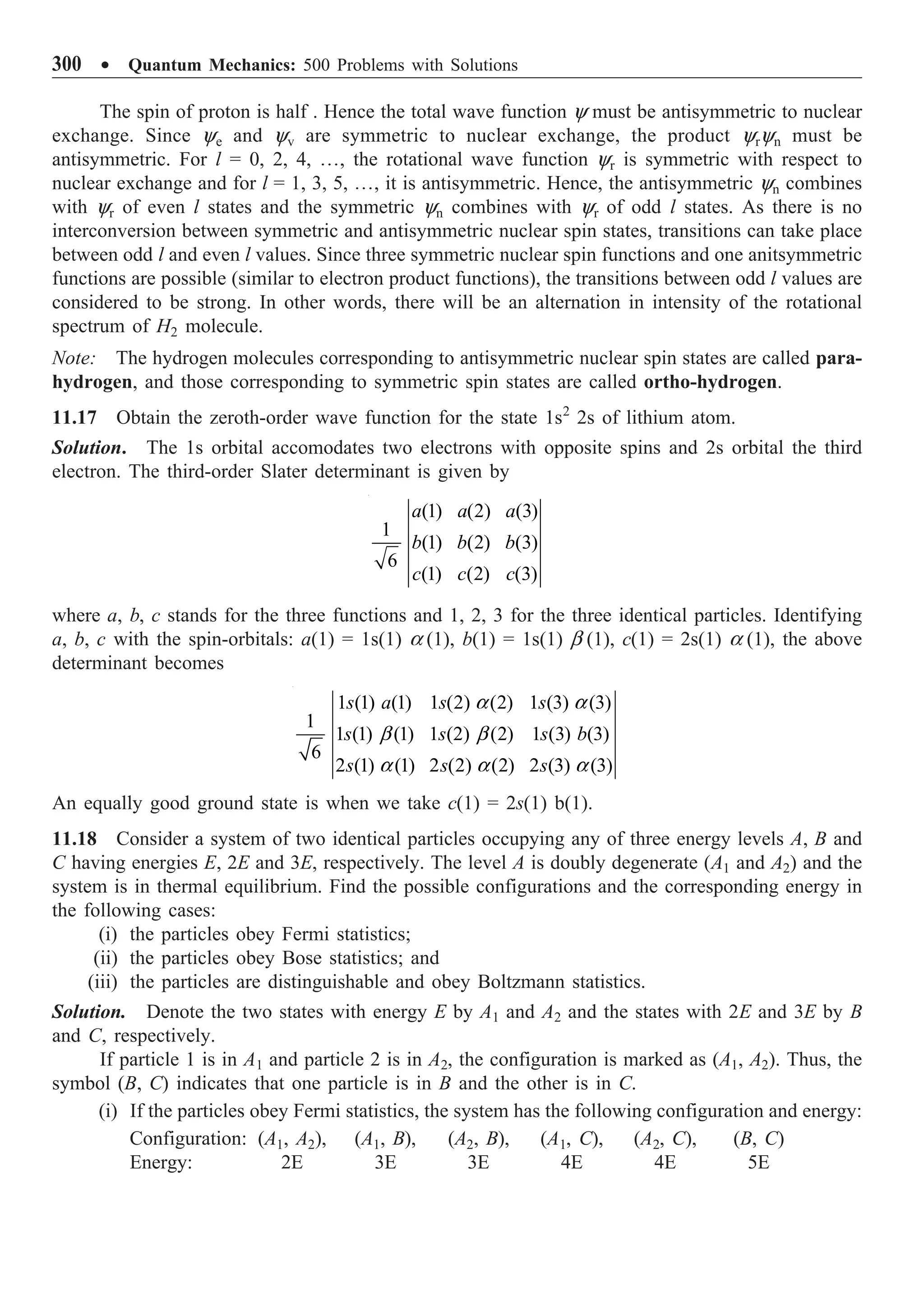
![Identical Particles ∑ 301
(ii) If the particles obey Bose statistics, the additional configurations: (A1, A1), (A2, A2), (B, B)
and (C, C) are also possible. Hence the configuration and energy are
(A1, A2), (A1, B), (A2, B), (A1, C), (A2, C), (B, C), (A1, A1), (A2, A2), (B, B), (C, C)
2E, 3E, 3E, 4E, 4E, 5E, 2E, 2E, 4E, 6E
(iii) Since the particles are distinguishable, the following configurations are also possible:
Configuration: (A2, A1), (B, A1), (B, A2), (C, A1), (C, A2), (C, B)
Energy: 2E, 3E, 3E, 4E, 4E, 5E
11.19 Consider the rotational spectrum of the homonuclear diatomic molecule14
N2. Show that the
ratio of intensities of adjacent rotational lines is approximately 2 : 1.
Solution. The rotational energy levels of N2 molecule are given by
2
( 1)
2
l
l l
E
I
+
=
, l = 0, 1, 2, º
The spin of 14
N is 1; hence it is a boson. The possible values of the total nuclear spin I of N2
molecule are 0, 1, 2, making it a boson. The total wave function must be symmetric to nuclear
exchange. The rotational functions corresponding to l = 0, 2, 4, º combine with the symmetric spin
functions (I = 0, 2), and the functions for l = 1, 3, 5, º combine with antisymmetric spin function
I = 1. The total degeneracy of symmetric spin functions = (2 ¥ 0 + 1) + (2 ¥ 2 + 1) = 6, and of
antisymmetric spin functions = (2 ¥ 1 + 1) = 3. Since transitions are allowed only between symmetric
or antisymmetric rotational states, Dl = 2. The first line will be l = 0 Æ l = 2 and the second one
l = 1 Æ l = 2. The nuclear spin I usually remains unchanged in optical transitions.
The energy difference between adjacent rotational levels is very small, the effect due to this
in intensity can be neglected. Hence, the intensity of the lines will be in the ratio 6:3 or 2:1.
11.20 Ignoring the interaction between the electrons and considering exchange degeneracy and
spin effects, write the wave functions for the ground and the excited states (1s)1
(2p)1
of helium
atom.
Solution. The Hamiltonian
2 2 2 2
2 2
1 2
0 1 0 2
2 4 2 4
Ze Ze
H
m r m r
Ê ˆ Ê ˆ
= - — - + - — -
Á ˜ Á ˜
Ë ¯ Ë ¯
pe pe
where —1 and —2 refer to the coordinates of electron 1 and 2, respectively. Distances r1 and r2 are
those of electron 1 and electron 2. The electrostatic repulsion between the two electrons is neglected.
Ground state. The ground state of helium is 1s2
. As both the electrons are in the |100Ò state, the
space part of the wave function is
yspace = |100Ò1 |100Ò2
The subscripts 1, 2 refer to the two electrons. Exchange degeneracy does not exist as both the
electrons are in the same state. Since the system is of fermions, the total wave function must be
antisymmetric. The space part of the wave function is symmetric. Hence the spin part must be
antisymmetric. Multiplying yspace by the antisymmetric spin combination, the wave function of the
ground state is obtained as
1 2
1
100 100 [ (1) (2) (1) (2)]
2
= | Ò | Ò -
y a b b a](https://image.slidesharecdn.com/quantummechanics500problemswithsolutionspdfdrive-220626164912-635041ea/75/Quantum-Mechanics_-500-Problems-with-Solutions-PDFDrive-pdf-311-2048.jpg)
![302 ∑ Quantum Mechanics: 500 Problems with Solutions
(1s)1
(2p)1
state: Since l = 1, m = 1, 0, –1. Therefore, the states obtained are
|100Ò1 |211Ò2, |100Ò1 |210Ò2, |100Ò1 |21, –1Ò2
Taking exchange degeneracy into account, the symmetric and antisymmetric combinations of the
space part are
ys1 = 1 2 2 1
1
[ 100 211 100 211 ]
2
= | Ò | Ò + | Ò | Ò
yas1 = 1 2 2 1
1
[ 100 211 100 211 ]
2
= | Ò | Ò - | Ò | Ò
ys2 = 1 2 2 1
1
[ 100 210 100 210 ]
2
= | Ò | Ò + | Ò | Ò
yas2 = 1 2 2 1
1
[ 100 210 100 210 ]
2
= | Ò | Ò - | Ò | Ò
ys3 = 1 2 2 1
1
[ 100 21, 1 100 21, 1 ]
2
= | Ò | - Ò + | Ò | - Ò
yas3 = 1 2 2 1
1
[ 100 21, 1 100 21, 1 ]
2
= | Ò | - Ò - | Ò | - Ò
Combining these with the spin functions, we get
y(s1) = ys1cas y(t1) = yas1cs
y(s2) = ys2cas y(t2) = yas2cs
y(s3) = ys3cas y(t3) = yas3cs
where S1, S2, S3 refer to singlet states and t1, t2, t3 refer to triplet states.
11.21 The excited electronic state (1s)1
(2s)1
of helium atom exists as either a singlet or a triplet
state. Which state has the higher energy? Explain why. Find out the energy separation between the
singlet and triplet states in terms of the one-electron orbitals y1s(r) and y2s(r).
Solution. The electrostatic repulsion between the electrons e2
/(4pe0r12) can be treated as
perturbation on the rest of the Hamiltonian. Here, r12 is the distance between the electrons. Taking
exchange degeneracy into account, the two unperturbed states are
y1s(r1) y2s(r2) and y1s(r2) y2s(r1) (i)
As the spin part of the wave function does not contribute to the energy, the perturbation for these
two degerate states can easily be evaluated [refer Eqs. (8.5) and (8.6)]. The energy eigenvalues of
the perturbation matrix can be evaluated from the determinant
(1)
(1)
0
J E K
K J E
-
=
-
(ii)
where
2
1 2s 2 1s 1 2s 2 1 2
1s
0 12
* *
( ) ( ) ( ) ( )
4
e
J d d
r
y y y y t t
pe
= Ú Ú r r r r (iii)](https://image.slidesharecdn.com/quantummechanics500problemswithsolutionspdfdrive-220626164912-635041ea/75/Quantum-Mechanics_-500-Problems-with-Solutions-PDFDrive-pdf-312-2048.jpg)
![Identical Particles ∑ 303
2
1s 1 2s 2 1s 2 2s 1 1 2
0 12
* *
( ) ( ) ( ) ( )
4
e
K d d
r
= Ú Úy y y y t t
pe
r r r r (iv)
Both J and K are positive. The solution of the determinant gives
(J – E(1)
)2
– K2
= 0
(J – E(1)
+ K) (J – E(1)
– K)
E(1)
= J + K or E(1)
= J – K (v)
These energies correspond to the normalized eigenfunctions
ys = 1s 1 2s 2 1s 2 2s 1
1
[ ( ) ( ) ( ) ( )]
2
+
y y y y
r r r r (vi)
yas = 1s 1 2s 2 1s 2 2s 1
1
[ ( ) ( ) ( ) ( )]
2
-
y y y y
r r r r (vii)
The total wave function must be antisymmetric. Hence ys combines with the antisymmetric spin part
and yas combines with the symmetric spin part, i.e.,
y(s) =
( )
2
s -
y ab ba
(viii)
y(t) = as
2
Ï
Ô
+
Ô
Ì
Ô
Ô
Ó
aa
ab ba
y
bb
(ix)
The Eq. (viii) is the wave function for the singlet state as S = 0 for it. The Eq. (ix) refers to the triplet
state as S = 1 for the state. The energy of ys is J + K and that of y(t) is J – K. Hence the singlet
lies above the triplet. The energy difference
DE = (J + K) – (J – K) = 2K
where the value of K is given by Eq. (iv).
11.22 The first two wave functions of an electron in an infinite potential well are U1(x) and U2(x)
Write the wave function for the lowest energy state of three electrons in this potential well.
Solution. By Pauli’s exclusion principle, two electrons can go into the n = 1 state and the third
electron must go in the n = 2 state. The spin of the third can be in an up or down state with the same
energy. We shall assume it to be in the spin up state. The antisymmetric combination of the two
electrons in the n = 1 state multiplied by the function of the third electron gives
1 2 1 2 3
1 1
1 1 2
[ ( ) ( ) ( ) ( )] ( )
U x U x U x U x U x
Ø Ø
≠ ≠ ≠
- (i)
This product would not be antisymmetric under the interchange of any pair of electrons. To make
the product function antisymmetric, we take the product in Eq. (i) and subtract from it the same
expression with x2 and x3 interchanged, as well as a second expression with x1 and x3 interchanged.
We then get](https://image.slidesharecdn.com/quantummechanics500problemswithsolutionspdfdrive-220626164912-635041ea/75/Quantum-Mechanics_-500-Problems-with-Solutions-PDFDrive-pdf-313-2048.jpg)
![304 ∑ Quantum Mechanics: 500 Problems with Solutions
1 2 1 2 3 1 3 1 3 2
1 1 1 1
1 1 2 1 1 2
[ ( ) ( ) ( ) ( )] ( ) [ ( ) ( ) ( ) ( )] ( )
U x U x U x U x U x U x U x U x U x U x
Ø Ø Ø Ø
≠ ≠ ≠ ≠ ≠ ≠
- - -
3 2 3 2 1
1 1
1 1 2
[ ( ) ( ) ( ) ( )] ( )
U x U x U x U x U x
Ø Ø
≠ ≠ ≠
- -
Multiplying, we obtain
1 2 3 1 2 3 1 3 2
1 1 1
1 2 1 2 1 2
( ) ( ) ( ) ( ) ( ) ( ) ( ) ( ) ( )
U x U x U x U x U x U x U x U x U x
Ø Ø Ø
≠ ≠ ≠ ≠ ≠ ≠
- -
1 3 2 3 2 1 3 2 1
1 1 1
1 2 1 2 1 2
( ) ( ) ( ) ( ) ( ) ( ) ( ) ( ) ( )
U x U x U x U x U x U x U x U x U x
Ø Ø Ø
≠ ≠ ≠ ≠ ≠ ≠
+ - +
This expression changes sign under the interchange of any two electrons.
11.23 Consider two identical fermions, both in the spin up state in a one-dimensional infinitely
deep well of width 2a. Write the wave function for the lowest energy state. For what values of
position, does the wave function vanish?
Solution. The wave function and energies of a particle in an infinite potential well of side 2a is
1
sin ,
2
n
n x
a
a
=
p
y –a £ x £ a
2 2 2
2
,
8
n
n
E
ma
=
p
n = 1, 2, 3
In the given case, both the fermions are in the spin up states. Hence, one will be in n = 1 state and
the other will be in the n = 2 state. Taking exchange degeneracy into account, the two product
functions are
y1(1) y2(2) and y1(2) y2(1)
For fermions, the function must be antisymmetric. The antisymmetric combination of these two
functions is
ya = 1 2 1 2
1
[ (1) (2) (2) (1)]
2
-
y y y y
=
1 2 2 1
1
sin sin sin sin
2 2
2
x x x x
a a a a
a
È ˘
-
Í ˙
Î ˚
p p p p
The function ya will be zero at x = 0, a/2, a.
11.24 Consider a system of two spin half particles in a state with total spin quantum number
S = 0. Find the eigenvalue of the spin Hamiltonian H = AS1 ◊ S2, where A is a positive constant in
this state.
Solution. The total spin angular momentum S of this two spin-half system is
S = S1 + S2
S2
= 2 2
1 2 1 2
2
S S
+ + ◊
S S
S1 ◊ S2 =
2 2 2
1 2
2
S S S
- -
Hence,
H = 2 2 2
1 2
( )
2
A
S S S
- -](https://image.slidesharecdn.com/quantummechanics500problemswithsolutionspdfdrive-220626164912-635041ea/75/Quantum-Mechanics_-500-Problems-with-Solutions-PDFDrive-pdf-314-2048.jpg)
![Identical Particles ∑ 305
Let the simultaneous eigenkets of S2
, Sz, S1
2
and S2
2
be | smsÒ. Then,
H | smsÒ = 2 2 2
1 2
( ) |
2 s
A
S S S sm
- - Ò
=
2
2
3 3
0
4 4 3
2 4
A
A
Ê ˆ
- -
Á ˜
Ë ¯
= -
The eigenvalue of the spin Hamiltonian H¢ is –(3/4)A2
.
11.25 The valence electron in the first excited state of an atom has the electronic configuration
3s1
3p1
.
(i) Under L-S coupling what values of L and S are possible?
(ii) Write the spatial part of their wavefunctions using the single particle functions ys(r) and
yp(r).
(iii) Out of the levels, which will have the lowest energy and why?
Solution.
(i) Electronic configuration 3s1
3p1
. Hence,
l1 = 0, l2 = 1, s1 = (1/2), s2 = (1/2)
L = 1, S = 0, 1
(ii) Taking exchange degeneracy into account, the two possible space functions are
ys(r1) yp(r2) and ys(r2) yp(r1)
The symmetric combination
ys = Ns [ys(r1) yp(r2) + ys(r2) yp(r1)]
Antisymmetric combination
yas = Nas [ys(r1) yp(r2) – ys(r2) yp(r1)]
where Ns and Nas are normalization constants.
(iii) Since the system is of fermions, the total wave function must be antisymmetric. Including
the spin part of the wave function, the total wave function for the singlet (S = 0) and triplet
(S = 1) states are
ysing = s s 1 p 2 s 2 p 1
1
[ ( ) ( ) ( ) ( )][ (1) (2) (1) (2)]
2
N r r r r
+ -
y y y y a b b a
ytrip = as s 1 p 2 s 2 p 1
(1) (2)
1
[ ( ) ( ) ( ) ( )] [ (1) (2) (1) (2)]
2
(1) (2)
N r r r r
Ï
Ô
Ô
- -
Ì
Ô
Ô
Ó
a a
y y y y a b b a
b b
The spin function associated with the antisymmetric space function is symmetric with
S = 1. When the space part is antisymmetric for the interchange of the electron 1 ´ 2, the
probability for the two electrons gets closer, is very low and, therefore, the Coulomb
repulsive energy is very small, giving a lower total energy. Thus, the triplet state (S = 1)
is the lower of the two.](https://image.slidesharecdn.com/quantummechanics500problemswithsolutionspdfdrive-220626164912-635041ea/75/Quantum-Mechanics_-500-Problems-with-Solutions-PDFDrive-pdf-315-2048.jpg)
![306 ∑ Quantum Mechanics: 500 Problems with Solutions
11.26 A one-dimensional potential well has the single-particle energy eigenfunctions y1(x) and
y2(x) corresponding to energies E1 and E2 for the two lowest states. Two noninteracting particles are
placed in the well. Obtain the two lowest total energies of the two-particle system with the
wavefunction and degeneracy if the particles are (i) distinguishable spin-half particles, (ii) identical
spin half particles, and (iii) identical spin zero particles.
Solution.
(i) Distinguishable spin-half particles. The particles have spin = half. Hence the total spin
S = 0, 1 when S = 0, Ms = 0 and when S = 1, Ms = 1, 0, –1. Let us denote the spin wave
functions by the corresponding | SMs Ò. As the particles are distinguishable, the two particles
can be in y1 even when S = 1. The different wave functions and energies are
y1(x1) y1(x2) | 00Ò, E1 + E1 = 2E1
y1(x1) y1(x2) | 1 MsÒ, Ms = 1, 0, –1, E1 + E1 = 2E1
The degeneracy is 1 + 3 = 4.
(ii) Two identical spin-half particles. Again, the total spin S = 0 or 1. When S = 0, the two
praticles are in y1 with their spins in the opposite directions. The total wave function must
be antisymmetric. The space part of the wave function is symmetric. Hence the spin part
must be antisymmetric. The wave function of the system is
1 1 1 2
1
( ) ( ) [ (1) (2) (1) (2)]
2
x x -
y y a b b a
with energy E1 + E1 = 2E1.
When S = 1, one particle will be in level 1 and the other will be in level 2. Hence, the
symmetric and antisymmetric combinations of space functions are
ys = 1 1 2 2 1 2 2 1
1
[ ( ) ( ) ( ) ( )]
2
x x x x
+
y y y y
yas = 1 1 2 2 1 2 2 1
1
[ ( ) ( ) ( ) ( )]
2
x x x x
-
y y y y
As the total wave function has to be antisymmetric, the wave functions including the spin
are
y(s) = s
1
[ (1) (2) (1) (2)]
2
-
y a b b a
y(t) = as
(1) (2)
1
[ (1) (2) (1) (2)]
2
(1) (2)
Ï
Ô
Ô
-
Ì
Ô
Ô
Ó
a a
y a b b a
b b
The first equation corresponds to a singlet state and the second equation to a triplet state.
As the energy does not depend on spin function, the energy of both are equal to E1 + E2.](https://image.slidesharecdn.com/quantummechanics500problemswithsolutionspdfdrive-220626164912-635041ea/75/Quantum-Mechanics_-500-Problems-with-Solutions-PDFDrive-pdf-316-2048.jpg)
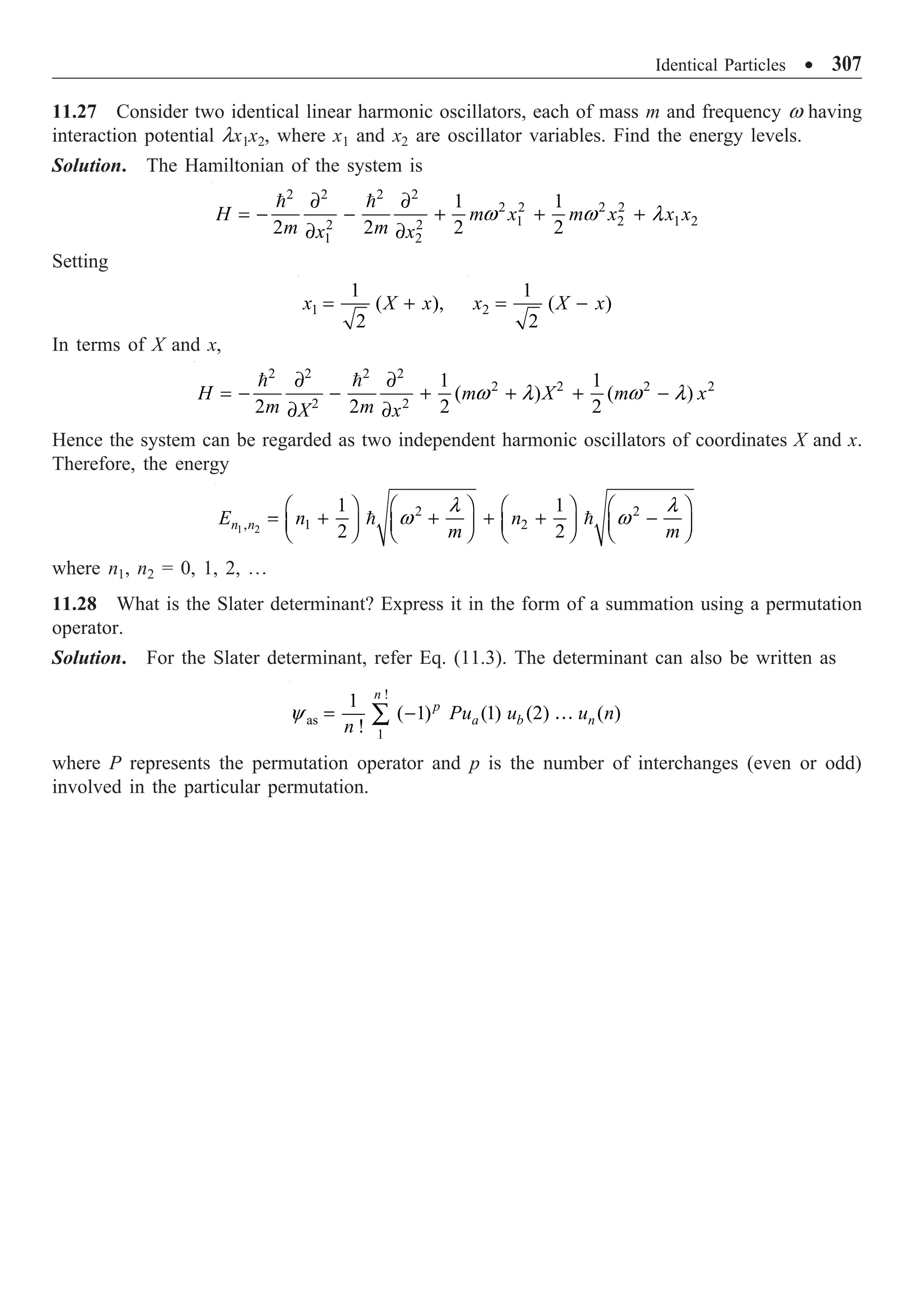
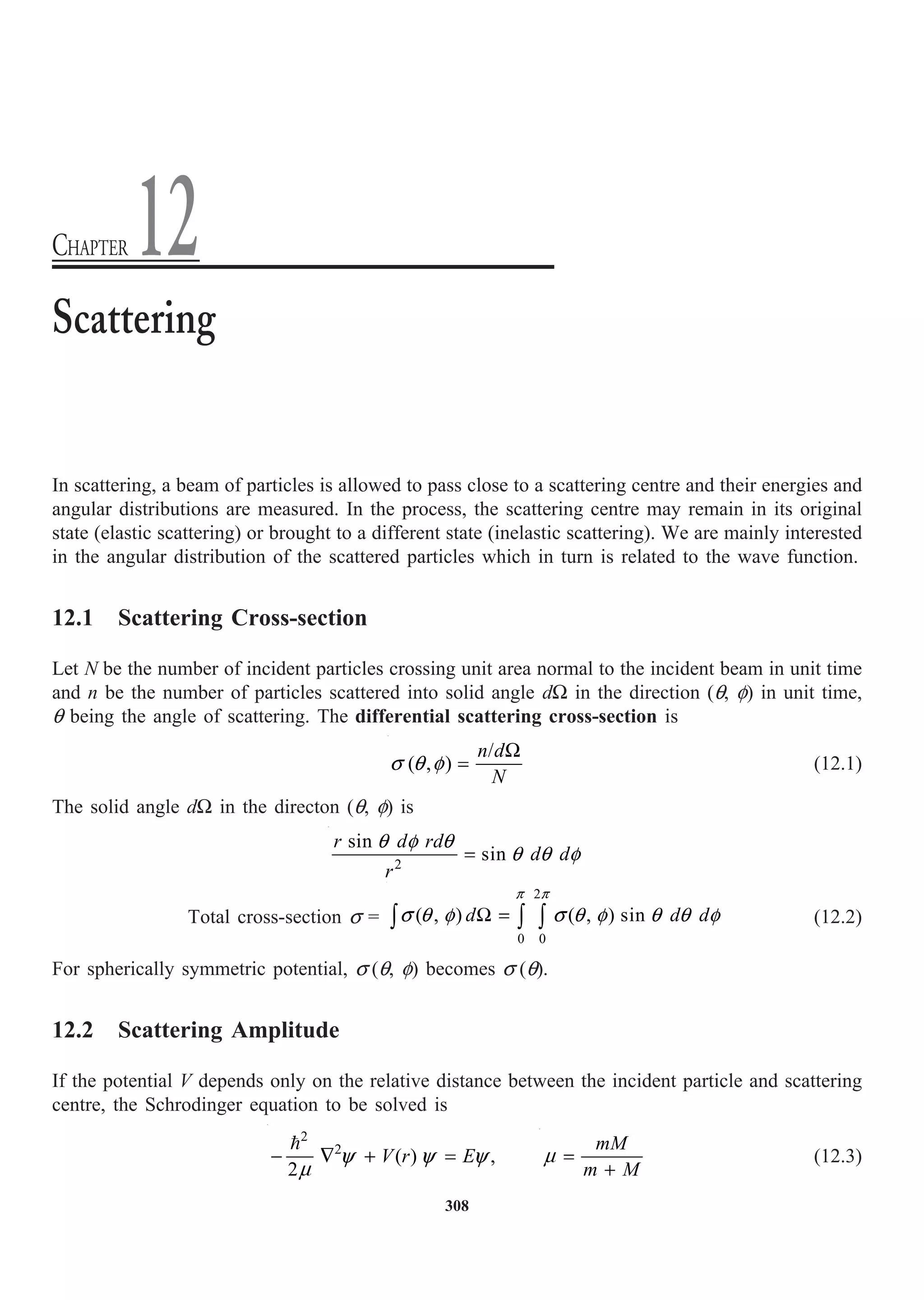
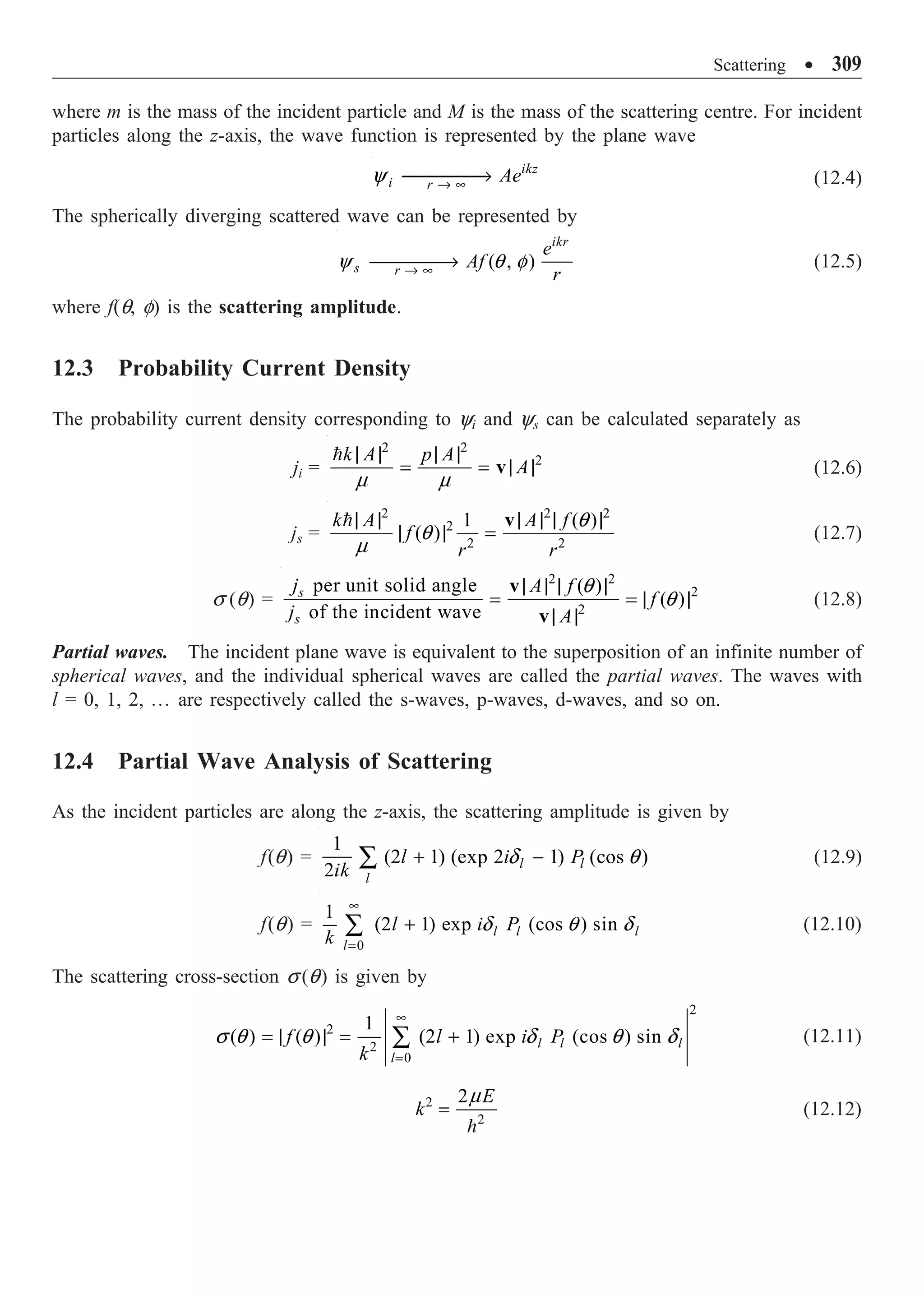
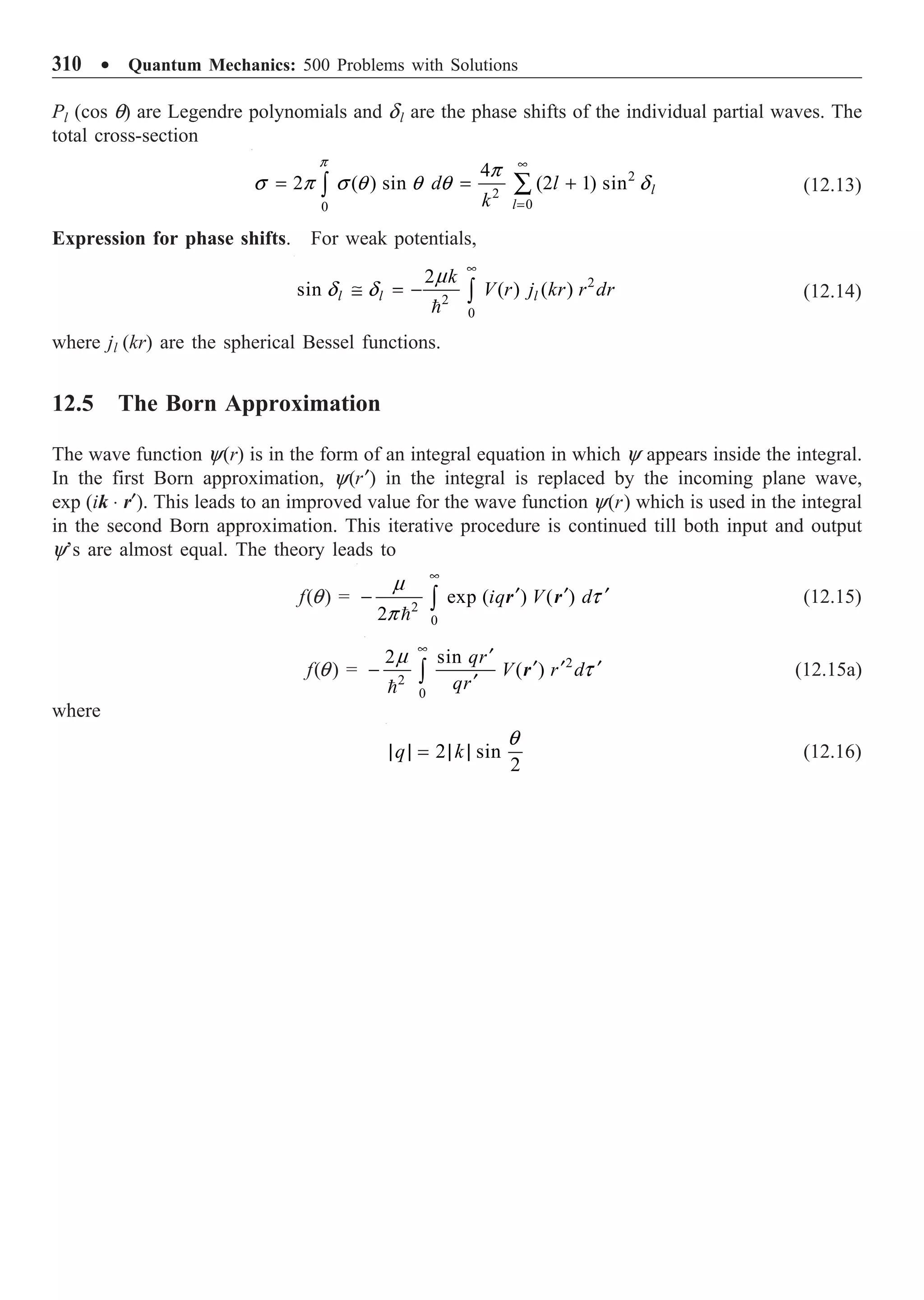

![312 ∑ Quantum Mechanics: 500 Problems with Solutions
Al = (2l + 1) eilp/2
= (2l + 1) il
Consequently,
eikz
=
0
(2 1) ( ) (cos )
l
l l
l
l i j kr P
•
=
+
 q
This is Bauer’s formula.
12.3 In the theory of scattering by a fixed potential, the asymptotic form of the wave function is
( , )
ikr
ikz
r
e
A e f
r
Æ•
È ˘
ææææ
Æ +
Í ˙
Í ˙
Î ˚
y q f
Obtain the formula for scattering cross-section in terms of the scattering amplitude f (q, f).
Solution. The probability current density j (r, t) is given by
( , ) ( * * )
2
i
t y y y y
m
= — - —
j r (i)
If j (r, t) is calculated with the given wave function, we get interference terms between the incident
and scattered waves. In the experimental arrangements, these do not appear. Hence we calculate the
incident and scattered probability current densities ji and js separately. The value of ji due to
exp (ikz) is
2
2 2
[ ( ) ( )]
2
i k A
A ik A ik
| |
= | | - - | | - =
m m
i
j (ii)
The scattered probability current density
js =
2 2
2 3 2 3
1 1
| ( , )
2
i ik ik
A f
r r r r
È ˘
| | | - - - +
Í ˙
Î ˚
q f
m
= 2 2
2
1
| ( , )
k
A f
r
| | |
q f
m
(iii)
In the above equation, 1/r2
is the solid angle subtended by unit area of the detector at the sacttering
centre. The differential scattering cross-section
s (q) =
Probability current density of the scattered wave per unit solid angle
Probability current density of the incident wave
=
2 2
2
( / ) [ ( )]
( / )
k A f
k A
| | | |
| |
m q f
m
= | f(q, f)|2
12.4 In the partial wave analysis of scattering, the scattering amptitude
0
1
( ) (2 1) exp ( ) (cos ) sin ,
l l l
l
f l i P
k
•
=
= +
Â
q d q d 2
2
2 E
k =
m](https://image.slidesharecdn.com/quantummechanics500problemswithsolutionspdfdrive-220626164912-635041ea/75/Quantum-Mechanics_-500-Problems-with-Solutions-PDFDrive-pdf-322-2048.jpg)
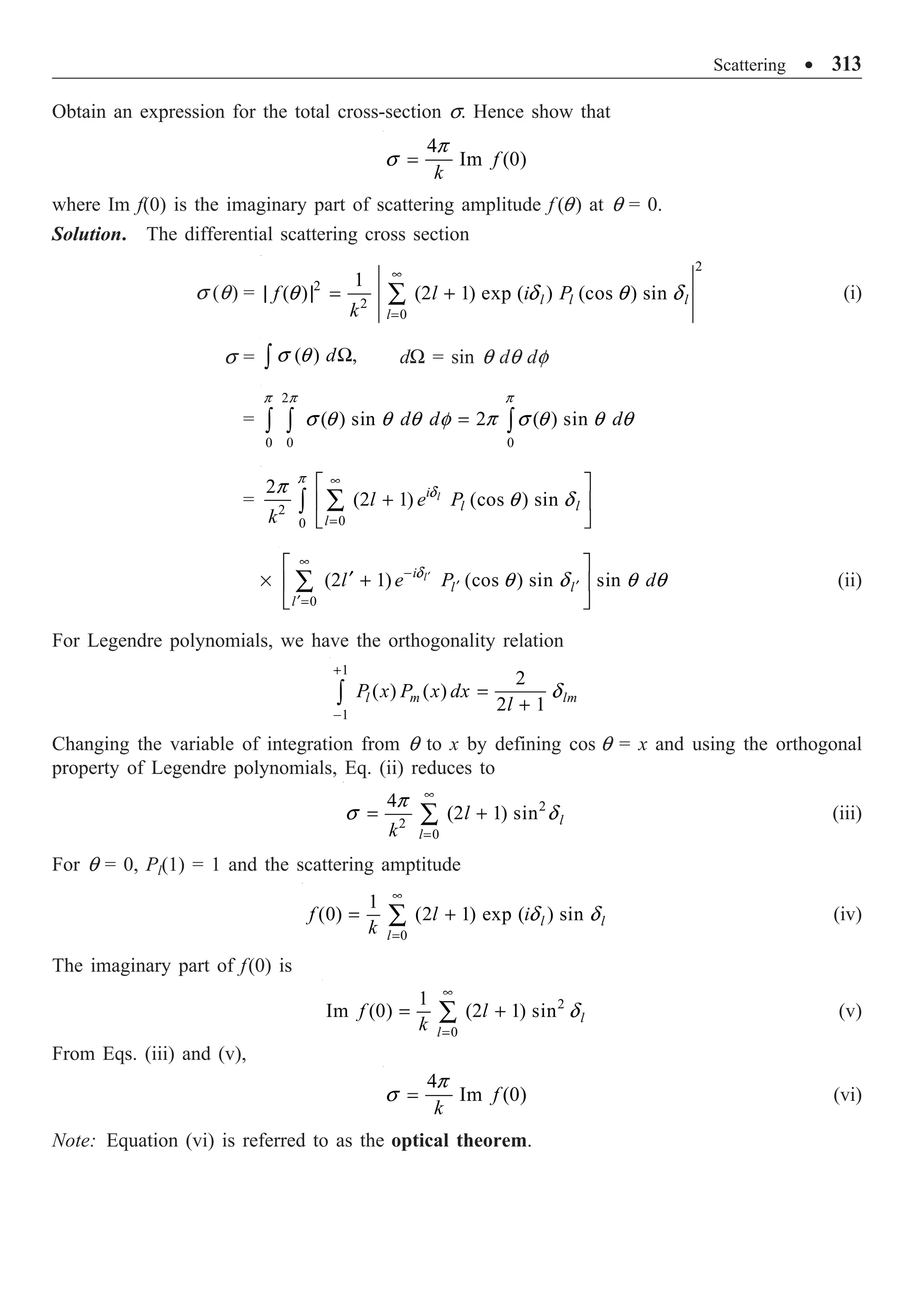
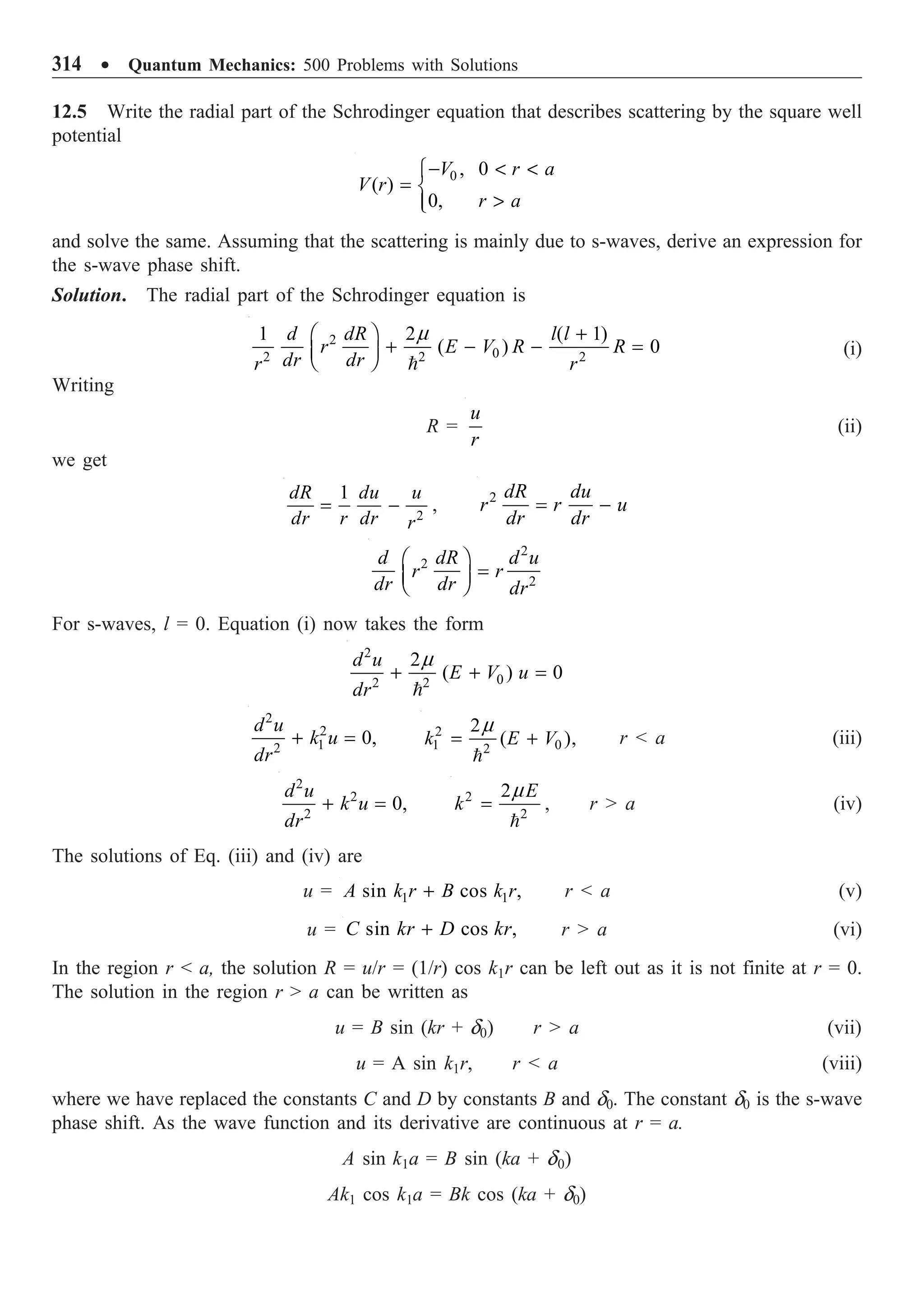
![Scattering ∑ 315
Dividing one by the other, we get
0 1
1
tan ( ) tan
k
ka k a
k
+ =
d (ix)
1
0 1
1
tan tan
k
k a ka
k
- Ê ˆ
= -
Á ˜
Ë ¯
d (x)
12.6 In a scattering problem, the scattering length a is defined by
0
lim [ ( )]
E
a f
Æ
= - q
Show that (i) the zero energy cross-section s0 = 4pa2
, and (ii) for weak potentials d0 = –ka.
Solution. When E is very low, only s-state is involved in the scattering. Consequently, from
Eq. (12.10), the scattering amplitude
0
0 0
1
( ) sin
i
f e
k
= d
q d
(i) In the limit E Æ 0,
0
0
1
sin
i
a e
k
= - d
d
0
0
sin i
kae-
= - d
d
From Eq. (12.13) we have
s0 = 2 2 2 2
0
2 2
4 4
sin 4
k a a
k k
= =
p p
d p
(ii) If the potential V(r) is weak, d0 will be small. Then exp (id0) @ 1 and sin d0 @ d0. Hence,
f(q) = 0
k
d
0
a
k
= -
d
or d0 = –ka
12.7 Consider the scattering of a particle having charge Z¢e by an atomic nucleus of charge Ze. If
the potential representing the interaction is
2
( ) r
ZZ e
V r e
r
-
¢
= - a
where a is a parameter. Calculate the scattering amplitude. Use this result to derive Rutherford’s
scattering formula for scattering by a pure Coulomb potential.
Solution. In the first Born approximation, the scattering amplitude f(q) is given by Eq. (12.15).
Substituting the given potential
2
2
0
2
( ) sin r
ZZ e
f qre dr
q
•
-
¢
= Ú
a
m
q (i)](https://image.slidesharecdn.com/quantummechanics500problemswithsolutionspdfdrive-220626164912-635041ea/75/Quantum-Mechanics_-500-Problems-with-Solutions-PDFDrive-pdf-325-2048.jpg)
![316 ∑ Quantum Mechanics: 500 Problems with Solutions
The value of this integral is evaluated in Problem 12.7. Substituting the value of the integral, we get
2 2
2 2 2 2 2 2
2 2
( )
( )
ZZ e q ZZ e
f
q q q
¢ ¢
= =
+ +
m m
q
a a
(ii)
The momentum transfer
2 sin
2
q k
| | = | |
q
(iii)
If the momentum transfer q a, then
2 2 2 2 2
4 sin
2
q a q k
+ @ =
q
(iv)
With this value of q2
, the differential scattering cross-section is
2 2 2 4
2
4 4 4
( ) | ( )|
4 sin ( /2)
Z Z e
f
k
¢
= =
m
s q q
q
(v)
which is Rutherford’s scattering formula for Coulomb scattering.
12.8 In a scattering experiment, the potential is spherically symmetric and the particles are
scattered at such energy that only s and p waves need be considered.
(i) Show that the differential cross-section s (q) can be written in the form s (q) = a + b cos q
+ c cos2
q.
(ii) What are the values of a, b, c in terms of phase shifts?
(iii) What is the value of total cross-section in terms of a, b, c?
Solution.
(i) The scattering amplitude
f(q) = 1
1
0
1
(2 1) (cos ) sin
i
l
l
l e P
k
d
q d
•
=
+
Â
= 0 1
0 1
1
[ sin 3 cos sin ]
i i
e e
k
d d
d q d
+
since
P0(cos q) = 1, P1(cos q) = cos q
s(q) = 2
2
1
( )
f
k
| | =
q [sin2
d0 + 6 sin d0 sin d1 cos (d0 – d1) cos q + 9 sin2
d1 cos2
q]
s(q ) = a + b cos q + c cos2
q
(ii) a =
2
0
2
sin
,
k
d
b = 2
6
k
sin d0 sin d1 cos (d0 – d1), c = 2
9
k
sin2
dl
(iii) Total cross-section s = 2 2
0 1
2
4
(sin 3 sin )
k
+
p
d d
=
4
4 4
3 3
c c
a a
Ê ˆ
+ = +
Á ˜
Ë ¯
p
p p](https://image.slidesharecdn.com/quantummechanics500problemswithsolutionspdfdrive-220626164912-635041ea/75/Quantum-Mechanics_-500-Problems-with-Solutions-PDFDrive-pdf-326-2048.jpg)

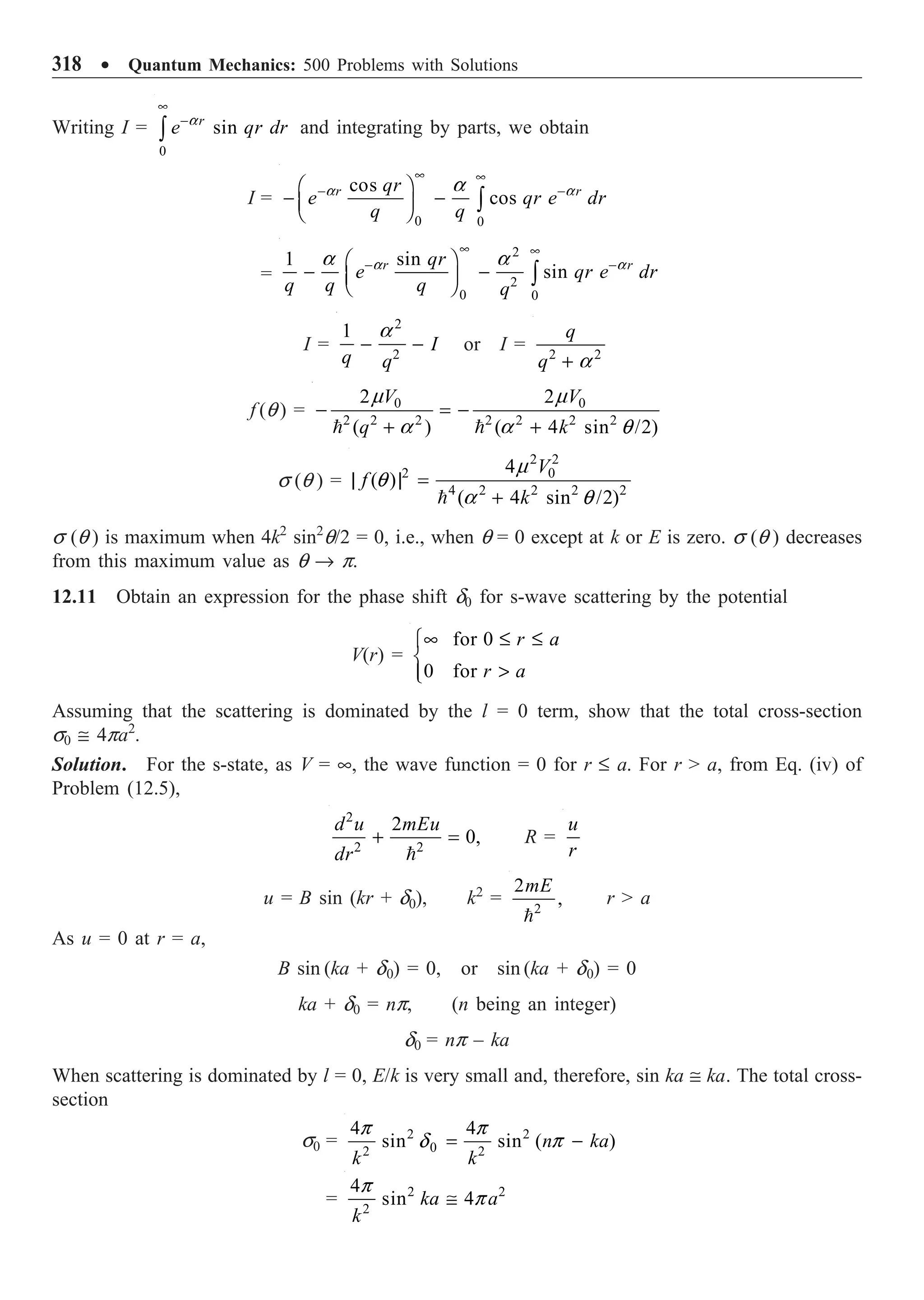

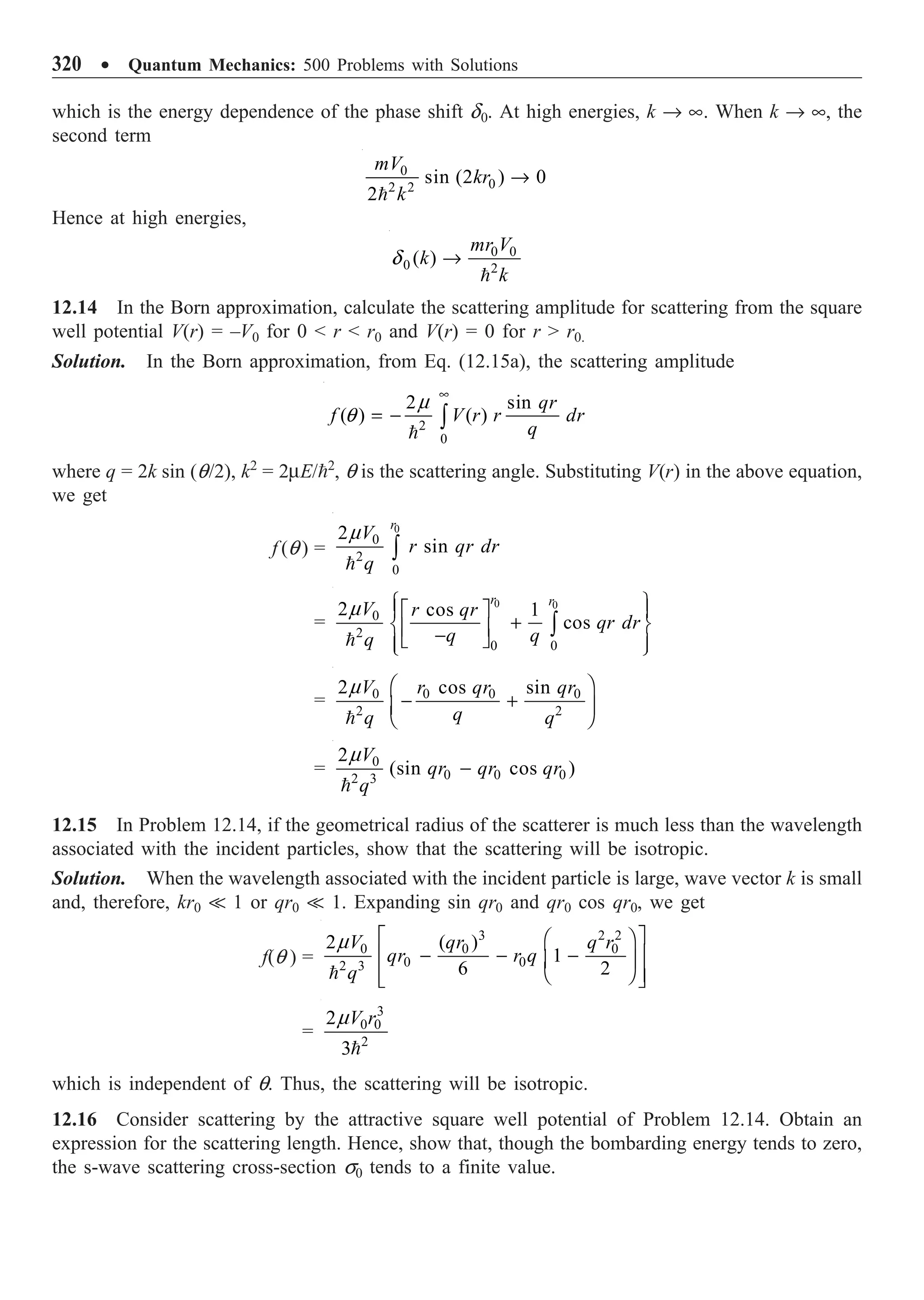
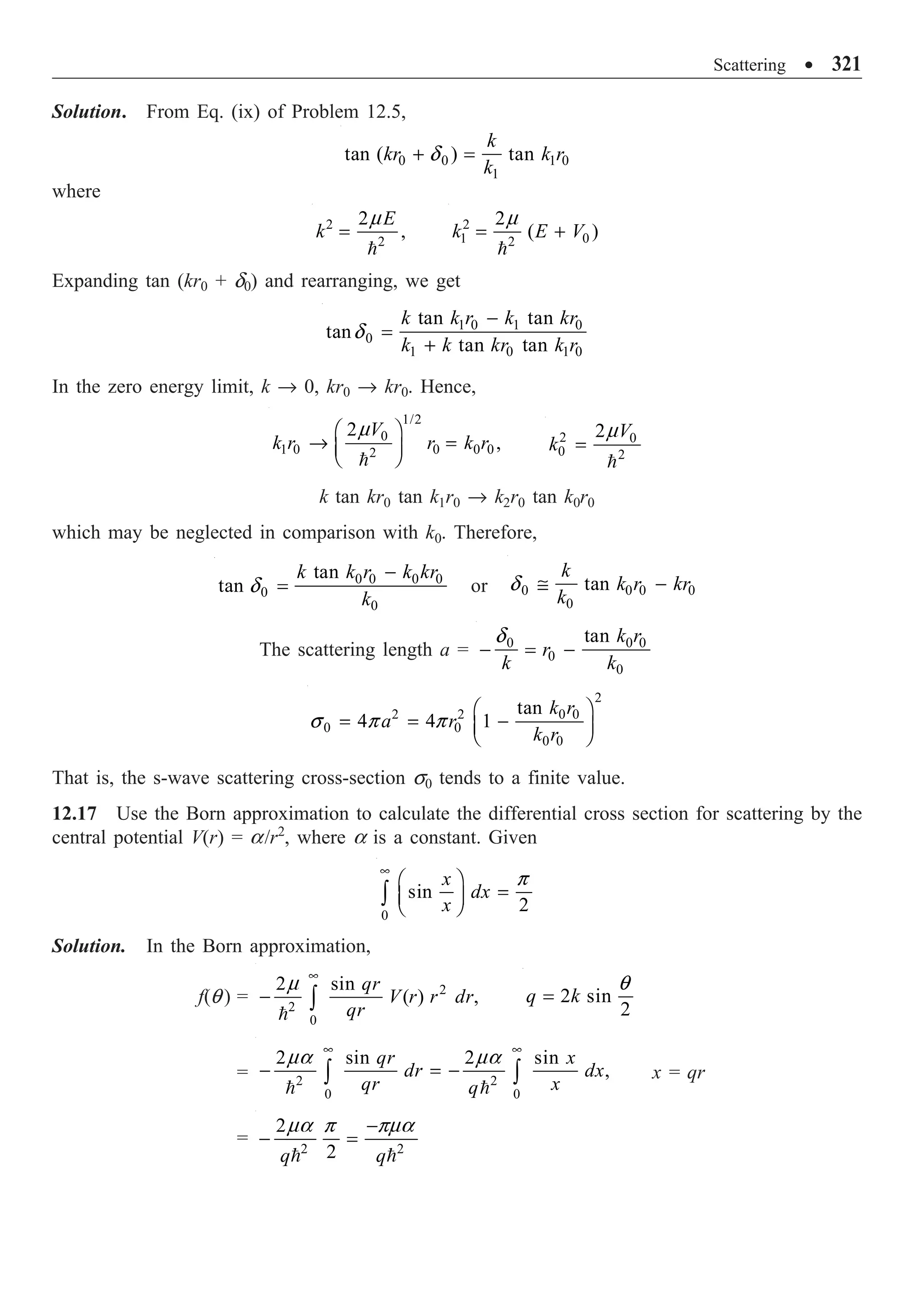
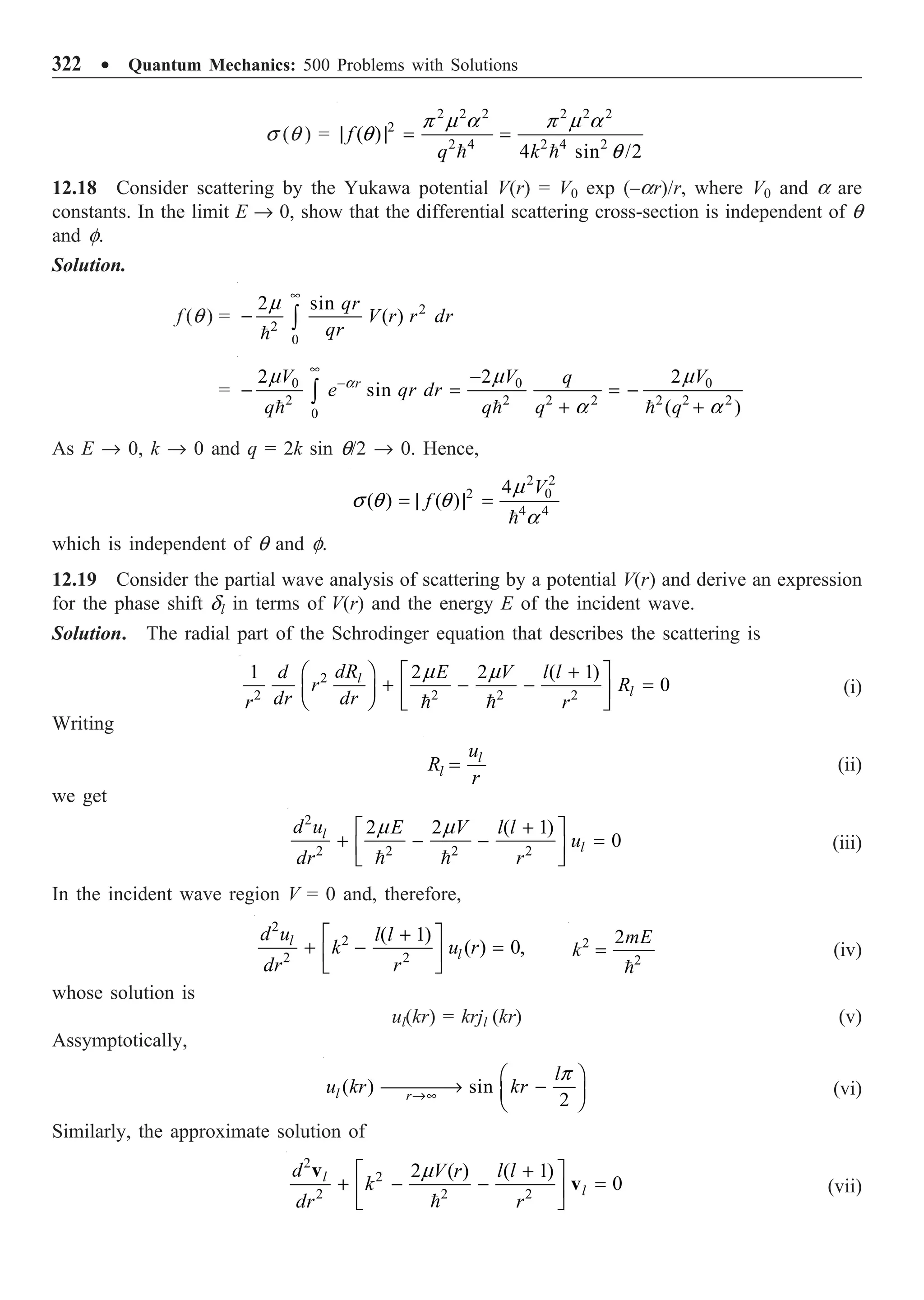
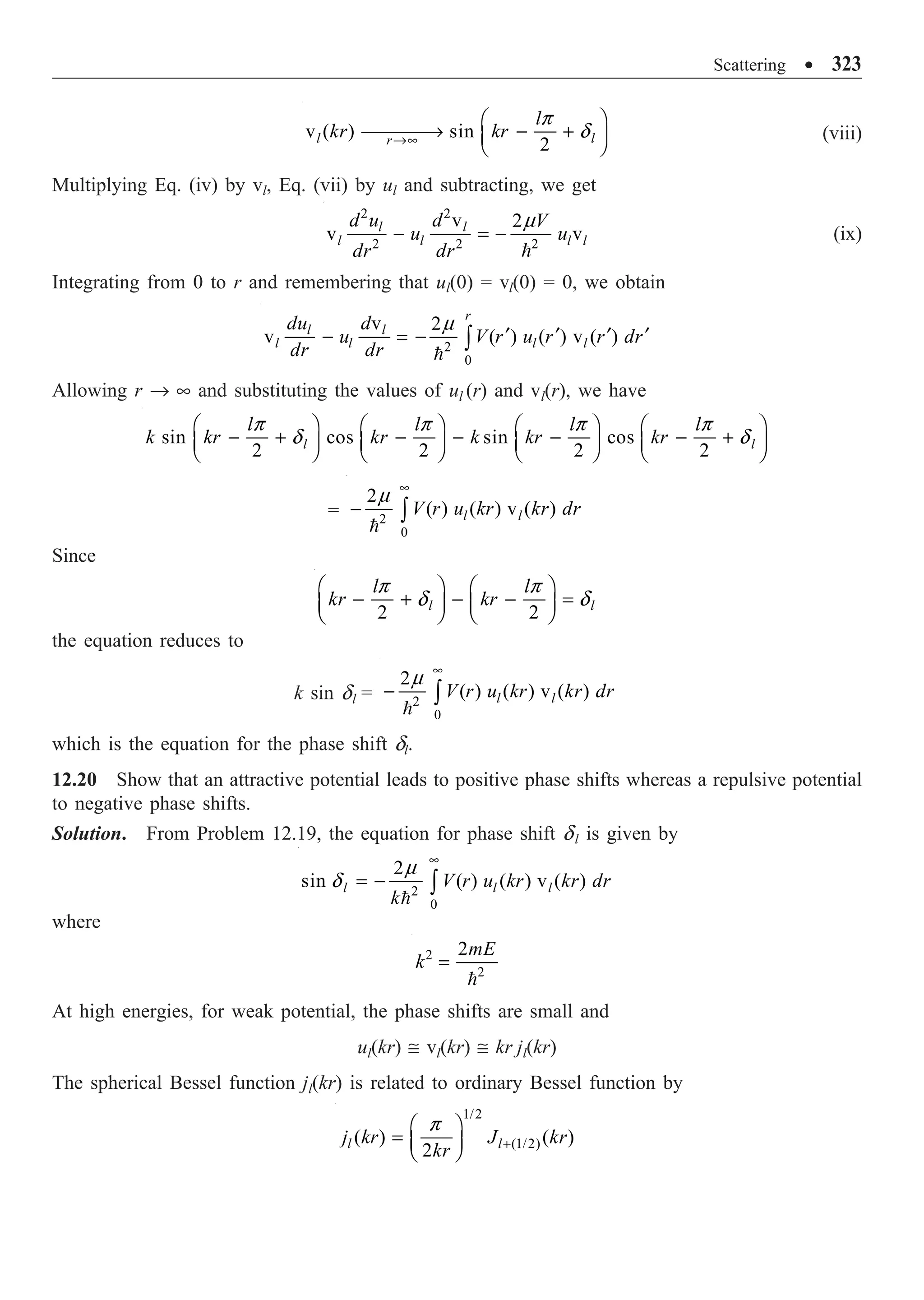
![324 ∑ Quantum Mechanics: 500 Problems with Solutions
sin dl = 2 2
2
0
2
( ) ( )
l l
k
V r j kr r dr
•
= - Ú
m
d
=
2
(1/2)
2
0
( ) ( )
l
V r j kr r dr
•
+
È ˘
- Î ˚
Ú
pm
From this equation it is obvious that an attractive potential (V £ 0) leads to positive phase shifts,
whereas repulsive potential (V ≥ 0) to negative phase shifts.
12.21 Use the Born approximation to obtain differential scattering cross-section when a particle
moves in the potential V(r) = –V0 exp (–r/r0), where V0 and r0 are positive constants. Given
2 2 2
0
2
exp ( ) sin ( )
( )
ab
x ax bx dx
a b
•
- =
+
Ú , a 0
Solution. The scattering amplitude
0
/
2 0
2 2
0 0
2
2 sin
( ) ( ) sin
r r
V
qr
f V r r dr re qr dr
qr q
• •
-
= - =
Ú Ú
m
m
q
2 2 2
0
2
sin ,
( )
ax ab
xe bx dx
a b
•
-
=
+
Ú a 0
2
2
0 0 0 0
2 2 2 2 2 2 2
0 0 0
2 2 (1/ ) 4
( )
[(1/ ) + ] 1
V q r V r
f
q r q r q r
Ê ˆ
= = Á ˜
+
Ë ¯
m m
q
2 2 6
2 0 0
4 2 2 4
0
16
( ) ( )
(1 )
V r
f
q r
= | | =
+
m
s q q
12.22 Calculate the scattering amplitude for a particle moving in the potential
V(r) = 0
0
exp
c r r
V
r r
- Ê ˆ
-
Á ˜
Ë ¯
where V0 and r0 are constants.
Solution.
f(q ) = 0
/
0
2
0
2
sin
r r
V c r
e r qr dr
r
q
•
-
-
- Ú
m
= 0 0
/ /
0
2
0 0
2
sin sin
r r r r
V
ce qr dr re qr dr
q
• •
- -
È ˘
- -
Í ˙
Í ˙
Î ˚
Ú Ú
m
f(q ) = 0
2 2 2 2 2 2
0
0 0
2 2 1
(1/ ) [(1/ ) ]
V q q
c
r
q q r r q
È ˘
- -
Í ˙
+ +
Í ˙
Î ˚
m
=
2 3
0 0 0
2 2 2 2 2 2
0 0
2 2
1 (1 )
V cr r
q r q r
m È ˘
- -
Í ˙
+ +
Í ˙
Î ˚](https://image.slidesharecdn.com/quantummechanics500problemswithsolutionspdfdrive-220626164912-635041ea/75/Quantum-Mechanics_-500-Problems-with-Solutions-PDFDrive-pdf-334-2048.jpg)
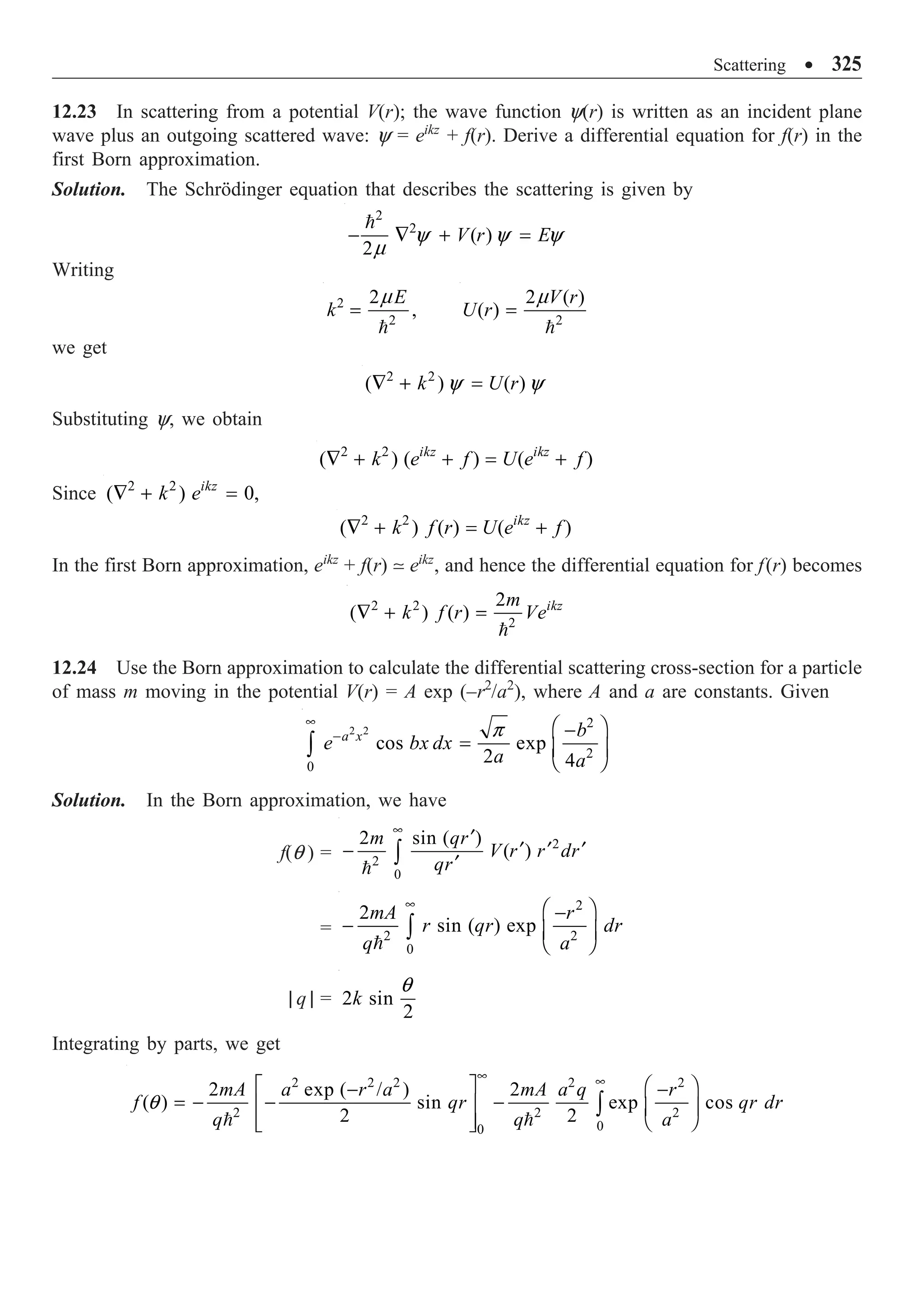
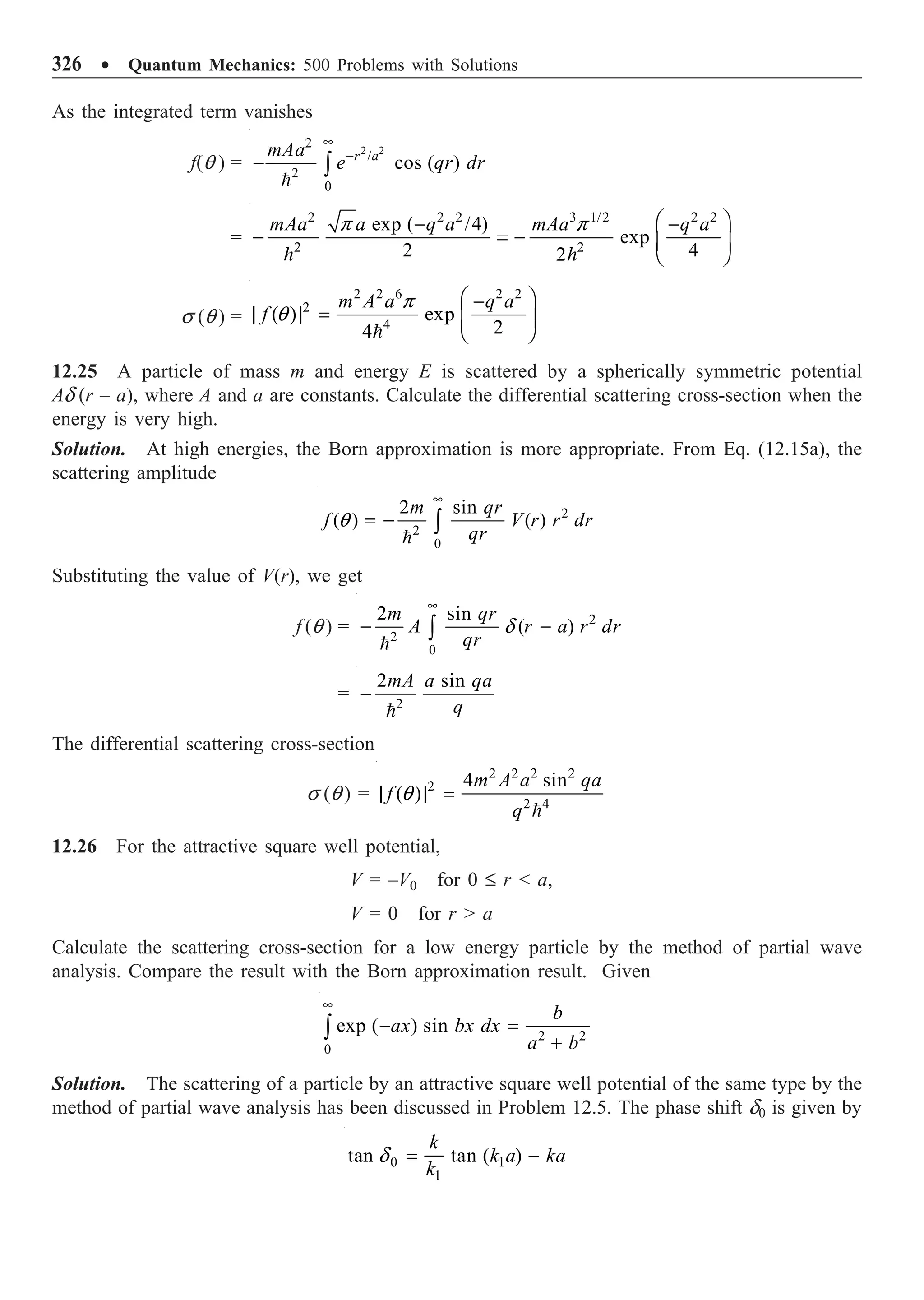
![Scattering ∑ 327
where
2
2
2
,
E
k =
m 2 0
1 2
2 ( )
E V
k
+
=
m
For low energy particles,
k Æ 0, k1 Æ k0 = 0
2
2 V
m
Consequently, the above relations reduce to
0
0
0
tan ( )
1
k a
ka
k a
È ˘
-
Í ˙
Î ˚
d
The total scattering cross-section
s 2 2
0 0
2 2
4 4
sin
k k
p p
d d
=
2
2 0
0
tan ( )
4 1
k a
a
k a
Ê ˆ
-
Á ˜
Ë ¯
p
If k0a 1,
s
2 2
3 3
2 2
0 0 0
0 0 0
( ) ( )
4 1 4
3 3
k a k a k a
a a
k a k a k a
Ê ˆ È ˘
+ - = Í ˙
Á ˜
Ë ¯ Í ˙
Î ˚
p p
=
6 2 2
0
4
16
9
a V
p m
In the Born approximation, the scattering amplitude (refer Problem 12.14)
0
2 3
2
( ) [sin ( ) cos ( )]
V
f qa qa qa
q
= -
m
q
2 2
2 2
0
4 6
4
( ) | ( )| [sin ( ) cos ( )]
V
f qa qa qa
q
= = -
m
s q q
where
2 sin ,
2
q k
=
q 2
2
2 E
k =
m
where q is the scattering angle. At low energies, k Æ 0, q Æ 0, and hence
3
1
sin ( ) ( ) ,
3 !
qa qa qa
-
2
1
cos ( ) 1 ( )
2 !
qa qa
-
Hence,
2 2 6
0
4
4
( )
9
V a
=
m
s q](https://image.slidesharecdn.com/quantummechanics500problemswithsolutionspdfdrive-220626164912-635041ea/75/Quantum-Mechanics_-500-Problems-with-Solutions-PDFDrive-pdf-337-2048.jpg)
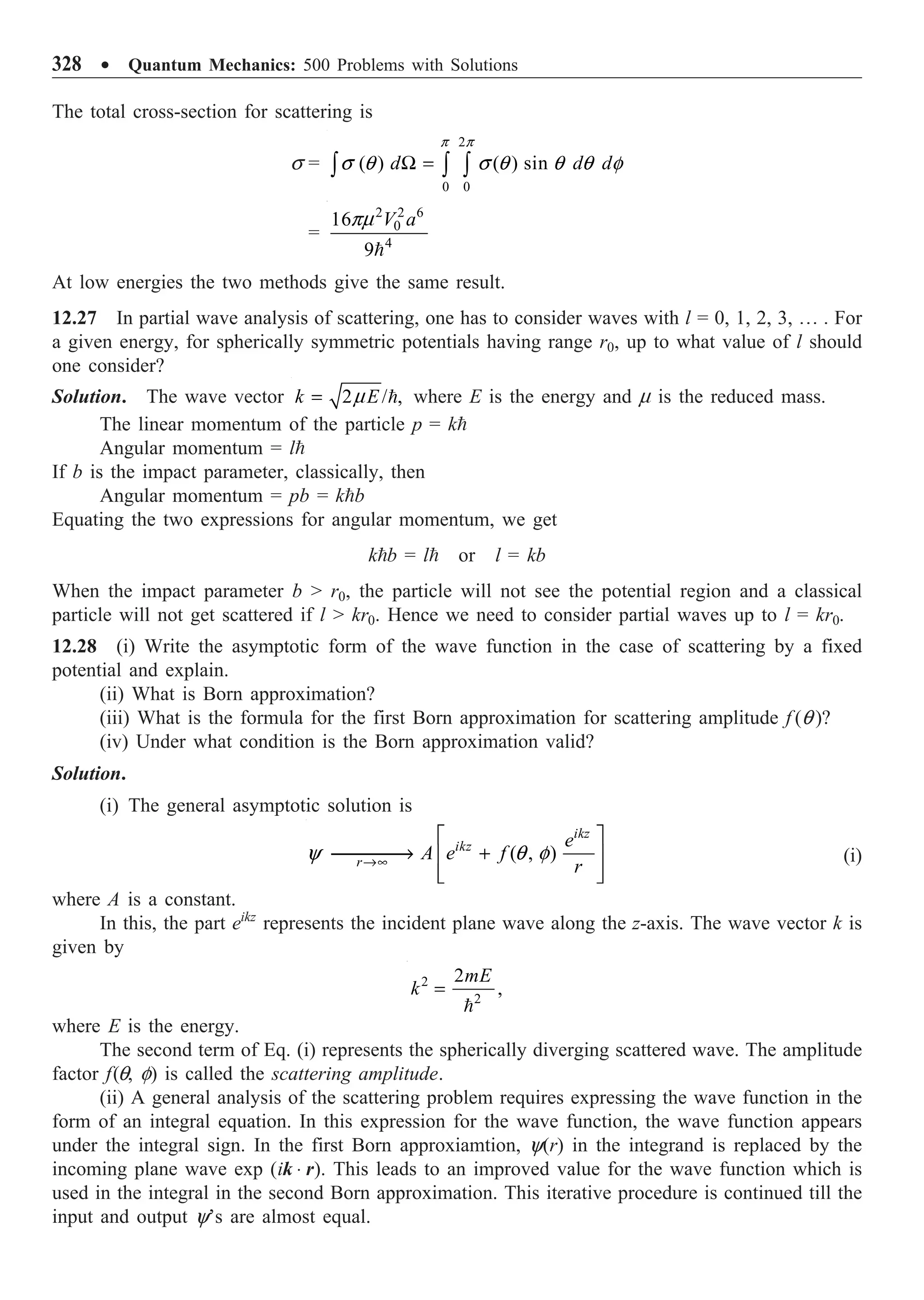
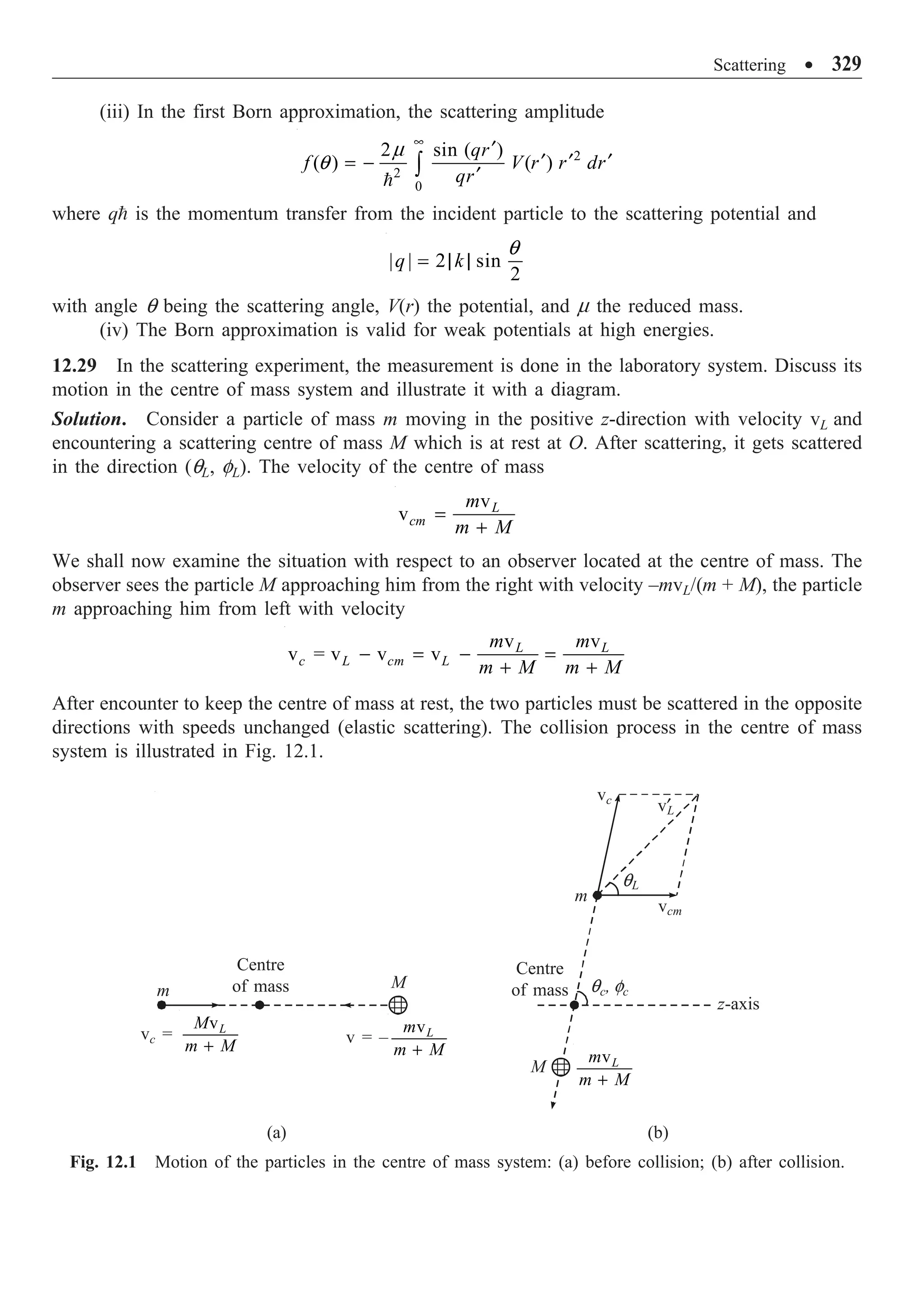

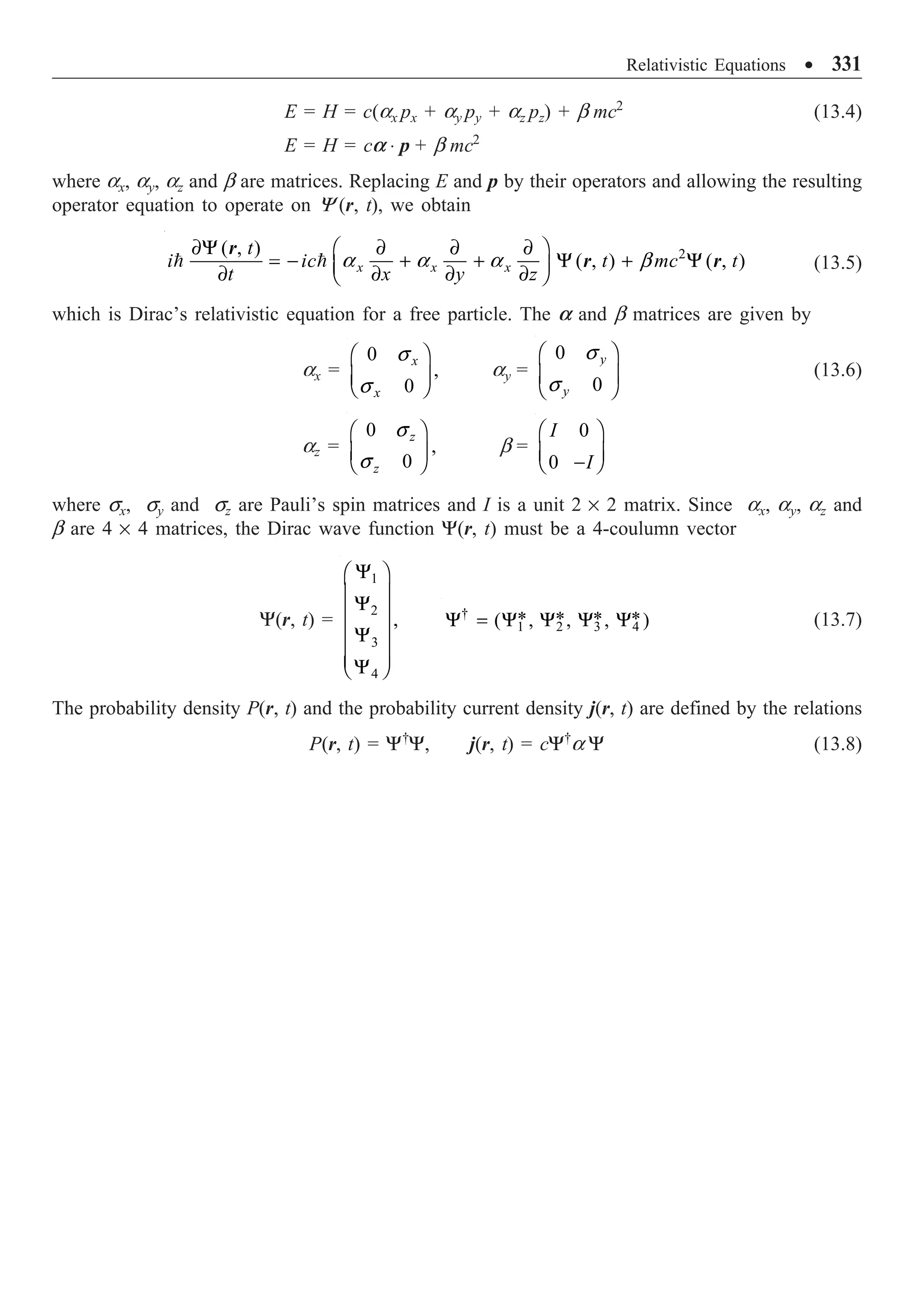
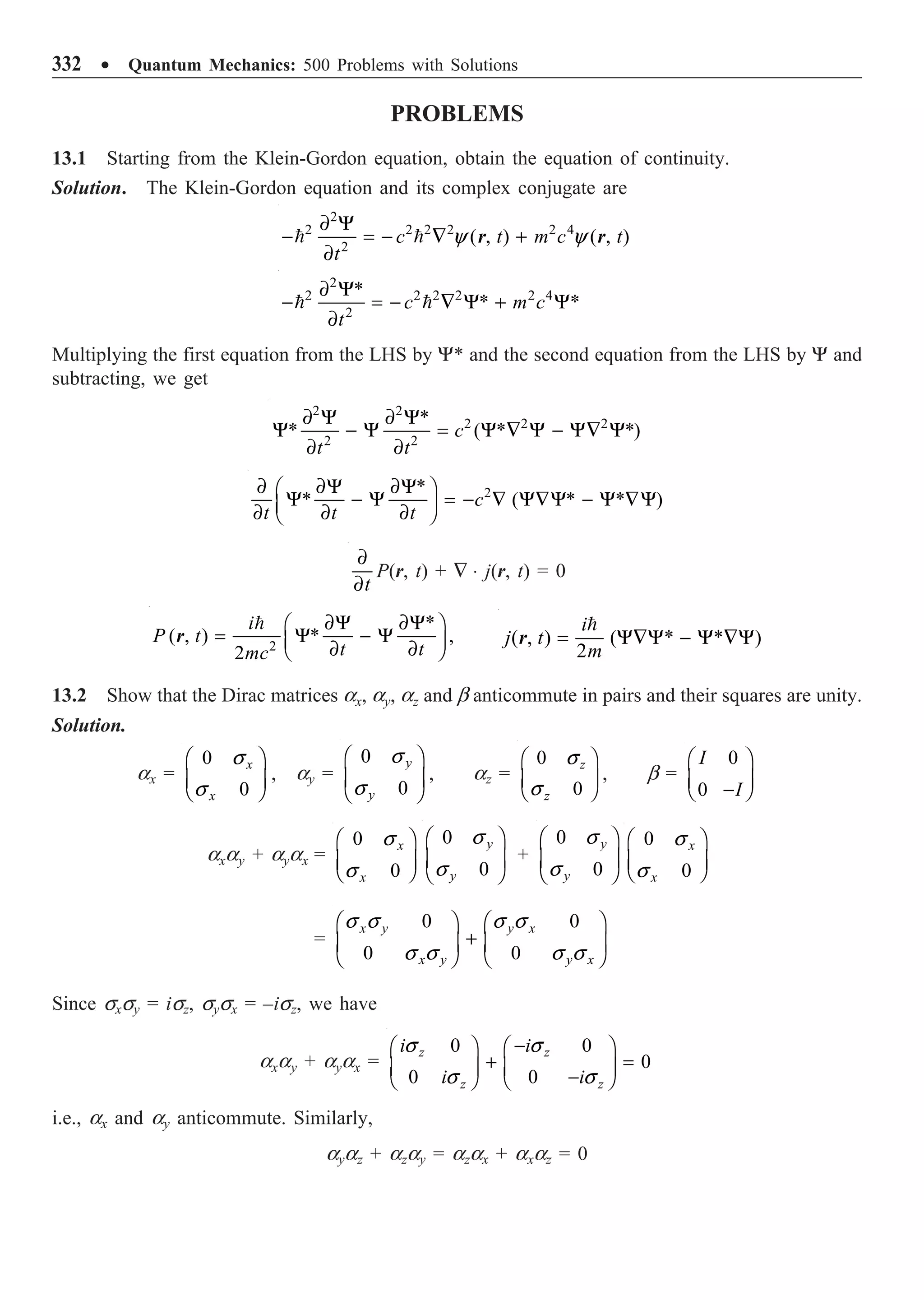
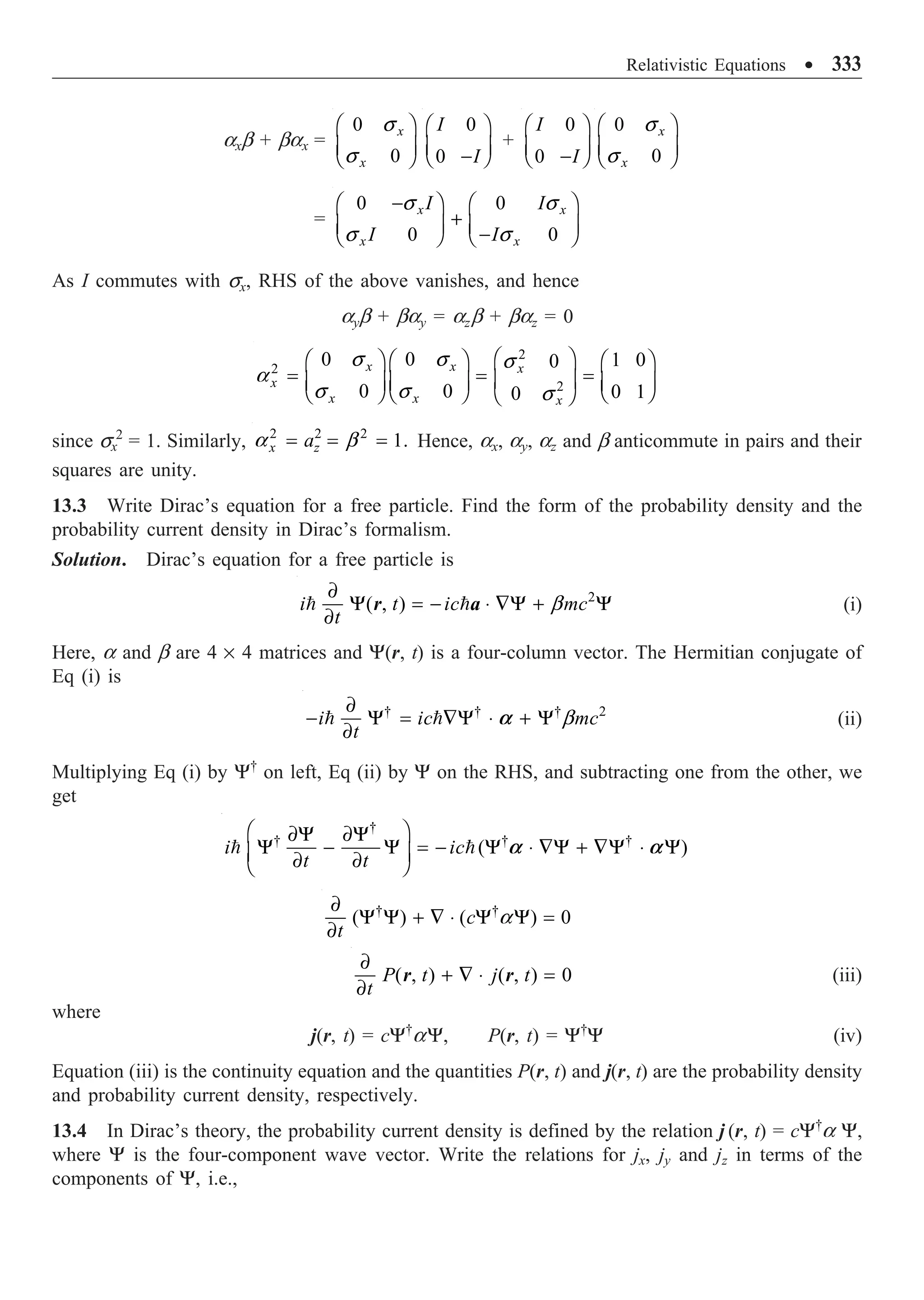
![334 ∑ Quantum Mechanics: 500 Problems with Solutions
j(r, t) = cY†
aY, jx = cY†
axY
jx =
1
2
1 2 3 4
3
4
0 0 0 1
0 0 1 0
* * * *
( )
0 1 0 0
1 0 0 0
c
Y
Ê ˆ
Ê ˆ
Á ˜
Á ˜ Y
Á ˜
Á ˜
Y Y Y Y
Á ˜
Á ˜ Y
Á ˜
Á ˜
Á ˜ Á ˜
Y
Ë ¯ Ë ¯
=
4
3
1 2 3 4
2
1
* * * *
( )
c
Y
Ê ˆ
Á ˜
Y
Á ˜
Y Y Y Y
Á ˜
Y
Á ˜
Á ˜
Y
Ë ¯
= 1 4 2 3 3 2 4 1
* * * *
( )
c Y Y + Y Y + Y Y + Y Y
Proceeding on a similar line, we have
jy = 1 4 2 3 3 2 4 1
* * * *
( )
ic -Y Y + Y Y - Y Y + Y Y
jz = 1 3 2 4 3 1 4 2
* * * *
( )
c Y Y - Y Y + Y Y - Y Y
13.5 Prove that the operator ca, where a stands for Dirac matrix, can be interpreted as the velocity
operator.
Solution. In the Heisenberg picture, the equation of motion of the position vector r, which has no
explicit time dependence, is given by
1
[ , ],
d
H
dt i
=
r
r H = ca ◊ p + bmc2
Since a commutes with x, the x-component of the above equation reduces to
dx
dt
=
1 1
[ , ] ( ) ( )
x x x x
c
H xH Hx x p p x
i i i
= - = -
a a
x
= ( )
x x x x
c
xp p x c
i
- =
a a
Similarly,
dy
dt
= cay,
dz
dt
= caz
Thus, ca is the velocity vector.
13.6 Show that (a ◊ A) (a ◊ B) = (A ◊ B) + is ¢ ◊ (A ¥ B), where A and B commute with a and
s ¢ =
0
.
0
s
s
Ê ˆ
Á ˜
Ë ¯
Solution.
(a ◊ A) (a ◊ B) = (ax Ax + ay Ay + az Az) (axBx + ayBy + azBz)
= 2
x
a AxBx + 2
y
a AyBy + 2
z
a AzBz + axay AxBy + axazAxBz
+ ayaxAyBx + ayazAyBz + azaxAzBx + azayAzBy](https://image.slidesharecdn.com/quantummechanics500problemswithsolutionspdfdrive-220626164912-635041ea/75/Quantum-Mechanics_-500-Problems-with-Solutions-PDFDrive-pdf-344-2048.jpg)
![Relativistic Equations ∑ 335
Since 2 2 2
1,
x y z x y y x
= = = = -
a a a a a a a and the cyclic relations
(a ◊ A) (a ◊ B) = (A ◊ B) + axay (AxBy – AyBx) + ayaz (AyBz – AzBy)
+ azax (AzBx – AxBz)
axay =
0 0 0
0
0 0 0
0
y x y z
x
z
y x y z
x
i i
Ê ˆ Ê ˆ Ê ˆ
Ê ˆ
¢
= = =
Á ˜ Á ˜ Á ˜
Á ˜
Ë ¯ Ë ¯
Ë ¯ Ë ¯
s s s s
s
s
s s s s
s
Using this results and the cyclic relations, we get
(a ◊ A)(a ◊ B) = (A ◊ B) + is ¢ ◊ (A ¥ B)
13.7 Consider the one-dimensional Dirac equation
2
[ ( )]
z
i c p mc V z
t
∂
= + +
∂
y
a b y , z
p i
z
∂
= -
∂
0
,
0
z
z
Ê ˆ
= Á ˜
Ë ¯
s
a
s
1 0
,
0 1
z
Ê ˆ
= Á ˜
-
Ë ¯
s
0
0
I
I
Ê ˆ
= Á ˜
-
Ë ¯
b
Show that
(i)
0
0
z
z
Ê ˆ
= Á ˜
Ë ¯
s
s
s
commutes with H; (ii) The one-dimensional Dirac equation can be written as two coupled first order
differential equations.
Solution. The Hamiltonian
2
( )
H c i mc V z
z
∂
Ê ˆ
= - + +
Á ˜
∂
Ë ¯
a b
The commutator
[s, a] =
0 0 0 0 0 0
0 0 0 0 0 0
z z z z z z
z z z z z z
È ˘
Ê ˆ Ê ˆ Ê ˆ Ê ˆ Ê ˆ Ê ˆ
= -
Í ˙
Á ˜ Á ˜ Á ˜ Á ˜ Á ˜ Á ˜
Ë ¯ Ë ¯ Ë ¯ Ë ¯ Ë ¯ Ë ¯
Í ˙
Î ˚
s s s s s s
s s s s s s
=
2 2
2 2
0 0
0
0 0
z z
z z
Ê ˆ Ê ˆ
- =
Á ˜ Á ˜
Ë ¯ Ë ¯
s s
s s
Similarly,
0 0
[ , ] , 0
0 0
z
z
I
I
È ˘
Ê ˆ Ê ˆ
= =
Í ˙
Á ˜ Á ˜
-
Ë ¯
Ë ¯
Í ˙
Î ˚
s
s b
s
Hence,
2
[ , ] [ , ] [ , ] 0
z
H c p mc
= + =
s s a s b](https://image.slidesharecdn.com/quantummechanics500problemswithsolutionspdfdrive-220626164912-635041ea/75/Quantum-Mechanics_-500-Problems-with-Solutions-PDFDrive-pdf-345-2048.jpg)
![336 ∑ Quantum Mechanics: 500 Problems with Solutions
As [s, H] = 0, the two operators s and H have common eigenfunctions s is a diagonal matrix whose
eigenfunction is
1
2
3
4
Ê ˆ
Á ˜
Á ˜
Á ˜
Á ˜
Á ˜
Ë ¯
y
y
y
y
1 1 1 1
2 2 2 2
3 3 3 3
4 4 4 4
0
1 0 0 0
0 1 0 0 0
0
0 0 1 0
0 0 0 1 0
Ê ˆ Ê ˆ Ê ˆ Ê ˆ
Ê ˆ Ê ˆ
Á ˜ Á ˜ Á ˜ Á ˜
Á ˜ Á ˜
-
-
Á ˜ Á ˜ Á ˜ Á ˜
Á ˜ Á ˜
= = = -
Á ˜ Á ˜ Á ˜ Á ˜
Á ˜ Á ˜
Á ˜ Á ˜ Á ˜ Á ˜
Á ˜ Á ˜
Á ˜ Á ˜
Á ˜ Á ˜ Á ˜ Á ˜
-
-
Ë ¯ Ë ¯
Ë ¯ Ë ¯ Ë ¯ Ë ¯
y y y y
y y y y
s
y y y y
y y y y
From the form of s, it is obvious that
1
3
0
0
Ê ˆ
Á ˜
Á ˜
Á ˜
Á ˜
Á ˜
Ë ¯
y
y
and
2
4
0
0
Ê ˆ
Á ˜
Á ˜
Á ˜
Á ˜
Á ˜
Ë ¯
y
y
are the eigenfunctions of s with the eigenvalues +1 and –1, respectively. Substituting these functions
in the Dirac equation, we get
1 1
2
3 3
0 0
0 0
i i c mc V
t z
Ê ˆ Ê ˆ
Á ˜ Á ˜
∂ ∂
Ê ˆ
Á ˜ Á ˜
= - + +
Á ˜
∂ ∂
Á ˜ Á ˜
Ë ¯
Á ˜ Á ˜
Á ˜ Á ˜
Ë ¯ Ë ¯
y y
a b
y y
2 2
2
4 4
0 0
0 0
i i c mc V
t z
Ê ˆ Ê ˆ
Á ˜ Á ˜
∂ ∂
Ê ˆ
Á ˜ Á ˜
= - + +
Á ˜
Á ˜ Á ˜
∂ ∂
Ë ¯
Á ˜ Á ˜
Á ˜ Á ˜
Ë ¯ Ë ¯
y y
a b
y y
1 1 3
3 3 1
/ 0 0 1 0 /
0 0 0 0 1 0 0
/ 1 0 0 0 /
0 0 1 0 0 0 0
z z
z
z z
y y y
a
y y y
∂ ∂ ∂ ∂
Ê ˆ Ê ˆ Ê ˆ Ê ˆ
Á ˜ Á ˜ Á ˜ Á ˜
- ∂
Á ˜ Á ˜ Á ˜ Á ˜
= =
∂
Á ˜ Á ˜ Á ˜ Á ˜
∂ ∂ ∂ ∂
Á ˜ Á ˜ Á ˜ Á ˜
Á ˜ Á ˜ Á ˜ Á ˜
-
Ë ¯ Ë ¯ Ë ¯ Ë ¯
1 1 1
3 3 3
1 0 0 0
0 0 1 0 0 0 0
0 0 1 0
0 0 0 0 1 0 0
Ê ˆ Ê ˆ Ê ˆ Ê ˆ
Á ˜ Á ˜ Á ˜ Á ˜
Á ˜ Á ˜ Á ˜ Á ˜
= =
Á ˜ Á ˜ Á ˜ Á ˜
- -
Á ˜ Á ˜ Á ˜ Á ˜
Á ˜ Á ˜ Á ˜ Á ˜
-
Ë ¯ Ë ¯ Ë ¯ Ë ¯
y y y
b
y y y](https://image.slidesharecdn.com/quantummechanics500problemswithsolutionspdfdrive-220626164912-635041ea/75/Quantum-Mechanics_-500-Problems-with-Solutions-PDFDrive-pdf-346-2048.jpg)
![Relativistic Equations ∑ 337
Similarly,
2 2 4
4 4 2
0 0 0
0 0 1 0
/ /
0 0 0 1
0 0 0
1 0 0 0
/ /
0 1 0 0
z z
z
z z
y y y
a
y y y
Ê ˆ Ê ˆ Ê ˆ
Ê ˆ
Á ˜ Á ˜ Á ˜
Á ˜
∂ ∂ ∂ ∂ -
- ∂
Á ˜ Á ˜ Á ˜
Á ˜
= =
Á ˜ Á ˜ Á ˜
∂
Á ˜
Á ˜ Á ˜ Á ˜
Á ˜
Á ˜
Á ˜ Á ˜ Á ˜
∂ ∂ ∂ ∂ -
-
Ë ¯
Ë ¯ Ë ¯ Ë ¯
Substituting this equation in the Dirac equations, we have
1 3 1 1
2
3 1 3 3
0 0 0 0
( )
0 0 0 0
i i c mc V z
t z
Ê ˆ Ê ˆ Ê ˆ Ê ˆ
Á ˜ Á ˜ Á ˜ Á ˜
∂ ∂
Á ˜ Á ˜ Á ˜ Á ˜
= - + +
∂ ∂
Á ˜ Á ˜ Á ˜ Á ˜
-
Á ˜ Á ˜ Á ˜ Á ˜
Á ˜ Á ˜ Á ˜ Á ˜
Ë ¯ Ë ¯ Ë ¯ Ë ¯
y y y y
y y y y
2 4 2 2
2
4 2 4 4
0 0 0 0
( )
0 0 0 0
i i c mc V z
t z
Ê ˆ Ê ˆ Ê ˆ Ê ˆ
Á ˜ Á ˜ Á ˜ Á ˜
- -
∂ ∂
Á ˜ Á ˜ Á ˜ Á ˜
= - + +
Á ˜ Á ˜ Á ˜ Á ˜
∂ ∂
Á ˜ Á ˜ Á ˜ Á ˜
Á ˜ Á ˜ Á ˜ Á ˜
- -
Ë ¯ Ë ¯ Ë ¯ Ë ¯
y y y y
y y y y
Each of these two equations represents two coupled differential equations.
13.8 For a Dirac particle moving in a central potential, show that the orbital angular momentum
is not a constant of motion.
Solution. In the Heisenberg picture, the time rate of change of the L = r ¥ p is given by
[ , ]
d
i L H
dt
=
L
Its x-component is
2
[ , ] [ , ]
x x z y
d
i L L H yp zp c mc
dt
a
= = - ◊ +
b
p
Since a and b commute with r and p,
x
d
i L
dt
= [ , ] [ , ]
z y y y z z
yp c zp c
-
a a
p p
= [ , ] [ , ]
y z y z y z
c y p p c z p p
-
a a
= cipzay – cipyaz
= ic (pza – pyaz)
which shows that Lx is not a constant of motion. Similar relations hold good for Ly and Lz
components. Hence the orbital angular momentum L is not a constant of motion.
13.9 Prove that the quatity L + (1/2)s ¢, where L is the orbital angular momentum of a particle,
and s ¢ =
0
0
s
s
¢
Ê ˆ
Á ˜
¢
Ë ¯
is a constant of motion for the particle in Dirac’s formalism. Hence give an
interpretation for the additional angular momentum 1/2 s ¢.](https://image.slidesharecdn.com/quantummechanics500problemswithsolutionspdfdrive-220626164912-635041ea/75/Quantum-Mechanics_-500-Problems-with-Solutions-PDFDrive-pdf-347-2048.jpg)
![338 ∑ Quantum Mechanics: 500 Problems with Solutions
Solution. In Dirac’s formalism, the Hamiltonian of a free particle is
H = ca ◊ p + bmc2
(i)
In the Heisenberg picture, the equation of motion for an operator M is given by
[ , ]
d
i H
dt
=
M M (ii)
Hence, for a dynamical variable to be a constant of motion, it should commute with its Hamiltonian.
Writing
1
2
¢
= + s
M L (iii)
where equation of motion is
2
1 1
,
2 2
d
i c mc
dt
a
Ê ˆ È ˘
¢ ¢
+ = + ◊ +
Á ˜ Í ˙
Ë ¯ Î ˚
s s b
L L p (iv)
The x-component of Eq. (iv) is
1
2
x x
d
i L
dt
Ê ˆ
¢
+
Á ˜
Ë ¯
s =
2
1
,
2
x x
L c mc
a
È ˘
¢
+ ◊ +
Í ˙
Î ˚
s b
p
= 2 2
1
[ , ] [ , ]
2
x x
L c mc c mc
a a
¢
◊ + + ◊ +
b s b
p p (v)
Let us now evaluate the commutators on the right side of (v) one by one
2 2
[ , ] [ , ]
x z y x x y y z z
L c mc yp zp c p c p c p mc
a ◊ + = - + + +
b a a a b
p
Since a and b commute with r and p,
2
[ , ]
x
L c mc
a ◊ + b
p = [ , ] [ , ]
z y y z z z
yp c p zp c p
-
a a
= [ , ] [ , ]
y z y z y z
c y p p c z p p
-
a a
= ( )
y z z y
ic p p
-
a a (vi)
The second commutator in Eq. (v) is
2
[ , ]
x c mc
a
¢ ◊ +
s b
p = 2
[ , ]
x x x y y z z
c p c p c p mc
¢ + + +
s a a a b
= 2
[ , ] [ , ] [ , ] [ , ]
x x x x y y x z z x
c p c p c p mc
¢ ¢ ¢ ¢
+ + +
s a s a s a s b
From Problem 13, we have
[ , ] 0,
x
¢ =
s b [ , ] 0,
x x
¢ =
s a [ , ] 2 ,
x y z
i
¢ =
s a a [ , ] 2
x z y
i
¢ = -
s a a
Substituting these commutators in the above equation, we get
2
[ , ]
x c mc
a
¢ ◊ +
s b
p = [ , ] [ , ]
x y y x z z
c p c p
¢ ¢
+
s a s a
= 2 2
z y y z
ic p ic p
-
a a (vii)](https://image.slidesharecdn.com/quantummechanics500problemswithsolutionspdfdrive-220626164912-635041ea/75/Quantum-Mechanics_-500-Problems-with-Solutions-PDFDrive-pdf-348-2048.jpg)
![Relativistic Equations ∑ 339
From Eqs. (v)–(vii),
1
2
x x
d
i L
dt
Ê ˆ
¢
+
Á ˜
Ë ¯
s =
1
( ) 2 ( )
2
y z z y z y y z
ic p p ic p p
- + ¥ -
a a a a (viii)
= 0
1
2
x x
L ¢
+ s = constant (ix)
Similar relations are obtained for the y- and z-components. Hence,
1
2
s ¢
+
L = constant (x)
From the structure of the s ¢ matrix, we can write
2 2 2
1
x y z
¢ ¢ ¢
= = =
s s s
This gives the eigenvalues of
1
2
s ¢
as +
1
2
or –
1
2
. Thus, the additional angular momentum
1
2
s ¢
can be interpreted as the spin angular momentum, i.e.,
0
1
2 0
s
s
Ê ˆ
= Á ˜
Ë ¯
S
13.10 If the radial momentum pr and radial velocity ar for an electron in a central potential are
defined by
pr = ,
i
r
-
r p
◊
ar =
r
r
a ◊
show that
(a ◊ p) = ar pr + r
i k
r
ba
where k =
( )
.
b ¢ +
L
s ◊
Solution. The relativistic Hamiltonian of an electron in a central potential V(r) is given by
H = c(a ◊ p) + bmc2
+ V(r)
If A and B are operators, then
(a ◊ A)(a ◊ B) = (A ◊ B) + s¢ ◊ (A ¥ B)
Setting A = B = r, we have (a ◊ r)2
= r2
. Taking A = r and B = p, we get
(a ◊ r)(a ◊ p) = (r ◊ p) + is ¢ ◊ L
Given
[( ) ]
k
b ¢ +
=
L
s ◊
or
k
s
b
¢ = -
L
◊](https://image.slidesharecdn.com/quantummechanics500problemswithsolutionspdfdrive-220626164912-635041ea/75/Quantum-Mechanics_-500-Problems-with-Solutions-PDFDrive-pdf-349-2048.jpg)
![340 ∑ Quantum Mechanics: 500 Problems with Solutions
Substituting this value of s ¢ ◊ L and multiplying by a ◊ r, we obtain
(a ◊ r)2
(a ◊ p) = (a ◊ r) ( )
k
i
b
È ˘
Ê ˆ
+ -
Í ˙
Á ˜
Ë ¯
Î ˚
r p
◊
Since
(a ◊ r)2
= r2
we have
2
( )
( )
ik i ik
i
r r r
r b b
-
È ˘ È ˘
= - + = +
Í ˙ Í ˙
Î ˚ Î ˚
a r a r r p
a p r p
◊ ◊ ◊
◊ ◊
Using the definitions of pr and ar, we get
a ◊ p =
2
r r
r r r r
i k i k
p p
r r
+ = +
a b a
a a
b b
= r
r r
i k
p
r
+
ba
a
13.11 If one wants to write the relativistic energy E of a free particle as
2
2
E
c
= (a ◊ p + bmc)2
,
show that a’s and b’s have to be matrices and establish that they are nonsingular and Hermitian.
Solution. The relativistic energy (E) of a free particle is given by
E2
= c2
p2
+ m2
c4
= c2
(p2
+ m2
c2
)
When E2
/c2
is written as given in the problem,
p2
+ m2
c2
= (a ◊ p + bmc)2
= 2 2 2 2 2 2
x x y y z z
p p p
+ +
a a a
+ 2 2 2
( ) ( )
x y y x x y x z z x x z
m c p p p p
+ + + +
b a a a a a a a a
+ ( ) ( )
y z z y y z x x x
p p mcp
+ + +
a a a a a b ba
+ ( ) ( )
y y y z z z
mcp mcp
+ + +
a b ba a b ba
For this equation to be valid, it is necessary that
2 2 2 2
1,
x y z
= = = =
a a a b [ , ] 0, [ , ] 0
x y y z
+ +
= =
a a a a
[ , ] 0, [ , ] 0
x z x
+ +
= =
a a a b , [ , ] 0, [ , ] 0
y z
+ +
= =
a b a b
It is obvious that the a’s and b cannot be ordinary numbers. The anticommuting nature of the a’s
and b suggests that they have to be matrices. Since the squares of these matrices are unit matrices,
they are nonsingular. As the a’s and b determine the Hamiltonian, they must be Hermitian.](https://image.slidesharecdn.com/quantummechanics500problemswithsolutionspdfdrive-220626164912-635041ea/75/Quantum-Mechanics_-500-Problems-with-Solutions-PDFDrive-pdf-350-2048.jpg)
![Relativistic Equations ∑ 341
13.12 If s ¢ =
0
0
s
s
Ê ˆ
Á ˜
Ë ¯
, show that
(i) 2 2 2
1.
x y z
¢ ¢ ¢
= = =
s s s
(ii) [ , ] 0,
x x
¢ =
s a [ , ] 2 ,
x y z
i
¢ =
s a a [ , ] 2
x z y
i
¢ = -
s a a ,
where s is the Pauli matrix and ax, ay, az are the Dirac matrices.
Solution.
0
,
0
s
s
s
Ê ˆ
¢ = Á ˜
Ë ¯
0
0
x
x
x
Ê ˆ
¢ = Á ˜
Ë ¯
s
s
s
(i)
2
2
2
0 0 1 0
0
0 0 0 1
0
x x x
x
x x x
Ê ˆ
Ê ˆ Ê ˆ Ê ˆ
¢ = = =
Á ˜
Á ˜ Á ˜ Á ˜
Ë ¯
Ë ¯ Ë ¯ Ë ¯
s s s
s
s s s
A similar procedure gives the values of 2
y
¢
s and 2
z
¢
s . Hence the result
(ii) [ , ]
x x
¢
s a =
0 0 0 0
0 0 0 0
x x x x
x x x x
Ê ˆ Ê ˆ Ê ˆ Ê ˆ
-
Á ˜ Á ˜ Á ˜ Á ˜
Ë ¯ Ë ¯ Ë ¯ Ë ¯
s s s s
s s s s
=
2 2
2 2
0 0
0
0 0
x x
x x
Ê ˆ Ê ˆ
- =
Á ˜ Á ˜
Ë ¯ Ë ¯
s s
s s
[ , ]
x y
¢
s a =
0 0
0 0
0 0
0 0
y y
x x
y y
x x
Ê ˆ Ê ˆ
Ê ˆ Ê ˆ
-
Á ˜ Á ˜
Á ˜ Á ˜
Ë ¯ Ë ¯
Ë ¯ Ë ¯
s s
s s
s s
s s
0 0
0 0
x y y x
x y y x
Ê ˆ Ê ˆ
-
Á ˜ Á ˜
Ë ¯ Ë ¯
s s s s
s s s s
=
0
0
x y y x
x y y x
-
Ê ˆ
Á ˜
-
Ë ¯
s s s s
s s s s
=
0 2
2
2 0
z
z
z
i
i
i
Ê ˆ
=
Á ˜
Ë ¯
s
a
s
Proof of the other relation is straightforward.
13.13 Show that matrix
0
0
s
s
s
Ê ˆ
¢ = Á ˜
Ë ¯
is not a constant of motion.
Solution. The equation of motion of s ¢ in the Heisenberg picture is
[ , ]
d
i H
dt
s
s
¢
¢
=
Hence for s ¢ to be a constant of motion, ,
x y
¢ ¢
s s and z
¢
s should commute with the Hamiltonian.
Thus,
2
[ , ] [ , ]
x x
H c mc
¢ ¢
= ◊ +
s s b
a p](https://image.slidesharecdn.com/quantummechanics500problemswithsolutionspdfdrive-220626164912-635041ea/75/Quantum-Mechanics_-500-Problems-with-Solutions-PDFDrive-pdf-351-2048.jpg)
![342 ∑ Quantum Mechanics: 500 Problems with Solutions
Since x
¢
s commutes with b,
[ , ] , , ,
x x x x x y y x z z
H c p c p c p
s s a s a s a
Í ˙
¢ ¢ ¢ ¢
È ˘
= + +
È ˘
Î ˚ Î ˚
Î ˚
From Problem 13.12,
, 0,
x x
¢ =
È ˘
Î ˚
s a , 2 ,
x y z
i
Í ˙
¢ =
Î ˚
s a a , 2
x z y
i
¢
È ˘ = -
Î ˚
s a a
, 2 ( ) 0
x z y y z
H ic p p
¢ = - π
È ˘
Î ˚
s a a
Hence the result.
13.14 Show that Dirac’s Hamiltonian for a free particle commutes with the operator s ◊ p, where
p is the momentum operator and s is the Pauli spin operator in the space of four component spinors.
Solution. Dirac’s Hamiltonian for a free particle is
2
( )
H c mc
= ◊ + b
a p
where
0
,
0
s
s
Ê ˆ
= Á ˜
Ë ¯
a
0
0
I
I
Ê ˆ
= Á ˜
-
Ë ¯
b
0 0
0 0
s s
a
s s
◊
Ê ˆ Ê ˆ
◊ = ◊ =
Á ˜ Á ˜
◊
Ë ¯ Ë ¯
p
p p
p
0
0
I
s
s s
s
◊
Ê ˆ
◊ = ◊ = Á ˜
◊
Ë ¯
p
p p
p
[s ◊ p, H] = [s ◊ p, ca ◊ p + bmc2
]
= c [(s ◊ p), a ◊ p] + [s ◊ p, bmc2
]
= 2
0 0 0 1 0
, ,
0 0 0 0 1
c mc
s s s
s s s
È ˘ È ˘
◊ ◊ ◊
Ê ˆ Ê ˆ Ê ˆ Ê ˆ
+
Í ˙ Í ˙
Á ˜ Á ˜ Á ˜ Á ˜
◊ ◊ ◊ -
Ë ¯ Ë ¯ Ë ¯ Ë ¯
Í ˙ Í ˙
Î ˚ Î ˚
p p p
p p p
= 0 + 0 = 0
Hence the result.](https://image.slidesharecdn.com/quantummechanics500problemswithsolutionspdfdrive-220626164912-635041ea/75/Quantum-Mechanics_-500-Problems-with-Solutions-PDFDrive-pdf-352-2048.jpg)
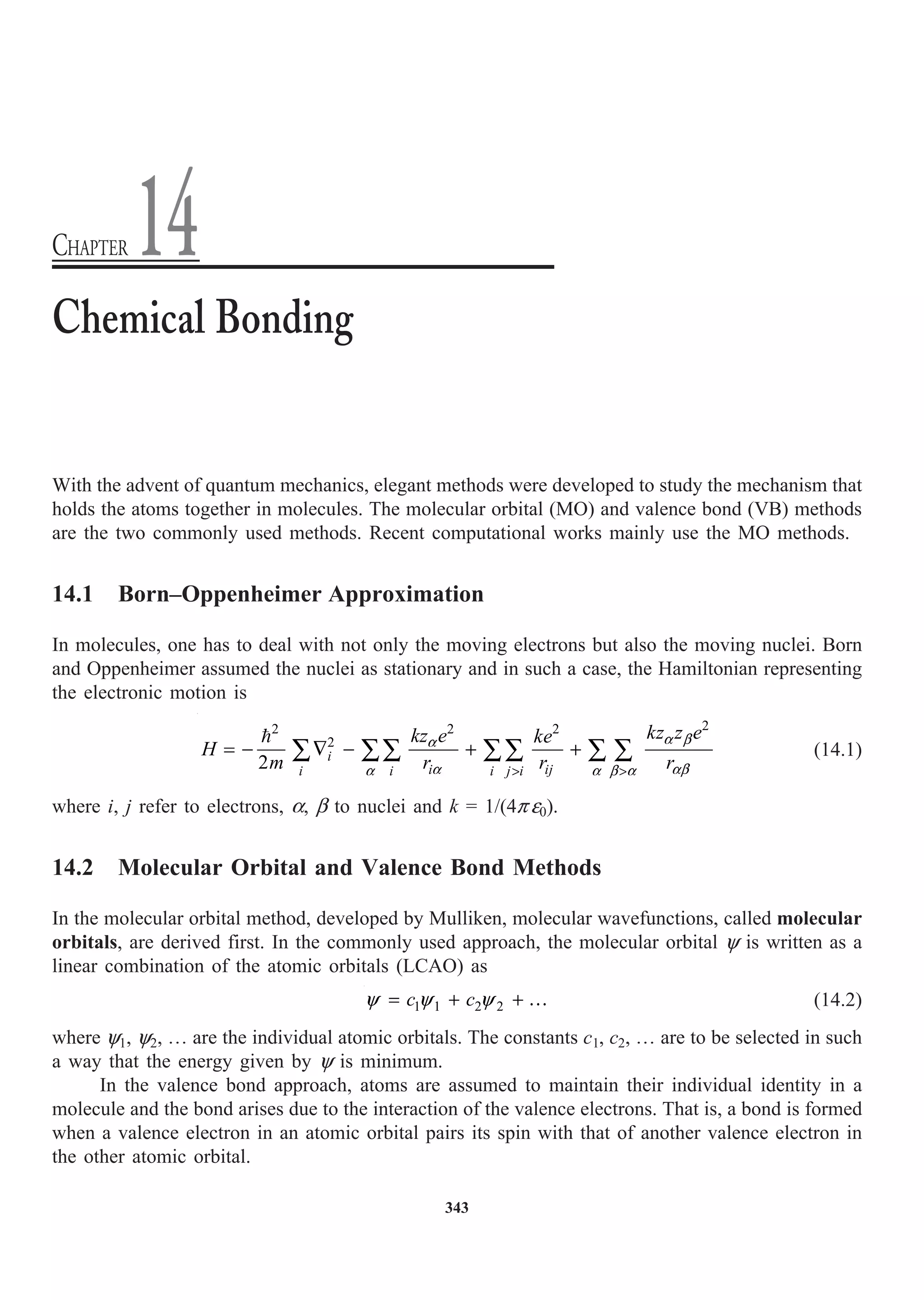
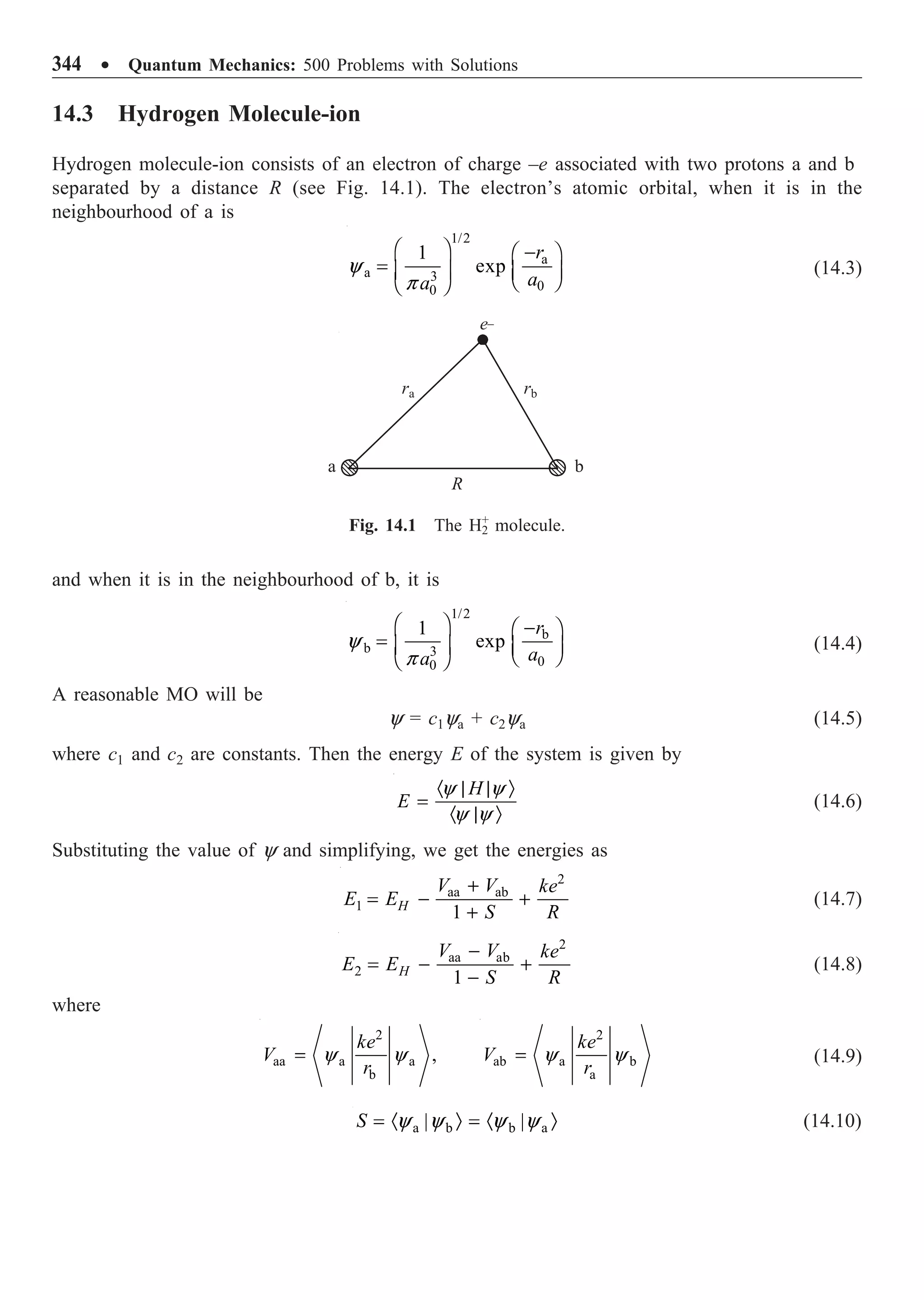
![Chemical Bonding ∑ 345
The normalized wavefunctions corresponding to these energies are
a b
1 ,
2 2S
y y
y
+
=
+
a b
2
2 2S
y y
y
-
=
-
(14.11)
The wavefunction y1 corresponds to a build-up of electron density between the two nuclei and is
therefore called a bonding molecular orbital. The wavefunction y2 is called an antibonding orbital
since it corresponds to a depletion of charge between the nuclei.
14.4 MO Treatment of Hydrogen Molecule
In MO theory the treatment of hydrogen molecule is essentially the same as that of H+
2 molecule.
One can reasonably take that in the ground state both the electrons occupy the bonding orbital y1
(Eq. 14.1) of H+
2 which is symmetric with respect to interchange of nuclei. The trial wave function
of H2 molecule can then be taken as
a b a b
mo 1 1
[ (1) (1)] [ (2) (2)]
(1) (2)
2 (1 )
S
+ +
= =
+
y y y y
y y y (14.12)
With this wave function, the energy is calculated.
14.5 Diatomic Molecular Orbitals
Figure 14.2 illustrates the formation of bonding and antibonding orbitals from two 1s atomic orbitals.
Both are symmetrical about the internuclear axis. Molecular orbitals which are symmetrical about the
internuclear axis are designated by s (sigma) bond, and those which are not symmetrical about
the internuclear axis are designated by p (pi) bond. The bonding orbital discussed is represented by
the symbol 1ss since it is produced from two 1s atomic orbitals. The antibonding state is represented
by the symbol 1ss *, the asterisk representing higher energy.
ya(1s) + yb(1s)
ya(1s) – yb(1s)
a
+
b
+
a
+
b
a
+
b
–
a
+
b
–
(a)
(b)
Fig. 14.2 Combination of 1s orbitals to form (a) bonding orbital 1ss, and (b) antibonding orbital 1ss*.](https://image.slidesharecdn.com/quantummechanics500problemswithsolutionspdfdrive-220626164912-635041ea/75/Quantum-Mechanics_-500-Problems-with-Solutions-PDFDrive-pdf-355-2048.jpg)
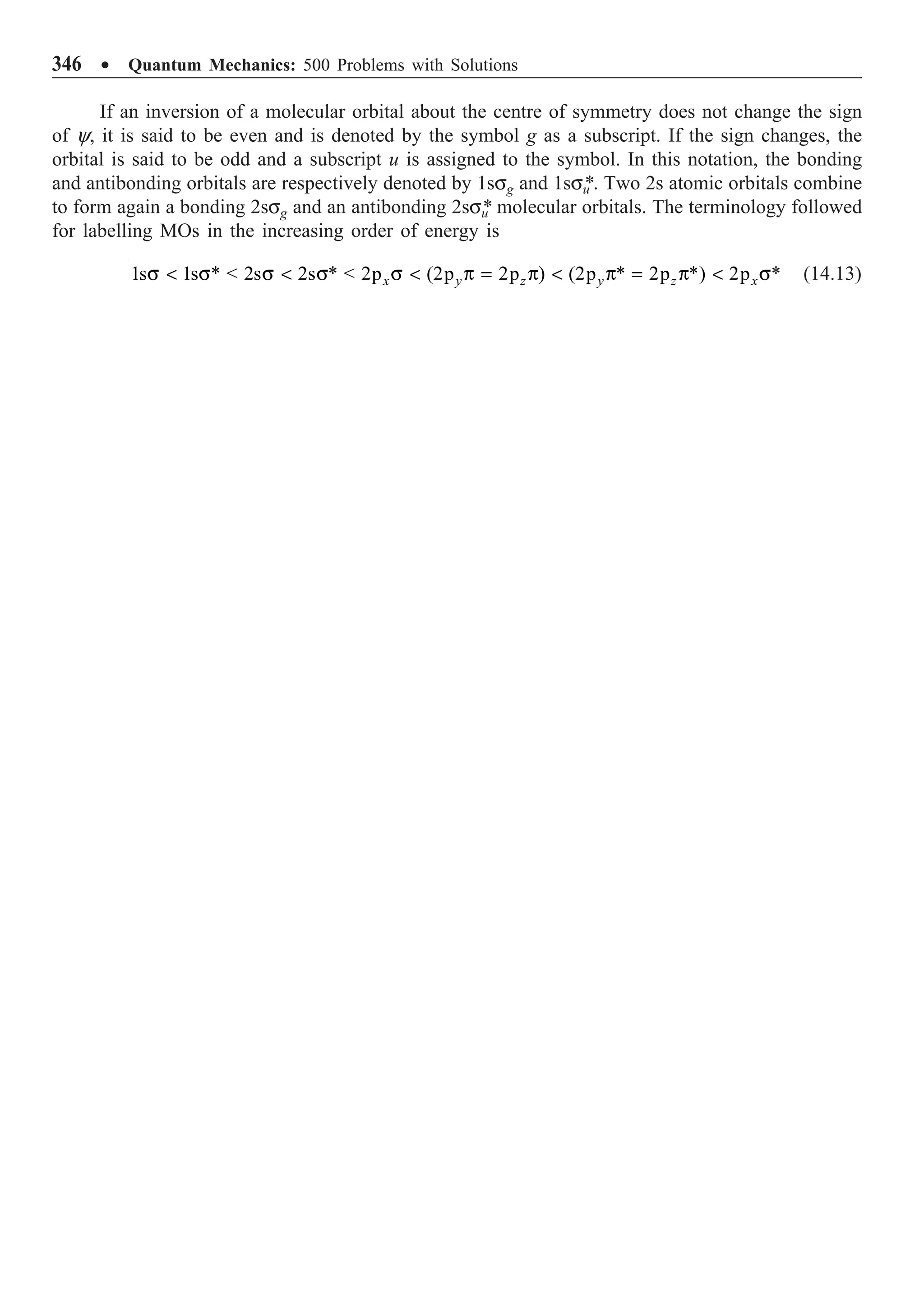
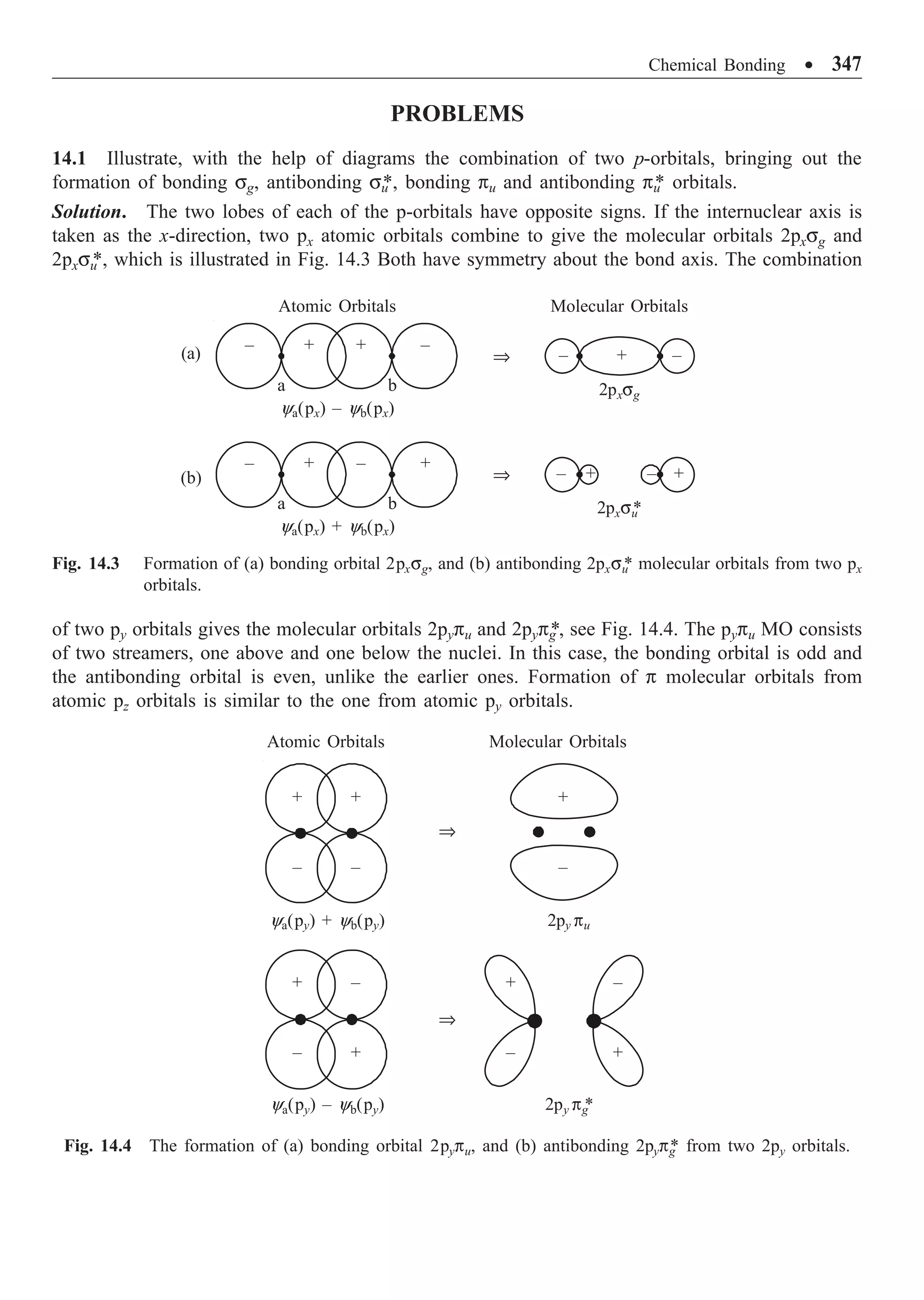
![348 ∑ Quantum Mechanics: 500 Problems with Solutions
14.2 Outline the Heitler-London wavefunctions for hydrogen molecule. What are singlet and triplet
states of hydrogen?
Solution. Hydrogen molecule is a system of two hydrogen atoms and, therefore, can be described
by the wave function
y(1, 2) = ya(1) yb(2) (i)
where a and b refer to the two nuclei, 1 and 2 to the two electrons. The function ya(1) yb(2) means
electron 1 is associated with the atom whose nucleus is a and electron 2 is associated with the atom
whose nucleus is b. The electrons are indistinguishable. Hence,
y(2, 1) = ya(2) yb(1) (ii)
is also a wave function. The wave function of the two-electron system is a linear combination of the
two.
Since an exchange of electron 1 and electron 2 leaves the Hamiltonian of the system
unchanged, the wavefunctions must either be symmetric or antisymmetric with respect to such an
exchange. The symmetric ys and antisymmetric yas combinations are
ys = Ns [ya(1) yb(2) + ya(2) yb(1)] (iii)
yas = Nas [ya(1) yb(2) – ya(2) yb(1)] (iv)
where Ns and Nas are normalization constants. The spin functions of a two-spin half system is given
by
as
1
[ (1) (2) (1) (2)]
2
= -
c a b b a (v)
s
(1) (2)
1
[ (1) (2) (1) (2)]
2
(1) (2)
Ï
Ô
Ô
= +
Ì
Ô
Ô
Ó
a a
c a b b a
b b
(vi)
As the total wave function has to be antisymmetric, the symmetric space part combines with the
antisymmetric spin part and vice versa. Hence, the inclusion of electron spin leads to the Heitler-
London wave functions
s a b a b
1
[ (1) (2) (2) (1)] [ (1) (2) (1) (2)]
2
N + -
y y y y a b b a (vii)
as a b a b
(1) (2)
1
[ (1) (2) (2) (1)] [ (1) (2) (1) (2)]
2
(1) (2)
N
Ï
Ô
Ô
- = +
Ì
Ô
Ô
Ó
a a
y y y y a b b a
b b
(viii)
Equation (vii) corresponds to a singlet state since S = 0, whereas Eq. (viii) is a triplet state as
S = 1.](https://image.slidesharecdn.com/quantummechanics500problemswithsolutionspdfdrive-220626164912-635041ea/75/Quantum-Mechanics_-500-Problems-with-Solutions-PDFDrive-pdf-358-2048.jpg)
![Chemical Bonding ∑ 349
14.3 In the hydrogen molecule ion, the wave functions corresponding to energy E1 and E2 are
y1 = c1(ya + yb) and y2 = c2(ya – yb), where ya and yb are hydrogenic wave functions. Normalize
the functions. What will be the normalization factor if the two nuclei are at infinite distance?
Solution. Given
y1 = c1(ya + yb), y2 = c2(ya – yb)
The normalization of y1 gives
2
1 a b a b
| | ( )|( )
c · + + Ò
y y y y = 1
2
1 a a b b a b b a
| | [ | | | | ]
c · Ò + · Ò + · Ò + · Ò
y y y y y y y y = 1
Writing a b b a
| | ,
· Ò = · Ò
y y y y refer Eq. (14.10), we get
c1
2
[1 + 1 + S + S] = 1
c1 =
1
,
2 2S
+
y1 = a b
2 2S
+
+
y y
Normalization of y2 gives
2
2 a a b b a b b a
| | [ | | | | ]
c · Ò + · Ò - · Ò - · Ò
y y y y y y y y = 1
c2 =
1
,
2 2S
-
y2 = a b
2 2S
-
-
y y
When the two nuclei are at infinite distance, the overlap integral ·ya |ybÒ = ·yb |yaÒ = 0. Hence the
normalization factor for both y1 and y2 is 1/ 2.
14.4 The Heitler-London wave functions for hydrogen molecule are
ys = Ns [ya(1) yb(2) + ya(2) yb(1)]
yas = Na [ya(1) yb(2) – ya(2) yb(1)]
Evaluate the normalization constants Ns and Na. What will be the normalization factor if the nuclear
separation is infinite.
Solution. The normalization condition of the symmetric Heitler-London trial function gives
2
s a b a b a b a b
| | [ (1) (2) (2) (1)]|[ (1) (2) (2) (1)] 1
N · + + Ò =
y y y y y y y y
2
s a b a b a b a b
| | [ (1) (2)| (1) (2) (1) (2)| (2) (1)
N · Ò + · Ò
y y y y y y y y
a b a b a b a b
(2) (1)| (1) (2) (2) (1)| (2) (1) ]
+ · Ò + · Ò
y y y y y y y y = 1
|Ns|2
[1 + S2
+ S2
+ 1] = 1, Ns =
2
1
2 2S
+
since
·ya(1) | ya(1)Ò = ·yb(2) | yb(2)Ò = ·ya(2) | ya(2)Ò = ·yb(1) | yb(1)Ò = 1
·ya(1)yb(2) | ya(2)yb(1)Ò = ·ya(1) | yb(1)Ò ·yb(2) | ya(2)Ò = S ◊ S = S2](https://image.slidesharecdn.com/quantummechanics500problemswithsolutionspdfdrive-220626164912-635041ea/75/Quantum-Mechanics_-500-Problems-with-Solutions-PDFDrive-pdf-359-2048.jpg)

![Chemical Bonding ∑ 351
Removal of an electron from the highest filled bonding orbital decreases the dissociation
energy from 9.91 to 8.85 eV.
14.8 Discuss the type of bonding in the heteronuclear diatomic molecule NO. Why is the bond in
NO+
expected to be shorter and stronger than that of NO?
Solution. Nitrogen and oxygen are close to each other in the periodic table and, therefore, their
AOs are of similar energy. The nitrogen atom has seven electrons and the oxygen atom eight. The
energy levels of the various MOs are the same as those for homonuclear diatomic molecules.
Therefore, the electronic configuration of NO molecule is
2 2 2 4 1
* *
KK (2s ) (2s ) (2p ) (2p 2p ) (2p )
g u x g y u z u g
s s s p = p p
The inner shell is nonbonding, the bonding and antibonding (2ssg) and (2ssu
*) orbitals cancel.
Though the four electrons in (2pypu = 2pzpu)4
orbital can give two p bonds, a half-bond is cancelled
by the presence of one electron in the antibonding 2ppg
* orbital. This leads to a s-bond (2pxsg)2
a
full p-bond and a half p-bond form 2p electrons. The molecule is paramagnetic since it has an
unpaired electron. Removal of an electron from the system means the removal of an electron from
the antibonding orbital. Hence, the bond in NO+
is expected to be shorter and stronger.
14.9 Compare the MO wavefunction of hydrogen molecule with that of the valence bond theory.
Solution. Equation (14.12) gives the MO wavefunction and the Heitler-London function for
hydrogen molecule is given in Problem 14.4. So,
ymo = constant [ya(1)ya(2) + yb(1)yb(2) + ya(1)yb(2) + yb(1)ya(2)]
yHL = constant [ya(1)yb(2) ± ya(2)yb(1)]
The first two terms in ymo represent the possibility of both the electrons being on the same proton
at the same time.These represent the ionic structures H–
a Hb
+
and Ha
+
H–
b. The third and the fourth
terms represent the possibility in which the electrons are shared equally by both the protons, and
hence they correspond to covalent structures. Both the terms in the valance bond wavefunction
correspond to covalent structures as one electron is associated with one nucleus and the second
electron is associated with the other nucleus.
14.10 Write the electronic configuration of Na2 and S2 molecules in the MO concept.
Solution. The electronic configuration of Na: 1s2
2s2
2p6
3s1
.
The electronic configuration of Na2 molecule is
Na2 [KK (2ss)2
(2ss*
)2
(2pyp = 2pzp)4
(2pxs)2
(2pyp* = 2pzp*)4
(2pxs*)2
(3ss)2
]
= Na2 [KK LL (3ss)2
]
This result may be compared with the electronic configuration of Li2, another alkali metal.
The electronic configuration of S: 1s2
2s2
2p6
3s2
3p4
. The electronic configuration of S2
molecule is
S2 [KK LL (3ss)2
(3ss*)2
(3pxs)2
(3pyp = 3pzp)4
(3pyp* = 3pzp*)2
]
Though the orbitals 3pyp* = 3pzp* can accomodate four electrons, there are only two. Hence by
Hund’s rule, one electron will enter each of these with their spins parallel giving a paramagnetic
molecule.](https://image.slidesharecdn.com/quantummechanics500problemswithsolutionspdfdrive-220626164912-635041ea/75/Quantum-Mechanics_-500-Problems-with-Solutions-PDFDrive-pdf-361-2048.jpg)
![352 ∑ Quantum Mechanics: 500 Problems with Solutions
14.11 (i) Write the electronic configuration of N2 molecule and N2
+
ion
(ii) explain the type of bonding in them.
(iii) which one has the longer equilibrium bond length?
(iv) which one has larger dissociation energy.
Solution. Nitrogen molecule has 14 electrons. They are distributed among the MOs as
2 2 2 4
2 *
N [KK (2s ) (2s ) (2p ) (2p ) ]
g u g u
s s s p
The electron configuration of N2
+
is
2 2 2 3
2 *
N [KK (2s ) (2s ) (2p ) (2p ) ]
g u g u
+
s s s p
The two electrons in 2ssg and the two in 2ssu
* antibonding orbital together leads to no bonding. The
(2psg)2
and (2ppu)4
bonding orbitals together give a triple N ∫ N bond, one bond being s and the
other two being p-bonds, in N2 molecule. In N2
+
ion the two electrons in 2psg gives rise to a single
s-bond, two electrons in 2ppu gives a p-bond, and the third electron in 2ppu makes a half-bond.
Bonding MOs produce charge building. Hence removal of an electron from 2ppu orbital
decreases the charge building . Hence, N2
+
has larger equilibrium bond length. Since charge density
is less in N2
+
, the dissociation energy in it is less, or N2 has larger dissociation energy.
14.12 Using the MO concept of electronic configuration of molecules, show that (i) oxygen is
paramagnetic, (ii) the removal of an electron from O2 decreases the bond length, and (iii) evaluate
the bond order of the O2 molecule.
Solution. The 16 electrons in oxygen molecule gives the electronic configuration
2 2 2 4 2
2 * *
O [KK (2s ) (2s ) (2p ) (2p ) (2p ) ]
g u g u g
s s s p p
The antibonding MO, 2ppg
* is degenerate and can accomodate four electrons. As we have only two
electrons in that orbital, the two will align parallel in the two-fold degenerate orbital (Hund’s rule).
Aligning parallel means, effective spin is 1. Hence the molecule is paramagnetic.
(ii) Removal of an electron from an antibonding orbital increases charge building. Hence, bond
length decreases and the equilibrium dissociation energy increases.
(iii) The bond order b is defined as one-half the difference between the number of bonding
electrons (n), between the atoms of interest, and the antibonding electrons (n*
):
1
( *)
2
b n n
= -
Since 2ssg, 2psg and 2ppu are bonding orbitals and 2ssu
* and 2ppg
* are anti-bonding orbitals, the
bond order
1
(8 4) 2
2
b = - =
14.13 Write the electronic configuration of the F2 molecule and explain how the configurations of
Cl2 and Br2 are analogous to those of F2.
Solution. The electronic configuration of F2 molecule is
2 2 4 2 4
2 * *
F [KK (2s ) (2s ) (2p ) (2p ) (2p ) ]
g u u g g
s s p s p](https://image.slidesharecdn.com/quantummechanics500problemswithsolutionspdfdrive-220626164912-635041ea/75/Quantum-Mechanics_-500-Problems-with-Solutions-PDFDrive-pdf-362-2048.jpg)
![Chemical Bonding ∑ 353
The inner shell is nonbonding and the filled bonding orbitals (2ssg)2
(2ppu)4
are cancelled by the
antibonding orbitals (2ssu
*)2
(2ppg
*)4
. This leaves only the s-bond provided by the 2psg orbital. For
Cl2 and Br2, the electronic configurations are
2 2 4 2 4
2 * *
Cl [KK LL(3s ) (3s ) (3p ) (3p ) (3p ) ]
g u u g g
s s p s p
2 2 4 2 4
2 * *
Br [KK LL MM (4s ) (4s ) (4p ) (4p ) (4p ) ]
g u u g g
s s p s p
All the three molecules have similar electronic configurations leading to a s bond.
14.14 On the basis of directed valence, illustrate how the p-valence shell orbitals of nitrogen atom
combine with the s-orbitals of the attached hydrogen atoms to give molecular orbitals for the NH3
molecule.
Solution. In NH3, the central nitrogen atom has the electron configuration
1s2
2s2
2px
1
2py
1
2pz
1
The maximum overlapping of the three p orbitals with the 1s hydrogen orbitals are possible along
the x, y and z-directions (Fig. 14.5). The bond angle in this case is found to be 107.3°, which is again
partly due to the mutual repulsion between the hydrogen atoms.
Fig. 14.5 The formation of ammonia molecule. (The singly occupied 2px, 2py and 2pz orbitals of nitrogen
overlap with the hydrogen 1s orbitals).
14.15 A gas consisting of B2 molecules is found to be paramagnetic. What pattern of molecular
orbitals must apply in this case?
Solution. The 10 electrons in this molecule are expected to be distributed as
2 2 2
2 *
B [KK (2s ) (2s ) (2p ) ]
g u g
s s s
The next orbital is 2ppu which has nearly the same energy as that of 2psg. Hence, instead of (2psg)2
,
the alternate configuration (2psg)1
(2ppu)1
, leading to a total spin of one is possible. These two
unpaired electrons per molecule lead to the observed paramagnetism of B2. The molecular orbital
pattern of B2 is, therefore,
2 2 1 1
2 *
B [KK (2s ) (2s ) (2p ) (2p ) ]
g u g u
s s s p](https://image.slidesharecdn.com/quantummechanics500problemswithsolutionspdfdrive-220626164912-635041ea/75/Quantum-Mechanics_-500-Problems-with-Solutions-PDFDrive-pdf-363-2048.jpg)
![354 ∑ Quantum Mechanics: 500 Problems with Solutions
14.16 Find the relative bond strengths of (i) F2 molecule and F2
+
ion; (ii) F2 and O2 molecules.
Solution.
(i) The electronic configaration of F2 is
2 2 4 2 4
2 * *
F [KK (2s ) (2s ) (2p ) (2p ) (2p ) ]
g u u g g
s s p s p
Removal of an electron means, only three electrons in the antibonding orbital *
2p g
p . Removal of an
electron from an antibonding orbital means an increase in charge building in the bond. Hence bond
strength increases in F2
+
. The electronic configuration of O2 is
2 2 2 4 2
2 * *
O [KK(2s ) (2s ) (2p ) (2p ) (2p ) ]
g u g u g
s s s p p
(ii) In O2, there is an excess of four bonding electrons over the antibonding ones, whereas
in F2 there is an excess of only two bonding electrons over the antibonding ones. Hence the bond
in O2 is stronger than that in F2.
14.17 In sp hybridization, show that the angle between the two hybrid bonds is 180o
.
Solution. As the two hybrids are equivalent, each must have equal s and p character. Hence the
wave function of the first hybrid is
1 1
1 1
s p
2 2
= +
y
and that of the second hybrid is
2 2
1 1
s p
2 2
= +
y
Since ·y1|y2Ò = 0,
1 2
1 1
(s p ) (s p ) 0
2 2
+ + =
1 2 2 1
1 1 1 1
s s p p s p p s 0
2 2 2 2
· | Ò + · | Ò + · | Ò + · | Ò =
The last two terms are zero. If q12 is the angle between the hybrids,
12
1 1
cos 0
2 2
+ q = or 12
cos 1
q = -
q12 = 180°
14.18 Show that the three hybrid bonds in sp2
hybridization are inclined to each other by 120o
.
Solution. Of the 3p-orbitals we leave one, say the pz, unmixed and the other two to mix with the
s-orbital. Hence, the three hybrid orbitals should be directed in the xy-plane. Consider the linear
combination of these two p-orbitals
f = apx + bpy
which gives rise to p1 in the direction of the first hybrid bond. Then the wave function of the first
hybrid can be written as
1 1 2 1
s p
c c
= +
y](https://image.slidesharecdn.com/quantummechanics500problemswithsolutionspdfdrive-220626164912-635041ea/75/Quantum-Mechanics_-500-Problems-with-Solutions-PDFDrive-pdf-364-2048.jpg)


